

i ROMA NUMISMATICS LIMITED Auction XXVIII 5-7 July 2023 Roma Numismatics Limited 40 Villiers Street London WC2N 6NJ United Kingdom Tel: +44 (0)20 7846 7115 www.romanumismatics.com email: info@romanumismatics.com

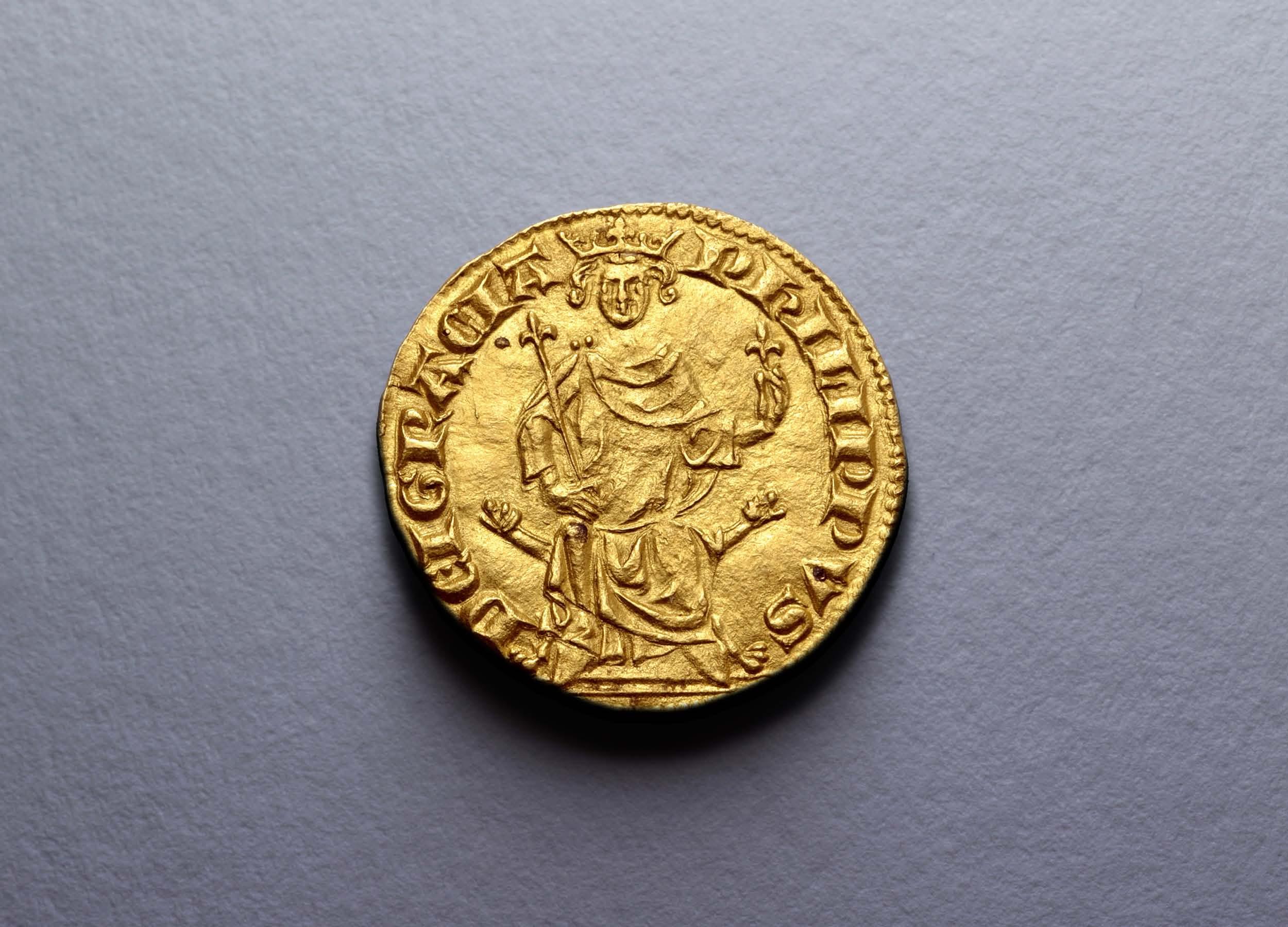
ii
Auction XXVIII
5 July 13:00 Celtic and Greek coins
6 July 13:00 Roman coins: Provincial, Republican, Imperatorial and Imperial Migrationary and Byzantine coins Islamic, Medieval and World coins
The GK Collection of Russian coins
7 July 13:00 The GK Collection of Russian coins (Part III)
E-Live auction 7
10 July 13:00 A Collection of Migrationary Period A Collection of Lombardic coins
A collection of Medieval and World coins
A Highly Interesting Collection of Byzantine Coins
18 July 13:00 A Highly Interesting Collection of Byzantine coins
Location
Please note this is a purely internet and telephone based event and the auction will not be held at a public venue. To find out more about participating please see page iv & v.
No live bidding fees will apply.
Viewing
At the office of Roma Numismatics: 40 Villiers Street
London, WC2N 6NJ United Kingdom
From 14 June - 4 July 2023
Monday - friday, 09.30 - 17.30 by appointment
To assist you with making informed bidding decisions, high resolution images of our auction lots are available upon request.
LOT PICKUP WILL BE AVAILABLE FROM 13.00 ON Thursday 13 July
iii
The Team
How to Bid Commission Bidding











BID ONLINE PRIOR TO THE AUCTION, SEE BIDS UPDATED IN REAL-TIME ON THE ROMA SITE. Commission bids may be submitted prior to the auction at www.RomaNumismatics.com - these bids will be automatically executed on the website, and will then be carried over into the live auction and executed by the auctioneer on the day. Commission bids can be placed up until 12pm on the day of the sale.
Telephone bids
Bids may be placed by telephone as the auction is in progress, but are accepted only at the discretion of Roma Numismatics and at the risk of the customer. Roma Numismatics will not be held responsible for any failure to execute bids by telephone during the auction resulting from technical issues, miscommunication or any other reason. Any client wishing to bid by telephone should inform Roma Numismatics no later than 72 hours before the auction, and should have a prepared list of all the lots they wish to bid on.
Absentee bids



You may submit an absentee bid that will be executed on your behalf by Roma Numismatics. Roma Numismatics will attempt to obtain the lot for you at the lowest possible price, and will not purchase the lot for you at a price higher than the maximum you specify. This service is free and confidential. Absentee bids must be sent and received in good time.
To place absentee bids please submit your list of lots, together with your maximum bids by email, or online at www.RomaNumismatics.com.
You may also participate live online during the sale at www.RomaNumismatics.com/live-bidding. NO LIVE BIDDING FEES WILL APPLY FOR THIS SALE

iv
Richard E Beale Managing Director & Senior Numismatist
Sally Oliver Senior Manager & Numismatist
Simon Parkin Associate Director & Numismatist
Clementine Bowring Associate Manager & Numismatist
George Kitchen Senior Auction Photographer
Lara Drew Auction Cataloguer
Svetlana Egorova Associate Client Manager
Ellis Meade Auction Photographer
Francesca Bailey Auction Cataloguer
Chris Rumney UK/EU Representative, World Coinage
Alice Prince Client Manager
Periklis Mastrangelis Numismatist
Deniz Grotjohann European Representative
Emma Hewson Dispatch Administrator
Omar Ali Finance Manager
T
w
BID ONLINE DURING THE AUCTION, WATCH THE AUCTION LIVE ON YOUR COMPUTER. Real-time bids may be placed on the Roma Numismatics’ website at www.RomaNumismatics.com/live-bidding and at www.biddr.ch on the day of the sale. These bids will be executed live on the floor. Roma Numismatics is not responsible for any missed lots or bids due to network speed or down-time. It is advisable to register as early as possible for these services. NO LIVE BIDDING FEES WILL APPLY FOR THIS SALE.
Successful Bids


Successful bidders will be notified and invoiced normally within 24 hours of the auction. Prices realised will be published around the same time.


new service: eu deliveries via the netherlands

v Live Internet Bidding
ww.biddr.com
We are now able to offer shipment to EU clients with qualifying invoices via our partner office in the Netherlands. NL import VAT of 9% and a service charge of £200 will be payable in addition to normal shipping charges. This service is upon request only and available to clients with invoices over £5,000 - please inform us at the point of bidding if you would like to make use of this option. he Auc�on
Pla�orm
Conditions of Sale
1. The following Terms and Conditions apply to Bidders of all Auctions held by Roma Numismatics Ltd. By making a Bid, the Bidder agrees to these Terms and Conditions and accepts to be bound by them.
ESTIMATES
2. All estimates for Lots are in pounds sterling (£). Any other currency displayed against a Lot is indicative only for the convenience of the Bidder and does not constitute an offer by Roma Numismatics Ltd to pay in any other currency
DESCRIPTIONS
3. The details of any Lot(s), including a description of each item is contained in the Catalogue and/or on Roma Numismatics Ltd’s website.
4. All grades, descriptions and rarity information are the opinion of the cataloguer. Conditions of all Lot(s) are as they appear in the photographs displayed in the Catalogue and/or on the Roma Numismatics Ltd website. Condition reports are available upon request.
5. Bidders are encouraged to carefully examine in person any Lot(s) for which they intend or do Bid for as it is not possible to note all marks or defects or colours. Roma Numismatics Ltd makes no guarantee as to the physical quality or condition of any Lot(s).
6. Any prospective Bidders who exercise the opportunity to physically inspect and examine any Lot(s) in hand shall assume all responsibility and liability for any damage they cause in the course of such examination. Roma Numismatics Ltd shall have sole discretion in determining the value of any damage caused, which shall be promptly paid to Roma Numismatics Ltd by the prospective Bidder.
AUTHENTICITY
7. Roma Numismatics Ltd guarantees the absolute authenticity of all Lots Sold. There is no expiration to this guarantee.
BIDDING
8. Unless otherwise determined at the discretion of the auctioneer, opening Bids will be 60% of the estimate unless there are existing higher Bids.
9. A Bid, once placed, is final. A Bid cannot be revoked.
10. A Bid is placed:
10.1. In the case of a Live (Printed) Auction when the auctioneer acknowledges a Bid and communicates to the other Bidders participating in the Auction that the Bid price has been altered accordingly; or
10.2. In the case of an Absentee (mail or other written) Bid, when a Bid is received by Roma Numismatics Ltd no later than one hour before the commencement of an Auction at which the Lot is due to be auctioned. It is the Bidder’s responsibility to ensure that Absentee Bid(s), whether submitted via the Roma Numismatics Ltd website or by other acceptable means, are accurate and placed in accordance with this sub-clause. Bids received after this point are not guaranteed to be accepted, but when accepted and executed the Bidder is subject to the same terms above.
11. If your Bid is successful You will become the Buyer of that particular Lot and be liable to pay the Hammer Price, plus those applicable charges and fees set out in the “Charges & Payment” section in these Terms and Conditions.
12. Roma Numismatics Ltd shall have absolute discretion to accept or decline any Bid, withdraw Lots from sale or re-open Bidding for any Lot at any time, whether before or after a Lot is Sold, until such time as the Buyer takes physical possession of the Lot, in circumstances which may include, but are not limited to (1) a bidding error has occurred (2) Roma Numismatics Ltd becomes aware of a dispute in relation to the Lot, Sale or Auction (3) Roma Numismatics Ltd has not received payment for the Lot.
13. For the protection of Absentee Bids, no ‘unlimited’ or ‘buy’ Bids will be accepted by Roma Numismatics Ltd.
14. When identical Bids are received for the same Lot, preference will be given to the Bid received first. Absentee Bids will take preference over a floor Bid.
15. Some Lots may carry a Reserve. Roma Numismatics Ltd reserves the right not to sell a Lot below the Reserve, or will repurchase the item on behalf of the consignor or for the account of Roma Numismatics Ltd. If a Reserve exists Roma Numismatics Ltd reserves the right to Bid on any Lot on behalf of the consignor up to the amount of the Reserve against any other Bidders.
CHARGES & PAYMENT
16. A Buyer’s Fee equivalent to 22.5% of the Hammer Price will be added to the Hammer Price and payable by the Buyer to Roma Numismatics Ltd in accordance with these Terms and Conditions:
17. VAT at the applicable rate (applicable to customers within the UK) is due on the Buyer’s Fee only, not the Hammer Price. Roma Numismatics Ltd registered VAT number is 901478828.
18. A 2% surcharge of the Hammer Price will be applied to Bids submitted via post or email, rather than being placed on the Roma Numismatics Ltd website.
19. Invoices are due immediately upon receipt by the Buyer. Roma Numismatics Ltd reserves the right to charge interest on invoices that remain unpaid for 1 calendar month after the date they become due at the rate of 2% per calendar month, except where prior agreement has been made with regards to payment.
20. The Buyer is responsible for paying all bank charges and any shipping and insurance costs.
21. Invoices are sent to Buyers by email. They can also be found listed under ‘Pending Invoices’ in the ‘My Account’ section of the Roma Numismatics Ltd’ website, and can be paid via the website by selecting the preferred payment option of BACS, PayPal or Credit/Debit card. Cash payments are no longer accepted. PayPal and Credit/Debit card payments are accepted only for invoices of £2,500 total value or less.
DELIVERY, COLLECTION & STORAGE
22. The Buyer will be required to satisfy the requirements of Roma Numismatics Ltd AML Policy before the Lot will be released. Buyers may, subject to payment of any fees or charges for delivery, either:
22.1. Collect Lots Sold to them from Roma Numismatics Ltd in person from the main office at 40 Villiers Street, London, WC2N 6NJ by prior appointment, or
22.2. Arrange with Roma Numismatics Ltd to send or deliver the Lot to the Buyer’s nominated address by post, courier or such other method as agreed with Roma Numismatics Ltd.
23. Buyers shall at all times be liable for any costs or expenses incurred by Roma Numismatics Ltd associated with the Buyer’s nominated delivery method. Roma Numismatics Ltd standard delivery costs are set out in the Catalogue and on the Roma Numismatics Ltd website. Any additional costs will be as displayed in the Catalogue and /or the Roma Numismatics Ltd website.
24. Roma Numismatics Ltd shall store any Lot following Sale until shipment to the Buyer without charge.
RISK & TITLE
25. Risk in the Lot passes to the Buyer when the Buyer takes physical possession of the Lot.
26. Title remains with the owner until such time as all sums owed to Roma Numismatics Ltd, by the Buyer, have been received by Roma Numismatics Ltd as cleared funds into Roma Numismatics Ltd’s bank account.
IMPORT/EXPORT RESTRICTIONS
27. Any Lot that is Sold that is subject to United States of America (US) or German import restrictions must be legally imported into the US or Germany (unless otherwise explicitly stated in the Lot description). Any such Lot will be accompanied by documentation proving that the Lot was outside of the source country prior to the Effective Date, or a valid export certificate issued by the country of origin. Any Lot subject to US or German import restrictions that may not lawfully
vi
Conditions of Sale (Continued)
be imported into these countries will be clearly indicated as such in the Catalogue with a notice stating ‘not suitable for US/German market’.
28. Our commitment to ethical and responsible provenance ensures that the Seller affirms each Lot is Their lawful property to sell, and where cultural property restrictions may exist, that it meets the requirements to be legally imported into the US and/or Germany
29. Roma Numismatics Ltd will endeavour to carry out importations on behalf of the Buyer to enable shipment of that Lot to the Buyer ’s nominated location but the Buyer is ultimately responsible for ensuring compliance with import regulations and procedures. However, any Buyer, whether based in the US, Germany or elsewhere, who purchases a Lot that cannot be lawfully imported into either the US or Germany, with the intention that the Lot is sent to either of those jurisdictions, shall be deemed to purchase the Lot and will be liable to pay all fees, charges and cost that become due when Knocked Down.
30. Roma Numismatics Ltd will not, and will not be compelled to, under any circumstances accept instructions from any person, make arrangements or be required to forward or send any Lot that cannot be lawfully imported to any jurisdiction to that jurisdiction.
31. Roma Numismatics Ltd undertakes to obtain export licences for those Lots that require them.
RETURNS
32. If a Buyer suspects a Lot is not authentic they must notify Roma Numismatics Ltd as soon as possible. Rejection by any third party grading service for any reason will not by itself constitute grounds for return of the Lot(s). The Buyer must support any claim of non-authenticity by valid technical evidence provided by at least 2 (two) separate qualified firms or individuals. A Lot may only be returned to Roma Numismatics Ltd if it is agreed to be not authentic by Roma Numismatics Ltd.
33. A Lot may be returned to Roma Numismatics Ltd within 21 (twenty one) days of the Sale Date if it is materially different from its description.
34. In circumstances where a Lot is returned by a Buyer pursuant to clause 32 or 33 and Roma Numismatics Ltd agrees to a refund, the amount to be refunded to the Buyer shall be (1) the Hammer Price (2) the Buyer’s Fee (3) the surcharge paid under clause 18 (if any). In all other cases, Roma Numismatics Ltd is not liable to refund or pay a Buyer for any fees or costs associated with returning a Lot to Roma Numismatics Ltd or the refund of any shipping charges or external or 3rd party costs.
35. All refunds will be made in Pounds Sterling unless otherwise agreed. Roma Numismatics Ltd is not liable for any exchange rate differences.
FALIURE TO PAY
36. Roma Numismatics Ltd is under no obligation to release a Lot to a Buyer until such time as the Buyer has paid Roma Numismatics Ltd. All sums that are due or which may become due as set out in these Terms and Conditions.
37. Lots will be held by Roma Numismatics Ltd for a period of 3 calendar months from the date the Lot is Knocked Down unless otherwise agreed. After 3 (three) calendar months Roma Numismatics Ltd shall be entitled to cancel the Sale and re-auction the Lot in accordance with clause 12.
LIMITATION ON LIABILITY
38. Roma Numismatics Ltd shall not be liable to You for any loss of profits, loss of sales or business, loss of agreement or contracts, loss of anticipated savings, loss of or damage to goodwill or indirect or consequential loss.
39. Our liability to You is capped at the amount You have paid to Us in respect of a Lot.
40. Roma Numismatics Ltd does not exclude or limit in any way its liability to You where it would be unlawful.
GENERAL
41. Roma Numismatics Ltd shall not be in breach of these Terms and Conditions nor liable for delay in performing, or failure to perform, any of its obligations under these Terms and Conditions if such delay or failure result from events, circumstances or causes beyond its reasonable control.
42. Any notice or other communication given to a party under or in connection with these Terms and Conditions shall be in writing, addressed to that party at its registered office (if it is a company) or such other address as that party may have specified to the other party in writing, and shall be delivered personally, sent by pre-paid first class post or other next working day delivery service, commercial courier or email.
43. A notice or other communication shall be deemed to have been received if delivered personally, when left at the address referred to in clause 43: if sent by prepaid first class post or other next working day delivery service, at 9.00 am on the second business day after posting; if delivered by commercial courier, on the date and at the time that the courier’s delivery receipt is signed; or, if sent by email, one business day after transmission.
44. These Terms and Conditions and any document produced by Roma Numismatics Ltd or otherwise mentioned herein constitutes the entire agreement between the parties and supersedes and extinguishes all previous agreements, promises, assurances, warranties, representations and understandings between them, whether written or oral, relating to its subject matter.
45. Roma Numismatics Ltd will only use Your personal information as set out in Our privacy policy, a copy of which can be viewed at: https://www.romanumismatics.com/privacy-policy. We may amend this policy from time to time.
46. Roma Numismatics Ltd’s Anti-Money Laundering Policy (AML Policy) sets out Roma Numismatics Ltd’s policy for ensuring compliance with anti-money laundering legislation that applies to some of its activities.
47. We may amend these Terms and Conditions from time to time.
48. No failure or delay by Roma Numismatics Ltd to exercise any right or remedy provided under these Terms and Conditions or by law shall constitute a waiver of that or any other right or remedy, nor shall it prevent or restrict the further exercise of that or any other right or remedy.
49. Nobody else has any rights under these Terms and Conditions.
50. If any provision or part-provision of these Terms and Conditions is or becomes invalid, illegal or unenforceable, it shall be deemed modified to the minimum extent necessary to make it valid, legal and enforceable. If such modification is not possible, the relevant provision or part-provision shall be deemed deleted. Any modification to or deletion of a provision or part-provision under this clause shall not affect the validity and enforceability of the rest of these Terms and Conditions.
51. These Terms and Conditions and any dispute or claim (including non-contractual disputes or claims) arising out of or in connection with it or its subject matter or formation, shall be governed by and construed in accordance with the law of England and Wales.
52. Each party irrevocably agrees that the courts of England and Wales shall have exclusive jurisdiction to settle any dispute or claim (including non-contractual disputes or claims) arising out of or in connection with these Terms and Conditions or its subject matter or formation.
PAYMENT METHODS:
Invoices can found listed under ‘Pending Invoices’ in the ‘My Account’ section of the Roma Numismatics’ website, and can be paid directly through the site by selecting the preferred payment option of BACS or Credit/Debit card.
Credit/Debit Card: For invoices with a total value of £2,500 or less.
Bank Transfer: Barclays Bank, 22 The Borough, Farnham, GU9 7NH, UK | Account Name: Roma Numismatics IBAN: GB90 BUKB 2031 0663 0101 39 |
vii
BIC: BUKB
SORT
ACC #:
GB22 |
CODE: 20-31-06 |
63010139
AUCTION REWARDS TERMS AND CONDITIONS
MEMBERSHIP
1. We reserve the right not to enrol individuals with resident addresses in certain countries and/or regions or restrict transfers and changes of registered address. Such countries and/or regions are subject to change however reasonable advance notice will be given in circumstances where the removal of a country and/or region will affect the Membership of existing Members.
2. Membership is offered at our discretion and we may refuse Membership to any applicant or revoke said Membership at any time.
3. Membership applicants must state their full name, date of birth, preferred mailing address, email address and telephone number for correspondence.
4. Risk (for example, theft or unauthorised or fraudulent redemption) associated with Points passes to the Member as soon as Points are recorded on the Member ’s account, or otherwise awarded to the Member. We are not liable for unauthorised or fraudulent redemptions. You are the holder of Points and are responsible for their security. We are the owner of all Points and they remain our property at all times.
5. Membership will terminate automatically in the event of the expiry of all Points when a Member has not earned or redeemed or bought for 24 consecutive months; or upon the death of a Member, Points accumulated but unused at the time of death shall be cancelled together with Membership of the Scheme; or if we reasonably believe that you have committed an act of Fraud or Misconduct against us. The Member shall be liable to us for the full price of any goods or services obtained wholly or partly as a result of such Fraud and/or Misconduct and any legal fees incurred by us.
6. Members may terminate their Membership by contacting us stating that they no longer wish to be a Member. Any such termination will result in a loss of all Points and does not relieve the Member of any continuing obligations under these Terms and Conditions.
7. In the case of Fraud and/or Misconduct, we may cancel all accrued and accruing Points of the Member and any Rewards.
EARNING POINTS
8. We will record Points in the Member’s personal account. Points cannot be redeemed until we have recorded it in the Member’s personal account. It will take up to 48 hours for points to be credited to the Member’s account.
9. Further details of how Points are earned and the applicable earn rates are contained on the Website.
10. Points may not be earned under the Scheme if any form of discount or preferential treatment is also received for the same activity. In the event we grant any Points in such circumstances we reserve the right to cancel the Points without notice to you.
11. Points can only be earned on the cash value of the hammer price of lots purchased at auction. Buyers’ Premiums, Vendors’ Commissions, shipping charges, external fees and any other cost or charge is not eligible. The award of Points will be calculated in accordance with the information published on our Website.
REDEEMING POINTS
12. Points are redeemable for products and service as described on the Website, and at the redemption values stated. In the case of auction lots, Points are redeemable only against the Hammer Value in blocks of 2000 points. Members are responsible for paying Buyers’ Premiums, taxes, fees, charges and surcharges.
13. Points may be redeemed online at the Website or via the Office in accordance with such procedures that may be in force from time to time for the issue of Rewards, as set out on the Website. Redemptions can only be requested by the Member.
REFUNDS
14. When Points have been used as part payment, the Points will be refundable only where the base product is refundable. Partial refunds will be credited to the Member’s Points account up to the value of the original part payment, with any remainder credited to the original method of payment together.
TRANSFERRING POINTS
15. Except as otherwise provided by us and communicated to the Member and subject to any stated limitations, Points are not transferable in any way (whether from person to person, account to account, statement to statement, Scheme to any other loyalty type scheme or otherwise.
16. Any purported purchase, sale, transfer, unauthorised use (including bartering), procurement or redemption of Points issued or awarded to another person or any other use of Points contrary to these Terms and Conditions will, unless explicitly authorised, constitute a fundamental breach by the Member of these Terms and Conditions and therefore the contract between us.
17. Other than as provided for herein Points are not redeemable for cash, refundable or exchangeable for anything else. At no time may Points be purchased by, sold to, bartered or otherwise transferred to other persons.
BUYING POINTS FOR YOURSELF
18. The Buyer can buy a maximum of 1,000,000 Points in any one calendar year.
19. In normal circumstances Points will be available to use immediately but it could take up to 3 working days for Points to appear on your account.
20. Points can only be bought online at the Website. The Buyer must be a member of the Scheme, members whose accounts have expired will not be able to buy Points.
21. Buying Points will be considered as collecting Points and will reset the 24 month expiry rule.
22. You have the right to cancel contracts for the buying of Points within 14 days without giving any reason provided the Points have not been used. The cancellation period will expire after 14 days from the day on which you purchase the Points. To exercise the right to cancel, you must inform us of your decision to cancel this contract by a clear statement (e.g letter sent by post or email). If you cancel, we will reimburse to you all payment received from you. We will make the reimbursement without undue delay, and not later than 14 days after the day on which we were informed about your decision to cancel this contract.
23. Points which are subsequently refunded will not constitute activity for the purposes of the 24 month expiry rule.
BUYING POINTS AS A GIFT
24. The Buyer of a Gift can buy a maximum of 1,000,000 Points as a gift for any number of Members, in any one calendar year. Members may not buy Points as a Gift to their own account. The Buyer can only buy Points for one Recipient per transaction.
25. A Gift Recipient of bought Points can only receive a maximum of 1,000,000 Points in any one calendar year in aggregate, irrespective of the number of Buyers.
26. In order to buy Points as a gift, the Buyer will need to know the Recipient’s full name, email address and client number. The Buyer should ensure that the Recipient has not received more than 1,000,000 Points, including the proposed Points transaction, in that calendar year. Points may not be bought for a Member whose account has expired. Buying Points will reset the 24 month Points expiry rule for the recipient. The Buyer must not demand and the Recipient must not offer any value or value in kind for Points. Such activity or any other use of Points contrary to these Terms and Conditions will constitute a fundamental breach by the member of these Terms and Conditions and therefore the contract between us and the Member. In the event of such a breach, we reserve the right at any time in our absolute discretion to terminate the Membership of any member.
viii
AUCTION REWARDS TERMS AND CONDITIONS (Continued)
POINTS EXPIRY
27. If a Member has not earned or redeemed Points or bought or transferred Points for 24 consecutive months, all Points that have accrued to that date will expire.
TIER STATUS
28. Roma Numismatics Ltd reserves the right to alter the rules for earning Tier status at any time.
29. Seasonal gifts will be sent to qualifying buyer Members with a paid invoice during their tier year
30. Seasonal gifts will be sent to qualifying seller Members who have consigned to auction during their tier year
31. Reimbursement requests for travel and accommodation to auctions held by Roma Numismatics Ltd. will be granted to Members who have consigned a minimum of value of £100,000 to the auction they wish to attend. Reimbursements will be limited to £1,500 per Member
VARIATION OF CURRENCY
32. We may, from time to time, change the base currency or the name of the currency used by us either in whole or in relation to any country or region. We will provide reasonable notice to Members of any such change.
CHANGES OR CANCELLATIONS BY YOU
33. Rewards, once selected and confirmed, are considered final. No changes or amendments are permitted.
CHANGES OR CANCELLATIONS BY US
34. We reserve the right to amend or cancel any redemption of points subject to the terms and conditions set out in our Terms and Conditions.
LIABILITY
35. We will not be liable for any Loss resulting from alteration to, or termination of, the Scheme or the right to earn or redeem Points, except for Loss caused by our own negligence or wilful misconduct. We do not accept liability where any failure to provide any services in accordance with the contract or any other form of loss or damage is due to your own fault, or is the result of our compliance with any instruction, request or direction given by you. In no event will we be liable for any direct, indirect, special, punitive, exemplary or consequential losses or damages of whatsoever kind arising out of access to, or the use of this website or any information contained in it, including loss of profit and the like whether or not in the contemplation of the parties, whether based on breach of contract, tort (including negligence), product liability or otherwise, even if advised of the possibility of such damages.
36. We will not be liable for any loss if, by reason of local legal or regulatory prohibitions or restrictions, the Scheme or the whole or any part of the Services cannot be made available in certain countries or to certain Members.
37. We make no representations as to any income, use, excise or other tax liability of Members as a result of their Membership. Such a tax liability may arise, for example, if a Member obtains Points and/or Rewards as a result of business expenditure. Members are advised to check with their accountant or tax adviser for further information. The Member is solely responsible for any tax liability incurred as a result of Membership.
GOVERNING LAW
38. To the extent permissible by local law or regulation these Terms and Conditions shall be governed by and construed in accordance with English law. Any provision of these Terms and Conditions declared void or unenforceable by any competent authority or court shall, to the extent of such invalidity or unenforceability, be deemed severable and shall not affect the other provisions remaining which shall continue unaffected. If there is any conflict in meaning between the English language version of these Terms and Conditions and any version or translation of these Terms and Conditions in any other language, the English language version shall prevail.
DATA PROTECTION
39. We will process your Data in accordance with the Privacy Policy which can be found at the Website under the heading “Privacy Policy”,
USE OF WEBSITE
40. Your use of this website indicates your agreement to be bound by these Terms and Conditions.
PROPRIETARY RIGHTS
41. All Materials on this website, the appearance, organisation and layout of this website, the underlying software code and the underlying data are subject to trade marks, copyright, database rights and other registered and unregistered intellectual property rights which are owned either directly by Roma Numismatics Ltd. Unless otherwise authorised within these Terms and Conditions, You must not copy, modify, alter, publish, broadcast, distribute, sell or transfer (whether in whole or in part) any Material on this website or the underlying software code or underlying data.
CHANGES TO OR TERMINATION OF THE SCHEME
42. We may terminate a Member’s right to earn or redeem Points or terminate the Scheme.
43. We will give reasonable notice of such termination of the Scheme or a Member’s right to earn or redeem Points issued by us.
44. We can change the Scheme, the Points, and the Rewards we provide. We will give you reasonable notice but this could depend on the nature of the change and the notice that we may receive from our Partners. Examples of the action, which we might take, include modifying or withdrawing the right to earn Points or amending the number of Points required to purchase a particular Reward. Members shall be deemed to have agreed to any modifications, withdrawal, amendment or addition to Rewards or the Scheme if, after we have notified you of the changes, you continue to participate in the Scheme. Members who do not wish to accept changes to the Scheme may terminate their Membership.
45. We may, at any time, amend the time limit on how long you have to spend any Points. We will give you reasonable notice.
46. We have the right to change these Terms and Conditions.
ix
x
COINS OF THE CELTS NORTHEAST GAUL

Northeast Gaul, the Ambiani AV Stater. Gallic War uniface type. Circa 56-55 BC. Plain / Devolved horse to right; pellet triad and ‘charioteer’s arms’ above, crescent and pellet below, exergual line with crescents and pellets below. D&T 238; LT 8710; ABC 16; VA 52/4. 6.17g, 18mm.



Extremely Fine.
Acquired from Leu Numismatik AG; Ex Hestia Collection, formed over the past five decades.
EASTERN GAUL
The Finest in Over 20 Years
Eastern Gaul, uncertain tribe AR Quinarius. Circa 1st century BC. Celticised male head to right within torque / Celticised figure advancing to left, holding large torque; annulets in field, all within wreath. D&T 205; LT 9388. 1.91g, 16mm, 6h.




Extremely Fine; beautiful old cabinet tone. Scarce, and easily the finest example of this unusual type to appear at auction in over 20 years.
Acquired from Leu Numismatik AG; Ex Hestia Collection, formed over the past five decades; Ex Emmert Collection.
CENTRAL EUROPE
The Second Known
Central Europe, Helvetii(?) AV Stater. Imitating Philip II of Macedon. Circa 3rd century BC. Laureate head of Apollo to right / Charioteer, holding kentron and reins, driving galloping biga to right; Nike flying to right below horses, ΦΙΛΙΠΠΟΥ in exergue. For prototype cf. Le Rider 370 (Pella); cf. HMZ 1-1 (Helvetii); Nomos 12, lot 8. 8.35g, 21mm, 12h.

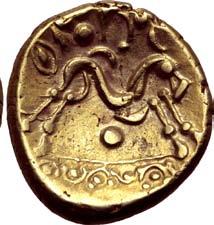

Extremely Fine; double struck, test cut to edge. Apparently only the second known example. The style of this coin indicates that it is an imitation of a Philip II Stater, and while there are similarities to coins of the Helvetii the attribution is far from certain.

1
2.
600
3. 1,800
480 Lot Starting Price
1.
CELTS IN EASTERN EUROPE
Celts in Eastern Europe AR Tetradrachm. Baumreiter Type. Circa 3rd century BC. Celticised, bearded head wearing reversed laurel wreath to right / Rider on horseback to left, wearing helmet with large crest terminating in annulet, holding leafless branch or small tree; animalistic symbol before, [floral ornament below]. Göbl, OTA pl. 12, 129/2-5; BMC I pl. 5, 65 & 67; Lanz 416-420; Pink 129-30. 14.14g, 26mm, 12h.
Extremely Fine; pleasant old cabinet tone.
Celts in Eastern Europe AR Tetradrachm. Triskeles Type. Circa 3rd - 2nd century BC. Celticised, laureate and bearded head of Zeus to right / Stylised rider on horseback to right; V in front, Π beneath foreleg, triskeles below. Göbl, OTA pl. 35, 434/4; Lanz 724. 13.24g, 24mm, 8h.




Extremely Fine; beautiful old cabinet tone.
Celts in Eastern Europe AR Tetradrachm. Lysimachoskopf Type. Circa 2nd - 1st century BC. Youthful head to left, S-form in front / Rider on horseback to left, wearing helmet with long crest. Göbl, OTA pl. 24, 284/2; Lanz 582. 12.76g, 22mm, 10h. Very
COINS OF THE GREEKS
Extremely Rare
Gaul, Massalia AR Drachm. Circa 150-125 BC. Draped bust of Artemis to right, wearing stephane; bow and quiver over shoulder / Lion standing to right; MAΣΣA -ΛIHTΩN around, Π between back legs, Δ under chest, Φ between front paws. Muarel 630; Depeyrot 41.39; BnF inv. 1282-4. 2.81g, 19mm, 6h.
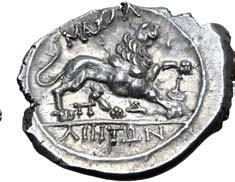
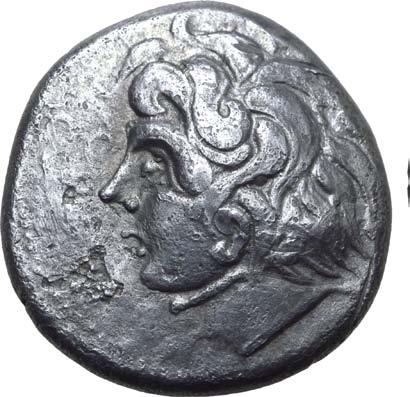







Mint State; previously NGC graded MS 5/5 - 3/5 (#2080858-003). Extremely rare variety with these three letters beneath lion.
Ex Roma Numismatics Ltd., Auction XX, 29 October 2020, lot 8; Ex Editions V. Gadoury, Auction 2018, 16 November 2018, lot 17.
1,200
2
4.
450
5.
450
Fine.
300
6.
GAUL
7.
A Gentleman’s Collection of Etruscan Coins
The Finest Known
Etruria, uncertain mint (Populonia?) Æ 100 Units (Centesimae). Late 4th - 3rd century BC. Laureate and bearded head of Tinia to right, ƆIC (mark of value) behind; all within dotted border within laurel wreath / Incuse hippocamp to right within border of waves. EC I, 1 (O-/R-); HN Italy 76; Vecchi IV, 24; HGC 1, 158. 42.99g, 42mm, 12h.
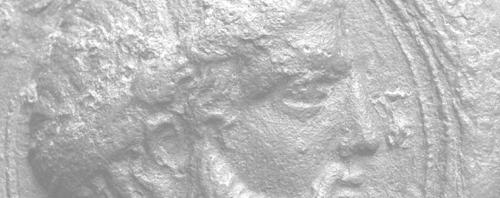



Extremely Fine; the finest known example. Extremely Rare; EC cites 7 examples, only one other seemingly auctioned in the past 20 years.
Ex Vitangelo Collection, Roma Numismatics Ltd., Auction XXI, 24 March 2021, lot 8.
The eighth published and by far the finest example known of this remarkable series demonstrates that even at this late date, the Etruscans could produce round art in the miniature equal to anything the classical Greek world had realised in Megálē Hellás.
The carefully engraved die struck bronze series cerebrating the Etruscan pantheon is characterized by wreath-bordered obverses and incuse reverses, clearly belongs to a single mint, possibly Populonia. The widely dispersed provenances are of little help in identifying the mint: Acanaro, Cecina, Cetona, Gravisca, Populonia, Valle d’Orcia, Valle Fuino di Cascia and Vetulonia. However, bronze cast and struck issues did predominate in central Etruria where four of the finds were made. The denominations are tariffed in centesimal marks of value from 100 down to a single unit, with the basic bronze unit on a standard somewhere between 0.6 and 1 gram. This may have been an attempt to divide a nominal as by centesimae rather than oncie as seen on the double denominated Populonia bronze series 139 with /X (11-units equated to a triens) and Populonia series 140 with X (= 10-units equated to a triens of lower weight) and the > or Ì (5-units) denominated bronzes from the Val di Chiana, HN Italy 72, 74 and 75. For an analysis of the metrological system employed by this group, see Hackens 1976, pp. 253-260.
3
8,100 ETRURIA
8.
Ex Merzbacher 24, 1910
Etruria, uncertain mint Æ 25 Units. Late 4th - early 3rd century BC. Helmeted head of Menvra to right; XXV (mark of value) before / Incuse cock standing to left within laurel wreath. EC I, 6.10 (this coin); SNG Spencer-Churchill 2 (this coin); Vecchi, SNR 72, 1993, 30.1, (this coin); Vicari, RIN XCIII, 1991, 102, (this coin); Pozzi 123 (this coin); HN Italy 81; Sambon 137; HGC 1, 163 (Populonia). 10.28g, 25mm, 3h.
Very Fine. Very Rare.
This coin published in I. Vecchi, Etruscan Coinage Part 1 (Milan, 2012);
This coin published in I. Vecchi, “The Coinage of the Rasna” Part IV, in SNR 72 (1993);
This coin published in F. Vicari, “Materials and considerations for an organic study of Etruscan coinage” in RIN XCIII (1991);
This coin published in S. Boutin, Catalogue des monnaies grecques antiques de l’ancienne collection Pozzi: Monnaies frappées en Europe (Maastricht, 1979);
This coin published in Sylloge Nummorum Graecorum, Great Britain, Part 1: The Collection of Capt. E.G. Spencer-Churchill, M.C., of Northwick Park / The Salting Collection in the Victoria and Albert Museum (1931);
Ex Lord Renfrew Collection no. 32;
Ex Baldwin’s Auctions Ltd., Auction 99, 4 May 2016, lot 570;
Ex Richard Cyril Lockett Collection, Greek (Part I), Glendining’s, Auction 10, 25 October 1955, lot 29 (part of);
Ex Captain E. G. Spencer-Churchill Collection, Naville, Auction XVI, 3 July 1933, lot 10;
Ex Professor S. Pozzi Collection, Naville, Auction I, 14 April 1921, lot 47;
Ex Merzbacher, Auction 24, 15 November 1910, lot 15.
Etruria, uncertain mint Æ 10 Units. Late 4th-early 3rd century BC. Laureate head of Tinia to right; X (mark of value) behind / Two incuse fish swimming in circle within border of waves. EC 1, 12.8 (this coin); Vecchi, SNR 72, 1993, 36; HN Italy 86; HGC 1, 169 (Populonia). 5.66g, 21mm.




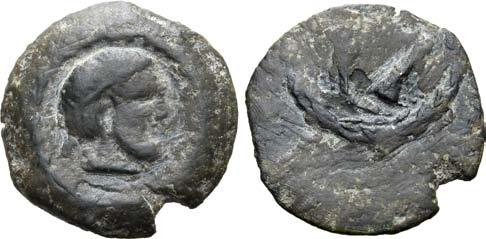
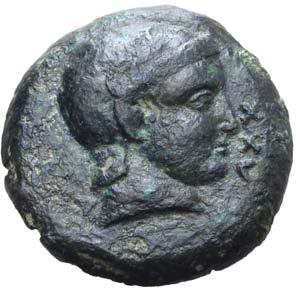
Very Fine; edge chip.
This coin published in I. Vecchi, Etruscan Coinage Part 1 (Milan, 2012);


Ex Fritz Rudolf Künker GmbH & Co. KG, Auction 295, 25 September 2017, lot 63;
Ex The New York Sale I, 3 December 1998, lot 2.
Etruria, uncertain mint cast Æ Semis. 3rd century BC. Wheel with six spokes / Anchor; six pellets (mark of value) in field. ICC 148; HN Italy 65d; Haeberlin pl. 89, 7-8. 74.42g, 52mm.
Very Fine. Very Rare.
Ex Artemide Aste s.r.l., Auction LII, 26 October 2019, lot 12.
4
9.
900
10.
150
11.
900
12.
Etruria, uncertain mint cast Æ Quadrans. 3rd century BC. Wheel with four spokes / Wheel with four spokes; three pellets (mark of value) between. ICC 158; HN Italy 56d; Haeberlin pl. 85, 9-13. 52.13g, 41mm.
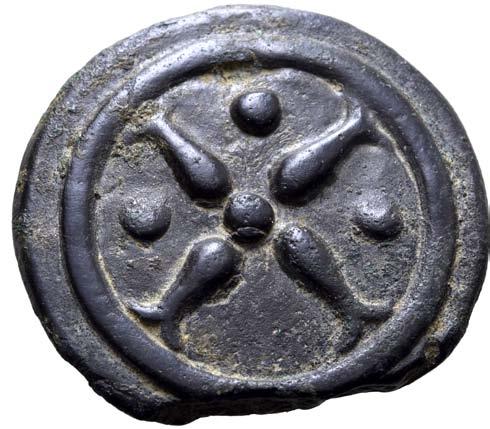







Near Extremely Fine; ‘V’ graffito on obv.
Artemide Aste s.r.l., Auction LII, 26 October 2019, lot 11.
13.
Etruria, uncertain mint cast Æ Quadrans. 3rd century BC. Wheel with four spokes / Krater; three pellets (mark of value) around. ICC 164; HN Italy 57c. 44.09g, 39mm.
Bertolami Fine Arts - ACR Auctions, E-Auction 105, 21 October 2021, lot 411.
Etruria, uncertain mint cast Æ Uncia. 3rd century BC. Wheel with four spokes / Krater. ICC 166; HN Italy 57e; Haeberlin p. 260, 1-46, pl. 86, 15. 14.40g, 26mm.
Good Fine. Rare.
Ex Roma Numismatics Ltd., Auction XVIII, 29 September 2019, lot 463.
Etruria, uncertain mint cast Æ Uncia. 3rd century BC. Wheel; pellet at centre / Wheel; pellet at centre. ICC 184; HN Italy 63f; Haeberlin pl. 90, 10. 9.73g, 25mm.


Good Very Fine.
Ex Spink & Son Ltd, Auction 18006, 25 September 2018, lot 1068.
270
240
5
Ex
450
Ex
Very Fine; scuffs to obv. 450
14.
15.
16.
Etruria, uncertain mint cast Æ Uncia. 3rd century BC. Wheel with four spokes / Wheel with four unevenly spaced spokes; [pellet] in field. ICC 161; HN Italy -. 12.39g, 24mm.
Near Very Fine. Very Rare.
Ex St. James’s Auctions Ltd., Auction 49, 5 October 2021, lot 1004; Purchased from A. H. Baldwin & Sons, 4 July 1955.
17.
Etruria, uncertain mint cast Æ Uncia. 3rd century BC. Wheel with four spokes / Wheel with four spokes. ICC 160; HN Italy 56f. 13.69g, 26mm.
Near Very Fine.
Ex Bertolami Fine Arts - ACR Auctions, Auction 29, 22 March 2017, lot 8.
18.
Etruria, uncertain mint cast Æ Uncia. 3rd century BC. Wheel with four spokes; Λ in field / Wheel with four spokes. ICC 160; HN Italy 56f. 9.89g, 24mm.
Near Very Fine; hole caused by bubble in casting process.
Ex St. James’s Auctions Ltd., Auction 49, 5 October 2021, lot 1003; Purchased from Seaby, 25 August 1955.
19.
Etruria, uncertain mint cast Æ Uncia. 3rd century BC. Wheel with six spokes; pellet in field / Anchor; pellet in left field. ICC 154; HN Italy 67. 8.97g, 23mm.






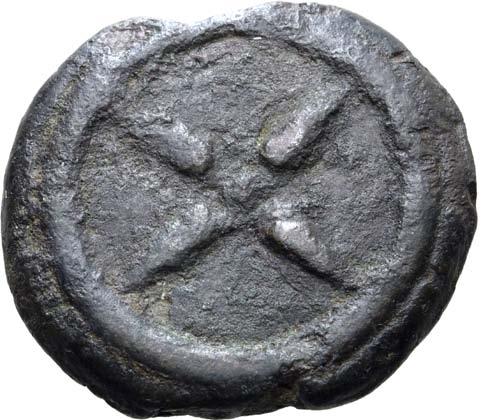





Near Very Fine; graffito to rev. Rare.
Ex Baldwin’s Auctions Ltd, Auction 99, 4 May 2016, lot 573; Ex Hall Collection, purchased from A. H. Baldwin & Sons Ltd., December 1958.
6
150
90
90
60
Etruria, uncertain mint cast Æ Uncia. 3rd century BC. Wheel with six spokes; pellet in field / Bipennis; pellet and Etruscan letter in field. ICC 170b; HN Italy 59. 8.23g, 21mm.
Near Very Fine.
Ex Baldwin’s Auctions Ltd, Auction 99, 4 May 2016, lot 574 (part of); Purchased from A. H. Baldwin & Sons Ltd., 25 September 1955.
Etruria, uncertain inland mint Æ Quartuncia. Circa 300-250 BC. Wheel with six spokes; pellet within / Labrys; V above. ICC 172; HN Italy 61; Vicari 233; Sambon 113. 3.24g, 15mm.









Good Very Fine. Extremely Rare; in exceptional condition for the issue.
Ex Roma Numismatics Ltd., Auction XVIII, 29 September 2019, lot 464.
Etruria, Luca(?) AR 5 Units. Circa 325-300 BC. Laureate young male head to right, Λ behind, dotted border / Blank. EC I, 4.30 (this coin); HN Italy 97; Sambon 101; HGC 1, 62. 11.18g, 23mm.


Good Very Fine.
This coin published in I. Vecchi, Etruscan Coinage Part I, (2012); Ex VCV Collection, Roma Numismatics Ltd., Auction 10, 27 September 2015, lot 9; Ex Numismatica Ars Classica, Auction 29, 11 May 2005, lot 1.
Luca (Modern Lucca) was originally inhabited by a Ligurian population, 20 km inland from the Tyrrhenian Sea and located on an island in the river Auser (Serchio); its territory reached the Arno to the southeast and hence the Etruscan frontier. Numerous recent site finds of Ligurian and Etruscan material excavated by the local superintendency in the surrounding area point to an aggressive confrontation of the two cultures from the fifth century BC, probably with alternating Ligurian and Etruscan occupations. Etruscan coin finds from nearby Gattaiola near Lucca, Ponte Gini in Orentano and Bora dei Frati in Versilia, make it virtually certain that by the third century BC Luca was an Etruscan city, the remains of which probably lie beneath the subsequent Roman and medieval town.
Luca may have been an outpost of Volterrae, the principal city-state of northwest Etruria, or of Pisae, which from the end of the 6th century had become an important Etruscan centre extending its influence into Versilia and Pian di Lucca.
The hippocamp series used a highly original system with value marks CC and C. It is struck on the same weight standard as Populonia’s second Gorgoneion series, but with the 10-units curiously expressed in two multiples of five, CC (5+5 = 10).
Etruria,
Very Fine. Very Rare.
This coin published in I. Vecchi, Etruscan Coinage Part I, (Milan, 2012); Ex Bertolami Fine Arts - ACR Auctions, E-Auction 64, 13 January 2019, lot 7.
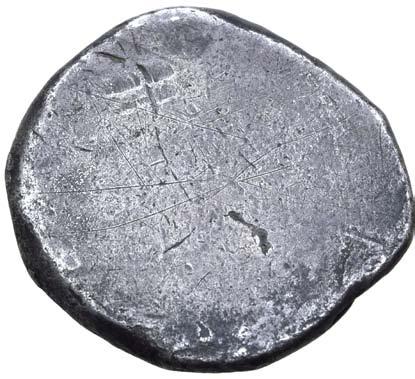

7
20. 45
21. 150
22.
2,100
Luca(?) AR 5 Units. Circa 3rd century BC. Hippocamp to right; dolphins above and below, C below / Blank. EC I, 10.16 (this coin); HN Italy 100; HGC I, 66. 2.13g, 15mm.
23. 210


8
Only Three Examples in Private Hands
Etruria, Populonia AR 20 Units. Early-mid 5th century BC. Amphora with blunt base set in elaborate stand, from the top of which emerges an octopus, tentacles spread to either side; XX below / Blank. EC I, 1.1-5 (O1, misattributed to Pisae); HN Italy 104 (Pisae); SNG ANS 16 (Uncertain mints). 22.59g. 33mm.
Good Very Fine. One of seven recorded examples, of which only three are in private hands, the others being in Basel’s Antikenmuseum, Lisbon’s Gulbenkian Collection, the BM in London, and the ANS collection in New York.
Ex Collection of a Swiss Etruscologist, Roma Numismatics Ltd., Auction XVI, 26 September 2018, lot 4 (hammer: 36,000 GBP).
18,000
The previous attribution to Pisae of the octopus/amphora series was originally based on Garrucci’s statement (Le monete dell’Italia antica 1885, p. 49, 18) that two examples, first published by Bompois 1879, pl. 18, come from Pisa and that the name teuthìs or teuthòs, Greek for octopus, is similar to the ethnic Teuta-Teutones recorded by Pliny and Cato as the name of the first inhabitants of Italian Pisa. However, there is no verifiable evidence for a coin of this type ever having been found in or around Pisa. Authors including Toscanelli 1933 (p. 369 note 2 ), Neppi-Modona 1953 (p. 30h and p. 42 k), Bruni 1993 (pp. 81-82), ASAT (p. 63), Tesei 1992 (p. 196), BTCGI XIII (pp. 597-598) and HN Italy (p. 30) all perpetuated Pisan provenance for the series, without actually attesting to specific finds in Pisa or in the vicinity. Pisa in the 19th and early 20th centuries was then the principal commercial centre of Tuscany to where such collectors’ coins would gravitate, which likely caused this confusion. The amphora 20, 10 and 5 unit issues fit metrologically between the Populonia undenominated Chalkidian weight standard silver animal and monster series, EC I, 1-6, and the first Metus X, 5 and 2.5 denominated series EC I, 7-10. The octopus fractional issues EC I, 7-5 also belong to Populonia in the 3rd century BC.
The design on this coin is impressive for its boldness and novelty, and at the same time highly enigmatic. Depicting an amphora on an elaborate (and probably weighted) stand intended to keep it upright when dropped from a boat into the sea, along with the top of the head of an octopus emerging from the opening with its tentacles splayed outwards on all sides, a quotidian fishing tool is transformed into a powerful sigil for the issuing authority. Along with the ubiquitous Gorgoneion, this type is emblematic of the Etruscan coinage series, though because of its extreme rarity few have ever seen one in hand and so it has for the most part been considered unobtainable by collectors and institutions alike. The elusive nature of the coin is matched by the obscurity of its significance; why the octopus motif occurs repeatedly on the coinage of Populonia is not known. It seems unlikely to be apotropaic in nature despite the qualities (some real, some imagined) attributed to octopodes by the ancients, since though it was known to be a dangerous, crafty and venomous animal, it was evidently also prized as a food source by the coastal Etruscans. The portrayal of the octopus in an amphora therefore suggests a usage similar to that of the crab of Akragas or the barley grain of Metapontion, which represented a prime local produce.

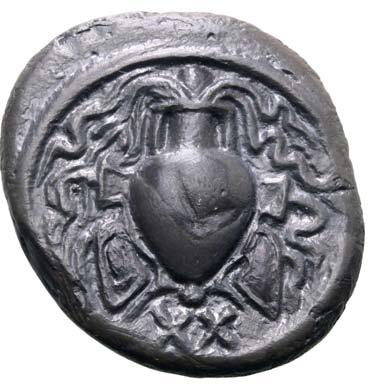
As a powerful marine predator it is tempting to visualise a connection between the recurrent octopus theme and Etruscan naval prowess. Aside from their extensive maritime trade connections, the Etruscans were also renowned for possessing a formidable navy - something which only the richest states could afford to construct, equip and maintain. Indeed, Herodotus credits the Etruscans with the invention of the rostrum - the bronze beak affixed to the prow of warships to ram enemy vessels. Until the 5th century BC the Etruscans had effectively dominated the Tyrrhenian Sea, and at the Battle of Alalia were strong enough to form a combined fleet of 120 warships with the Carthaginians

to resist Greek encroachment and piracy
9
The other principal types of the period - the Chimaera, the lion, the boar, and a marine lion-serpent monster - are clearly carefully chosen for their connotations of strength and intimidatory qualities. A simply mundane significance to this particular issue would therefore seem particularly incongruous. It thus seems highly likely that the ancient observer was intended to infer some deeper level of meaning from this motif, perhaps related to guile and ferocity in a marine context. 24.
Very Rare
Etruria, Populonia AR Drachm. Early 5th century BC. Head and neck of roaring lion to left; dotted border around / Blank. EC I, 5.2 (O1): HN Italy 114; Sambon 17; HGC 1, 85. 3.69g, 16mm.






Extremely Fine. Very Rare.
27 April 2019, lot 5.
Extremely Rare
Etruria, Populonia AR Drachm (5 Units). Early 4th century BC. Amphora; Λ (mark of value) to left / Blank. EC I, 3 (Pisae?); HN Italy 106 (Pisae); HGC 1, 89. 5.72g, 17mm.
Good Very Fine. Extremely Rare; among the finest of just a handful of examples.
lot 4.
Etruria, Populonia AR Unit. 4th - 3rd century. Octopus / Blank. EC I, 5.27 (O3, misattributed to Pisae, this coin); HN Italy 227; HGC 1, 91. 1.07g, 10mm.


Good Very Fine. Very Rare.
This coin published in I. Vecchi, Etruscan Coinage Part 1 (Milan, 2012); Ex Collection of a Swiss Etruscologist, Roma Numismatics Ltd., Auction XVI, 26 September 2018, lot 18; Ex VCV Collection, Roma Numismatics Ltd., Auction X, 27 September 2015, lot 15.
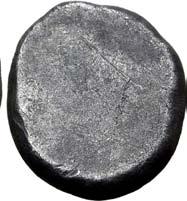




Etruria, Populonia AR Unit. 4th - 3rd century. Octopus / Blank. EC I, 5 (O1, misattributed to Pisae); HN Italy 227; HGC 1, 91. 1.18g, 12mm.

Good Very Fine.
Ex Vitangelo Collection, Roma Numismatics Ltd., E-Sale 86, 8 July 2021, lot 56.
10
Ex Artemide Aste s.r.l., Auction
2,100
51,
25.
Ex Artemide Aste s.r.l., Auction LIII,
2,400 26.
2 May 2020,
600
27.
450 28. 2x
2x 2x
2x
Etruria, Populonia AR Unit. 4th - 3rd century BC. Eagle with closed wings standing to right / I (mark of value). Unpublished in the standard references, cf. Roma E-108, 24; Roma XXVII, 17; Roma XXI, 9; X, 16 and 17. 1.02g, 12mm.
Extremely Fine. Extremely Rare; unpublished and apparently one of only seven known.
Ex Vitangelo Collection, Roma Numismatics Ltd., E-Sale 77, 26 November 2020, lot 108 (collector’s ticket included, previously sold for 3,800 GBP).
Etruria, Populonia AR Unit. 4th - 3rd century BC. Eagle with closed wings standing to right / I (mark of value). Unpublished in the standard references, cf. Roma E-108, 24; Roma XXVII, 17; Roma XXI, 9; E-77, 108; X, 16 and 17. 0.94g, 12mm.



Good Very Fine. Extremely Rare; unpublished in the standard references.
Etruria, Populonia AR Didrachm (10 Units). Circa 425-400 BC. Head of Metus facing, hair bound with diadem, X below, dotted border / Blank. EC I, 8.1-20 (O1); HN Italy 117; HGC 1, 92. 7 65g, 22mm.





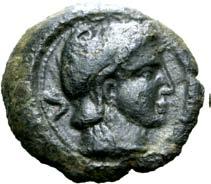
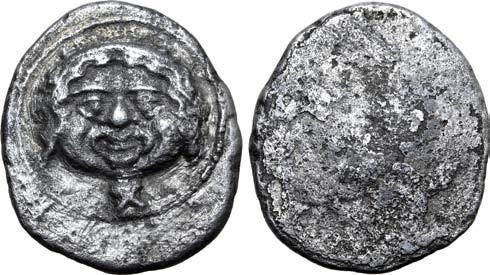




Good Very Fine; porous metal. Ex Vitangelo Collection, Roma Numismatics Ltd., Auction XXII, 7 October 2021, lot 124.



Etruria, Populonia Æ 5 Units. Late 4th - 3rd century BC. Young male head to right, wearing Phrygian helmet; V (mark of value) behind / Incuse cross shape, within linear border. EC I, 13.6 (O1/R1, Uncertain Central Etruria); HN Italy 87 (Uncertain Central Etruria); HGC I, 170. 2.80g, 17mm.
Good Very Fine. Very Rare.
Ex Collection of a Swiss Etruscologist, Roma Numismatics Ltd., Auction XVI, 26 September 2018, lot 21.
Etruria, Populonia Æ 5 Units. Late 4th - 3rd century BC. Young male head to right, wearing Phrygian helmet; V (mark of value) behind / Traces of incuse cross shape, within linear border. EC I, 13.6 (O1), (Uncertain Central Etruria); HN Italy 87 (Uncertain Central Etruria); HGC 1, 170. 2.33g, 16mm.
Good Very Fine. Rare.
Ex Vitangelo Collection, Roma Numismatics Ltd., E-Sale 77, 26 November 2020, lot 99.
11
2,100
2x 2x
29.
One of Seven Known
150
2x 2x
30.
600
31.
900
32.
90
33.
Etruria, Populonia AR Unit. 4th century BC. Male head to right; I (mark of value) before / Blank. EC I, 16 (O2); HN Italy 122; Sambon 79; HGC 1, 99. 0.66g, 12mm.
Good Very Fine. Extremely Rare; only a handful known from these dies. Ex Artemide Aste s.r.l., Auction 55E, 26 June 2021, lot 5.
Etruria, Populonia AR Unit. 4th century BC. Wheel with long crossbar, central pin supported by two curved struts / Blank. EC I, 19.1-5 (O1); HN Italy 126; SNG Firenze 79-80; HGC 1, 100. 0.61g, 11mm.
Very Fine; pleasant old cabinet tone. Extremely Rare; one of fewer than ten known examples.
Ex Collection of a Swiss Etruscologist, Roma Numismatics Ltd., Auction XVI, 26 September 2018, lot 11.
Etruria, Populonia AR Unit. 4th century BC. Wheel with long crossbar, central pin supported by two curved struts / Blank. EC I, 19.5 (this coin); HN Italy 126; HGC I, 100. 0.73g, 10mm.








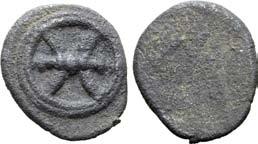





Good Very Fine. Very Rare.
This coin published in I. Vecchi, Etruscan Coinage Part 1 (Milan, 2012); Ex Vitangelo Collection, Roma Numismatics Ltd., Auction XXI, 24 March 2021, lot 11 (collector’s ticket included);

Etruria, Populonia AR Unit. 4th century BC. Wheel with long crossbar, central pin supported by two curved struts / Blank. EC I, 19 (O2); HN Italy 126; HGC I, 102. 0.87g, 12mm.
Extremely Fine. Very Rare.
Ex collection of a British Connoisseur, Part II, Artemide Aste s.r.l., Auction 52, 26 October 2019, lot 19.
Etruria, Populonia AR Unit. 4th century BC. Wheel with long crossbar, central pin supported by two curved struts / Blank. EC I, 19 (O2); HN Italy 126; HGC I, 102. 0.87g, 12mm.
Good Very Fine. Very Rare.
Artemide Aste s.r.l., Auction 50, 3 November 2018, lot 4.
12
300
2x 2x
34.
1,200
35.
Ex Astarte S.A., Auction 7, 10 October 2001,
5. 600 36.
lot
600
37.
Ex
450 38. 2x 2x 2x 2x 2x 2x 2x 2x
Etruria, Populonia AR 10 Asses. 3rd century BC. Laureate head to right; ‘pvplvna’ behind, [‘metl’] before, X (mark of value) behind / Blank. EC I, 7.12 (O1, unidentified mints); HN Italy 191; SNG Firenze 1169. 2.51g, 28mm.
Very Fine. Extremely Rare; the third recorded example, and the first to reveal the ethnic ‘pvplvna’ which securely attributes this issue to Populonia.
Ex Artemide Aste, Auction LIV, 7 November 2020, lot 15; Ex collection of a British Connoisseur, part II, Artemide Aste, Auction LI, 27 April 2019, lot 27.
Etruria, Populonia AV 10 Asses. Circa 300-250 BC. Bare male head to right; X (mark of value) below chin / Blank. EC I, 29.14 (O2, this coin); HN Italy 135; Sambon 7; Vicari 27; HGC 1, 80. 0.54g, 8mm.

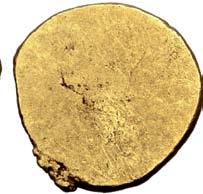








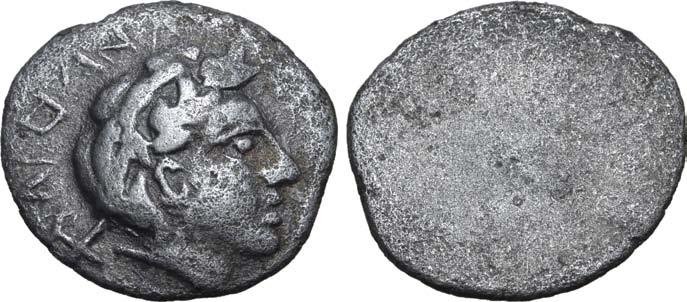
Good Extremely Fine. Very Rare.
This coin published in I. Vecchi, Etruscan Coinage Part 1 (Milan, 2012); Ex Roma Numismatics Ltd., E-Sale 77, 26 November 2020, lot 100; Ex Classical Numismatic Group, Mail Bid Sale 84, 5 May 2010, lot 21 (hammer: 2,200 USD);
Ex Classical Numismatic Group, Triton XII, 6 January 2009, lot 14;
Ex Numismatik Lanz München, Auction 135, 21 May 2007, lot 37
1,500
1,200
Etruria, Populonia AR 20 Asses. Circa 300-250 BC. Facing head of Metus, hair bound with diadem; X:X (mark of value) below / Traces of ‘poplv’ in Etruscan script. EC I, 37.237 (this coin, O1/R1); HN Italy 142; Sambon 59.1; HGC 1, 103. 8.39g, 25mm.
Extremely Fine; pleasant old cabinet tone.
This coin published in I. Vecchi, Etruscan Coinage Part 1 (Milan, 2012); Ex Baldwin’s Auctions Ltd., Auction 99, 4 May 2016, lot 541; Ex Lord Renfrew Collection, bought from Seaby, 1955.


Etruria, Populonia AR 20 Asses. Circa 300-250 BC. Facing head of Metus, hair bound with diadem; X:X (mark of value) below / Club. EC I, 46.1-17 (O12/R16); HN Italy 149. 8.50g, 24mm.
Good Very Fine. Very Rare.
Ex Collection of a Swiss Etruscologist, Roma Numismatics Ltd., Auction XVI, 26 September 2018, lot 28.
13
39.
One of Three Known
40.
360
41.
300
2x 2x
42.
Etruria, Populonia AR 20 Asses. Circa 300-250 BC. Facing head of Metus; X:X (mark of value) below / Kerykeion. EC I, 48 (O14/R18); HN Italy 150; HGC 1, 112. 8.29g, 22mm.
Very Fine.
Ex Vitangelo Collection, Roma Numismatics Ltd., E-Sale 86, 8 July 2021, lot 59.
Etruria, Populonia AR 20 Asses. Circa 300-250 BC. Facing head of Metus; X:X (mark of value) below / Two kerykeia. EC I, 48 (O14/R18); HN Italy 150; HGC 1, 112. 6.56g, 28mm.
Good Very Fine.
Ex Vitangelo Collection, Roma Numismatics Ltd., E-Sale 86, 8 July 2021, lot 60.
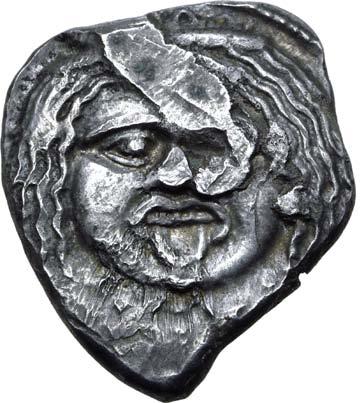

Etruria, Populonia AR 20 Asses. Circa 300-250 BC. Facing head of Metus; X X (mark of value) below / Blank. EC I, 52.199 (O20); HN Italy 142; HGC 1, 113. 8.21g, 20mm.




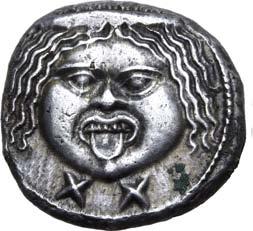

Extremely Fine. Rare in this state of preservation and without the die break.
Ex Jesus Vico S. A., Auction 159, 20 July 2021, lot 305.
1,050
Etruria, Populonia AR 20 Asses. Circa 300-250 BC. Facing head of Metus; X : X (mark of value) below / Blank. EC I, 52 (O20); HN Italy 142; HGC 1, 113. 8.36g, 24mm.




Near Extremely Fine; with usual die break on obverse.
Ex Vitangelo Collection, Roma Numismatics Ltd., E-Sale 86, 8 July 2021, lot 63.
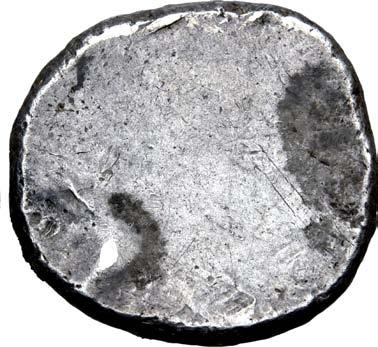
14
300
43.
300
44.
45.
300
46.
Etruria, Populonia AR 20 Asses. 3rd century BC. Facing head of Metus; X : X (mark of value) below / Blank. EC I, 52.125 (O20); HN Italy 142; Sambon 59; HGC 1, 113. 8.32g, 22mm.
Good Very Fine.
Ex Baldwin’s Auctions Ltd., Auction 99, 4 May 2016, lot 550; Sold with ticket noting ex Adolphe Menjou collection, Kreisberg & Schulman, New York, 25-26 January 1957, lot 2765/6 (part of), which is published in EC 1, 52.125 with a different plate.
Etruria, Populonia AR 20 Asses. Circa 300-250 BC. Facing head of Metus; X : X (mark of value) below / Blank. EC I, 58 (O31); HN Italy 142; HGC 1, 113. 8.36g, 21mm.
Near Extremely Fine; pleasant old cabinet tone. Acquired from Artemide Aste s.r.l.
Etruria, Populonia AR 20 Asses. Circa 300-250 BC. Facing head of Metus; X : X (mark of value) below / Blank. EC I, 58 (O32); HN Italy 142; HGC 1, 113. 8.22g, 23mm.

Extremely Fine; minor scrape to cheek, a well-detailed example of the type. Ex Roma Numismatics Ltd., E-Sale 90, 18 November 2021, lot 7.
Etruria, Populonia AR 20 Asses. Circa 300-250 BC. Facing head of Metus, hair bound with diadem; X X (mark of value) below / Blank. EC I, 60.11102 (O38); HN Italy 152. 8.54g, 25mm.





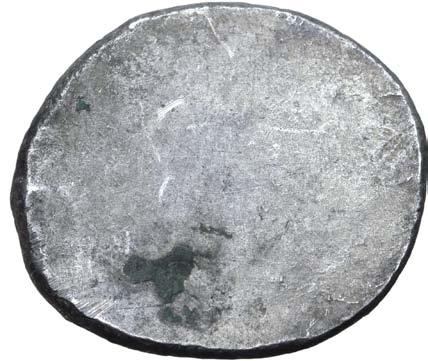

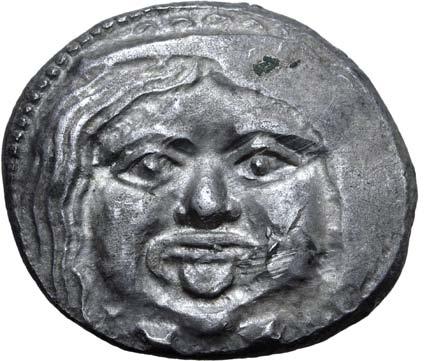

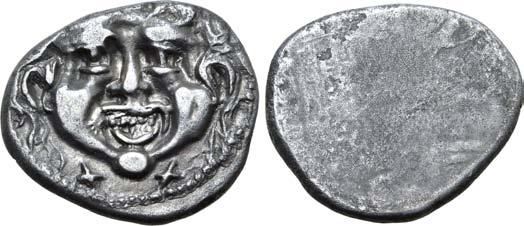


Near Extremely Fine.
Ex Collection of a Swiss Etruscologist, Roma Numismatics Ltd., Auction XVI, 26 September 2018, lot 40.
900
Etruria, Populonia AR 20 Asses. Circa 300-250 BC. Facing head of Metus; X X (mark of value) below / Blank. EC I, 60 (O37); HN Italy 152; HGC 1, 109. 6.89g, 22mm.
About Extremely Fine. Very Rare; only two other recorded examples from this die with prominent sharp features. Ex Vitangelo Collection, Roma Numismatics Ltd., Auction XXII, 7 October 2021, lot 127.

600
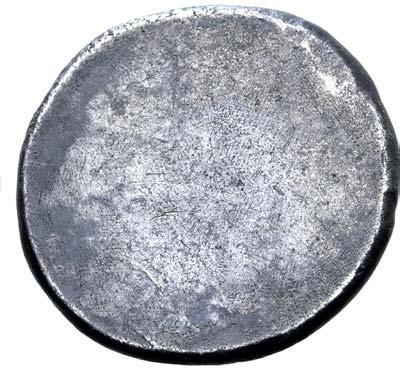
15
900
48.
450
49.
50.
51.
240
47.
Etruria, Populonia AR 20 Asses. Circa 300-250 BC. Facing head of Hercle, wearing lion’s skin knotted at neck; X X (mark of value) below / Blank. EC I, 65.1-107 (O1); HN Italy 155; HGC 1, 115. 8.40g, 20mm.


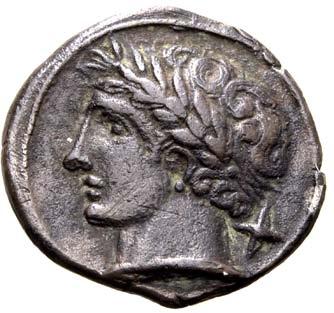




Very Fine.
Ex Collection of a Swiss Etruscologist, Roma Numismatics Ltd., Auction XVI, 26 September 2018, lot 44.
450
Etruria, Populonia AR 20 Asses. Circa 300-250 BC. Facing head of Hercle, wearing lion’s skin knotted at neck; X X (mark of value) below / Club. EC I, 66.1-41 (O2/R1); HN Italy 156; HGC 1, 116. 8.29g, 22mm.
Very Fine.
Ex Collection of a Swiss Etruscologist, Roma Numismatics Ltd., Auction XVI, 26 September 2018, lot 49.
Ex Kovacs 16, 2004
Etruria, Populonia AR 10 Asses. Circa 300-250 BC. Laureate male head to left, slightly bearded; X (mark of value) behind / Blank. EC I, 70.87 (O1, this coin); HN Italy 168; Sambon 73-4. 4.22g, 18mm.






Extremely Fine; pleasant light cabinet tone.
This coin published in I. Vecchi, Etruscan Coinage Part 1 (Milan, 2012); Ex Artemide Aste s.r.l., Auction 20, 12 April 2008, lot 19; Ex Dix Noonan Webb, Auction 73A, 14 March 2007, lot 2031; Ex F. Kovacs, Sale 16, 29 September 2004, lot 5.

Etruria, Populonia AR 10 Asses. Circa 300-250 BC. Laureate male head to left, slightly bearded; X (mark of value) behind / Blank. EC I, 70.1-141 (O1); HN Italy 168; HGC 1, 120. 3.17g, 18mm.

Near Extremely Fine.
Ex Collection of a Swiss Etruscologist, Roma Numismatics Ltd., Auction XVI, 26 September 2018, lot 50.
600
Etruria, Populonia AR 10 Asses. Circa 300-250 BC. Laureate male head to left, slightly bearded; X (mark of value) behind / Blank. EC I, 70.159-264 (O3); HN Italy 168; HGC 1, 120. 4.01g, 19mm.
Very Fine; pleasant old cabinet tone.
Ex Collection of a Swiss Etruscologist, Roma Numismatics Ltd., Auction XVI, 26 September 2018, lot 52.
480
450
16
52.
53.
54.
55.
450
56.
Etruria, Populonia AR 10 Asses. Circa 300-250 BC. Laureate male head to left, slightly bearded; X (mark of value) behind / Blank. EC I, 70 (O3); HN Italy 168; HGC 1, 120. 3.98g, 19mm.

Near Extremely Fine.
Ex Vitangelo Collection, Roma Numismatics Ltd., E-Sale 86, 8 July 2021, lot 60 (collector’s ticket included).
Etruria, Populonia AR 10 Asses. Circa 300-250 BC. Laureate male head to left / Dolphin to right. EC I, 72 (O12); HN Italy -; HGC 1, -. 2.56g, 16mm.


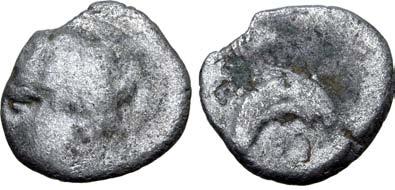
Near Very Fine. Extremely Rare; possibly only the third known example.
Ex Artemide Aste s.r.l., Auction 55E, 26 June 2021, lot 6.
Etruria, Populonia AR 10 Asses. Circa 300-250 BC. Female head to right, wearing broad hair band and triple-pendant earring; + (mark of value) behind / Blank. EC I, 75.41-63 (O12); HN Italy 165; HGC 1, 123. 3.99g, 18mm.

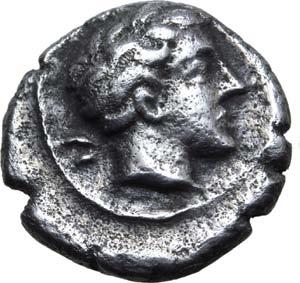





Very Fine; pleasant old cabinet tone.
Ex Collection of a Swiss Etruscologist, Roma Numismatics Ltd., Auction XVI, 26 September 2018, lot 55.
Etruria, Populonia AR 5 Asses. 3rd century BC. Diademed and bearded male head to right; V (mark of value) behind / Blank. EC I, 89 (O1); HN Italy 174; Sambon 98; HGC 1, 132. 2.02g, 15mm.
Good Very Fine. Rare.
Ex Artemide Aste s.r.l., Auction 52, 26 October 2019, lot 26.
Etruria, Populonia AR 5 Asses. 3rd century BC. Male head to right, V (mark of value) behind / Blank. EC I, 90.23 (O6, this coin); HN Italy 170; Sambon 81; HGC 1, 133. 1.81g, 13mm.


Very Fine. Very Rare; only two other examples on CoinArchives.
This coin published in I. Vecchi, Etruscan Coinage Part 1 (Milan, 2012); Ex Collection of a Swiss Etruscologist, Roma Numismatics Ltd., Auction XVI, 26 September 2018, lot 66; Ex VCV Collection, Roma Numismatics X, 27 September 2015, lot 59.


17
180
58.
600
59.
240
60.
300
2x 2x
61.
300
57.
62.
Etruria, Populonia AR 5 Asses. 3rd century BC. Young male head to left; V (mark of value) behind / Blank. EC I, 91; HN Italy 163; HGC 1, 132. 1.89g, 14mm.
Near Extremely Fine; encrustations to rev. Extremely Rare.
Ex Artemide Aste s.r.l., Auction 54, 7 November 2020, lot 18.
750
63.
Etruria, Populonia AR 5 Asses. 3rd century BC. Owl standing to left, head facing; V (mark of value) to left / Blank. EC I, 94.1 (O1, same die); HN Italy 225; Sambon 32; HGC 1, 135. 1.78g, 14mm.
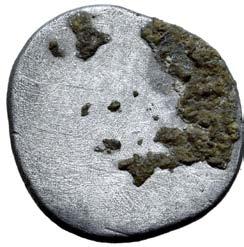

Extremely Fine. Extremely Rare, apparently only the fifth known example, and one of just three in private hands.
Ex VCV Collection, Roma Numismatics Ltd., Auction 10, 27 September 2015, lot 62.
Possibly the Third Known
64.
900
Etruria, Populonia AR Unit. 3rd century BC. Male head to left; I (mark of value) behind / Blank. EC I, 108 (O1); HN Italy -; HGC 1, 139. 0.39g, 9mm.




Near Extremely Fine. Extremely Rare; possibly the third known.
Ex Artemide Aste s.r.l., Auction 51, 27 April 2019, lot 37.
450
Etruria, Populonia AR Drachm. 3rd century BC. Hare leaping to right / Blank. EC I, 116.5 (O2); HN Italy 223; Sambon 31; SNG ANS 22; HGC 1, 144. 3.60g, 16mm.
Good Very Fine. Extremely Rare, one of only a handful of known examples from this die.
Ex collection of a British Connoisseur, Part II, Artemide Aste s.r.l., Auction 52, 26 October 2019, lot 33.
1,200
The hare was a popular motif in Etruscan art, particularly on surviving pottery and bronze ware. A bronze statuette sold by Royal Athena Galleries (New York) portrays a standing figure of Turms holding a sacrificial hare and the remains of a knife. The possibility therefore of the hare shown here representing a sacrificial animal or a symbolic attribute of swift-footed Turms (perhaps as the lion-skin diobol [see following lot] relates to Hercle?) should not be ignored, though the depiction of other animals including dolphins and octopodes (see following lots) also cannot yet be satisfactorily explained.
Etruria, Populonia AR Obol. 3rd century BC. Two dolphins / Blank. EC I, 122; HN Italy 231 (uncertain mints); HGC 1, 152. 0.73g, 11mm.





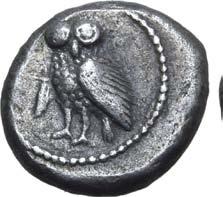




Very Fine. Very Rare.
Ex collection of a British Connoisseur, Part II, Artemide Aste, Auction LII, 26 October 2019, lot 34.
18
65.
180
2x 2x 2x 2x
66.
Etruria, Populonia AR Unit. 3rd century BC. Amphora / Large I (mark of value). Unpublished in the standard references, for obv. type, cf. EC I, 129 (O1); cf. HGC 1, 154; Roma XXVII, 16. 0.95g, 10mm.
Good Very Fine. Extremely Rare; unpublished with this reverse type, only two examples on CoinArchives.
Ex collection of a British Connoisseur, Part II, Artemide Aste s.r.l., Auction 52, 26 October 2019, lot 36.
This newly discovered series with a clear mark of value seems to be on a similar silver unit weight standard to series EC I, 12-16 and 17-19. The use of an amphora as the principal design should of course not surprise us considering its appearance on EC I, 129 and (albeit in more elaborate form) on EC I, series 1-3 formerly attributed to Pisae.
Etruria, Populonia Æ Uncia. Circa 215-211 BC. Female head to right, hair in band, • (mark of value) behind / Two crescents and four stars. EC I, 131.1 (this coin); HN Italy 116; HGC 1, 182. 5.67g, 23mm.

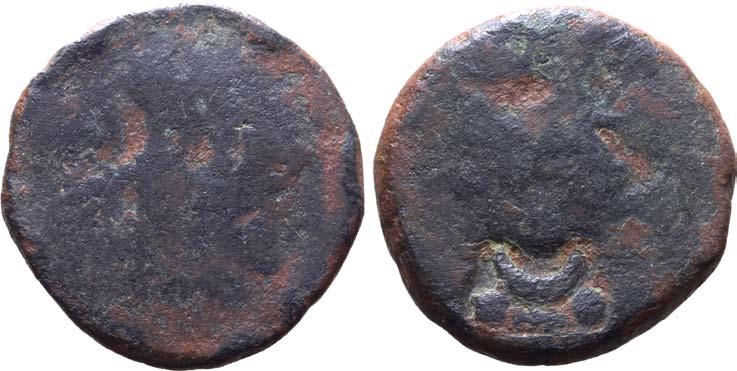








Good Fine. Extremely Rare, one of only two known examples.
This coin published in I. Vecchi, Etruscan Coinage Part 1 (Milan, 2012); Ex VCV Collection, Roma Numismatics Ltd., Auction X, 27 September 2015, lot 85.
Etruria, Populonia Æ Triens. Circa 215-211 BC. Head of Menvra to right, wearing Corinthian helmet, •••• (mark of value) below / Etruscan legend ‘pvplvna’, owl facing with wings spread, •••• (mark of value) between; countermarked crescent over line with two pellets. EC I, 133.26 (this coin); HN Italy 184; Sambon 114; HGC 1, 175. 20.14g, 30mm, 11h.
Very Fine, weakly struck. Rare.
This coin published in I. Vecchi, Etruscan Coinage Part 1 (Milan, 2012); Ex VCV Collection, Roma Numismatics Ltd., Auction 10, 27 September 2015, lot 87.
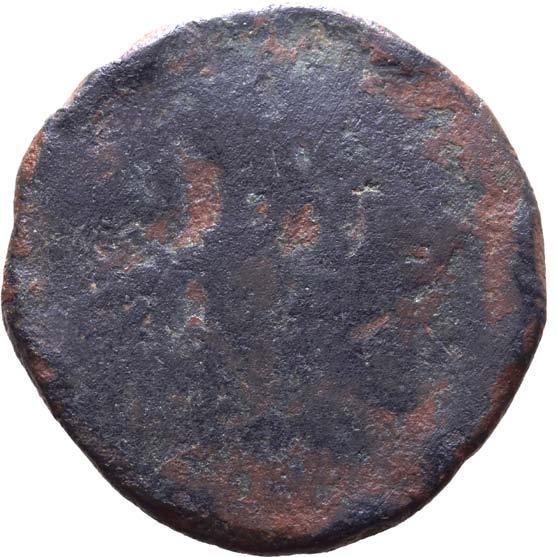
The main bronze issues are made up of various denominations tariffed in unciae (represented by pellets) on a weight standard based on a nominal bronze as of 81g which was extant in Rome after the post-semilibral phase of c. 215-212 BC (Crawford 1974, 41).

Etruria, Populonia Æ Sextans. Circa 215-211 BC. [Head of Menvra to right, wearing Corinthian helmet, •••• behind]/ [Etruscan legend ‘pvplvna’, owl standing facing, wings spread, between two stars; •••• above]; c/m: two pellets, line and crescent. EC I, 133.30-34; HN Italy 184; Sambon 114. 12.78g, 26mm, 8h.
Good Fine; most of design illegible.
Ex Jesus Vico S.A., Auction 150, 1 March 2018, lot 63.
19
600 67.
120
68.
450
2x 2x
69.
90
70.
71.
Etruria, Populonia Æ Sextans. Circa 215-211 BC. Head of Menvra to right, wearing Corinthian helmet, •• (mark of value) above / Etruscan legend ‘pvplvna’, owl standing to right on two pellets, crescent with two stars flanking above. EC I, 135.48 (same dies); HN Italy 186; Sambon 117; HGC 1, 180. 14.75g, 26mm, 1h.
Very Fine. Rare.
Ex VCV Collection, Roma Numismatics Ltd., Auction 10, 27 September 2015, lot 88.
72.
Etruria, Populonia Æ Sextans. Circa 215-211 BC. Head of Menvra to right, wearing Corinthian helmet, •• (mark of value) above / Etruscan legend ‘pvplvna’, owl standing to right on two pellets, crescent with two stars flanking above. EC I, 135.68 (this coin); HN Italy 186; Sambon 117; HGC 1, 180. 12.78g, 26mm, 8h.










Good Very Fine. Rare.
This coin published in I. Vecchi, Etruscan Coinage Part 1 (Milan, 2012); Ex Baldwin’s Auctions Ltd., Auction 99, 4 May 2016, lot 566; Purchased from Spink & Son Ltd, 9 April 1959.
150
Etruria, Populonia Æ Sextans. Circa 215-211 BC. Diademed head of young Hercle to right, club over shoulder / Etruscan legend ‘pvplvna’, bow, arrow and club, •• (mark of value) between. EC I, 136.15 (this coin); HN Italy 187; Sambon 116; HGC 1, 181. 12.22g, 28mm, 5h.


Good Very Fine. Rare, and unusually well preserved for this issue.
This coin published in I. Vecchi, Etruscan Coinage Part 1 (Milan, 2012); Ex VCV Collection, Roma Numismatics Ltd., Auction 10, 27 September 2015, lot 90.
1,200
Etruria, Populonia Æ Sextans. Circa 215-211 BC. Diademed head of young Hercle to right, club over shoulder / Etruscan legend ‘pvplvna’, bow, arrow and club, •• (mark of value) between. EC I, 136.18 (this coin); HN Italy 187; Sambon 116; HGC 1, 181. 13.67g, 30mm, 5h.
Very Fine; edge split. Rare.
This coin published in I. Vecchi, Etruscan Coinage Part 1 (Milan, 2012); Ex Baldwin’s Auctions Ltd., Auction 99, 4 May 2016, lot 567; Ex Lord Renfrew Collection, purchased from Spink & Son Ltd, 21 September 1960.
20
600
73.
120
74.
Etruria, Populonia Æ 11 Units. Circa 215-211 BC. Bust of Turms to right, wearing winged petasos; crescent to left / Etruscan legend ‘pvplvna’ between two kerykeia; X/ between. EC I, 139.1-7 (O1/R1); HN Italy 190; SNG ANS 96; HGC 1, 184. 11.51g, 27mm, 1h. Good Very Fine; light sage-green patina and uncommonly attractive for this issue.



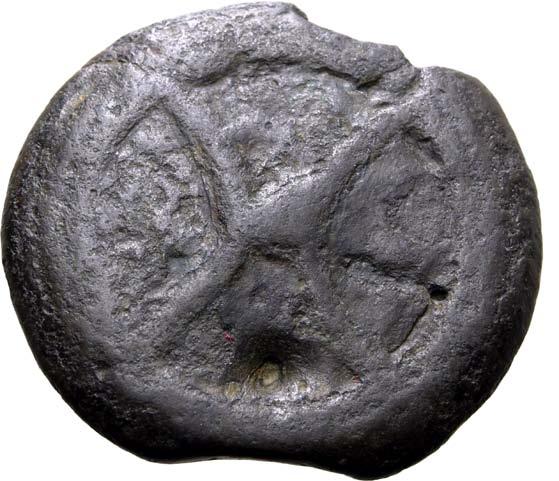



Ex Collection of a Swiss Etruscologist, Roma Numismatics Ltd., Auction XVI, 26 September 2018, lot 80.
Etruria, Populonia Æ Triens of 10 Units. Circa 215-211 BC. Bust of Sethlans to right, wearing pileus decorated with laurel-wreath, X behind / Etruscan legend ‘pvplvna’ below hammer and tongs, •••• between. EC I, 140.54 (this coin); HN Italy 195; Sambon 119; HGC 1, 183. 8.04g, 24mm, 3h.




Very Fine. Rare.
This coin published in I. Vecchi, Etruscan Coinage Part 1 (Milan, 2012); Ex VCV Collection, Auction X, 27 September 2015, lot 92.
The final bronze issues (EC I, 139-140) are also tariffed with X and /X and may be metrologically connected with the remarkable struck bronze coins with incuse reverse and marks of value 1 to 100, cf. Uncertain Central Italy, EC I, 1-17.

Etruria, Populonia Æ Triens of 10 Units. Circa 215-211 BC. Bust of Sethlans to right, wearing pileus decorated with laurel-wreath, X behind / Etruscan legend ‘pvplvna’ below hammer and tongs, •••• (mark of value) between; c/m: •••• in incuse oval. EC I, 140.98; HN Italy 195; HGC I, 183. 7.64g, 27mm, 8h.
Very Fine; traces of overstrike on Menvra/Owl Sextans to obv.(?)
Ex Artemide Aste s.r.l., Auction 51, 27 April 2019, lot 46.
Etruria, Val di Chiana Cast Æ Sextans. 3rd century BC. Cross-bar wheel within double ring / Two pellets within double ring. ICC 186; HN Italy 64e. 18.21g, 30mm.
Good Fine.
Ex Vitangelo Collection, Roma Numismatics Ltd., E-Sale 86, lot 97 (collector’s ticket included).
21
600
75.
600
76.
60
77.
90
78.
Etruria, Val di Chiana Æ Uncia. 3rd century BC. Head of African to right, wearing earring / Indian elephant standing to right with bell at neck. HN Italy 69; Sambon 145. 4.13g, 19mm, 6h.
Very Fine. Rare.
Ex VCV Collection, Roma Numismatics Ltd., Auction 10, 27 September 2015, lot 102.


Ex Lockett and Lord Grantley Collections
Etruria, Val di Chiana Æ Uncia. 3rd century BC. Head of African to right, wearing earring / Indian elephant standing to right with bell at neck; Etruscan letter ‘m’ below. HN Italy 69; Sambon 145. 4.68g, 19mm, 7h.
Very Fine. Rare.
Ex Baldwin’s Auctions Ltd, Auction 99, 4 May 2016, lot 584; Ex Richard Cyril Lockett Collection (Part I), Glendining’s, 25 October 1955, lot 29 (part of); Ex Lord Grantley Collection (Part I), Glendining’s, 29 November 1943, lot 242.
Etruria, Val di Chiana Æ Uncia. 3rd century BC. Head of African to right, wearing earring / Indian elephant standing to right with bell at neck. HN Italy 69; Sambon 145. 5.21g, 19mm, 7h.


Near Very Fine. Rare.
Ex Baldwin’s Auctions Ltd, Auction 99, 4 May 2016, lot 582; Purchased from Spink & Son Ltd, November 1954.
Etruria, Val di Chiana Æ Semuncia. 3rd century BC. Head of Śelvanś to right, wearing feline skin headdress / Volpino prancing to left; Etruscan letter ś below. HN Italy 70; Sambon 146a. 2.51g, 15mm, 6h.
Very Fine. Very Rare.
Ex Bertolami Fine Arts - ACR Auctions, Auction 12, 29 October 2014, lot 4.
Etruria, Val di Chiana Æ 15mm. 3rd century BC. Laureate head of Apollo to right, quiver over shoulder; Etruscan ‘C’ in right field / Owl standing to right, head facing; Etruscan ‘C’ in right field. HN Italy 74; Sambon 130. 2.82g, 15mm, 6h.






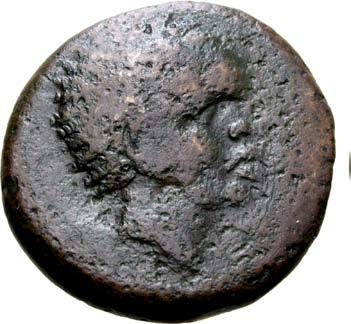




Very Fine.
Ex Baldwin’s Auctions Ltd., Auction 99, 4 May 2016, lot 579; Purchased from A. H. Baldwin & Sons Ltd., 17 April 1957 (misdescribed as Velia).
22
180
80.
60
81.
150
82.
90
83.
600
79.
Etruria, Vetulonia Æ Uncia. 3rd century BC. Female head to right; Etruscan script behind / Blank. EC I, 1 (O1); HN Italy 198; Sambon -. 10.36g, 22mm.



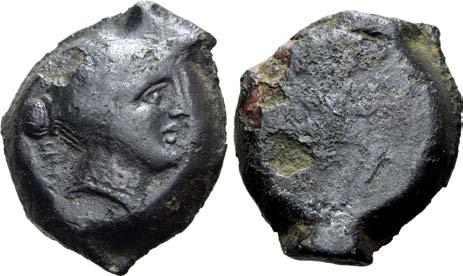
Very Fine. Very Rare; particularly in this condition. Acquired from Artemide Aste s.r.l.
Etruria, Vetulonia Æ Semuncia. 3rd century BC. Male head to right, wearing pileos; Etruscan legend ‘vatl’ behind / Steering oar. EC I, 5; HN Italy 199; HGC 1, 202. 5.04g, 28mm.

Near Very Fine. Very Rare.
Ex Bertolami Fine Arts - ACR Auctions, E-Auction 64, 13 January 2019, lot 10.
Etruria, Vetulonia Æ Sextans. Late 3rd century BC. Head of Nethuns to right; Etruscan legend ‘vatl’ behind / Trident head flanked by dolphins; two pellets across fields. EC I, 11 (O2/R3); HN Italy 190; HGC 1, 203. 9.68g, 24mm, 7h.






Very Fine.
Ex Vitangelo Collection, Roma Numismatics Ltd., E-Sale 86, lot 107 (collector’s ticket included).
Etruria or Umbria, possibly Volsinii Cast Æ Sextans. 3rd century BC. Club / Two pellets. ICC 199; HN Italy 54; for a tentative identification of this issue’s minting authority, cf. M. Crawford ‘The oval series of aes grave’ in CH 9 (2002), pp. 269-270. 19.63g, 29mm.

Very Fine.
Ex Vitangelo Collection, Roma Numismatics Ltd., E-Sale 86, lot 55.
23
450
84.
90
85.
210
86.
120
87.
88.
Etruria or Umbria, possibly Volsinii Cast Æ Sextans. 3rd century BC. Club / Two pellets. ICC 199; HN Italy 54; for a tentative identification of this issue’s minting authority, cf. M. Crawford ‘The oval series of aes grave’ in CH 9 (2002), pp. 269-270. 24.76g, 29mm.
Very Fine.
Ex Vitangelo Collection, Roma Numismatics Ltd., E-Sale 86, lot 54 (collector’s ticket included).
89.
Etruria or Umbria, possibly Volsinii Cast Æ Sextans. 3rd century BC. Club / Two pellets. ICC 199; HN Italy 54; for a tentative identification of this issue’s minting authority, cf. M. Crawford ‘The oval series of aes grave’ in CH 9 (2002), pp. 269-270. 26.28g, 29mm.
Near Very Fine.
90.
Etruria or Umbria, possibly Volsinii Cast Æ Sextans. 3rd century BC. Club / Two pellets. ICC 199; HN Italy 54; for a tentative identification of this issue’s minting authority, cf. M. Crawford ‘The oval series of aes grave’ in CH 9 (2002), pp. 269-270. 20.33g, 29mm.
Near Very Fine.
91.
Etruria, Volterrae cast Æ Quadrans. 3rd century BC. Janiform head / Club; Etruscan ‘velaΘri’ around, four pellets (mark of value) around. ICC 139; HN Italy 109e. 32.58g, 37mm, 6h.
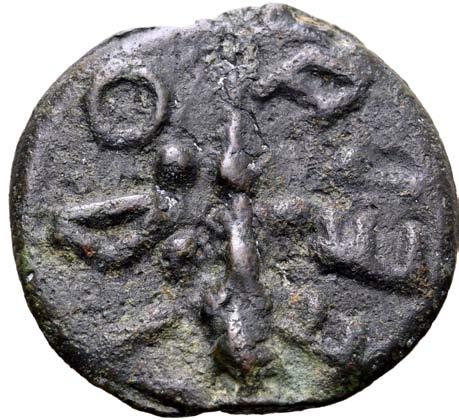











Very Fine.
Ex St. James’s Auctions Ltd., Auction 49, 5 October 2021, lot 1002.
450
24
120
90
90
Of Great Historical Importance
93. SAMNIUM 0.29x 19.5kg
Central Italy, uncertain mint cast Æ Aes Formatum. Circa 6th-4th century BC. Disk-shaped with rounded obverse / Flat. ICC -; cf. Haeberlin p. 4, pl. 2 var. (weight); cf. Nomos AG, obolos 25, 568 var. (weight), cf. Oslo Myntgalleri AS 28, 227 var. (shape) (hammer: 500,000 NOK). 19.5kg, 275mm. Condition as seen; some areas of active corrosion. Extremely rare and of great historical importance; only one other on CoinArchives of a comparable weight.



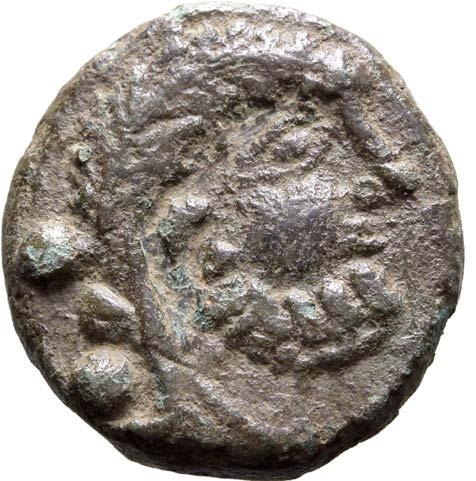

From the Vitangelo Collection.
Haeberlin dubbed this very rare bronze currency, which was successor to aes rude and precursor to the issues of aes grave, aes formatum.
12,000
25
CENTRAL ITALY
PLEASE NOTE: Due to this lot’s weight and size, shipping or collection is to be arranged directly with our shipping team. 92.
Samnium, Meles Cast Æ Sextans. Time of Hannibal, 216-210 BC. Bearded head of Hercules-Baal to right, club over shoulder; •• (mark of value) behind / African elephant with mahout advancing to right. ICC 325 var. (elephant to left); Garrucci pl. 66, 5. 18.65g, 28mm, 12. Good Very Fine. Extremely Rare; seemingly no others offered at auction in over twenty years. 1,500
CAMPANIA
Campania, Neapolis AR Didrachm. Circa 320-300 BC. Diophanes, magistrate. Diademed head of nymph to right, wearing triple-pendant earring and pearl necklace; grape bunch behind, [ΔIOΦANOYΣ] below / Nike flying to right crowning man-headed bull advancing to right; monogram below bull, NEOΠOΛITH[Σ] in exergue. HN Italy 571; Sambon 439; Pozzi 82; SNG ANS 318 (same dies); HGC 1, 451. 7.53g, 19mm, 1h.
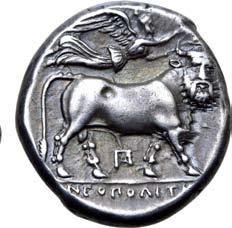





Extremely Fine; handsome old cabinet tone.
Acquired from Phidias, France.
LUCANIA
1,950
Lucania, Herakleia AR Nomos. Circa 281-278 BC. Head of Athena to right, wearing crested Corinthian helmet decorated with Skylla; HPAKΛHIΩN above, E behind / Herakles standing facing, holding club, bow, and arrow, lion skin draped over left arm; owl above club; APIΣ upwards on left. Van Keuren 87; HN Italy 1385; HGC 1, 990. 7.86g, 22mm, 2h.


Extremely Fine. 750
Lucania, Metapontion AR Stater. Circa 330-290 BC. Ay-, magistrate. Wreathed head of Demeter to left, wearing triple pendant earring and necklace / Ear of barley with leaf to left; META upwards to right, griffin springing to right above leaf, foreleg raised, AY below. Johnston Class C, 6.2; HN Italy




1589. 7.95g, 19mm, 8h.
Good Extremely Fine; stunning old cabinet tone with aquamarine blue iridescence to obverse and attractive rainbow iridescence to reverse.
Ex North River Collection; Ex Stack’s, 8 June 1999, lot 56; Ex Giessener Münzhandlung, Auction 13, 28 June 1979, lot 23.
1,650
26
94.
95.
96.
97.
Lucania, Metapontion AR Stater. Circa 330-290 BC. Ly-, magistrate. Wreathed head of Demeter to left, wearing triple pendant earring and necklace; ΞƎΔ before / Ear of barley with leaf to left; altar above leaf, YΛ below, META (retrograde) upwards in right field. Johnston Class C, 10.4 = SNG ANS 503 (same dies); HN Italy 1593; HGC 1, 1063. 7.89g, 21mm, 10h.
Extremely Fine.
Acquired from Pars Coins, San Jose CA.
98.
Lucania, Metapontion AR Stater. Circa 330-290 BC. Da-, magistrate. Wreathed head of Demeter to left, wearing triple pendant earring and necklace / Ear of barley with leaf to left; fork or rake above leaf, [ΔΑ] below, ΜΕΤΑ upwards to right. HN Italy 1582; Johnston C5.12. NGC graded Ch XF 5/5 - 4/5 (#6625604-003).



Acquired from Pars Coins, San Jose CA.
99.
Lucania, Metapontion AR Stater. Circa 330-290 BC. Da-, magistrate. Wreathed head of Demeter to left, wearing triple pendant earring and necklace / Ear of barley with leaf to left; fork or rake above leaf, ΔΑ below, ΜΕΤΑ upwards to right. HN Italy 1582; Johnston C5.8. 7.85g, 22mm, 10h.

Near Extremely Fine.
Acquired from Pars Coins, San Jose CA.
100.
Lucania, Velia AR Stater. Circa 300-280 BC. Philistion group. Head of Athena to right, wearing crested Attic helmet decorated with griffin; A behind neck-guard, Φ before chin / Lion standing to right; dolphin swimming to right above, I and Φ flanking, ΥΕΛΗΤΩ[Ν] in exergue. Williams 446; SNG ANS 1376; SNG Lockett 565; SNG München 882; McClean 1459; HN Italy 1307. 7.14g, 21mm, 2h.









Near Extremely Fine; wonderful deep old cabinet tone with underlying lustre.
Ex collection of a Provenance Enthusiast; Reportedly acquired from a coin fair in Metz in 2012.

750
750
600
750
27
Lucania, Velia AR Stater. Circa 280 BC. IE Group. Head of Athena to left, wearing crested Attic helmet decorated with griffin; A above, [Φ before neck], IE within shallow square incuse behind neck / Lion attacking stag to left; [YEΛHTΩN] behind. Williams 571 (O280/R– [unlisted rev. die]); HN Italy 1318; SNG Ashmolean 1403. 7.54g, 21mm, 5h.







About Extremely Fine; attractive cabinet tone, small delamination on reverse. Acquired from Classical Numismatic Group.
CALABRIA
1,050
Ex Roma II, 2011
Calabria, Tarentum AR Nomos. Contemporary imitation. Circa 302-280 BC. Dakimos, magistrate. Warrior on horseback to right, thrusting spear downward and holding two spears and shield; [Σ]I behind, ΔAKIMOΣ below / Taras riding dolphin to left, holding dolphin and cradling cornucopiae; ΔA below, TARAΣ behind. Fischer-Bossert N140; Vlasto 696 corr. (ΔA rather than ΩA); SNG ANS 1071 corr. (same); HN Italy 967; SNG BnF -; SNG Copenhagen -. 7.89g, 21mm, 6h.





Near Mint State; attractive old cabinet tone.
Ex Sheikh Saud bin Mohammed al-Thani Collection; Ex Roma Numismatics Ltd., Auction II, 2 October 2011, lot 8.
The ANS catalogue repeats the mistake made by Vlasto (whose coin was unique at the time); the correct letters were noted by G. Procopio who examined two or three examples of this type (nos. 497-499) in his article on the Bernalda hoard in 1957.
Ex CNG 42, 1997
1,200
Calabria, Tarentum AR Nomos. Circa 302-280 BC. Arethon, Sa- and Cas-, magistrates. Nude youth on horseback to right, crowning horse with wreath; ΣΑ to left and APEΘΩΝ in two lines below / Taras astride dolphin to left, holding tripod; ΤΑΡΑΣ behind, ⵎΑΣ below. Vlasto 666-7; SNG ANS 104650; HN Italy 957. 7.90g, 22mm, 12h.
Extremely Fine; stunning golden iridescence around devices.
Ex North River Collection; Ex Barry Murphy inventory no. 17057; Ex Classical Numismatic Group, Auction 43, 24 September 1997, lot 52; Ex Classical Numismatic Group, Auction 42, 29 May 1997, lot 28.
28
101.
102.
600
103.



30
A Stellar Example
Calabria, Tarentum AV Stater. Circa 280 BC. Apol-, magistrate. Laureate head of Zeus to right; NK (ligate) monogram behind / TAPANTINΩN, eagle standing to right on thunderbolt, wings spread; ΑΠΟΛ downwards to right, helmet in right field. Fischer-Bossert G37b (this coin); HN Italy 983; HGC 1, 733.


NGC graded AU ★ 5/5 - 4/5, Fine Style (#6674505-001). Rare and in exceptional condition for the issue. This coin published in W. Fischer-Bossert, Chronologie Der Didrachmenprägung von Tarent 510-280 v.Chr. (Berlin 1999); Ex Exceptional Collection, Numismatica Ars Classica, Auction 132, 30 May 2022, lot 159; Ex Santamaria, 18 February 1958, lot 924.
At the beginning of the 3rd century BC the increasing power and influence of Rome in Southern Italy became a source of great concern to Tarentum. Aggravated by what they perceived as Roman interference within their area of dominion, increasing numbers of Roman colonies in Apulia and Lucania, and a growing fleet which threatened Tarentine naval supremacy in Italy, the Tarentines came to an agreement with Rome in 282 BC, part of which forbade Roman ships from entering the Gulf of Taranto. In the same year, ten Roman ships were caught in a storm and driven into the gulf, arriving in the sea off Tarentum during the festival of Dionysos. Considering this a hostile act, the Tarentines attacked the Roman flotilla, sinking four ships and capturing a fifth. A Roman delegation sent to negotiate and seek redress from the Tarentines was insulted and mocked, resulting in the Roman Senate declaring war on Tarentum, and the latter calling for assistance from Pyrrhos of Epeiros.
The ‘victories’ of Pyrrhos at Herakleia and Asculum did little more than grant the Tarentines and their allies a temporary reprieve. After these battles Pyrrhos embarked on a Sicilian adventure that brought him no better fortune, but in the meantime the Magna Graecians were left to their own devices. After returning and fighting another costly but inconclusive engagement at Beneventum, Pyrrhos abandoned Italy for good, leaving Magna Graecia to its fate. Pyrrhos’ departure was followed swiftly by the Roman conquest of Lucania, Samnium, and finally in 272, after fighting on for a further three years after Pyrrhos’ departure, Tarentum itself was forced to surrender.
This coin’s types depart from more typically Tarentine types like the head of Athena or Herakles and the dolphin rider or depictions of Taras in a chariot, and the head of Zeus paired with an eagle probably reflects the influence of the Epierote king. Struck as a war issue by Tarentum, the issue is the legacy of a pivotal moment in history frozen in time and gold. The defeat of Pyrrhos and Tarentum marked a great turning point in the affairs of the world - the Roman conquest of Italy was complete, and the defeat of a powerful Greek king with a trained, professional army by an unheard-of Italian republic had sent shockwaves throughout the Hellenistic east. The successor states of the Alexandrine empire took note: a new power had emerged in the central Mediterranean, and less than a decade later the emboldened Rome would embark on a major overseas war, challenging the might of Carthage for control of Sicily.

31
104.
45,000
107.
Calabria, Tarentum AR Nomos. Circa 280-272 BC. Reduced standard. Xo-, Neume- and Poly-, magistrates. Nude youth on horseback to right, crowning horse with wreath and holding reins; ΞΩ to left, NEY MH in two lines below / Taras astride dolphin to left, holding helmet; stars across fields, ΠΟΛΥ to upper right, TAPAΣ below. Vlasto 739-45; HN Italy 1006; SNG ANS 1106-12; HGC 1, 884. 6.50g, 22mm, 9h.
Good Extremely Fine; die break to obverse, attractive old cabinet tone.
Acquired from Phidias, France.
900
Calabria, Tarentum AR Nomos. Circa 280-272 BC. Phy-, Sodamos and Gu-, magistrates. The Dioskouroi riding to left; ΦY monogram above / Taras riding dolphin to left, holding Nike and two spears and shield decorated with hippocamp; TAPAΣ above, ΓY to left, waves below. Vlasto 773 (obv. die), 776 (rev. die); HN Italy 1011. 6.21g, 21mm, 5h.
Near Extremely Fine; beautiful old cabinet tone.
Acquired from Morton & Eden.
450
Calabria, Tarentum AR Nomos. Circa 272-235 BC. Eu -, Phi - and Xeneas, magistrate. Nude youth on horseback to right, holding reins and wreath above horses head, EY behind, ΦI before, ΞENEA below / Taras astride dolphin to left, holding trident and rhyton terminating in horse’s protome; corn ear with leaf to right. Vlasto 865; HN Italy 1032. 6.53g, 20mm, 9h.












Near Mint State; attractive iridescence on obverse.
Ex collection of a Provenance Enthusiast; Ex Gitbud & Naumann, Auction 9, 3 November 2013, lot 27.
600
Calabria, Tarentum AR Nomos. Circa 272-240 BC. Aristis, magistrate. Nude youth on horseback to left, crowning horse with wreath and holding reins; ΑΡΙΣΤΙC and anchor below / Taras astride dolphin to left, holding Nike who crowns him and a spindle; ΤΑΡΑΣ below. Vlasto 820 (same dies); HN Italy 1020; HGC 1, 889. 6.48g, 20mm, 10h.


Near Mint State.
Acquired from Nomos AG; Ex Morcote Collection, formed before 2005.
32
105.
106.
600 108.
109.
Calabria, Tarentum AR Nomos. Circa 240-228 BC. Aristippos, magistrate. Nude rider on horseback to right, holding filleted palm; AP monogram to left, APIΣTIΠΠOC below / Taras astride dolphin to left, holding kantharos in extended right hand; MY monogram to right, TAPA[Σ] below. Vlasto 9478; HN Italy 1056; SNG ANS 1253; HGC 1, 902. 6.62g, 21mm, 10h.






Mint State; lustrous.
Acquired from Nomos AG; Ex Morcote Collection, formed before 2005.
1,800
110.
Calabria, Tarentum AR Nomos. Circa 240-228 BC. Aristippos, magistrate. Reduced standard. Nude rider on horseback to right, holding filleted palm; AP monogram to left, APIΣTIΠΠ[OC] below / Taras astride dolphin to left, holding kantharos in extended right hand; MY monogram to right, TAPAC below. Vlasto 947-8; HN Italy 1056; SNG ANS 1253; HGC 1, 902. 6.50g, 21mm, 5h.



Good Extremely Fine; attractive cabinet tone and featuring a wonderfully detailed obverse.
Ex Weise Collection;
Ex LHS Numismatik AG, Auction 95, 25 October 2005, lot 454.
750
Calabria, Tarentum AR Nomos. Circa 240-228 BC. Xenokrates, magistrate. Reduced standard. Bearded strategos on horse walking to left, wearing short tunic and chlamys, raising right hand in salutation, and with parazonium under left arm; monogram and pileos to upper right, ΞΕΝΟΚΡΑΤΗΣ in two lines below / Taras astride dolphin to left, with torso turned to right, naked but for chlamys raised in left hand, with trident over right shoulder; TAPAΣ to left, monogram to right, cuttlefish and waves below. Vlasto 955-958; SNG ANS 1259; HN Italy 1058; HGC 1, 904. 6.52g, 20mm, 3h.


Near Mint State.
Ex Roma Numismatics Ltd., Auction XXIII, 24 March 2022, lot 23.
Bruttium, Kaulonia AR Stater. Circa 525-500 BC. Nude Apollo walking to right, holding laurel branch, small daimon running to right on extended arm, holding branches; to right, stag standing to right with head reverted, [K]AVΛ to left; all within dot and cable border / Incuse of obverse, but no ethnic. Noe, Caulonia, Group A, 10 (same dies); SNG ANS 142; Gulbenkian 119; HN Italy 2035; HGC 1, 1416. 7.91g, 31mm, 12h.


Extremely Fine; flan crack at 5h, beautiful old cabinet tone.
Acquired from Leu Numismatik AG.
33
750 111.
3,000 112. BRUTTIUM
113.
Bruttium, Kroton AR Stater. Circa 530-500 BC. Tripod surmounted by wreaths, legs terminating in lion’s paws, a pair of serpents above; ϘPO (partially retrograde) upwards to right, crab in left field / Incuse tripod as obverse; ϘPO (partially retrograde) upwards to right, lyre in left field. Attianese 33; HN Italy 2087; SNG Copenhagen 1746; HGC 1, 1446. 7.86g, 26mm, 12h.

Near Extremely Fine.
Acquired from Leu Numismatik AG.
114.
Bruttium, Lokroi Epizephyrioi AR Stater. Circa 350-275 BC. Pegasos flying to left; thunderbolt below / Head of Athena to left wearing Corinthian helmet. Pozzi Paolini Group II, g; Pegasi 13; HN Italy 2342. 8.54g, 24mm, 8h.




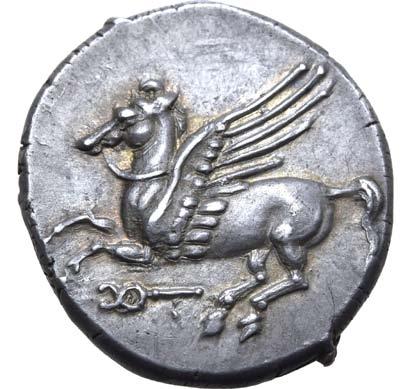

Near Mint State; a crisp strike on lustrous surfaces with hints of iridescence.
Acquired from Pars Coins, San Jose CA; Previously acquired from Auktionhaus H.D. Rauch GmbH.
600
1,050
115.
Bruttium, Lokroi Epizephyrioi AR Stater. Time of Timoleon, circa 344-318 BC. Pegasos with reins flying to left, kerykeion below / Head of Athena to left, wearing Corinthian helmet; ΛOKPΩN upwards before. Spinelli Group I, 1b, 16 (same dies); Pegasi 12; HN Italy 2342. 8.61g, 23mm, 10h.




Near Mint State; attractive old cabinet tone, beautiful golden iridescence around devices.
Ex North River Collection;
Ex Classical Numismatic Group - Numismatica Ars Classica - Freeman & Sear, Triton IV, 5 December 2000, lot 74.

1,050
Bruttium, Rhegion AR Litra. Struck under the tyrant Anaxilas, circa 480-462 BC. Hare springing to right / RE retrograde, pellet below. Caltabiano, - cf. series II-IV, 113-136 for type (all with REC and no pellet); SNG ANS - cf. 633-4 (same); HN Italy - cf. 2475 (same); HGC 1, - cf. 1649 corr. (weight) (same variants). 0.71g, 10mm, 12h.


Good Very Fine. Apparently unpublished; no record of this type with only the letters RE and a pellet.
Ex F. Cruse Collection.
300
34
116. Apparently Unpublished 2x 2x

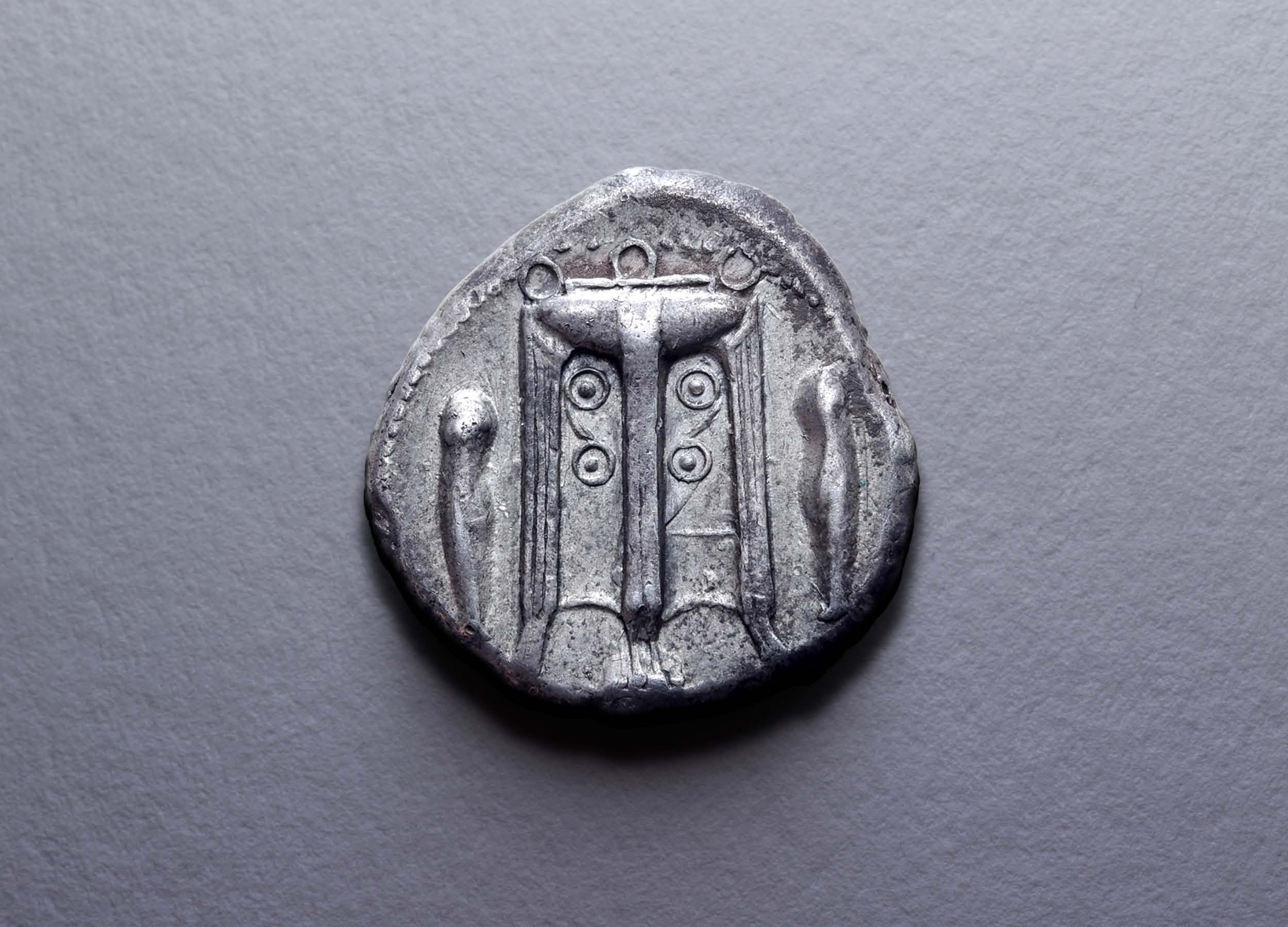

36
Bruttium, Temesa AR Stater/Tridrachm. Early 5th century BC. Tripod, greaves to left and right / Corinthian helmet, TEM below. AMB 234 (this coin); Jameson 464; HGC 1, 1724. 8.18g, 20mm, 9h.
Extremely Fine; attractive old cabinet tone. Very Rare.
This coin published in H. A. Cahn et al., Antikenmuseum Basel und Sammlung Ludwig: Griechische Münzen aus Grossgriechenland und Sizilien (Basel, 1988);
Ex Dr Maag Collection, Dr. Busso Peus Nachfolger, Auction 407, 7 November 2012, lot 141;
Ex Numismatics Ars Classica AG, Auction 13, 8 October 1998, lot 234;
Ex A. Moretti Collection, acquired in 1960’s and then displayed in the Antiken Museum Basel.
According to mythological tradition, Temesa was founded by Thoas, an Aitolian hero returning home after the Trojan war, although it has also been attributed to Polites, a companion of Odysseus who was stoned to death by the local inhabitants when they were blown onto shore. Pausanias relates that the sailor returned as a daimon to kill inhabitants of Temesa, who were ordered by the Pythian oracle to appease him by building a temple and sacrificing a maiden there every year. (Pausanias 6.6.10) He continued to haunt the living until a Lokrian Olympic athlete Euthymos supposedly bested him in a wrestling match in the fifth century BC.
This story may have been promulgated by the victorious city of Lokroi Epizephyrioi, which conquered Temesa after defeating Kroton, the previous dominant power in the region of Bruttium, in circa 480 BC. It is in these circumstances that this coin was likely minted, still bearing the tripod of Kroton which had marked Temesa as a dependency of that city, alongside the Corinthian helmet emblem of Temesa. However, where previous coinage had named both cities, this one names only Temesa, possibly pointing towards a new level of autonomy outside of the Krotoniate sphere of influence.




37 Ex A. Moretti Collection and Published in AMB
117.
33,000
118.
A Marvellous Example
119.
North Africa, Carthage AV Stater. Circa 350-320 BC. Wreathed head of Tanit to left, wearing triple-pendant earring and pendant necklace / Horse standing to right on ground line; three pellets before. Jenkins & Lewis Group IIIh; SNG Copenhagen 974; McClean 9979; MAA 4.




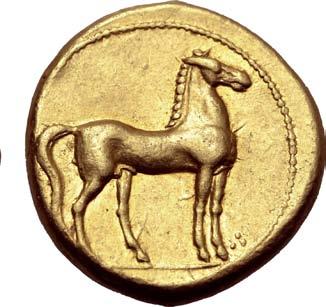




NGC graded Ch AU 5/5 - 4/5 (#6674414-001). Previously NGC graded the same but with comment ‘Fine Style’. Acquired from Numismatica Ars Classica.
7,500
120.
North Africa, Carthage AV Stater. Circa 350-320 BC. Wreathed head of Tanit to left, wearing triple-pendant earring and pendant necklace / Horse standing to right on ground line; three pellets before. CNP 1.5q; Jenkins & Lewis Group IIIf, 49 (same dies); MAA 4. 9.20g, 19mm, 11h.
Good Extremely Fine.
Ex Roma Numismatics Ltd., Auction XXI, 24 March 2021, lot 31; Ex Roma Numismatics Ltd., E-Sale 62, 17 October 2019, lot 98.

4,500
North Africa, Carthage AV Stater. Circa 350-320 BC. Wreathed head of Tanit to left, wearing triple-pendant earring and pendant necklace / Horse standing to right on ground line; three pellets before. CNP 1.5q; Jenkins & Lewis Group IIIf, 45-47; MAA 4. 9.55g, 18mm, 6h.

Extremely Fine; sharply struck.
Acquired from Leu Numismatik AG.
3,000
38
NORTH AFRICA
121.
Sicily, Siculo-Punic AR Tetradrachm. ‘People of the Camp’ mint (Entella?), circa 320-300 BC. Head of Arethusa to left, wearing grain-wreath, triplependant earring, and necklace; four dolphins around / Horse’s head to left; palm tree behind, Punic script (‘MMHNT = People of the Camp) below. Jenkins, Punic 153 (O48/R138); CNP 267; Jameson 917 (same dies); SNG Lloyd 1629 (same dies); HGC 2, 284. 17.20g, 26mm, 12h.
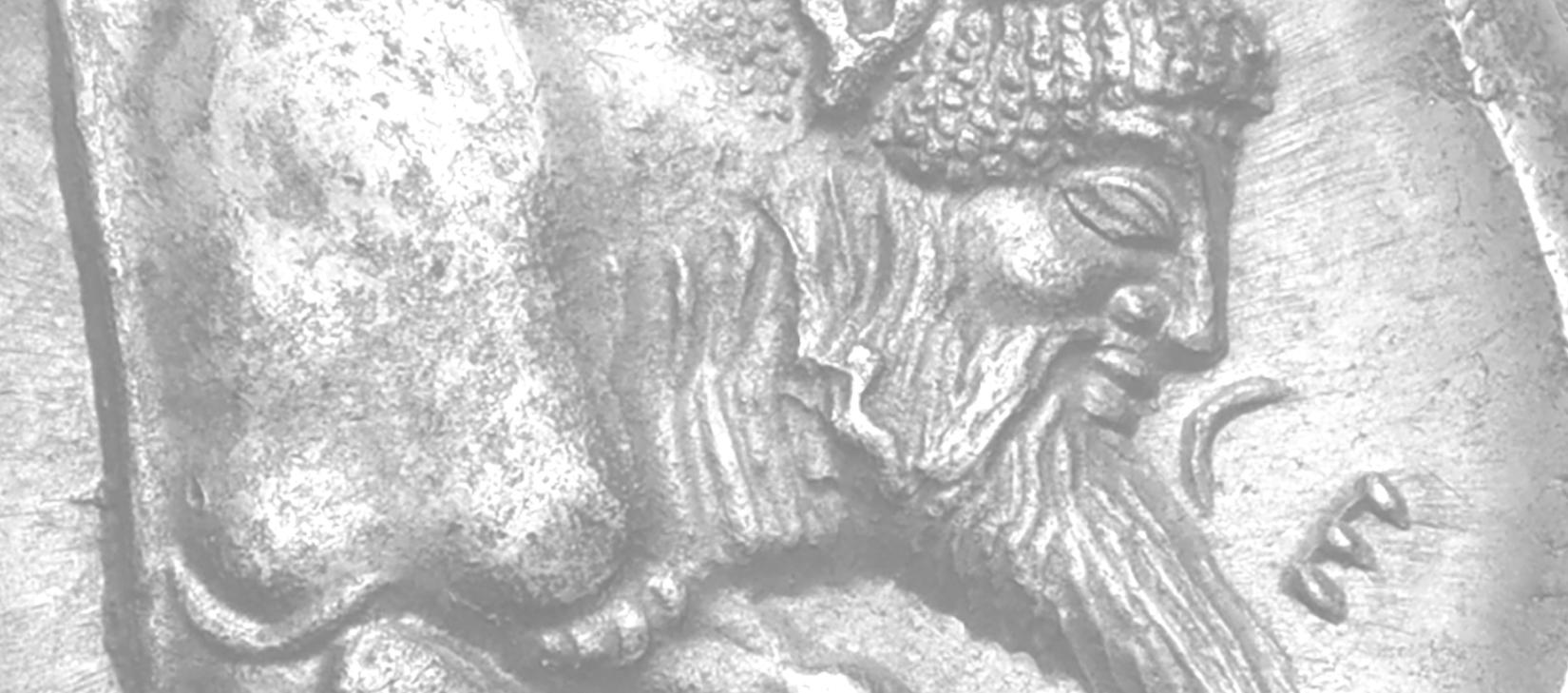

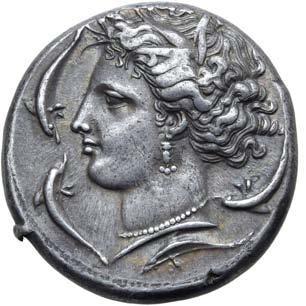
Good Extremely Fine; beautiful old cabinet tone.
Acquired from Prunier auction, France.
4,500
122.
Sicily, Gela AR Didrachm. Circa 490/85-480/75 BC. Horseman riding to right, preparing to cast javelin / Forepart of man-headed bull to right; CΕΛΑ around; within circular incuse. Jenkins, Gela, Group Ib, 8 (O5/R4); Buceti 8; HGC 2, 362. 8.17g, 20mm, 12h.






Good Extremely Fine.
Acquired from Nomos AG; Ex Sottoceneri Collection, formed prior to 2005.
5,700
39 SICILY


40
An Unsigned Work by Prokles?
Sicily, Katane AR Drachm. Circa 405-403/2 BC. Dies in the style of engraver Prokles. Female charioteer, holding kentron and reins, driving galloping quadriga to right; above, Nike flying to left, crowning charioteer with wreath held in outstretched arms / Horned head of the river-god Amenanos to left, wearing tainia; crayfish and two dolphins around, AMENANOΣ above. SNG Manchester 384 (same dies); SNG ANS - cf. 1263 for drachm by different engraver; HGC 2, 582 (this coin) corr. (incorrect description copied from 581). 4.20g, 19mm, 9h.



Good Extremely Fine; attractive iridescence around devices. Very Rare.
This coin published in O.D. Hoover, The Handbook of Greek Coins, Vol. 2 - Coins of Sicily (Lancaster PA, 2012); Ex Numismatica Ars Classica, Auction 116, 1 October 2019, lot 44; Ex Classical Numismatic Group, Triton XIV, 4 January 2011, lot 23.
16,500
The city of Katane, founded around 729 BC by Chalkidic colonists from Naxos, was established on the site of the archaic village of the same name that was then peopled by the indigenous Sikels, who had named their village after the rugged black lava landscape (katane, meaning sharp stones). The native Sikels were rapidly Hellenised, but the Naxian founders kept the autochthonal name for their new home on the banks of the river Amenanos.
During the ill-fated Athenian invasion of Sicily of 415-413 BC, Diodoros reports that Katane was at first in favour of Syracuse, though upon hearing the case of the Athenian strategoi Thucydides relates that the Katanaians were compelled to espouse the alliance of the invaders. Katane thus became the headquarters for the Athenian force, and remained its principal base of operations throughout the campaign.
It was to this city that the survivors of the Athenian general Nicias’ massacred army escaped, finding refuge there until they could return to Athens. Despite the utter destruction of their ally’s forces, Katane appears to have emerged from the war largely unscathed, and may indeed have gained some economic benefit from the 300 talents of silver that the Athenian reinforcements brought with them in 414 BC to hire Sicilian cavalry, in addition to the money the Athenians spent within the city. In any case, Katane remained free from Syracusan rule until 403 BC, when a force under Dionysios I was able to seize the city by surprise thanks to the treachery of the strategos Arkesilaos. Dionysios then sold its people into slavery and granted the city itself to his Campanian mercenaries.
It is to this period, immediately prior to Katane’s capture, that this drachm belongs. It is a triumph of late classical style, struck during the golden age of Sicilian art when master die-engravers such as Kimon, Euainetos and Herakleidas were active. The obverse type of the victorious quadriga, derived from contemporary issues of Leontinoi and Syracuse, is rendered in a wonderful, dynamic manner which emphasises the thundering motion of the four galloping horses. The presence of Nike, soaring in from above to crown the charioteer, shows victory is assured. On the reverse is depicted the river-god Amenanos, appearing not as a bearded man-faced bull as Sicilian river gods were often portrayed in emulation of their father Acheloos, but in a handsome youthful form. The nature of his divinity is revealed only by the small bull’s horn above his tainia and by the fish and crayfish that float around his face.
The double exergual lines, treatment of Amenanos’ hair, upright posture of the charioteer and positioning of the horse’s legs identify it as in the style of Prokles, a die-engraver whose signature appears on several tetradrachms of Katane. Unsigned drachms in his style are a rarity in the Katane drachm series, with drachms signed by Euainetos, Herakleidas and Choirion being more common.
41
123.
124.
Sicily, Syracuse AR Tetradrachm. Deinomenid Tyranny. Time of Gelon, circa 480-475 BC. Charioteer, holding kentron and reins, driving slow quadriga to right; Nike flying to right above, crowning horses / Head of Arethusa to right, wearing necklace and pearl diadem, with hair in krobylos; ΣVRΑΚΟΣΙΟΝ before, four dolphins around. Boehringer - (V45/R- [unrecorded rev. die]); Randazzo 257 (same dies); New York Sale XLII, 45 (same dies); HGC 2, 1306. 17.22g, 23mm, 3h.
Extremely Fine. Very Rare; reverse die unlisted in Boehringer.
Acquired from Prunier auction, France.
1,800
125.
Sicily, Syracuse AR Tetradrachm. Deinomenid Tyranny. Time of Gelon, circa 480-475 BC. Charioteer, holding kentron and reins, driving slow quadriga to right; Nike flying to right above, crowning horses / Head of Arethusa to right, wearing necklace and pearl diadem, with hair in krobylos; ΣVRΑΚΟΣΙΟΝ and four dolphins around. Boehringer 80 (V37/R52); Randazzo 249 (same dies); HGC 2, 1306. 17.17g, 24mm, 9h.
Near Extremely Fine; struck from attractive archaic style dies.
Acquired from Prunier auction, France.
1,500
Sicily, Syracuse AR Tetradrachm. Deinomenid Tyranny. Time of Hieron I, circa 470-466 BC. Charioteer, holding kentron and reins, driving slow quadriga to right; above, Nike flying to right, crowning horses; ketos swimming to right in exergue / Head of Arethusa to right, hair in pearl band, wearing loop earring with single pendant and pearl necklace; ΣVRAKOΣION and four dolphins around. Boehringer 408 (V211/R288); SNG ANS 128; Hunterian 20; Bement 1050 (all from same dies); Roma XVI, 148 (same dies). 17.11g, 25mm, 2h.












Extremely Fine.
Acquired from Morton & Eden.
2,400
42
126.
127.
Sicily, Syracuse AR Tetradrachm. Second Democracy, circa 450-440 BC. Charioteer, holding kentron and reins, driving slow quadriga to right; Nike flying to right above, crowning horses, ketos swimming to right in exergue / Head of Arethusa to right, wearing earring, necklace and headband; ΣΥRAΚΟΣΙΟΝ and four dolphins around. Boehringer 566 (V285/R385); SNG ANS -; HGC 2, 1311. 17.36g, 26mm, 12h.

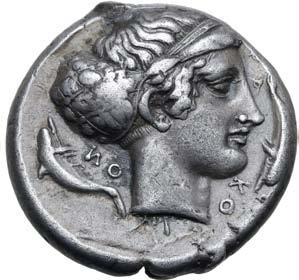









Near Extremely Fine. Very Rare; apparently no other examples of Boehringer 566 on CoinArchives.
Acquired from Prunier auction, France.
Very Rare
2,400
128.
Sicily, Syracuse AR Tetradrachm. Second Democracy, circa 420-415 BC. Charioteer, holding kentron and reins, driving slow quadriga to right; Nike flying to right above, crowning horses, grasshopper in exergue / Head of Arethusa to right, hair in sphendone; ΣΥRAΚΟΣΙΟΝ and four dolphins around (only 2 visible). Boehringer 727 (V359/R495); Jameson 781 (same dies); McClean 2682 (same dies); Pozzi 590 (same dies); de Luynes 1187 (same dies); HGC 2, 1324 corr. (Boehringer 727 not listed). 17.18g, 24mm, 12h.

Good Very Fine. Very Rare.
Acquired from Prunier auction, France.
Signed by Eumenes and Eukleidas
3,600
129.
Sicily, Syracuse AR Tetradrachm. Second Democracy, circa 415-405 BC. Obverse die signed by Eumenes and reverse die signed by Eukleidas. Charioteer, holding kentron in right hand and reins in both, driving fast quadriga to left; Nike above, flying to right, crowning charioteer with wreath; [EYMENOY] in exergue / Head of Arethusa to left, wearing double-pendant earring, hair bound by ampyx and net-like sphendone; below chin, diptych inscribed EYKΛEIΔA in two lines, ΣYPAKOΣIΩN and four dolphins around. Fischer-Bossert, Coins 24 (O9/R16); Boston MFA 402 = Warren 372 (same dies); SNG ANS 259 (same dies); BMC 193 (same dies); HGC 2, 1328. 16.70g, 26mm, 4h.
Good Very Fine; minor flan crack, trace of oxidation on reverse. Scarce.
Acquired from Phidias, France.
3,150
43


44
A Wonderful Syracusan Dekadrachm
Sicily, Syracuse AR Dekadrachm. Time of Dionysios I, circa 405-370 BC. In the style of Euainetos. Charioteer driving galloping quadriga to left, holding kentron in right hand, reins in left; above, Nike flying to right, wreath in outstretched arms to crown charioteer; in exergue, panoply of arms on two steps: cuirass, two greaves, Phrygian helmet; horizontal spear behind / Head of Arethusa to left, wearing wreath of reeds, triple-pendant earring, and pearl necklace; ΣΥΡΑΚΟΣΙΩΝ behind, four dolphins around, scallop shell with seven ridges behind. Gallatin O.XV/R.F.VIIA; Gulbenkian 315 (same rev. die); Dewing 908-917; SNG ANS 373 (same rev. die) and 374 (same obv. die); HGC 2, 1299. 42.57g, 36mm, 11h.



Good Extremely Fine; beautiful old cabinet tone, sharply struck, a stellar example of an extremely desirable type with uncommonly well preserved detail, and the often-present die rust that plagues so many Syracusan dekadrachms is notably and fortuitously absent.
Ex Nomos AG, Auction 24, 22 May 2022, lot 33; Ex collection formed prior to WWII, primarily from auction purchases (often from Hirsch), but also through private treaty sales.
36,000
45
Described by Cicero as “the greatest Greek city and the most beautiful of them all” (In Verrem, 2.4.52), Syracuse became the major power in Sicily during the late fifth century BC. Its political and cultural power is borne out in its enormous issues of what are undoubtedly some of the finest coinage in all of antiquity, with its influence attracting eminent artists and famous die-engravers from all across the Mediterranean. These masters brought about a stylistic revolution, breathing life into the static rigid forms of Archaic art and developing new ways of depicting motion and life on a miniature scale. While these artists were responsible for an array of magnificent classical tetradrachms, it is the dekadrachms that are now endlessly sought after by collectors, due to the exquisite and boundary-breaking artistry which their large flan size enabled. This coin bears the supremely graceful head of the sea-nymph Arethusa, her delicate features and serene expression beautifully complemented by the curls flowing wave-like away from her face. This sense of motion carries over to the obverse in a dramatic depiction of a chariot race. An iconic motif which had evolved from sober, canonical renderings inspired by an Attic vase painting, this highly-energized engraving emphasises the thundering motion of the team of horses, their legs poised in sensationally naturalistic style. We are afforded a wonderful view of the four horses and charioteer straining forwards by the realistic, non-frontal perspective which renders the scene dynamic and lifelike. While the die engraver’s authentic style powerfully engages the viewer in the race, the outcome is never in doubt: the presence of Nike, soaring in from above to crown the charioteer, shows victory is assured. This victorious element to the Syracusan dekadrachms has led some to associate their introduction with a military victory, a link reinforced by the presence of armour, weaponry and the short inscription ‘AΘΛA’ indicating prizes, contests or combat which appears on the majority of dies, although not on this example. A century ago, Head agreed that they were likely exceptional issues, but argued that they were “chiefly issued on special occasions or for the personal gratification of tyrants or kings, and not for common currency.” However, we now know dekadrachms of both Athens and Syracuse had enduring roles in the monetary system, and those in the style of Euainetos continued to be struck for decades, perhaps even into the 360s BC. Euainetos produced several magnificent signed dekadrachm dies, whose influence on Syracusan coinage was unparalleled, and the many dekadrachm types which do not bear his signature but meticulously repeat the details of Euainetos’ energetic artistry are testament to the fact, such as this present example. Indeed, Gallatin notes that the entire series ‘shows a most amazing repetition of the details of the arrangement of the hair, locks and curls being slavishly repeated’ and argues that either it is possible that assistants employed by Euainetos ‘were allowed to identity their work in this manner with various symbols’ such as the scallop shell which appears on the reverse of this coin. (Syracuse Dekadrachms of the Euainetos Type, pp.10-11). 130.
An Attractive Tetradrachm of Syracuse



Sicily, Syracuse AR Tetradrachm. Time of Dionysios I, 405-395 BC. Unsigned dies in the style of Eukleidas. Charioteer, holding kentron in right hand and reins in both, driving fast quadriga to left; above, Nike flying to right, crowning charioteer with wreath held in both hands; dolphin to left in exergue / Head of Arethusa to left, hair in bands, wearing double-loop earring; [ΣYPAKOΣIΩN] and four dolphins around. Fischer-Bossert, Coins 104 (O35/R71); BMC 197 (same dies); SNG ANS 300 (same dies); Pozzi 626 (same dies); Boston MFA 444 (same dies); Jameson 809 (same dies); de Luynes 1232 = Rizzo pl. XLVIII, 16 (same dies); HGC 2, 1345. 17.21g, 24mm, 1h.




Good Extremely Fine. Rare.
Acquired from Nomos AG; Ex Sottoceneri Collection, formed prior to 2005.
‘They say that there was a hunter called Alpheius, who fell in love with Arethusa, who was herself a huntress. Arethusa, unwilling to marry, crossed to the island opposite Syracuse called Ortygia, and there turned from a woman to a spring. Alpheius too was changed by his love into the river. [...] Because the water of the Alpheius mingles with the Arethusa, I am convinced that the legend arose of the river’s love-affair’ (Pausanias, Description of Greece, 5.7). Just as the tale of Arethusa captured the imagination of Pausanias, the Corinthians, who established the Syracusan colony on the island of Ortygia, chose the enchanting deity to be their patron. As the colony established itself and spread from its nucleus to the Eastern coast of Sicily, depictions of the nymph’s head started to appear on their early coins minted at the end of the 6th century BC.
As the colony of settlers grew and transitioned into a democracy, they gained both strength and territory as well as a flourishing cultural scene. With their growing ambition and power, clashes with neighbouring cities competing for supremacy were inevitable and Syracuse became embroiled in various conflicts until its transformation back into a tyranny under Dionysios I (c. 430-367 BC) gave way to a period of prosperity. Besides his highly successful military tactics, another dimension to the rule of Dionysios I was his patronage of the arts. Numerous sculptures and die-cutters were employed to enhance the city’s grandeur and, as the art scene blossomed, the opportunity for individuals to hone their skills and become famous arose. A number of die cutters proudly signed their works and thus we have come to know the names of some of them, including Exakestidas, Kimon, Euainetos and Eukleidas.
Sicily, Syracuse AR Tetradrachm. Time of Dionysios I, 400-390 BC. Unsigned dies in the style of Eukleidas. Charioteer, holding kentron in right hand and reins in both, driving fast quadriga to left; above, Nike flying to right, crowning charioteer with wreath held in both hands; dolphin to left in exergue, its dorsal fin breaking the exergual line / Head of Arethusa to left, hair in bands, wearing necklace and double-loop earring; ΣY-PA-[K-OΣI-Ω-]N and four dolphins around. Fischer-Bossert, Coins 103 (O35/R70); Tudeer 103; Hirsch 613 (same dies); Hunterian 62 (same dies); de Luynes 1231 (same dies); Morgan 149 (same dies); HGC 2, 1345. 17.32g, 25mm, 6h.
Near Extremely Fine; beautiful cabinet tone.
Ex Numismatica Ars Classica, Auction 120, 6 October 2020, lot 287; Ex private European collection, privately purchased in 2012.
46
131.
6,000
4,800 132.
133.
Sicily, Syracuse AR Stater. Time of Timoleon and the Third Democracy, circa 343-338 BC. Pegasos flying to left / Head of Athena to right, wearing Corinthian helmet; ΣVΡΑΚΟΣΙΩΝ around. Pegasi 1; SNG Copenhagen 711-2; SNG ANS 494-507; SNG Copenhagen 711; HGC 2, 1400 corr. (no symbols or letters).
NGC graded MS 5/5 - 3/5 (#6329072-002).
Ex private Swiss collection, in Switzerland prior to 2004, acquired from NAC.
Sicily, Syracuse AR Hemidrachm. Time of Timoleon and the Third Democracy, circa 343-317 BC. Helmeted head of Athena facing slightly to left; ΣΥΡΑΚΟΣΙΩN and three dolphins around / Horseman riding to right; star behind. SNG ANS 520-1 (same dies); HGC 2, 1370. 1.95g, 14mm, 3h.


Sicily, Syracuse AR Stater. Time of Timoleon and the Third Democracy, circa 343-317 BC. Pegasos flying to left / Head of Athena to right, wearing Corinthian helmet; ΣYΡΑΚΟΣΙΩΝ before. Pegasi 1; SNG Copenhagen 711-2; SNG ANS 494-5; HGC 2, 1400 corr. (no symbols or letters). 8.41g, 21mm, 12h.





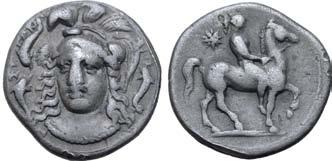
Mint State; beautiful old cabinet tone.
Ex Superior Stamp & Coin, Auction 149; 3 December 1999, lot 1424.
Sicily, Syracuse Æ 27mm. Time of Timoleon and the Third Democracy, circa 339/8-334 BC. ΖΕΥΣ ΕΛΕΥΘΕΡΙΟΣ, laureate head of Zeus to left /





free horse prancing to left. CNS 80; SNG ANS 533-41; HGC 2, 1439. 19.44g, 27mm, 9h.

Near Extremely Fine. Ex F. Cruse Collection.
Sicily, Syracuse Æ 28mm. Time of Timoleon and the Third Democracy, circa 339/8-334 BC. ΖΕΥΣ ΕΛΕΥΘΕΡΙΟΣ, laureate head of Zeus to left /
free horse prancing to left. CNS 80; SNG ANS 533-41; HGC 2, 1439. 19.33g, 28mm, 3h. Good Very Fine. Ex F. Cruse Collection.

47
3,000
Very Fine. Rare. Ex F. Cruse Collection. 150
134.
900 135.
ΣΥΡΑΚΟΣΙΩΝ,
600 136.
ΣΥΡΑΚΟΣΙΩΝ,
600 137.


48
Sicily, Syracuse AR Tetradrachm. Time of Agathokles, circa 310-306/5 BC. Head of Kore to right, wearing wreath of grain ears, single-pendant earring, and necklace; KOPAΣ to left / Nike standing to right erecting trophy to right; AI monogram to lower left, triskeles to right, AΓAΘOKΛEOΣ in exergue. Ierardi 88b (O18/R57, this coin) = Basel 512 (this coin); BAR Issue 23; Gulbenkian 334 (same obv. die); Hermitage Sale II 379 (same dies); McClean 2835 (same dies); HGC 2, 1536. 16.69g, 28mm, 10h.
Fleur De Coin; magnificent old cabinet tone, engraved in refined style, struck on a broad flan, very well centred and exceptionally complete for the type. Likely the finest known example of the type.
This coin published in M. Ierardi, Tetradrachms of Agathocles of Syracuse (AJN 7-8, 1995-1996);

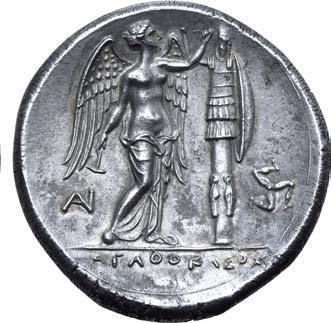


This coin published in H.A. Cahn et al., Griechischen Münzen aus Grossgriechenland und Sizilien (Basel, 1988);
Ex Long Valley River Collection, Auction XX, Roma Numismatics Ltd., 29 October 2020, lot 83; Ex Star Collection, Numismatica Ars Classica, Auction 48, 21 October 2008, lot 53; Ex Athos D. Moretti Collection, Numismatica Ars Classica, Auction 13, 8 October 1998, lot 512.
With the usurpation of Agathokles in 317 BC, Syracuse once more monopolised the right of coinage for the whole of Sicily, even more distinctly than in the time of Dionysios. Yet the reign of Agathokles, as noted by Malcolm Bell (Morgantine Studies I, 1981) ‘was a watershed for the arts in Sicily, just as it was for politics. The change from a conservative late-classical style to the new modes of the early-Hellenistic period came very quickly, within the space of a decade, and it coincided with the replacement of democratic government by the new monarchy. It is clearly perceptible in the coins that... document the full acceptance of early-Hellenistic style.’
Depicted often as a cruel and unscrupulous adventurer and tyrant, Agathokles achieved little of lasting historical importance; indeed after his death anarchy erupted both in Syracuse, where a damnatio memoriae was decreed, and in other places that had been under his rule (Diod. Sic. 21.18). Nonetheless, his patronage of the arts left a legacy of beauty as embodied by a small number of surviving works of art from his reign, and smaller but no less wonderful objects such as this stunning coin.
49
Published in Ierardi and Basel; Ex Star and Moretti Collections
138.
18,000
139.
Sicily, Syracuse AR Tetradrachm. Time of Agathokles, circa 310-305 BC. Wreathed head of Kore to right, KOPAΣ downwards behind / Nike standing to right, crowning trophy she has erected to right; triskeles to lower left. Ierardi 157 (O40/R106); BAR Issue 23; HGC 2, 1536. 17.05g, 27mm, 3h.






140.
Good Extremely Fine.
Ex Chaponnière & Firmenich SA, Auction 13, 16 May 2021, lot 85. 2,100
Sicily, Syracuse AR Trichalkon or Litra. Time of Hieron II, circa 216-214 BC. Helmeted head of Athena to left / Large XIII; three pellets in triangular formation to left, ΣΥΡΑΚΟΣYΩΝ (sic) above, K below. CCO 320 var. (D2/R- [unlisted rev. die with variant spelling of ethnic]); BMC 669 (same obv. die) var. (same); SNG Copenhagen 887 (same obv. die) var. (same); HGC 2, 1426 var. (same). 0.88g, 11mm, 5h.



Good Extremely Fine. Rare and apparently unpublished.
Ex Gorny & Mosch Giessener Münzhandlung, Auction 186, 8 March 2010, lot 1153.
450
Sicily, Syracuse AR 10 Litrai. Time of Hieronymos, circa 215-214 BC. Diademed head to left; K (retrograde) behind / BAΣIΛEOΣ IEPΩNYMOY, winged thunderbolt; KI above. Holloway 41 (O21/R33); SNG ANS 1029 (these dies); HGC 2, 1567. 8.18g, 23mm, 3h.

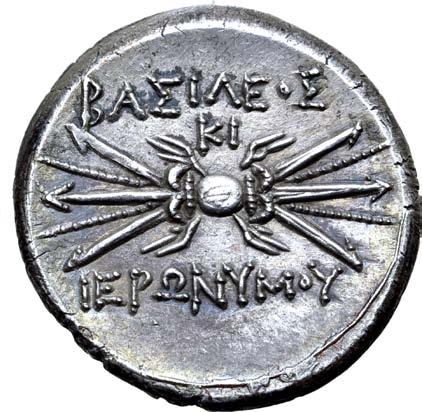
Good Extremely Fine; light cleaning marks, beautiful cabinet tone with iridescent highlights.
Ex Münzhandlung Basel, Auction 10, 15 March 1938, lot 144.
Hieronymos ascended to the throne of Syracuse at a time of crisis. A Roman consular army of eight legions and allied troops had been annihilated at Cannae only the year before, and Roman power had been dealt a considerable shock. The repercussions of that defeat had been profoundly felt in Sicily; the former king Hieron II had remained steadfast in his loyalty and support to Rome though a significant party in the city favoured abandoning the Roman alliance and joining the cause of Carthage, despite their traditional enmity to that people. The young Hieronymos, who had already shown signs of weakness and depravity of character, allowed himself to be influenced by his pro-Carthaginian uncles into breaking the alliance with Rome, a decision that would have disastrous consequences for Syracuse.
50
141.
2,400
2x 2x
Ex Münzhandlung Basel 10, 1938
Sicily, the Tyrrhenoi Æ 31mm. Circa 354/3-336 BC. Helmeted head of Athena to right; TYPPH around / Athena standing facing, head to left, holding spear in right hand and resting hand on grounded shield to right; M in right field. Castrizio series I, 1; Campana 1; CNS 1; HGC 2, 1657. 35.46g, 31mm, 5h.




Fine. Very Rare.
Ex Roma Numismatics Ltd., E-Sale 81, 25 February 2021, lot 71; Ex collection of a Photographer, Roma Numismatics Ltd., E-Sale 64, 28 November 2019, lot 226; Ex Hans Hermann Gutknecht Collection, Münzen & Medaillen Deutschland GmbH, Auction 17, 4 October 2005, lot 402; Acquired in 1987.
In 384 Dionysios I of Syracuse raided the south coast of Etruria and returned to Sicily with a band of Etruscan soldiers who had surrendered. He probably settled them in the vicinity of the Sileraioi, near present-day Alimena. Here these Etruscan mercenaries struck coins naming themselves as the Tyrrhenoi - the Greek exonym for the Etruscans (their own name for themselves being Rasenna). This mercenary mint ceased to mint coinage overstruck on Syracusan drachmae when the Tyrrhenoi were wiped out by Timoleon in the 330s BC.
EPEIROS
143.
Epeiros, Ambrakia AR Stater. Circa 360-338 BC. Pegasos flying to right; A below / Head of Athena to left, wearing Corinthian helmet; oinochoe behind. Pegasi 121; SNG Copenhagen -. 8.68g, 25mm, 12h.



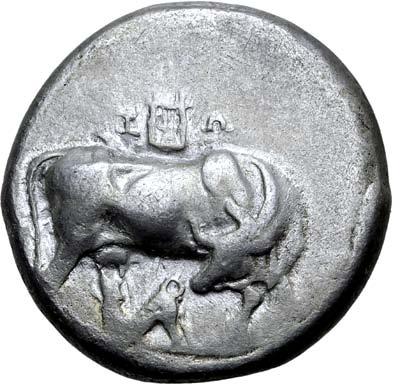


Extremely Fine; slight die shift to obv., struck on a very broad planchet. Very Rare. Acquired from Leu Numismatik AG.
144.
Islands off Epeiros, Korkyra AR Diobol. Circa 525-500 BC. Amphora / Stellate pattern in incuse square. SNG Copenhagen 145 var. (denomination); BMC 24 var. (same); HGC 6, 43 var. (same). 1.65g, 9mm.
Very Fine. Apparently unpublished in this denomination.
Ex Roma Numismatics Ltd., E-Sale 100, 28 July 2022, lot 42.
Only 3 Examples Cited by Fried
600
300
145.
Islands off Epeiros, Korkyra AR Stater. Circa 350/30-290/70 BC. Cow standing to right, looking back at suckling calf standing to left below; above, Z-Ω flanking kithara / Double stellate pattern, each within adjoining linear square borders; below, thyrsos to right; K-O-P around; all within linear circle border. Fried Group IV, dies 106/(196); Meadows, CH (forthcoming), 256 (this coin); HGC 6, 37. 10.45g, 22mm, 3h.


Very Fine. Extremely Rare; only three examples cited by Fried.
Ex Classical Numismatic Group, Auction 99, 13 May 2015, lot 107.
450
51
142.
120
Apparently Unpublished
2x
2x
AKARNANIA
146.
Akarnania, Anaktorion AR Stater. Circa 350-300 BC. Pegasos flying to left; AN below / Head of Athena to left, wearing Corinthian helmet; EΠI above, ΔΩ below, flail angled to left in right field. Pegasi 62 var. (placement of ΔΩ); Imhoof-Blumer, Akarnaniens 87; BCD Akarnania 107 var. (same); HGC 4, 763. 8.38g, 22mm, 6h.







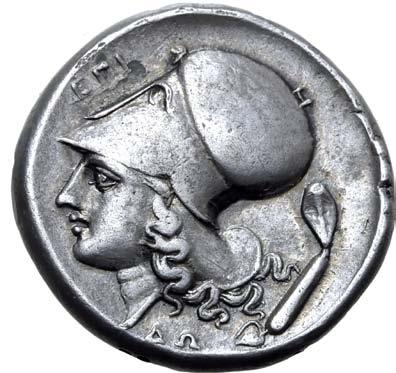



Good Very Fine; attractive old cabinet tone.
Acquired from Classical Numismatic Group; Ex D.K. Collection.
148.
Akarnania, Anaktorion AR Stater. Circa 350-300 BC. Pegasos flying to right; AN monogram below / Head of Athena to right, wearing Corinthian helmet; tripod within wreath and AN monogram behind. Pegasi 30; BCD Akarnania 89-90; HGC 4, 758. 8.55g, 22mm, 7h. Near
1,050
149.
Akarnania, Anaktorion AR Stater. Circa 345-300 BC. Pegasos flying to right; A below / Head of Athena to right, wearing Corinthian helmet; AN monogram below, Σ and tripod behind. Pegasi 28; BCD Akarnania -. 8.43g, 20mm, 9h.


Extremely Fine; pleasant old cabinet tone.
Acquired from Leu Numismatik AG.
Extremely Rare Variant
600
Akarnania, Anaktorion AR Stater. Circa 320-280 BC. Ari - and Do-, magistrates. Pegasos flying to left; AN monogram below / Head of Athena to left, wearing Corinthian helmet; API above, ΔΩ and flail behind. Pegasi -; BCD Akarnania -; Imhoof-Blumer, Akarnaniens 83 var. (form of monogram); BMC -; HGC 4, -; Leu Web 23, 3189. 8.55g, 21mm, 12h.
About Extremely Fine; die break to obv. Extremely Rare; unpublished and seemingly only one other example on CoinArchives.
Acquired from Nomos AG.
450
52
Extremely Fine.
from Nomos AG.
Acquired
450 147.
154.
Akarnania, Argos Amphilochikon AR Stater. Circa 340-300 BC. Pegasos flying to left, below, head of Molossian dog to left / Head of Athena to left, wearing Corinthian helmet; APΓEI above, behind, crested Corinthian helmet to left. Pegasi 9; BCD Akarnania 134-5; HGC 4, 783. 8.48g, 21mm, 6h. Near Extremely Fine.
Akarnania, Leukas AR Stater. Circa 320-280 BC. Pegasos flying to left; Λ below / Head of Athena to left, wearing Corinthian helmet; Λ and stylis behind; Ξ below. Pegasi 138; BMC 101; HGC 4, 825. 8.48g, 21mm, 6h.
Akarnania, Leukas AR Stater. Circa 320-280 BC. Pegasos flying to left; Λ below / Head of Athena to left, wearing Corinthian helmet; T-I and crested Macedonian helmet behind. Pegasi 151; BCD Akarnania 272; HGC 4, 825. 8.53g, 23mm, 9h.









Akarnania, Thyrrheion AR Stater. Circa 320-280 BC. Pegasos flying to left; Θ below / Head of Athena to left, wearing Corinthian helmet; Θ-Y flanking neck, ΛΥ beneath neck, earring with pendants behind head. Pegasi 13; BCD Akarnania 373.3; BMC 7. 8.56g, 19mm, 10h. Near Extremely Fine.






Leu Numismatik AG, Web Auction 20, 16 July 2022, lot 716.
Akarnania, Thyrrheion AR Stater. Circa 320-280 BC. Pegasos flying to left; Θ below / Head of Athena to left, wearing Corinthian helmet; Θ-Y flanking neck, YΛ beneath neck, earring with pendants behind head. Pegasi 13 var. (ΛY instead of YΛ); BCD Akarnania 373.3 (same); Imhoof-Blumer, Akarnaniens 12; BMC 9; HGC 4, -. 8.60g, 20mm, 11h.
53
Extremely Fine. Acquired from Nomos AG. 450
Extremely Fine; pleasant light cabinet tone. Acquired from Classical Numismatic Group. 900
151.
Extremely Fine; attractive iridescence around devices. Acquired from Leu Numismatik AG. 750
152.
450
Ex
153.
Acquired
from Nomos AG. 1,050 150.
Thessaly, Pharkadon AR Hemidrachm. Circa 420-400 BC. Hero (Thessalos?) advancing to right, wearing cloak and petasos flying behind, holding horns of bull forepart / Forepart of horse to right, ΦAPK(last two letters retrograde) around. BCD Thessaly II 604; HGC 4 292. 2.87g, 16mm, 2h.





Good Extremely Fine.
Ex Leu Numismatik AG, Auction 10, 24 October 2021, lot 2067; Ex Bavarian collection, formed in the early 2000s.
LOKRIS
450
Pedigreed to 1962
156.
Lokris, Lokri Opuntii AR Stater. Circa 370-360 BC. Wreathed head of Demeter to left, wearing pearl necklace and triple-pendant earring / Ajax, nude but for crested Corinthian helmet, advancing to right on rocky ground, holding sword and shield decorated with coiled serpent; Phrygian helmet between his legs; ΟΠΟΝ-ΤΙΩΝ around. H&D Group 3, 32a (O5/R8 - this coin); BCD Lokris 14; HGC 4, 989. 12.15g, 23mm, 3h.



Extremely Fine; attractive light cabinet tone. Rare.
This coin published in J.M. Humphris & D. Delbridge, The Coinage of the Opountian Lokrians (London, 2014);
Ex collection of a Provenance Enthusiast; Ex Bernard Poindessault Collection, Burgan Numismatique-Maison Florange, 17 November 2017, lot 46; Ex Münzen & Medaillen AG Basel, Auction 25, 17 November 1962, lot 448.
ELIS
An Extremely Rare Hera Mint Stater
4,500
157.
Elis, Olympia AR Stater. Hera mint, 95th Olympiad, 400 BC. Head of Hera to right, wearing stephanos inscribed HPA (Hera) between palmettes on band / Thunderbolt flanked by F-A; all within wreath. Seltman 275; BCD -; SNG Copenhagen 381; BMC 63. 12.07g, 21mm, 6h.



Very Fine. Extremely Rare; this type missing from the extensive BCD collection.
Acquired from A. H Baldwin & Sons Ltd (GBP 6,750); Ex VAuctions, Auction 333, 13 November 2018, lot 129; Ex Spink & Son Ltd, Auction 325, 21 June 2016, lot 34.
3,600
54
155. THESSALY


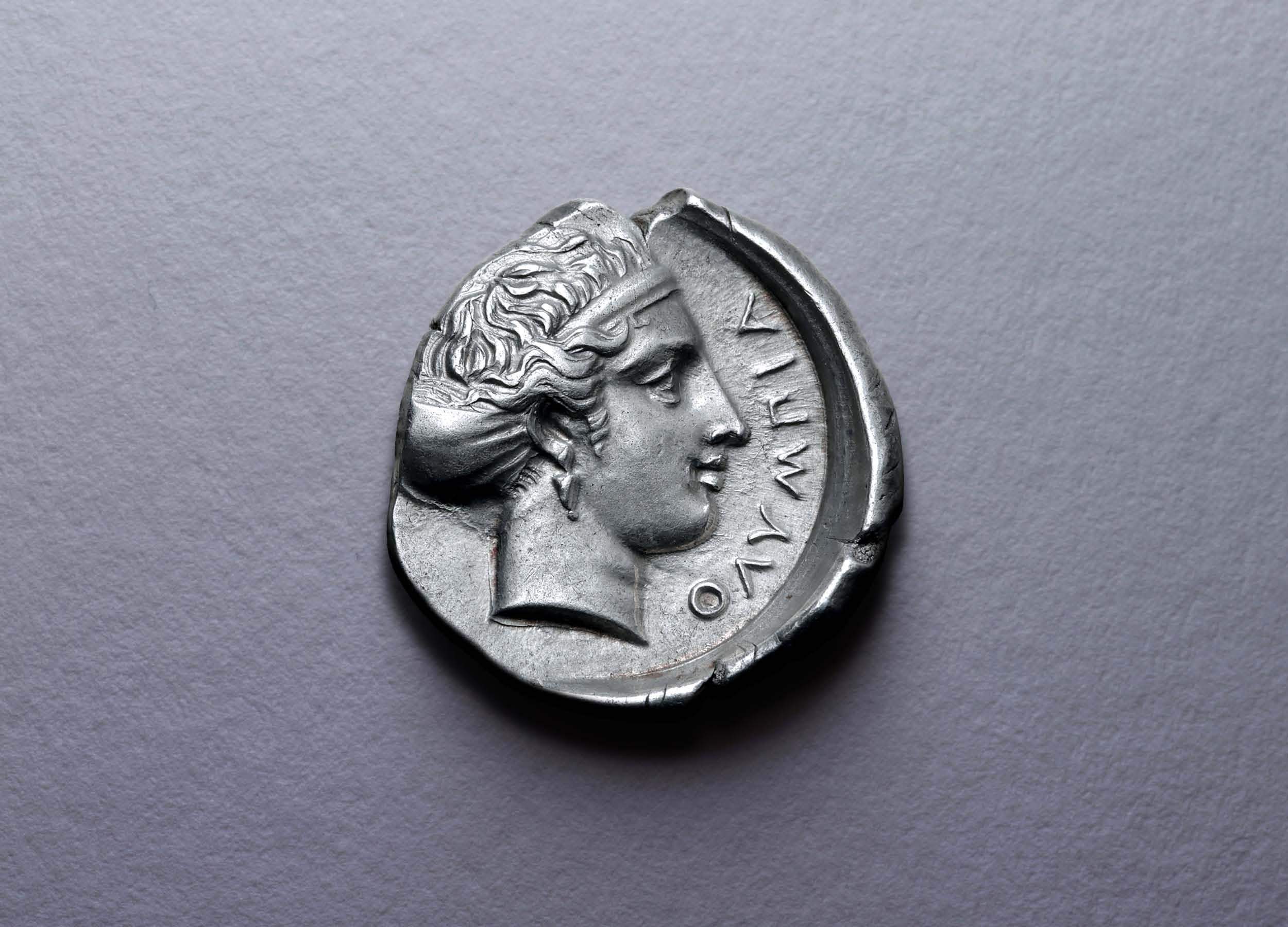
56
One of Seven; the Finest in Private Hands
Elis, Olympia AR Stater. 105th Olympiad, 360 BC. Head of Zeus to left, wearing laurel wreath; [FAΛEION to left] / Head of the nymph Olympia to right, hair in sphendone, wearing single-pendant earring; OΛYMΠIA to right; all within incuse circle. Seltman, Temple 175 (dies CA/δλ); BCD Olympia 118 (same dies); SNG Copenhagen -; BMC 71-2 (same dies); SNG Delepierre 2144 (same dies); Gulbenkian 544 = Jameson 1235 (same dies); ACGC 334 (same dies); HGC 5, 364 (this coin). 12.17g, 27mm, 11h.
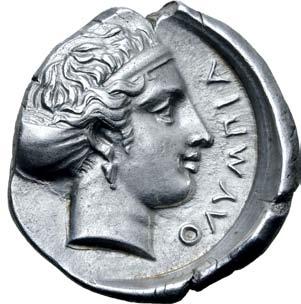
Good Extremely Fine. Extremely Rare; the seventh known and one of only two in private hands.
This coin published in O.D. Hoover, The Handbook of Greek Coins, Vol. 5 - Coins of the Peloponnesos (Lancaster PA, 2011); Ex Long Valley River Collection, Roma Numismatics Ltd., Auction XX, 29 October 2020, lot 98; Ex Roma Numismatics Ltd., Auction IV, 30 September 2012, lot 141 (hammer: 30,000 GBP); Ex Classical Numismatic Group, Triton XI, 8 January 2008, lot 179 (hammer: 30,000 USD).
13,500
The seventh known example, this is one of only two not in a museum collection, the other having been offered in the sale of the BCD Collection of The Coinage of Olympia (Leu 90, 10 May 2004, lot 118), and which was of decidedly poor preservation, being heavily worn. This is therefore the finest example in private hands.
After the withdrawal of the Arkadians in 363 BC, the Eleans reclaimed their control of the sanctuary of Olympia and resolved to strike an impressive series of coins for the 105th Olympiad in commemoration of the sanctuary’s liberation. From the number of dies that have been recorded for the issues following the re-establishment of Elean control of Olympia, it appears that the issue was far more extensive than Seltman had supposed. The engravers who were commissioned to produce the dies were among the most accomplished in the Greek world, and to effect this extraordinary series it was necessary to reopen the Zeus mint, closed since 388. Both it and the Hera mint were put to work, each with their own team of master engravers.
This fascinating coin displays a portrait of Zeus that stands in stark contrast to every other such image on the coinage of Olympia. This particular issue shows us a god unencumbered by the robust, severe and authoritative features that normally characterise his appearance. In their place is a god with a serene expression, noble and imposing, yet with an apparent benevolence that is surprising.

Paired with this remarkably refined image of Zeus is the first appearance of the eponymous nymph of the sanctuary, Olympia. She appears too on the obverse of the first contemporary issue of the Hera mint in a more mature form, but here she is rendered in a youthful style reminiscent of Arethusa on the high classical coinage of Syracuse. One of the most pleasing aspects of this important coin is the way in which Olympia betrays a hint of a smileno doubt contentedness at the return of the sacred site to the Eleans, as borne out in the legend FALEION OLYMPIA: ‘Olympia belongs to the Eleans’.

57
158.
159.
Corinthia, Corinth AR Stater. Circa 405-345 BC. Pegasos flying to left; Ϙ below / Head of Athena to right, wearing Corinthian helmet; ivy leaf behind. BCD Corinth 51; Pegasi 118; Ravel 374; HGC 4, 1833. 8.46g, 21mm, 2h.



Near Mint State; lustrous, with a sharply struck reverse. Very Rare. Ex Leu Numismatik AG, Web Auction 20, 16 July 2022, lot 825.
160.
Corinthia, Corinth AR Stater. Circa 345-307 BC. Pegasos flying to left; Ϙ below / Head of Athena to left, wearing laureate Corinthian helmet; A-P flanking below, eagle standing behind to left, head reverted. Pegasi 426; Ravel 1008; BCD Corinth 101; SNG Copenhagen 73-4; HGC 4, 1848. 8.55g, 21mm, 2h.




161.
Corinthia, Corinth AR Stater. Circa 345-307 BC. Pegasos flying to left; Ϙ below / Head of Athena to left, wearing laureate Corinthian helmet; A-P flanking below, eagle standing to left, head reverted, behind. Pegasi 426; Ravel 1008; BCD Corinth 101; SNG Copenhagen 73-4; HGC 4, 1848. 8.52g, 22mm, 4h.






Near Extremely Fine. Acquired from Nomos AG.
162.
Corinthia, Corinth AR Stater. Circa 345-307 BC. Pegasos flying to left; Ϙ below / Head of Athena to left, wearing laureate Corinthian helmet; A-P flanking below, aegis behind. Pegasi 427; BCD Corinth -; Ravel 1009; SNG Copenhagen 71; HGC 4, 1848. 8.56g, 21mm, 2h. Extremely Fine. Ex Historical Scholar collection. 1,200
58
900
CORINTHIA
1,050
Good Extremely Fine. Acquired from Classical Numismatic Group.
600
163.
Corinthia, Corinth AR Stater. Circa 345-307 BC. Pegasos flying to left, Ϙ below / Head of Athena to left, wearing Corinthian helmet; Γ beneath chin; behind, dove flying to left within wreath. Pegasi 419; Ravel 1029; BCD Corinth 110 = SNG Lockett 2094; SNG Copenhagen -; HGC 4, 1848. 8.56g, 22mm, 6h.



Extremely Fine.
Acquired from Nomos AG.
164.
Corinthia, Corinth AR Stater. Circa 345-307 BC. Pegasos flying to left; Ϙ below /Head of Athena to right, wearing Corinthian helmet; I below chin; behind, Nike flying to left, holding fillet. Pegasi 420; Ravel 1030; BCD Corinth 111; HGC 4, 1848. 8.52g, 21mm, 12h.




Good Extremely Fine; hints of golden iridescence around devices; an attractive example.
Acquired from Nomos AG.
165.
Corinthia, Corinth AR Stater. Circa 345-307 BC. Pegasos flying to left, Ϙ below / Head of Athena to left, wearing Corinthian helmet, I beneath chin; eight rayed star behind. Pegasi 425; Ravel 1034; BCD Corinth -; SNG Copenhagen 113; HGC 4, 1848. 8.60g, 21mm, 1h.

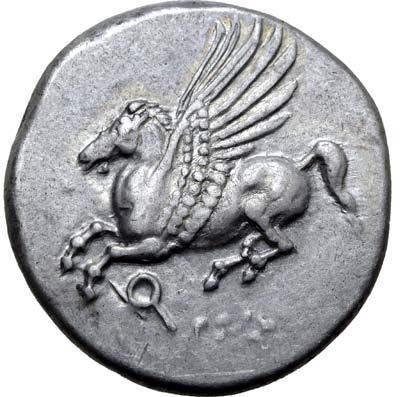
Mint State; attractive old cabinet tone.
Ex Stack’s Bowers Galleries (& Ponterio), Sale 173, 8 January 2013, lot 172.
600
600
1,500
166.
Corinthia, Corinth AR Stater. Circa 345-307 BC. Pegasos flying to left, Ϙ below / Head of Athena to left, wearing Corinthian helmet, A below, wreath behind head. Pegasi 404; BCD Corinth 116; HGC 4, 1848. 8.57g, 21mm, 2h.





Near Extremely Fine; beautiful golden iridescence around devices.
Acquired from Leu Numismatik AG.
600
59
167.
Corinthia, Corinth AR Stater. Circa 345-307 BC. Pegasos flying to left; Ϙ below / Head of Athena to right, wearing Corinthian helmet; bucranium and N in left field. BCD Corinth 125; Pegasi 382; Ravel 1064; HGC 4, 1846. 8.62g, 22mm, 2h.




Good Extremely Fine; well-centred, attractive old cabinet tone.
Ex Classical Numismatic Group, Auction 87, 18 May 2011, lot 473.
168.
Corinthia, Corinth AR Stater. Circa 345-307 BC. Pegasos flying to left; Ϙ below / Head of Athena to right, wearing Corinthian helmet; Δ-I flanking neck truncation; behind, Artemis running to right, holding torch. Pegasi 457; Ravel 1081; BCD Corinth 133; HGC 4, 1848. 8.57g, 21mm, 8h.








Good Extremely Fine; pleasant old cabinet tone.
Ex D.K. Collection;
Ex collection of P.G., Roma Numismatics Ltd, Auction XV, 5 April 2018, lot 93.
ARGOLIS Ex BCD Collection
2x
2x
1,800
169.
Argolis, Argos AR Trihemiobol. Circa 270-260/50 BC. Wolf at bay to left; Θ above / Crested Corinthian helmet to left, decorated with wreath; Π-Y flanking. BCD Peloponnesos 1114 (this coin); HGC 5, 674. 1.17g, 12mm, 10h.
Extremely Fine; old cabinet tone with beautiful golden iridescence around devices to obverse and attractive rainbow iridescence to reverse.
Ex North River Collection;
Ex Classical Numismatic Group, Auction 93, 22 May 2013, lot 325; Ex BCD Collection, LHS Numismatik AG, Auction 96, 8 May 2006, lot 1114.
1,050
1,050
60
ATHENS
An Attractive Archaic Tetradrachm

170.
Attica, Athens AR Tetradrachm. Circa 500-480 BC. Archaic head of Athena to right, wearing crested helmet decorated with chevron and dot pattern, and round earring / Owl standing to right with head facing, olive sprig behind, ΑΘΕ before; all within incuse square. Svoronos pl. 4; Seltman Group Gi-ii, unlisted dies; Asyut Group IVh; HGC 4, 1590. 17.52g, 23mm, 10h.


Near Extremely Fine; with an almost complete helmet crest. Rare.
Ex Nomos AG, Auction 23, 30 November 2021, lot 100.
3,000
171.
Attica, Athens AR Tetradrachm. Circa 500-480 BC. Archaic head of Athena to right, wearing crested Attic helmet decorated with chevron and dot pattern / Owl standing to right, head facing, olive sprig behind, AΘE before; all within incuse square. Seltman Group M, unlisted dies; Svoronos pl. 4 for similar obverse style, reverses show owls with longer legs than on this coin; HGC 4, 1590. 17.32g, 22mm, 6h.






Extremely Fine.
Ex Heritage World Coin Auctions, NYINC Signature Sale 3098, 18 January 2022, lot 33067 (hammer: USD 6,000).
1,800
Attica, Athens AR Tetradrachm. Circa 454-404 BC. Head of Athena to right, wearing crested Attic helmet ornamented with three olive leaves above visor and spiral palmette on bowl, round earring with central boss, and pearl necklace / Owl standing to right with head facing; olive sprig and crescent behind, ΑΘΕ before; all within incuse square. Kroll 8; Dewing 1591-8; SNG Copenhagen 31; HGC 4, 1597.
NGC graded MS 5/5 - 4/5 (#6672356-012).
Attica, Athens AR Tetradrachm. Circa 454-404 BC. Head of Athena to right, wearing crested Attic helmet ornamented with three olive leaves above visor and spiral palmette on bowl, round earring with central boss, and pearl necklace / Owl standing to right with head facing; olive sprig and crescent behind, ΑΘΕ before; all within incuse square. Kroll 8; Dewing 1591-8; SNG Copenhagen 31; HGC 4, 1597. 17.25g, 26mm, 9h.


Near Mint State; small die break on cheek, lustrous metal.

61
172. 600
173. 450
174. 450
175.
Attica, Athens AR Tetradrachm. Circa 454-404 BC. Head of Athena to right, wearing crested Attic helmet ornamented with three olive leaves above visor and spiral palmette on bowl, round earring with central boss, and pearl necklace / Owl standing to right with head facing, olive sprig and crescent behind, ΑΘΕ before; all within incuse square. Kroll 8; Dewing 1591-8; SNG Copenhagen 31; HGC 4, 1597. 17.32g, 25mm, 9h.
NGC graded MS 4/5 - 4/5 (#6674258-001).
Ex Roma Numismatics Ltd., E-Sale 93, 6 January 2022, lot 168.
176.
Attica, Athens AR Tetradrachm. Circa 454-404 BC. Head of Athena to right, wearing crested Attic helmet ornamented with three olive leaves above visor and spiral palmette on bowl, round earring with central boss, and pearl necklace / Owl standing to right with head facing, olive sprig and crescent behind, ΑΘΕ before; all within incuse square. Kroll 8; Dewing 1591-8; SNG Copenhagen 31; HGC 4, 1597. 17.24g, 24mm, 8h.
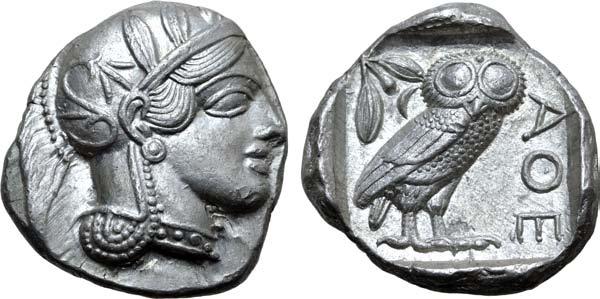
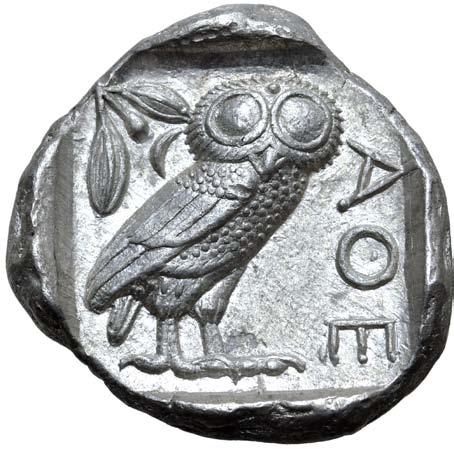




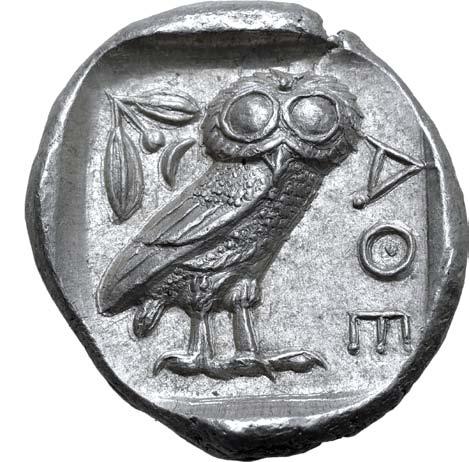



NGC graded MS 5/5 - 5/5 (#6674258-002).
Ex Roma Numismatics Ltd., E-Sale 93, 6 January 2022, lot 181.
Attica, Athens AR Tetradrachm. Circa 454-404 BC. Head of Athena to right, wearing crested Attic helmet ornamented with three olive leaves above visor and spiral palmette on bowl, round earring with central boss and pearl necklace / Owl standing to right with head facing, olive sprig and crescent behind, ΑΘΕ before; all within incuse square. Kroll 8; Dewing 1591-8; SNG Copenhagen 31; HGC 4, 1597. 17.24g, 25mm, 6h.
Near Mint State.
Ex Roma Numismatics Ltd., Auction XXII, 7 October 2021, lot 211.
177. 450
Attica, Athens AR Tetradrachm. Circa 454-404 BC. Head of Athena to right, wearing crested Attic helmet ornamented with three olive leaves above visor and spiral palmette on bowl, round earring with central boss and pearl necklace / Owl standing to right with head facing, olive sprig and crescent behind, ΑΘΕ before; all within incuse square. Kroll 8; Dewing 1591-8; SNG Copenhagen 31; HGC 4, 1597. 17.22g, 25mm, 7h.


Mint State.
Ex Roma Numismatics Ltd., Auction XXIII, 25 March 2022, lot 119.
62
450
450
Attica, Athens AR Tetradrachm. Circa 454-404 BC. Head of Athena to right, wearing crested Attic helmet ornamented with three olive leaves above visor and spiral palmette on bowl, round earring with central boss, and pearl necklace / Owl standing to right with head facing; olive sprig and crescent behind, ΑΘΕ before; all within incuse square. Kroll 8; Dewing 1591-8; SNG Copenhagen 31; HGC 4, 1597.
178. 450
NGC graded MS 5/5 - 4/5, Die Shift (#6674258-003).
179. 450
Attica, Athens AR Tetradrachm. Circa 454-404 BC. Head of Athena to right, wearing crested Attic helmet ornamented with three olive leaves above visor and spiral palmette on bowl, round earring with central boss, and pearl necklace / Owl standing to right with head facing, olive sprig and crescent behind, ΑΘΕ before; all within incuse square. Kroll 8; Dewing 1591-8; SNG Copenhagen 31; HGC 4, 1597. 17.23g, 27mm, 6h.


Good Extremely Fine; a near full helmet crest.
Ex Roma Numismatics Ltd., E-Sale 98, 16 June 2022, lot 134.
180. 450
Attica, Athens AR Tetradrachm. Circa 454-404 BC. Head of Athena to right, wearing crested Attic helmet ornamented with three olive leaves above visor and spiral palmette on bowl, round earring with central boss, and pearl necklace / Owl standing to right with head facing; olive sprig and crescent behind, ΑΘΕ before; all within incuse square. Kroll 8; Dewing 1591-8; SNG Copenhagen 31; HGC 4, 1597.
NGC graded Ch AU 5/5 - 3/5, lt. graffito (#6674258-004).
181. 450
Attica, Athens AR Tetradrachm. Circa 454-404 BC. Head of Athena to right, wearing crested Attic helmet ornamented with three olive leaves above visor and spiral palmette on bowl, round earring with central boss, and pearl necklace / Owl standing to right with head facing; olive sprig and crescent behind, ΑΘΕ before; all within incuse square. Kroll 8; Dewing 1591-8; SNG Copenhagen 31; HGC 4, 1597.
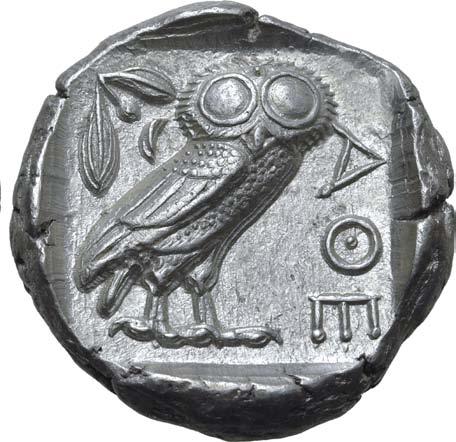
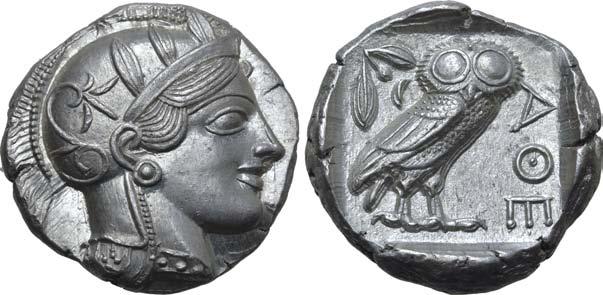







NGC graded MS 5/5 - 5/5 (#6674486-001).

63
182. 450
183.
Attica, Athens AR Tetradrachm. Circa 454-404 BC. Head of Athena to right, wearing crested Attic helmet ornamented with three olive leaves above visor and spiral palmette on bowl, round earring with central boss, and pearl necklace / Owl standing to right with head facing; olive sprig and crescent behind, ΑΘΕ before; all within incuse square. Kroll 8; Dewing 1591-8; SNG Copenhagen 31; HGC 4, 1597.
NGC graded MS 5/5 - 5/5 (#6674486-010).
Attica, Athens AR Tetradrachm. Circa 454-404 BC. Head of Athena to right, wearing crested Attic helmet ornamented with three olive leaves above visor and spiral palmette on bowl, round earring with central boss, and pearl necklace / Owl standing to right with head facing; olive sprig and crescent behind, ΑΘΕ before; all within incuse square. Kroll 8; Dewing 1591-8; SNG Copenhagen 31; HGC 4, 1597.
NGC graded MS 5/5 - 5/5 (#6674486-011).
Full Helmet Crest
450
184. 450
Attica, Athens AR Tetradrachm. Circa 454-404 BC. Head of Athena to right, wearing crested Attic helmet ornamented with three olive leaves above visor and spiral palmette on bowl, round earring with central boss, and pearl necklace / Owl standing to right with head facing; olive sprig and crescent behind, ΑΘΕ before; all within incuse square. Kroll 8; Dewing 1591-8; SNG Copenhagen 31; HGC 4, 1597.
NGC graded Ch AU 5/5 - 3/5, lt.graffito (#6674486-012).
185. 450
Attica, Athens AR Tetradrachm. Circa 454-404 BC. Head of Athena to right, wearing crested Attic helmet ornamented with three olive leaves above visor and spiral palmette on bowl, round earring with central boss, and pearl necklace / Owl standing to right with head facing; olive sprig and crescent behind, ΑΘΕ before; all within incuse square. Kroll 8; Dewing 1591-8; SNG Copenhagen 31; HGC 4, 1597.



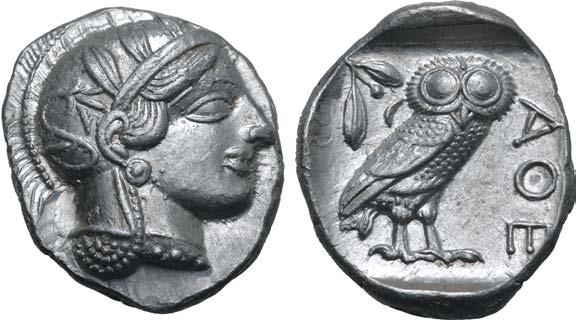
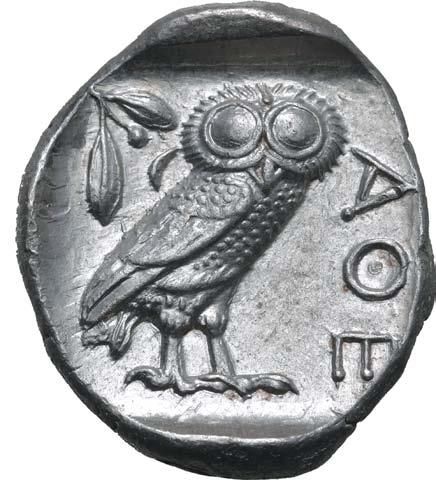






NGC graded MS 5/5 - 5/5 (#6674486-013).

64
186.
Attica, Athens AR Tetradrachm. Circa 454-404 BC. Head of Athena to right, wearing crested Attic helmet ornamented with three olive leaves above visor and spiral palmette on bowl, round earring with central boss, and pearl necklace / Owl standing to right with head facing; olive sprig and crescent behind, ΑΘΕ before; all within incuse square. Kroll 8; Dewing 1591-8; SNG Copenhagen 31; HGC 4, 1597.
NGC graded Ch AU 5/5 - 4/5, edge cut (#6674486-014).
450
187.
Attica, Athens AR Tetradrachm. Circa 454-404 BC. Head of Athena to right, wearing crested Attic helmet ornamented with three olive leaves above visor and spiral palmette on bowl, round earring with central boss, and pearl necklace / Owl standing to right with head facing; olive sprig and crescent behind, ΑΘΕ before; all within incuse square. Kroll 8; Dewing 1591-8; SNG Copenhagen 31; HGC 4, 1597.
NGC graded MS ★ 5/5 - 5/5, full crest (#6674486-002).
450
188. 450
Attica, Athens AR Tetradrachm. Circa 454-404 BC. Head of Athena to right, wearing crested Attic helmet ornamented with three olive leaves above visor and spiral palmette on bowl, round earring with central boss, and pearl necklace / Owl standing to right with head facing; olive sprig and crescent behind, ΑΘΕ before; all within incuse square. Kroll 8; Dewing 1591-8; SNG Copenhagen 31; HGC 4, 1597.
NGC graded MS 5/5 - 5/5 (#6674486-003).
189. 450
Attica, Athens AR Tetradrachm. Circa 454-404 BC. Head of Athena to right, wearing crested Attic helmet ornamented with three olive leaves above visor and spiral palmette on bowl, round earring with central boss, and pearl necklace / Owl standing to right with head facing; olive sprig and crescent behind, ΑΘΕ before; all within incuse square. Kroll 8; Dewing 1591-8; SNG Copenhagen 31; HGC 4, 1597.




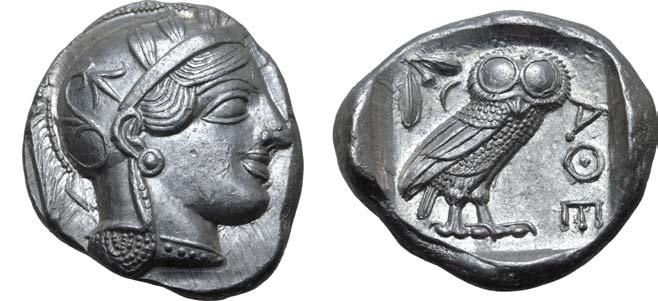






NGC graded MS 5/5 - 5/5 (#6674486-004).

65
Attica, Athens AR Tetradrachm. Circa 454-404 BC. Head of Athena to right, wearing crested Attic helmet ornamented with three olive leaves above visor and spiral palmette on bowl, round earring with central boss, and pearl necklace / Owl standing to right with head facing; olive sprig and crescent behind, ΑΘΕ before; all within incuse square. Kroll 8; Dewing 1591-8; SNG Copenhagen 31; HGC 4, 1597.
190. 450
NGC graded Ch AU 5/5 - 4/5 (#6674486-005).
191. 450
192.
Attica, Athens AR Tetradrachm. Circa 454-404 BC. Head of Athena to right, wearing crested Attic helmet ornamented with three olive leaves above visor and spiral palmette on bowl, round earring with central boss, and pearl necklace / Owl standing to right with head facing; olive sprig and crescent behind, ΑΘΕ before; all within incuse square. Kroll 8; Dewing 1591-8; SNG Copenhagen 31; HGC 4, 1597.
NGC graded MS 5/5 - 5/5 (#6674486-006).
193.
Attica, Athens AR Tetradrachm. Circa 454-404 BC. Head of Athena to right, wearing crested Attic helmet ornamented with three olive leaves above visor and spiral palmette on bowl, round earring with central boss, and pearl necklace / Owl standing to right with head facing; olive sprig and crescent behind, ΑΘΕ before; all within incuse square. Kroll 8; Dewing 1591-8; SNG Copenhagen 31; HGC 4, 1597.
NGC graded Ch AU 5/5 - 4/5 (#6674486-007).
Attica, Athens AR Tetradrachm. Circa 454-404 BC. Head of Athena to right, wearing crested Attic helmet ornamented with three olive leaves above visor and spiral palmette on bowl, round earring with central boss, and pearl necklace / Owl standing to right with head facing; olive sprig and crescent behind, ΑΘΕ before; all within incuse square. Kroll 8; Dewing 1591-8; SNG Copenhagen 31; HGC 4, 1597.




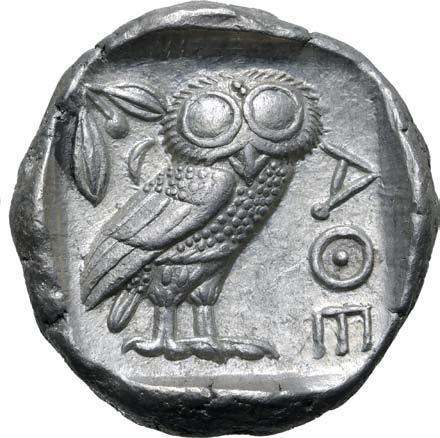

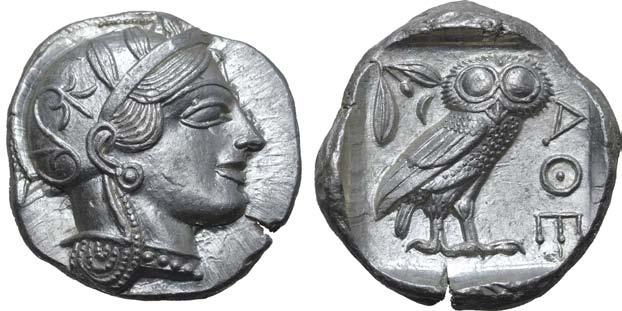




NGC graded Ch MS 5/5 - 5/5 (#6674486-009).

66
450
450
194.
Attica, Athens AR Tetradrachm. Circa 454-404 BC. Head of Athena to right, wearing crested Attic helmet ornamented with three olive leaves above visor and spiral palmette on bowl, round earring with central boss, and pearl necklace / Owl standing to right with head facing; olive sprig and crescent behind, ΑΘΕ before; all within incuse square. Kroll 8; Dewing 1591-8; SNG Copenhagen 31; HGC 4, 1597.
NGC graded MS 5/5 - 4/5 (#6674486-008).
450
195.
Attica, Athens AR Tetradrachm. Circa 454-404 BC. Head of Athena to right, wearing crested Attic helmet ornamented with three olive leaves above visor and spiral palmette on bowl, round earring with central boss, and pearl necklace / Owl standing to right with head facing; olive sprig and crescent behind, ΑΘΕ before; all within incuse square. Kroll 8; Dewing 1591-8; SNG Copenhagen 31; HGC 4, 1597.
NGC graded MS 5/5 - 5/5 (#6672356-002).
450
Attica, Athens AR Tetradrachm. Circa 454-404 BC. Head of Athena to right, wearing crested Attic helmet ornamented with three olive leaves above visor and spiral palmette on bowl, round earring with central boss, and pearl necklace / Owl standing to right with head facing; olive sprig and crescent behind, ΑΘΕ before; all within incuse square. Kroll 8; Dewing 1591-8; SNG Copenhagen 31; HGC 4, 1597.
NGC graded MS 5/5 - 5/5 (#6672356-003).
Attica, Athens AR Tetradrachm. Circa 454-404 BC. Head of Athena to right, wearing crested Attic helmet ornamented with three olive leaves above visor and spiral palmette on bowl, round earring with central boss, and pearl necklace / Owl standing to right with head facing; olive sprig and crescent behind, ΑΘΕ before; all within incuse square. Kroll 8; Dewing 1591-8; SNG Copenhagen 31; HGC 4, 1597.


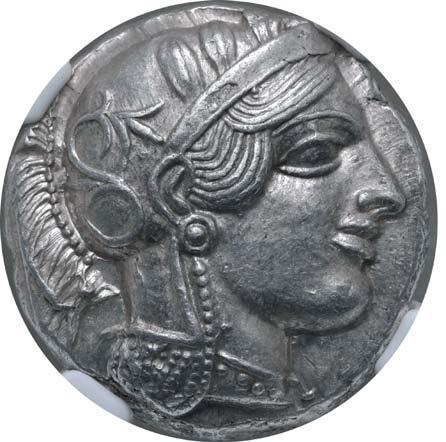


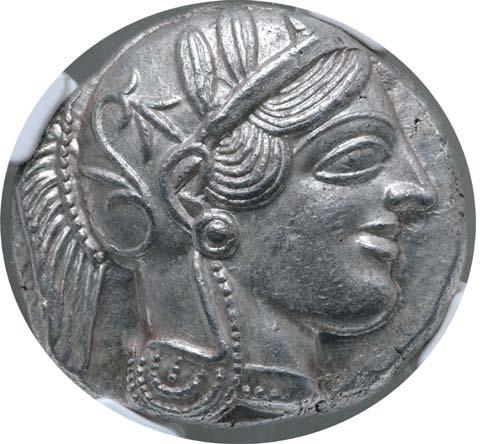

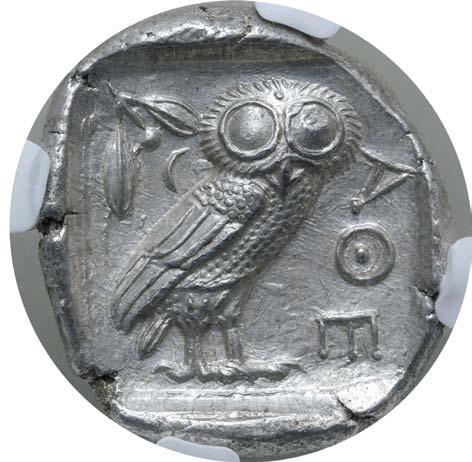

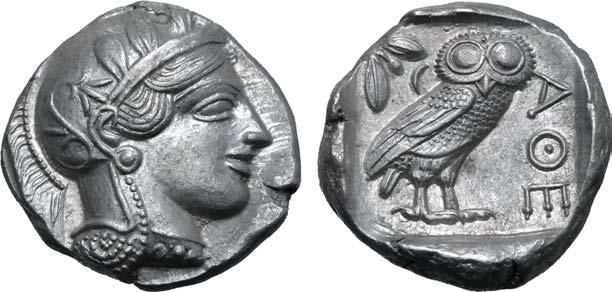

NGC graded MS 5/5 - 4/5 (#6672356-004).

67
196. 450
197. 450
Attica, Athens AR Tetradrachm. Circa 454-404 BC. Head of Athena to right, wearing crested Attic helmet ornamented with three olive leaves above visor and spiral palmette on bowl, round earring with central boss, and pearl necklace / Owl standing to right with head facing; olive sprig and crescent behind, ΑΘΕ before; all within incuse square. Kroll 8; Dewing 1591-8; SNG Copenhagen 31; HGC 4, 1597.
198. 450
NGC graded Ch AU 5/5 - 5/5 (#6672356-005).
199. 450
200.
Attica, Athens AR Tetradrachm. Circa 454-404 BC. Head of Athena to right, wearing crested Attic helmet ornamented with three olive leaves above visor and spiral palmette on bowl, round earring with central boss, and pearl necklace / Owl standing to right with head facing; olive sprig and crescent behind, ΑΘΕ before; all within incuse square. Kroll 8; Dewing 1591-8; SNG Copenhagen 31; HGC 4, 1597.
NGC graded MS 5/5 - 5/5 (#6672356-009).
Attica, Athens AR Tetradrachm. Circa 454-404 BC. Head of Athena to right, wearing crested Attic helmet ornamented with three olive leaves above visor and spiral palmette on bowl, round earring with central boss, and pearl necklace / Owl standing to right with head facing; olive sprig and crescent behind, ΑΘΕ before; all within incuse square. Kroll 8; Dewing 1591-8; SNG Copenhagen 31; HGC 4, 1597.
NGC graded Ch AU 5/5 - 4/5, edge cut (#6672356-001).
450
201. 450
Attica, Athens AR Tetradrachm. Circa 454-404 BC. Head of Athena to right, wearing crested Attic helmet ornamented with three olive leaves above visor and spiral palmette on bowl, round earring with central boss, and pearl necklace / Owl standing to right with head facing; olive sprig and crescent behind, ΑΘΕ before; all within incuse square. Kroll 8; Dewing 1591-8; SNG Copenhagen 31; HGC 4, 1597.
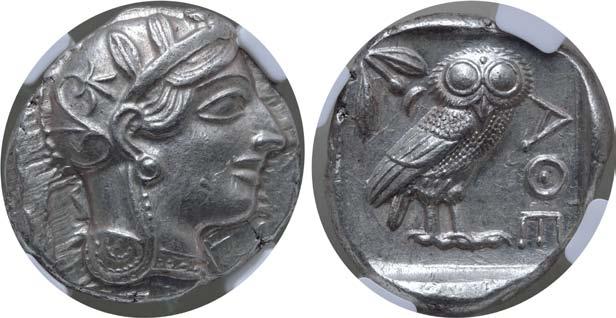









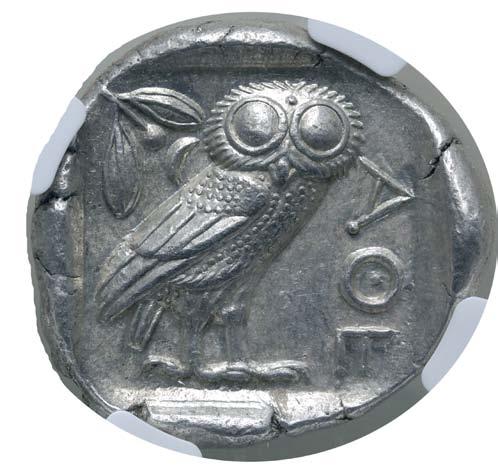
NGC graded MS 4/5 - 5/5 (#6672356-008).

68
Attica, Athens AR Tetradrachm. Circa 454-404 BC. Head of Athena to right, wearing crested Attic helmet ornamented with three olive leaves above visor and spiral palmette on bowl, round earring with central boss, and pearl necklace / Owl standing to right with head facing; olive sprig and crescent behind, ΑΘΕ before; all within incuse square. Kroll 8; Dewing 1591-8; SNG Copenhagen 31; HGC 4, 1597.
NGC graded MS 5/5 - 4/5, brushed (#6672356-010).
450
204.
Attica, Athens AR Tetradrachm. Circa 454-404 BC. Head of Athena to right, wearing crested Attic helmet ornamented with three olive leaves above visor and spiral palmette on bowl, round earring with central boss, and pearl necklace / Owl standing to right with head facing; olive sprig and crescent behind, ΑΘΕ before; all within incuse square. Kroll 8; Dewing 1591-8; SNG Copenhagen 31; HGC 4, 1597.
NGC graded MS 5/5 - 4/5 (#6672356-011).
Full Helmet Crest
450
Attica, Athens AR Tetradrachm. Circa 454-404 BC. Head of Athena to right, wearing crested Attic helmet ornamented with three olive leaves above visor and spiral palmette on bowl, round earring with central boss, and pearl necklace / Owl standing to right with head facing; olive sprig and crescent behind, ΑΘΕ before; all within incuse square. Kroll 8; Dewing 1591-8; SNG Copenhagen 31; HGC 4, 1597.
NGC graded Ch AU★ 5/5 - 5/5 (#6672356-013).
450
205. 450
Attica, Athens AR Tetradrachm. Circa 454-404 BC. Head of Athena to right, wearing crested Attic helmet ornamented with three olive leaves above visor and spiral palmette on bowl, round earring with central boss, and pearl necklace / Owl standing to right with head facing; olive sprig and crescent behind, ΑΘΕ before; all within incuse square. Kroll 8; Dewing 1591-8; SNG Copenhagen 31; HGC 4, 1597.








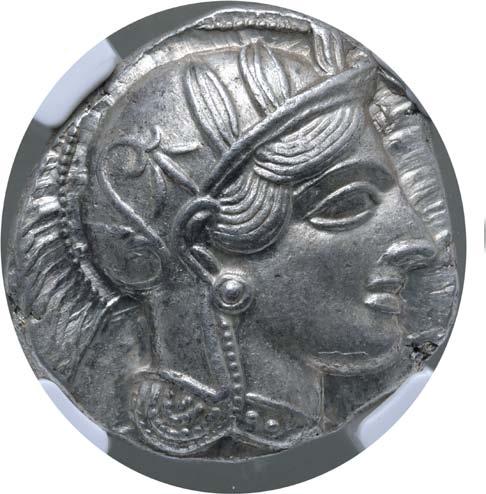


NGC graded Ch AU 5/5 - 5/5 (#6672356-014).

69
202.
203.
206. 450
207.
Attica, Athens AR Tetradrachm. Circa 454-404 BC. Head of Athena to right, wearing crested Attic helmet ornamented with three olive leaves above visor and spiral palmette on bowl, round earring with central boss, and pearl necklace / Owl standing to right with head facing; olive sprig and crescent behind, ΑΘΕ before; all within incuse square. Kroll 8; Dewing 1591-8; SNG Copenhagen 31; HGC 4, 1597.
NGC graded MS 5/5 - 5/5 (#6672356-015).
Attica, Athens AR Tetradrachm. Circa 454-404 BC. Head of Athena to right, wearing crested Attic helmet ornamented with three olive leaves above visor and spiral palmette on bowl, round earring with central boss, and pearl necklace / Owl standing to right with head facing; olive sprig and crescent behind, ΑΘΕ before; all within incuse square. Kroll 8; Dewing 1591-8; SNG Copenhagen 31; HGC 4, 1597.
NGC graded MS 5/5 - 5/5 (#6672356-016).
450
Attica, Athens AR Tetradrachm. Circa 454-404 BC. Head of Athena to right, wearing crested Attic helmet ornamented with three olive leaves above visor and spiral palmette on bowl, round earring with central boss, and pearl necklace / Owl standing to right with head facing; olive sprig and crescent behind, ΑΘΕ before; all within incuse square. Kroll 8; Dewing 1591-8; SNG Copenhagen 31; HGC 4, 1597.
208. 450
NGC graded Ch AU 5/5 - 4/5 (#6672356-018).
Attica, Athens AR Tetradrachm. Circa 454-404 BC. Head of Athena to right, wearing crested Attic helmet ornamented with three olive leaves above visor and spiral palmette on bowl, round earring with central boss, and pearl necklace / Owl standing to right with head facing; olive sprig and crescent behind, ΑΘΕ before; all within incuse square. Kroll 8; Dewing 1591-8; SNG Copenhagen 31; HGC 4, 1597.


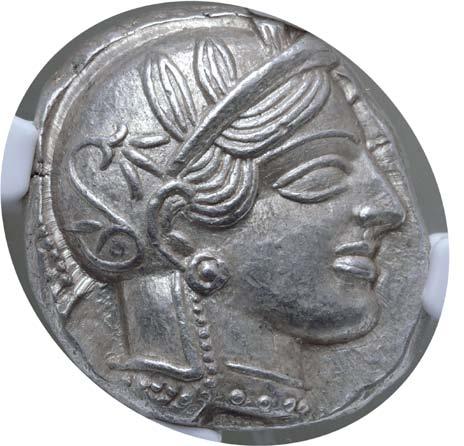








NGC graded MS 5/5 - 5/5 (#6672356-021).

70
209. 450
Attica, Athens AR Tetradrachm. Circa 454-404 BC. Head of Athena to right, wearing crested Attic helmet ornamented with three olive leaves above visor and spiral palmette on bowl, round earring with central boss, and pearl necklace / Owl standing to right with head facing; olive sprig and crescent behind, ΑΘΕ before; all within incuse square. Kroll 8; Dewing 1591-8; SNG Copenhagen 31; HGC 4, 1597.
210. 450
NGC graded MS 5/5 - 5/5 (#6672356-022).
Attica, Athens AR Tetradrachm. Circa 454-404 BC. Head of Athena to right, wearing crested Attic helmet ornamented with three olive leaves above visor and spiral palmette on bowl, round earring with central boss, and pearl necklace / Owl standing to right with head facing; olive sprig and crescent behind, ΑΘΕ before; all within incuse square. Kroll 8; Dewing 1591-8; SNG Copenhagen 31; HGC 4, 1597.
NGC graded Ch AU 5/5 - 5/5 (#6672356-023).
450
Attica, Athens AR Tetradrachm. Circa 454-404 BC. Head of Athena to right, wearing crested Attic helmet ornamented with three olive leaves above visor and spiral palmette on bowl, round earring with central boss, and pearl necklace / Owl standing to right with head facing; olive sprig and crescent behind, ΑΘΕ before; all within incuse square. Kroll 8; Dewing 1591-8; SNG Copenhagen 31; HGC 4, 1597.












NGC graded MS 5/5 - 4/5 (#6672356-024).
450
71
211.
212.
BOIOTIA
215.
Boiotia, Thebes AR Stater. Circa 390-382 BC. Wast(ias), magistrate. Boiotian shield / Amphora with a decorated upper half, barley grain above, FA-ΣT across central field; all within shallow incuse circle. Hepworth 36; BCD Boiotia 494; BMC 120; HGC 4, 1330. 12.04g, 23mm, 11h.
213. 600
Good Very Fine; beautiful cabinet tone.
Ex Maggiore Collection, formed in the late 1970s to early 2000s, Leu Numismatik AG, Web Auction 6, 9 December 2018, lot 156.
Boiotia, Thebes AR Stater. Circa 368-364 BC. Klio(n), magistrate. Boiotian shield / Amphora with tall handles and a decorated upper half; ΚΛ-ΙΩ across fields. BCD Boiotia 531; SNG Copenhagen 343; Hepworth 69. 12.20g, 21mm, 10h.











Near Extremely Fine.
Acquired from Dr. Busso Peus Nachfolger; Ex collection of a Provenance Enthusiast; Ex VAuctions, Auction 255, 18 November 2010, lot 17.
Ex
Ponterio 151, 2009
Boiotia, Thebes AR Stater. Circa 363-338 BC. Lyki(no)-, magistrate. Boiotian shield / Amphora; grape bunch on vine above, ΛY-KI across fields; all within incuse circle. BCD Boiotia 571 (same rev. die); Hepworth 75 (same rev. die); SNG Copenhagen 345 (same rev. die); HGC 4, 1334. 12.30g, 22mm.
Extremely Fine. Very Rare.
Ex Hestia Collection, formed over the past five decades; Ex Classical Numismatic Group, Auction 87, 18 May 2011, lot 451 (lot ticket included); Ex Ponterio & Associates, Sale 151 - Baltimore Auction, 12 November 2009, lot 8056 (lot ticket included).
1,050
72
214. 600
CYCLADES
One of the Rarest Cycladic Coins
Cyclades, Tenos AR Tetradrachm. Circa 200-180 BC. Head of Apollo Karneios to right / Poseidon seated to left, holding trident and dolphin; THNIΩN to right, grape bunch to left, monogram below throne. Étienne & Artémis-Gyselen 202; HGC 6, 727. 13.91g, 24mm, 12h.




Good Very Fine. Extremely Rare; Étienne and Artémis-Gyselen note only six surviving tetradrachms from Tenos.
From the Apollo to Apollo Collection.
The head on the obverse of this coin, while clearly inspired by the portrait of Alexander on the principal type of Lysimachos, cannot be other than Apollo Karneios, due to the presence of the laurel wreath. This intriguing issue is one of the very rarest of all Cycladic coins.
CRETE
Only Two Recorded by Le Rider
217.
Crete, Gortyna AR Drachm. Circa 4th century BC. Head of Persephone to right, hair bound with barley wreath, wearing triple pendant earring and necklace / ΓΟΡΤΙΝΙΩΝ, Cretan bull standing to right, head reverted. Le Rider p. 83, 90. pl. 20, 16 (same dies); Svoronos 90, pl. 15, 10 (same dies); Traité pl. 254, 13 (same dies). 5.89g, 19mm, 7h.



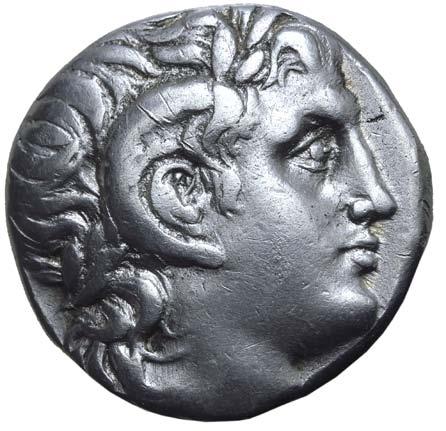
Extremely Fine. Extremely Rare; only two examples recorded by Le Rider
Ex Long Valley River Collection, Roma Numismatics Ltd., Auction XX, 29 October 2020, lot 116; Ex Roma Numismatics Ltd., Auction IX, 22 March 2015, lot 265.
2,400
1,800
73
216.


74
Ex Charles Gillet Collection, Pedigreed to 1909
Crete, Phaistos AR Stater. Mid-Late 4th century BC. Herakles standing in fighting attitude to left, wearing Nemean lion skin, seizing one of the heads of the Lernean Hydra, and preparing to strike with club; crab by right foot / ΦΑΙΣΤΙOΝ (retrograde), bull butting to right on straight exergual line. Cf. Svoronos 60 (obv. die); cf. Le Rider pl. 23, 24; cf. Babelon, Traité, 1657, pl. 257, 1; Gillet 1019 (this coin). 11.68g, 29mm, 4h.


Very Fine; beautiful old cabinet tone. Extremely rare variety with bull charging to right and retrograde legend; seemingly the only example thus on CoinArchives.
Ex Bank Leu AG, Auction 28, 5 May 1981, lot 124.
Ex Charles Gillet Collection; Ex F. S. Benson collection, Sotheby, Wilkinson & Hodge, 3 February 1909, lot 615.
15,000
The historian Pausanias suggested that the mythological founder of the city of Phaistos was Phaestos, son of Herakles. This aspirational lineage is supported by the depiction of Herakles’ second labour on this stater: slaying the ancient serpent-like monster that resided in the lake of Lerna in the Argolid, which guarded an underwater entrance to the underworld. The obverse shows Herakles in his characteristic lion skin, gained by killing the Nemean lion in his first labour. The scene is full of movement, showing a muscular Herakles holding one head of the writhing many headed hydra and preparing to swing at it with his club.

Upon removing each of the Hydra’s heads however, Herakles found that two more would grow back in its place, an expression of the hopelessness of such a struggle for any but the hero. Realizing that he could not defeat the Hydra in this way, Herakles called on his nephew Iolaos for help. Iolaos then came upon the idea (possibly inspired by Athena) of using a firebrand to cauterize the stumps after each decapitation. When Hera saw that Herakles was gaining the upper hand she sent a large crab to distract the hero, but Herakles crushed it underfoot. He cut off the last and strongest of the Hydra’s heads with a golden sword given to him by Athena, and so completed his task. Hera, upset that Herakles had slain the beast she raised to kill him, placed it in the vault of the heavens as the constellation Hydra, and she turned the crab into the constellation Cancer
The encounter with the Lernean Hydra is not only well attested in epic, but is also the subject of some of the earliest securely identifiable Herakles scenes in Greek art. On two Boiotian fibulae of c. 750-700 BC (BM 3025, Philadelphia 75-35-1), the hydra is attacked by Herakles, at whose feet is the crab sent by Hera. This particular form of the scene would later be replicated on the coins of Phaistos (cf. Svoronos 60, pl. XXIV, 20), even including the crab. The die engraver chose to depict Hera’s ‘giant’ crab from the myth, as a small creature no larger than the lion’s paw; this has the dual purpose of making the animal appear insignificant and surmountable, right next to the foot that will crush it, and does not detract from main action of the killing of the hydra. This is a compositionally superior piece, visually balanced on a large planchet.
75
It has been repeatedly suggested that the later designs of Phaistos copy a now lost masterpiece of sculpture or painting, perhaps even a statue group by the great sculptor Lysippos (see Lehmann, ‘Statues on Coins’, New York 1946; see also Lacroix, ‘Les Reproductions de Statues sur les Monnaies Grecques’, Liege 1949; see also Lattimore, ‘Lysippian Sculpture on Greek Coins’, California Studies in Classical Antiquity Vol. 5 1972). Lattimore makes a plausible and convincing argument for the Herakles-Hydra confrontation as depicted here being copied from a sculpture; in particular he notes that a sculptural prototype is strongly suggested by ‘a feature that is rare, possibly unique, in Greek numismatic design: the group of combatants is shown from both sides, not in mirror reversal, but as two profile views of a three-dimensional group’ (cf. Svoronos pl. XXIV, 17 and 22, and Wroth pl. XV, 6). Lattimore notes two discrepancies: that the head of the lion skin is sometimes depicted whether we are shown the front or back view of Herakles, and the lion’s paw always passes behind the body of Herakles, but he explains these as a minor and illustrative artistic licence on the part of the die engraver, and a practical necessity to avoid overlapping planes, respectively. 218.
Agression and Valour
Macedon, Akanthos AR Tetradrachm. Circa 470-430 BC. Bull collapsing to left, head raised, attacked and mauled by lion upon his back to right; tunny fish to left in exergue / AKANΘION in shallow incuse around quadripartite square, the quarters raised and granulated. Desneux 96ff; Weber 1863; HGC 3.1, 385. 17.29g, 30mm, 5h.




Good Extremely Fine; beautiful cabinet tone.
Ex Auktionshaus H. D. Rauch GmbH, Auction 107, 12 November 2018, lot 98.
9,000
The ubiquitous and persistent theme of the lion-bull combat can be traced back to the figurate art of the third millennium, where the geometrical motifs are replaced by narrative symbolic representations, and the scene is characteristic of Near Eastern art in its infancy. The earliest known depiction occurs on a ewer found at Uruk dated to the latter part of the Protoliterate period, circa 3300 BC. That ewer has a relief depiction of a lion attacking a bull from behind (see Henri Frankfort, Art and Architecture of the Ancient Orient, 1963). The scene became widely distributed by 500 BC, featuring prominently in the Achaemenid Empire, and in particular at the palace of Darios in Persepolis, where it occurs no fewer than twenty seven times, including on the main staircase leading to the imperial complex. Its frequent appearance in key locations strongly suggests an important symbolic significance, which unfortunately has not survived antiquity in any explicitly clear form.
Explanations for the symbolism and its power over the ancient peoples who reproduced it with prodigious enthusiasm have ranged from it being an expression of royal power, to an astronomical allusion, as well as it being an embodiment of the constant struggle between civilisation (represented by the domesticated bull) and nature (represented by the untameable lion). This latter argument may well hold true for the Mesopotamians of Uruk, who it is known took a rather grim view of the world, seeing it as a battleground of opposing powers.
One interpretation that has gained traction in recent years is that the motif is apotropaic in nature, serving to ward off evil in a similar function to the gorgoneion, which like the lion attack motif is very prevalent in ancient Greek coinage, though there is little evidence to support such a notion.
G. E. Markoe (‘The Lion Attack in Archaic Greek Art’, Classical Antiquity Vol. 8, 1, 1989) convincingly suggests that a more likely explanation may be found in the examination of archaic Greek epic poetry, particularly in Homeric literature, wherein a lion attacking cattle or sheep is repeatedly employed as a simile for the aggression and valour of combatant heroes. In notable passages, Agamemnon’s victorious advance against the Trojans in the Iliad (11.113ff and 129) and Hektor’s successful pursuit of the Achaeans (15.630ff) are both likened to a lion triumphing over its hapless prey. In both of these cases the allusion is completed by the defeated being compared to fleeing prey animals. In all, there are twenty five examples present in the Iliad of heroic warriors being compared to leonine aggressors, with the victims variously compared to boars, sheep, goats, bulls or deer. The repetition of this literary device is clearly demonstrative of how deeply rooted the imagery was in the Greek (and perhaps more generally human) consciousness. Of further and great significance is the involvement of the gods as the primary instigators of heroic leonine aggression in almost every case, and as it is made clear that the lion itself is an animal that is divinely directed to its prey (11.480, by a daimon), so then is the lion attack a metaphor for divinely inspired heroic triumph.
76
219.
MACEDON
Beautiful and Unusual Orientalised Style
Macedon, Akanthos AR Tetradrachm. Circa 470-430 BC. Bull collapsing to left, attacked and mauled by lion upon his back to right; A above, floral ornament in exergue / Quadripartite incuse square. Desneaux 90; AMNG III pl VI, 19 var. (obv. legend); HGC 3.1, 384. 17.55g, 30mm.


Near Mint State; beautiful and unusual orientalised style.
4,500
Macedon, Akanthos AR Tetradrachm. Circa 470-430 BC. Bull collapsing to left, head raised, attacked and mauled by lion upon his back to right; tunny fish to left in exergue / ΑΚΑΝΘΙΟΝ around raised quadripartite square; all within incuse square. Cf. Desneux 96ff (unlisted obv. die); HGC 3.1, 385; Roma XVI, 203 (same dies). 17.21g, 30mm, 8h.






Extremely Fine.
4,500
77
220.
221.
Macedon, Akanthos AR Tetradrachm. Circa 470-430 BC. Lion to right, leaping upon and attacking bull to left; in exergue, tunny fish swimming to left / ΑΚΑΝΘΙΟΝ around raised quadripartite square; all within incuse square. Desneux 95/96 (D92/R86(?)); HGC 3.1, 385. 17.23g, 29mm, 5h.






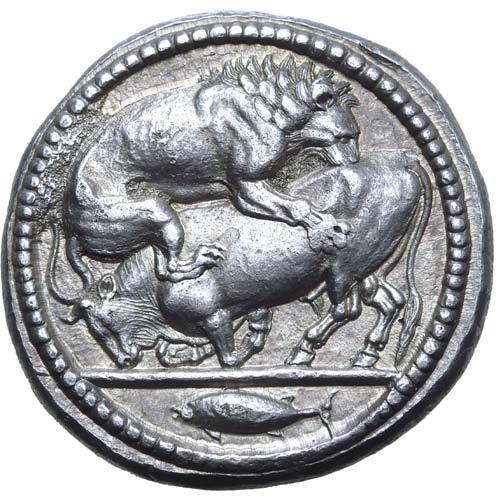
NGC graded Ch AU★ 5/5 - 5/5, Fine Style, die shift (#6674261-001).
4,500
Macedon, Akanthos AR Tetradrachm. Circa 470-430 BC. Lion to right, attacking bull crouching to left; in exergue, tunny fish swimming to left / AKANΘION in shallow incuse around quadripartite square, the quarters raised and granulated. Desneaux 98 (D95/R88); HGC 3.1, 385. 17.50g, 29mm, 4h.
Extremely Fine; light cabinet tone.

78
222.
223.
4,500
Macedon, Philippoi AV Stater. Circa 356-345 BC. Head of Herakles to right, wearing lion skin headdress / Tripod; ΦIΛIΠΠΩN upwards to left; stag head to right in right field. BMC 3; Boston MFA 583 = Warren 593; Bellinger, Philippi 18; AMNG III/2, 3 var. (horse head on rev.); cf. HGC 3.1, 628 (same type, symbol not listed). 8.57g.
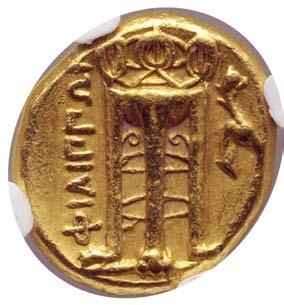


NGC graded Ch XF 4/5 - 4/5, edge marks (#5873092-003). Extremely Rare.
Acquired from Vilmar Numismatics; Ex Heritage World Coin Auctions, Dallas Signature Sale 3085, 5 August 2020, lot 30007; Ex Jonathan P. Rosen Collection, Classical Numismatic Group, Triton XXIII, 14 January 2020, lot 192.
7,500
Originally a Thasian foundation, the town of Daton alternated between Athenian control for most of the fifth century, a brief period of local autonomy in the first half of the fourth century, and once more came under the control on Thasos in circa 360 BC when the local mines were recaptured with Athenian backing and the town was refounded with the new name of Krenides. Shortly thereafter however, in 356 Krenides was threatened by Thracians, and the citizens appealed to the rising power in the area, Philip of Macedon. Philip had conquered Amphipolis the year before, and he now took Krenides under his aegis. The city was strengthened greatly with new fortifications, enlarged with new colonists, and was renamed Philippoi in honour of the king.
Having gained command of the Mount Pangeion region and the 1000 talents a year in gold that its mines provided, Philip at first permitted the city to continue striking coinage in its own name, using types that it had previously employed, in both gold and silver - it is to this period of production that the present coin belongs. For a time therefore, the coinage of Philippoi must have circulated alongside Philip’s royal coinage, however with the advent of Philip’s currency reforms of the 340s, gold production at Philippoi came to an end.
This stater belongs to the second issue of staters by the city, continuing the Herakles / tripod type which had been employed prior to the Macedonian recolonisation, altering, however, the obverse bust type slightly to exhibit a more conventional style, with the paws of the lion skin closed around the neck of Herakles. The stag’s head variety is particularly rare, with only a handful known, perhaps as a result of the fact that gold production at Philippi was short-lived, and this second series was terminated before the end of the 340s BC.
As for the city itself, following its incorporation into the Kingdom of Macedon, it would next feature significantly on the pages of history only centuries later when in October 42 BC, on the plain to the west of the city, the legions of Octavian and Marc Antony faced those Brutus and Cassius to determine the fate of the Roman world.

79
Ex Jonathan P. Rosen Collection
224.
Kingdom of Macedon, Philip II AR Tetradrachm. Pella, 336/5-329/8 BC. Laureate head of Zeus to right / Youth on horseback to right, holding palm; ΦIΛIΠΠOY around, wreath below. Le Rider 384-387; SNG ANS 416 (same rev. die); HGC 3.1, 865 (Amphipolis, unlisted symbol). 14.33g, 24mm, 9h.

Good Extremely Fine; pleasant light cabinet tone.
Acquired from Dr. Busso Peus Nachfolger; Ex collection of a Provenance Enthusiast; Ex Gorny & Mosch Giessener Münzhandlung, Stuttgart Auction 1, 22 November 2010, lot 169.
Extremely Rare
2x 2x
1,950
226. 600
227.
Kingdom of Macedon, Philip II AR 1/10 Tetradrachm. Struck under Antipater, Polyperchon, or Kassander. Pella, circa 323/2 - 315 BC. Diademed head to right / ΦIΛIΠΠOY, bridled head of horse to right, thunderbolt below. Le Rider 482 (D255/R397); SNG ANS 437; HGC 3.1 -. 1.24g, 12mm, 12h.


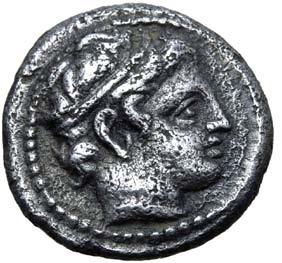
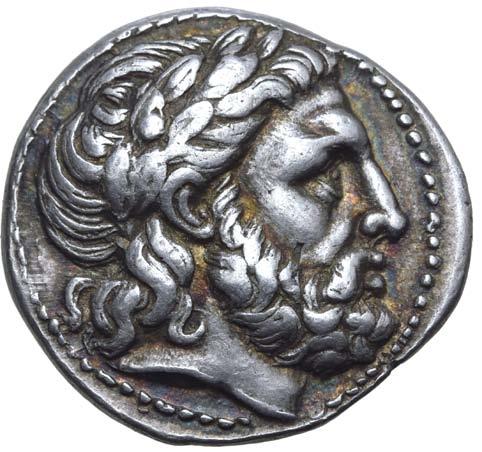

Extremely Fine; slightly porous. Extremely Rare.
Kingdom of Macedon, Philip II AR Tetradrachm. Struck under Kassander or his son Antipater. Amphipolis, circa 315-294 BC. Laureate head of Zeus to right / Youth on horseback to right, holding palm; ΦIΛIΠΠOY around, monogram below horse, Λ above torch below foreleg. Le Rider pl. 47, 12 (this coin). 14.31g, 27mm, 10h.



Good Very Fine; slight scratches and patch of discoloration on rev., attractive hints of iridescence.

80
225.
Ex Gorny & Mosch, 2010
This coin published in G. Le Rider, Le Monnayage d’argent et d’or de Philippe II frappé en Macédoine de 359 à 294 (1977); Ex Baldwin’s Auctions Ltd., Auction 75, 26 September 2012, lot 2187 (sale certificate included); Ex Ars Classica, Auction XIII, 27-29 June 1928, lot 482. 480
Published in Le Rider and Ex Ars Classica, 1928
Kingdom of Macedon, Alexander III ‘the Great’ AV Stater. Uncertain mint in western Asia Minor, circa 250-225 BC. Head of Athena to right, wearing necklace and crested Corinthian helmet decorated with coiled serpent / Nike standing facing, head to left, holding wreath and stylis; ΑΛΕΞΑΝΔΡΟΥ to right. Price 2696; Müller -. 8.42g, 19mm, 12h.


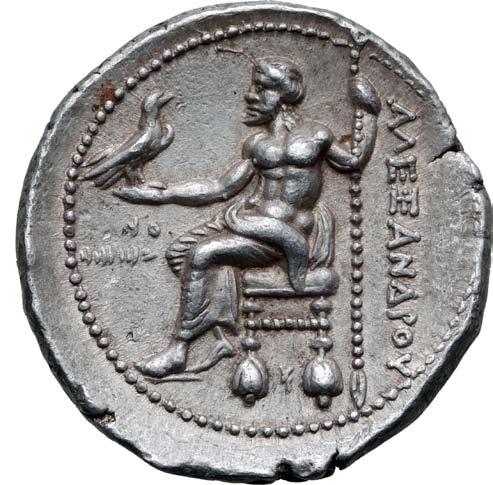



Near Mint State. Very Rare; arguably the finest of just a handful of examples on CoinArchives, considerably superior to the example sold at Heritage, Sale 3107 (May 2023, lot 30013) for USD 15,000.
Acquired from Numismatik Naumann.
3,000
230.
Kingdom of Macedon, Alexander III ‘the Great’ AR Tetradrachm. Struck under Menes or Philotas. Tarsos, circa 327-323 BC. Head of Herakles to right, wearing lion skin headdress / Zeus Aëtophoros seated to left, holding sceptre; AΛΕΞΑΝΔΡΟΥ to right, plough in left field, Θ below throne, • in inner right field. Price 3020. 17.21g, 28mm, 6h.



Good Extremely Fine; beautiful iridescence around devices. Very Rare.
Acquired from Leu Numismatik AG; Ex German collection, formed in the late 1990s and early 2000s.
231.
Kingdom of Macedon, Philip III Arrhidaios AR Tetradrachm. Struck under Laomedon, in the name and types of Alexander III. Tyre, dated RY 28 of ‘Ozmilk = 319/8 BC. Head of Herakles to right, wearing lion skin headdress / Zeus Aëtophoros seated to left, holding sceptre;
to right, -|O (Phoenician ‘K = ‘Ozmilk [king of Tyre]) above ||||| ||| = (date [28 in Phoenician]) in left field, Phoenician A below throne. Price 3272 (Ake); Newell, Dated 29 (Ake), obv. die XXIII; DCA 737. 17.22g, 28mm, 3h.
Good Extremely Fine; wonderfully detailed.
600
Kingdom of Macedon, Demetrios I Poliorketes AR Tetradrachm. Tarsos, circa 298-295 BC. Nike standing to left on prow of galley to left, blowing trumpet and cradling stylis / Poseidon Pelagaios advancing to left, hurling trident with his upraised right hand, chlamys draped over extended left arm; BAΣIΛEΩΣ below, ΔHMHTPIOY to outer right, monograms to inner left and right. Cf. Newell 33 (stater with same control marks); Seleucus I Hoard 1037-41; cf. HGC 3.1, 1012b. 17.07g, 25mm, 7h.


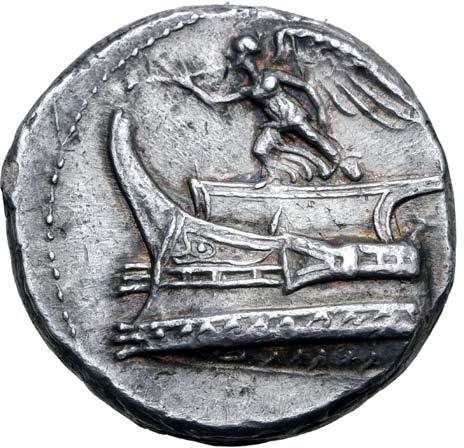
Extremely Fine; attractive light cabinet tone.
Ex Gorny & Mosch Giessener Münzhandlung, Auction 159, 8 October 2007, lot 121.
2,700
81
228.
229. 750
ΑΛΕΞΑΝΔΡΟΥ
Kingdom of Macedon, Antigonos II Gonatas AR Tetradrachm. Amphipolis, circa 271/68-260/55 BC. Horned head of Pan to left, lagobolon over shoulder, on boss of Macedonian shield / Athena Alkidemos advancing to left, holding shield decorated with aegis, preparing to cast thunderbolt; ΒΑΣΙΛΕΩΣ to right, ΑΝΤΙΓΟΝΟΥ to left, crested Macedonian helmet to inner left, monogram to inner right. TEA Period I, Group 9 (unlisted dies); Touratsoglou 18-24; SNG Copenhagen 1200; SNG Berry 354; HGC 3.1, 1042. 17.09g, 31mm, 12h.




Near Extremely Fine.
Acquired from Morton & Eden; Ex European Ambassador Collection, formed in the 1950s and 1960s.
Ex G. Picard Collection, Sambon 1923
Kingdom of Macedon, Antigonos II Gonatas AR Tetradrachm. Amphipolis, circa 252/1-246 BC. Horned head of Pan to left, lagobolon over shoulder, on boss of Macedonian shield / Athena Alkidemos advancing to left, holding shield decorated with aegis, preparing to cast thunderbolt; ΒΑΣΙΛΕΩΣ to right, ΑΝΤΙΓΟΝΟΥ to left, crested Macedonian helmet to inner left, monogram to inner right. TEA Period II, Group 1, 2b (O02/R02, this coin); SNG Copenhagen 1200 var. (monogram); HGC 3.1, 1042. 17.14g, 32mm, 11h.



Near Extremely Fine; beautiful old cabinet tone. Extremely Rare.
This coin cited in K. Panagopoulou, The Early Antigonids: Coinage, Money, and the Economy (New York, 2020); Ex Maison Palombo, Auction 19, 12 December 2020, lot 33; Ex collection of Edouard Yervant Hindamian, Ciani & Vinchon, 6 February 1956, lot 349; Ex G. Picard Collection, Sambon, 14-16 March 1923, lot 402.
2,400
Kingdom of Macedon, temp. Antigonos II Gonatas - Demetrios II Aitolikos AR Tetradrachm. Amphipolis or Pella mint, 246/5-229 BC. Horned head of Pan to left, lagobolon over shoulder, on boss of Macedonian shield / Athena Alkidemos advancing to left, holding shield decorated with aegis, preparing to cast thunderbolt; ΒΑΣΙΛΕΩΣ to right, ΑΝΤΙΓΟΝΟΥ to left, crested Macedonian helmet to inner left, monogram to inner right. TEA Period III, Group 7, 33 (O08/R32); SNG Copenhagen 1199 (same); HGC 3.1, 1042 (Antigonos II Gonatas). 17.11g, 31mm, 8h.


Good Extremely Fine.
Ex North River Collection; Ex Collection C.P.A., Classical Numismatic Group, Mail Bid Sale 78, 14 May 2008, lot 436; Ex Leu Numismatik AG, Auction 86, 5 May 2003, lot 366.
82
233.
232. 600
234. 1,500
235.
Kingdom of Macedon, temp. Antigonos II Gonatas - Demetrios II Aitolikos AR Tetradrachm. Amphipolis or Pella mint, 246/5-229 BC. Horned head of Pan to left, lagobolon over shoulder, on boss of Macedonian shield / Athena Alkidemos advancing to left, holding shield decorated with aegis, preparing to cast thunderbolt; ΒΑΣΙΛΕΩΣ to right, ΑΝΤΙΓΟΝΟΥ to left; crested Macedonian helmet in inner left field, TI in inner right field. TEA Period III, Group 26, (unlisted dies); SNG Copenhagen 1202 (Antigonos II Gonatas). 17.12g, 31mm, 10h.
Extremely Fine.
Acquired from Nomos AG.
600
236.
Kingdom of Macedon, temp. Antigonos II Gonatas - Demetrios II Aitolikos AR Tetradrachm. Amphipolis or Pella mint, 246/5-229 BC. Head of Poseidon to right, wearing wreath of marine plants / Apollo, testing bow in extended right hand, seated to left on prow to left; BAΣIΛEΩΣ ANTIΓONOY inscribed on prow, monogram below. TEA Period III, Group 44, 222 (O33/R212); HGC 3, 1051 (Antigonos III Doson). 17.15g, 30mm, 12h.






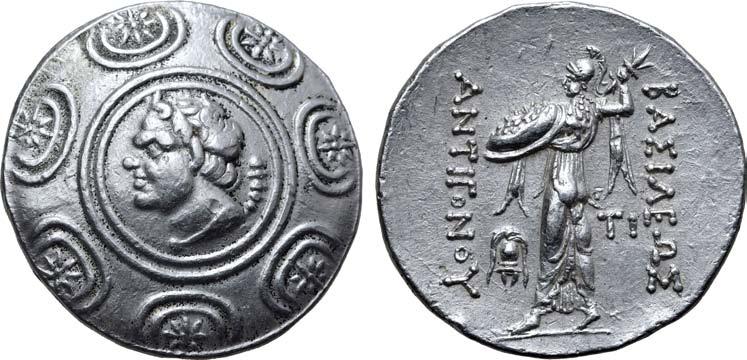
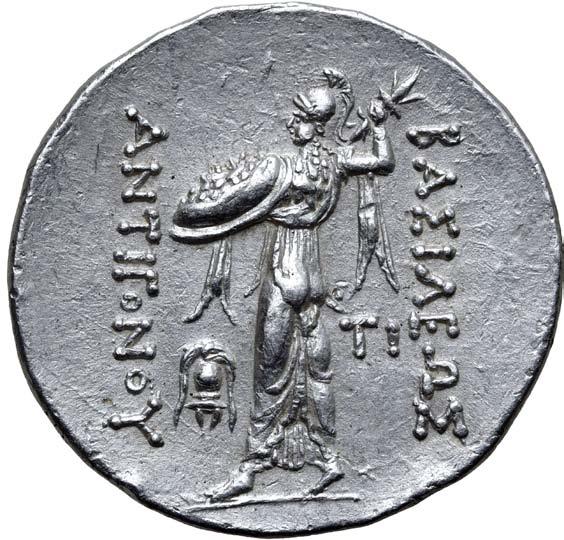

Near Mint State.
Ex Classical Numismatic Review XLV.2, Summer 2020, no. 531640; Ex Dr. Matthew Curtis Collection, Classical Numismatic Group, Triton XXII, 14 January 2020, lot 227.
3,600
Kingdom of Macedon, Perseus AR Tetradrachm. Amphipolis or Pella mint, circa 171-168 BC. Reduced standard. Au-, mintmaster. Diademed head to right / Eagle, with wings spread, standing to right on thunderbolt; BAΣIΛEΩΣ across upper fields, ΠEP-ΣEΩΣ across lower fields, NK monogram above, AY (mintmaster’s) monogram in right field, AI monogram between legs; all within oak wreath, plow to left below. F. De Luca, The Tetradrachms of Perseus of Macedonia 253 (O52/R224); Mamroth, Perseus, 25; SNG Alpha Bank 1132; HGC 3.1, 1094. 15.50g, 30mm, 12h.

Good Extremely Fine.
Acquired from Morton & Eden; Ex European Ambassador Collection, formed in the 1950s and 1960s.
2,700
83
237.
238.
Thrace, Abdera AR Tetradrachm. Circa 322/1 BC. Euresippos, magistrate. Griffin couchant to left, raising foreleg, ABΔHP above, ITEΩN in exergue / Laureate head of Apollo to right; EΠI EYPHΣIΠΠOY to left and right. Chryssanthaki-Nagle, Period XI, 110-1 var. (unlisted dies); May, Abdera 541; HGC 3.2, 1211g. 9.79g, 25mm, 9h.





Good Very Fine. Very Rare.
Ex Kölner Münzkabinett, Auction 115, 29 October 2021, lot 30; Ex Hellmuth Kricheldorf Verlag e.K., Auction 49, 20 February 2017, lot 80; Privately purchased from Nomos AG (Dr. Roland Maly), 7 October 1977.
239. 450
240.
Thrace, Odessos AR Tetradrachm. In the name and types of Alexander III of Macedon. Circa 120-90 BC. Head of Herakles to right, wearing lion skin headdress / Zeus Aëtophoros seated to left, holding sceptre; ΒΑΣΙΛΕΩΣ to right, ΑΛΕΞΑΝΔΡΟΥ to left, θE in inner left field, monogram below throne. Price 1181; Topalov 69. 16.75g, 32mm, 12h.

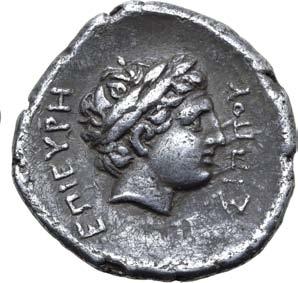


Mint State; an attractive and well-centred example.
Acquired from Dr. Busso Peus Nachfolger.
Islands off Thrace, Thasos AR Stater. Circa 500-480 BC. Nude satyr in kneeling-running stance to right, carrying off a protesting nymph / Quadripartite incuse square. Le Rider, Thasiennes 5; HPM pl. X, 14-17; SNG Copenhagen 1008-9; HGC 6, 331. 9.09g, 21mm.
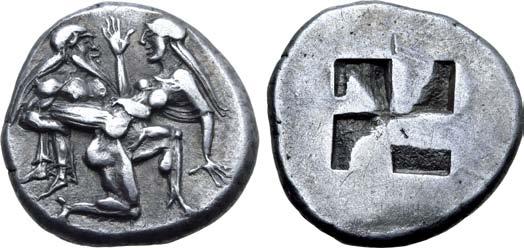
Near Extremely Fine; pleasant old cabinet tone.

84 THRACE
900
600
Islands off Thrace, Thasos AR Stater. Circa 412-404 BC. Bald-headed and nude satyr in kneeling-running stance to right, carrying off protesting nymph; Α in right field / Quadripartite incuse square. Le Rider, Thasiennes, 6; Kraay-Hirmer 437; Gulbenkian 464; SNG Copenhagen Supp. 103; HGC 6, 334. 8.89g, 21mm.

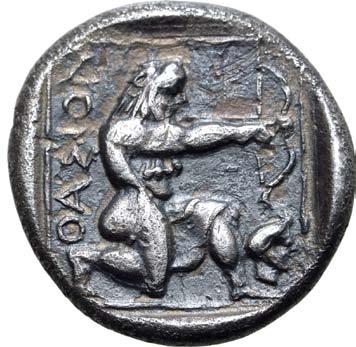

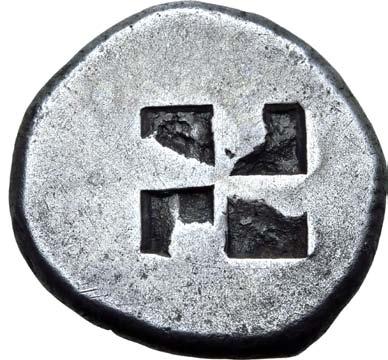




241. 3,000
Extremely Fine; excellent high classical style.
242. 1,800
243.
Islands off Thrace, Thasos AR Stater. Circa 412-404 BC. Bald-headed and nude satyr in kneeling-running stance to right, carrying off a protesting nymph; dolphin to right / Quadripartite incuse square. Le Rider, Thasiennes 6; HPM pl. X, 23; SNG Copenhagen 1017; HGC 6, 334 var. (dolphin). 8.95g, 8.96g, 22mm.
Extremely Fine; excellent high classical style.
Islands off Thrace, Thasos AR Drachm. Circa 411-350 BC. Head of Dionysos to right, wearing ivy wreath / Herakles kneeling to right, drawing bow; ΘΑΣΙΟN to left, head of Pan to lower right. Le Rider, Thasiennes 24; West, period III, pl. 26c; HGC 6, 345. 3.63g, 14mm, 12h.

Extremely Fine.
Islands off Thrace, Thasos AR Tetradrachm. Circa 168/7-148 BC. Head of young Dionysos to right, wearing ivy wreath / HPAKΛEOYΣ ΣΩTHPOΣ, Herakles standing to left, holding club and lion skin; M to inner left, ΘAΣIΩN below. Le Rider, Thasiennes 51; SNG Copenhagen 1039; BMC 72; HGC 6, 359. 16.87g, 33mm, 12h.

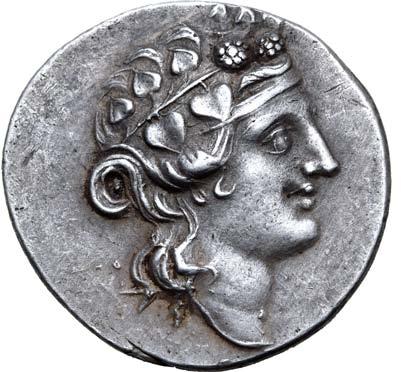


Good Extremely Fine; dies of fine style, a highly attractive example.
Acquired from Leu Numismatik AG.
1,350
85
Ex Classical Numismatic Group, E-Auction 477, 23 September 2020, lot 68. 750
244.
2x 2x
A Highly Attractive Example
Kings of Thrace, Lysimachos AV Stater. Byzantion, 305-281 BC. Diademed head of the deified Alexander to right, with horn of Ammon / Athena Nikephoros enthroned to left, resting elbow on grounded shield, transverse spear behind; ΒΑΣΙΛΕΩΣ to right, ΛΥΣΙΜΑΧΟΥ crowned by Nike to left, monogram in left field, BY below throne, trident in exergue. Price -; Müller -, cf. 231 (tetradrachm with this monogram); Marinescu Issue 135, 453 (O174/R432); A. Zograph, The Tooapse Hoard, NC 1925, illustration on p.29 (same dies); CNG Triton VI, 228 (same dies). 8.47g, 21mm, 12h. Mint State; a wonderful example. Extremely Rare with this monogram.

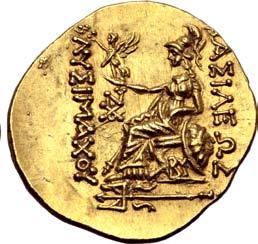
7,500
Acquired from Nomos AG; Ex collection of a Nobleman (†1940) and “undoubtedly from the Tuapse (Tooapse) Hoard of 1908 (IGCH 1120)” - Nomos.
“One of the most remarkable of the ‘Successors’ of Alexander” in the words of D. Sear, Lysimachos became King of Thrace in 306 BC, following a period of personal service to Alexander as somatophylax (bodyguard) to the famous conqueror (Sear, Greek Coins and Their Values, Volume 2, 1978, p. 634). According to Justin, Lysimachos gained favour with Alexander, despite disobeying the Macedonian king in assisting condemned philosopher Kallisthenes, when he proved himself capable of killing a lion with his bare hands (Justin, Epitome of Pompey Trogue’s “Philippic histories”, 15.3). For such a feat, which was also narrated by Pausanias, Lysimachos was “exalted far above any nobility of birth by the proofs which he had given of personal merit” (Pausanias, Description of Greece, 1.9.5; Justin, Epitome of Pompey Trogue’s “Philippic histories”, 15.3). A lion head appears on the shield of Athena Nikephoros on this coin reverse and Lysimachos adopted the front part of a lion as a numismatic symbol above the monogram on many of his coins (e.g. silver drachm, Thompson 65), perhaps alluding to this story of his heroic strength and bravery.

Types like this beautifully detailed stater stand out among the coinages of the Diadochi due to the obverse portrait: the Thracian king continued to feature Alexander on his gold staters and silver tetradrachms even after the other Diadochi had ceased to depict Alexander. Lysimachos’ coinage represents Alexander as a distinguished and deified figure, his diadem and ram’s horns signifying his royal and divine status as king and son of Zeus Ammon. K. Dahmen identifies this notable numismatic design as an assertion of Lysimachos’ particular legitimacy as a successor to Alexander, elevating the living Lysimachos by association with the qualities of the late Macedonian conqueror (Dahmen, The Legend of Alexander the Great on Greek and Roman Coins, 2007, p.17). The reverse imagery attests to the Thracian king’s personal successes: the depiction of the war goddess Athena, with her Nike attribute crowning Lysimachos’ inscribed name, can be understood to refer to the king’s military achievements, specifically perhaps the Battle at Ipsos in 301 BC (O. Morkholm, Early Hellenistic Coinage from the Accession of Alexander to the Peace of Apamea, 1991, p.81).

86
Ex Tuapse Hoard, 1908 (?)
245.
246.
Kings of Thrace, Lysimachos AR Tetradrachm. Uncertain mint, circa 305-281 BC. Diademed head of the deified Alexander to right, with horn of Ammon / Athena Nikephoros seated to left, resting left arm on shield, transverse spear in background; ΒΑΣΙΛΕΩΣ to right, ΛΥΣΙMΑXOY crowned by Nike to left; monogram to inner left, monogram in exergue. Thompson - ; Müller 1658 var. (minor monogram differences). 16.80g, 29mm, 6h.

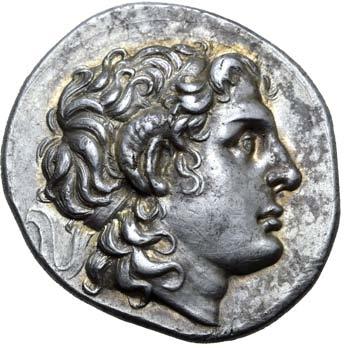




Good Extremely Fine; attractive old cabinet tone with blue and gold iridescence around devices. Apparently unpublished variant.
Ex Apollo to Apollo Collection.
Exceedingly Rare
1,200
248.
Kings of Thrace, Lysimachos AR Tetradrachm. Sestos, circa 299-296 BC. Diademed head of the deified Alexander to right, with horn of Ammon / Athena Nikephoros seated to left, resting left arm on shield, transverse spear in background; BΑΣΙΛΕΩΣ to right, ΛΥΣΙΜΑXΟΥ crowned by Nike to left, axe(?) to inner left field. Cf. Thompson 28 (axe, not plated); Müller -; HGC 3.2 1750 corr. (unlisted mint); Roma, E-29, 120 (same dies). 17.21g, 30mm, 2h.
Good Extremely Fine; minor die breaks on rev., struck from dies of wonderful style. Exceedingly Rare; only one other example on CoinArchives, none in the ANS photofile.
Ex Classical Numismatic Group, Auction 117, 19 May 2021, lot 81.
Published in 1967
Kings of Thrace, Lysimachos AR Tetradrachm. Lampsakos, circa 297-281 BC. Diademed head of the deified Alexander to right, with horn of Ammon / Athena Nikephoros seated to left, resting left arm on shield, transverse spear in background; ΒΑΣΙΛΕΩΣ to right, ΛΥΣΙΜΑΧΟΥ crowned by Nike to left; HP monogram to inner left, crescent in exergue. Thompson 47; Müller 401; SNG BnF 2540-2542; Kunst der Antike aus Privatbesitz Bern, Biel, Solothurn (1967), 469 (this coin). 17.24g, 28mm, 1h.

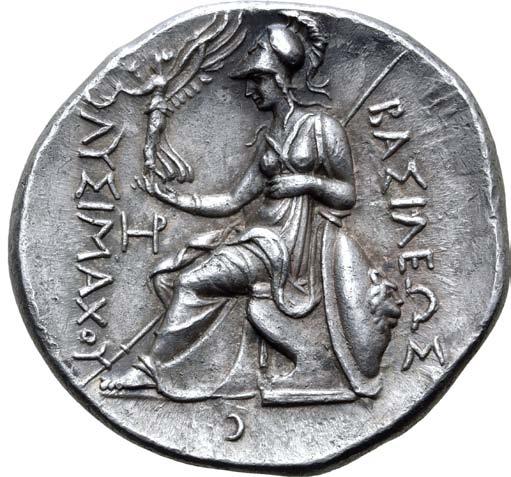


Good Extremely Fine; struck in high relief, dies of fine style.
This coin published in Kunst der Antike aus Privatbesitz Bern, Biel, Solothurn (1967); Ex collection of Regierungsrat Dr. iur. Hans Krähenbühl, Leu Numismatik AG, Auction 8, 23 October 2021, lot 40; Privately acquired from Bank Leu AG, 7 December 1965.
2,700
87
247. 3,300
249.
Kings of Thrace, Lysimachos AR Tetradrachm. Amphipolis, 288/7-282/2 BC. Diademed head of the deified Alexander to right, with horn of Ammon / Athena Nikephoros seated to left, resting left arm on shield, transverse spear in background; BAΣIΛEΩΣ to right, ΛYΣIMAXOY crowned by Nike to left, monogram in inner left field, two monograms in exergue. Thompson 209; Müller -. 17.13g, 31mm, 7h.



Good Extremely Fine; a bold portrait in high relief.
Ex European collection, formed before 2005, Leu Numismatik AG, Auction 10, 24 October 2021, lot 2031.
GETO-DACIAN DYNASTS
1,950
250.
Geto-Dacian dynasts, Koson AV Stater. Circa 44-42 BC. Roman consul (L. Junius Brutus?) walking to left, accompanied by two lictors; OΛB monogram before, KOΣΩN in exergue / Eagle with spread wings standing to left on sceptre, clutching laurel wreath in right talon. RPC I 1701A; BMC 2; HGC 3.2, 2049. 8.31g, 20mm, 12h.
Mint State; well-centered.
Acquired from Leu Numismatik AG; Ex Hestia Collection, formed over the past five decades.
1,200
251.
Geto-Dacian dynasts, Koson AV Stater. Circa 44-42 BC. Roman consul (L. Junius Brutus?) walking to left, accompanied by two lictors; OΛB monogram before, KOΣΩN in exergue / Eagle with spread wings standing to left on sceptre, clutching laurel wreath in right talon. RPC I 1701A; BMC 2; HGC 3.2, 2049. 8.52g, 19mm, 12h.
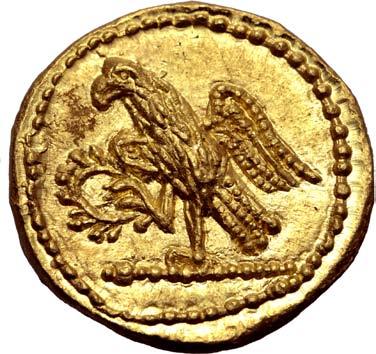








Mint State.
Acquired from Leu Numismatik AG.
1,080
88
Geto-Dacian dynasts, Koson AV Stater. Circa 44-42 BC. Roman consul (L. Junius Brutus?) walking to left, accompanied by two lictors; OΛB monogram before, KOΣΩN in exergue / Eagle with spread wings standing to left on sceptre, clutching laurel wreath in right talon. RPC I 1701A; BMC 2; HGC 3.2, 2049. 8.42g, 22mm, 11h. Mint State.




252. 1,050
Acquired from Heritage World Coin Auctions.
TAURIC CHERSONNESOS
Extremely Rare
253.
Tauric Chersonesos, Chersonesos AR Drachm. Circa 90-80 BC. Demetrios, magistrate. Laureate head of Artemis to right, bow and quiver over left shoulder / ΔHMHTPIOY, Artemis advancing to left, holding bow and spear, striking stag lying to left beneath. SNG Moskau 3579-80; Anokhin 817; SNG BM Black Sea 828-9; SNG Stancomb -; HGC 3.2, 2067. 3.36g, 16mm, 12h.




Extremely Fine. Extremely Rare.
Ex Pontos Euxeinos Collection, formed in the late 1990s and early 2000s, Leu Numismatik AG, Web Auction 19, 26 February 2022, lot 131.
KIMMERIAN BOSPOROS
Kimmerian Bosporos, Pantikapaion Æ 20mm. Circa 310-304/3 BC. Head of bearded Satyr to right / Π-Α-Ν around forepart of griffin to left; sturgeon to left below. MacDonald 69; SNG BM Black Sea 869-71; SNG Stancomb 541-2; HGC 7, 113. 6.52g, 20mm, 12h.


Good Extremely Fine; attractive glossy chestnut patina.
Ex Pontos Euxeinos Collection, formed in the late 1990s and early 2000s.
Kimmerian Bosporos, Pantikapaion Æ 21mm. Circa 310-304/3 BC. Head of bearded Satyr to right / Π-Α-Ν around forepart of griffin to left; sturgeon to left below. MacDonald 69; SNG BM Black Sea 869-71; SNG Stancomb 541-2; HGC 7, 113. 8.23g, 21mm, 12h.


Extremely Fine.
Acquired from Leu Numismatik AG.
89
600
254. 450
255. 300
Extremely Rare
Kings of the Bosporos, Asander (as king) AV Stater. Dated RY 17 = 31/0 BC. Diademed head to right / Nike standing to left on prow, holding wreath and palm; BAΣIΛEΩΣ to right, AΣANΔPOY to left, ZI (date) in inner left field. MacDonald 206; RPC I 1854; HGC 7, 201. 8.00g, 20mm, 12h.
NGC graded AU 4/5 - 2/5, brushed, bent (#6158066-006). Extremely Rare; only one other example with this date offered at auction in over 20 years. Ex GK Collection, Roma Numismatics Ltd., Auction XXIII, 24 March 2022, lot 210.
Asander rose to prominence in the Kimmerian Bosporos after defeating Pharnakes II in battle. However, Julius Caesar instead appointed Mithridates of Pergamum, his personal friend, as ruler of the Bosporos, angering Asander, who also defeated and killed the new Mithridates II in 47 or 46 BC. He was left in sole control and quickly strengthened his claim to the throne by marrying Pharnakes’ daughter Dynamis, but only assumed the title of archon, likely a concession to Rome, which had and would in the future confirm all Bosporan kings. Circa 43 or 42 BC, Octavian recognised Asander as king, most probably to shore up a potential ally in the chaotic aftermath of his adopted father Caesar ’s assassination. Asander was designated ‘Philocaesar Philoromaios’, a title recognising the support of the Romans and personal connection with Octavian himself. Little else is known about his reign, but in later life it appears that his wife acted as regent, with coins minted under her authority, until Asander committed suicide by starvation in about 16 BC in the face of an army desertion.
In his earlier gold staters, struck while he was still archon, Asander is portrayed with short hair and an idealised face, leading to various identification of the portrait as that of Marc Antony, Octavian, or Asander himself. While the facial features remain consistent on this later portrait, the longer hairstyle, reminiscent of Mithridates VI Eupator and standard among Bosporan monarchs, marks his transition from archon to king. The reverse type of Nike on prow is common to all his staters, and implies a naval victory, possibly over Mithridates II, the Tauri or other pirates, an interpretation supported by a fragmentary stone inscription, which does not record the date or identity of the defeated enemy. The staters of Asander bear Greek letter-numeral dates counting the years of his rule: this type, from the seventeenth year, is extremely rare and unlisted in the Handbook of Greek Coinage, with only one other example offered at auction in over two decades.







90
256.
9,000
(#6158071-003).
257. 600
Kings of the Bosporos, Sauromates I, with Hadrian, AV Stater. Dated Bosporan Era 416 = AD 119/20. BACIΛЄѠC CAVPOMATOV, diademed and draped bust of Sauromates to right / Laureate head of Hadrian to right; ςIY (date) below. MacDonald 390/2; RPC III 814; Frolova p. 109. 7.77g, 19mm, 12h. NGC graded Ch
VF 5/5 - 4/5
Rare.
Kings of the Bosporos, Rhoimetalkes, with Hadrian, AV Stater. Dated Bosporan Era 431 = AD 134/5. ΒΑϹΙΛЄѠC ΡΟΙΜΗΤΑΛΚΟΥ, diademed and draped bust of Rhoimetalkes to right / Laureate head of Hadrian to right; AΛY (date) below. MacDonald 440/2; RPC III 916; Anokhin 505a. 7.87g, 20mm, 1h.
Near Mint State. Rare.
Ex GK Collection.
1,050
Kings of the Bosporos, Eupator, with Marcus Aurelius and Lucius Verus, EL Stater. Dated Bosporan Era 459 = AD 162/3. BACIΛЄѠC ЄVΠATOPOC, diademed and draped bust of Eupator to right; club before / Head of Marcus Aurelius to left, facing draped bust of Lucius Verus to right, pellet between; ΘNV (date) below. MacDonald 469/1; RPC IV.1 Online 3742 (temporary); Frolova p. 160-161. 7.78g, 19mm, 12h.
259. 600
NGC graded Ch XF 4/5 - 3/5, brushed (#6158071-013).
Kings of the Bosporos, Sauromates II EL Stater. Dated Bosporan Era 489 = AD 192/3. BACIΛЄѠC CAVPOMATOV, diademed and draped bust of Sauromates to right / Laureate and draped bust of ‘generic’ Roman emperor to right; globe before, ΘΠV (date) below. MacDonald 500/4; RPC IV.1 Online 3812 (temporary); Frolova p. 173, A-a, pl. XXX 36-37 (same dies); Coins of the Bosporos Online 570-4002-11 (this coin). 7.76g, 19mm, 12h.
Near Extremely Fine; tooled, area of flatness to rev.
This coin published at Coins of the Bosporos Online (https://bosporan-kingdom.com); Ex Hess-Divo AG, Auction 336, 27 May 2019, lot 53.
MacDonald suggests that the generic nature of the reverse bust on this coin is due to Sauromates II’s reluctance to affiliate himself with a particular ruler in the civil war after the death of Commodus.



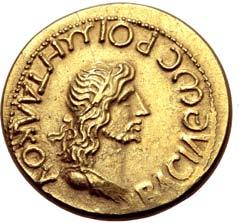




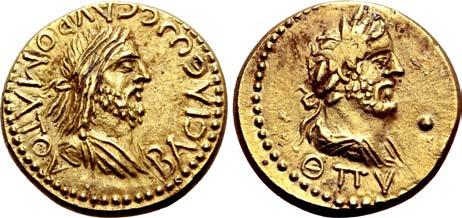





261. 600
Kings of the Bosporos, Sauromates II, with Septimius Severus and Caracalla, EL Stater. Dated Bosporan Era 495 = AD 198/9. ΒΑϹΙΛЄѠϹ ϹΑΥΡΟΜΑΤOV, diademed and draped bust of Sauromates to right / Laureate bust of Severus to right, facing laureate and draped bust of Caracalla to left; crescent between, ЄꟼV (date) below. MacDonald 506/11; RPC IV.1 Online 3831 (temporary); Frolova p. 176; Anokhin 576b var. (without crescent). 7.91g, 20mm, 11h.
Extremely Fine; lightly tooled hair.
91
258.
260. 450
262.
Kings of Armenia, Tigranes II ‘the Great’ AR Tetradrachm. Tigranokerta, circa 80-68 BC. Diademed and draped bust to right, wearing Armenian tiara with five peaks and emblazoned with star between two eagles; bead and reel border around / Tyche of Artaxata seated to right on rock pile, holding palm branch, river god Araxes swimming to right below; BAΣIΛEΩ[Σ] to right, TIΓPAN[OY] to left, monograms to inner right and on rock; all within wreath. Kovacs 71.2; SCADA Group 3; CAA 20; ACV 34.
NGC graded Ch XF 5/5 - 4/5 (#6329072-003).
Acquired from Numismatica Ars Classica.
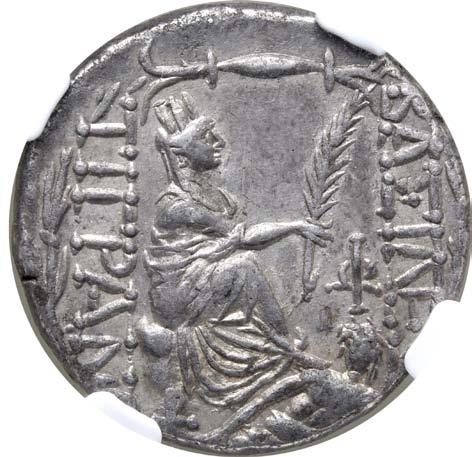
263.
1,200
264.
Kings of Armenia, Tigranes II ‘the Great’ AR Tetradrachm. Tigranokerta, circa 80-68 BC. Diademed and draped bust to right, wearing Armenian tiara with five peaks and emblazoned with star between two eagles; bead and reel border around / Tyche of Artaxata seated to right on rock pile, holding palm branch, river god Araxes swimming to right below; BAΣIΛEΩΣ to right, [TIΓPANOY] to left, [uncertain monogram] on rock; all within wreath.
Kovacs 72, 73 or 75. 15.69g, 26mm, 12h.
Extremely Fine; superb metal quality.
Superb Metal Quality for the Issue
1,200
Kings of Armenia, Tigranes II ‘the Great’ AR Tetradrachm. Tigranokerta, circa 80-68 BC. Diademed and draped bust to right, wearing Armenian tiara with five peaks and emblazoned with star between two eagles; bead and reel border around / Tyche of Artaxata seated to right on rock pile, holding palm branch, river god Araxes swimming to right below; BAΣIΛEΩΣ to right, TIΓPANOY to left, AP monogram to inner right, ΔΗ monogram on rock; all within wreath. Kovacs 74.1; SCADA, Group 1; CAA 17. 15.97g, 26mm, 1h.






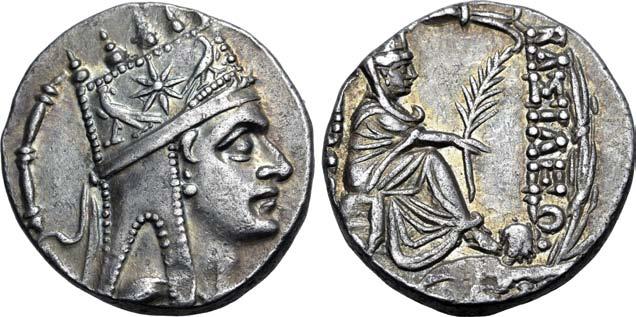


Good Extremely Fine; attractive light cabinet tone with iridescence around the devices, superb metal quality for the issue.
1,200
92
ARMENIA
Kings of Armenia, Tigranes II ‘the Great’ AR Tetradrachm. Tigranokerta, circa 80-68 BC. Diademed and draped bust to right, wearing Armenian tiara with five peaks and emblazoned with star between two eagles; bead and reel border around / Tyche of Artaxata seated to right on rock pile, holding palm branch, river god Araxes swimming to right below; BAΣIΛEΩΣ to right, TIΓPANOY to left, AP monogram to inner right, ΔΗ monogram on rock; all within wreath. Kovacs 74.1; SCADA, Group 1; CAA 17. 15.97g, 27mm, 12h.
Extremely Fine.
1,200
Kings of Armenia, Tigranes II ‘the Great’ AR Tetradrachm. Tigranokerta, circa 80-68 BC. Diademed and draped bust to right, wearing Armenian tiara with five peaks and emblazoned with star between two eagles; bead and reel border around / Tyche of Artaxata seated to right on rock pile, holding palm branch, river god Araxes swimming to right below; BAΣIΛEΩΣ to right, TIΓPANOY to left, AP monogram to inner right, ΔΗ monogram on rock; all within wreath. Kovacs 74.1; SCADA, Group 1; CAA 17. 15.81g, 27mm, 12h.
Good Extremely Fine; attractive iridescence around devices with underlying lustre, excellent metal quality for the issue.
900
Kings of Armenia, Tigranes II ‘the Great’ AR Tetradrachm. Tigranokerta, circa 80-68 BC. Diademed and draped bust to right, wearing Armenian tiara with five peaks and emblazoned with star between two eagles; bead and reel border around / Tyche of Artaxata seated to right on rock pile, holding palm branch, river god Araxes swimming to right below; BAΣIΛEΩΣ to right, TIΓPANOY to left, AP monogram to inner right, ΔΗ monogram on rock; all within wreath. Kovacs 74.1; SCADA, Group 1; CAA 17. 16.04g, 26mm, 12h.
Good Extremely Fine.
900
Kings of Armenia, Tigranes II ‘the Great’ AR Tetradrachm. Tigranokerta, circa 80-68 BC. Diademed and draped bust to right, wearing Armenian tiara with five peaks and emblazoned with star between two eagles; bead and reel border around / Tyche of Artaxata seated to right on rock pile, holding palm branch, river god Araxes swimming to right below; BAΣIΛEΩΣ to right, TIΓPANOY to left, two monograms on rock; all within wreath. Kovacs 75.1; SCADA Group 8; CAA 21; ACV 33. 15.89g, 27mm, 1h.












Extremely Fine; excellent metal quality for the issue.
900
93
265.
266.
267.
268.
269.
Kings of Armenia, Tigranes II ‘the Great’ AR Tetradrachm. Tigranokerta, circa 80-68 BC. Jewel-diademed, draped bust to right, wearing Armenian tiara with five peaks and emblazoned with star between two eagles; bead and reel border around / Tyche of Artaxata seated to right on rock pile, holding palm branch, river god Araxes swimming to right below; BAΣIΛEΩΣ to right, TIΓPANOY to left, monogram on rock; all within wreath. Kovacs 75.3 (same obv. die); SCADA Group 7; CAA 21; ACV 33. 15.33g, 29mm, 12h.



Good Very Fine; attractive old cabinet tone.
Acquired from Leu Numismatik AG.
900
Kings of Armenia Minor, Aristoboulos Æ 25mm. Nicopolis-ad-Lycum, or Chalkis, dated RY 17 = AD 70/1. BACIΛEΩC APICTOBOYΛOY ET [IZ] (date), diademed and draped head to left / TITΩ OΥECΠACIANΩ AYTOKPATΩP CEBACTΩ in six lines within wreath. Kovacs 301; cf. Meshorer 367a; cf. Hendin 1258; cf. Sofaer 172; cf. RG 3; cf. RPC II 1692. 14.17g, 27mm, 12h.

Very Fine. Very Rare.
Ex Roma Numismatics Ltd., Auction XX, 29 October 2020, lot 158.

Undoubtedly the Finest Example
Pontos, Amisos AR Drachm. Time of Mithradates VI Eupator, circa 120-100 BC. Bust of Perseus to right, with harpa over shoulder / Aegis with facing gorgoneion, monogram to right. SNG BM Black Sea 1127-8; RG p. 62, 12, HGC 7, 235. 3.99g, 17mm, 12h. Extremely Fine; beautiful old cabinet tone. Extremely Rare; only two other examples on CoinArchives, with this example being far superior

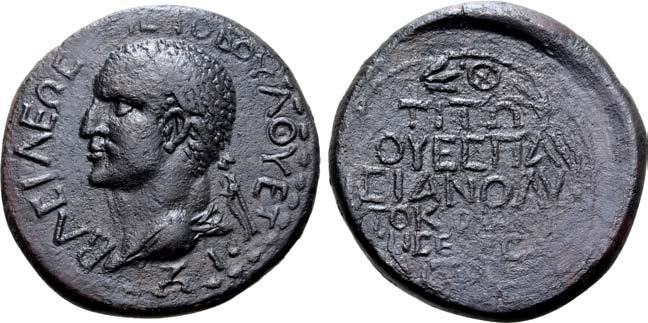
Pontos, Amisos Æ 15mm. Time of Mithradates VI Eupator, circa 105-85 BC. Head of Perseus to right, wearing Phrygian-style helmet ending in griffin’s head / Winged harpa; AMI-ΣOY across fields, monogram in lower right field. SNG BM Black Sea 1197-8; SNG Stancomb 694; RG 35; HGC 7, 256. 2.91g, 15mm, 12h.

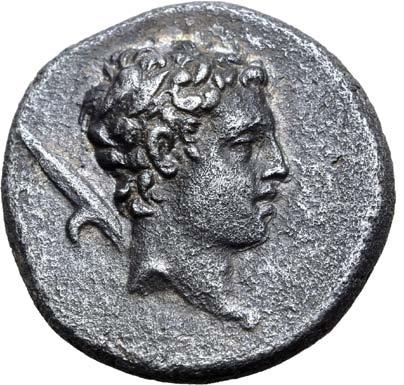



Good Extremely Fine; a highly attractive portrait.
Acquired from Leu Numismatik AG.
94
270. 3,000
271.
600
272. 180 PONTOS 2x 2x 2x 2x


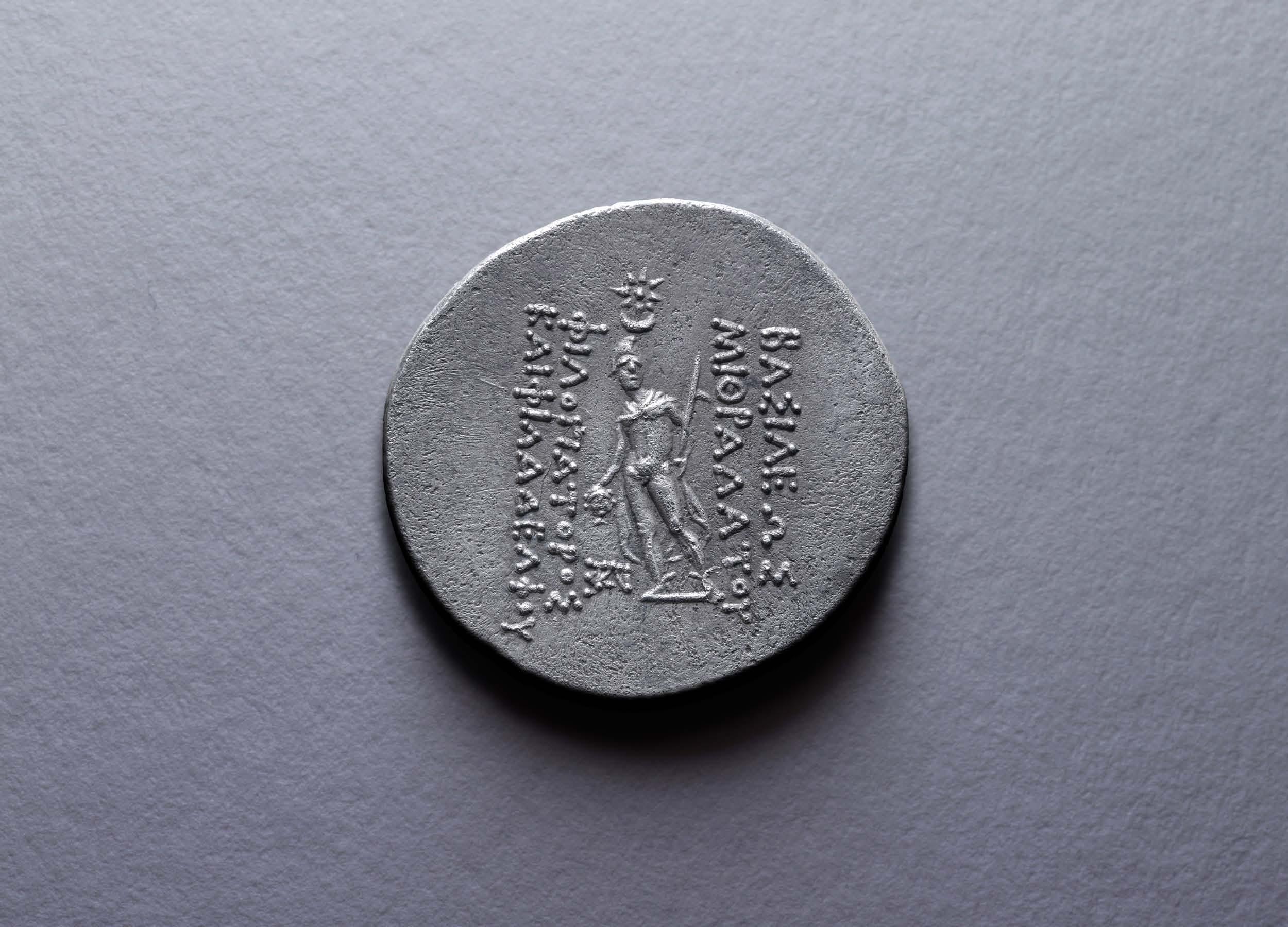
96
Mithradates IV of Pontos
Kings of Pontos, Mithradates IV AR Tetradrachm. Circa 169-150 BC. Diademed head to right / Perseus standing facing, holding harpa and severed head of Medusa; above, crescent above star; BAΣIΛEΩΣ MIΘPAΔATOY to right, ΦΙΛOΠATOPOΣ KAI ΦΙΛΑΔΕΛΦΟY to left, monogram to inner left. Callataÿ, First, [O4 (corr., “O5”), see below/R- (“R7a”, see below)]; SNG von Aulock 6674; Jameson 2153 var. (monogram); Gulbenkian 933-4 var. (same); Mattingly, Studies Price, pl. 56, 11 (same obv. die); HGC 7, 326; NAC 106, 246 (hammer: 220,000 CHF). 16.47g, 33mm, 12h.
Good Extremely Fine; a fine late Hellenistic portrait struck in high relief. Extremely Rare, one of only four tetradrachms of Mithradates IV to be offered at auction in the past two decades, struck from an obverse die from which only one other specimen is known (The Royal Collection, Copenhagen), and from a seemingly previously unknown reverse die with a retrograde monogram.


Callataÿ incorrectly describes both the Hunt and Copenhagen as being specimens struck from the same obverse die (O4/R6 and O4/R7 respectively). This is not the case, and therefore the Copenhagen specimen which shares its obverse die with the present example should properly be described as “O5”, with a new reverse die that may here be referred to as R7a. The Boston coin which Callataÿ assigns to die O5/R8 should necessarily be corrected to O6/R8.
Perseus, the famous hero of Greek myth, is instantly recognisable on the reverse of this coin by virtue of the severed head of Medusa he carries. According to the legend, King Akrisios of Argos imprisoned Perseus’ mother Danae to prevent her having children after an oracle foretold he would be killed by her son. When however she bore a son of Zeus, Perseus, he banished them to sea in a wooden box, only for the mother and son to survive, having been washed ashore and taken-in by the fisherman Dictys. As a man, Perseus was instructed by King Polydektes of Seriphos to bring him the head of Medusa, a woman whom Ovid relates was cursed by Athena after being violated by Poseidon in the goddess’s temple, causing her hair to transform into writhing snakes and for her to turn all those upon whom she looked to stone.
Perseus, with the help of myriad divine attributes, namely Hades’ helmet of invisibility, a sword from Hephaestus, Hermes’ winged sandals and a mirrored shield from Athena, was able to behead the monster by looking at her through the shield’s reflection, thus avoiding being turned to stone. Upon his return to Seriphos, he turned the head on Polydektes, who was attempting to force Perseus’ mother Danae into marriage.
The inclusion of an archetypal Greek hero on this tetradrachm of Mithridates IV should be viewed within the context of the long-standing etymological association, whereby Perseus was considered the mythical ancestor of the Persians. This iconography was employed by King Xerxes I during his invasion of Greece in 480 BC in an attempt to persuade the Argives, whom Perseus ruled over as king after accidentally fulfilling the oracle’s prophecy and killing Akrisios, to surrender to him since they shared a common forefather. Mithridates therefore exploited the shared affiliation to associate the Mithridatic dynasty of Pontus, Persian in heritage, with the wealthy and great Achaemenid empire.
This Persian heritage is thus juxtaposed with a reverse design that is thoroughly Greek in character, and further emphasised by the conspicuously Hellenistic portrait style, with the diadem of a contemporary Hellenistic king, and the use of Greek titles Philopator (‘Father-loving’) and Philadelphos (‘Brother-loving’), intended to recall the successes of Mithradates III and Pharnakes I, Mithridates’ father and brother. These Hellenistic influences could be viewed as being in conflict with the long-standing Pontic desire to emulate the Persian empire, yet also serve as a link to the visual tradition of the Argead dynasty of Macedon from which Mithradates was himself also descended, who themselves claimed descendancy from the Argives whom Perseus ruled over as King. The most famous scion of the Argean dynasty, Alexander III ‘the Great’, had achieved a neat historical-mythological circularity when he succeeded in conquering the entirety of the former Achaemenid Persian empire in the late fourth century BC, thus assuming the title King of Persia and uniting the two strands of mythological ancestry from Perseus which Mithridates IV claims here.

97
1 30,000 273.
Extremely Rare Date
Kings of Pontos, Mithradates VI Eupator AR Tetradrachm. Dated Bithyno Pontic Era 206, month 3 = December 92/1 BC. Diademed head to right / Pegasos on ground line to left, preparing to lie down, BAΣΙΛEΩΣ above, MIΘPAΔATOY EYΠATOPOΣ below; star within crescent to left, CΣ (year) and monogram to right, Γ (month) below; all within ivy wreath. De Callataÿ pl. IV (D33/R-); Waddington p. 15, 15; DCA 688; HGC 7, 338. 16.68g, 33mm, 12h.


Good Extremely Fine. Extremely Rare; no other examples of this date on CoinArchives. Ex Roma Numismatics Ltd., Auction XXIII, 24 March 2022, lot 254.
3,000
Kings of Pontos, Mithradates VI Eupator AV Stater. First Mithradatic War issue, in the name and types of Lysimachos. Kallatis, circa 88-86 BC. Diademed head of the deified Alexander to right, with horn of Ammon / Athena Nikephoros seated to left, ΒΑΣΙΛΕΩΣ to right, ΛYΣΙΜΑΧΟY to left; HPO to inner left, KAΛ on throne, ornate trident in exergue. Callataÿ p. 140 (D6/R- [unlisted rev. die, possibly R3 which is not illustrated]); AMNG I 258; HGC 3.2, 1824. 8.34g, 19mm, 12h.







Good Extremely Fine.
Acquired from Leu Numismatik AG.
1,950
98
274.
275.
The Second Known Example
Kings of Pontos, Mithradates VI Eupator AR Tetradrachm. Dated Bithyno Pontic Era 212, month 12 = September 86/5 BC. Diademed head to right / Stag grazing on ground line to left, BAΣΙΛEΩΣ above, MIΘPAΔATOY EYΠATOPOΣ below; to left, star within crescent above monogram; BIΣ (year) and monogram to right, IB (month) below; all within ivy wreath. De Callataÿ pl. VII, D4/R2; BMC -; SNG von Aulock -; SNG Copenhagen -; DCA 692; HGC 7, 340. 16.75g, 33mm, 12h.


NGC graded MS 5/5 - 4/5 (#6674414-002); a fine late Hellenistic portrait. Extremely Rare; the second known example after one specimen cited by De Callataÿ.
Ex Roma Numismatics Ltd., Auction XXII, 7 October 2021, lot 287.
This coin was struck in the midst of the First Mithridatic War, after the Romans had responded to Mithradates’ invasion of the Roman province of Asia Minor and massacre of some 80,000 Roman and Italian settlers in Anatolia (known as ‘the Asiatic Vespers’) in 88 BC. It was the Roman general Lucius Cornelius Sulla, who had recently marched on Rome to secure his command, who led the army against Mithradates and forced the Pontic armies to withdraw after a successful siege of Athens and Piraeus and victorious battles in Boeotia. However, since he was anxious to return home to secure his position within the Roman state against rival general Marius, in 85 BC he agreed lenient peace terms with Mithradates. Mithradates would return Asia and Paphlagonia to Rome and the kingdoms of Bithynia and Cappadocia to Roman client kings and provide Sulla with seventy ships and three thousand talents; in return, Sulla ratified Mithradates’ position in Pontos and declared him a Roman ally. Sulla was the first of several famous Roman generals to try their might against Mithradates: Murena provoked the Second Mithridatic War from 83-81 BC, before Lucullus and then Pompey would finally defeat the king in the Third Mithridatic War in 63 BC.
This coin portrays Mithradates in youthful style and idealised fashion after the manner of Alexander, from whose generals (Seleukos, Antipater and Antigonos Monophthalmos, among others including Cyrus the Great and the family of Darios the Great), Mithradates claimed to be descended. It is thus in itself a poignant irony, an object of great beauty produced in the twilight years of Hellenism for the vanity of the last of the powerful Greek kings, the final obstacle to complete Roman domination of the Mediterranean. With Mithradates’ defeat and passing in 63 BC, when his last tetradrachm issue was struck, all that remained of the once great Hellenistic kingdoms that spanned from Sicily to Baktria were a rapidly disintegrating Seleukid rump state and a decadent Ptolemaic kingdom already firmly albeit indirectly under Roman control.

99
276.
9,000
277.
Paphlagonia, Sinope AR Drachm. Circa 330-300 BC. Persic standard. Karp-, magistrate. Head of nymph to left, wearing triple-pendant earring and necklace, hair in sakkos / Sea-eagle on dolphin to left; ΚΑΡΠ below wings, ΣΙΝΩ below dolphin. SNG BM Black Sea -; SNG Stancomb -; RG 34; HGC 7, 399. 4.94g, 20mm, 5h.







Near Mint State.
Acquired from Leu Numismatik AG.
ASIA MINOR
Apparently Unique and Unpublished
900
240-180 BC. Head of Herakles to right, wearing lion skin headdress / Zeus Aëtophoros seated to left, holding sceptre; AΛEΞANΔPOY to right, monogram to left. Price -; Müller -. 16.90g, 35mm, 12h.
Asia Minor, uncertain mint (Rhodes?) AR Tetradrachm. In the name and types of Alexander III of Macedon. Circa
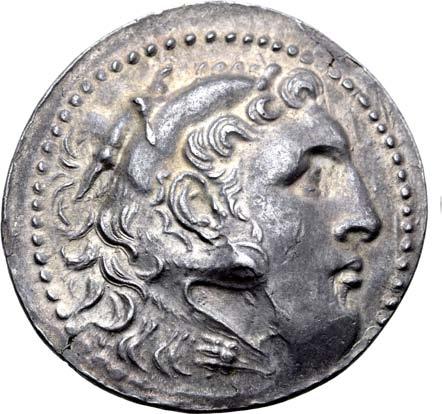

278. 900
Good Extremely Fine; attractively toned and struck on a large flan. Apparently unique and unpublished.
Ex Heritage World Coin Auctions, Long Beach Signature Sale 3067, 6 September 2018, lot 30201; Ex Classical Numismatic Group, Triton XIII, 5 January 2010, lot 107.
IONIA
279. 900
Ionia, uncertain mint EL Trite. Circa 650-600 BC. Lydo-Milesian standard. Plain type. Plain globular surface / Two incuse square punches. Traité I 3; Rosen 253; SNG von Aulock 7761; Boston MFA 1749. 4.62g, 12mm.




Extremely Fine. Rare.
Ionia, uncertain mint EL 1/24 Stater. Circa 6th century BC. Bull or ox standing to right, head reverted / Rough incuse punch. SNG von Aulock 7794; Boston MFA 1793; Rosen 89. 0.53g, 7mm.
Good Very Fine. Very Rare.
100 PAPHLAGONIA
280. 300 3x 3x 2x 2x
281.
Ionia, uncertain mint EL Hekte. Circa 600-550 BC. Lydo-Milesian standard. Facing head of lion or panther within triangular incuse on a raised area / Two square punches with raised lines within. Weidauer 160 = Traité I 30 = Boston MFA 1753 = Warren 1721; SNG Kayhan 711. 2.35g.




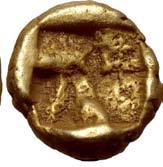

NGC graded Ch XF 4/5 - 4/5, edge scuffs (#5872643-008). Rare.
Acquired from Vilmar Numismatics.
282.
1,500
283.
Ionia, uncertain mint EL 1/24 Stater. Circa 600-550 BC. Phokaic standard. Lion seated to right, with open jaws and tail raised / Quadripartite incuse square. Unpublished in the standard references; CNG 111, 267; Nomos 19, 135; Gulbenkian 724 var. (hekte); SNG von Aulock 1776 var. (same). 0.64g, 6mm.
Extremely Fine. Very Rare and among the finest known examples of the type.
Extremely Rare
284.
Ionia, Kolophon AR Trihemiobol. Circa 450-410 BC. ΚΟΛΟΦ[...], laureate head of Apollo to right / Kithara within incuse square. SNG Copenhagen 138; Milne, Colophon 23. 1.29g, 12mm, 12h.





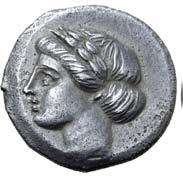


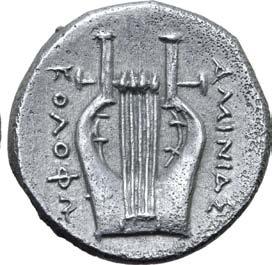
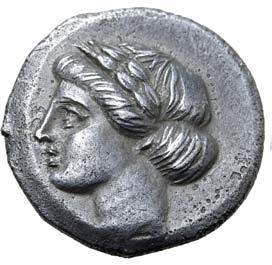
Good Very Fine. Extremely Rare.
Acquired from Leu Numismatik AG; Ex collection of G. Plankenhorn, formed since the 1960s.
300
Ionia, Kolophon AR Drachm. Reduced Rhodian standard. Circa 310-294 BC. Aminias, magistrate. Laureate head of Apollo to left / Kithara; ΚΟΛΟΦΩ[Ν] to left, AMINIAΣ to right. Kinns 89; Milne, Kolophon 85; SNG Copenhagen -. 2.94g, 15mm, 4h.
Good Extremely Fine.
From the Saint Paul Collection; Ex Roma Numismatics Ltd., E-Sale 28, 2 July 2016, lot 131.
101
150
600 2x 2x 2x 2x
Ionia, Magnesia ad Maeandrum AV Stater. Circa 155-140 BC. Euphemos, son of Pausanias, magistrate. Draped bust of Artemis to right, wearing stephane, with bow and quiver over shoulder / Nike, holding kentron and reins, driving fast biga to right; MAΓNH[TΩN] (of the Magnesians) above, EYΦHMO[Σ] ΠAYΣANIOY below. Roma XXII, 302 (same dies); Heritage 3056, 30066 (same); unpublished in the standard references, but for the magistrate Euphemos son of Pausanias and dating of the stephanophoric tetradrachms of Magnesia, cf. N. F. Jones, ‘The Autonomous Wreathed Tetradrachms of Magnesia-on-Maeander’, ANSMN 24, 1979, pp. 63-109, especially nos. 8-25; for the obv. Artemis bust type cf. B. Head, History of the Coinage of Ephesus, London 1880, p. 69, 1-7, pl. 5 and Mørkholm, Early Hellenistic Coinage, Cambridge 1991, 657 = Gulbenkian 985. 8.43g, 18mm, 12h.




Extremely Fine. Rare; a type of great numismatic importance.
Acquired from Leu Numismatik AG.
The discovery of this totally new reverse type for a gold stater on the Attic weight standard of about 8.5g, fortunately signed by a very well known Magnesian magistrate, solves two long standing numismatic problems. Firstly, it allows for the dating of the Ephesian gold staters with which it is associated, and it confirms the mid second century dating of the Ionian stephanophoric coinage. Euphemos, son of Pausanias, was one of the eight magistrates who were responsible for the substantial silver stephanophoric ‘wreath-bearer ’ tetradrachm issues, beautifully engraved and struck on broad flans on the Attic silver standard of about 17.2 grams. It is notable that Magnesia had in the late 4th and early 3rd centuries produced very high quality Attic standard gold staters with polished dies in the names of Philip, Alexander and Lysimachos.
The obverse bust of Artemis is of exactly the same style as the well known Ephesos gold staters which depict on their reverse the Ephesian cult figure of Artemis. Until now those Ephesian staters have defied proper dating, having been given a chronological range by various authors from 150 to 88 BC (cf. Gilbert K. Jenkins, ‘Hellenistic gold coins of Ephesus’, in Festschrift E. Akurgal, Anadolu-Anatolia 21, 1978/80, Ankara, 1987, pp. 183-8, pls. A-B). Though of course it does not preclude the possibility that they were struck over an extended period of time, we may now at least say with some certainty that they were already being struck by around 150-140 BC.

The evidence from the seven extant stephanophoric tetradrachm hoards from the contemporary territory of the Seleukid Empire, found together with dated Seleukid coins, points to a secure narrow chronological range for all these issues of 150-138 BC. Significantly the Magnesian coinage has often been found in close association with similar wreathed issues from Aigai, Kyme, Myrina, Herakleia, Lebedos and Smyrna in what must have been an unattested ‘entente’ by cities that had been guaranteed their autonomy following the imposition by Rome of the Treaty of Apameia between the Republic and Antiochos III in 188 BC - an attempt to stop the constant quarrelling between the Greeks. For the numismatic history of the period cf. Jones 1979, pp. 90-100 and C. Boehringer, Zur Chronologie Mittelhellenistischer Münzserien 220-160 v. Chr., Berlin 1972, pp. 49f.
Ionia, Magnesia ad Maeandrum AR Tetradrachm. Circa 155-140 BC. Attic standard, Stephanophoric type. Euphemos, son of Pausanios, magistrate. Diademed and draped bust of Artemis to right, bow and quiver over shoulder / Apollo Delphios standing to left, resting on tall tripod behind, holding branch tied with fillet; EYΦHMOΣ ΠAYΣANIOY in two lines to left, MAΓNHTΩN to right, maeander pattern below; all within laurel wreath. Jones obv. die 9; SNG Copenhagen -. 16.74g, 32mm, 12h.
Near Mint State; attractive old cabinet tone.
Acquired from Noonan’s.
Extremely Rare
1,800
287. 900
Ionia, Magnesia ad Maeandrum AR Tetradrachm. Circa 155-145 BC. Attic standard, Stephanophoric type. Antigenes, son of Anaxikrates, magistrate. Diademed and draped bust of Artemis to right, bow and quiver over shoulder / Apollo Delphios standing to left, resting on tall tripod behind, holding branch tied with fillet; ANTIΓENHΣ ANAΞIKPATOY to left, MAΓNHTΩN to right, meander pattern below; all within laurel wreath. Jones obv. die 34 (for Erasippos, son of Aristeos, [this magistrate unlisted]); SNG von Aulock -; SNG Copenhagen -; BMC -; cf. R. Ashton and P. Kinns, Opuscula Anatolica II in NC Vol. 164 (2004), p. 73, footnote 11; NFA XIX (1987), 326. 16.92g, 30mm, 12h.



Near Mint State. Extremely rare with this magistrate, seemingly only the third example offered at auction since 1987.

102
285.
2,700
286.
Ionia, Miletos AR Tetradrachm. In the name and types of Alexander III of Macedon. Circa 295-270 BC. Head of Herakles to right, wearing lion skin headdress / Zeus Aëtophoros seated to left on low throne, holding sceptre; AΛEΞANΔPOY to right, MI (civic) monogram in left field. Price 2150 var. (back to throne); SNG Copenhagen 751. 16.96g, 27mm, 1h.


288. 1,500
Near Mint State; beautifully centered on the flan and featuring a bold portrait struck in excellent, early Hellenistic style.
Ex Dr. Hans Krähenbühl Collection, Leu Numismatik AG, Auction 8, 23 October 2021, lot 49; Ex Classical Numismatic Group, Triton IX, 10-11 January 2006, lot 783, original auction ticket included.
Ionia, Miletos AR Drachm. Circa 205 BC. Laureate head of Apollo facing slightly to right / Lion standing to left, head reverted; MI monogram over ME monogram in left upper field, sun-burst in right upper field, [M]ENANΔΡ[ΟΣ] in exergue. Unpublished in the standard references, for magistrate’s name cf. Kinns, Review, p. 255 and Giessener Münzhandlung 90, 330 (hemidrachm); for type cf. Deppert-Lippitz 633-4 (hemidrachms); cf. Roma Numismatics E-Sale 26, 212 (hemidrachm); for dating cf. P Kinns, Milesian Notes in Opuscula Anatolica II, 2003, pp. 11-12. 5.35g, 20mm, 1h. Extremely Fine. Unique and unpublished, save for its previous auction appearance, and of great numismatic importance.

Ex Long Valley River Collection, Roma Numismatics, Auction XX, 29 October 2020, lot 180; Ex Roma Numismatics Ltd., Auction XI, 7 April 2016, lot 298; Ex private German collection.
This beautiful drachm of Miletos represents a remarkable break with the city’s century and a half old tradition of issuing silver coinage with a profile head of Apollo. While a facing-Apollo head had been employed at Miletos from c. 260 BC for bronze issues that would retain the same types (facing Apollo, and lion standing with head reverted) through to the end of the series c. 200 BC, prior to the publication of this coin in Roma Numismatics XI, the facing-Apollo series was known in silver only from the extremely rare hemidrachm denomination (surviving in only seven examples). These hemidrachms were assessed by P. Kinns (Opuscula Anatolica II, 2003, Milesian notes, pp. 11-12) as being struck at a higher than usual weight (2.53g - 2.82g, compared to an average of 2.35g - 2.53g for the ‘regular ’ profile head issues), corresponding to an earlier standard in use around 260-250 BC. He furthermore observes that this higher weight standard was quickly abandoned in favour of a return to lighter profile-head coins. This unique drachm confirms the higher weight standard briefly used, as it equates to two hemidrachms of 2.68g, which is precisely as expected given the mean weight of the surviving specimens.




The circumstance for the striking of the facing-Apollo silver coins, which are contemporary with the final group of middle-denomination facingApollo bronzes, may be found in the Cretan War of 205-200 BC. The Macedonians under Philip V had just concluded a favourable treaty with Rome following the First Macedonian War, but undertook not to expand further westwards; while Rome preoccupied itself with Carthage then, Philip looked east and resolved to seize control of the Greek world. Having defeated the Kingdom of Pergamon and allied with the Aetolian League and several of the major Cretan cities, the only serious power that opposed Philip was the city-state of Rhodes and its allies. Despite Rhodes and its allies having dealt the Macedonian navy near crippling losses in the Battle of Chios in 201, Philip was not defeated and shifted his attention to Karia. Rhodes’ fleet had repositioned to the strait between Lade and in order to block the approach to Miletos - the most likely Macedonian objective, and the door to Karia and Rhodes’ own mainland territories, however the Rhodian fleet accepted an engagement at a numerical disadvantage and this time were defeated in short order.
Polybius (The Histories, XVI.15) relates that “the Milesians, in great alarm at what had happened... voted a crown to Philip for his brilliant attack”, and the city fell under Macedonian control. Though the historical sources for this conflict are sparse, Miletos had long maintained a close relationship with the Ptolemies, as had Rhodes, and with Miletos being located in close proximity to the Rhodian Peraia (the mainland territories controlled and colonised by Rhodes), it is safe to infer that if the city was not in fact allied to Rhodes prior to 201 BC, it was at least sympathetic to its neighbour. Even if Philip’s intentions were not clear to the Milesians at the outbreak of war, or even after he had captured and razed Kios and Myrleia, sacked Thasos and enslaved its people after having given them assurances of safety, they would certainly have understood his designs when in the winter of 203/2 he formed an alliance with Antiochos III of the Seleukid Empire in which Antiochos promised to help Philip take control of Ionia, as well as Kyrene and the Cyclades. It is highly likely then, given also that this coin is struck to a weight standard matching that of the contemporary Rhodian coinage, that this issue was a short-lived product of the Cretan War, discontinued after the city’s capitulation to Philip.
103
289.
4,500
Ex Triton IX, 2006
A Unique Cretan War Drachm
Ionia, Phokaia EL Hekte. Circa 625-522 BC. Head of seal to left; small seal downwards behind / Quadripartite incuse square. Bodenstedt 2.2 (e/-); cf. Boston MFA 1894; CNG Mail Bid 63, 495 (same obv. die). 2.58g, 10mm.


Extremely Fine. Very Rare variant with small seal downwards behind seal’s head.
291. 2x 2x
Ionia, Phokaia EL Hekte. Circa 625-522 BC. Helmeted head to left; small seal upwards behind / Quadripartite incuse square. Bodenstedt 6; Boston MFA -. 2.56g, 10mm.






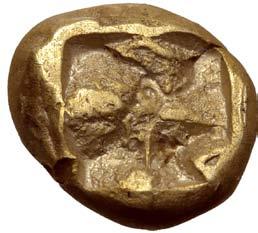




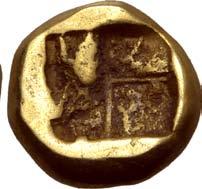





292. 450 3x 3x
Extremely Fine. Very
293. 2,100 2x 2x
Fine; well-centred. Very Rare.
294. 900 2x 2x
Good Extremely Fine; well-centred.
104
900 2x 2x
290.
Extremely Fine. Very Rare; Bodenstedt recorded only one example. 900
Ionia, Phokaia EL 1/24 Stater. Circa 625-522 BC. Head of a griffin with open jaws to left; small seal upwards behind / Quadripartite incuse square. Bodenstedt 12; Boston MFA 1893; BMC 16-8. 0.65g, 6mm.
Rare.
Ionia, Phokaia EL Hekte. Circa 521-478 BC. Forepart of lion to left, devouring prey; small seal to left above / Quadripartite incuse square. Bodenstedt 36; BMC 21; de Luynes 2646. 2.56g, 11mm.
Extremely
Ionia, Phokaia EL Hekte. Circa 521-478 BC. Head of ram to left; small seal to left below / Quadripartite incuse square. Bodenstedt 37; SNG von Aulock -; SNG Copenhagen -; Boston MFA 1896. 2.62g, 11mm.
Civic Parallel to the Dionysiac Technitai Tetradrachm
Islands off Ionia, Teos AR Tetradrachm. Circa 165-140 BC. Head of young Dionysos to right, wreathed with ivy leaves and flower in rolled hair from which a spiral lock falls on neck and shoulders / ΤΗΙΩΝ, draped statue of Apollo standing to left, naked to hips with himation end over left arm, extending kantharos in his left hand and holding thyrsos with right; to right, high pedestal surmounted by a small figure of Marsyas, standing to right holding wineskin; in left field, monogram Λκ. Unpublished in the standard references, for reverse type as a symbol cf. Teos tetradrachm in the name of Alexander dated to circa 204-190 BC by Price (no. 2310), and P. Kinns, Studies in the coinage of Ionia: Erythrae, Teos, Lebedos, Colophon, c. 400-30 BC, unpublished Cambridge University Ph.D. dissertation, 1980 pp. 220-1 and 519-20. 16.67g, 36mm, 1h.
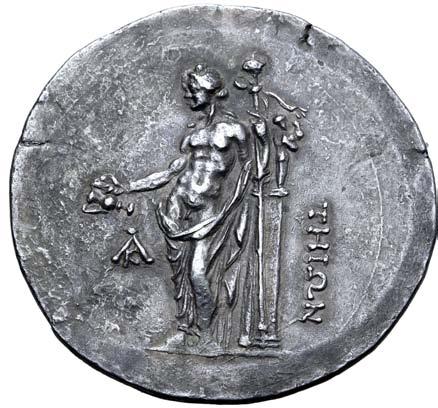


Good Extremely Fine, of excellent style. Unpublished, save for its previous auction appearance, unique, and of considerable numismatic and arthistorical importance.
Ex Long Valley River Collection, Roma Numismatics Ltd., Auction XX, 29 October 2020, lot 187; Ex Roma Numismatics Ltd., Auction XVII, 28 March 2019, lot 451.
9,000
Of all the gods worshipped at Teos, Dionysos was held above all - he was the legendary founder and protector of Teos, and such was the relationship between the city and its god that at the end of the third century BC the city and its territory were declared sacred and inviolate to Dionysos by the Seleukid king Antiochos III, who also released the city from tribute.
The Anthesteria, a festival of Dionysos celebrating new wine, was in the early fifth century BC already one of the chief religious occasions at Teos, and from the fourth century onwards the god appeared on civic coinage; in the second century BC the city was able to attract wider regional attention by enlarging the festival of Dionysos, and inviting to Teos the famous Association of Dionysiac Technitai. A professional guild of actors since around 279/8 BC, the Dionysiac Technitai were musicians, actors and other artists devoted to Dionysos who participated in the festivals and contests across the Greek world in the classical and Hellenistic periods, enjoying panhellenic freedom of travel and immunity from hostile action. Organised into three corporate bodies or chapters at Athens, in the Peloponnesos, and in Asia Minor, the latter was based in Teos from circa 207/6 until sometime during the second century.
The Association of Dionysiac Technitai struck, presumably at Teos, a coinage issue survived by a single specimen (‘An Unpublished Tetradrachm Issued by the Artists of Dionysos’ in NC 163, 2003, pp. 59-68, p. 15, 1) which is the only known ancient coin struck in the name of a professional guild; it may have been intended as a prize or gift for visiting dignitaries. The present issue should be considered to have been issued contemporaneously with the tetradrachm of the Dionysiac Technitai (that is to say circa 165-140 BC as evidenced by finds such as the Cilicia 1972 Hoard from near Kirikhan dated to about 140 BC - cf. Coins Hoards I, 1975, 87A) along with the other great outputs of stephanophoric coinage from other western Asia Minor mints including (but not limited to) Kyme, Myrina, Herakleia, Lebedos, Magnesia ad Maeandrum, and Smyrna. If it should be considered possible that the Dionysiac Technitai tetradrachm was issued in connection with a major festival event for the specific use or promotion of the Association, then in such an event we might also find the cause for a parallel civic issue.
The obverse portrait of Dionysos of this unique issue is analogous to that of the Dionysiac Technitai tetradrachm, but unlike the latter’s simple stephanophoric thyrsos design, the reverse of the present coin is nearly identical in pose to the symbol employed on the Teos tetradrachm issue in the name of Alexander dated to circa 204-190 BC by Price (no. 2312) and P. Kinns (Studies in the coinage of Ionia: Erythrae, Teos, Lebedos, Colophon, c. 400-30 BC, unpublished Cambridge University Ph.D. dissertation, 1980, p. 519, 125); the present coin in all probability therefore depicts a statue of Dionysos that we might infer stood within the temple precinct at Teos. The temple itself was the largest dedicated to Dionysos in the ancient world, and was considered the finest example of the Ionic style of architecture in the Greek world; this celebrated monopteral temple was attributed by Vitruvius to the architect Hermogenes of Priene (see De Architectura 1.0.12). Nothing appears to be recorded concerning the statue we must expect to have stood within the temple; it is possible therefore that the present coin represents its only surviving depiction. If Vitruvius was correct in his attribution of the temple to Hermogenes, said construction must have taken place in the late third to early second century BC, which period would certainly fit with the naturalistic contrapposto composition of the type. In any case, despite the great importance of the cult of Dionysos to the city, the Dionysiac coinage from this mint is excessively rare, and the present specimen represents a welcome addition to our understanding of the coinage of Teos.
105
295.
Troas, Abydos AR Tetradrachm. Circa 80-70 BC. Iphiados, magistrate. Draped bust of Artemis to right, wearing stephanos; bow and quiver over shoulder / Eagle, with wings spread, standing to right; ABYΔHNΩN above, IΦIAΔOY below, radiate head of Helios to right with star above in right field; all within laurel wreath. Callataÿ, Abydos, D34 (same obv. die); SNG München 32; SNG von Aulock 1453 (same obv. die); Roma XXVII, 252 (same dies). 15.89g, 31mm, 1h.
Good Very Fine; beautiful old cabinet tone. Rare.
1,200
Troas, Abydos AR Tetradrachm. Circa 80-70 BC. Iphiados, magistrate. Draped bust of Artemis to right, wearing stephanos; bow and quiver over shoulder / Eagle, with wings spread, standing to right; ABYΔHNΩN above, IΦIAΔOY below, radiate head of Helios to right with sun above in right field; all within laurel wreath. Callataÿ, Abydos, D34 (same obv. die); SNG von Aulock 1453 (same obv. die). 15.74g, 32mm, 12h.
Near Extremely Fine. Extremely Rare.
900
Troas, Abydos AR Tetradrachm. Circa 80-70 BC. Iphiados, magistrate. Draped bust of Artemis to right, wearing stephanos; bow and quiver over shoulder / Eagle, with wings spread, standing to right; ABYΔHNΩN above, IΦIAΔOY below, radiate head of Helios to right with sun above in right field; all within laurel wreath. Callataÿ, Abydos, D34 (same obv. die); SNG von Aulock 1453 (same obv. die). 16.41g, 34mm, 12h.





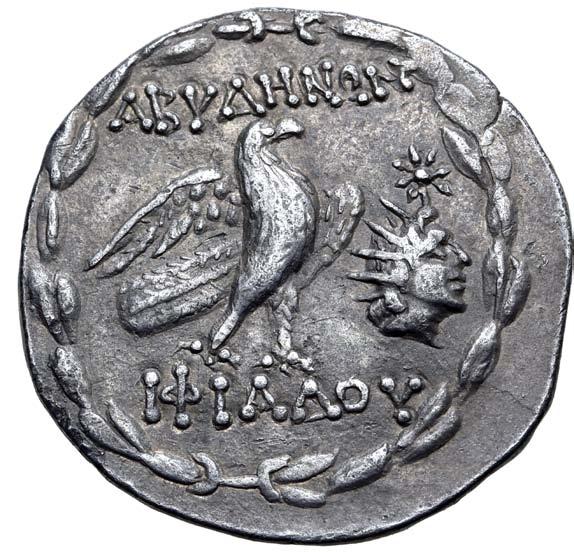
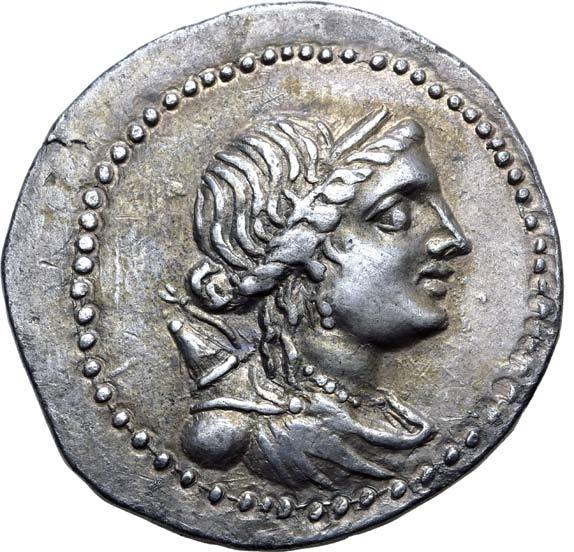



Near Extremely Fine. Extremely Rare.
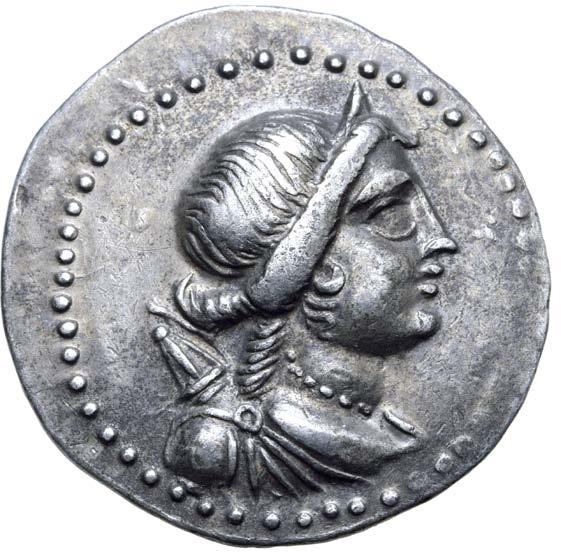
106
296.
297.
298. 750 TROAS
Troas, Abydos AR Tetradrachm. Circa 80-70 BC. Iphiados, magistrate. Draped bust of Artemis to right, wearing stephanos; bow and quiver over shoulder / Eagle, with wings spread, standing to right; ABYΔHNΩN above, IΦIAΔOY below, radiate head of Helios to right with star above in right field; all within laurel wreath. Callataÿ, Abydos, D32 (same obv. die); SNG München 32; SNG von Aulock 1453; Naumann 43, 326 (same obv. die). 16.03g, 32mm, 12h.
Good Very Fine; beautiful old cabinet tone. Rare.
Troas, Abydos AR Tetradrachm. Circa 80-70 BC. Iphiados, magistrate. Draped bust of Artemis to right, wearing stephanos; bow and quiver over shoulder / Eagle, with wings spread, standing to right; ABYΔHNΩN above, IΦIAΔOY below, radiate head of Helios to right with sun above in right field; all within laurel wreath. Callataÿ, Abydos, D32 (same obv. die); SNG Fitzwilliam 4250 (same obv. die). 16.25g, 31mm, 12h.


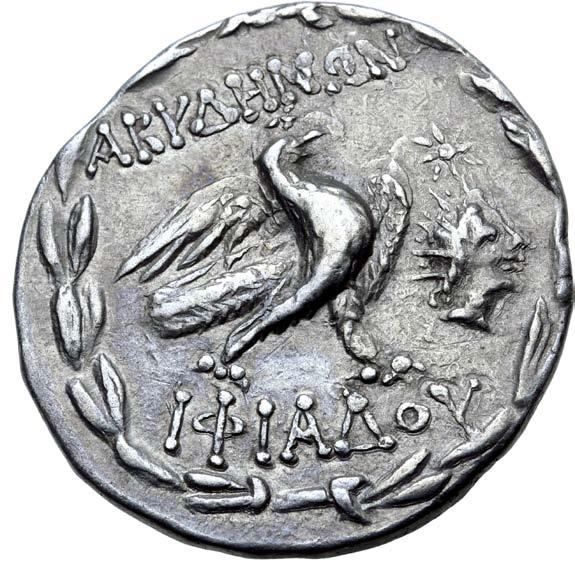
Good Very Fine. Extremely Rare.
No Others on CoinArchives
Troas, Abydos AR Tetradrachm. Circa 80-70 BC. Kallistratos, magistrate. Draped bust of Artemis to right, wearing stephanos; bow and quiver over shoulder / Eagle, with wings spread, standing to right; ABYΔHNΩN upwards on left, KAΛΛIςTPATOY below, cornucopiae in right field; all within laurel wreath. Callataÿ, Abydos, D21/R1; SNG von Aulock 1453 var. (rev. control symbol). 16.47g, 28mm, 12h.




Good Very Fine; beautiful old cabinet tone. Extremely Rare; seemingly no other examples with this control on CoinArchives.
600
Troas, Assos AR Drachm. Circa 500-450 BC. Griffin seated to left, raising right forepaw / Head of roaring lion to right within incuse square. Boston MFA 1626; BMC 1; Traité II 2298, pl. CLXIII, 25; SNG von Aulock -; SNG Copenhagen -. 3.49g, 13mm, 3h.


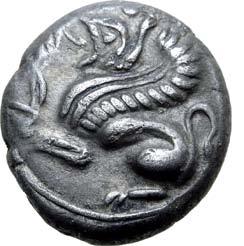

Near Extremely Fine.
Acquired from Classical Numismatic Group.

107
299. 750
300. 750
301.
302. 600
Extremely Rare
Islands off Troas, Tenedos AR Tetradrachm. Circa 160-70 BC. Janiform head of a laureate bearded male to left and female to right, wearing stephanos / Labrys; TENEΔIΩN above, handle flanked by monogram and grape bunch to left, pilei of the Dioscuri to right; all within laurel wreath. Callataÿ, Tenedos 94 (D19); BMC 29; HGC 6, 390; CNG Triton X, 278 (same dies). 16.27g, 32mm, 12h. Extremely Fine; beautiful old cabinet tone. Extremely Rare.



9,000
Tenedos was an island of strategic importance throughout antiquity due to its location at the entrance to the Hellespont, which ensured every ship sailing to or from the Propontis and the Black Sea would pass by. It is referenced in both Homer’s Iliad and Virgil’s Aeneid, in the latter as the place where the Greek fleet was concealed towards the end of their siege of Troy in order to trick the Trojans into taking the fateful Trojan horse within the walls of the city. During the fifth century, Athens used the island as a stronghold to protect their vital shipping routes, but it came under the influence of successive Hellenistic dynasties from the third century onwards: controlled first by the Seleukids, then the Attalids and eventually by Mithridates VI Eupator, who used the island as a naval base in the Third Mithridatic War against the Roman general Lucullus in 73-63 BC. It was during the latter’s long reign that this type and other stephanophoric (wreath-bearing) Tenedian tetradrachms were first minted.
The labrys on the reverse of this coin is a reference to the Tenedian foundational myth, in which the hero Tenes used an axe to sever the mooring lines of his father’s ship when he attempted to land on the island to reconcile with his son. In Pausanias’ version of the myth, he concludes “for this reason a by-word has arisen, which is used of those who make a stern refusal: so and so has cut whatever it may be with an axe of Tenedos” (Paus. 10.14.4). Indeed, Cicero, writing less than half a century from the time of this coin’s issue jokes to his brother Quintus about Tenedos’ unsuccessful request to the Roman senate to be made a free city: “well then, the liberty of the Tenedians has been chopped by the Tenedian axe” (Letters to his brother Quintus, 2.9).

108
303.
An Apparently Unpublished Control
Islands off Troas, Tenedos AR Tetradrachm. Circa 160-70 BC. Janiform head of a laureate bearded male to left and female to right, wearing stephanos / Labrys; TENEΔIΩN above, handle flanked by monogram and grape bunch to left, small figure of Hermes with kerykeion to right; all within laurel wreath. Callataÿ, Tenedos -, cf. 49-55 (drachms) corr. (monogram); BMC -, cf. 33 (drachm); HGC 6, 390 var. (this control not listed); Roma XXVII, 257 (same rev. die). 15.90g, 33mm, 1h.

Extremely Fine; fine style, slight doubling on obv. Apparently unpublished with this control in this denomination.
9,000
Islands off Troas, Tenedos AR Tetradrachm. Circa 160-70 BC. Janiform head of a laureate bearded male to left and female to right, wearing stephanos / Labrys; TENEΔIΩN above, handle flanked by monogram and grape bunch to left, eagle to right; all within laurel wreath. Callataÿ, Tenedos 11; HGC 6, 390. 16.12g, 33mm, 12h.






Good Very Fine. Extremely rare with this control symbol.
4,500
109
304.
305.
Islands off Troas, Tenedos AR Tetradrachm. Circa 100-80 BC. Janiform head of a laureate bearded male to left and female to right, wearing stephanos / Labrys; TENEΔIΩN above, handle flanked by monogram and grape bunch to left and small figure of Marsyas to right; all within laurel wreath. Callataÿ, Tenedos 65 (D13/R1a); HGC 6, 390. 15.93g, 31mm, 1h.


306. 3,000
Good Very Fine. Extremely Rare variety; only 5 others offered at auction in the past twenty years.
AIOLIS
307. 1,050
Aiolis, Kyme AR Tetradrachm. Circa 151-143 BC. Olympios, magistrate. Head of the Amazon Kyme to right, wearing tainia / Horse prancing to right; one-handled cup beneath raised foreleg, KYMAIΩN downwards to right, ΟΛΥΜΠΙΟΣ below; all within wreath. Oakley obv. die 52; Boston MFA 1651 (same obv. die); Pozzi 2302 (same obv. die). 16.92g, 33mm, 12h.




Good Extremely Fine.
Acquired from Classical Numismatic Group.
308. 900
Aiolis, Myrina AR Tetradrachm. Circa 155-145 BC. Stephanophoric type. Laureate head of Apollo to right / Apollo Grynios standing to right, holding phiale in right hand, filleted laurel branch in left; monogram and MYPINAIΩN to left, omphalos and amphora at feet; all within laurel wreath. Sacks Issue 34, obv. die 59 (die unlisted for issue); Hunterian 5; SNG Copenhagen -; SNG von Aulock -. 16.64g, 32mm, 11h.


Good Extremely Fine. Very Rare; only two specimens recorded by Sacks.
LESBOS
Lesbos, Mytilene AR Tetradrachm. Circa 215-200 BC. In the name and types of Alexander III of Macedon. Head of Herakles to right, wearing lion skin headdress / Zeus Aëtophoros seated to left, holding sceptre; AΛEΞANΔPOY to right, monogram above kithara in left field. Price 1699; Müller 976; HGC 6, 1046. 16.81g, 30mm, 12h.




Extremely Fine; large planchet.
Acquired from Leu Numismatik AG; Ex Hestia Collection, formed over the past five decades.
110
309. 600



112 MYSIA
Of the Utmost Rarity
Mysia, uncertain mint EL Stater. Circa 450-330 BC. Phokaic standard. Forepart of Pegasos to left; spear head to right below / Quadripartite incuse square of windmill pattern with stippled quarters. Triton XIX, 168 (same dies), otherwise unpublished in the standard references.
NGC graded AU ★ 5/5 - 3/5, Fine Style (#6674413-003). Of the utmost rarity, only the second known example. Acquired from Leu Numismatik AG.
This issue bears a close resemblance to the electrum staters of Lampsakos struck with the type of a Pegasos forepart (cf. Boston MFA 1582) throughout the sixth and fifth centuries, but differs significantly on a number of accounts. Firstly, this coin appears to be struck on the Phokaic weight standard of 16.10g employed by the mints at Phokaia, Mytilene and Kyzikos, rather than the Milesian standard of 14.10g which was used at Lampsakos.

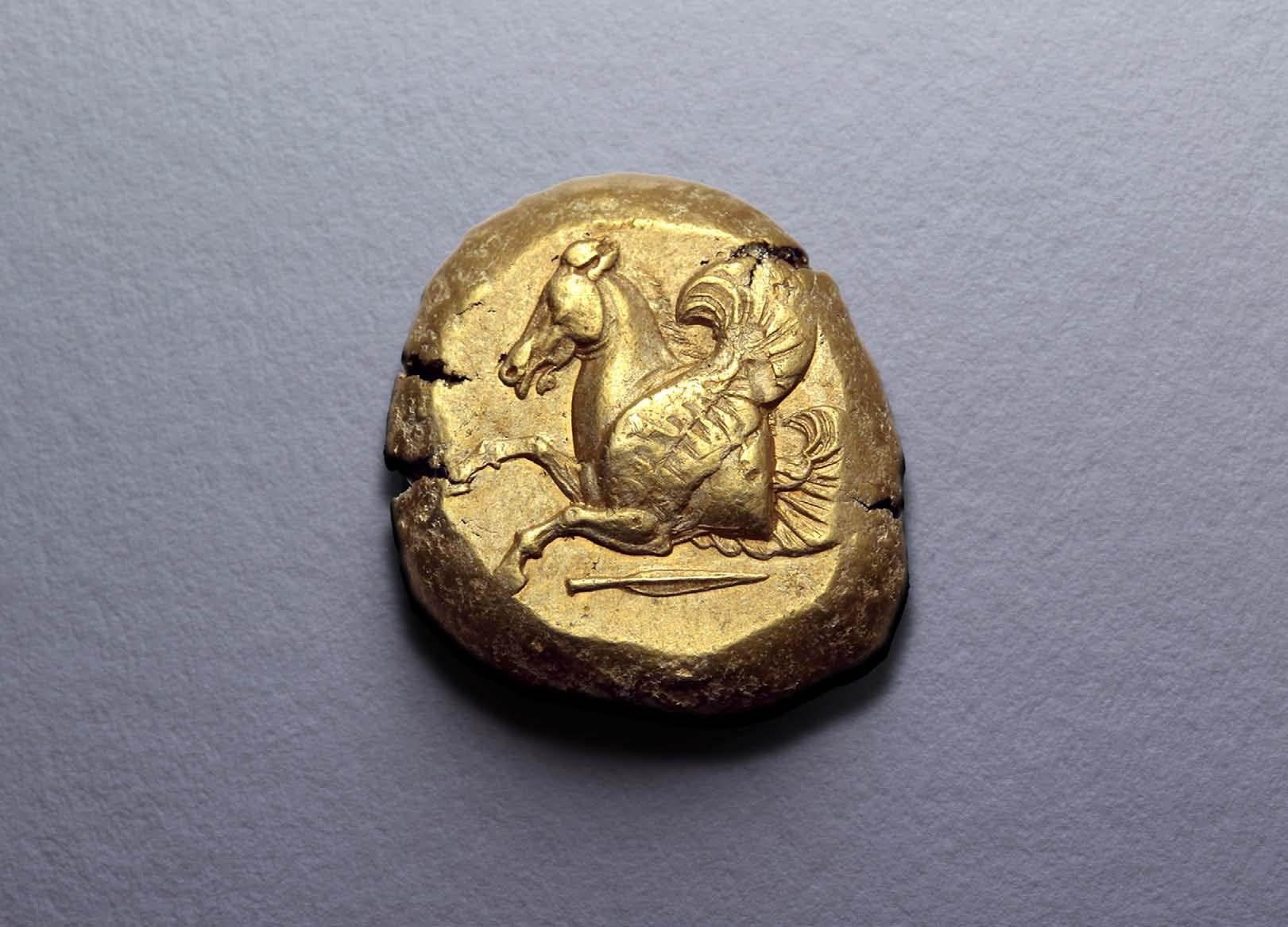
Secondly, the windmill style quadripartite incuse punch on the reverse of this coin is typical of that used at Kyzikos, in comparison to the more regular quadripartite punch of staters at Lampsakos with all four quarters uniformly depressed. The cataloguer of the Triton XIX example also noted the difference in style between the Pegasi of Lampsakos which are carved in remarkably consistent style with legs folded in, and the splayed legs of the example here, with parallels to some issues of Kyzikos depicting mythological creatures in a similar position (e.g. von Fritze I pl. II, 7 and 24).
It is clear therefore that this issue’s weight standard, the distinctive incuse of Kyzikos and it’s similarity to the Pegasos type of Lampsakos situate the mint in the region of Mysia. Although it lacks the distinctive tunny fish which is present on all known electrum issue of Kyzikos from 6th to 4th centuries BC, the similarities to staters of Kyzikos and the masterful quality of engraving may suggest the mint employed some engravers of that city: the cataloguer of the Triton XIX example suggests a colony or outpost of Kyzikos. Instead of a tunny, a spearhead features on the obverse, perhaps reflecting some military context for the issue.

113
310.
27,000
Mysia, Kyzikos AR Hemiobol. Circa 600-550 BC. Tunny fish head to right with small tunny or lotus flower in mouth / Quadripartite incuse square. Von Fritze II, -; SNG BnF -; Klein -; SNG von Aulock -. 0.49g, 8mm.

Extremely Fine; beautiful crystallisation patterns. Apparently unpublished.
Ex Roma Numismatics Ltd., E-Sale 100, 28 July 2022, lot 386.
Mysia, Kyzikos EL 1/12 Stater. Circa 600-550 BC. Head of tunny fish on spine to left; small tunny to right above, pellets above and below spine / Quadripartite incuse. Von Fritze I, 2 var. (hekte); SNG BnF -; Boston MFA -; Rosen -; Hurter & Liewald I-III -. 1.35g, 8mm.
Extremely Fine. Very Rare; unpublished in this denomination.
Very Rare
Mysia, Kyzikos EL Stater. Circa 550-500 BC. Forepart of lioness to left, devouring prey; tunny fish upwards behind / Quadripartite incuse square. Von Fritze 41, pl. I, 42; Greenwell 109; Boston MFA 1416 = Warren 1534; cf. SNG BnF 181 (hekte); BMC 46; Gillet -; Gulbenkian -; Jameson 2163; cf. Rosen 436 (hekte); Myrmekion -; Weber -. 16.00g, 20mm.



Very Fine. Very Rare.
Ex Roma Numismatics Ltd., Auction XX, 29 October 2020, lot 200. 1,800
Mysia, Kyzikos EL 1/12 Stater. Circa 550-450 BC. Archaic bearded head to left; tunny fish below / Quadripartite incuse square. Von Fritze I 66; SNG BnF 194 var. (denomination); Jameson 2170 var. (denomination); Rosen 447 var. (denomination); Hurter & Liewald I-III -. 1.34g, 8mm.



Near Mint State. Extremely Rare in this denomination - no other examples on CoinArchives.
Ex Roma Numismatics Ltd., Auction XXIII, 24 March 2022, lot 283. 1,800
Mysia, Kyzikos EL Hekte. Circa 550-470 BC. Lion at bay to left; tunny fish to left below / Quadripartite incuse square. Von Fritze I 84 (stater); Rosen 461. 2.66g, 11mm.



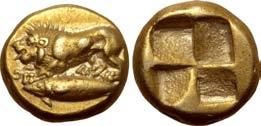







Good Extremely Fine.
Mysia, Kyzikos EL Hekte. Circa 500-450 BC. Panther or lioness advancing to left with tail curled over back; tunny fish to left below / Quadripartite incuse square. Von Fritze I 86; SNG BnF 219-20; Boston MFA 1472; Jameson 2175; Rosen 464. 2.59g, 12mm.
Extremely Fine. 300
114
210
Apparently
3x 3x
311.
Unpublished
3x 3x
180 312.
313.
3x 3x
314.
1,200 315. 2x 2x
316. 2x 2x
317.
Mysia, Kyzikos EL Stater. Circa 500-450 BC. Forepart of winged lioness to left; tunny fish behind / Quadripartite incuse square. Von Fritze I 96; SNG BnF 237; Boston MFA -. 16.09g, 19mm.
Near Mint State. Very Rare; one of the finest and most complete specimens offered to the market in the past 20 years.
Ex Long Valley River Collection, Roma Numismatics Ltd., Auction XX, 29 October 2020, lot 213; Ex Roma Numismatics Ltd., Auction IX, 22 March 2015, lot 322.
3,000
Kyzikos, purportedly the first Milesian colony, was located on the southwest shore of the Propontis in ancient Mysia next to the river Aisepos. Its prosperity was due principally to its two fine harbours, which made the city a convenient stopping point for merchant ships trading between the Aegean and Black Seas. Its principal export was the tunny, of which its waters had abundant stock.
The prevalence of winged beings in Kyzikene coinage is a reflection of archaic mythological convention that assigned wings to most divine or sacred entities as an immediately visible and understandable symbol of their nature, and in the case of gods, of their power to move at will across great distances. In the case of the winged animals, we should probably understand these to be attributes of or animals sacred to a particular Olympian god.
Very Rare Hekte with Beautiful Banker’s Mark
Mysia, Kyzikos EL Hekte. Circa 550-450 BC. Herakles, holding club overhead in right hand and bow with two arrows in left, in kneeling-running stance to right; tunny fish upward to left / Quadripartite incuse square. Von Fritze I 107; Greenwell 65; Boston MFA 1463; SNG BnF 249 = de Luynes 2440; BMC -; Rosen -. 2.69g, 11mm.
About Extremely Fine. Very Rare, and with an extremely unusual banker’s mark of an ivy-leaf within an incuse on edge.
Acquired from Classical Numismatic Group.

3,000
Mysia, Kyzikos EL 1/12 Stater. Circa 550-450 BC. Triton reclining to left, holding wreath in raised left hand, leaning on left elbow; tunny fish to left below / Quadripartite incuse square. Cf. Von Fritze I 126 (unlisted denomination); cf. Greenwell 11 (same); cf. Hurter & Liewald I 26a (stater); cf. Hurter & Liewald II 78 (Triton holding tunny before); cf. Boston MFA 1425 (hekte); cf. SNG BnF 276 (hekte); cf. BMC 24 (stater); cf. Gulbenkian 614 (hekte); cf. Jameson 2561 (hekte); cf. Rosen 503 (hekte); Traité -; Weber -; Münzen und Medaillen AG 52, 168; Triton XI, 209. 1.32g, 9mm.






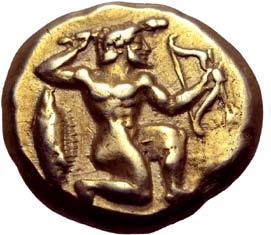




Extremely Fine. Very Rare; particularly in this denomination. Ex Siren Collection.
2,700
Mysia, Kyzikos EL 1/12 Stater. Circa 450-400 BC. Head of Attis to right, wearing ornamented Phrygian cap; [tunny fish] below / Quadripartite incuse square. Hurter & Liewald II, 142; Boston MFA 1523 var. (hekte); Greenwell 56, pl. III, 5 var. (stater & hekte); Von Fritze 142 var. (same); SNG BnF 291 var. (same). 1.30g, 8mm.

Extremely Fine. Extremely Rare. 600
Mysia, Kyzikos AR Drachm. Circa 170-150 BC. Stephanophoric type. Wreathed head of Kore Soteira to right / KY-ZI above and below flaming torch; monograms above and below(?); all within oak wreath. SNG von Aulock 1234; Von Fritze -; SNG BnF -; NAC 106, 259; ANS 1948.77.8. 3.23g, 19mm, 12h.

Extremely Fine. Extremely Rare denomination; only one other on CoinArchives which hammered for 12,000 CHF 600

115
318.
2x 2x
3x 3x
319.
3x
320. 3x
321.
Mysia,
Product of the Ionian Revolt, or Themistokles’ Control?
1582. 15.15g, 19mm.
Extremely Fine, struck on a broad flan. Rare.
Ex A. Tkalec AG, 9 May 2011, lot 56.
Lampsakos was founded in around 654/3 BC by Phokaian colonists, and in the sixth century became a dependency of Lydia; when the Lampsakenes had captured Miltiades, the Athenian tyrant of the Chersonesos, they were forced by Kroisos to set him free. After the fall of the Lydian kingdom in 547, the city then fell under the dominion of Persia. Lampsakos joined the Ionian cities in revolt in 499, but was conquered by Daurises in 498 or 497, and thereafter remained under Persian control until it was given by Artaxerxes to the exiled Athenian general Themistokles as part of the governorship of the Magnesian district. Themistokles’ district also included the cities of Myos, and Magnesia itself, who along with Lampsakos paid him revenue of 50 talents per year, for ‘meat’, ‘bread’ and ‘wine’ respectively. At an uncertain date after the death of Themistokles in 459, Lampsakos joined the Delian League, and is recorded in the tribute lists from 453/2, paying a phoros of fifteen talents.
The dating of this issue has long proven to be difficult, with earlier scholars having attributed it to as far back as 525-500, though this has been shown to be unlikely, not least on account of the style being of a more dynamic and baroque nature than the rather static designs of the Archaic period. At the time Baldwin published her study of the electrum coinage of Lampsakos in 1914, she knew of just fourteen varieties encompassing approximately forty specimens of all of Lampsakene electrum. As for coins from the first period under which this coin falls, she knew of just thirteen specimens. Of course while additional specimens have appeared over the past century, this coin is still a rarity.
The style is much more refined than the earliest issues of the period, and while it is tempting to perceive the Pegasos motif as one symbolising freedom, and thus try to place this as a product of the Ionian revolt, the general modern consensus is that the issue should belong to the period of 480-450. This being the case, it should reasonably be viewed within the context of Themistokles’ control of the city - under his control, Lampsakos was required to pay tribute, for which purpose a substantial issue of coinage was necessary. The subsequent issue has the same types and is also of a highly refined engraving style, but shows the letter Ξ below the winged horse of the obverse, thus tying it to the Athenian Coinage Decree and the banning of the use of non-Athenian silver soon after 450 BC.




116
Lampsakos EL Stater. Circa 480-450 BC. Forepart of Pegasos with curved wings to left; vine with bunches of grapes around / Quadripartite incuse square. Baldwin, Period I, Group II, 12; SNG BnF 1111; BMC 9; SNG von Aulock 1292 var. (monogram below Pegasos); Traité pl. 8, 2; Boston MFA
322. 6,000
323.
Very Rare
Mysia, Pergamon AR Diobol. Eurysthenes or Gongylos as satrap. Circa 450-400 BC. Laureate head of Apollo to right / Bearded head of satrap to right, wearing Persian headdress; ΠΕΡΓ upwards to left, uncertain symbol (possibly an eye?) to upper right; all within incuse square. SNG BnF 1546-48 var (no reverse symbol); SNG von Aulock 1347 var. (same); Winzer 7.3; Hauck & Aufhäuser 21, 103 (same dies). 1.66g, 12mm, 12h.




Near Mint State. Very Rare.
Ex Leu Numismatik AG, Auction 10, 24 October 2021, lot 2135.
LYDIA
Kingdom of Lydia, Alyattes EL Trite - 1/3 Stater. Sardes, circa 600-561 BC. Head of roaring lion to right, sunburst with five rays on forehead / Two incuse square punches. GRPC Lydia G25; Weidauer 88-89; ATEC Group D, 14-19. 4.76g, 12mm.
Extremely Fine.
Acquired from Leu Numismatik AG.
Kingdom of Lydia, Alyattes EL Trite - 1/3 Stater. Sardes, circa 600-561 BC. Head of roaring lion to right, sunburst with [five?] rays on forehead / Two incuse square punches. Cf. GRPC Lydia G25; cf. Weidauer 88-89; cf. ATEC Group D, 14-19. 4.74g, 12mm.
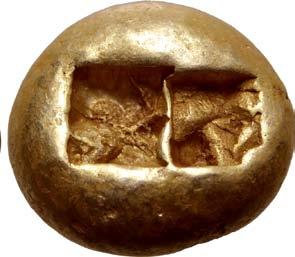






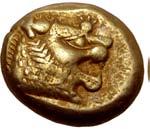
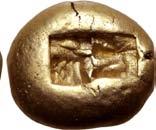


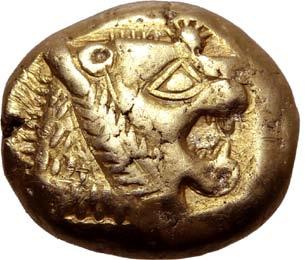
Good Extremely Fine.
Acquired from Leu Numismatik AG.
Kingdom of Lydia, Alyattes EL Trite - 1/3 Stater. Sardes, circa 600-561 BC. Head of roaring lion to right, sunburst with five rays on forehead / Two incuse square punches. GRPC Lydia G25; Weidauer 88-89; ATEC Group D, 14-19. 4.74g, 13mm.
Extremely Fine; a couple of minor marks.
Acquired from Leu Numismatik AG.
117
900
324. 1,650
325. 1,650
326. 1,500 2x 2x 2x 2x 2x 2x
Kingdom of Lydia, Kroisos AR Stater - Double Siglos. Sardes, circa 561-546 BC. Confronted foreparts of lion to right and bull to left / Two incuse squares of unequal size. GRPC Lydia S1; Berk 20; Traité I 407; SNG Kayhan 1018; SNG von Aulock 2874; SNG Copenhagen 455; SNG Ashmolean 760. 10.49g, 19mm.



Good Very Fine.
Ex Roma Numismatics Ltd., Auction XXIII, 24 March 2022, lot 302.


KARIA
1,050
Karia, Antioch ad Maeandrum AR Tetradrachm. Circa 90-60 BC. Solon, magistrate. Laureate head of Zeus to right / Eagle standing to left on thunderbolt; ANTIOXEΩN in three lines in right field, ΣOΛ in left field; all within circular meander pattern. Thonemann Group B, 8; HNO 1530 (temporary). 16.66g, 29mm, 1h.
Extremely Fine; pleasant old cabinet tone. Very Rare; among the finest of just a handful of examples known.
2,400
Karia, Antioch ad Maeandrum AR Tetradrachm. Circa 90-60 BC. Solon, magistrate. Laureate head of Zeus to right / Eagle standing to left on thunderbolt; ANTIOXEΩN in three lines in right field, ΣOΛ in left field; all within circular meander pattern. Thonemann Group B, 8; HNO 1530 (temporary). 16.53g, 28mm, 12h.




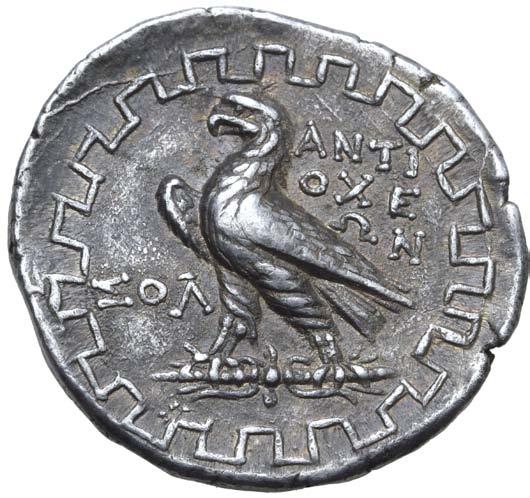


Extremely Fine; attractive cabinet tone. Extremely Rare.
2,400
118
327.
328.
329.
Islands of Karia, Kos(?) EL 1/48 Stater. Circa 625-580 BC. Crab / Rough incuse square. HNO 2467 (temporary); Rosen 347 var. (denomination, Asia Minor uncertain mint); BMC 29 var. (denomination, Ionia uncertain mint); HGC 6, 1295 var. (denomination); CNG 466, 177; Heritage 3099, 31161. 0.34g, 6mm.
Extremely Fine; a charming miniature crustacean. Very Rare; apparently unpublished in this denomination.
Hoover states in relation to the electrum fractions from this island; “While the attribution to Kos seems probable, production in Ionia or elsewhere in the islands or the Anatolian mainland cannot be excluded.”
RHODES
331.
Ex CNG 87, 2011
Rhodos, Rhodes AR Didrachm. Circa 230-205 BC. Eukrates, magistrate. Radiate head of Helios facing slightly to right / POΔION, rose with bud to right; anchor in left field, EYKPAT-HΣ across fields. Ashton 220; HNO 849 (temporary); SNG Keckman 549; SNG Copenhagen 760; HGC 6, 1440. 6.81g, 19mm, 12h.

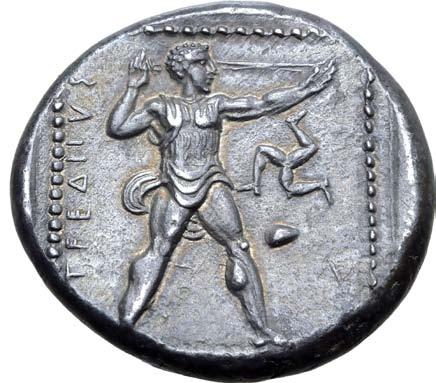





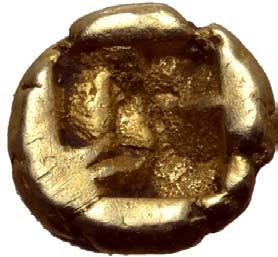

About Extremely Fine; beautiful old cabinet tone.
Ex Classical Numismatic Group, Auction 87, 18 May 2011, lot 558.
600
Pseudo-Rhodian AR Drachm. Struck for Perseus, King of Macedon. Uncertain mint in Thessaly, circa 171-170 BC. Third Macedonian War issue, Rhodian standard. Hermias, magistrate. Head of Helios facing slightly to right / Rose with bud to right; EPMIAΣ above, Z-Ω across stem. Ashton -; SNG Keckman 793-795 (attributed to Thessaly); Price, Kraay-Mørkholm Essays, pp. 241-2 (Thessaly or Macedonia); SNG Copenhagen suppl. 358 (Pseudo-Rhodian, Peraia); cf. HGC 6, 1453. 2.38g, 17mm, 10h.

Near Mint State. Rare.
Acquired from Morton & Eden; Ex European Ambassador Collection, formed in the 1950s and 1960s.
PAMPHYLIA
333.
Pamphylia, Aspendos AR Stater. Circa 380-325 BC. Two wrestlers grappling; pellet between / Slinger in throwing stance to right; [EΣ]TFEΔIIYΣ to left, triskeles to right; all within pelleted square. Tekin Series 4; SNG von Aulock 4536-4537; cf. SNG BnF 74 (same obv. die). 10.92g, 24mm, 12h.



Good Extremely Fine; attractive deep old cabinet tone.
Ex Gorny & Mosch Giessener Münzhandlung, Auction 257, 15 October 2018, lot 498; Ex old Munich collection, acquired before 1973.
3,600
119
330.
4x 4x
600
332. 150
Pamphylia, Aspendos AR Stater. Circa 380-325 BC. Two wrestlers grappling; KF in central field / Slinger in throwing stance to right; EΣTFEΔIIYΣ to left, triskeles to right; all within pelleted square. Tekin Series 4; SNG BnF 102; SNG von Aulock 4544–6. 10.81g, 23mm, 7h. Near Mint State; beautiful old cabinet tone with attractive hints of iridescence.

Acquired from Dr. Busso Peus Nachfolger; Ex collection of a Provenance Enthusiast; Ex Chaponnière & Firmenich, SA Auction 8, 5 July 2017, lot 14; Ex A. Tkalec AG, 19 February 2001, lot 150.
CILICIA
Extremely Rare
Cilicia, Kelenderis AR Stater. Circa 410-375 BC. Nude youth, holding whip in right hand, dismounting from horse rearing to right; T below / Goat kneeling to right, head reverted; KEΛEN above. Casabonne type 4; SNG BnF -; SNG Levante -; BMC 22 var. (monogram on rev.; same obv. die); Hirsch 1592 var. (same; same obv. die). 10.72g, 23mm, 12h.

Extremely Fine; unobtrusive test cut, struck from dies engraved in beautiful style. Extremely Rare.
Ex Roma Numismatics Ltd., Auction XXII, 7 October 2021, lot 372.
Cilicia, Kelenderis AR Stater. Circa 410-375 BC. Nude youth, holding whip in right hand, dismounting from horse rearing to right / Goat kneeling to right, head reverted; KEΛEN above, monogram in exergue. Kraay -; Casabonne type 4; SNG BnF -; SNG Levante -; SNG von Aulock 5639 var. (monogram). 10.59g, 22mm, 10h.





Extremely Fine; struck from a somewhat worn obv. die. Extremely Rare.
From the Saint Paul Collection; Ex Roma Numismatics Ltd., E-Sale 35, 3 May 2017, lot 318.
Cilicia, Soloi AR Obol. Circa 350-330 BC. Head of Athena to right, wearing crested Corinthian helmet / Grape bunch, with tendril; ΣOΛEΩN around. SNG BnF 185. 0.77g, 9mm, 9h.





Good Extremely Fine.
Acquired from Leu Numismatik AG; Ex Papillon, E-Auction 5, 6 March 2021, lot 333.
120
Tkalec
334. 3,000 Ex
2001
335. 300
336. 300
337. 300 3x 3x
One of the Greatest Rarities of Hellenistic Portraiture
Kingdom of Cappadocia, Orophernes AR Tetradrachm. Priene, circa 159-157 BC. Diademed head to right / Nike standing to left, holding wreath and palm; ΒΑΣΙΛΕΩΣ to right, ΟΡΟΦΕΡΝΟ[Υ] to left, [ΝΙΚΗΦΟΡΟΥ] in exergue; to inner left, owl standing to left, head facing, on round altar, above monogram. Simonetta 1; BMC 1; Gulbenkian 1018; Kraay-Hirmer 768; HGC 7, 815; NAC 106, 331 (hammer: 220,000 CHF); Lanz 158, 290; Gemini II, 129.

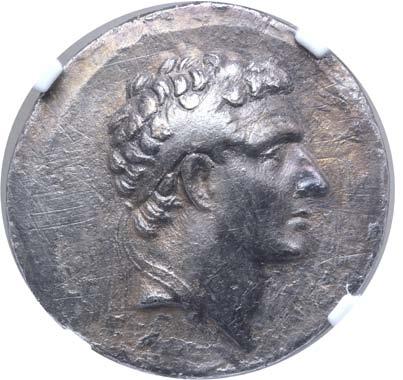
NGC Graded XF 4/5 - 2/5, scratches (#6556607-001). One of the greatest rarities of Hellenistic portraiture and only the fifth to appear at auction in the past two decades.

Ex Ira & Larry Goldberg Coins & Collectibles, Auction 130, 27 September 2022, lot 1147.
“He who on the tetradrachms / appears to be smiling / with a delicate beautiful face / is Orophernes.” These words begin a poem by the modern Alexandrian poet C. P. Cavafy (1866-1933) which is testament to the superlative artistry of this rare gem of numismatic Hellenistic portraiture.
12,000
The enigmatic Orophernes was one of two illegitimate sons of Antiochis and Ariarathes IV Eusebes, whom ancient accounts report were unable to conceive a child naturally. In an effort to secure their dynasty, Antiochis presented him with baby boys and claimed they were his legitimate children. However, when she later gave birth to the future Ariarathes V Eusebes, she revealed the truth and sent the suppositious sons out of Cappadocia to prevent them from challenging the succession of the legitimate heir to the throne. Orophernes was sent off to the Ionian city of Priene, while his brother was sent to Rome.
After the death of Ariarathes IV in 163 BC, Ariarathes V became king and soon after refused a marriage alliance with the Seleukid king Demetrios I Soter, who ruled in Syria without the sanction of the Roman senate, in an effort to maintain his good relations with Rome. Scorned, Demetrios I happily provided Orophernes with an army to invade and claim the throne of Cappadocia for himself in 158 BC. He succeeded in this ambition, but his time on the throne was brief and characterised by greed and oppression. He reportedly deposited 400 talents at Priene as security against any attempt to overthrow him, but he did not have to wait long for his rule to be contested. The deposed Ariarathes appealed to the Roman senate for support in restoring his throne, and Orophernes was ultimately forced to flee and sought safety with Demetrios I in Syria, where, in an extraordinary display of hubris, he also conspired to overthrow his protector. Demetrios I punished him with perpetual imprisonment in order to hold the threat of his potential release against Ariarathes V.
Upon his return to power, Ariarathes V demanded the return of the 400 talents Orophernes had drained from the kingdom and placed at Priene. The Prieneans refused, unwilling to betray Orophernes, and endured a brutal attack in retaliation. Six tetradrachms were found at Priene beneath the pedestal of the cult statue of Athena in 1870, and were thought to form part of Orophernes’ deposit. It has been suggested that the reverse type, with an owl, the symbol of Athena, standing on an altar may indicate that this findspot was the intended location for the coins, thus suggesting that the coins were minted at Priene also. The reverse design is a particular variation on a traditional and oft-repeated reverse type depicting Nike crowning the king’s name, which was ultimate derived from Lysimachos’ coins (323-281 BC) but here serves to reflect Orophernes’ title Nikephoros.
121
CAPPADOCIA
338.

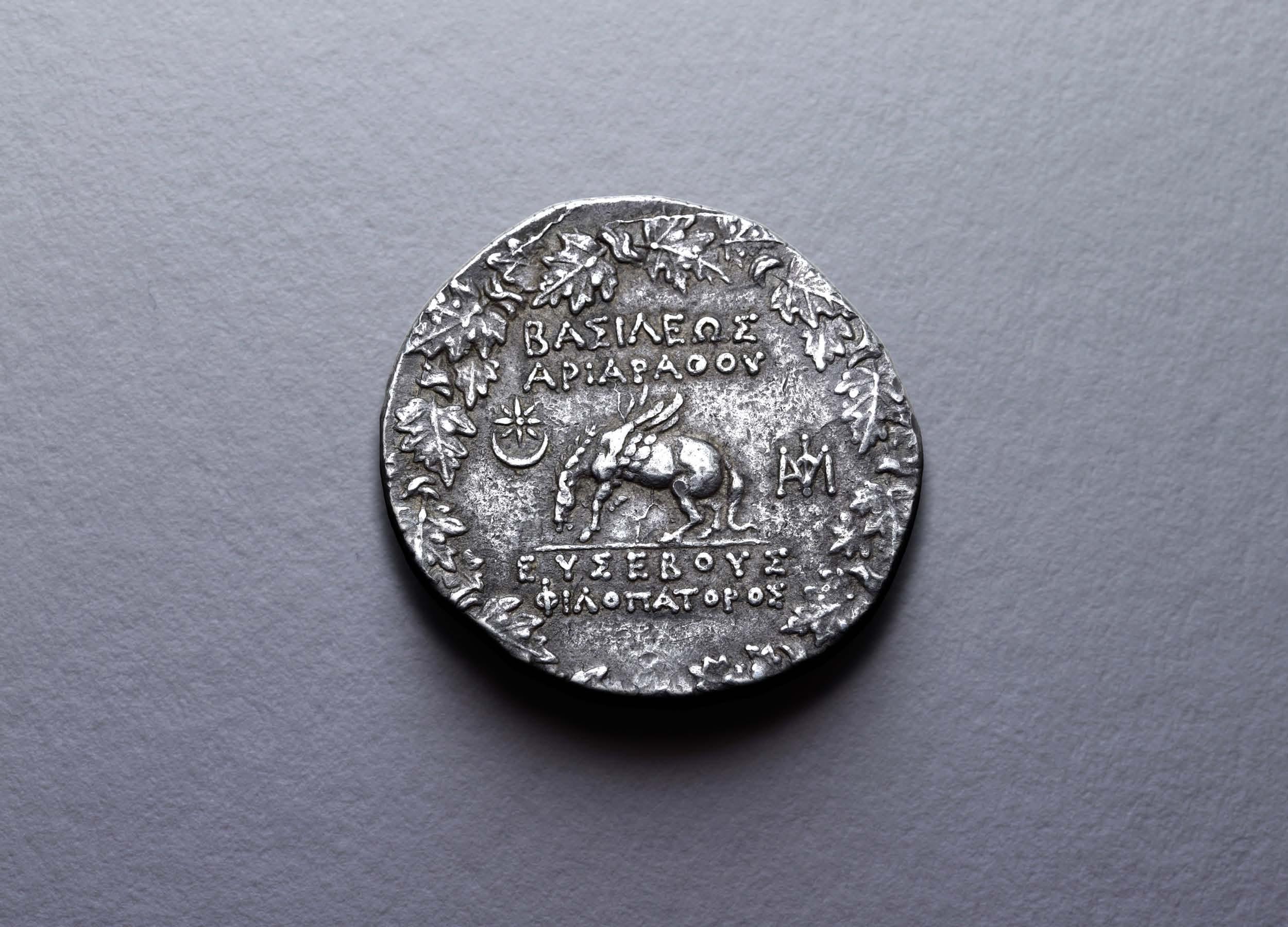
122
Kingdom of Cappadocia, Ariarathes IX Eusebes Philopator AR Tetradrachm. Eusebeia Tyana (or Amphipolis?), circa 101-86 BC. Diademed head to right / Pegasos grazing to left on ground line; star-in-crescent to left, AMΦI monogram to right; ΒΑΣΙΛΕΩΣ
above,
below; all within wreath of vine leaves. Simonetta 2007, p. 139 1a (same dies); SNG von Aulock 6299 (same dies); SNG Lockett 3085 (same dies); Jameson 1636 (this coin); de Callataÿ pl. XLIII (D1/R1b), p. 180, d (this coin); HGC 7 843 (same obv. die). 16.61g, 30mm, 12h.
Near Extremely Fine; beautiful old cabinet tone. Extremely Rare; one of only fourteen specimens known of which just seven are in private hands.
This coin published in F. de Callataÿ, L’histoire des guerres Mithridatiques vue par les monnaies (Louvain-La-Neuve, 1997);
This coin published in Collection R. Jameson, Monnaies grecques antiques, Vol. II, (Paris, 1913-1932);
Ex Long Valley River Collection, Roma Numismatics Ltd., Auction XX, 29 October 2020, lot 266;
Ex Schweizerische Kreditanstalt (Crédit Suisse), Monetarium List 56, Autumn 1991, no. 108;
Ex Numismatica Ars Classica, Auction 4, 27 February 1991, lot 157;
Ex Bank Leu AG, Auction 20, 25 April 1978, lot 155;
Ex Münzen & Medaillen AG Basel, Auction 19, 5 June 1959, lot 517;
Ex Frédéric Robert Jameson (1861-1942) Collection;
Ex Athanasios Rhousopoulos Collection, Dr. Jacob Hirsch, Auction XIII, 15 May 1905, lot 4417.
Some decades before the present coin was struck, under the reign of the child-king Ariarathes VI (130-116 BC), the Kingdom of Cappadocia had fallen under the sway of the neighbouring Kingdom of Pontos. The young king’s maternal uncle Mithradates V of Pontus attempted to assert control over Cappadocia by marrying his first daughter Laodike to Ariarathes. We must assume that the influence Laodike was able to assert over her husband was insufficient to turn Cappadocia into a reliable satellite of Pontos, or that her hold over him diminished as he grew older; thus when Mithradates VI succeeded his father to the throne of Pontos, he conspired to have Ariarathes murdered by a Cappadocian merchant named Gordius, in time replacing Ariarathes VI with the murdered king’s son, Ariarathes VII. He too proved insufficiently compliant to Mithradates’ will, objecting to his father’s murderer being handed a prominent role in the government of Cappadocia, and so was promptly assassinated too in his turn.

Mithradates placed his infant son on the throne of Cappadocia, paying lip service to the deposed dynasty by renaming him as Ariarathes, but early in his reign the Cappadocian nobility rebelled, overthrowing Mithradates’ son and installing instead the second son of Ariarathes VI, brother of Ariarathes VII. This revolt was quickly put down and Ariarathes VIII was exiled. Mithradates’ young son was restored to the throne as Ariarathes IX.
Under the kingship of Ariarathes IX, Mithradates’ hold over the Kingdom of Cappadocia was always tenuous at best; both the Kingdom of Bithynia and the Roman Republic attempted, with limited success, to detach Cappadocia from Mithradates’ grip, who was aided by his son-in-law Tigranes II, the powerful king of Armenia. Ariarathes IX was three (possibly four) times deposed and replaced with the Roman-appointed candidate, Ariobarzanes, yet in 89 BC Ariarathes IX was sent back into Cappadocia at the head of a powerful Pontic army and reinstalled, which together with Mithradates’ massacre of 80,000 Roman and Italian citizens in the Asiatic Vespers shortly thereafter led directly to war with the Roman Republic.
This beautiful coin was struck at an uncertain point in time but securely in the context of the First Mithradatic War, fought between the great powers of Rome and what may reasonably be called the last great Hellenistic empire, the Kingdom of Pontos. It makes no attempt to disguise the fact that Cappadocia was little more than an extension of Mithradates himself; the style of the obverse portrait greatly resembling that of the Pontic king, and the reverse type also mirroring one employed by Mithradates.

The suggestion that the minting location of this issue was not in Cappadocia but rather a ‘military’ mint located at Amphipolis was made by T. Reinach (Numismatique Ancienne: Trois Royaumes De L’asie Mineure, 1888) and accepted in BMC Galatia and (with a question) by Head (Historia Nummorum). However this has been considered doubtful on the basis that this monogram had not been ever used before at Amphipolis, and the similarly-located monograms on Mithradates’ coinage most likely refers to mint officials. That being said, the nature of this type and the possible circumstances for its production speak for reconsideration of the possibility. Amphipolis itself was captured by Pontic forces under the command of Mithradates’ general Taxiles, likely in early 86 BC, leaving open the possibility that a brief issue, known to have been struck from only two die combinations, might have been issued there in the name of Ariarathes for his immediate requirements. These must have been small, considering the extreme rarity of this issue struck from so few dies, and Ariarathes’ absence from Roman histories pertaining to the war. The surviving (Roman) accounts are confused; Plutarch (Parallel Lives, Sulla XI.1) apparently mixes up Ariarathes with his older brother Arkathias, who commanded the king’s 10,000 Armenian cavalry alongside his father’s generals (see also Appian Mith. 35, 41). The records captured by Pompey (Plutarch, Pompey XXXVII.1) suggest Ariarathes was poisoned by his father, possibly while campaigning in Thessaly, circa 87/6 BC, the latter end of which year would not discount the Amphipolis hypothesis. This, however, is only conjecture.

123
“An excellent coin of the greatest rarity” - Jakob Hirsch, 1905
ΑΡΙΑΡΑΘΟΥ
ΕΥΣΕΒΟΥΣ ΦΙΛΟΠΑΤΟΡΟΣ
339.
15,000
Likely the Finest Known
Cyprus, Salamis AR Stater. Evagoras I, circa 411-374 BC. Head of bearded Herakles to right, wearing lion skin headdress; ‘e-u-wa-ko-ro’ in Cypriot script before / Goat with long horns and beard lying to right on dotted ground line, barley-grain above; combined Greek and Cypriot script legend reading ‘pa-si-le-wo-se’ - EY around. Tziambazis 113; Masson & Amandry II.B.a var. (differing reverse legend). BMC 55 var. (rev. legend); MFA Boston 2144; Zapiti & Michaelidou 6; Kraay-Hirmer pl. 194, 678; SNG Copenhagen 47 = Jameson 1629. 10.51g, 23mm, 6h. Mint State; attractive light cabinet tone. Very Rare, and likely the finest known specimen.
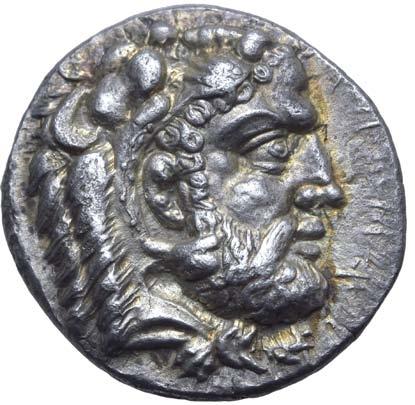

Ex Long Valley River Collection, Roma Numismatics Ltd., Auction XX, 29 October 2020, lot 274. Acquired from Cabinet Numismatique Maison Palombo SA.
9,000
Coinage commenced in Cyprus around 525 BC, with the city of Salamis minting a primitive currency which from its earliest days featured the type of a ram lying down on its obverse. This design would remain common on the coinage of Salamis, no doubt implying that the region’s economy was heavily reliant on goat herding. Interestingly, in these early days the reverse was blank and flat, without even a punch mark. In this respect the coins of Salamis differ significantly from those of Greece or Asia Minor.

Evagoras I, the greatest king of Salamis, claimed descent from Teukros son of Telamon and half-brother of Ajax. Having failed to avenge his brother’s death, Teukros was thus prevented from returning home from the Trojan war and supposedly settled in Salamis, becoming the mythical founder of the city. Evagoras was born under the rule of the Phoenician usurpers, and according to Isokrates, was so possessed of “beauty... strength... manly courage, wisdom and justice” that “one of the princes, starting a conspiracy, slew the tyrant and attempted to arrest Evagoras, believing that he would not be able to retain the rule himself unless he should get him out of the way.” First escaping to Soloi in Cilicia, then returning with a picked band of fifty men, Evagoras attacked the palace by night and established himself as ruler of the city
The king produced a substantial issue of coinage in support of Athens and to further his ambitions for the domination of Cyprus. Indeed, with Athenian aid Evagoras succeeded in extending his rule over the greater part of the island, and even conquered several cities in Phoenicia, including Tyre. Yet when Athenian support was withdrawn under the terms of the Peace of Antalkidas, Evagoras continued to fight alone against the Persian Empire, which resulted in an invasion of the island that effectively reduced him to the status of a vassal king. In 374 he was assassinated by a eunuch for motives of private revenge, and was succeeded by his son, Nikokles.
The inscription on the reverse of this coin is written in a combination of Cypriot syllabic and Greek characters. Although Cypriots were Greeks and their language a dialect of Greek, their written language was recorded in an older and more difficult system, the Cypriot syllabary, which was ultimately derived from the Linear A script of the Minoans. Evagoras has been called a pioneer of the adoption of the Greek alphabet in Cyprus in place of the older Cypriot syllabary.

124
340.
CYPRUS
341.
Phoenicia, Byblos AR Shekel. Ozbaal (Uzzibaal). Circa 400-376 BC. Galley, with prow terminating in lion’s head, on waves to left, carrying three hoplites, each holding shield; below, `Z (in Phoenician script) and hippocamp to left, above murex shell / Lion attacking bull to left; ‘ZB’L MLK GBL (in Phoenician script) above. E&E-B Group IV.2.1.c, 403-471 (O12/R?); SNG Copenhagen 132; HGC 10, 133. 13.32g, 26mm, 2h.


Near Mint State.
Ex Numismatica Ars Classica, Auction 114, 6 May 2019, lot 1216.
KYRENAIKA
1,500
Kyrenaika, Kyrene AR Didrachm. Temp. Magas, circa 294-275 BC. Horned head of Zeus Karneios to left / Silphion plant; two stars across upper fields, KY-PA across lower fields. BMC 237; SNG Copenhagen 1237. 7.63g, 20mm, 12h.

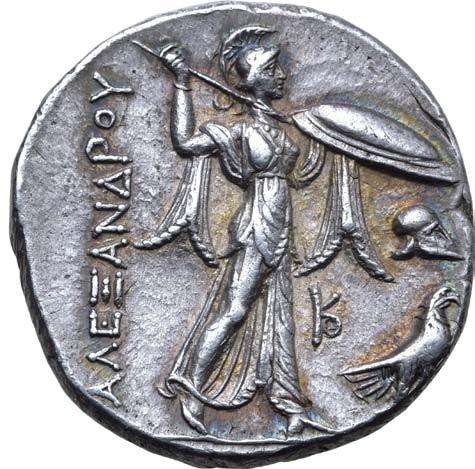

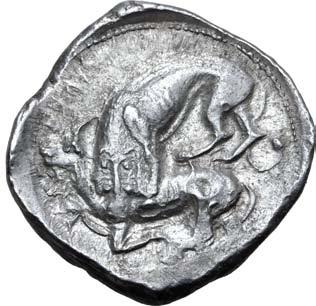

Near Extremely Fine; light cabinet tone.
Acquired from Classical Numismatic Group.
Ptolemaic Kingdom of Egypt, Ptolemy I Soter, as satrap or king, AR Tetradrachm. In the name of Alexander III of Macedon. Alexandria, circa 306300 BC. Diademed head of the deified Alexander to right, wearing elephant skin headdress; tiny Δ on aegis / Athena Alkidemos advancing to right, brandishing spear and holding shield; AΛEΞANΔPOY in left field, helmet, monogram and eagle on thunderbolt in right field. CPE 70; Svoronos 164; Zervos Issue 29. 15.68g, 26mm, 12h.


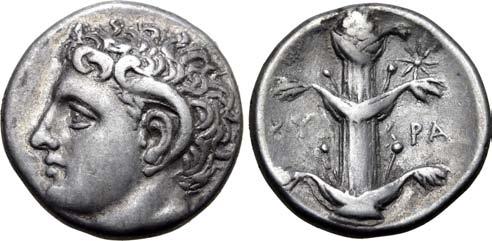

Extremely Fine; beautiful iridescence around devices.
Acquired from Leu Numismatik AG, there erroneously attributed to Gorny & Mosch sale 138.
2,550
125
PHOENICIA
342. 900
343.
EGYPT
344.
Ptolemaic Kingdom of Egypt, Ptolemy I Soter, as satrap or king, AR Tetradrachm. In the name of Alexander III of Macedon. Alexandria, circa 306300 BC. Diademed head of the deified Alexander to right, wearing elephant skin headdress; tiny Δ on aegis / Athena Alkidemos advancing to right, brandishing spear and holding shield; AΛEΞANΔPOY in left field, helmet, monogram and eagle on thunderbolt in right field. CPE 72; Svoronos 169; Zervos Issue 31; SNG Copenhagen 30; BMC 26. 15.80g, 27mm, 12h.
Good Extremely Fine.
Acquired from Noonan’s.
900
345.
Ptolemaic Kingdom of Egypt, Ptolemy I Soter AR Tetradrachm. Alexandria, circa 305-282 BC. Diademed head to right; Δ behind ear / ΠΤΟΛEΜΑΙOΥ BAΣΙΛEΩΣ, eagle with closed wings standing to left on thunderbolt; P above monogram to left. CPE 168; Svoronos 255; SNG Copenhagen 70. 14.20g, 28mm, 12h.





Near Mint State; planchet flaw to rev.; edge previously repaired; well detailed with hints of golden iridescence.
Ex Fritz Rudolf Künker GmbH & Co. 347 KG, Auction 347, 22 March 2021, lot 7; Reportedly acquired in March 1986.
1,050
346. 600
Ptolemaic Kingdom of Egypt, Ptolemy II Philadelphos AR Tetradrachm. Sidon, circa 274 BC. Diademed head of Ptolemy I to right, wearing aegis / ΠTOΛEMAIOY BAΣIΛEΩΣ, eagle with closed wings standing to left on thunderbolt; ΣΙ to left. CPE 505a; Svoronos 713; SNG Copenhagen 506-7. 14.10g, 27mm, 12h.






Good Extremely Fine.
Ex Historical Scholar Collection.
126

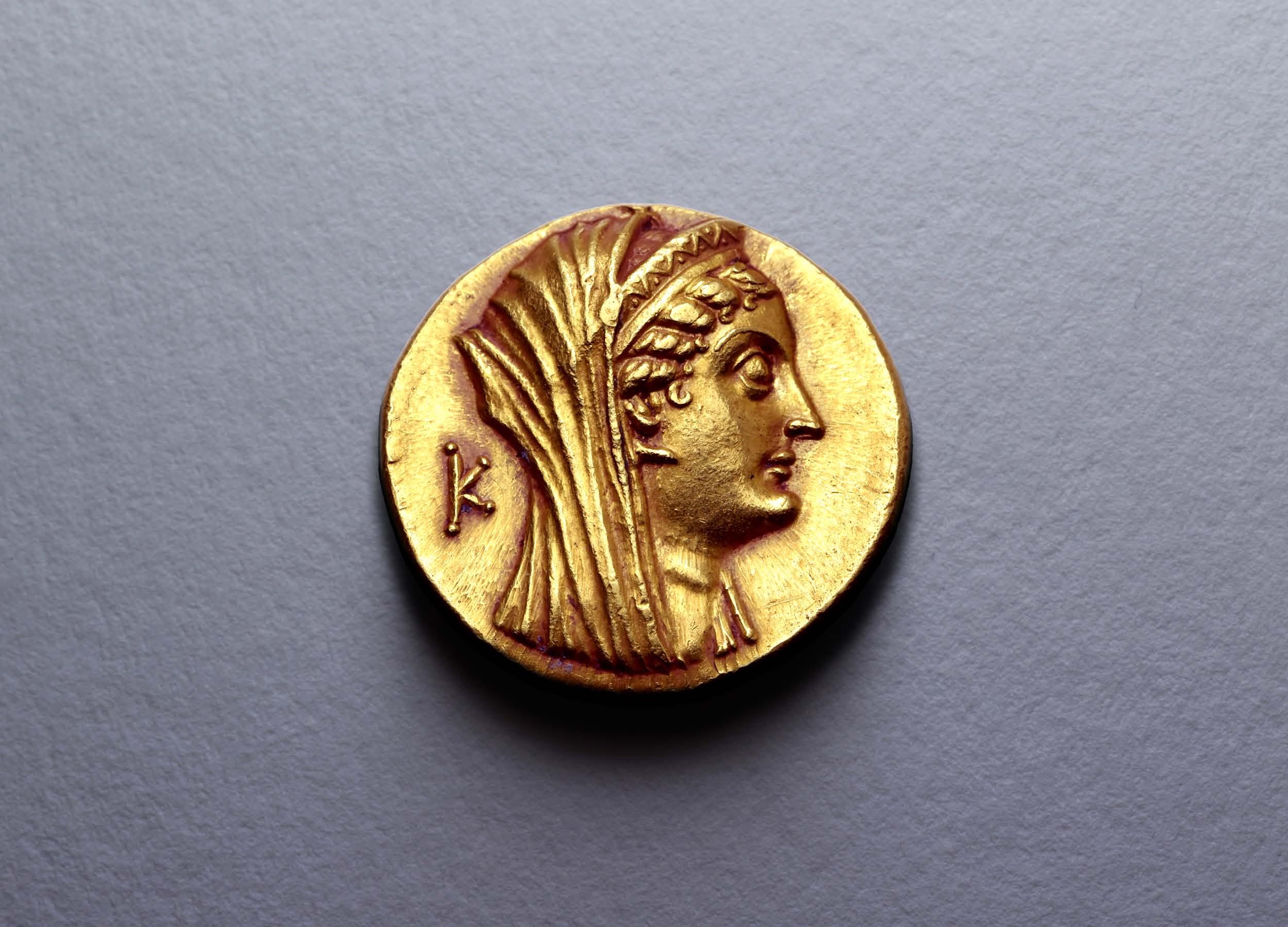

128
Ptolemaic Kingdom of Egypt, Arsinoe II (wife of Ptolemy II) AV Mnaieon (Oktadrachm). Struck under Ptolemy VI-VIII. Alexandria, circa 180-116 BC. Veiled head to right, wearing stephane; lotus-tipped sceptre in background, K to left / Double cornucopiae, grape bunches hanging at sides, bound with fillet; APΣINOHΣ ΦIΛAΔEΛΦOY around. Svoronos 1498-9; SNG Copenhagen 322; Troxell p. 67, 8.
NGC graded Ch AU 5/5 - 2/5, brushed (#6674413-002).
Acquired from Morton & Eden.
19,500
The daughter of Ptolemy I and his wife Berenike, Arsinoe II was born in 316 BC in the nascent Ptolemaic kingdom of Egypt. After a swift political marriage to Lysimachos of Thrace at the age of fifteen, she was married again to Ptolemy Keraunos, her half-brother, but fled Macedon immediately after the wedding to the protection of Egypt, which had passed to her younger brother Ptolemy II. The two gained the epithet ‘Philadelphoi’ or ‘siblinglover’ after they married in 273-272 BC: the practice of sibling marriage was traditional for Egyptian pharaohs, but was known only to the Greeks in deities such as Zeus and Hera. However, their marriage provided a model which was followed by most subsequent Ptolemaic monarchs, and its divine connotations only advanced their power. The image of Arsinoe here portrays a beautiful and serene queen, with considerable attention devoted to her curled hairstyle and the drape of her veil, while her usual attributes of cornucopiae associate her with peace and prosperity
She was considered a capable co-ruler who directed Egypt’s foreign affairs, and her death prompted a great outpouring of gold coinage to mark her full deification, emphasised in this portrait by a glimpse of a ram’s horn emerging from her veil, reminiscent of the horn of Ammon on images of the deified Alexander the Great.



Ptolemaic Kingdom of Egypt, Ptolemy VI Philometor AR Tetradrachm. Second sole reign. Alexandria, circa 163-145 BC. Diademed head to right, aegis around neck / BAΣIΛEΩΣ ΠTOΛEMAIOY, eagle standing to left on thunderbolt; no control marks. Svoronos 1489; SNG Copenhagen 262-8. 14.12g, 28mm, 12h. Good Extremely Fine. Ex Historical Scholar Collection.


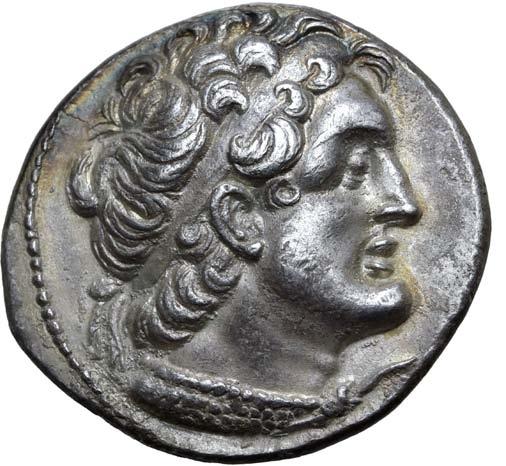
129 A Mint State Mnaieion
347.
750 348.
349.
Kingdom of Axum, Eon (Noe) AV Unit. Circa AD 410-450. ⧾ CIN ⧾ CΛX ⧾ ΛCΛ ⧾ CAC (partially retrograde - interpretation uncertain - “King of the land of the Abyssinians” [much abbreviated]?), crowned and draped bust to right, holding stick, flanked by wheat stalks; all within circular border / ⧾ ЄѠN ⧾ CIC ⧾ IΛN ⧾ ΛΛΦ (partially retrograde - “Eon man of Anaaf”), draped bust to right, wearing headcloth, flanked by wheat stalks; all within circular border. Hahn & Keck 38.99 (same legend variant); SACAM 223; H 28a; AC 59-60; Vaccaro 39. 1.58g, 17mm, 12h.

Extremely Fine. Very Rare.
600
350.
Kingdom of Axum, Ebana AV Unit. Circa AD 460-480. ⧾ CIN ⧾ CΛX ⧾ ΛCΛ ⧾ CAC (partially retrograde - interpretation uncertain - “King of the land of the Abyssinians” [much abbreviated]?), crowned bust to right, holding stick, grain ears flanking; Ge’ez letter ‘z’ above crown, within circular border / ⧾ ΛNΛ ⧾ BAC ⧾ ΛCΛ + ECB (partially retrograde - “King Ebana”), draped bust to right, wearing headcloth, holding fly-whisk, grain ears flanking; within circular border. Hahn & Keck 43; SACAM 262; H 34; AC 71-3. 1.34g, 16mm, 12h.
Extremely Fine.
300
Kingdom of Axum, Ousas (Ousanas II) AV Unit. Circa AD 500-510. ⧾ OVCAC BACIΛЄVC (“King Ousas”), crowned and draped bust to right, holding rod, flanked by wheat stalks; Ge’ez letter ‘r’ behind and ‘d’ before; all within circular border / ⧾ ΘЄOVЄV XAPICTIA (“thanks be to God”), draped bust to right, wearing headcloth, holding fly whisk, flanked by wheat stalks; within circular border. Hahn & Keck 60; SACAM 339 (same obv. die); H 37a; AC 85. 1.63g, 17mm, 12h.




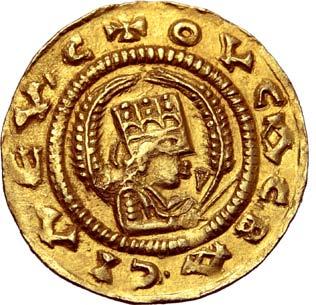
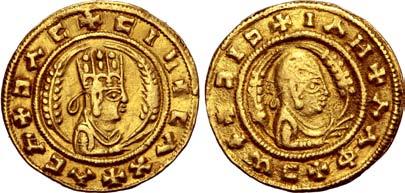


Extremely Fine.
PERSIA
Persia, Achaemenid Empire AV Daric. Time of Xerxes II to Artaxerxes II. Sardes, circa 420-375 BC. Persian Great King or hero, wearing kidaris and kandys, in kneeling-running stance to right on exergual line, holding apple-tipped spear and strung bow; quiver over shoulder / Rectangular incuse punch. Carradice Type IIIb, Group C (pl. XIV, 42); Meadows, Administration 323; BMC Arabia pl. XXIV, 12; Sunrise 28; GRPC Lydia G67-8. 8.34g, 16mm.
Near Extremely Fine. 1,200
Persia, Achaemenid Empire AV Daric. Time of Xerxes II to Artaxerxes II. Sardes, circa 420-375 BC. Persian Great King or hero, wearing kidaris and kandys, in kneeling-running stance to right on exergual line, holding apple-tipped spear and strung bow; quiver over shoulder / Rectangular incuse punch. Carradice Type IIIb, Group C (pl. XIV, 42); Meadows, Administration 323; BMC Arabia pl. XXIV, 12; Sunrise 28; GRPC Lydia G67-8. 8.37g, 14mm.





Near Extremely Fine. 1,200

130 AXUM
Very Rare
300
351.
352.
353.
354.
Persia, Achaemenid Empire AV Daric. Time of Xerxes II to Artaxerxes II. Sardes, circa 420-375 BC. Persian Great King or hero, wearing kidaris and kandys, in kneeling-running stance to right on exergual line, holding apple-tipped spear and strung bow; quiver over shoulder / Rectangular incuse punch. Carradice Type IIIb, Group C (pl. XIV, 42); Meadows, Administration 323; BMC Arabia pl. XXIV, 12; Sunrise 28; GRPC Lydia G67-8. 8.26g, 16mm.

Near Extremely Fine.
SELEUKID EMPIRE
1,200
Seleukid Empire, Seleukos I Nikator AR Tetradrachm. In the types of Alexander III of Macedon. Seleukia in Pieria, circa 300-281 BC. Head of Herakles to right, wearing lion skin headdress / Zeus Nikephoros seated to left, holding sceptre; monogram within circle in left field, KP below throne, ΣEΛEYKOY to right, [B]AΣIΛEΩΣ in exergue. SC 29.1b; WSM 890; HGC 9, 16d. 17.16g, 27mm, 2h.

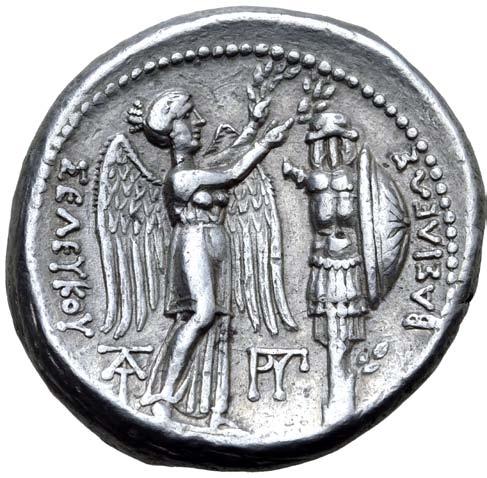

Extremely Fine. 600
Seleukos I Victorious
Seleukid Empire, Seleukos I Nikator AR Tetradrachm. Susa, circa 305-295 BC. Head to right, wearing helmet covered with panther skin and adorned with bull’s ears and horns; panther skin tied around neck / Nike standing to right, wearing peplos, crowning trophy of Macedonian arms set on sapling tree, from which branch sprouts near base; ΒΑΣΙΛΕΩΣ ΣΕΛΕΥΚΟΥ around, monogram to lower left and in lower central field. SC 173.4; ESM 426; HGC 9, 20. 17.05g, 27mm, 11h.




Extremely Fine.
Ex Roma Numismatics Ltd., Auction XXV, 22 September 2022, lot 499.
4,500
The trophy series of Seleukos was issued over an extended period, and used 67 obverse dies and at least 93 reverses that we are aware of. The type is generally assumed to commemorate the victories of Seleukos as he pushed eastwards into India, occupying territory as far as the Indus, and eventually waging war against the Mauryan Empire. This campaign against Chandragupta Maurya was however a failure. While there is no record of what transpired to prevent Seleukos achieving his aims, the two leaders eventually reached an accord whereby Seleukos ceded some of his easternmost territory in exchange for a gift of 500 war elephants. The massive beasts were to play a significant role in the coming wars of the Diadochi, in particular at the Battle of Ipsos in 301 BC.
The assertion that the trophy reverse commemorates a victory by Seleukos in the east or in the Upper Satrapies, and his subsequent assumption of a the royal title in 305/4 BC is problematic. The dating of the issue was proposed by Kritt (The Early Seleukid Mint of Susa, 1997) and subsequently accepted by the numismatic community seemingly without question. Moreover, the important detail of the trophy’s composition is ignored. The trophy is unquestionably built from Macedonian arms, as evidenced by the Vergina Sun (or Argead Star) clearly emblazoned on the shield. That this should therefore represent an eastern victory is impossible, particularly given the inconclusive nature of Seleukos’ campaign against Chandragupta, and its stale conclusion. The issue bears far more significance when viewed in the context of a victory over other Macedonians - for which we should look to the battle of Ipsos, in which Seleukos’ elephants played a decisive role in the victory over Antigonos.


131
355.
356.
359.
Ex Frank Sternberg, 1992
360.
Seleukid Empire, Antiochos I Soter AR Tetradrachm. Seleukeia on the Tigris, circa 281-261 BC. Diademed head to right / Apollo Delphios seated to left on omphalos, testing arrow and resting left hand on grounded bow; ΒΑΣΙΛΕΩΣ to right, ΑΝΤΙΟΧΟΥ to left, AP monogram to outer left, HP monogram to outer right. SC 379.3a; ESM 149; HGC 9, 128g. 17.20g, 29mm, 9h.




Good Very Fine; struck in high relief, attractive light cabinet tone with golden iridescent highlights.
Ex Dr. G.W. Collection, Schweizerische Kreditanstalt (Crédit Suisse), List 59, Spring 1993, no. 90; Ex Frank Sternberg AG, Auction 26, 16 November 1992, lot 114.
2,100
Seleukid Empire, Antiochos I Soter AR Drachm. Aï Khanoum, circa 280-271 BC. Diademed head to right / Horned and bridled horse’s head to right; ΒΑΣΙΛΕΩΣ behind, [ΑΝ]ΤΙΟΧΟΥ below; Δ within circle before. SC 432.2; SMAK A1DH, 27 (A14/P16); HGC 9, 136. 3.79g, 16mm, 6h.



Good Very Fine.
Acquired from Pars Coins, San Jose CA.
300
Seleukid Empire, Antiochos II Theos AR Tetradrachm. Seleukeia on the Tigris, 261-246 BC. Diademed head of Antiochos I to right / Apollo Delphios seated to left on omphalos, testing arrow and resting left hand on grounded bow; ΒΑΣΙΛΕΩΣ to right, ΑΝΤΙΟΧΟΥ to left, monograms to outer left and right. SC 587.2; ESM 186; HGC 9, 236g. 17.07g, 30mm, 2h.
Extremely Fine; a striking portrait.
Ex Roma Numismatics Ltd., E-Sale 98, 16 June 2022, lot 545.
600
Seleukid Empire, Seleukos II Kallinikos AR Tetradrachm. Antioch on the Orontes, circa 246-225 BC. Diademed head to right / Apollo standing to left, testing arrow and leaning on tall tripod; BAΣIΛEΩΣ to right, ΣEΛEYKOY to left, monograms to inner left and outer right. SC 689.1a; HGC 9, 303p. 17.06g, 34mm, 11h.


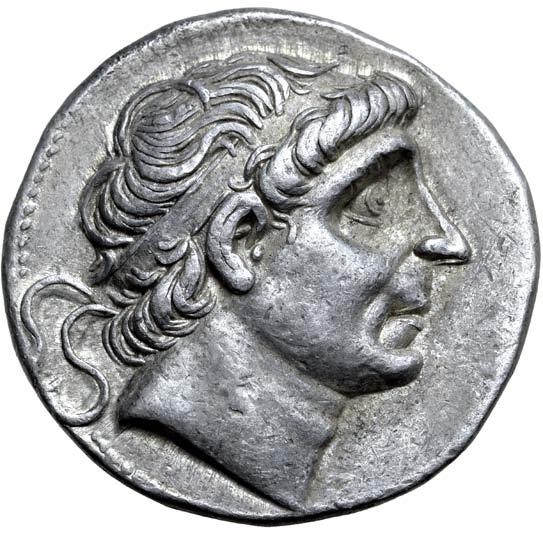


Good Extremely Fine; minor die shift to reverse; struck on a sizable planchet.
Acquired from Leu Numismatik.
900
132
357.
358.
361.
Seleukid Empire, Seleukos II Kallinikos AR Tetradrachm. Antioch on the Orontes, circa 244-226 BC. Diademed head to right / Apollo standing to left, testing arrow and leaning on tall tripod; BAΣIΛEΩΣ to right, ΣEΛEYKOY to left, KE monogram to inner left. SC 689.4; WSM 996; HGC 9, 303p. 17.10g, 30mm, 12h.







Good Extremely Fine.
Acquired from Leu Numismatik AG.
900
362.
Seleukid Empire, Antiochos III ‘the Great’ AR Drachm. Apameia on the Orontes(?), circa 222-187 BC. Diademed head to right / Elephant standing to right; monogram to right, ΒΑΣΙΛΕΩΣ above, ΑΝΤΙΟΧΟΥ in exergue. SC 1065.6; Houghton, Elephants, Type C; HGC 9, 453a. 4.14g, 18mm, 12h.


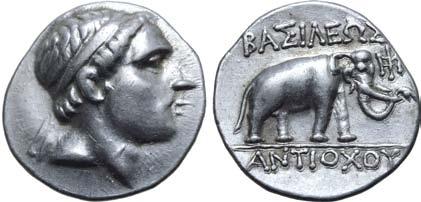

Good Extremely Fine.
Acquired from Bucephalus Numismatic.
Seleukid Empire, Antiochos III ‘the Great’ AR Drachm. Uncertain mint, circa 222-187 BC. Diademed head to right / Elephant standing to right;
above, ΑΝΤΙΟΧΟΥ in exergue. SC 1068; Houghton, Elephants, -; HGC 9, 453b. 4.27g, 18mm, 1h.
Near Mint State. Very Rare.
300
300
600 364.
Seleukid Empire, Demetrios I Soter AR Tetradrachm. Susa, 162-150 BC. Diademed head to right / Apollo Delphios seated to left on omphalos, testing arrow, and resting left hand on grounded bow; BAΣIΛEΩΣ to right, ΔHMHTPIOY to left, monograms in outer right field and exergue. SC 1711.1; CSE 1967 = Leu 6, 274 (same dies, hammer: 2,400 CHF); HGC 9, 790c. 16.80g, 28mm, 10h.


Extremely Fine. Very Rare; seemingly only one example on CoinArchives and three in the SCO database.
Ex Roma Numismatics Ltd., Auction XXV, 22 September 2022, lot 511.
133
ΒΑΣΙΛΕΩΣ
Acquired from Bucephalus Numismatic. 363.
Very Rare
365.
Seleukid Empire, Demetrios II Nikator AR Tetradrachm. Second reign. Tyre, dated SE 185 = 128/7 BC. Diademed and draped bust to right / BAΣIΛEΩΣ ΔHMHTPIOY, eagle standing to left on prow, with palm frond over shoulder; club surmounted by monogram of Tyre in left field, monogram above, monogram in right field above EΠP (date), monogram between legs. SC 2195.3b; DCA 230; HGC 9, 1122. 14.05g, 29mm, 12h.












Near Extremely Fine; lustrous and lightly toned.
Ex Leu Numismatik AG, Web Auction 12, 30 May 2020, lot 613.
600
Seleukid Empire, Antiochos VII Euergetes (Sidetes) AR Tetradrachm. Tyre, dated SE 177 = 136/5 BC. Diademed and draped bust to right / BAΣIΛEΩΣ ANTIOXOY, eagle standing to left on prow, with palm branch over shoulder; club surmounted by monogram of Tyre in left field, APE monogram above, ZOP (date) to right, monogram between legs. SC 2109.5a; DCA 198; HGC 9, 1074. 14.07g, 30mm, 1h.
Good Extremely Fine; lustrous.
Acquired from Leu Numismatik AG.
Seleukid Empire, Antiochos VII Euergetes (Sidetes) AR Tetradrachm. Tyre, dated SE 181 = 132/1 BC. Diademed and draped bust to right / BAΣIΛEΩΣ ANTIOXOY, eagle standing to left on prow, with palm branch over shoulder; club surmounted by monogram of Tyre in left field, APE monogram above, monogram in right field above AΠP (date), M between legs. SC 2109.9a; SNG Spaer 2084; DCA 198; HGC 9, 1074. 13.99g, 29mm, 1h.
Good Extremely Fine; well-centered and attractive portrait.
Acquired from Leu Numismatik AG.
134
450 366.
450 367.
369.
Seleukid Empire, Antiochos VII Euergetes (Sidetes) AR Tetradrachm. Tyre, dated SE 177 = 136/5 BC. Diademed and draped bust to right / BAΣIΛEΩΣ ANTIOXOY, eagle standing to left on prow, with palm branch over shoulder; club surmounted by monogram of Tyre in left field, APE monogram above, ZOP (date) to right, monogram between legs. SC 2109.5a; DCA 198; HGC 9, 1074. 14.15g, 30mm, 12h.




Good Extremely Fine.
Acquired from Leu Numismatik AG.
370.
Seleukid Empire, Kleopatra Thea and Antiochos VIII AR Tetradrachm. Antioch on the Orontes, circa 122-121 BC. Jugate busts of Kleopatra Thea, draped and wearing diadem and stephane, and Antiochos VIII wearing diadem, to right / Zeus Nikephoros seated to left, holding sceptre; [ΒΑΣΙΛΙ]
KΛΕΟΠΑΤΡΑΣ to right, KAI ΒΑΣΙΛΕΩΣ ANTIOXOY to left, IE to outer left, A below throne. SC 2262.1d; SMA 359; HGC 9, 1182c. 16.67g, 28mm, 12h.
Extremely Fine.
Ex Historical Scholar Collection; Ex Roma Numismatics Ltd., Auction VIII, 28 March 2014, lot 716.
1,500
Seleukid Empire, Kleopatra Thea and Antiochos VIII AR Tetradrachm. Antioch on the Orontes, circa 122-121 BC. Jugate busts of Kleopatra Thea, draped and wearing diadem and stephane, and Antiochos VIII wearing diadem, to right / Zeus Nikephoros seated to left, holding sceptre; ΒΑΣΙΛΙΣΣΗΣ
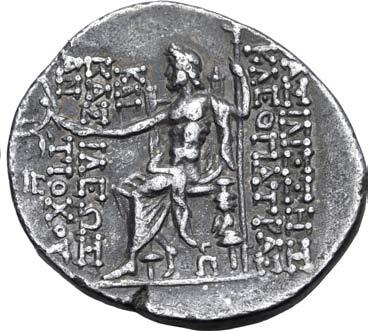






to right, KAI ΒΑΣΙΛΕΩΣ ΑΝΤΙΟXΟY to left, IE to outer left, C over Π below throne. SC 2262.1a; HGC 9, 1182c. 16.02g, 30mm, 12h.
Near Extremely Fine; attractive light cabinet tone.
Ex Roma Numismatics Ltd., Auction XXV, 22 September 2022, lot 518.
900
135
450
368.
ΣΣΗΣ
ΚΛΕΟΠΑΤΡΑΣ
Kings of Charakene(?), Hippokrates Autokrator Nikephoros (usurper?) AR Tetradrachm. Uncertain mint, dated SE 232 = 81/8 BC. Diademed head to right / Zeus seated to left on throne, holding sceptre and tied diadem, [BAΣI]ΛEΩ[Σ] [IΠ]ΠOKPATOPOY to right, [AY]TOKPATOPOΣ [NI] KHΦOPOY to left, monogram(?) to upper left; BΛΣ (date) in exergue. G. R.F. Assar, ‘A New Hellenistic Ruler from Early 1st century BC: King Hippokrates Autokrator Nikephoros’ (2020), p. 339, fig. 1 (this coin); otherwise unpublished.
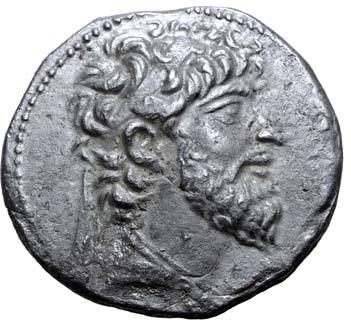

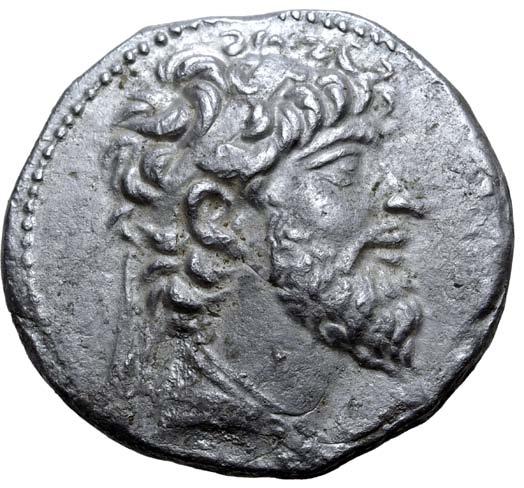
Near Extremely Fine. Unique and of great numismatic importance.
4,500
This coin published in G.R.F. Assar, A New Hellenistic Ruler from Early 1st century BC: King Hippokrates Autokrator Nikephoros in Andreas Pangerl (ed.), 400 years of Hellenistic Portraits (Munich, 2020);
From the collection of Dr. Gholam Reza Assar.
Unique and of Great Numismatic Importance CHARAKENE PARTHIA
The king referred to on this coin is known to history only through the numismatic evidence of this tetradrachm and the under type of a tetradrachm of Kamnaskires III (see Roma XXIII, lot 394). The identity of King Hippokrates is hard to establish and is discussed at length in Assar’s article based on this coin. The most compelling argument is that Hippokrates was a Charakenean usurper, based on the break in Charakenean coinage from 88/87 to 79/78 BC, a period which this coin sits within. Assar argues that his Greek name does not determine his origins or the location of his rule. This fascinating piece opens the door to a new and as yet little researched area of history and numismatics and is therefore of great significance.
Parthia, Andragoras AR Tetradrachm. Hekatompylos(?), circa 246-238 BC. Attic standard. Turreted head of Tyche to right, wearing pendant earring and necklace; monogram of Andragoras behind / Athena standing to left, wearing helmet, long chiton and himation, holding owl on extended right hand and resting left hand on grounded shield, transverse spear in background; ANΔPAΓOPOY to right. Roma XIV, 326; Mitchiner 20; BMC 3-4, pl. xxviii, 2-3. 16.81g, 25mm, 6h.





Good Extremely Fine. Extremely Rare.
From the 1960s Andragoras-Sophytes Group, present in Germany in 1975, subsequently exported to the USA.
1,500
Baktria, uncertain mint AR Obol. Circa late 4th-early 3rd century BC. Turreted head of Kybele or Tyche to right / Eagle standing to left, head to right, wings displayed. Roma E-Sale 103, 605; Roma E-Sale 89, 635; Roma E-Sale 78, 677; Roma E-Sale 63, 362; CNG 66, 928. 0.56g, 8mm, 5h.


Good Extremely Fine; possibly the finest example of the type to come to auction in the last 20 years. Very Rare.
300
The appearance of Kybele/Tyche on this coin attributed to Baktria can be explained by considering the influence of Alexander the Great and the accompanying soldiers and citizens who travelled with him on his eastern campaigns had on the cities they then populated there. Many of these people came from Asia Minor where cities such as Mytilene in Lesbos, Plakia in Mysia, and Nagidos in Cilicia were minting coins with similar Kybele/Tyche types. The depiction of the eagle is far more familiar to Baktria, being consistent with types such as the coins of Sophytes.
136
371.
372.
373. 2x 2x
BAKTRIA
Possibly the Finest Example in the Last 20 Years



138
An Issue of Considerable Numismatic Interest
Baktria, Sophytes AR Tetradrachm. Uncertain mint in the Oxus region, circa 246-235 BC. Attic standard. Head of Seleukos(?) to right, wearing laurel wreathed Attic helmet decorated with spiral pattern on crest and eagle wings on cheek-guard, tied under chin; M on bust truncation / Cockerel standing to right; kerykeion behind, ΣΩΦYΤΟΥ to right. Cf. Bopearachchi, Sophytes Series 3A, pl. I, 1; for type cf. SNG ANS 21-23 (drachm); Mitchiner 29 (drachm); Whitehead NC 1943, p. 64, 1 and pl. III, 7-8 (drachm); Roma XXIII, 409 (same dies, hammer: 36,000 GBP). 17.04g, 28mm, 6h.



Good Extremely Fine; a bold and expressive portrait with a beautiful old cabinet tone. Extremely Rare; an issue of considerable numismatic interest.
From the 1960s Andragoras-Sophytes Group, present in Germany in 1975, subsequently exported to the USA.
This portrait, which has all too often been simply assumed to be that of Sophytes himself, is eminently worthy of further scrutiny. It is the work of a highly talented individual, and depicts what should by any account be a great general, helmeted in Attic style and wearing the laurel wreath of a conqueror. Unfortunately the actions of Sophytes, whatever they might have been, were either not recorded or have long since been lost. We cannot therefore determine whether this individual may indeed have performed such deeds as to be worthy of commemoration in such a fashion. In examining the features of the individual depicted on this coin however, it becomes immediately apparent that there are distinct similarities with certain idealised portraits of Seleukos I. It is conceivable that we should see in this portrait not an image of the unknown ruler Sophytes, but an idealised image of the deified Seleukos, as can be found on the somewhat earlier coinage of Philetairos. Those images (cf. in particular Gulbenkian 966) have nearly identical features - in particular the heavy brow, aquiline nose, down-turned mouth and prominent chin.
The historical sources offer us few clues as to the dating of Sophytes’ rule. They tell us that Stasanor was satrap of Baktria until at least 316 BC, and that Seleukos reintegrated Baktria into his empire on his eastern anabasis in c. 305. An early date therefore seems highly unlikely. Turning to the evidence of the coin itself, numismatists have correctly observed that the obverse portrait is derived from the similar type of Seleukos on his trophy tetradrachms (SC 174), which should be dated to after c. 301 BC; the presence of the somewhat worn elephant-quadriga tetradrachm in the present group pushes the date even further to the right, and into the third century. Now, the presence of this type in this group along with coins of Andragoras indicates a considerably later date than previously supposed. We have already proposed with good reason that the coinage of Andragoras should be dated to c.246/5-239/8 BC and that given the patterns of wear that may be observed upon them, there is sufficient justification to argue for the dating of Sophytes’ named coinage to c. 246/5-235, after Andragoras had begun coining but before Diodotos II would have been free to dispose of any lesser regional powers. This turbulent time period has already afforded us a plausible reason for the striking of Andragoras’ coinage. It is possible that Sophytes too was prompted to look to the security of his own territory following the effective withdrawal of the central government’s influence in that area. Diodotos I too struck his own coinage in Baktria, which while bearing his own portrait on the obverse nevertheless maintained the name ‘Antiochos’ on the reverse as a token symbol of loyalty. Does Sophytes coinage, with a distinctly ‘local’ reverse type, seek to achieve the same veneer of loyalty as that of Philetairos and Diodotos by placing the image of Seleukos I, the founder of the Seleukid empire, on his obverse?
139
374.
15,000
GRECO-BAKTRIAN KINGDOM
Greco-Baktrian Kingdom, Euthydemos I Theos Megas AR Tetradrachm. Mint A (near Aï Khanoum), circa 225-215 BC. Diademed head to right / Herakles seated to left on rock, holding club set on rocks; BAΣIΛEΩΣ and monogram to right, EYΘYΔHMOY to left. Glenn Group I, 10 (O1/R10); Kritt A1; Mitchiner 85c; Bopearachchi 5B; SNG ANS 124-7; HGC 12, -. 16.45g, 27mm, 12h.







Good Very Fine.
Greco-Baktrian Kingdom, Euthydemos I Theos Megas AR Tetradrachm. Mint B (“Baktra”), circa 215-210 BC. Diademed head to right / Herakles seated to left on lion skin draped over rocks, holding club set on right leg; BAΣIΛEΩΣ and monogram to right, EYΘYΔHMOY to left. Glenn Group IV, 365 (O100/R245); Kritt B13; Bopearachchi 9A; SNG ANS 136; HGC 12, 42. 16.61g, 30mm, 12h.
Good Extremely Fine; a fine style portrait.
Greco-Baktrian Kingdom, Euthydemos I Theos Megas AR Tetradrachm. Mint B (“Baktra”), circa 215-210 BC. Diademed head to right / Herakles seated to left on lion skin draped over rocks, holding club set on right leg; BAΣIΛEΩΣ and monogram to right, EYΘYΔHMOY to left. Glenn Group IV (O94/R- [unlisted rev. die]); Kritt B13; Bopearachchi 9A; SNG ANS 136; HGC 12, 42. 16.36g, 30mm, 11h.

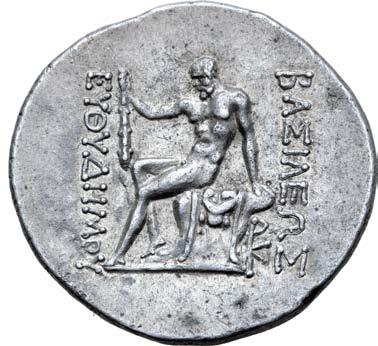


Good Extremely Fine; minor planchet flaws, attractive cabinet tone.
Ex JTB Numismatic Collection (collector’s ticket included); Ex Lampasas Collection, Classical Numismatic Group, Electronic Sale 484, 27 January 2021, lot 471; Ex Peter K. Tompa Collection, Classical Numismatic Group, Auction 112, 11 September 2019, lot 396; Acquired from Frank Kovacs, 19 November 2004.
1,950
140
375.
600
376. 2,400
377.
378.
Greco-Baktrian Kingdom, Euthydemos I Theos Megas AR Tetradrachm. Mint B (“Baktra”), circa 210-206 BC. Diademed head to right / Herakles seated to left on lion skin draped over rocks, holding club set on right leg; BAΣIΛEΩΣ and monogram to right, EYΘYΔHMOY to left. Glenn, Group V (O125/R- [unlisted rev. die]); Kritt B14; Bopearachchi 10A; SNG ANS 137-8; HGC 12, 42. 16.86g, 31mm, 12h.
Extremely Fine.
1,500
379.
Greco-Baktrian Kingdom, Euthydemos I Theos Megas AR Tetradrachm. Mint B (“Baktra”), circa 206-200 BC. Diademed head to right / Herakles seated to left on lion skin draped over rocks, holding club set on right leg; BAΣIΛEΩΣ and monogram to right, EYΘYΔHMOY to left. Glenn, Group VII, cf. 611 (unlisted dies); Kritt B17; Bopearachchi 12A; SNG ANS 141-2; HGC 12, 43. 16.61g, 30mm, 12h.












Near Mint State.
2,100
Greco-Baktrian Kingdom, Demetrios I Aniketos AR Tetradrachm. Mint A, circa 200-185 BC. Diademed and draped bust to right, wearing elephant skin headdress / Herakles standing facing, crowning himself with right hand, holding club and lion’s skin in left; BAΣIΛEΩΣ to right, ΔHMHTPIOY to left, monogram to inner left. Glenn, Group I, 11 (O3/R8); Bopearachchi 1B; Mitchiner 103b; SNG ANS 186; HGC 12, 63. 17.05g, 32mm, 12h.
Near Extremely Fine; attractive old cabinet tone. Rare with this monogram.
900
141
380.
In an Excellent State of Preservation
Greco-Baktrian Kingdom, Demetrios I Aniketos AR Tetradrachm. Mint B, circa 200-185 BC. Diademed and draped bust to right, wearing elephant skin headdress / Herakles standing facing, crowning himself with right hand, holding club and lion’s skin in left; BAΣIΛEΩΣ to right, ΔHMHTPIOY to left, monogram to inner left. Glenn, Group IIIA (O70/R160); Bopearachchi 1C; Mitchiner 103d; SNG ANS 188-9; HGC 12, 63. 16.96g, 35mm, 12h.


Fleur De Coin; sharply struck and in an excellent state of preservation, by far the finest example of the type to be auctioned in the past 20 years.
Ex Oxus Collection, Roma Numismatics Ltd., Auction XXV, 22 September 2022, lot 549.

9,000
Demetrios I Aniketos succeeded his father Euthydemos in circa 200 BC, inheriting a conflict with the Seleukid king Antiochos III. Reportedly impressed with the young prince Demetrios who conducted the treaty negotiations on behalf of his father Euthydemos, Antiochos III, “judging from his appearance, conversation and the dignity of his manners that he was worthy of royal power, first promised to give him one of his own daughters, and secondly conceded the royal title to his father”. (Polybius 11.34) Thus Demetrios I began his reign in the same vein as he maintained it, victorious, giving rise to his posthumous epithet ‘aniketos’, meaning ‘the unconquered’, since he was never defeated in battle.
It was Demetrios I who started the Greco-Baktrian invasion of northwestern India in 186 BC, conquering extensive areas of what is now southern Afghanistan, Iran, Pakistan and India. The well-known portrait of the king wearing an elephant skin headdress has been used in modern scholarship as emblematic of the Greek presence in Central Asia and India (Glenn, p.89), and evolved from the numismatic portraits of Alexander the Great wearing an elephant skin headdress commemorating his own conquest of India in the late fourth century BC.
Lorber argues that this portrait type has a longer heritage and that Alexander’s own portraits were in turn inspired by Thutmose III of Egypt, who celebrated his own Asian conquests with a legendary Syrian elephant hunt more than one thousand years previously. (Lorber, C. (2012), ‘An Egyptian Interpretation of Alexander’s Elephant Headdress’, AJN 24) Demetrios I Aniketos’ version was replicated with remarkable consistency across the silver denominations struck during his reign. Later Indo-Greek kings such as Lysias would endeavour to emulate him by adopting the epithet Aniketos and reusing the characteristic reverse type of this coin, the athletic Herakles crowning himself in a striking facing contrapposto pose.

142
381.
Greco-Baktrian Kingdom, Demetrios I Aniketos AR Tetradrachm. Mint B, circa 200-185 BC. Diademed and draped bust to right, wearing elephant skin headdress / Herakles standing facing, crowning himself with right hand, holding club and lion’s skin in left; BAΣIΛEΩΣ to right, ΔHMHTPIOY to left, monogram to inner left. Glenn, Group IIIA (O70/R159); Bopearachchi 1C; Mitchiner 103d; SNG ANS 188-9; HGC 12, 63. 16.94g, 34mm, 12h.
382. 4,500
Good Extremely Fine.
Extremely Rare
Greco-Baktrian Kingdom, Demetrios I Aniketos AR Drachm. Panjhir(?), circa 200-185 BC. Diademed and draped bust to right, wearing elephant skin headdress / Herakles standing facing, crowning himself with right hand, holding club and lion’s skin in left; BAΣIΛEΩΣ to right, ΔHMHTPIOY to left, monogram to inner left. Glenn 8 (O5/R6); Bopearachchi 2A; SNG ANS -; Mitchiner 104d; HGC 12, 64; Roma E-103, 612 (hammer: 1,700 GBP).





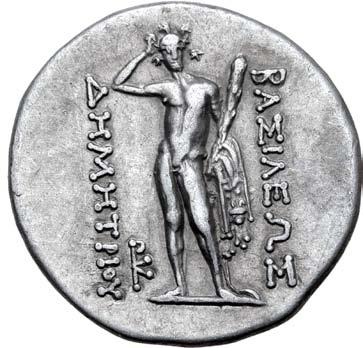
4.20g, 20mm, 12h.
383. 900
Good Very Fine; in better condition than the Roma E-103 specimen. Extremely Rare; Bopearachchi cites only two specimens, and there are only a handful on CoinArchives.
384. 600
Greco-Baktrian Kingdom, Euthydemos II AR Tetradrachm. Circa 185-180 BC. Diademed and draped bust to right / Herakles standing facing, crowned with leaves, holding wreath and carrying club and lion’s skin; BAΣIΛEΩΣ to right, EYΘYΔHMOY to left, monogram to inner left. Glenn (O23/R-); Bopearachchi 1C; Bopearachchi & Rahman 142; SNG ANS 216; HGC 12, 72. 16.88g, 33mm, 12h.





Near Extremely Fine.

143
386.
Greco-Baktrian Kingdom, Agathokles Dikaios AR Tetradrachm. Circa 185-175 BC. Diademed and draped bust to right / Zeus standing facing, holding figure of Hekate with torches in outstretched right hand, and sceptre in left; BAΣIΛEΩΣ to right, ΑΓΑΘΟΚΛΕOYΣ to left, monogram in inner left field, ΔIKAIOY in exergue. Glenn, Series II, 103 (O16/R51); Bopearachchi 3A; Bopearachchi & Rahman 150; SNG ANS 232; Mitchiner 141; HGC 12, 82. 16.91g, 32mm, 12h.


About Extremely Fine; mottled old cabinet tone, a portrait of wonderful style and appeal. Extremely Rare type with honorific title ‘Dikaios (righteous)’ in exergue.
387.
Greco-Baktrian Kingdom, Agathokles Dikaios AR Drachm. Circa 185-175 BC. Diademed and draped bust to right / Zeus standing facing, holding figure of Hekate with torches in outstretched right hand, and sceptre in left; BAΣIΛEΩΣ to right, ΑΓΑΘΟΚΛΕOYΣ to left, monogram in inner left field. Glenn - (unlisted dies); Bopearachchi 2B; Mitchiner 138a; SNG ANS -; HGC 12, 90. 4.02g, 20mm, 12h.



Extremely Fine; light cabinet tone with hints of golden iridescence. Very Rare.
300
Greco-Baktrian Kingdom, Antimachos I Theos AR Tetradrachm. Circa 180-170 BC. Diademed and draped bust to right, wearing kausia / Poseidon, laureate, standing facing, holding trident and filleted palm; BAΣIΛEΩΣ ΘEOY to right, ANTIMAXOY to left, monogram to inner right field. Glenn, Group I, 36 (O8/R22); Bopearachchi 1B; SNG ANS -; HGC 12, 106. 16.98g, 31mm, 12h.






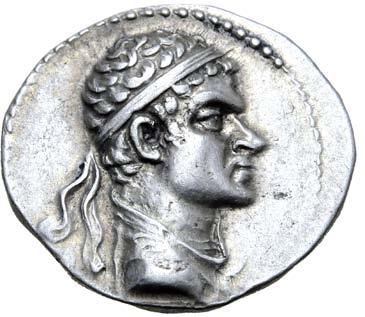
Extremely Fine.
1,200
144
385.
4,500 Extremely Rare
389.
Greco-Baktrian Kingdom, Antimachos I Theos AR Tetradrachm. Circa 180-170 BC. Diademed and draped bust to right, wearing kausia / Poseidon, laureate, standing facing, holding trident and filleted palm; BAΣIΛEΩΣ ΘEOY to right, ANTIMAXOY to left, monogram to inner right field. Glenn, Group III, 316 (‘O41a’/R133); Bopearachchi 1D; Mitchiner 124b; SNG ANS 276-7; HGC 12, 106. 16.90g, 31mm, 12h.


Good Very Fine; hints of golden iridescence around devices. Glenn’s 316 seems to have a different obv. die to 315 but they are both listed as O41 so this coin has been given a new die number of O41a.
388. 600
Greco-Baktrian Kingdom, Antimachos I Theos AR Drachm. Circa 180-170 BC. Diademed and draped bust to right, wearing kausia / Poseidon, laureate, standing facing, holding trident and filleted palm frond; BAΣIΛEΩΣ ΘEOY to right, ANTIMAXOY to left, monogram to inner right field. Glenn (O3/ R16); Bopearachchi 2B; Mitchiner 125a; SNG ANS 280-1; HGC 12, 109. 4.23g, 22mm, 12h.
Extremely Fine.
Greco-Baktrian Kingdom, Antimachos I Theos AR Drachm. Circa 180-170 BC. Diademed and draped bust to right, wearing kausia / Poseidon, laureate, standing facing, holding trident and filleted palm frond; BAΣIΛEΩΣ ΘEOY to right, ANTIMAXOY to left, monogram to inner right field. Glenn (O/R- [unlisted dies]); Bopearachchi 2C; Mitchiner -; SNG ANS 282; HGC 12, 109. 4.25g, 19mm, 12h.
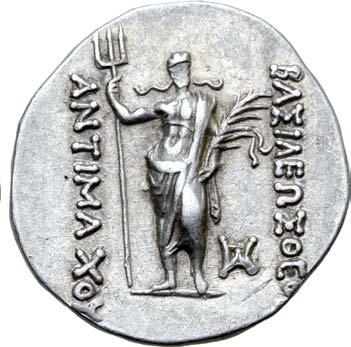


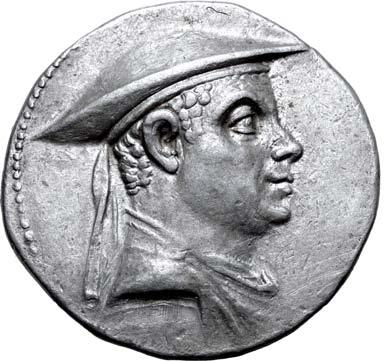
Near Extremely Fine. Rare.
Very Rare
Greco-Baktrian Kingdom, Demetrios II AR Tetradrachm. Circa 175-170 BC. Diademed and draped bust to right / Athena standing facing, holding spear and shield set on ground; BAΣIEΛEΩΣ to right, ΔHMHTPIOY to left, monogram to lower left, Δ to upper right. Bopearachchi 1F; Mitchiner 101h; SNG ANS 395; HGC 12, 126. 16.77g, 32mm, 12h.







391. 600
Extremely Fine. Very Rare; only two other examples on CoinArchives with these monograms.
145
300
390. 300
392.
Greco-Baktrian Kingdom, Eukratides I Megas AR Tetradrachm. Circa 170-145 BC. Diademed and draped bust to right / The Dioskouroi on horses prancing to right, each holding spear and palm; BΑΣΙΛΕΩΣ above, ΕΥΚΡΑΤΙΔΟΥ below, monogram in lower right field. Bopearachchi 1B; Mitchiner 168f; SNG ANS 432; HGC 12, 130. 16.99g, 34mm, 12h.
Good Extremely Fine.
393.
Greco-Baktrian Kingdom, Eukratides I Megas AR Tetradrachm. Circa 170-145 BC. Diademed and draped bust to right / The Dioskouroi on horses prancing to right, each holding spear and palm; BΑΣΙΛΕΩΣ above, ΕΥΚΡΑΤΙΔΟΥ below, monogram in lower right field. Bopearachchi 1D; Mitchiner 168a; SNG ANS 432; HGC 12, 130. 17.07g, 34mm, 12h.






Near Mint State; a finely detailed and characterful portrait.
394.
Greco-Baktrian Kingdom, Eukratides I Megas AR Drachm. Circa 170-145 BC. Diademed and draped bust to right / The Dioskouroi on horses prancing to right, each holding spear and palm; ΒΑΣΙΛΕΩΣ above, ΕΥΚΡΑΤΙΔΟΥ below, monogram to lower right. Bopearachchi 2B; Mitchiner 169b; SNG ANS 437-8; HGC 12, 135. 4.25g, 20mm, 12h.


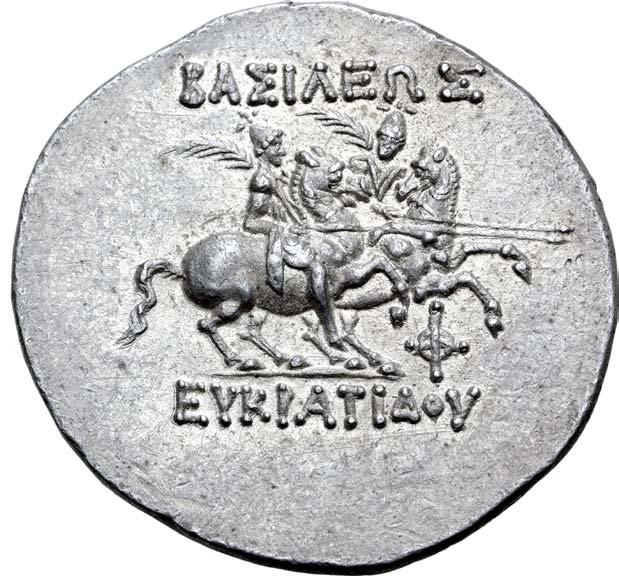


Good Extremely Fine.

146
300
900
1,200
395. 600
397.
Greco-Baktrian Kingdom, Eukratides I Megas AR Drachm. Circa 170-145 BC. Diademed and draped bust to right / The Dioskouroi on horses prancing to right, each holding spear and palm; ΒΑΣΙΛΕΩΣ above, ΕΥΚΡΑΤΙΔΟΥ below, monogram to lower right, A (mark of value) to left. Bopearachchi 2C; Mitchiner 169a; SNG ANS 439-41; HGC 12, 135. 4.33g, 20mm, 12h.
Good Extremely Fine. Rare.
Greco-Baktrian Kingdom, Eukratides I Megas AR Drachm. Circa 170-145 BC. Diademed and draped bust to right / The Dioskouroi on horses prancing to right, each holding spear and palm; ΒΑΣΙΛΕΩΣ above, ΕYΚΡΑΤΙΔΟΥ below, monogram to lower right, A (mark of value) to upper left. Bopearachchi 2C; Mitchiner 169a; SNG ANS 439-41; HGC 12, 135. 4.21g, 20mm, 12h.


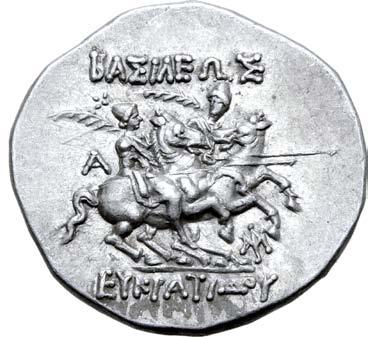





Extremely Fine. Scarce.
398.
Greco-Baktrian Kingdom, Eukratides I Megas AR Tetradrachm. Circa 170-145 BC. Diademed and draped bust to right, wearing crested helmet adorned with bull’s horn and ear / The Dioskouroi on horses prancing to right, each holding spear and palm; ΒΑΣΙΛΕΩΣ
above, ΕΥΚΡΑΤΙΔΟΥ below, monogram in lower right field. Bopearachchi 6O; Mitchiner 177a; SNG ANS 467; HGC 12, 131. 16.95g, 33mm, 12h.
Near Mint State; hairlines in obv. field, attractively toned.
600
Greco-Baktrian Kingdom, Eukratides I Megas AR Tetradrachm. Circa 170-145 BC. Diademed and draped bust to right, wearing crested helmet adorned with bull’s horn and ear / The Dioskouroi on horses prancing to right, each holding spear and palm; ΒΑΣΙΛΕΩΣ ΜΕΓΑΛΟΥ above, ΕΥΚΡΑΤΙΔΟΥ below, monogram in lower right field. Bopearachchi 6W; Mitchiner 177f; SNG ANS 469-71; HGC 12, 131. 17.00g, 34mm, 12h.
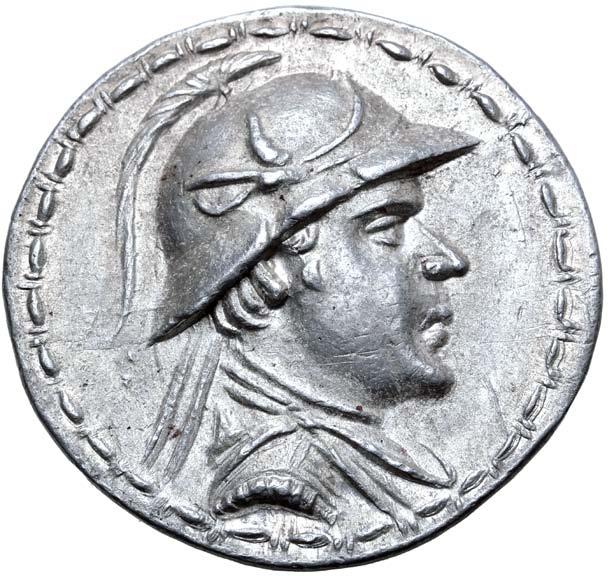





Extremely Fine.
900
147
396. 300
ΜΕΓΑΛΟΥ
399.
Greco-Baktrian Kingdom, Eukratides I Megas AR Tetradrachm. Circa 170-145 BC. Diademed and draped bust to right, wearing crested helmet adorned with bull’s horn and ear / The Dioskouroi on horses prancing to right, each holding spear and palm; ΒΑΣΙΛΕΩΣ



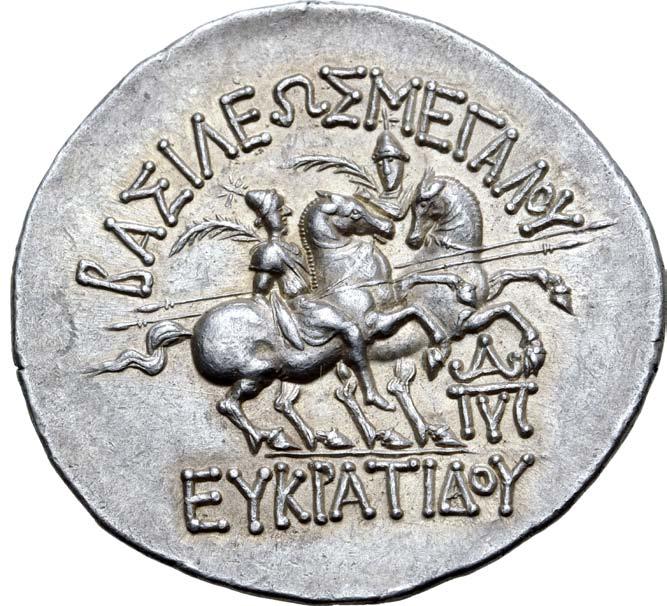







above,
below, monogram in lower right field. Bopearachchi 6X; Mitchiner 177e; SNG ANS 472; HGC 12, 131. 17.09g, 35mm, 11h. Mint State; a beautiful portrait engraved in fine style.
400.
above,
ΕΥΚΡΑΤΙΔΟΥ
ΒΑΣΙΛΕΩΣ
ΜΕΓΑΛΟΥ
401. 1,500
Mint State; struck on a broad planchet. Extremely Rare; only one other example of this monogram offered at auction in the past 20 years.
148
ΜΕΓΑΛΟΥ
ΕΥΚΡΑΤΙΔΟΥ
900
ΜΕΓΑΛΟΥ
Greco-Baktrian Kingdom, Eukratides I Megas AR Tetradrachm. Circa 170-145 BC. Diademed and draped bust to right, wearing crested helmet adorned with bull’s horn and ear / The Dioskouroi on horses prancing to right, each holding spear and palm; ΒΑΣΙΛΕΩΣ 600
below, monogram in lower right field. Bopearachchi 6DD; Mitchiner 177dd; SNG ANS 474; HGC 12, 131. 17.00g, 35mm, 11h. Good Extremely Fine.
ΕΥΚΡΑΤΙΔΟΥ
Greco-Baktrian Kingdom, Eukratides I Megas AR Tetradrachm. Circa 170-145 BC. Diademed and draped bust to right, wearing crested helmet adorned with bull’s horn and ear / The Dioskouroi on horses prancing to right, each holding spear and palm;
above,
below, monogram in lower right field. Bopearachchi 6EE; Mitchiner 177cc; SNG ANS -; HGC 12, 131; Roma XXII, 489 (hammer: £4,600). 16.92g, 36mm, 12h.
An Extremely Rare Monogram Issue
402.
Greco-Baktrian Kingdom, Eukratides I Megas AR Drachm. Circa 170-145 BC. Diademed and draped bust to right, wearing crested helmet adorned with bull’s horn and ear / The Dioskouroi on horses prancing to right, each holding spear and palm; ΒΑΣΙΛΕΩΣ
below, monogram in lower right field. Bopearachchi 7G; Mitchiner 178a; SNG ANS 476-8; HGC 12, 136. 4.25g, 20mm, 11h. Mint State; lustrous metal.
403. 600
404.
Greco-Baktrian Kingdom, Eukratides I Megas AR Drachm. Circa 170-145 BC. Diademed and draped bust to right, wearing crested helmet adorned with bull’s horn and ear / The Dioskouroi on horses prancing to right, each holding spear and palm; ΒΑΣΙΛΕΩΣ
above, ΕΥΚΡΑΤΙΔΟΥ below, monogram in lower left field. Bopearachchi 7J; Bopearachchi & Rahman -; Mitchiner 178d; SNG ANS 483; HGC 12, 136. 4.25g, 20mm, 12h. Good Extremely Fine.
Greco-Baktrian Kingdom, Eukratides I Megas AR Drachm. Circa 170-145 BC. Diademed and draped bust to right, wearing crested helmet adorned with bull’s horn and ear / The Dioskouroi on horses prancing to right, each holding spear and palm; BAΣIΛEΩΣ MEΓAΛOY above, EYKPATIΔOY below, monogram in lower left field. Bopearachchi 7J; Bopearachchi & Rahman -; Mitchiner 178d; SNG ANS 483; HGC 12, 136. 4.25g, 20mm, 12h. Mint State; sharply struck.
405. 600
Greco-Baktrian Kingdom, Eukratides I Megas AR Drachm. Circa 170-145 BC. Diademed and draped bust to right, wearing crested helmet adorned with bull’s horn and ear / The Dioskouroi on horses prancing to right, each holding spear and palm; ΒΑΣΙΛΕΩΣ ΜΕΓΑΛΟΥ above, ΕΥΚΡΑΤΙΔΟΥ below, monogram in lower right field. Bopearachchi 7I; Mitchiner 178c; HGC 12, 131. 4.27g, 20mm, 12h. Mint State. Rare.
406. 300
Greco-Baktrian Kingdom, Eukratides I Megas AR Drachm. Circa 170-145 BC. Diademed and draped bust to right, wearing crested helmet adorned with bull’s horn and ear / The Dioskouroi on horses prancing to right, each holding spear and palm; ΒΑΣΙΛΕΩΣ ΜΕΓΑΛΟΥ above, ΕΥΚΡΑΤΙΔΟΥ below, monogram in lower right field. Bopearachchi 7I; Mitchiner 178c; HGC 12, 131. 4.23g, 20mm, 12h. Good Extremely Fine; minor flan cracks.















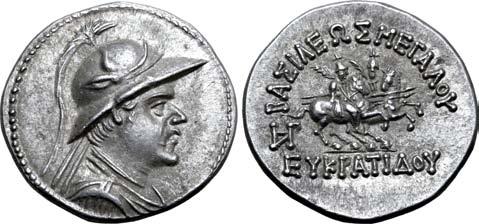

149
ΜΕΓΑΛΟΥ
ΕΥΚΡΑΤΙΔΟΥ
above,
600
ΜΕΓΑΛΟΥ
300
Sculptural Heroic Bust
Greco-Baktrian Kingdom, Eukratides I Megas AR Tetradrachm. Circa 170-145 BC. Diademed heroic bust to left, seen from behind, wearing crested helmet adorned with bull’s horn and ear, brandishing spear in right hand / The Dioskouroi on horses prancing to right, each holding spear and palm; BAΣIΛEΩΣ MEΓAΛOY above, EYKPATIΔOY below, monogram in lower right field. Bopearachchi 8A; Bopearachchi & Rahman 252-4; Mitchiner 179a (Mitchiner doesn’t differentiate between monograms A and B in Bopearachchi but the plates show both); SNG ANS 484; HGC 12, 132. 16.99g, 32mm, 12h.



Near Mint State; a wonderfully sculptural heroic bust, lustrous silver beneath a satin grey tone.
Ex Oxus Collection, Roma Numismatics Ltd., Auction XXV, 22 September 2022, lot 597.
The Greco-Baktrian Kingdom is seldom mentioned in classical texts, in fact, much of what we know about the territory has been learnt from coins and their inscriptions. Notably, it is these very coins that have also granted Baktria a position in the history of Hellenistic art (J.J. Pollitt, Art in the Hellenistic Age, p.285), for, they present some of the finest examples of numismatic design and portraiture. Not only remarkable for its artistic merit however, a coin such as this is further significant for what it reveals about the self-perception of a Baktrian King. Eukratides, an usurper, proclaimed himself King following a revolt (recorded by Justin (XLI, 6)) against Demetrios and the elimination of the entire former dynasty. The reverse of this coin reflects the warring prowess of the King in an intricate depiction of cavalrymen, the Dioskouroi, rushing into battle with their lances set and palm branches trailing behind them. The inscription surrounding the image reads ‘of the great King, Eukratides’ implying that, like the Persians and Alexander before him, Eukratides had come to dominate all the local rulers of the region.
In a numismatically unprecedented mode of depiction, Eukratides I appears on the obverse of this coin as a heroic nude bust. Seen from behind with a side-profile of his verisimilar portrait, Eukratides, spear in hand, is poised ready to strike. His muscles are tense, ready for action, but Eukratides’ face conveys the calm composure of a true leader, he gazes straight ahead and his expression is of utmost concentration. Eukratides wears a crested helmet decorated with a bull’s horn and ear, possibly an allusion to his Seleukid blood as we also find them on coins of Seleukos, who, according to Appian (Syr. 57) ‘was of such a large and powerful frame that once when a wild bull was brought for sacrifice to Alexander and broke loose from his ropes, Seleukos held him alone, with nothing but his hands, for which reason his statues are ornamented with horns’.


Good Extremely Fine.

150
407.
7,500
Greco-Baktrian Kingdom, Eukratides I Megas AR Tetradrachm. Circa 170-145 BC. Diademed heroic bust to left, seen from behind, wearing crested helmet adorned with bull’s horn and ear, brandishing spear in right hand / The Dioskouroi on horses prancing to right, each holding spear and palm; BAΣIΛEΩΣ MEΓAΛOY above, EYKPATIΔOY below, monogram in lower right field. Bopearachchi 8B; Bopearachchi & Rahman 255; Mitchiner 179a; SNG ANS 485; HGC 12, 132. 16.99g, 32mm, 12h.
408.
3,000
A Rare and Desirable Type
Greco-Baktrian Kingdom, Eukratides I Megas, with Heliokles and Laodike, AR Tetradrachm. Circa 170-145 BC. Dynastic pedigree issue. Jugate draped busts of Heliokles and Laodice to right, HΛIOKΛEOYΣ above, KAI ΛAOΔIKHΣ below; monogram behind / Diademed and draped bust to right, wearing crested helmet adorned with bull’s horn and ear, BAΣIΛEYΣ MEΓAΣ above, EYKPATIΔHΣ below. Bopearachchi 13A; Mitchiner 182b; HGC 12, 133. 17.04g, 32mm, 12h.
Good Extremely Fine. A rare and desirable type.
Eukratides ‘the Great’ was one of the last but most important Greco-Baktrian kings, responsible for the overthrow of the Euthydemid dynasty. While the position held by Eukratides prior to his revolt is unclear, it has been suggested he held the position of satrap in Baktria during the campaigning of Demetrios, successor of Euthydemos II, in India around 192 BC (Cunningham, A. “Coins of Alexander’s Successors in the East (Continued).” in The Numismatic Chronicle and Journal of the Numismatic Society 9 (1869): pp. 121-53). There is limited record of the revolt, although Justin (XLI, 6) describes an event when the usurper survived a siege lasting five months by a force of sixty thousand loyal to Demetrios, successor of Euthydemos II, with only three hundred men.
Whilst Justin reports that the conflict originated between Eukratides and Demetrios, numismatic evidence suggests Demetrios ceased to rule and succession passed down the legitimate line to Antimachos, Agathokles and Pantaleon before the revolt was over. This is supported by Mitchiner, who argues the coinage of Demetrios ceased and was replaced by that of his heirs, who controlled the main mints in Baktria and from which they issued ‘pedigree coins’ affirming their legitimacy (The early Indo-Greeks and their antecedants, vol. 1, (1975), p. 66).



Eukratides gained control over all of Baktria around 168 BC, reducing Antimachos, Agathokles and Pantaleon to Indo-Greek territories south of the Hindu Kush, and struck ‘pedigree coins’ of his own bearing the adopted and immodest title MEΓAΣ (‘the Great) - the tetradrachm presented here is an outstanding example of such an issue. The obverse depicts two busts, named by the legend as Heliokles and Laodike, whose identities are uncertain. It has been suggested that the coin cites Eukratides’ parents, and Laodike, who wears a diadem, may have been a member of the Seleukid imperial house (see Astin, A.E. The Cambridge Ancient History (1990), p. 401, see also Mitchiner). If the identification is correct, we might see this issue within the context of and in direct response to the Euthydemid commemoration issues struck during the period of Eukratides’ revolt.

151
409.
6,000
In Outstanding Condition
Greco-Baktrian Kingdom, Eukratides I Megas, with Heliokles and Laodike, AR Tetradrachm. Circa 170-145 BC. Dynastic pedigree issue. Jugate draped busts of Heliokles and Laodice to right, HΛIOKΛEOYΣ above, KAI ΛAOΔIKHΣ below; monogram behind / Diademed and draped bust to right, wearing crested helmet adorned with bull’s horn and ear, BAΣIΛEYΣ MEΓAΣ above, EYKPATIΔHΣ below. Bopearachchi 15A; Bopearachchi & Rahman 263; Mitchiner 182a; SNG ANS 526-527; HGC 12, 133. 16.94g, 32mm, 12h.
410. 6,000
Good Extremely Fine. Rare, and in outstanding condition for the type.
411. 900
Greco-Baktrian Kingdom, Eukratides II Soter AR Tetradrachm. Circa 145-140 BC. Diademed and draped bust to right / Apollo standing facing, head to left, holding arrow in right hand and grounded bow with left; BAΣIΛEΩΣ to right, EYKPATIΔOY to left, monogram in lower left field. Bopearachchi 1Q; Mitchiner 164q; SNG ANS 624; HGC 12, 161. 17.05g, 31mm, 12h.






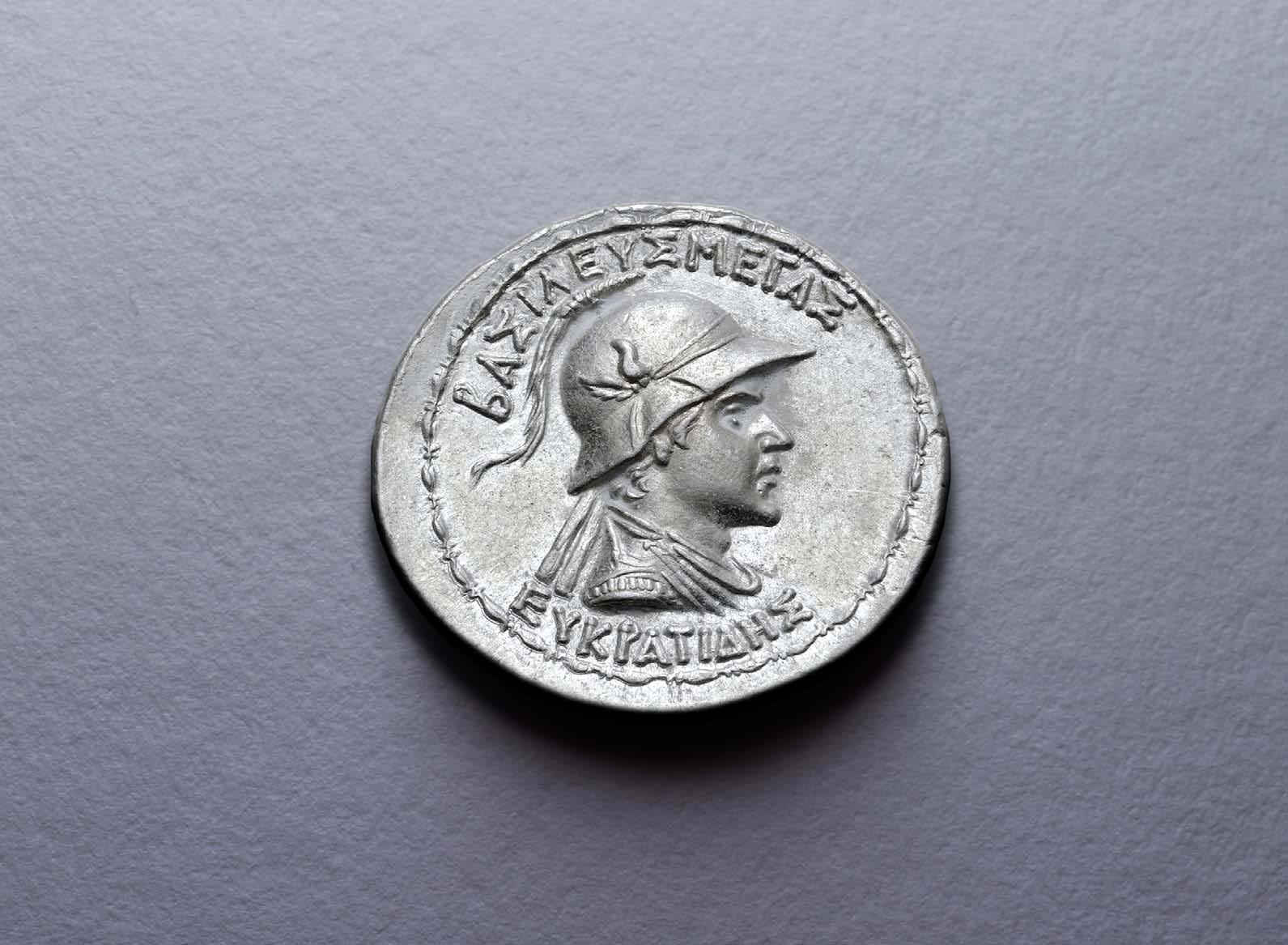
Near Mint State.
Ex Professor Shir Mohammad Collection, Roma Numismatics Ltd., Auction XXIII, 24 March 2022, lot 441.
152
412.
Greco-Baktrian Kingdom, Eukratides II Soter AR Tetradrachm. Circa 145-140 BC. Diademed and draped bust to right / Apollo standing facing, head to left, holding arrow in right hand and grounded bow with left; BAΣIΛEΩΣ to right, EYKPATIΔOY to left, monogram in lower left field. Bopearachchi 1H; Mitchiner 164m; SNG ANS 619-22; HGC 12, 161. 16.87g, 31mm, 11h.









Good Extremely Fine.
Ex Roma Numismatics Ltd., Auction XXIII, 24 March 2022, lot 443.
413.
Greco-Baktrian Kingdom, Heliokles I Dikaios AR Tetradrachm. Circa 145-130 BC. Diademed and draped bust to right / Zeus standing facing, holding thunderbolt in right hand and sceptre in left; BAΣIΛEΩΣ to right, HΛIOKΛEOYΣ to left, ΔIKAIOY below; monogram to lower left field. Bopearachchi 1Q; Mitchiner 284f; SNG ANS 641; HGC 12, 169. 16.97g, 33mm, 12h.
Mint State; a beautiful example.
INDO-GREEK KINGDOM
The Third Known
414.
600
1,800
415.
Indo-Greek Kingdom, Nikias AR Drachm. Circa 129-125 BC. BAΣIΛEΩΣ ΣΩTHPOΣ NIKIOY, diademed and draped bust to right / ‘Maharajasa tratarasa Nikiasa’ in Kharosthi, king on horseback charging to right; monogram below. Bopearachchi -; Mitchiner -; Bopearachchi & Rahman -; SNG ANS -; HGC 12, 233; CNG 93, 687; CNG Triton IX, 1133. 1.88g, 16mm, 12h. Very Fine. Extremely Rare; the third known example.

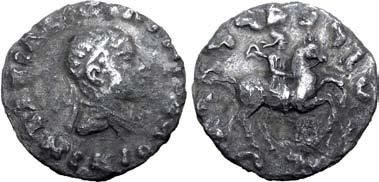
Ex Rubellite Collection, Roma Numismatics Ltd., Auction XXIII, 24 March 2022, lot 456.
900
Indo-Greek Kingdom, Strato I Soter AR Tetradrachm. Circa 105-80 BC. BAΣIΛEΩΣ ΣΩTHPOΣ ΔIKAIOY ΣTPATΩNOΣ, diademed and draped bust to right / Athena Alkidemos standing to left, wielding thunderbolt and shield; monogram to right, ‘’Maharajasa tratarasa dhramikasa Stratasa’ in Kharosthi around. Bopearachchi 17A var. (monogram variant); Mitchiner - cf. 328 for monogram variant on left; SNG ANS - cf. 995 (same); Bopearachchi & Rahman -; HGC 12, 326 var. (monogram to right). 9.47g, 26mm, 12h.

Good Very Fine; flan crack at 5h. Apparently unpublished in the standard references.
3,000
153
Apparently Unpublished
KINGS OF PARTHIA
416.
Kings of Parthia, Mithradates I AR Drachm. Hekatompylos, circa 141-132 BC. Diademed and draped bust to left / ΒΑΣΙΛΕΩΣ
archer (Arsakes I) seated to right on omphalos, holding bow. Sellwood 11.1; Sunrise 265 var. (no border); Shore 24. 4.13g, 20mm, 12h.
Mint State; a superb example of the type.
KUSHAN EMPIRE
417.
Kushan Empire, Kanishka I AV Quarter Dinar. Main mint in Baktria (Balkh?), circa AD 127-151. Diademed and draped half-length bust of king to left, emerging from mountain top, wearing crown, holding spear; flames at shoulder / Athsho standing facing, head to left, holding diadem in outstretched hand; tamgha to left. MK 41 (O2/R10α); ANS Kushan 375-6 (same rev. die); Donum Burns 122 (same rev. die). 2.00g, 13mm, 12h.








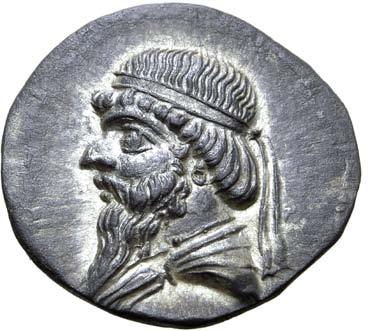





Very Fine. Very Rare.
Kushan Empire, Huvishka AV Dinar. Subsidiary mint in Gandhara (Peshawar?), circa AD 152-192. Nimbate, diademed and crowned half-length bust on clouds to left, holding mace-sceptre and filleted spear / Ardoxsho standing to right, extending cornucopiae with both hands; tamgha to right. MK 364 (O1/R52); ANS Kushan 768 (same dies); Donum Burns -; CNG Triton XXV, 612 (hammer: 8,000 USD); NAC 92, 232. 7.82g, 21mm, 12h.
Very Fine. Extremely Rare; only four examples known to Göbl, two others on CoinArchives.
Kushan Empire, Vasudeva I AV Dinar. Main mint in Baktria (Balkh?), circa AD 190-230. Vasudeva standing facing, diademed and crowned, head to left, sacrificing over altar and holding trident; flames at right shoulder, filleted trident to left / Ithyphallic Siva standing facing, holding diadem and trident; behind, the bull Nandi standing to left; tamgha to left. MK 528 (O1a/R34, Vasudeva II); ANS Kushan -; Donum Burns 438-9. 8.12g, 21mm, 12h.

Extremely Fine.
KUSHANO-SASANIANS
Kushano-Sasanians, temp. Ardaxšīr (Ardashir) - Pērōz (Fīrūz) I AV Dinar. In the name of Vasudeva I. Uncertain Baktrian mint, AD 230-270. King standing facing, nimbate, diademed and crowned, head to left, sacrificing over altar and holding trident; flames at shoulder, filleted trident and symbol to left, swastika between legs, nandipana to right / Ithyphallic Siva standing facing, holding diadem and trident; behind, the bull Nandi standing to left; tamgha and pellet to upper left, OHPO to right. MK 692 (O92/R5, Vasudeva II); ANS Kushan 1698 corr. (swastika not mentioned in text); Donum Burns 474. 8.08g, 27mm, 12h.
Mint State.
Acquired from Pars Coins, San Jose CA.
1,050
154
ΜΕΓΑΛΟΥ ΑΡΣΑΚΟΥ,
300
750
418.
750
419.
750
420.
422.
Kushano-Sasanians, temp. Ardaxšīr (Ardashir) - Pērōz (Fīrūz) I AV Dinar. In the name of Vasudeva I. Uncertain Baktrian mint, AD 230-270. King standing facing, nimbate, diademed and crowned, head to left, sacrificing over altar and holding trident; flames at shoulder, filleted trident to left, nandipana to right, Brahmi letter to left, swastika between legs, legend around / Ithyphallic Siva standing facing, holding diadem and trident; behind, the bull Nandi standing to left; tamgha and pellet to upper left, OHPO to right. MK 692 (Vasudeva II); ANS Kushan 1698 corr. (swastika not mentioned in text); Donum Burns 474. 8.00g, 28mm, 12h.
Near Mint State.
600
423.
Kushano-Sasanians, temp. Ardaxšīr (Ardashir) - Pērōz (Fīrūz) I AV Dinar. In the name of Vasudeva I. Uncertain Baktrian mint, AD 230-270. King standing facing, nimbate, diademed and crowned, head to left, sacrificing over altar and holding trident; flames at shoulder, filleted trident to left, nandipana to right, Brahmi letter to left, swastika between legs, legend around / Ithyphallic Siva standing facing, holding diadem and trident; behind, the bull Nandi standing to left; tamgha and pellet to upper left, OHPO to right. MK 692 (Vasudeva II); ANS Kushan 1698 corr. (swastika not mentioned in text); Donum Burns 474. 8.07g, 26mm, 12h.
Near Mint State; minor dies shift to rev.
600
Kushano-Sasanians, temp. Ardaxšīr (Ardashir) - Pērōz (Fīrūz) I AV Dinar. In the name of Vasudeva I. Uncertain Baktrian mint, AD 230-270. King standing facing, nimbate, diademed and crowned, head to left, sacrificing over altar and holding trident; flames at shoulder, filleted trident to left, nandipana to right, Brahmi letter to left, swastika between legs, legend around / Ithyphallic Siva standing facing, holding diadem and trident; behind, the bull Nandi standing to left; tamgha and pellet to upper left, OHPO to right. MK 692 (Vasudeva II); ANS Kushan 1698 corr. (swastika not mentioned in text); Donum Burns 474. 8.04g, 27mm, 12h.
Near Mint State; scrape to obv., die shift to rev.
600
Kushano-Sasanians, temp. Ardaxšīr (Ardashir) - Pērōz (Fīrūz) I AV Dinar. In the name of Vasudeva I. Uncertain Baktrian mint, AD 230-270. King standing facing, nimbate, diademed and crowned, head to left, sacrificing over altar and holding trident; flames at shoulder, filleted trident to left, nandipana to right, Brahmi letter to left, swastika between legs, legend around / Ithyphallic Siva standing facing, holding diadem and trident; behind, the bull Nandi standing to left; tamgha and pellet to upper left, OHPO to right. MK 692 (Vasudeva II); ANS Kushan 1698 corr. (swastika not mentioned in text); Donum Burns 474. 8.12g, 27mm, 12h.




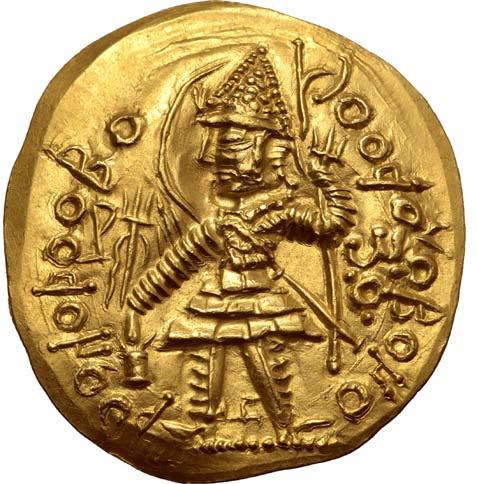







Mint State; die shift to obv. and rev.
600
155
424.
421.
Kushano-Sasanians, temp. Ardaxšīr (Ardashir) - Pērōz (Fīrūz) I AV Dinar. In the name of Vasudeva I. Uncertain Baktrian mint, AD 230-270. King standing facing, nimbate, diademed and crowned, head to left, sacrificing over altar and holding trident; flames at shoulder, filleted trident to left, nandipana to right, legend around / Ithyphallic Siva standing facing, holding diadem and trident; behind, the bull Nandi standing to left; tamgha and pellet to upper left, OHPO to right. MK 692 (Vasudeva II); ANS Kushan 1698 corr. (swastika not mentioned in text); Donum Burns 474. 7.92g, 27mm, 12h.
425. 600
Near Mint State; die shift to rev. Unpublished variant with this control arrangement.
426. 600
Kushano-Sasanians, temp. Ardaxšīr (Ardashir) - Pērōz (Fīrūz) I AV Dinar. In the name of Vasudeva I. Uncertain Baktrian mint, AD 230-270. King standing facing, nimbate, diademed and crowned, head to left, sacrificing over altar and holding trident; flames at shoulder, filleted trident to left, nandipana to right, Brahmi letter to left, swastika between legs, annulet below left arm, legend around / Ithyphallic Siva standing facing, holding diadem and trident; behind, the bull Nandi standing to left; tamgha and pellet to upper left, OHPO to right. MK 691 var. (no pellet above swastika) (Vasudeva II); ANS Kushan - cf. 1698; Donum Burns - cf. 474. 8.10g, 28mm, 12h.
Near Mint State. Apparently unpublished variant.
427. 600
Kushano-Sasanians, temp. Ardaxšīr (Ardashir) - Pērōz (Fīrūz) I AV Dinar. In the name of Vasudeva I. Uncertain Baktrian mint, AD 230-270. King standing facing, nimbate, diademed and crowned, head to left, sacrificing over altar and holding trident; flames at shoulder, filleted trident to left, nandipana to right, Brahmi letter to left, swastika between legs, three pellets below left arm, legend around / Ithyphallic Siva standing facing, holding diadem and trident; behind, the bull Nandi standing to left; tamgha and pellet to upper left, three pellets to lower left, OHPO to right. MK 693 var. (no pellet in place 5 on obverse, Vasudeva II); ANS Kushan - cf. 1698; Donum Burns - cf. 474; Peus 425, 352 (for example also with no obverse pellet). 8.04g, 27mm, 12h.




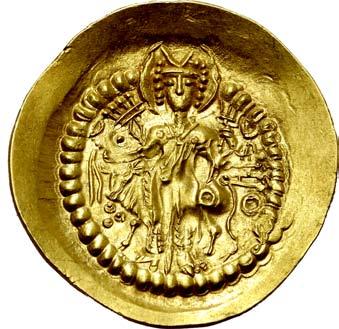






Mint State. Apparently unpublished variant.

156
430.
Sasanian Kingdom, Shapur I AV Dinar. Mint I (“Ctesiphon”), Phase 2, circa AD 260-272. Draped bust to right, wearing diadem and mural crown surmounted by korymbos / Fire-altar flanked by two attendants, each wearing mural crown with ribbons and korymbos and holding staff surmounted by pellet-in-crescent; three pellets to right of altar shaft. SNS type IIc/1b, style P; Göbl type I/1; Saeedi AV4 var. (no pellets on rev.); Sunrise 739 var. (same). 7.36g, 21mm, 3h.
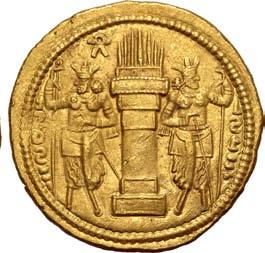





Near Mint State.
Acquired from Pars Coins, San Jose CA.
Shapur was the second shahanshah (king of kings) of the Sasanian empire, apparently joining his father Ardashir I as king in joint rule in AD 240, and then succeeding in around 242 as sole ruler. Shapur had accompanied his father on campaign against the Parthians who then still controlled much of the Iranian plateau, and already before his accession was praised for his intelligence and learning, as well as for boldness and kind-heartedness. Continuing his father’s war with the Roman empire, Shapur conquered the Mesopotamian fortresses of Nisibis and Carrhae, advancing into Syria, which required the young emperor Gordian III to set out with a vast army to counter the Sasanian threat. Gordian’s army won battle after battle, at last routing the Sasanian army at Rhesaena, forcing Shapur to hand back all of his gains. Gordian’s death and the succession of Philip ‘the Arab’ ended the Roman campaign against Shapur, who was able to extract considerable advantages from Philip including an enormous indemnity in gold.
Shapur soon resumed his attacks on Rome, and in 253 met and annihilated a Roman army of 60,000 at the Battle of Barbalissos, and proceeded then to burn and ravage the Roman province of Syria. Armenia was conquered, and Georgia submitted to Sasanian control. With his northern borders secure, Shapur then led an army which penetrated deep into Syria, plundering all the way to Antioch which quickly fell to his forces. The Roman counter-offensive under emperor Valerian was slow, but by 257 Antioch had been recovered and the province of Syria returned to Roman control. Shapur’s speedy retreat caused the Romans to launch a hasty pursuit of the Sasanians all the way to Edessa, where they were severely defeated by the Persians, and Valerian along with the survivors of his army were led away into captivity. The defeat and capture of Valerian surely marks the greatest achievement in the reign of Shapur, who is also called ‘the Great’, and the submission of Valerian is commemorated in a mural at Naqsh-e Rustam, which shows the emperor bending the knee before Shapur on horseback. Valerian’s army was sent to Bishapur, and the soldiers were used in engineering and development works, such as the Band-e Kaisar (Caesar ’s dam) near the ancient city of Susa.
Sasanian Kingdom, Shapur I AV Dinar. Mint I (“Ctesiphon”), Phase 2, circa AD 260-272. Draped bust to right, wearing diadem and mural crown surmounted by korymbos; one pellet above and two below diadem ends / Fire-altar flanked by two attendants, each wearing mural crown with ribbons and korymbos and holding staff, tamgha to upper left. SNS type IIc/1b, style P, group d/1, pl. 31, 143; Göbl type I/1; Saeedi AV5; Sunrise 740. 7.29g, 21mm, 3h.
Near Mint State; well centered.
1,800
Sasanian Kingdom, Shapur I AV Dinar. Mint I (“Ctesiphon”), Phase 2, circa AD 260-272. Draped bust to right, wearing diadem and mural crown surmounted by korymbos; one pellet above and two below diadem ends / Fire-altar flanked by two attendants, each wearing mural crown with ribbons and korymbos and holding staff; frawahr to left of flames. SNS type IIc/1b, style P, group d/1, 143; Göbl type I/1; Saeedi AV5; Sunrise 740. 7.42g, 21mm, 3h.


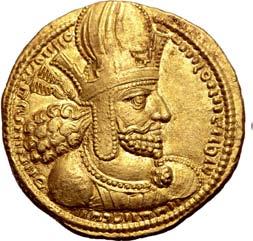

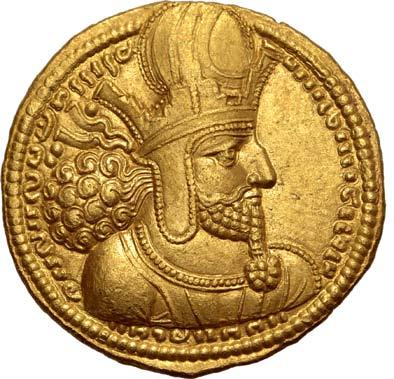

Mint State.
1,800
157
428. 2,100 SASANIAN KINGDOM
429.
431. 1,800
433.
Sasanian Kingdom, Vahran II AV Dinar. AD 276-293. Draped bust to right, wearing winged crown surmounted by korymbos / Fire-altar flanked by two attendants, one wearing winged crown with korymbos, one wearing mural crown with korymbos. SNS type 1/1; Göbl type I/1 var. (curved wing in crown); Saeedi -; Sunrise 765 var. (no pellet below altar); Roma XXVII, 453. 7.34g, 22mm, 3h.




Near Mint State. Very Rare with the curved wing on the crown in this denomination.
Sasanian Kingdom, Shapur II AR Obol. Mint IX (“Kabul”), circa AD 320. Draped bust to right, wearing diadem and mural crown surmounted by korymbos / Fire altar with ribbons. SNS type Ib1/2a; Göbl type Ia/7; Saeedi -; Sunrise 844. 0.71g, 13mm, 3h.

Good Extremely Fine. Extremely Rare.
Acquired from Pars Coins, San Jose CA.
Levantine Region, uncertain mint AR Obol. 4th-3rd centuries BC. Reverse type in imitation of Athens. Facing gorgoneion / Owl standing to right, head facing; olive sprig and crescent behind, AⵁE before; all within shallow incuse square. Unpublished, cf. Roma E-109, 731; cf. Roma E-105, 518; cf. CNG Triton XXV, 342; cf. CNG 115, 342; cf. CNG 82, 740; cf. CNG E-174, 73. 0.69g, 9mm, 9h.
Extremely Fine. Unpublished and extremely rare.
300
Philistia (Palestine), uncertain mint AR Obol. Gaza(?), circa 450-333 BC. Laureate and bearded male head (Ba’al Arwad) to right / Owl standing facing, wings spread; olive spring and crescent to upper left, AΘE around; all within incuse square. Gitler & Tal pg. 204, XIV, 290 var. (arrangement of legend) = Sofaer 10 var. (same - Gaza); HGC 10, -; Roma E-44, 333; Roma E-79, 473. 0.57g, 10mm, 12h.


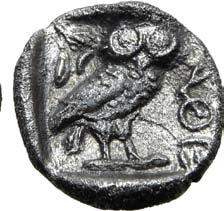


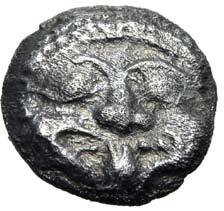


Extremely Fine. Extremely Rare.
Ex Roma Numismatics Ltd., Auction XXIII, 24 March 2022, lot 508.

Philistia, Gaza AR Obol. Circa 450-333 BC. Janiform male and female heads / Forepart of horse to right; Phoenician AZ to upper left; all within dotted linear square border within incuse square. Gitler & Tal VI.7O. 0.52g, 9mm, 2h.


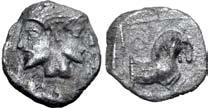
Good Very Fine. Extremely Rare.
Ex Roma Numismatics Ltd., Auction XXIII, 24 March 2022, lot 512.
158
432. 450
300
434.
435. 180 2x 2x 2x 2x 2x 2x 2x 2x
DAY TWO - THURSDAY 6 JULY 2023, 1:00 PM
COINS OF THE ROMAN PROVINCES
P. Salpa and M. Fulvius, as duoviri, Æ As of Lepida-Celsa, Spain. Pseudo-autonomous issue, circa 44-36 BC. Helmeted head of Mars to right; COL VIC IVL LEP before / Bull to right; P SALPA M FVLVI PR II VIR around. RPC I 264; SNG Stockholm 1624-1630; SNG Copenhagen 536; CNH 22; ACIP 1495. 12.91g, 29mm, 11h.





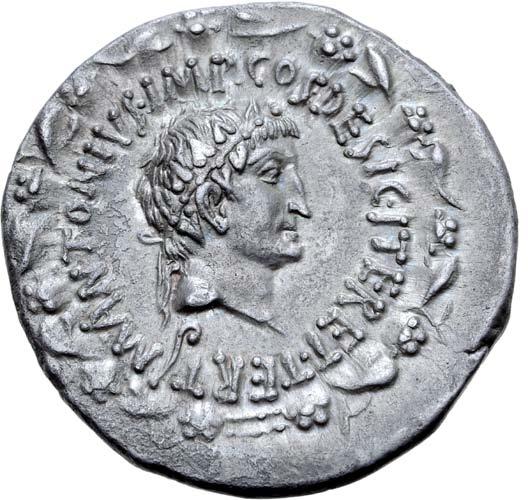

Good Very Fine. Rare.
Ex Roma Numismatics Ltd., E-Sale 100, 28 July 2022, lot 696.
Ex Sternberg, 1992
Marc Antony and Octavia AR Cistophoric Tetradrachm of Ephesus, Ionia. Circa 39 BC. M•ANTONIVS•IMP•COS•DESIG ITER•ET•TERT, head of Antony to right, wearing ivy wreath, lituus below; all within wreath of ivy and flowers / III•VIR• R•P•C, head of Octavia atop cista mystica, between twisting snakes. RPC I 2201; CRI 262; BMCRR East 133; RSC 2. 11.93g, 29mm, 12h.
437. 2,100
Good Extremely Fine; attractive old cabinet tone.
Ex Numismatica Ars Classica, Auction 100, 29 May 2017, lot 1673; Ex F. Sternberg AG, Auction XXVI, 16 November 1992, lot 263.
In Exceptional Condition for the Issue
Fulvia (wife of Marc Antony) Æ 19mm of Eumenea (as Fulviana), Phrygia. Circa 41-40 BC. Zmertorix Philonidou, magistrate. Winged and draped bust of Fulvia (as Nike) to right / [ΦΟΥΛ]ΟΥΙΑ[ΝΩΝ] ΖΜΕΡΤΟΡΙΓΟΣ


Athena advancing to left, holding vertical spear and shield. RPC I 3139; BMC 20-21; HGC 7, 693. 6.51g, 19mm, 12h.

Good Extremely Fine. Rare and in exceptional condition for the issue - one of if not the best preserved example of the past 20 years.
Purchased from Münzhandlung Ritter (Düsseldorf), 8 December 1995, old collector ’s ticket included.
Fulvia was the first wife of Marc Antony, having married him in 44 BC. She appears to have been a devoted spouse, and was an outspoken defender of his interests in Rome while he was away in the East. Antony’s partisans renamed the Phrygian city of Eumeneia in her honour.

159
210
436.
ΦΙΛΩΝΙΔΟΥ,
438. 600
440.
Augustus AR Cistophorus of Ephesus, Ionia. Circa 25 BC. IMP•CAESAR, bare head to right / Capricorn to right, head reverted, bearing cornucopiae on back; AVGVSTVS below; all within laurel wreath. RPC I 2213; RIC I 477; BN 916. 11.92g, 27mm, 12h.





Good Extremely Fine; stunning old cabinet tone. Scarce in this condition.
Ex Classical Numismatic Group, Auction 100, 7 October 2015, lot 1831 (hammer: USD 3,750).
The significance of the constellation Capricorn to Augustus is subject to debate, with some ancient sources reporting that it was his birth sign and others relating that he was conceived under the sign - the latter tying in with his official birthday on 23-24 September. Although we now view conception and birth as two separate events, the Romans viewed conception through to birth as a continuous process. Under the tropical zodiac, the sun transits Capricorn from late December to late January, marking midwinter and the shortest day of the year. For this reason, often it was considered a hostile sign but Augustus chose to interpret it positively since it had governed two major events in his life - the granting of imperium to him by the Senate in January 43 BC, and the acceptance of the title Augustus on 16 January 27 BC.
The capricorn is represented as a goat with a fish tail, and is often thought to be a representation of Pan escaping an attack by the monster Typhon. Having jumped into the Nile, the half of Pan’s body which was submerged was transformed into a fish. An alternative interpretation is that the goat is Amalthea, who suckled the infant Zeus after Rhea rescued him from being devoured by his father Cronus. The broken horn of Amalthea transformed into the cornucopiae, which on the present example is carried on the back of the capricorn. It is a symbol of fertility and abundance, and here accompanies the corona civica, awarded to Romans who saved the lives of fellow citizens by slaying an enemy, but in the case of Augustus for having saved the entire Roman citizenry from the horrors of further civil war
In 27 BC, Augustus had declared Ephesus the capital of Asia Minor, promoting the city above the former capital Pergamum. The decision to use such striking imagery alongside his birth sign for issues minted in the new capital reinforced Augustus as the head of the new imperial regime.



441.
inscribed on entablature; COM-ASIAE across fields. RPC I 2219; RIC I 506; BMCRE 705 (Ephesus); Sutherland group VII; RSC 86. 11.83g, 26mm, 12h.
Near Extremely Fine; beautiful cabinet tone.
Ex Naville Numismatics Ltd, Auction 66, 27 June 2021, lot 361.
Augustus AR Drachm of Masicytus, Lycian League. Circa 27-20 BC. Bare head to right; Λ-Y flanking / Two citharas; MA below. RPC I 3309c.4; Troxell Period IV, 121.3. 3.50g, 19mm, 12h.



Mint State. Extremely Rare.
Very Rare
750
600
draped bust to right / ΣЄΡΓΙΟΣ ΗΦΑΙΣΤ[ΙΩΝ] ΙΟΥΛΙЄΩΝ, Cybele seated to left, holding patera and resting arm on tympanum. RPC I 3192. 2.16g, 16mm, 12h. Good Extremely Fine. Very Rare.
Agrippina II (mother of Nero) Æ 16mm of Julia, Phrygia. Circa AD 55. Sergios Hephaistion, magistrate. [Α]ΓΡΙΠЄΙΝΑ

442. 300
Ex Roma Numismatics Ltd., E-Sale 100, 28 July 2022, lot 726.
160
439.
1,800
Augustus AR Cistophorus of Pergamum, Mysia. 19-18 BC. IMP•IX TR PO V, bare head to right / Hexastyle temple with ROM ET AVGVST
ΣЄΒΑΣΤΗ,
Trajan AR Tetradrachm of Antioch, Seleucis and Pieria. AD 103-111. AYTOKP KAIC NЄP TPAIANOC CЄB ΓЄPM ΔAK, laureate head to right, set on eagle standing to right; club in right field / ΔHMAPX ЄΞ YΠATЄ, laureate bust of Melkart-Hercules to right, with lion skin tied around neck. RPC III 3528; McAlee 455; Prieur 1495 (Tyre). 15.00g, 28mm, 6h.

Good Extremely Fine; lustrous.
Ex Historical Scholar Collection; Previously privately purchased from Antiqua Inc., tickets included.
laureate head to right, set on eagle standing to right; club in left field /
Trajan AR Tetradrachm of Antioch, Seleucis and Pieria. Dated RY 15 = AD 110/1.








laureate bust of Melkart-Hercules to right, with lion skin tied around neck. RPC III 3539; McAlee 460; Prieur 1515 (Tyre). 14.09g, 27mm, 6h.

Good Extremely Fine.
Ex Historical Scholar Collection, collector’s ticket included; Privately purchased from Edward J. Waddell Ltd, inventory no. 40408.
The Second Known Example
Hadrian Æ 30mm of Attaea, Mysia. AD 117-138. ΑV Κ ΤΡΑΙ ΑΔΡΙΑΝΟϹ, laureate head to right / [ΑΤ]ΤΑΙΤΩΝ, nude youth standing to right, with upper body bent forward, arms crossed over his left knee and left foot resting on decorated cippus, facing Zeus standing facing, head to left, holding thunderbolt and sceptre; at feet to right, eagle with closed wings to right; between, nude child standing facing. RPC III 1757.2 (this coin); Imhoof Blumer, KM p. 18, 5 = RPC III 1757.1. 18.69g, 30mm, 6h.

Good Very Fine. Extremely Rare; the second known example.
This coin published at Roman Provincial Coinage Online (rpc.ashmus.ox.ac.uk).
The resting youth, without doubt a hero, and the figure of Zeus, together or separately, are known from other coins of the same city. The youth’s stance resembles that of Alexander the Great of the famous statue in Munich’s Glyptothek (Inv. 298). The child could perhaps be explained as a minor deity.
161
450
443.
•ΑΥΤΟΚΡ ΚΑΙϹ ΝЄΡ ΤΡΑΙΑΝΟϹ ϹЄΒ ΓЄΡΜ ΔΑΚ•,
•ΔΗΜΑΡΧ• •ЄΞ• •ΙЄ•ΥΠΑΤ•Є,
444. 600
300
445.
446.
Only Two Examples on CoinArchives
Antinous (favourite of Hadrian) Æ 31mm of Tarsus, Cilicia. Circa AD 130. ANTINOOC HPΩC, head to left, wearing ivy wreath and hem-hem-crown / AΔPIA TAPCOY MHTPOΠO NЄOKOPOY, amphora standing on small base within garlanded and decorated tetrastyle shrine; NЄΩ IAKXΩ in exergue. RPC III 3288.4 (this coin); Blum p. 52, 4 = BMC 159 and pl. IV, 4; Pudill p. 87, M86 (reportedly this coin). 19.00g, 31mm, 12h.

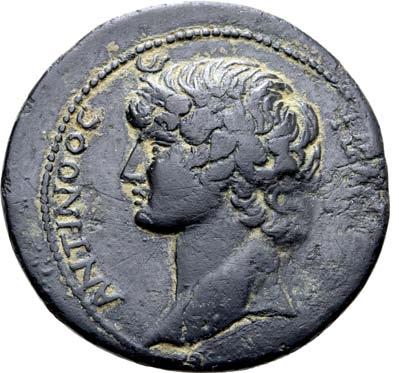
Very Fine; exceptional style with attractive earthen highlights. Extremely Rare; one of only two examples auctioned in the past 20 years.
This coin published at Roman Provincial Coinage Online (rpc.ashmus.ox.ac.uk); This coin published in R. Pudill, Antinoos: Münzen und Medaillons (2014); Ex collection formed in the Rhineland (with collector’s ticket); Ex Gorny & Mosch Giessener Münzhandlung 76, 22 April 1996, lot 337.
4,500
Antoninus Pius Æ 28mm of Palaeopolis, Pisidia. After AD 147. ΑVΤ ΚΑΙ

Extremely Fine; cleaning marks in fields; struck from dies of wonderful style.
Ex Auktionshaus H. D. Rauch GmbH, Auction 112, 10 June 2021, lot 708.
laureate head to right /
Zeus seated to left, holding thunderbolt and sceptre, eagle facing to lower right, head to left. RPC IV.3 Online 3316 (temporary); Von Aulock, Pisidien I, 1069-85; SNG Copenhagen 172. 10.42g, 28mm, 6h.


Antoninus Pius Æ Drachm of Alexandria, Egypt. Dated RY 10 = AD 146/7. AVT K T AIΛ AΔP ANTѠNЄINOC CЄB ЄYC, laureate head to right / L ΔEKATOY (date), Zeus, holding patera and sceptre, reclining to left on eagle standing facing with wings spread and head to right. RPC IV.4 Online 13589.66 (temporary, this coin cited); Dattari (Savio) pl. 155, 2933 bis (this coin). 25.76g, 35mm, 12h.
Extremely Fine; in outstanding condition for an Alexandrian drachm, and likely the finest known example of this particular type. Rare.
This coin published at Roman Provincial Coinage Online (rpc.ashmus.ox.ac.uk);



This coin published in A. Savio, Catalogo completo della collezione Dattari Numi Augg. Alexandrini (Trieste, 1999);
Ex Roma Numismatics Ltd., Auction XVIII, 29 September 2019, lot 766;
Ex Naville Numismatics Ltd., Auction 46, 27 January 2019, lot 279; Ex Giovanni Dattari Collection, formed in Egypt prior to 1901.

162
ΑΔΡ ΑΝΤΩΝЄΙΝΟϹ,
ΠΑΛΑΙΟΠΟΛЄΙΤΩΝ,
750
447.
448.
1,500
Ex Giovanni Dattari Collection
449.
Antoninus Pius Æ Drachm of Alexandria, Egypt. Dated RY 10 = AD 146/7. AVT K T AIΛ AΔP ANTѠNЄINOC CЄB ЄVC, laureate head to right / Hercules standing to right, holding lion’s skin and club, plucking an apple from the tree of the Hesperides; coiled body of the dead serpent Ladon around tree; [LΔE]KATOV (date) around. RPC IV.4 Online 13594 (temporary); Emmett 1554.10; Köln 1545; Dattari (Savio) 8495-6. 27.76g, 35mm, 12h.
Good Very Fine; lightly smoothed and tooled. Rare, relatively well preserved for the type. Ex Classical Numismatic Group, Triton XXV, 11 January 2022, lot 719 (hammer: USD 2,500).
A Sculptural Reverse
1,200
Commodus Æ 21mm of Elaea, Aeolis. AD 191-192. ΑVΤ Κ Λ ΑVΡ ΚOΜ[OΔ..], laureate, draped and cuirassed bust to right / [EΛ]ΑΙΤΩΝ, draped bust of Demeter (head assimilated to portrait of Crispina) to right, holding poppy and two ears of corn. RPC IV.2 Online 226 (temporary); BMC 47; SNG von Aulock 1614-5. 4.04g, 21mm, 6h.


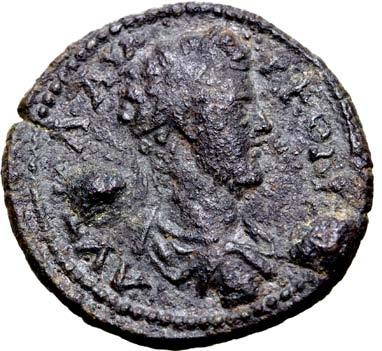

Very Fine. Rare, and with a beautiful reverse of sculptural quality.
Ex Roma Numismatics Ltd., E-Sale 93, 28 July 2022, lot 1341.

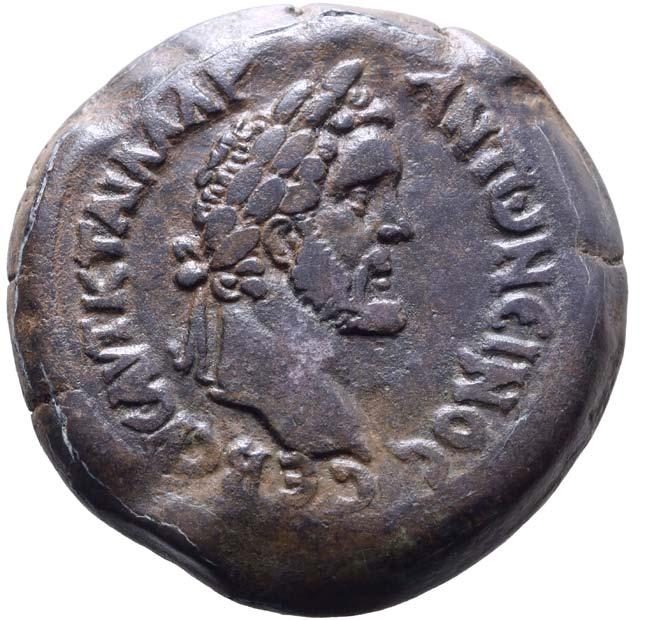
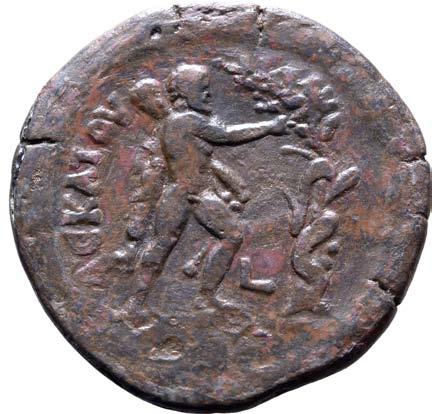

Septimius Severus AR Tetradrachm of Laodicea ad Mare, Seleucis and Pieria. AD 209-211. AVT KAI CЄOYHPOC CЄ, laureate and draped bust to right / ΔHMAPX ЄΞ VΠATOC Γ, eagle standing facing, head to left, with wings spread, holding wreath in beak; star between legs. Prieur & Amandry Group II, 22; Prieur 1140; McAlee, Severan, Group 2, 16. 13.14g, 27mm, 12h.



Good Extremely Fine.
Ex Conti Collection; Ex Philip T. Ashton Collection, Gemini LLC, Auction XIV, 18 April 2018, lot 538; Ex Classical Numismatic Group, Mail Bid Sale 58, 9 September 2001, lot 964.
Ex M&M, 1970
Caracalla Æ 25mm of Isaura, Cilicia. AD 198-217. ΑV Κ Μ ΑV ΑΝΤΩΝΙΝΟC, laureate and cuirassed bust to right, with aegis on breastplate / ΜΗΤΡΟΠΟΛΕΩC ΙCΑΥΡΩΝ, emperor standing to right, holding spear, receiving uncertain object from Apollo standing to left, holding laurel branch. SNG BnF 494-5 (same obv. die); SNG Levante - (but cf. 262); SNG von Aulock 5410. 9.53g, 25mm, 6h.

Extremely Fine; attractive dark green patina. Very Rare.
Ex collection of Regierungsrat Dr. iur. Hans Krähenbühl; Ex Münzen & Medaillen AG, Auction 41, 18-19 June 1970, lot 544.
163
450. 300
451. 300
450
452.
Hercules’ Eleventh Labour
Caracalla Æ 35mm of Tarsus, Cilicia. AD 198-217. [ΑΥΤ ΚΑ]Ι Μ ΑΥΡ CЄΥΗΡΟC ΑΝΤΩΝЄΙΝΟC CЄΒ, laureate head to left; Π-Π across fields / ΑΝΤΩΝΙΑΝΗC CЄΥἭ ΑΔΡ [ΜΗΤ], Hercules, holding lion skin, attacking the Hydra with club to left; ΤΑΡCΟΥ in exergue, Δ Ε Κ in two lines in lower central field. SNG Levante 1051; Voegtli 2q; SNG BnF -; SNG Von Aulock -. 16.88g, 35mm, 12h.

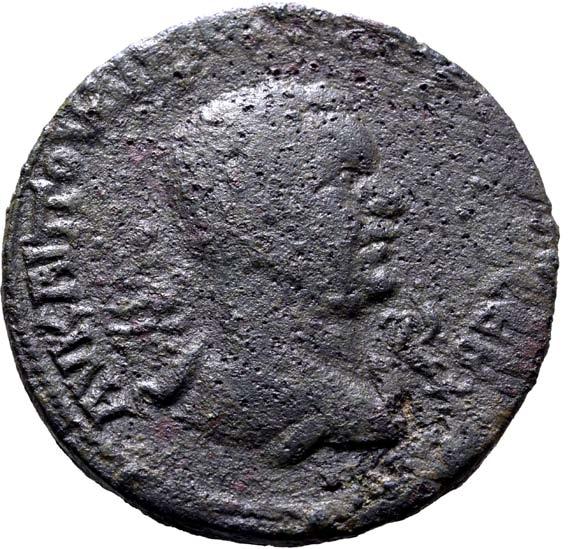
Good Very Fine. Very Rare.
The reverse of this coin depicts the second of Hercules’ Twelve Labours, the slaying of the so-called Lernaean Hydra, the lake-monster with many snake-like heads of which two would regrow for every one that was cut off. Hercules successfully defeated this creature with the help of his nephew Iolaus, who burnt the stumps of the monster’s heads after they had been cut off to stop them regrowing. The last, immortal, head of the Hydra was dealt with by burial deep within the ground.

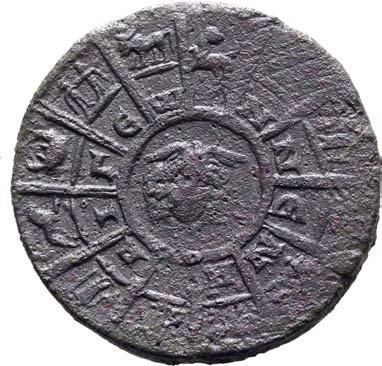


An Outstanding Portrait
Caracalla BI Tetradrachm of Hierapolis, Cyrrhestica. AD 215-217. ΑΥΤ Κ Μ Α ΑΝΤΩΝЄΙΝΟϹ ϹЄΒ, laureate, draped and cuirassed bust to right /
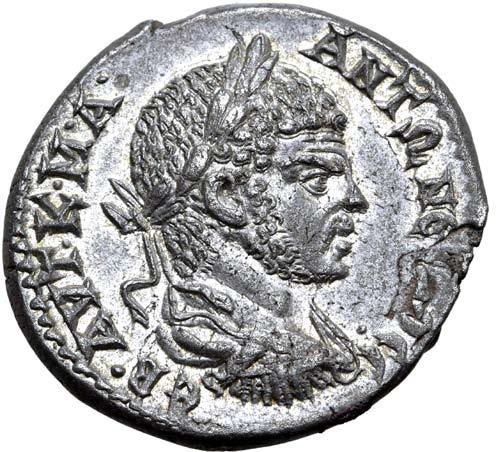


ΤΟ Δ, eagle standing facing, wings spread, head to right, wreath in beak; lion walking to right between legs. Prieur 929. 11.75g, 28mm, 12h.

Near Mint State; an outstanding portrait.
Ex Dr. Busso Peus Nachfolger, Auction 431, 27 April 2022, lot 3689; Acquired from Münzhandlung Ritter, Düsseldorf, 2002.
Valerian I Æ 31mm of Aegeae, Cilicia. AD 253-254. AV KAI ΠOV ΛIK [OVAΛЄPIANOC C]ЄB, laureate, draped and cuirassed(?) bust to right, holding serpent-entwined sceptre / Winged Gorgoneion facing slightly to right within Zodiac wheel, the innermost circle containing AIΓEѠN NE NA, the outermost containing the signs of the Zodiac. SNG BnF -, cf. 1803 for obverse; Anson 128, pl. XXI, 128 corr. (rev. legend); Künker 115, 733 (same rev. die); Haymann 239.2 = Berlin Münzkabinett no. 18234460 (same rev. die). 19.73g, 31mm, 6h.
Near Very Fine. Extremely Rare; only one other example on CoinArchives.
Ex Roma Numismatics Ltd., Auction XXIII, 24 March 2022, lot 534.
164
450
453.
ΔΗΜΑΡΧ ЄΞ ΥΠΑΤΟϹ
454. 300
455. 750
COINS OF THE ROMAN REPUBLIC
A Superior Example with an Exceptional Reverse
Anonymous AR Didrachm. Rome, 269-266 BC. Head of Hercules to right, wearing taenia, with club and lion-skin over shoulder / She-wolf standing to right, head to left, suckling the twins Romulus and Remus; ROMANO in exergue. Crawford 20/1; RBW 23 (Neapolis?); BMCRR Romano-Campanian 28; RSC 8. 7.30g, 20mm, 6h.
Extremely Fine; light cabinet tone. A superior example of the type, with arguably the best-preserved and well-detailed reverse for this issue present on CoinArchives.
From the Apollo to Apollo Collection.
While Pliny writes “the Roman people did not even use silver coin before the defeat of Pyrrhus” which took place in 275 BC, modern scholars can scarcely hope to be as categorical as the ancient author (NH xxxiii, 42). It is clear, however, that the silver didrachm emerged at some point during the early 3rd century BC, weighing around 6.8g or six scruples, consistent with the weight of a south Italian Greek didrachm. Thomsen suggested that this Hercules / Wolf type can be conclusively dated to 269 BC, since the type alludes to the consuls of that year, C. Fabius Pictor, of whom Hercules was the patron, and Q. Ogulnius L. f. Q. n. Gallus, whose ancestors Gnaeus and Quintus Ogulnius had as curule aediles used fines collected from violators of usury laws to erect a statue of the she-wolf in 296 BC (ERC III, p. 120). Mitchell, however, assigns the date of this issue much earlier, to the date of the statue’s erection, and argues that the legend ROMANO, which appears on four early didrachms, indicates that this coinage was struck outside Rome, as opposed to the later didrachms which bear the legend ROMA (‘A New Chronology for the Romano-Campanian Coins’, NC 1966, pp.66-7). Mattingly had suggested earlier that the latter legend “might seem to indicate the sovereignty of Rome more explicitly” (‘The Various Styles of the Roman Republican Coinage’, NC 1949, p.63.).




Crawford meanwhile believes that although basing the date upon the family histories of the consuls is misconceived, since he argues that it was in fact the censors who were responsible for issues of the didrachm (RRC p.714), he nonetheless also dates it to 269 BC noting that of the four issues of silver didrachms it is the first to bear distinctly Roman imagery. He suggests the portrait of Hercules may be that of Hercules Victor, which would be “highly suitable for a coinage struck from the spoils of war and perhaps reflecting the Roman ideology of military prowess” after the victory against Pyrrhus (RRC p.714).
Following the sporadic didrachm issues, the so-called Quadrigati emerged in the latter half of the 3rd century and were eventually issued in large quantities throughout the Punic Wars. At some point circa 214-212 the denomination was replaced by the denarius, a shift that would prove decisive and would dominate Roman coinage for centuries to come. Nevertheless, the wolf type, which is rendered for the first time so masterfully on this early didrachm, would endure as an iconic and patriotic symbol of Rome on coinage well into the imperial period and beyond, eventually achieving a satisfying historical circularity when it was employed on the municipal coinage of Rome under the Ostrogoths for what was to be the last issue of coinage struck by the ancient Romans in their own name.
165
456.
6,000
457.
Anonymous AR Didrachm. Rome, 269-266 BC. Head of Hercules to right, wearing taenia, with club and lion-skin over shoulder / She-wolf standing to right, head to left, suckling the twins Romulus and Remus; ROMANO in exergue. Crawford 20/1; RBW 23 (Neapolis?); BMCRR Romano-Campanian 28; RSC 8. 6.96g, 20mm, 6h.

Extremely Fine; magnificent dark old cabinet tone.
Privately purchased from Numismatics Ars Classica (ticket included).


One of the Most Beautiful Dies of the Whole Series
3,000
Anonymous AR Didrachm (Quadrigatus). Rome, circa 225-212 BC. Laureate head of Janus / Jupiter standing in galloping quadriga driven to right by Victory, holding sceptre and brandishing thunderbolt overhead; ROMA incuse on raised tablet below. Crawford 28/3; RBW 63 (note: possibly the first Quadrigatus of the whole series, due to broad flan); RSC 23. 6.57g, 25mm, 5h.





Extremely Fine; attractive light cabinet tone, struck on a broad planchet.
Acquired from Nomos AG.
Anonymous cast Æ As. Semilibral standard. Rome, circa 225-217 BC. Laureate and bearded head of Janus / Prow of galley to left; I (mark of value) above. Crawford 38/1; ICC 93. 119.05g, 53mm, 12h.
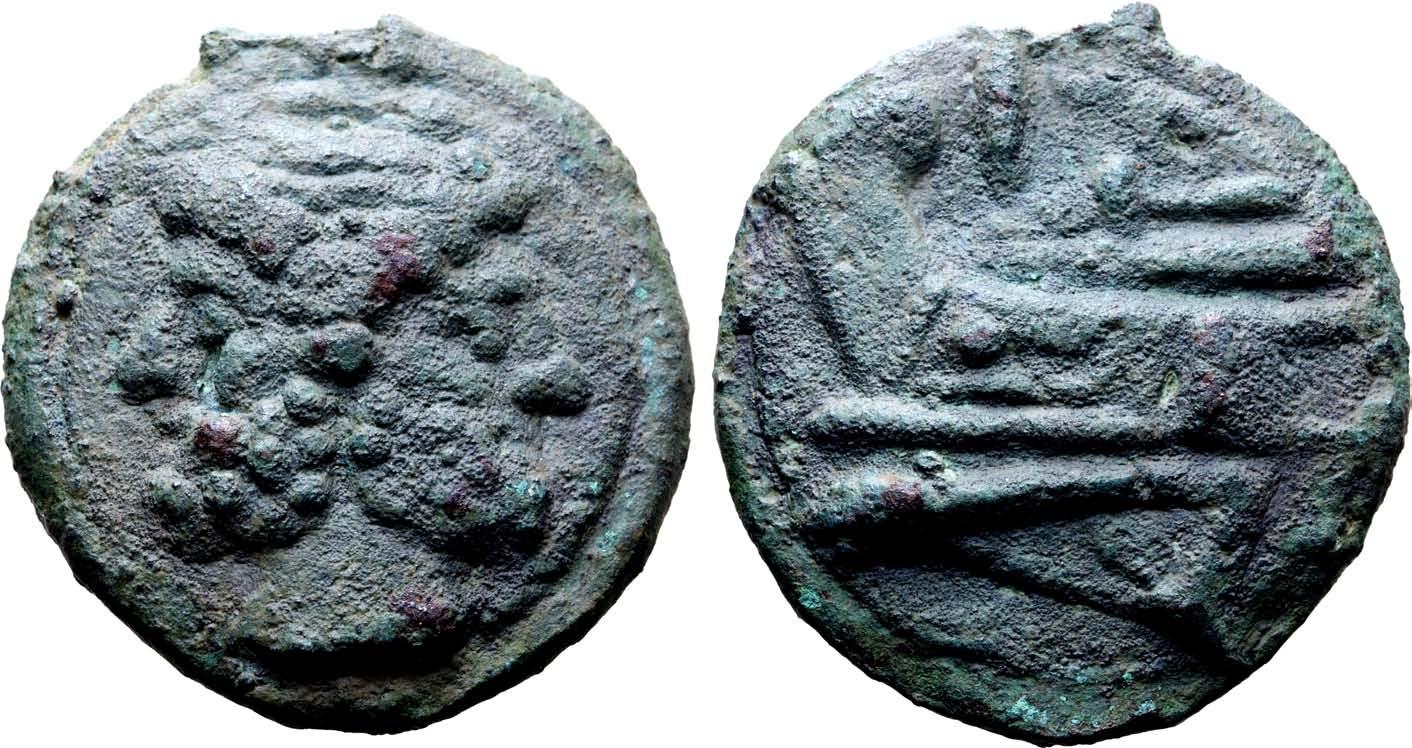
Good Very Fine.
Ex Vitangelo Collection, Roma Numismatics Ltd., E-Sale 82, 15 April 2021, lot 1013 (collector’s ticket included).
166
458. 600
459.
900
460.
Anonymous (L Series) cast Æ Sextans. Luceria, 214-212 BC. Laureate head of Saturn to right / Prow of galley to right; retrograde S (mark of value) above, L to right. Crawford 43/2a; ICC 114; RBW 151; CNG e-452, 661 (hammer: 800 USD). 39.31g, 37mm, 6h.
462.
Anonymous AR Victoriatus. Rome, after 211 BC. Laureate head of Jupiter to right / Victory standing to right, crowning trophy of arms; ROMA in exergue. Crawford 44/1; BMCRR Rome 297-9; RSC 9. 3.38g, 18mm, 12h.









463.
Extremely Fine; well-centred on a broad planchet.
From the Andrew McCabe Collection, collector’s ticket included; Acquired from Odysseus Numismatique (Montpelier, France). 90
Anonymous AR Denarius. Rome, 211-208 BC. Helmeted head of Roma to right; X (mark of value) behind / Dioscuri riding to right, each holding spear, star above each head; ROMA in linear frame below. Crawford 44/5; BMCRR Rome 1; RSC 2. 4.08g, 19mm, 9h.




Mint State; light cabinet tone.
Ex Roma Numismatics Ltd., Auction XXV, 22 September 2022, lot 818. 300
Very Fine.
From the Andrew McCabe Collection, collector’s ticket included; Acquired from A. H. Baldwin & Sons Ltd, 1992. 60
167
Very Fine. Rare. 360
461.
Anonymous Æ Semis. Rome, after 211 BC. Laureate head of Saturn to right; S (mark of value) behind / Prow of galley to right; S (mark of value) above; ROMA below. McCabe Group G1.Sm; Crawford 56/3; RBW 203-4. 19.89g, 27mm, 12h.
VB Series AR Victoriatus. Uncertain mint, 211-208 BC. Laureate head of Jupiter to right / Victory standing to right, crowning trophy with wreath; VB (ligate) in field, ROMA in exergue. Crawford 95/1a; BMCRR Italy 233-234; RSC 36m. 3.31g, 18mm, 3h.
464. 600
Mint State. Previously NGC graded MS (#4374443-094).
465. 600
VB Series AR Victoriatus. Uncertain mint, 211-208 BC. Laureate head of Jupiter to right / Victory standing to right, crowning trophy with wreath; VB (ligate) in field, ROMA in exergue. Crawford 95/1a; BMCRR Italy 233-234; RSC 36m. 3.13g, 17mm, 1h.
Mint State. Previously NGC graded MS (#4374443-062).
466. 600
467.
VB Series AR Victoriatus. Uncertain mint, 211-208 BC. Laureate head of Jupiter to right / Victory standing to right, crowning trophy with wreath; VB (ligate) in field, ROMA in exergue. Crawford 95/1a; BMCRR Italy 233-234; RSC 36m. 3.27g, 18mm, 3h.
Mint State. Previously NGC graded MS (#4374443-086).
468.
L Series AR Victoriatus. Luceria, 211-208 BC. Laureate head of Jupiter to right / Victory standing to right, crowning trophy with wreath; ⇂ in field, [R] OMA in exergue. Crawford 97/1a; BMCRR Italy 159; RSC 36e*. 3.01g, 17mm, 10h.


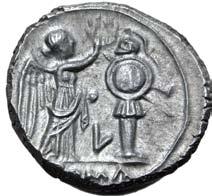



Mint State. Previously NGC graded MS, Fine Style (#4374443-155).
600
L Series AR Victoriatus. Luceria, 211-208 BC. Laureate head of Jupiter to right / Victory standing to right, crowning trophy with wreath; ⇂ in field, [ROMA] in exergue. Crawford 97/1b; BMCRR Italy 160-161; RSC 36e*. 3.58g, 16mm, 5h.


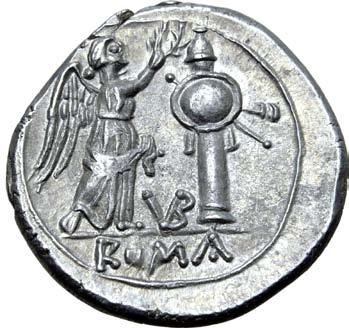








Mint State. Previously NGC graded MS (#4374448-005).
600
168
470.
Q Series AR Victoriatus. Apulia, 211-210 BC. Laureate head of Jupiter to right / Victory standing to right, crowning trophy with wreath; Q in field, ROMA in exergue. Crawford 102/1; BMCRR Italy 219-220; RSC 36k. 2.93g, 16mm, 3h. Mint State. Previously NGC graded MS, Fine Style (#4374477-230).
Q Series AR Victoriatus. Apulia, 211-210 BC. Laureate head of Jupiter to right / Victory standing to right, crowning trophy with wreath; Q in field, ROMA in exergue. Crawford 102/1; BMCRR Italy 219-220; RSC 36k. 2.94g, 17mm, 6h.

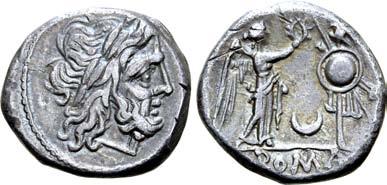
Good Extremely Fine. Previously NGC graded Ch AU (#4374477-186).
C Series AR Denarius. Etruria(?), 209-208 BC. Helmeted head of Roma to right; X (mark of value) behind / The Dioscuri, each holding spear, riding to right; C above; ROMA in linear frame in exergue. Crawford 107/1b; BMCRR Italy 182 & 184-5; RBW 495; RSC 32a. 4.38g, 20mm, 7h.



Good Extremely Fine; beautiful deep old cabinet tone with hints of blue iridescence around the devices. Rare.
From the Andrew McCabe Collection, collector’s tickets included; Ex RBW Collection; Ex Emporium Hamburg, Auction 39, 8 May 1998, lot 183 (hammer: DM 280).
Anonymous AR Victoriatus. Rome, circa 207 BC. Laureate head of Jupiter to right / Victory standing to right, crowning trophy with wreath; crescent in field, ROMA in exergue. Crawford 57/1; BMCRR Rome 436; RSC 24d. 3.00g, 16mm, 11h.
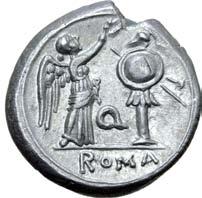
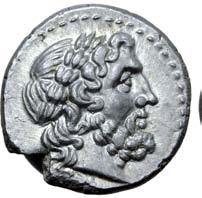









Near Extremely Fine; attractive old cabinet tone.
From the Andrew McCabe Collection, collector’s ticket included; Acquired from Tom Cederlind, 2001.
Pentagram Series AR Denarius. Uncertain mint, 206-200 BC. Helmeted head of Roma to right; X (mark of value) behind / The Dioscuri, each holding spear, riding to right; pentagram below, ROMA in linear frame below. Crawford 129/1; BMCRR Italy 293; RSC 20w. 3.42g, 19mm, 1h.
Near Extremely Fine. Scarce.
From the Andrew McCabe Collection, collector’s tickets included; Ex Nomisma S.p.a. (San Marino), Auction 65, 17 June 2022, lot 22.
169
469. 600
450
471. 180
472. 60
473. 180
474.
Caecilius Metellus Ӕ As. Rome, 194-190 BC. Laureate head of Janus / Prow to right; ME (ligate) above, I (mark of value) before, ROMA below. Crawford 132/3; Sydenham 319; RBW 585; Banti Caecilia 3/2 (this coin). 31.15g, 34mm, 6h.

Very Fine. Scarce.
This coin published in A. Banti, Corpus Nvmmorvm Romanorvm, Monetazione Republicana, Avidia - Calpvrnia (Firenze, 1980);


476.
Owl Series AR Denarius. Rome, 194-190 BC. Helmeted head of Roma to right; X (mark of value) behind / The Dioscuri, each holding spear, riding to right; owl below, ROMA in exergue. Crawford 135/1; BMCRR Italy 323; RSC 20v. 4.00g, 19mm, 12h.



Extremely Fine. Rare.
From the Andrew McCabe Collection, collector’s tickets included; Ex RBW Collection; Ex Goodman Collection, Classical Numismatic Group, Auction 43, 24 September 1997, lot 1416; With Herb Kreindler ticket. 180
Ex Centauro 2, 2007
Crescent Series AR Denarius. Rome, 194-190 BC. Helmeted head of Roma to right; X (mark of value) to left / The Dioscuri, each holding spear, riding to right; crescent above, ROMA below in linear frame. Crawford 137/1; BMCRR Rome 575; RSC 20i. 4.00g, 20mm, 9h.






Extremely Fine; attractive light cabinet tone with iridescent highlights around the devices.
From the Andrew McCabe Collection, collector’s tickets included; Acquired from London Coin Galleries; Ex Artemide Aste s.r.l. (San Marino), Auction XXXIX, 30 November 2013, lot 114; Ex Centauro, Auction 2, 18 May 2007, lot 43. 300
477. 300
Good Extremely Fine; beautiful old cabinet tone with attractive hints of iridescence around devices.
170
From the Andrew McCabe Collection, collector’s tickets included; Ex RBW Collection; Ex Gerhard Hirsch Nachfolger, Auction 156, 25 November 1987, lot 324 (hammer: DM 360); Ex Münzzentrum Albrecht, Auction XXX, 21 November 1977, lot 177. 120
475.
Matienus AR Denarius. Rome, 179-170 BC. Helmeted head of Roma to right; X behind / The Dioscuri, each holding spear, riding to right; MAT (ligate) below, ROMA in exergue. Crawford 162/2a; BMCRR Italy 399; RSC Matiena 2. 3.86g, 20mm, 2h.
478.
Ex Baldwin & Glendining, 1975
L. Saufeius AR Denarius. Rome, 152 BC. Helmeted head of Roma to right; X (mark of value) behind / Victory driving galloping biga to right, holding reins and whip; L•SAVF (partially ligate) below horses, ROMA within linear frame in exergue. Crawford 204/1; BMCRR Rome 835; RSC Saufeia 1. 3.69g, 19mm, 7h.


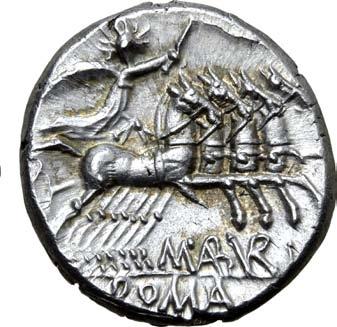

Near Mint State; wonderful old cabinet tone.
Ex Chaponnière & Firmenich, Auction 13, 16 May 2021, lot 230; Ex Dr. Harwood Collection, Baldwin & Glendining, Roman Coins, 8 October 1975, lot 26.
479.
L. Sempronius Pitio AR Denarius. Rome, 148 BC. Helmeted head of Roma to right; PITIO downwards behind, X (mark of value) below chin / The Dioscuri, each holding spear, riding to right; L•SEMP below, ROMA within linear frame in exergue. Crawford 216/1; BMCRR Rome 711-715; RSC


Sempronia 2. 3.92g, 20mm, 3h.
Extremely Fine.
Acquired from Artemide Aste s.r.l.
Unusually Complete
480.
C. Servilius M. f. AR Denarius. Rome, 136 BC. Helmeted head of Roma to right; wreath and mark of value behind, ROMA below / The Dioscuri galloping in opposite directions, heads reverted, holding spears; two stars above, C•SERVEILI• M•F in exergue. Crawford 239/1; BMCRR Italy 540; RSC Servilia 1. 3.93g, 21mm, 5h.
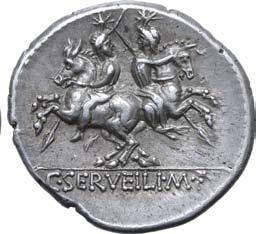
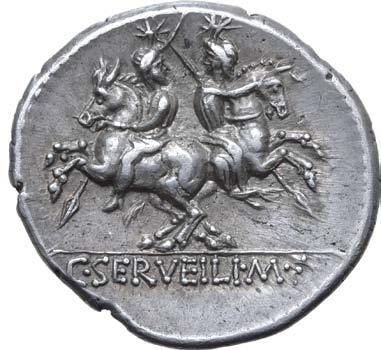






M. Aburius M. f. Geminus AR Denarius. Rome, 132 BC. Helmeted head of Roma to right; GEM behind, mark of value below chin / Sol driving galloping quadriga to right; M•ABVRI (partially ligate) below, ROMA in exergue. Crawford 250/1; BMCRR Rome 995-7; RSC Aburia 6. 3.95g, 18mm, 2h.
Mint State.
Acquired from Classical Numismatic Group. 240
171
300
180
Good Extremely Fine; attractive iridescence around devices, unusually complete for the issue. From the Andrew McCabe Collection, collector’s tickets included; Ex Ira & Larry Goldberg Coins & Collectibles, Auction 103, 20 February 2018, lot 2160. 450
481.
482.
A Very Rare No Bell Die
L. Caecilius Metellus Diadematus AR Denarius. Rome, 128 BC. Helmeted head of Roma to right; mark of value behind / Pax driving galloping biga to right, holding olive branch, sceptre, and reins; elephant’s head below, ROMA in exergue. Crawford 262/1; BMCRR Rome 1044; RSC Caecilia 38. 3.91g, 19mm, 12h.


Good Extremely Fine; attractive iridescent highlights. Very Rare without bell around elephant head. From the Andrew McCabe Collection, collector’s tickets included; Ex Numismatica Ars Classica, Auction 78, 26 May 2014, lot 592; Ex Raffaele Negrini, Auction 24, 30 November 2006, lot 46.
Crawford notes that the bell around the elephant’s head is ‘occasionally missing’ on this issue (p. 287) however this is somewhat of an understatement for Richard Schaefer only identified three no-bell dies from over fifty in RRDP
Q. Fabius Maximus AR Denarius. Rome, 127 BC. Helmeted head of Roma to right; mark of value below chin, ROMA behind, Q•MAX before / Cornucopiae superimposed on thunderbolt, all within wreath. Crawford 265/1; RBW 1073; RSC Fabia 5. 3.95g, 18mm, 12h.
T. Quinctius Flamininus AR Denarius. Rome, 126 BC. Helmeted bust of Roma to right; flamen’s cap behind, mark of value below chin / The Dioscuri riding to right, each holding couched lance, stars above; Macedonian shield between T-Q below, ROMA in exergue. Crawford 267/1; BMCRR Rome 1038; RSC Quinctia 2. 3.94g, 17mm, 3h.
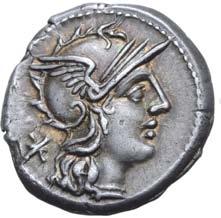

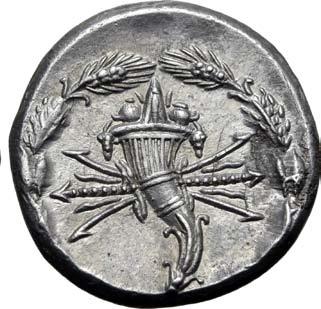




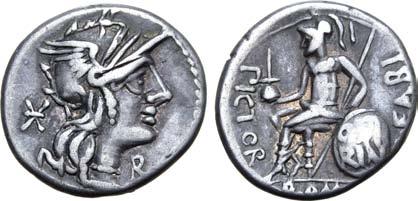
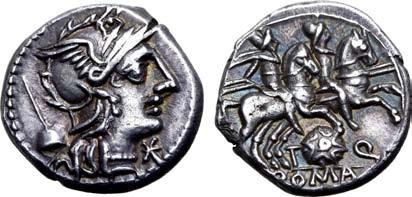
Extremely Fine; attractive old cabinet tone.
Ex American collection of Roman Republican and Imperatorial coins; Ex Artemide Aste s.r.l., Auction XXXIII, 2 July 2011, lot 67 (lot ticket included).
With Provenance Dating Back to 1856
Numerius Fabius Pictor AR Denarius. Rome, 126 BC. Helmeted head of Roma to right; R below chin, mark of value behind / The Flamen Quirinalis: Q. Fabius Pictor, seated to left, holding apex and spear, with shield at side inscribed QVIRIN in two lines; N•FABI to right, PICTOR to left, I (control letter) above, ROMA in exergue. Crawford 268/1b; BMCRR Rome 1177-8 var. (control letter on rev.); RSC Fabia 11. 3.37g, 18mm, 2h.

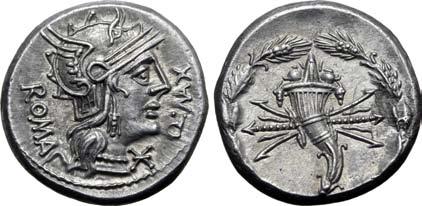
Very Fine.
This coin cited in Rear Admiral W. H. Smyth, Descriptive Catalogue of a Cabinet of Roman Family Coins belonging to His Grace the Duke of Northumberland, K.G., (Oxford, 1856), p. 75, Tablet VII, Coin 9; From the Andrew McCabe Collection, collector’s tickets included; Acquired from Del Parker at NYINC, 2019; Ex Dr. Flynn Collection, Noble Numismatics Pty Ltd, Auction 107, 18 November 2014, lot 3592; Ex Colin Pitchfork Collection (confirmed by correspondence); Ex His Grace the Duke of Northumberland K.G., P.C., G.C.V.O., F.R.S Collection, removed from Alnwick Castle, Sotheby, 4 November 1982, lot 253.
172
150
Mint State. 483.
300
484. 210
485. 300
Ex Artemide 2011
T. Didius AR Denarius. Rome, 113-112 BC. Helmeted head of Roma to right; monogram of ROMA behind, [mark of value below] / Two gladiators fighting, each holding shield, one attacking to right with flail, the other defending to left with sword; T•DEIDI in exergue. Crawford 294/1; BMCRR Italy 530; RSC Didia 2. 3.87g, 19mm, 8h.


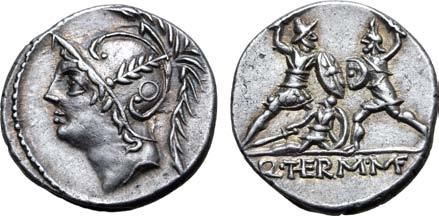
Near Extremely Fine.
Ex Numismatica Varesi, Auction 65, 30 October 2014, lot 67; Ex Astarte S.A., Auction XVI, 26 November 2004, lot 1260.






Babelon suggests that the reverse type refers to the moneyer’s ancestor T. Didius, who was sent to Sicily in 138 BC to quash a slave revolt that was ultimately the precursor to the first of the three Servile Wars. Crawford disagrees, suggesting that the reverse depicts a scene one would expect to witness at the games T. Didius promised to put on during his time as aedile, making this issue an example of electoral propaganda.
Mn. Fonteius AR Denarius. Rome, 108-107 BC. Laureate and jugate heads of the Dioscuri to right; mark of value before / Galley to right; MN•FONTEI (partially ligate) above, C below. Crawford 307/1b; BMCRR Rome 1206; RSC Fonteia 8. 3.84g, 21mm, 3h.
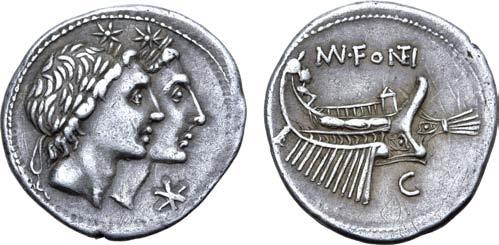
Near Extremely Fine.
From the Andrew McCabe Collection, collector’s tickets included; Acquired from Apollo Numismatics (Merrill Gibson); Ex Dr. Nicholas Lowe Collection, Roma Numismatics Ltd., Auction XVIII, 29 September 2019, lot 829 (hammer: 650 GBP); Ex Astarte S.A., Auction V, 28 October 1999, lot 504.
Q. Minucius Thermus M. f. AR Denarius. Rome, 103 BC. Helmeted head of Mars to left / Two warriors in combat, each brandishing sword and shield, one on left protecting a fallen comrade below; Q•THERM•MF (partially ligate) in exergue. Crawford 319/1; BMCRR Italy 653; RSC Minucia 19; RBW 1174. 4.00g, 18mm, 10h.


Good Extremely Fine; well-centered.
Ex American collection of Roman Republican and Imperatorial coins; Privately purchased from Calicó (collector’s ticket included).
This coin records the brave deeds of the moneyer’s ancestor and namesake, Quintus Minucius Q. f. L. n. Thermus, who was elected consul in 193 and assigned Liguria as his province. From his base in Pisa, he waged war against the Ligurians. His command was extended for the following year, during which time he defeated the Ligurian forces near Pisa. He remained as proconsul in Liguria for 191–190 BC. During this time it appears that he may have won the distinction of the corona civica, the second highest military award to which a Roman could aspire, by saving the life of a fellow citizen in battle through slaying an enemy on a spot not further held by the enemy army that day - this act being depicted on the reverse.
He may also have been the same Thermus who served as military tribune under Scipio in North Africa in 202 BC. Appian relates that about this time there was a cavalry engagement between the forces of Hannibal and those of Scipio near Zama, in which the latter had the advantage. On the succeeding days they had sundry skirmishes until Scipio, learning that Hannibal was very short of supplies and was expecting a convoy, sent the military tribune, [Quintus Minucius] Thermus, by night to attack the supply train. Thermus took a position on the crest of a hill at a narrow pass, where he killed 4,000 Africans, took as many more prisoners, and brought the supplies to
173
486. 450
487. 300
488. 600
Scipio.
489. 300
M. Lucilius Rufus AR Denarius. Rome, 101 BC. Helmeted head of Roma to right; PV behind, all within laurel wreath / Victory in biga to right; RVF above, M•LVCIL[I] in exergue. Crawford 324/1; BMCRR Rome 1613; RSC Lucilia 1. 3.86g, 19mm, 12h. Mint State; attractive hints of iridescence around devices. Ex Vitangelo Collection; collector’s ticket included, Roma Numismatics Ltd., E-Sale 98, 16 June 2022, lot 1038.
492.
Published
in
493.
P. Cornelius Lentulus M. f. AR Denarius. Rome, 100 BC. Bust of Hercules to right, seen from behind, holding club; shield in left field, K (control mark) before, ROMA below / Roma standing facing, holding spear and wearing triple-crested helmet, crowned by Genius of the Roman People standing to left and holding cornucopiae; K (control mark) in left field, LENT•MAR•F (partially ligate) in exergue; all within laurel wreath. Crawford 329/1b; BMCRR Rome 1717; CNR Cornelia 38/9 (this coin); RSC Cornelia 25a. 3.94g, 20mm, 12h.
Good Extremely Fine; attractive old cabinet tone with golden iridescence around the devices. This coin published in A. Banti. Corpus Nummorum Romanorum, Monetazione Repubblicana (Firenze, 1980-1982); Ex Vogelberg Collection (Switzerland), formed c. 1960-1985, Roma Numismatics Ltd., Auction XXV, 22 September 2022, lot 729.
C. Poblicius Malleolus, A. Postumius Sp. f. Albinus and L. Metellus AR Denarius. Rome, 96 BC. Laureate head of Apollo to right; star below, [A•ALB•S•F] upwards before, L•METE[L] downwards behind / Roma seated to left on pile of shields, holding sword and spear, being crowned by Victory standing behind; C•MALL (ligate) downwards in left field, ROMA in exergue. Crawford 335/1b; BMCRR Italy 730; RSC Poblicia 3, Postumia 3 and Caecilia 45; RBW 1201. 4.03g, 19mm, 4h.
Good Extremely Fine; attractive hints of iridescence.
Ex American collection of Roman Republican and Imperatorial coins; Privately purchased at the New York International Numismatic Convention in 2002 from Tamco Numismatics (collector’s ticket included).
L. Calpurnius Piso Frugi AR Denarius. Rome, 90 BC. Head of Apollo to right; axe behind, O below chin / Horseman galloping to right, carrying palm over shoulder and holding reins; L PISO FRVGI below, flute above, V below. Crawford 340/1; cf. BMCRR Rome 1938; RSC Calpurnia 11. 3.82g, 18mm, 2h.





Near Mint State.
L. Titurius L. f. Sabinus AR Denarius. Rome, 89 BC. Bearded head of the Sabine king Tatius to right; SABIN downwards behind, palm branch below chin / Tarpeia buried to waist in shields, thrusting off two soldiers about to cast their shields at her; star in crescent above, L•TITVRI in exergue. Crawford 344/2b; BMCRR Rome 2328; Sydenham 699; RSC Tituria 4. 3.99g, 18mm, 6h.






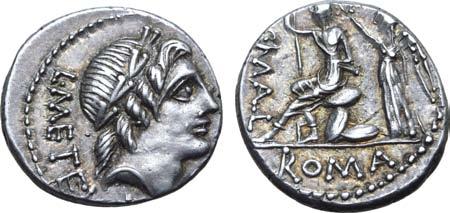

Near Mint State; beautiful old cabinet tone with hints of golden iridescence, a truly exceptional example of this desirable type.
Ex Santana Collection, Roma Numismatics Ltd., Auction XXIII, 24 March 2022, lot 568; Ex Roma Numismatics Ltd., Auction XIX, 26 March 2020, lot 699 (hammer: 3,400 GBP); Ex Classical Numismatic Group, Triton XII, 6 January 2009, lot 477; Ex Harlan J. Berk Ltd, Sale 112, 13 January 2000, lot 332.
174
490. 900
491. 150
Ex Marti Hervera and Soler & Llach, Auction 1127, 14 June 2022, lot 66. 180
Banti, Corpus Nummorum Romanorum
1,050
An Exceptional Example
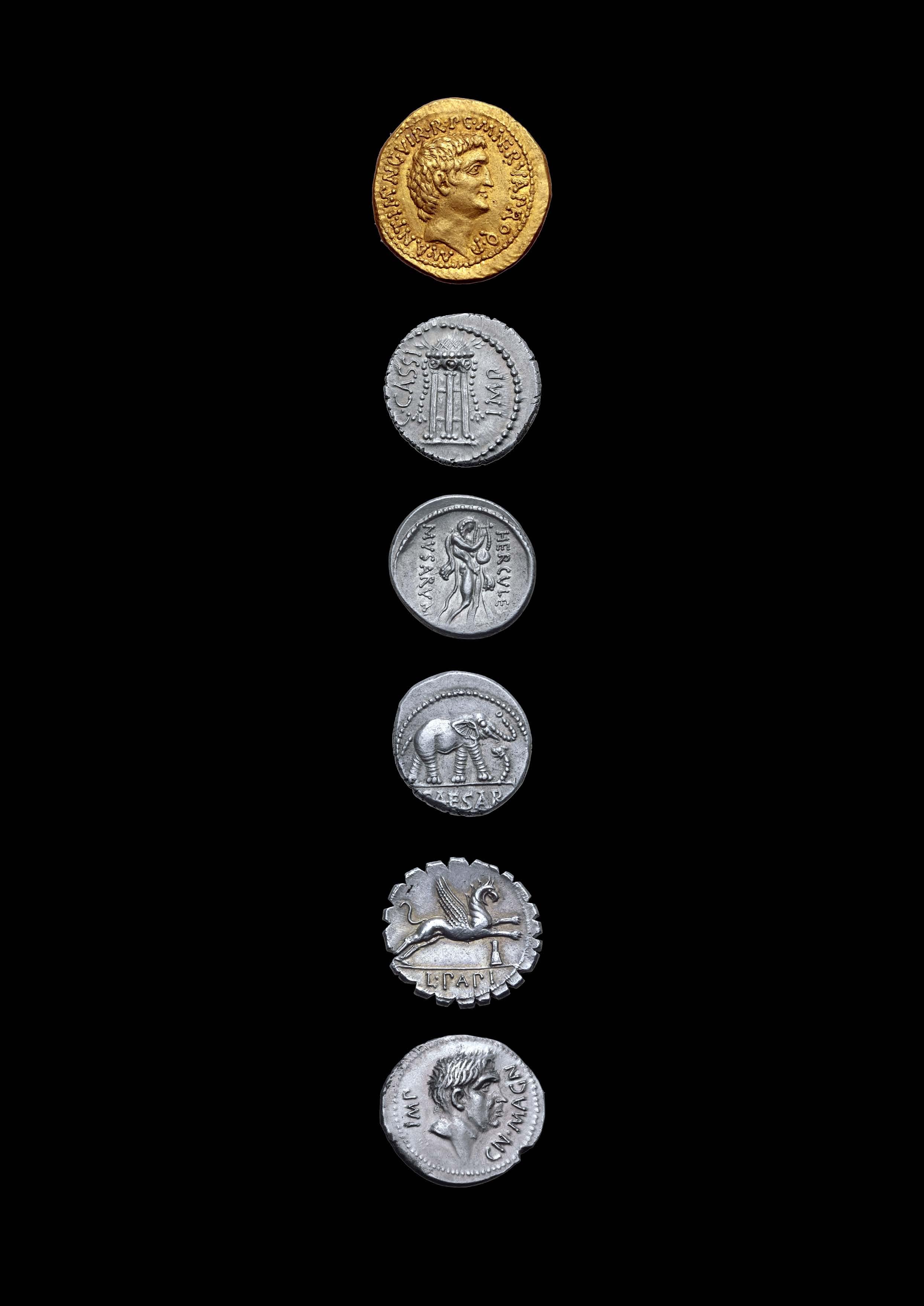
A Unique Sestertius of the Roman Republic
C. Licinius L. f. Macer AR Sestertius. Rome, 84 BC. Bearded Gallic male head to right, with dishevelled hair and prominent moustache, pierced through by or superimposed over a dart (or ritually bent spear?) / Legionary boar-tipped standard; IIS with bar (mark of value) to right, C• LICINI•L F MACER in two lines in exergue. Crawford -; Sydenham -; BMCRR -; RBW -; unpublished in the standard references on the Roman Republic; for the only other known silver denomination issued C. Licinius L.f. Macer cf. Crawford 354/1 and RSC Licinia 16. 0.87g, 12mm, 11h.


Extremely Fine. Unique and of considerable numismatic importance.
Ex Long Valley River Collection, Roma Numismatics Ltd., Auction XX, 29 October 2020, lot 416; Acquired from Artemide Aste s.r.l. (San Marino), with detailed XRF analysis report of both metal and corrosion products demonstrating perfect consistency with coins of the period.
The C. Licinius Macer responsible for this striking of this remarkable silver sestertius is to be identified with the historian and annalist frequently mentioned by Livy: one of the tresviri monetales with C. Cassius and L. Salinator in 84 BC; tribune in 73; praetor in 68; impeached for extortion by Cicero in 66, he took his own life to avoid the public disgrace. Macer is known to have written a history of Rome in 16 books, now lost, which Livy consulted but casts doubt on its reliability, suggesting that he misrepresented events in order to glorify the Licinii (Livy, 7.9.5).
This unique coin is unparalleled or noteworthy in several respects, not least on account of the supposed minting date for the denomination, the denominational notation itself, and the iconography employed.
The denominational structure of the Republican coinage was prescribed by the well attested Lex Clodia, believed to have been passed in circa 101 BC, and the Lex Papiria in circa 91 BC, though as is often the case, the dates for these laws are inferred but by no means certain (cf. Crawford p.77, 61011). The Lex Clodia legalised the existing issues of Victoriati, and Crawford notes that “although there were considerable periods in the first century BC when the new quinarius was not issued, Pliny implies that the Lex Clodia continued to be regarded as the source of authority for the issue of the quinarius to the end of the Republic and beyond.” In contrast to the Lex Clodia, the motive for the Lex Papiria was to authorise the issue of bronze denominations on a greatly reduced standard. Fully half the weight of the existing bronzes, the coins of semuncial weight standard consequently bore the legend L.P.D.A.P. (lege Papiria de assis/aeris pondere), clearly identifying them as correct and legal tender under the authority of the Lex Papiria.
The revival of the sestertius, which had not been struck for over a century, was accomplished at the same time; given the length of time during which this denomination had been allowed to lapse Crawford argues that a law may have been considered necessary to ensure its reimplementation and acceptance. Hence it is no surprise that the Lex Papiria sestertii issued under D. Silanus and L. Piso Frugi also bear the formula E.L.P. (e lege Papiria). He furthermore reasonably argues that “the Lex Papiria may have been taken to have provided authority for the issue of the silver sestertius to the end of the Republic.” Certainly the plethora of silver sestertii struck in the 40s BC make no mention of the law, as is the case with the present coin; but then after the first year of issue, there would be no reason to do so – hence the absence of the L.P.D.A.P. formula on bronze after the very first issues of the reintroduced semuncial standard.
The denominational notation of the sestertius on the early Roman silver coinage was commonly rendered as IIS (= two asses and a semis = two and a half asses = ¼ of a denarius). Thus when the denarius was retariffed to 16 asses so then was the sestertius revalued at 4 asses. It is easy to see that having dropped the by now unnecessary formula of E.L.P., the denomination of this issue needed to be rendered in a clear form: hence it is obvious that the usage of IIS (struck through with horizontal bar) is to clearly denote the value as being 4 asses, not what would be explicitly 2.5 asses if the mark of value were the old IIS. This logically follows on from the ‘XVI’ monogram for the retariffed denarius’ mark of value, which is in fact also an X struck through with a horizontal bar.

Doubts about the authenticity of this coin have centred on this struck-through IIS notation, which is often erroneously believed to be a modern shorthand, but which is well attested as being in common (and numismatic) usage during Roman times, at least as early as 38-37 BC if not in fact much sooner. The fleet coinage of Mark Antony (see RPC I 1468; CRI 291) for a sestertius employing the same IIS struck through with horizontal bar. For another particularly interesting example of quotidian character, preserved by chance as an inscription scratched on a wall in Pompei, a reward is offered for a lost article see August Mau, Pompeii, Its Life and Art, 1902, p. 490: Insula VIII. v.-vi.: “A copper pot has been taken from this shop. Whoever brings it back will receive 65 sesterces. If anyone shall hand over the thief...” (the rest of the inscription is illegible) - the notation of sestertius with horizontal bar is clear.
The iconography of the coin is furthermore worthy of mention. That the obverse is anepigraphic is not at all unusual – so too were the sestertii of L. Calpurnius Piso Frugi in 90 BC (Crawford 340/3b). That the type appears to be the head of a Gaul pierced by a spear or dart-weapon is more astonishing; only the denarii of M. Sergius Silus (286/1) and L. Titurius Sabinus (344/2) bear similarly gruesome imagery – the former depicting a Roman cavalryman bearing aloft a decapitated head, and the latter illustrating the ill-fated Tarpeia being crushed to death by Sabine soldiers. Appearances may be deceiving however; perhaps the intent was to depict the object as being behind the head, rather than through it. In this case there is the possibility that the image here is connected to Celtic practices of ritually bending weapons before depositing them in burials or as votive offerings at religious sanctuaries. This much is uncertain, but what is clear is that the types here: the head of the Gaul, together with the Legionary boar-standard on the reverse, appear deeply personal; doubtless it is one of the many references, veiled or explicit, to the deeds of a moneyer ’s ancestors of which either no record survives or to which we may not attribute the identity of their author
That a hitherto unknown sestertius type should be discovered is hardly surprising. Crawford acknowledged in concept the possible existence of unknown fractions; the known denarii of Silanus and Piso Frugi exist in no great numbers, and they being the first year of issue when we must assume a significant number were produced given their explicit authorisation under the Lex Papiria. It is furthermore worth considering that from 88 to 63 BC the Roman treasury was so chronically and desperately short of money that it could not afford to finance the armies of Sulla in 88 or of L. Valerius Flaccus in 85. Instead, temple treasures were sold or melted down at home, and the wealth of both Greece and Asia was expropriated by Roman generals in the absence of money from Rome. It may well be in this context of both cash shortage and high state expenditure as the First Mithradatic War drew to a close and the impending civil war with Sulla loomed that the production of silver sestertii was not accorded anything but low priority

176
12,000 494. 2x 2x


177
L. Censorinus, P. Crepusius, and C. Limetanus AR Denarius. Rome, 82 BC. Veiled, diademed and draped bust of Venus to right; L•CENSORIN behind / Venus driving biga to right, holding goad and reins; XXVIIII (control number) above, C•LIMETA (partially ligate) below, P•CREPVSI in exergue. Crawford 360/1b; BMCRR Rome 2642 var. (control number); RSC Marcia 27. 3.73g, 18mm, 5h.

Good Extremely Fine; lustrous metal.
Ex Scipio Collection;
Ex Numismatica Ars Classica, Auction 11, 29 April 1998, lot 226.
P. Crepusius AR Denarius. Rome, 82 BC. Laureate head of Apollo to right; sceptre and M (control letter) behind, [vine leaf] before / Horseman to right, brandishing spear; [CVII] (control number) behind, P•CREPVSI in exergue. Crawford 361/1c; BMCRR Rome 2683; RSC Crepusia 1. 3.71g, 18mm, 5h.






Mint State; beautiful old cabinet tone, a wonderful portrait.
Ex American collection of Roman Republican and Imperatorial coins; Ex A. Lynn Collection, Freeman & Sear Manhattan Sale I, 5 January 2010, lot 144 (original ticket included).
Q. Caecilius Metellus Pius AR Denarius. North Italy, 81 BC. Diademed head of Pietas to right; stork standing to right before / Elephant walking to left; Q•C•M•P•I in exergue. Crawford 374/1; Sydenham 750; BMCRR Spain 43-46; RSC Caecilia 43; RBW 1396. 3.68g, 18mm, 6h.

Good Extremely Fine.
Ex Classical Numismatic Group, Auction 115, 16 September 2020, lot 560.
Ex M&M 52, 1975
L. Cornelius Sulla AR Denarius. Uncertain mint, 81 BC. Diademed head of Venus to right; D(?) behind / EX SC, cornucopiae; all within wreath. Crawford 376/1; Sydenham 763; RSC Cornelia 44; FFC 663 (this coin). 3.65g, 19mm, 4h.






Good Extremely Fine; lustrous metal. Rare, and in excellent condition for the type, struck on an uncommonly broad planchet.
This coin published in Richard Schaefer’s Roman Republican Die Project (RRDP), binder 5, p. 224, available online at: http://numismatics.org/ archives/ark:/53695/schaefer.rrdp.b05#schaefer.rrdp.b05_0308;
This coin published in Fernández, Fernández & Calicó, Catálogo Monográfico de los Denarios de la República Romana (2002);
Ex Roma Numismatics Ltd., Auction XX, 29 October 2020, lot 421; Ex Alba Longa Collection;
Ex Leo Benz Collection, Numismatik Lanz München, Auction 94, 23 November 1998, lot 310;
Ex Classical Numismatic Group, Auction 50, 23 June 1999, lot 1311; Ex Münzen & Medaillen AG Basel, Auction 52, 19 June 1975, lot 343.
178
496. 180
495. 450
497. 240
498. 2,400
Exceptionally Heavy
L. Cornelius Sulla AR Denarius. Uncertain mint, 81 BC. Diademed head of Venus to right; E behind / Cornucopiae; EX upwards to right, S•C downwards to left; all within wreath. Crawford 376/1; Sydenham 763; RSC Cornelia 44. 4.19g, 19mm, 3h.
Good Very Fine; obv. field lightly buffed, exceptionally heavy. Very Rare, and well-struck on an uncommonly broad planchet.
From the Andrew McCabe Collection, collector’s ticket included; Ex Ernst Ploil Collection, Numismatica Ars Classica, Auction 101, 24 October 2017, lot 7; Ex Luc Girard Collection, Numismatica Ars Classica, Auction 54, 24 March 2010, lot 212.
1,200
L. Procilius AR Denarius. Rome, 80 BC. Laureate head of Jupiter to right; S•C downwards behind / Juno Sospita advancing to right, hurling spear and holding shield decorated with thunderbolt; serpent to right, L•PROCILI•F downwards in two lines to left. Crawford 379/1; BMCRR Rome 3147-9; RSC Procilia 1. 4.07g, 19mm, 4h.
Extremely Fine; edge chip, beautiful old cabinet tone.
Ex American collection of Roman Republican and Imperatorial coins; Ex iNumis Mail Bid Sale 17, 23 March 2012, lot 117.

C. Poblicius Q. f. AR Serrate Denarius. Rome, 80 BC. Helmeted and draped bust of Roma to right; R (control letter) above, ROMΔ downwards behind / Hercules standing to left, strangling the Nemean lion; club at feet, bow and arrows in bowcase to lower left, R (control letter) to upper left, C•POBLICI•Q•F upwards on right. Crawford 380/1; BMCRR Rome 2912; RSC Poblicia 9 corr. (rev. legend). 3.78g, 18mm, 9h.


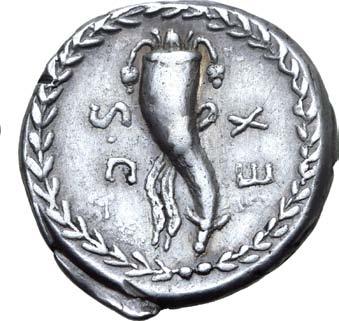

Extremely Fine.
This coin published in Richard Schaefer’s Roman Republican Die Project (RRDP), processed clippings, 380_QRST_sd, available online at: http:// numismatics.org/archives/ark:/53695/schaefer.rrdp.processed_300-399#schaefer_clippings_output_380_QRST_sd; Ex Numismatik Lanz München, Auction 123, 30 May 2005, lot 300.
L. Papius AR Serrate Denarius. Rome, 79 BC. Head of Juno Sospita to right, wearing goat skin headdress; tanner’s knife (control symbol) behind / Griffin springing to right; tanner’s scraper (control symbol) below, L•PAPI in exergue. Crawford 384/1 (symbols 76); BMCRR Rome 3061; RSC Papia 1. 3.88g, 19mm, 7h.





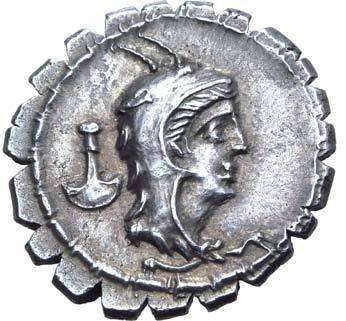



Near Mint State.
From the Andrew McCabe Collection, collector’s tickets included; Acquired from Shanna Schmidt Numismatics; Ex Numismatica Varesi, “Cesare” Auction, 7 April 2018, lot 303.
179
500. 180
499.
501. 180
502. 450
L. Rutilius Flaccus AR Denarius. Rome, 77 BC. Helmeted head of Roma to right; FLAC downwards behind / Victory, holding reins and wreath aloft, driving galloping biga to right; L•RVTILI in exergue. Crawford 387/1; BMCRR Rome 3244; RSC Rutilia 1a. 3.92g, 19mm, 6h.







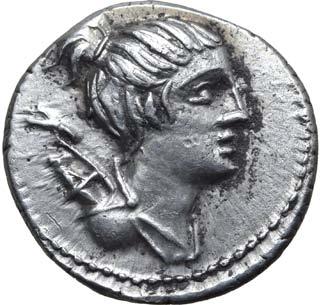




Good Very Fine; attractive iridescence.
Ex American collection of Roman Republican and Imperatorial coins; Privately purchased from Harlan J. Berk Ltd, dealer and collector ’s tickets included.
Ex Künker 2002
L. Rustius AR Denarius. Rome, 76 BC. Helmeted head of Mars to right; S•C behind, mark of value
before / Ram standing to right; L•RVSTI in exergue. Crawford 389/1; BMCRR Rome 3271; RSC Rustia 1. 3.95g, 19mm, 6h.
Extremely Fine; beautiful old cabinet tone with iridescence around devices.
Ex American collection of Roman Republican and Imperatorial coins; Ex Fritz Rudolf Künker GmbH & Co. KG, Auction 71, 12 March 2002, lot 584.
Engraved in Unusually Fine Style
Cn. Lentulus AR Denarius. Uncertain Spanish mint, 76-75 BC. Diademed and draped bust of Genius Populi Romani to right, holding sceptre over shoulder; G•P•R above / Sceptre with wreath, globe and rudder; EX•-S•C across fields, CN•LEN•Q in exergue. Crawford 393/1a; BMCRR Spain 52; RSC Cornelia 54. 3.91g, 19mm, 7h.


Near Extremely Fine; engraved in very fine style unusual to this issue.
From the Andrew McCabe Collection, collector’s ticket included; Acquired from Marc de Cock, Belgium.
C. Postumius AR Denarius. Rome, 74 BC. Draped bust of Diana to right, bow and quiver over shoulder / Hound running to right, spear below; [C•P] OSTVM[I], in exergue. Crawford 394/1b; BMCRR Rome 3238 var. (rev. legend); RSC 9a; RBW 1435. 3.92g, 18mm, 5h.
Extremely Fine.
Ex American collection of Roman Republican and Imperatorial coins; Ex Inasta Spa, Auction 43, 22 February 2012, lot 549.
180
504. 300
503. 150
120
505.
90
506.
C. Piso L.f. Frugi AR Denarius. Rome, 67 BC. Head of Apollo to right; apex (control symbol) behind / Horseman galloping to right, carrying palm over shoulder and holding reins; hook (control symbol) above, C•PISO•L•F•FRV below. Crawford 408/1b; cf. BMCRR Rome 3678; Hersh, Piso 421 (O-315/R-2135); RSC Calpurnia 24. 3.92g, 19mm, 8h.


507. 120
Near Mint State.
Ex Marti Hervera and Soler & Llach, Auction 1127, 14 June 2022, lot 125.
508. 120
509.
C. Piso L.f. Frugi AR Denarius. Rome, 67 BC. Head of Apollo to right; mark of value behind / Horseman galloping to right, wearing long canonical hat, carrying palm over shoulder and holding reins; C•PISO•L•F•FRV below. Crawford 408/1b; cf. BMCRR Rome 3728 (same obv. die); Hersh, Piso 231 (O233/R2052); RSC Calpurnia 24. 3.85g, 19mm, 3h.
Good Extremely Fine; edge scuff.
Ex Marti Hervera and Soler & Llach, Auction 1127, 14 June 2022, lot 128.
510.
Q. Pomponius Musa AR Denarius. Rome, 66 BC. Diademed head of Apollo to right; Q•POMPONI downwards behind, MVSA upwards before / Hercules standing to right, wearing lion skin headdress and playing lyre, with club at his side; HERCVLES downwards to right, MVSARVM downwards to left. Crawford 410/1; BMCRR Rome 3602-4; RSC Pomponia 8. 4.06g, 18mm, 12h. Mint State.
Ex Numismatica Ars Classica, Auction 46, 2 April 2008, lot 388.




1,800
L. Roscius Fabatus AR Serrate Denarius. Rome, 64 BC. Head of Juno Sospita to right, wearing goat skin headdress; dice box (control symbol) behind, L•ROSCI below / Female standing to right, feeding serpent out of dress; two flutes (control symbol) to left, FABATI in exergue. Crawford 412/1; BMCRR Rome 3431; Sydenham 915; RSC Roscia 3. 3.81g, 19mm, 6h.





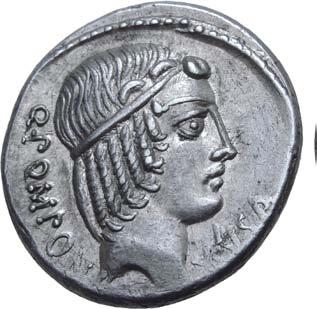

Good Extremely Fine.
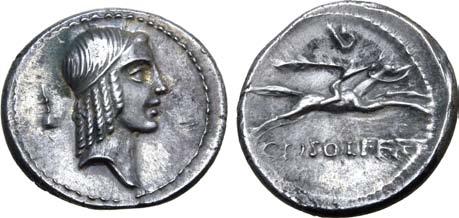
181
Ex Vitangelo Collection, Roma Numismatics Ltd., E-Sale 98, 16 June 2022, lot 1088. 750
L. Cassius Longinus AR Denarius. Rome, 63 BC. Head of Vesta to left, wearing veil and diadem; kylix behind, L (control mark) before / Voter to left, dropping tablet marked V into cista, LONGIN III V downwards behind. Crawford 413/1; BMCRR Rome 3931; Sydenham 935; RSC Cassia 10. 3.90g, 20mm, 7h.


Extremely Fine; lustrous iridescence around devices.
Ex iNumis Mail Bid Sale 17, 23 March 2012, lot 130 (original ticket included).
M. Calpurnius Piso M. f. Frugi AR Denarius. Rome, 61 BC. Terminal statue of Mercury facing; wreath to left, two-handled cup to right / Knife and patera, M•PISO M F FRVGI in two lines above; all within laurel wreath. Crawford 418/1; BMCRR Rome 3636; RSC Calpurnia 22. 3.95g, 18mm, 11h.

Near Extremely Fine. Very Rare.
From the Andrew McCabe Collection, collector’s tickets included; Ex Numismatica Ars Classica, Auction 125, 23 June 2021, lot 426; Ex Collection of Roman Republican Coins of a Student and his Mentor Part III, Numismatica Ars Classica, Auction 83, 20 May 2015, lot 367; Ex Numismatica Ars Classica, Auction 33, 6 April 2006, lot 275.
Published in Corpus Nummorum
C. Considius Nonianus AR Denarius. Rome, 57 BC. Laureate and diademed bust of Venus to right; C•CONSIDI•NONIANI downwards behind, S•C before / Temple on summit of rocky mountain surrounded by wall with towers on each side and gate in centre; ERVC above gate. Crawford 424/1; BMCRR Rome 3831; CNR Considia 4/1 (this coin); RSC Considia 1a. 3.74g, 19mm, 12h.
Near Mint State; somewhat weakly struck, but lustrous with traces of original mineral adhesions. This coin published in A. Banti. Corpus Nummorum Romanorum, Monetazione Repubblicana (Firenze, 1980-1982); Ex Vogelberg Collection (Switzerland), formed c. 1960-1985, Roma Numismatics Ltd., Auction XXV, 22 September 2022, lot 755; Ex Kunst und Münzen, Auction 5, 18 November 1970, lot 51.

1,200
L. Marcius Philippus AR Denarius. Rome, 56 BC. Head of Ancus Marcius to right, wearing diadem; lituus behind, ANCVS below / Aqueduct on which stands equestrian statue, flower at horse’s feet; PHILIPPVS to left, AQVA MAR (partially ligate) within arches of aqueduct. Crawford 425/1; BMCRR Rome 3890; Sydenham 919; RBW 1524; RSC Marcia 28; RBW 1524. 4.01g, 19mm, 7h.


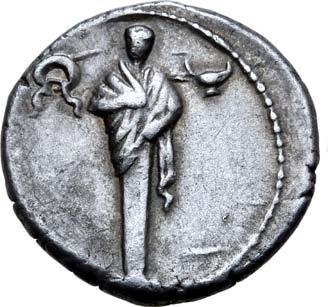






Good Extremely Fine; an outstanding example boasting a wonderful old cabinet tone and highly expressive portrait. Ex Vitangelo Collection (collector’s ticket included).

182
512. 1,200
300
511.
513.
514. 600
Very Rare
Romanorum
L. Marcius Philippus AR Denarius. Rome, 56 BC. Head of Ancus Marcius to right, wearing diadem; lituus behind, ANCVS below / Aqueduct on which stands equestrian statue, flower at horse’s feet; PHILIPPVS to left, AQVA MAR (partially ligate) within arches of aqueduct. Crawford 425/1; BMCRR Rome 3890; Sydenham 919; RBW 1524; RSC Marcia 28; RBW 1524. 4.12g, 18mm, 3h.

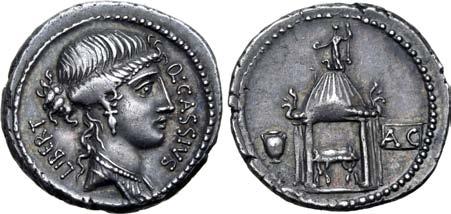

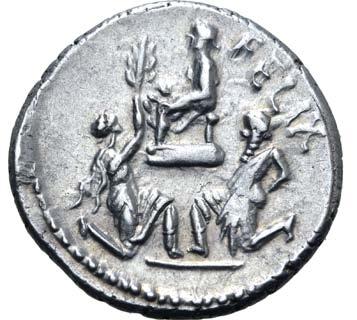




Good Extremely Fine; well centred and struck on a broad planchet.
This coin published in Richard Schaefer’s Roman Republican Die Project (RRDP), binder 7, p. 188, available online at: http://numismatics.org/ archives/ark:/53695/schaefer.rrdp.b07#schaefer.rrdp.b07_0232;
Ex Alan J. Harlan Collection, Classical Numismatic Group, Triton XXII, 8 January 2019, lot 877.
The Marcia gens claimed decent from Ancus Marcius, the fourth king of Rome, who is said to have been the first to bring water to Rome by means of an aqueduct. The equestrian statue is that of Q. Marcius Rex, who, when praetor in 144 BC, was commissioned by the Senate to repair the old aqueducts and to build one which would give a supply of water to the Capitol. This aqueduct, known as the Aqua Marcia, still stands in parts today and together with the Aqua Anio Vetus, Aqua Anio Novus and Aqua Claudia, is regarded as one of the four great aqueducts of ancient Rome. It was largely paid for by spoils from the recent Roman conquests of Corinth in 146 BC and the destruction of Carthage at the end of the Third Punic War, in the same year. The Aqua Marcia supplied water to the Viminal Hill in the north of Rome, and from there to the Caelian, Aventine, Palatine, and Capitoline regions of the city. Its extension to the Capitoline Hill caused a controversy at the time, because traditionalists were concerned about a passage in the Sibylline Books warning against bringing water there.
Faustus Cornelius Sulla AR Denarius. Rome, 56 BC. Draped bust of Diana to right, wearing diadem with crescent; lituus behind, FAVSTVS downwards before / Sulla seated to left on platform above kneeling figures of Bocchus, king of Mauretania, on left, who offers olive branch, and Jugurtha, king of Numidia, on right, his hands tied behind his back; FELIX downwards to right. Crawford 426/1; BMCRR Rome 3824-3825; Sydenham 879; RSC Cornelia 59; RBW 1525. 4.07g, 19mm, 7h.
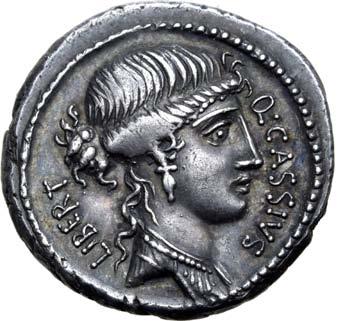


Good Extremely Fine; lightly toned.
Ex Santana Collection; Ex Classical Numismatic Group, Triton XXIII, 14 January 2020, lot 598; Ex Jack A. Frazer Collection, Numismatica Ars Classica, Auction 21, 17 May 2001, lot 258.
Ex
Q. Cassius Longinus AR Denarius. Rome, 55 BC. Head of Libertas to right; LIBERT upwards behind, Q•CASSIVS downwards before / Curule chair within temple of Vesta; urn to left, voting tablet inscribed AC (Absolvo Condemno) to right. Crawford 428/2; BMCRR Rome 3873; RSC Cassia 8. 4.03g, 19mm, 5h.
Good Extremely Fine; beautifully centred with a deep old cabinet tone.
From the Andrew McCabe Collection, collector’s ticket included; Ex Nomisma S.p.a. (San Marino), Auction 62, 15 September 2020, lot 36; Ex Leu Numismatik AG, Auction 86, 5 May 2003, lot 703.
P. Fonteius P. f. Capito AR Denarius. Rome, 55 BC. Helmeted and draped bust of Mars to right; trophy behind, P•FONTEIVS•P•F•CAPITO•III•VIR around / Warrior on horseback galloping to right, thrusting spear downwards at kneeling enemy in Gallic helmet, who holds sword and shield; to lower left, another enemy warrior, kneeling to right; Gallic helmet and shield to lower right, MN•FONT•TR•MIL above. Crawford 429/1; BMCRR Rome 3851-5; Sydenham 900; RSC Fonteia 17. 3.73g, 19mm, 2h. Extremely Fine.
Ex Numismatica Ars Classica, Auction 54, 24 March 2010, lot 940.

183
516. 600
515. 180
517. 300
518. 210 The Aqua Marcia
Leu 86, 2003
P. Fonteius P. f. Capito AR Denarius. Rome, 55 BC. P•FONTEIVS•CAPITO•III•VIR•CONCORDIA, diademed and veiled bust of Concordia to right / Villa Publica on the Campus Martius; T•DIDI• downwards on left, VIL•PVB on right, IMP• below. Crawford 429/2a; BMCRR Rome 3856; RSC Fonteia 18 and Didia 1. 3.90g, 18mm, 6h.
Extremely Fine; attractive old cabinet tone.
Ex Numismatica Ars Classica, Auction 63, 17 May 2012, lot 314 (hammer: 1,400 CHF).


The Villa Publica was a most ancient building, first constructed on the Field of Mars in 435 BC, and according to Livy it was there that the first census of the Roman people was held in the year of its completion. The Villa Publica served as the censors’ office, and held their records, as well as serving as the place where foreign ambassadors were greeted, where victorious Roman generals waited to hear if they would be granted a triumph, and as a base for the levying of legions. At least two renovations of the structure were undertaken, in 194 and 34 BC.
520. 450
Q. Servilius Caepio (M. Junius) Brutus AR Denarius. Rome, 54 BC. Bust of Libertas to right; LIBERTAS downwards behind / Consul L. Junius Brutus, between two lictors, preceded by accensus, all walking to left; [BRVTVS] in exergue. Crawford 433/1; BMCRR Rome 3862; RSC Junia 31. 3.60g, 20mm, 6h.

Good Extremely Fine; some mineral adhesions, charming iridescent cabinet tone.
Ex Roma Numismatics Ltd., Auction XXIII, 25 March 2022, lot 609.
COINS OF THE ROMAN IMPERATORS




Julius Caesar AR Denarius. Military mint travelling with Caesar, 49-48 BC. Elephant advancing to right, trampling on serpent; CAESAR in exergue / Emblems of the pontificate: simpulum, aspergillum, securis (surmounted by wolf’s head), and apex. Crawford 443/1; CRI 9; BMCRR Gaul 27-30; RSC 49. 3.65g.
NGC graded AU 4/5 - 5/5 (#6674258-005).
Ex Collection of Dipl. Ing. Adrian Lang.
Julius Caesar AR Denarius. Military mint travelling with Caesar, 49-48 BC. Elephant advancing to right, trampling on serpent; CAESAR in exergue / Emblems of the pontificate: simpulum, aspergillum, securis (surmounted by wolf’s head), and apex. Crawford 443/1; CRI 9; BMCRR Gaul 27-30; RSC 49; RBW 1557. 3.96g, 19mm, 9h.







Extremely Fine.
Ex American collection of Roman Republican and Imperatorial coins; Privately purchased from Edward J. Waddell Ltd, inventory no. C37537.
184
519. 450
521. 1,050
900
522.
Julius Caesar AR Denarius. Military mint travelling with Caesar, 48-47 BC. Diademed female head to right, wearing oak-wreath; LII (Caesar’s age) behind / Trophy of Gallic arms, wearing horned helmet, holding oval shield ornamented with thunderbolt and carnyx; securis to right, CAE-SAR across lower fields. Crawford 452/2; CRI 11; BMCRR Rome 3955; RSC 18. 3.98g, 17mm, 4h.


Extremely Fine; attractive golden iridescence around devices.
Caesar’s conquest of Gaul, which the reverse of this coin alludes to, with its captured Gallic spoils (the typical shield, the Gallic ‘carnyx’ or war horn, and axe), was the springboard from which he was to take control of the Republic and become its Dictator. It allowed him to grow his power base through both fame as the conqueror of so vast a region and of so many peoples, and through strength as the commander of an army that grew ever more experienced and fiercely loyal. His allocation of the provinces of Gaul also granted him a magistrate’s immunity from the prosecution his enemies intended to conduct upon his return to Rome, which would undoubtedly have stunted his career. It was from his province of Cisalpine Gaul that he invaded Italy across the Rubicon, and he did so with the Legio XIII Gemina, who had fought for him in the major battles of his conquest of Gaul.
The importance of this conquest of Gaul to Caesar’s career, and his awareness of this, is demonstrated by this coin. It was minted some time after he had left Gaul behind, by the mint which had moved with his army across the Mediterranean and beyond as it chased down the Optimates, most likely in Greece shortly after the victory over Pompey in Pharsalus. Yet the type harks back to these Gallic victories, reminding those he paid with these coins of his past as a Roman hero - a conqueror not of his own people, but of his people’s enemies.
L. Hostilius Saserna AR Denarius. Rome, 48 BC. Female head to right, wearing oak wreath / Victory walking to right, holding caduceus and trophy over shoulder; L•HOSTILIVS downwards before, SASERN[A] upwards behind. Crawford 448/1a; CRI 17;

L. Hostilius Saserna AR Denarius. Rome, 48 BC. Head of Gallic captive to right; Gallic shield behind / Two warriors in biga to right: one driving, holding whip and reins, and the other, facing backward, holding shield and brandishing spear; L•HOSTILIVS above, SASERN below. Crawford 448/2a; CRI 18; BMCRR Rome 3994-5; RSC Hostilia 2. 4.11g, 18mm, 12h.

Good Extremely Fine; beautiful iridescent tone around the devices.
Ex Numismatica Ars Classica, Auction 120, 6 October 2020, lot 609.
The portrait of the Gallic warrior (in captivity) is believed to be Vercingetorix, leader of the great Gallic rebellion against Caesar in 55-54 BC.
Extremely Rare
Q. Oppius Æ Dupondius. Uncertain mint in northern Italy, circa 46 BC. Diademed head of Venus to left; [star] before / Victory advancing to left, holding wreath and palm; Q OPPIVS PR before. Crawford 550/3a; CRI 508; RPC I 603; RBW 1859. 16.34g, 28mm, 12h.








Very Fine. Extremely Rare with left facing portrait.
From the Andrew McCabe Collection, collector’s tickets included; Acquired from Ancient Imports, 2013, with older ticket marked 23-1398.
3,600
185
Near Mint State. Ex Lampasas Collection; Ex Classical Numismatic Group, Electronic Auction 449, 31 July 2019, lot 497. 524. 450
BMCRR Rome 3989; RSC Hostilia 5. 3.74g, 17mm, 6h.
523. 450
525.
300
526.
In Extraordinary Condition for the Type
A and pl. VII, obv. 3, rev. c; RSC Minatia 2 and Pompeia 11. 3.88g, 20mm, 2h.
Mint State; in extraordinary condition for the type. Very Rare.
Ex Shackleford Collection, Roma Numismatics Ltd., Auction XXI, 24 March 2021, lot 454.
The eldest son of Pompey Magnus, Cnaeus Pompeius (also commonly referred to as Pompey Junior) and his brother Sextus grew up in the long shadow of their father’s fame as the greatest general of his age. The elder Pompey had seemed to hold the whole Roman world in the palm of his hand, yet in the struggle for mastery of the Republic against his former friend and ally Caesar, Pompey was forced to abandon Italy with his family, and was utterly undone at the Battle of Pharsalus in 48 BC. Defeated, Pompey and his family took flight to Egypt where the general believed they would be safe, since the boy king Ptolemy XIII was indebted to the friendship and the help Pompey had given to his father. Upon their arrival in Egypt however, Pompey was treacherously murdered by a former comrade on the orders of the Egyptian king, who had been advised that this would forestall further civil war, and ingratiate him with Caesar. Stabbed to death by sword and daggers, his head severed and his unclothed body thrown into the sea, Pompey died the day after his sixtieth birthday. Horrified, his family put back out to sea.
Cnaeus and Sextus joined the remainder of the resistance to Caesar in Africa, and after the defeat at Thapsus the brothers escaped to the Balearic islands, whence they crossed over to the Spanish mainland with Titus Labienus, a former lieutenant of Caesar. Struck at Corduba, which became the Pompeian military headquarters, this coin is laden with symbolism. The reverse is as imaginative and unusual as any reverse in the Republican series, and propagandises the welcome received by the brothers in Spain, which readily provided them with the means with which to continue the fight against Caesar. The obverse bears the first securely datable portrait of their dead father Pompey Magnus, whose success in bringing the Sertorian War to a close in 71 BC would still have been remembered in Spain. The legend names ‘Cnaeus Magnus Imperator’, a pious statement that the authority behind the striking of this coinage is that of the wronged and murdered Pompey Magnus, on whose behalf the resistance to Caesar was taken up by his son.
This coin must have been struck only shortly before the Pompeian and Caesarean armies met on 17 March 45 BC; the extreme rarity of the issue argues for a limited production run. At the Battle of Munda, some 70,000 troops commanded by Cnaeus, Sextus, and Titus Labienus met Caesar’s battlehardened veteran force of 40,000. The result of the contest was a decisive victory for Caesar; Labienus was killed along with around 30,000 Pompeian troops, and the brothers Cnaeus and Sextus were once again forced to flee. Cnaeus was quickly captured and executed, but Sextus would survive his brother in Sicily for over a decade.

Sextus Pompey AR Denarius. Q. Nasidius, commander of the fleet. Massilia, 44-43 BC. Bare head of Pompey Magnus to right; NEPTVNI behind, trident before, dolphin swimming to right below / Galley under oar and sail to right; star in upper left field, Q•NASIDIVS below. Crawford 483/2; CRI 235; Sydenham 1350; BMCRR Sicily 21; RSC 20 (Pompey the Great). 3.59g, 18mm, 7h.


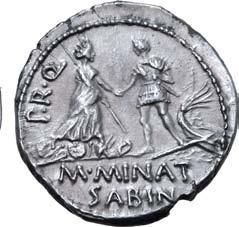
Near Extremely Fine; attractive iridescence around devices.
Ex Bertolami Fine Arts - ACR Auctions, Auction 15, 27 April 2015, lot 488.
According to Dio Cassius, following success in naval battles against Octavian, Sextus Pompey came to be known as ‘Son of Neptune’ as reflected in the obverse legend NEPTVNI and trident symbol. The reverse legend names Quintus Nasidius, an admiral under Pompey Magnus and then Sextus. Realising the futility of the Pompeian cause, Nasidius eventually defected to the camp of Marc Antony, and fought under him at the Battle of Actium, after which point he disappears from the historical record.


186
Cnaeus Pompeius Junior and M. Minatius Sabinus AR Denarius. Corduba, 46-45 BC. CN•MAGN IMP, head of Cnaeus Pompeius Magnus to right / Personification of Corduba, turreted, standing to right amidst heap of arms, holding transverse spear and welcoming Pompeian soldier who debarks from stern of ship; PR•Q to left, M•MINAT SABIN in exergue. Crawford 470/1a; CRI 49; C. 5; Sydenham 1036; Buttrey, ANSMN 9, 1960, p. 76, type
12,000 527.
528. 1,500


187
Julius Caesar AR Denarius. Rome, 43 BC. L. Flaminius Chilo, moneyer. Wreathed head of Caesar to right / Goddess (Pax or Venus?) standing to left, holding caduceus and sceptre; L • FLAMINIVS downward to right, IIII • VIR upward to left. Crawford 485/1; CRI 113; BMCRR Rome 4201-2; RSC 26. 3.78g, 19mm, 8h.
Good Extremely Fine; attractive cabinet tone, a wonderful portrait of Caesar
This coin published in Richard Schaefer’s Roman Republican Die Project (RRDP), binder 12, p. 14, available online at: http://numismatics.org/ archives/ark:/53695/schaefer.rrdp.b12#schaefer.rrdp.b12_0024; Ex Roma Numismatics Ltd., Auction XXIII, 24 March 2022, lot 769; Ex Viggo Collection, Classical Numismatic Group, Triton XXII, 8 January 2019, lot 946; Ex JD Collection of Roman Republican Coins, Numismatica Ars Classica, Auction 72, 16 May 2013, lot 494; Ex Numismatica Aretusa, Auction 2, 13 May 1994, lot 294.
7,500
In the years of his supremacy, Caesar had amassed unprecedented power by corrupting the institutions of the old Republic to his own requirements. First appointed Dictator in 49 BC by the Praetor (and future Triumvir) Marcus Aemilius Lepidus, possibly in order to preside over elections, Caesar resigned his Dictatorship within eleven days but in 48 BC he was appointed Dictator again, only this time for an indefinite period, and was also given permanent tribunician powers making his person sacrosanct and allowing him to veto the Senate. In 46 BC he was appointed Dictator for ten years, and he gave himself quasi-censorial powers under the mantle of ‘Prefect of the Morals’, enabling him to fill the Senate with his partisans who duly voted him the titles of Pater Patriae and Imperator. He increased the number of magistrates who were elected each year, thus allowing him to reward his supporters, and in October 45 BC, having served in the unconstitutional role of Sole Consul for that year, Caesar resigned his consulship and facilitated the election of two successors for the remainder of the year - theoretically restoring the ordinary consulship, but in practice submitting the Consuls to the Dictatorial executive - a practice that later become common under the empire. In February 44 BC, one month before his assassination, Caesar was appointed Dictator for life.
More followed; he was given the unprecedented honour of having his own likeness placed upon the Roman coinage, his statue was placed next to those of the kings, he was granted a golden chair in the Senate, and was permitted to wear triumphal dress whenever he chose. Then, at the festival of the Lupercal, Marc Antony presented Caesar with a royal diadem, and attempted to place it on his head. Yet for all these hideous affronts to the ancient institutions of the Republic and the sensibilities of the Roman people, perhaps his most egregious reform was the law he passed in preparation for his planned campaign against the Parthian Empire. Realising that his absence from Rome would impede his ability to install his own men in positions of power and that therefore his back would be exposed while away from the city, Caesar decreed that he would have the right to appoint all magistrates in 43 BC, and all consuls and tribunes in 42 BC, thus at a stroke transforming the magistrates from being representatives of the people to being representatives of the dictator.
Struck after Caesar’s assassination, this coin marks a departure from the portraiture on the coinage minted during his lifetime. Rather than the veiled head of Caesar the dictator, depicted instead is the wreathed head of the soon-to-be deified adoptive father of Octavian. This depiction of Caesar by Flaminius Chilo appears to be heavily influenced by Octavian’s concerted attempts in the aftermath of Caesar’s death to rehabilitate his image in the eyes of many of those at Rome who had developed concerns surrounding his increasing power and also, perhaps more cynically, to reinforce Octavian’s own legitimacy as his heir.




188
Ex Aretusa 2, 1994
529.
530.
C. Cassius Longinus and P. Cornelius Lentulus Spinther AR Denarius. Military mint travelling with Brutus and Cassius, probably at Smyrna, 43-42 BC. Tripod with cauldron, decorated with two laurel-branches; C•CASSI upwards to left, IMP upwards to right / Capis and lituus; LENTVLVS SPINT in two lines below. Crawford 500/1; CRI 219; BMCRR East 79; RSC 7; RBW 1761.
NGC graded MS 5/5 - 5/5 (#6674258-006).
Acquired from Leu Numismatik AG; Ex Roma Numismatics Ltd., Auction XXII, 7 October 2021, lot 641; Ex Roma Numismatics Ltd., Auction XIX, 26 March 2020, lot 748.






A Wonderful Example
1,500
531.
C. Cassius Longinus and P. Cornelius Lentulus Spinther AR Denarius. Military mint travelling with Brutus and Cassius, probably at Smyrna, 43-42 BC. Tripod with cauldron, decorated with two laurel-branches; C•CASSI upwards to left, IMP upwards to right / Capis and lituus; LENTVLVS SPINT in two lines below. Crawford 500/1; CRI 219; BMCRR East 79; RSC 7; RBW 1761.



NGC graded MS 5/5 - 4/5 (#6329072-001).
900
189
One of Six Known
Extremely Fine. An extremely rare variant (only 6 specimens known) of an already extremely rare type; in exceptional condition for the issue, and certainly finer than the example of NAC 73, 18 November 2013, lot 250 (CHF 350,000).
Ex Long Valley River Collection, Roma Numismatics Ltd., Auction XX, 29 October 2020, lot 466; Ex Roma Numismatics Ltd., Auction IX, 22 March 2015, lot 572; Ex private German collection.
75,000
Following the victory at Philippi over the Liberators Brutus and Cassius, Antony assumed direct control of the East. Ruling from Ephesus as a king in all but name, he consolidated Rome’s hegemony in the East, receiving envoys from Rome’s client kingdoms and intervening in their dynastic affairs, extracting enormous financial ‘gifts’ from them in the process. Meanwhile Octavian had returned to the West, tasked with the difficult and unpopular job of assigning land grants to the demobilised legionaries. Since there was insufficient state-controlled land to fulfil the allotments to the veterans, Octavian was faced with the difficult choice of alienating the citizen body by confiscating private land, or alienating many Roman soldiers who might back a military rebellion against the Triumvirate’s rule. Octavian chose the former; as many as eighteen Roman towns through Italy were affected by the confiscations, with entire populations driven out.
Exploiting the hostile sentiments of the Senate over the issue of the land grants, Antony’s wife Fulvia schemed with Antony’s younger brother Lucius, who was consul that year. Together they encouraged the Senate to oppose Octavian’s land policies; Fulvia it seems hoped to delay the land settlements until Antony returned to Rome, so that he could share credit and the gratitude of the soldiers. The conflict between Octavian and Fulvia caused great political and social unrest throughout Italy. Tensions escalated into open war when Octavian divorced Clodia Pulchra, Fulvia’s daughter from her first husband.
Together Fulvia and Lucius raised an army to oppose Octavian militarily. They raised eight legions and held Rome for a brief time before being forced to retreat to Perugia. Lucius had expected that his brother ’s legions in Gaul would come to their aid, but Antony, facing the grave political embarrassment caused by Fulvia’s actions, gave no instructions to his legions. Octavian laid siege to the city, eventually causing it to surrender out of starvation. While Octavian pardoned Lucius for his role in the war and even granted him the governorship of Spain, Fulvia was exiled along with her children to Sicyon in Greece.
Struck in early 41 BC prior to Lucius and Fulvia taking up arms against Octavian, this extremely rare aureus type, which was accompanied by a significant issue of denarii, is evidence of Antony’s pride at his younger brother’s assumption of the consulship.



190
Marc Antony and Lucius Antony AV Aureus. M. Cocceius Nerva, proquaestor pro praetore. Mint moving with M. Antony in the East, 41 BC. M•ANT•IMP•AVG VIR•R•P C•M•NERVA PRO Q•P, bare head of Marc Antony to right / L•ANTONIVS COS, bare head of Lucius Antony to right. Crawford 517/4b; CRI 245a; Sydenham 1184 var. (same); C. 2 var. (same); Calicó 111; Bahrfeldt 80 var. (III VIR). 8.13g, 22mm, 12h.
532.


191
Marc Antony AR Denarius. Military mint moving with Antony, 40 BC. Bare head to right; lituus behind / Caduceus between two cornucopiae on globe, M•ANT•IMP above, III•VIR•R•P•C• below. Crawford 520/1; CRI 256; BMCRR East 114; RSC 66. 3.75g, 19mm, 6h.




Very Fine; some light scratches to obv., attractive light cabinet tone. Very Rare.
From the Andrew McCabe Collection, collector’s ticket included; Ex Harlan J. Berk Ltd., Buy or Bid Sale 183, 28 March 2013, lot 218 (1,850 USD); Ex Áureo & Calicó, Auction 247, 30 October 2012, lot 653.
C. Numonius Vaala AR Denarius. Rome, 41 BC. Bare head of Numonius Vaala to right; C•NVMONIVS downwards before, VAALA upwards behind / Soldier advancing to left, holding sword and shield, attacking vallum defended by [two soldiers]; VAALA in exergue. Crawford 514/2; CRI 322; BMCRR Rome 4216; Sydenham 1087; RSC Numonia 2. 2.90g, 18mm, 10h.


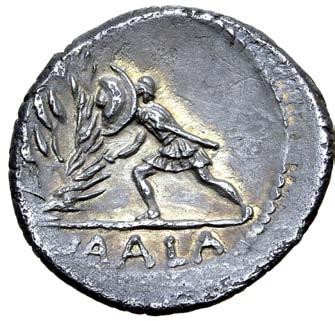



Near Mint State; a striking portrait accentuated by hints of golden iridescence.
Ex Fritz Rudolf Künker GmbH & Co. KG, Auction 280, 26 September 2016, lot 392.
The reverse type no doubt depicts the deeds of an ancestor which resulted in the cognomen Vaala. The first soldier to breach the enemy rampart (vallum) was awarded the corona vallaris. The details of this particular instance are not known to history.
C. Numonius Vaala AR Denarius. Rome, 41 BC. Bare head of Numonius Vaala to right; C•NVMONIVS downwards before, VAALA upwards behind / Soldier advancing to left, holding sword and shield, attacking vallum defended by two soldiers; VAALA in exergue. Crawford 514/2; CRI 322; BMCRR Rome 4216; RSC Numonia 2. 4.08g, 20mm, 9h.

Good Very Fine.

192
533. 600
534. 2,100 Very Rare
535. 900

Quintus Labienus AR Denarius. Uncertain mint in south-eastern Asia Minor, early 40 BC. Bare head to right; Q•LABIENVS•PARTHICVS•IMP around / Horse standing to right, wearing saddle with quiver attached and bridle. Crawford 524/2; CRI 341; BMCRR East 132; Hersh 15; RSC 2. 3.85g, 19mm, 5h.
Good Extremely Fine; minor flan crack at 12h, light iridescent tone. Very Rare.
Ex private collection in North Rhine-Westphalia, Germany, Roma Numismatics Ltd., Auction XXV, 22 September 2022, lot 928.
It should perhaps not come as a surprise that Quintus Labienus, the son of Titus Labienus who was an important general to Caesar during the Gaul Campaign and then broke ties with him to form an alliance with Pompey, also became a traitor during his lifetime. After the assassination of Caesar, the younger Labienus joined Cassius and Brutus who sent him as an ambassador to Parthia to request support from King Orodes II. This mission proved to be unsuccessful and thus contributed to Cassius and Brutus being defeated in the battle of Philippi by Octavian and Antony in 42 BC.
It is at this point that some may call Labienus a coward, and some an opportunist. He knew if he returned home he would face punishment, and the chances of advancement for himself would all but disappear. However, if he stayed with the Parthians he could perhaps have the opportunity to fulfil his military ambitions. Labienus therefore decided to stay and convince Orodes to invade Syria on the pretence that several areas under Antony and Octavian were not well protected. In 40 BC he jointly commanded forces with Orodes’ son Pacorus II that invaded areas of Syria and Asia Minor. Labienus and Pacorus were able to achieve much success and overtook Apameia, Antioch, and Cilicia. His success was short lived though, as in 39 BC he was defeated, captured and executed in an attack orchestrated by Antony and Octavian and carried out by Publius Ventidius.
It is around the time of his military victories that he began striking coinage to pay the many soldiers he was acquiring through his conquests. This coin in particular strikes a balance between Roman and Parthian characteristics. The obverse depicts a very serious, yet commanding portrait in Roman style, but with a legend naming him PARTHICVS. The reverse depicts a horse with a bridled saddle and quiver, making reference to the infamous Parthian soldiers who were known for their accuracy and efficiency as horse archers.

After Labienus was killed most of his coinage was melted down, making surviving examples very rare indeed.


194
Very Rare
536.
12,000


195
Cleopatra and Marc Antony AR Denarius. Uncertain eastern mint, autumn 34 BC. ANTONI•ARMENIA•DEVICTA, bare head of Marc Antony to right; Armenian tiara to left / CLEOPATRAE•REGINAE•REGVM•FILIORVM•REGVM•, diademed and draped bust of Cleopatra to right; prow to right at point of bust. Crawford 543/1; CRI 345; BMCRR East 179-181; RSC 1. 3.78g, 20mm, 2h. Good Extremely Fine; flan crack at 12h, traces of overstrike(?) on obv., attractive iridescence with underlying lustre, among the finest known.
537. 3,000
Marc Antony Legionary AR Denarius. Military mint moving with Antony, autumn 32 - spring 31 BC. ANT•AVG III•VIR•R•P•C, praetorian galley to right / Aquila between two signa; LEG IV across fields. Crawford 544/17; CRI 352; BMCRR East 195; Sydenham 1219; RSC 30. 3.46g, 18mm, 6h.
538. 600
Good Extremely Fine; light cabinet tone, an attractive example.
Ex Gorny & Mosch Giessener Münzhandlung, Auction 237, 7 March 2016, lot 1788.
539. 750
Marc Antony Legionary AR Denarius. Military mint moving with Antony, autumn 32 - spring 31 BC. ANT•AVG III•VIR•R•P•C, praetorian galley to right / Aquila between two signa; LEG V across fields. Crawford 544/18; CRI 354; BMCRR East 196; RSC 32. 3.53g, 19mm, 5h.
Good Extremely Fine; almost invisible ‘A’ graffito in rev. field.
Ex Marti Hervera and Soler & Llach, Auction 1128, 15 June 2022, lot 1079 (since professionally conserved).
AEGYPTO CAPTA
Octavian AR Denarius. Uncertain Italian mint (Rome?), 28 BC. CAESAR COS•VI, bare head to right; lituus behind / Crocodile standing to right; AEGYPTO above, C[AP]TA below. RIC I 275a; CRI 430; BMCRE 650 = BMCRR East 243; RSC 2. 3.65g, 19mm, 6h.






Near Extremely Fine. Rare.
From the Andrew McCabe Collection, collector’s ticket included; Acquired from A. H. Baldwin & Sons Ltd.;
Ex Numismatica Ars Classica, Auction 125, 23 June 2021, lot 591 (hammer: 3,750 CHF);
Ex Roma Numismatics Ltd., Auction XIII, 3 March 2017, lot 732.
Bearing the Nile crocodile as the sole element of the reverse design, and with the simple legend conveying a succinct message, this coin proudly announces Octavian’s annexation of Egypt to the Empire. After the Battle of Actium, Octavian invaded Egypt in August 30 BC and with the conquest that followed both assured his supremacy by the death of Marc Antony and Cleopatra, and guaranteed his power through the great wealth of Egypt and the grain supply that could be harnessed for Rome. The Ptolemaic Kingdom of Egypt, the last of the great Hellenistic kingdoms, had been reduced to the status of a Roman province.








196
540. 1,800
541.
Augustus AR Denarius. Uncertain Spanish mint (Colonia Patricia?), 19 BC. CAESAR AVGVSTVS, bare head to left / Round shield inscribed CL•V, aquila and signum flanking; SIGNIS above, RECEPTIS below, S P Q R around. RIC I 86b; BMCRE 420-421; RSC 267. 3.66g, 19mm, 5h.

Extremely Fine; an attractive portrait of Augustus.
Ex collection of Dipl.-Ing. Adrian Lang; Ex Numismatik Lanz München, Auction 156, 2 June 2013, lot 254; Ex Helios Numismatik, Auction 8, 13 October 2012, lot 53.
542.
Augustus AR Denarius. Rome, 19-18 BC. P. Petronius Turpilianus, moneyer. TVRPILIANVS III VIR FERON, draped bust of Feronia to right, wearing stephane and pearl necklace / CAESAR AVGVSTVS•SIGN•RECE•, bare-headed Parthian kneeling to right, extending standard with vexillum marked X, and holding out left hand. RIC I 288; BMCRE 14; RSC 484. 4.00g, 19mm, 3h.








Extremely Fine; flan crack at 6h, attractive old cabinet tone.
543. 900
Augustus AR Denarius. Lugdunum, 15-13 BC. AVGVSTVS DIVI•F, bare head to right / Bull butting to right; IMP•X in exergue. RIC I 167a; BMCRE 451; Lyon 19; RSC 137. 3.62g, 20mm, 7h.





Good Extremely Fine; attractive golden iridescence around the devices. Ex Dr. Busso Peus Nachfolger, Auction 429, 3 November 2021, lot 285.
544. 600
Extremely Fine.
Ex Auktionshaus H. D. Rauch GmbH, Auction 112, 10 June 2021, lot 803.
197
600
From the Apollo to Apollo Collection; Acquired from Gorny & Mosch Giessener Münzhandlung. 450
Augustus AR Denarius. Rome, 13 BC. C. Antistius Reginus, moneyer. CAESAR AVGVSTVS, bare head to right / C • ANTIS[TIVS] • REGINVS, simpulum and lituus above tripod and patera; III•VIR below. RIC I 410; BMCRE 119-120 = BMCRR Rome 4661-4662; BN 547; RSC 347. 3.94g, 19mm, 6h.
COINS OF THE ROMAN EMPIRE
546.
Augustus Æ Dupondius. Lugdunum, AD 9-14. CAESAR AVGVSTVS DIVI F PATER PATRIAE, laureate head to right / Front elevation of the Altar of Lugdunum, decorated with the corona civica between laurels, flanked by stylised male figures; Victories on columns, facing one another to left and right; ROM ET AVG below. RIC I 232; C. 237; BMCRE 566. 13.40g, 27mm, 12h.
Extremely Fine; arguably the best preserved example offered at auction in the past two decades.
Ex Phidias (Paris), vente numismatique, 29 June 2022, lot 174.
Ex Ars Classica XVI, 1933 and Naville II, 1922
Divus Augustus Æ Dupondius. Rome, AD 37-41. DIVVS•AVGVSTVS, radiate head to left; large S-C across fields / CONSENSV • SENAT • ET • EQ • ORDIN • P • Q • R •, Augustus(?) or Caligula, laureate and togate, seated to left on curule chair, holding olive branch and globe. RIC I 56 (Gaius); C. 87; BMCRE 88 (Gaius); BN 137 (Gaius). 15.54g, 29mm, 6h.





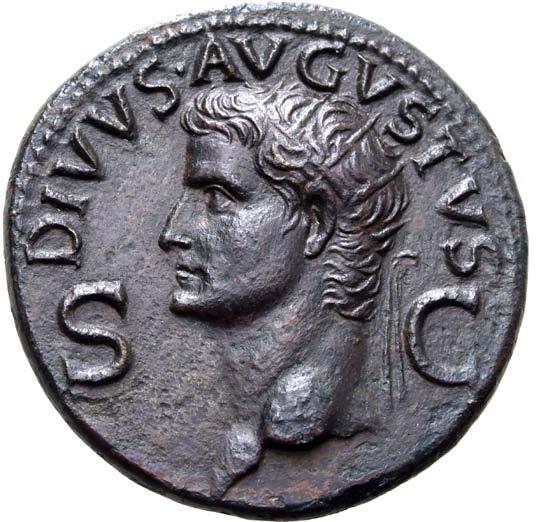
Good Extremely Fine; a superb example of the type, and one of the very best to have been auctioned in recent years.
Ex Long Valley River Collection, Roma Numismatics Ltd., Auction XX, 29 October 2020, lot 534; Ex Leu Numismatik AG, Auction 5, 27 October 2019, lot 321; Ex Classical Numismatic Group, Triton XX, 10 January 2017, lot 644; Ex Ars Classica S.A., Auction XVI, 3 July 1933, lot 1588 (expertly conserved since); Ex M.P. Vautier & Prof. M. Collignon Collection, Naville & Cie., Auction II, 12-14 June 1922, lot 96.
1,800
Agrippa (grandfather of Caligula) Æ As. Rome, AD 37-41. M • AGRIPPA • L • F • COS • III •, head to left wearing rostral crown / Neptune standing facing, head to left, holding small dolphin and trident; S-C across fields. RIC I 58 (Gaius); C. 3; BN 77-78; BMCRE 161-166 (Tiberius). 11.91g, 30mm, 7h.
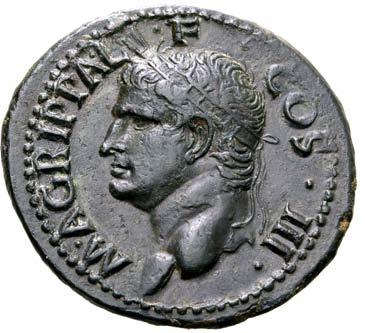



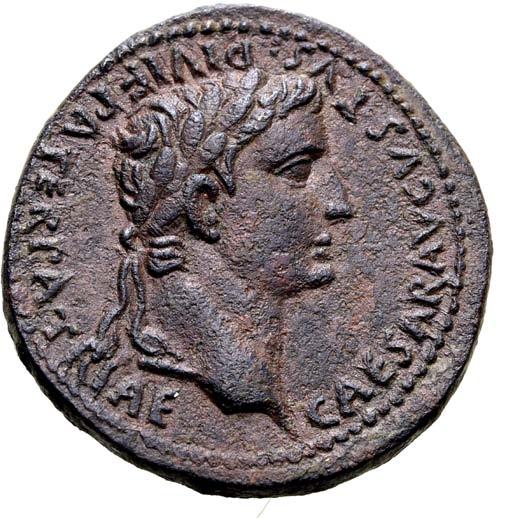
Near Extremely Fine.
Ex Historical Scholar Collection; Privately purchased from Tom Cederlind, old dealer’s ticket included.
198
545. 210
600
547.

Tiberius AV Aureus. Lugdunum, AD 14-37. TI CAESAR DIVI AVG F AVGVSTVS, laureate head to right / PONTIF MAXIM, Livia, as Pax, seated to right on throne with ornamented legs, holding sceptre and olive branch; single exergual line below. RIC I 29; BMCRE 46; Lyon 147; Calicó 305c. 7.79g, 19mm, 4h.


Mint State; a truly spectacular example.
Ex Roma Numismatics Ltd., Auction XXII, 7 October 2021, lot 676.

Following a series of early issues honouring Divus Augustus and Tiberius’ military triumphs, the mint at Lugdunum settled upon striking one single type: ‘Pontif Maxim’. Numismatists identify the seated figure depicted on this ubiquitous reverse type as Livia, the wife of Augustus and mother of Tiberius, in the guise of Pax, the Roman personification of peace. The type was struck continuously for twenty three years and throughout that time, only minor changes were made to the portrait of Tiberius and the ornamentation of the throne. Despite the vast output of the ‘Pontif Maxim’ coinage, the significance of the type is not immediately clear - the depiction of Livia as Pax may represent a universal matronly ideal; Livia may be intended as the personification of what Seneca the Younger described in AD 55 as the ‘Pax Romana’ (‘Roman Peace’), the period of peace and stability marked by Octavian’s victory over Mark Antony at the battle of Actium in 31 BC, which brought to an end to the prolonged period of civil war.



Certainly, during the last decade of the 1st century BC Livia began to appear more frequently in the preserved sources, and L. Brännstedt (‘Femina princeps: Livia’s position in the Roman state’) suggests that “her role as mater and uxor at this time was becoming an integral part of Augustus’ political program, and being made publicly manifest on a large scale.” Brännstedt furthermore asserts that “the appointment on March 6, 12 BC of Augustus as pontifex maximus was crucial for the development of Livia’s mater-role... Augustus’ religious role was identified as that of a father to his family. Strengthening the paternal connotations of Augustus’ leadership, the appointment of him as pontifex maximus would also have favoured Livia’s impact as mater”. The identification of Livia with Pax therefore strongly associated the imperial family with the continued prosperity of the Empire, and hence should be seen as primarily a propagandistic instrument for the reinforcement of the imperial cult.
In contrast to the official portrayals of Livia as a matriarch embodying traditional Roman ideals, contemporary sources were often highly critical of her, describing her as a murderess who was determined to secure the succession for her son Tiberius. Cassius Dio describes how Livia was blamed for the death of Augustus’ nephew Marcellus who, having married the Emperor’s daughter Julia, was favoured as an heir, and later, the deaths of Gaius and Lucius Caesars (55.33.4 and 55.10a.10). Tacitus moreover suggests that Livia convinced Augustus to banish his then only surviving grandson, Agrippa Postumus, on this basis that his character was not in keeping with Augustan ideals (1.1.3). Dio recounts that following years of banishment, a visit undertaken by Augustus to reconcile with his grandson drove Livia to poison her husband in order to secure the succession for Tiberius (56.30.2). These accusations are however mainly dismissed as malicious fabrications spread by political enemies of the dynasty
200 A Truly Spectacular Example
12,000
548.
Tiberius Æ As. Restitution issue struck under Titus. Rome, AD 80-81. TI CAESAR DIVI AVG F AVGVST IMP VIII, bare head to left / IMP T CAES DIVI VESP F AVG P M TR P P P COS VIII RESTITV in two circles around SC. RIC II.1 433 (Titus); BMCRE 285 note (Titus). 9.16g, 27mm, 6h.
Near Extremely Fine; Very Rare; rated R3 in RIC.
Ex Roma Numismatics Ltd., E-Sale 97, 26 May 2022, lot 1012.
600
549.


201
Agrippina I (mother of Caligula) Æ Sestertius. Rome, AD 37-41. AGRIPPINA M F MAT C CAESARIS AVGVSTI, draped bust to right / Carpentum, with ornamented side and cover supported by standing figures, drawn to left by two mules; S • P • Q • R above, MEMORIAE AGRIPPINAE in two lines in left field. RIC I 55 (Gaius); C. 1; BN 128-131; BMCRE 81-85 (Caligula). 26.41g, 35mm, 7h. Near Extremely Fine; obv. legend lightly reinforced.






Ex Historical Scholar Collection.
Nero Claudius Drusus (father of Claudius) AR Denarius. Rome, circa AD 41-45. NERO CLAVDIVS DRVSVS GERMANICVS IMP, laureate head to left / DE GERMANIS, two oblong shields crossed, over vexillum, four spears and two trumpets. RIC I 74 (Claudius); BMCRE 107; RSC 6; BN 109-10 (Claudius). 3.79g, 19mm, 1h.
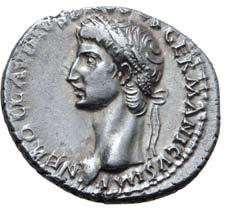

Good Extremely Fine. Very Rare.
Ex Shackleford Collection, Roma Numismatics Ltd., Auction XXI, 24 March 2021, lot 509.


Roman history, like that of any enduring empire, allows for speculation about how the course of events might have changed had certain people died, or in this case, not died. A perfect study in this is Nero Claudius Drusus, the younger brother of the future Emperor Tiberius. Unlike Tiberius, whom Augustus had always disliked, Drusus was much beloved by Rome’s first emperor. When Augustus wrested Livia from her first husband, she was already pregnant with Drusus and gave birth to him months after her marriage to Augustus. It is commonly understood that Livia’s first husband had sired Nero Claudius Drusus, and had been legally declared the father before the couple divorced - but it is not impossible that Augustus was the father.
Speculation aside, Augustus took instantly to the newborn Drusus and treated him as if he was a son of his own blood. The same cannot be said for Drusus’ brother Tiberius, who was already four years old when he came to live in Augustus’ household. Augustus saw personally to Drusus’ education and arranged his marriage to his noble and wealthy niece Antonia. Drusus’ career advanced quickly, having in 19 BC been granted the ability to hold all public offices five years before the minimum age requirement, and after a spell commanding alongside his brother he spent three years leading a campaign in Germania.
In his lifetime Nero Claudius Drusus was one of the most celebrated military commanders of the age, leading the first Roman legions across the Rhine and rapidly accruing a string of victories and conquests in Germania; in the course of his Germanic campaigns Drusus sought out multiple (at least three) Germanic chieftains, challenging and beating them in single combat. The sources are ambiguous, but imply that at some point he claimed the spolia opima (the arms and armour taken by a a Roman general from the body of an opposing commander slain in single combat) from a Germanic king, thus becoming the fourth and final Roman to gain this honour, the most prestigious any Roman general could aspire to.
Drusus dedicated the great Altar of Lugdunum to Augustus on August 1, 10 BC, the very day that his youngest son, Claudius (who struck this denarius in posthumous remembrance 50 years after his death) was born. But Drusus’ great possibilities ended tragically in 9 BC when he died of injuries he received falling off a horse at age 29. This reverse type celebrates his German campaign - for which his eldest son, Germanicus, was renamed.
202
550.
750
551. 3,000
•
• TR • P • IMP • P •
•
Agrippina I (sister-in-law of Claudius) Æ Sestertius. Rome, AD 50-54. AGRIPPINA • M • F • GERMANICI CAESARIS, draped bust to right / TI
CLAVDIVS
• CAESAR • AVG GERM P M
P
around large S•C. RIC I 102 (Claudius); C. 3; BMCRE 219-221 (Claudius); BN 236. 28.82g, 36mm, 6h.
Good Extremely Fine; lightly smoothed fields.
552. 1,200
Claudius with Nero, as Caesar, AR Denarius. Lugdunum, AD 50-54. TI CLAVD CAESAR AVG GERM P M TRIB POT P P, laureate head to right / NERO CLAVD CAES DRVSVS GERM PRINC IVVENT, bare-headed and draped bust of Nero to left. RIC I 83; BMCRE 80; RSC 5 (Claudius and Nero). 3.64g.
NGC graded AU 5/5 - 4/5 (#6674263-002). Rare in this condition.
Ex Numismatica Ars Classica, Auction 131, 30 May 2022, lot 10; Ex Hess-Divo AG, Auction 332, 31 May 2017, lot 96.
After the assassination of his nephew Caligula, it was Claudius, the last adult male of the Julio-Claudian dynasty, who was unexpectedly installed as emperor at 51 years of age. He swiftly took steps to legitimise his precarious succession, adopting the cognomens ‘Caesar ’ and ‘Augustus’ and keeping the honorific ‘Germanicus’ to highlight the connection to his heroic brother, all of which appear here on this coin. Although his wife Messalina had provided him with a future heir in a young son named Britannicus, when she attempted to remarry and mount a coup against him he realised the weakness of his position with no obvious adult heir and remarried in 49 BC to Agrippina the Younger, his niece, the sister of his predecessor as emperor and one of the last few remaining blood descendants of Augustus. He formally adopted her son Lucius Domitius Ahenobarbus in 50 BC, married him to his daughter Octavia in 53 BC and promoted him to joint heir with the underage Britannicus. The boy would become Nero Claudius Caesar Augustus Germanicus, the last of the Julio-Claudian emperors.
Both Nero and his mother Agrippina featured prominently on Claudius’ coinage during the last years of his reign, broadcasting the continuation of Augustus’ bloodline: Agrippina was the first Roman empress to appear on coinage since Augustus’ own wife Livia. Nero’s portrait on the reverse of this coin is a classic example of the so-called ‘first type’ of Neronian portraiture, a consistent and codified public image of the boy in his early teenage years when first adopted by Claudius and named as his heir in AD 50. He is presented to the world as a quintessential Julio-Claudian prince in the style of his grandfather Germanicus, with idealised unindividualized physiognomy, a long straight nose, thin flat eyebrows and flat hair brushed forward into the standard Augustan fringe. When he became emperor in AD 54, the Julio-Claudian portrait mode which legitimised his accession gave way to a new image form embodying prosperity and sophistication with a plump, luxurious portrait in the style of Hellenistic kings.







Good Extremely Fine; lightly smoothed.
Ex Historical Scholar Collection.
203
A Superior Example with an Exceptional Reverse
553. 7,500
Claudius Æ As. Rome, AD 50-54. TI CLAVDIVS CAESAR AVG P M TR P IMP P P, bare head to left / LIBER[T]AS AVGVSTA, Libertas standing facing, head to right, holding pileus in right hand and with left outstretched; S-C across fields. RIC I 113; C. 47; BN 230-232; BMCRE 202-205. 11.65g, 29mm, 6h.
554.
450
Nero Æ Sestertius. Rome, AD 62-68. NERO CLAVDIVS CAESAR AVG GER P M TR P IMP P P, laureate head to left / Port of Ostia: seven ships within harbour; at top is pharus surmounted by statue of Neptune; below is reclining figure of Tiber, holding rudder and dolphin; to left, crescent-shaped pier with portico, terminating with figure sacrificing at altar and building; to right, crescent-shaped row of breakwaters or slips; AVGVSTI above, SPOR OST C below. RIC I 182; BN 291 (same rev. die); BMCRE 135 var. (seven ships). 28.32g, 37mm, 6h.
Near Extremely Fine. Scarce.
Ex Numismatic Fine Arts Inc., Auction XVIII, Beverly Hills, 11 April 1987, lot 441; Ex Bank Leu, Auction 33, 3 May 1983, lot 27.
15,000
This precise and intricately designed masterpiece of numismatic design depicts on its reverse an exquisite interpretation of the recently completed harbour at Ostia, begun by Claudius in AD 42 and simply named Portus (‘Harbour’). The porticos of the harbour curve around the left of the image and the breakwaters the right. A statue of Neptune, god of the sea, watches over the harbour from a lighthouse and at the entrance of the harbour the reclining river god Tiber is depicted holding a rudder and dolphin. These details are just the frame of this elaborate design, which has as its central focus a series of ships coming and going from the harbour supplying goods and grain to the people of Rome.



A site of tremendous importance, Ostia was once (as its name, derived from the Latin word for mouth, os, suggests) the seaport of the city of Rome located at the mouth of the Tiber, through which goods could arrive from overseas into the city. Settled first in the 7th Century BC as most likely the first Roman colonia (colony), it shows signs of continuous development into the Imperial period, by which time its primary importance was as the site through which the huge overseas grain imports reached the city of Rome, long since swollen beyond any ability to self-sustain. Yet it had a debilitating feature: sandbars, which prevented large ships from penetrating beyond its coastline and meant that goods had to be transported from vessel to vessel in order to reach the city. Both Augustus and Julius Caesar had plans to expand the harbour and render it more useful for the centre of the empire. Yet the considerable cost and engineering required to complete the works held them back and it was not until the reign of Claudius that the project was finally begun.
Suetonius describes the remarkable technological feats that Claudius initiated: “He constructed the harbour at Ostia by building curving breakwaters on the right and left, while before the entrance he placed a mole in deep water. To give this mole a firmer foundation, he first sank the ship in which the great obelisk had been brought from Egypt, and then securing it by piles, built upon it a very lofty tower after the model of the Pharos at Alexandria, to be lighted at night and guide the course of ships.” (Suetonius, The Lives, 20.3). The marvel of the works was commented on far and wide, and it even appeared on Pliny the Elder’s list of the ‘most marvellous buildings in Rome’, NH 36. 121125.
204 Ex Bank Leu 1983
Ancient sources notably do not give any mention to Nero’s involvement in the completion of the harbour although it has often been cited as the reason for the issue of this remarkable series of sestertii. The literary evidence, however, suggests that Portus was perhaps completed while Claudius was still ruling. Naomi A. Weiss (‘The Visual Language of Nero’s Harbour Sestertii’, MAAR 58, 2013) argues convincingly instead that its primary message was of the security of the grain supply route under Nero, intended for an audience of the urban poor of Rome who would have dealt on a daily basis with low-denomination coins such as this. She states that the grain fleets’ “protection by architectural, technological, military and divine means” is encompassed in the symbols of this depiction. While the oared war-galley in the top right leaves the harbour as an extension of Roman military force, suggesting armed protection of the grain convoys, a narrative of the continuous and secure travel of these convoys is told by the merchant ship entering into the bustling harbour from top left while others lie at anchor in the centre. Overseeing all of this with divine favour is the reclining Tiber, through whose benevolent waters the grain is able to flow upriver to the hungry masses. 555.


205
A Finely Detailed Depiction of the Arch of Nero
Nero Æ Sestertius. Rome, AD 64. NERO CLAVDIVS CAESAR AVG GERM P M TR P IMP P P, laureate bust to right / The garlanded and ornate triumphal Arch of Nero, surmounted by statue of the emperor in quadriga accompanied by Pax and Victory, flanked by two soldiers; the base decorated with ornamental friezes, a nude, helmeted statue of Mars with spear and shield in side alcove, reclining female figures in angles below entablature, one with billowing veil, the other holding cornucopiae; S-C across fields. RIC I 149; C. 308; BMCRE 185; MacDowall, Nero 111; BN 287; Bauten p. 55, 106; Hill, Monuments 84. 28.27g, 36mm, 6h.
Near Mint State; magnificent Tiber patina, with near miraculous preservation of fine detail. One of the finest known examples.


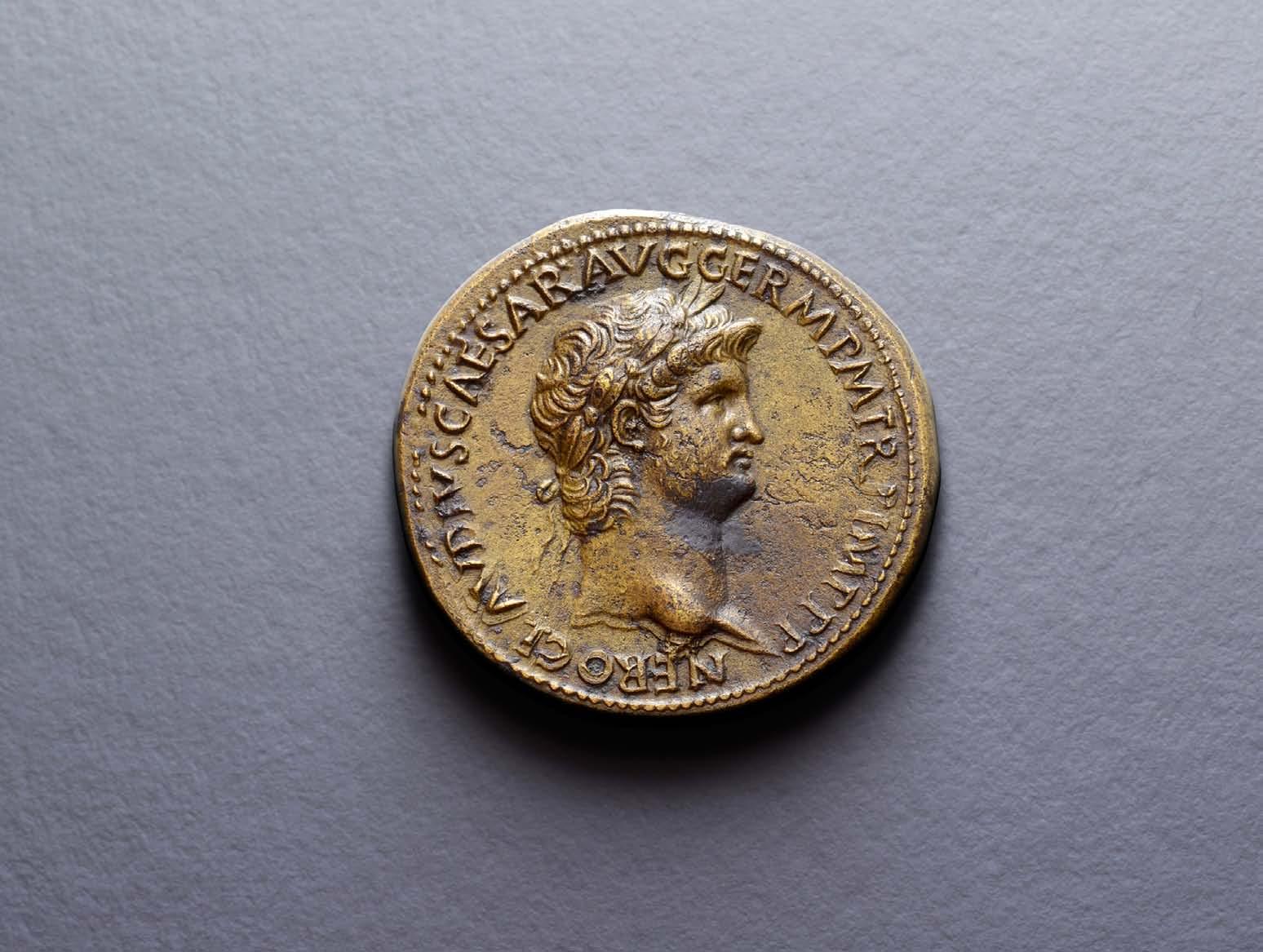
Ex Roma Numismatics Ltd., Auction XX, 25 March 2022, lot 555.
‘In no one thing was Nero more prodigal than in his buildings’, claimed Suetonius before his description of the lavish Domus Aurea, and indeed numismatic evidence attests to the importance and extravagance of private and public construction projects during the rule of the infamous emperor (Life of Nero, 31).


Tensions between the Parthian and Roman empires had long been brewing, but until the reign of Nero these had manifested only as a series of proxy-wars, shows of force and diplomatic negotiations - the period has been likened to a ‘cold war ’ between the two powers (Poirot, ‘Julio-Claudian Foreign Policy in the First Century’, 2014). The War of Armenian Succession, as it became known, commenced in AD 58 when the Parthian king installed his brother Tiridates on the Armenian throne. A strategically important buffer zone, Armenia was a frequent flash-point between the two great powers. Initially, a Roman counter-attack proved successful in removing Tiridates and installing their own claimant to the throne, but the garrison forces left to hold the territory were soon overwhelmed and a humiliating defeat was inflicted on the Romans at Rhandeia. The Roman commander Lucius Caesennius Paetus was recalled as soon as news of this defeat reached the Senate in Rome in AD 63, by which time the Arch of Nero was allegedly already under construction ‘while the war was yet undecided….in disregard of known facts’ (Tac. Ann. 15.18). He was replaced by Gnaeus Domitius Corbulo, an experienced commander then acting as governor of the adjacent province of Syria. Gathering his forces, he re-opened diplomatic negotiations with the Parthians and agreed a settlement whereby Tiridates would remain as king of Armenia, but only when crowned as such by Nero himself.
Since the arch was apparently rededicated or destroyed following Nero’s damnatio memoriae, as F. Kleiner suggests (The Arch of Nero in Rome, 1985), this beautifully detailed reverse offers invaluable insight into the physical monument. Indeed, as Philip Hill emphasises, ‘coins are the sole evidence’ for the appearance of many Neronian edifices (‘Buildings and Monuments of Rome As Coin Types’, 1983, p.88): for instance, denarii depicted the hexastyle Temple of Vesta (RIC 62) and sestertii showed the Temple of Janus (RIC 265). O. Hekster, E. Manders and D. Slootjes record that 92 Neronian coin types celebrated the city, with an additional 49 types depicting new buildings in Rome and Ostia (‘Making History with Coins’, 2014, p.35). Though it is not possible to assess the faithfulness of the coin design to the original building, the detail on this example is extraordinary, with its

206
556.
garlanded archway, ionic columns, and elaborate reliefs around the triumphal archway.
9,000
Nero AV Aureus. Rome, AD 65-66. NERO CAESAR AVGVSTVS, laureate head to right / VESTA, domed hexastyle temple, Vesta inside seated facing, head to left, holding patera and sceptre. RIC I 61; C. 334; BMCRE 101-103; Calicó 448. 7.30g, 19mm, 7h. Very Fine; rev. scratch.
557. 1,500
Nero Æ Sestertius. Rome, AD 65. NERO CLAVDIVS CAESAR AVG GER P M TR P IMP P P, laureate bust to right, slight drapery on far shoulder / Roma, helmeted and draped, seated to left on cuirass, right foot on helmet, holding Victory in outstretched right hand and resting left hand on parazonium; to right, shields set on ground; S-C across fields, ROMA in exergue. RIC I 275 var. (wearing aegis); WCN 137 var. (same); BMCRE 180 var. (same); BN 364 var. (same). 27.90g, 35mm, 6h.

Extremely Fine; engraved in fine style, with a superbly detailed reverse.
This coin published at www.moneymuseum.com;
Ex Long Valley River Collection, Roma Numismatics Ltd., Auction XX, 29 October 2020, lot 550;
Ex Classical Numismatic Group, Triton XVIII, 6 January 2015, lot 1033;
Ex MoneyMuseum Zürich Collection, Classical Numismatic Group, Triton XVIII, 6 January 2015, lot 1033 (hammer: USD 15,000);
Ex Kurt P. Wyprächtiger Collection, Bank Leu AG, Auction 7, 9 May 1973, lot 346.
The reverse of this magnificent sestertius displays a finely detailed depiction of Roma. Conceived of by Romans as ‘Amazonian’, militaristic by nature, holding Victory in her palm and gripping the parazonium (a leaf-shaped blade that was a ceremonial mark of rank and used to rally troops), she is the embodiment of the city of Rome, and more broadly the Roman state.


Unexpectedly, the cult of Dea Roma had emerged not at Rome, but in the Greek East. The earliest appearances of Roma are most likely found in the helmeted figure appearing on Roman cast bronze coins dating from 280-276 BC, however the identification is contestable. Other early Roman coinage displays a similarly warlike ‘Amazon’ type, who is also possibly Roma, but more likely a genius (defined as the individual instance of a general divine nature that is present in every individual person, place, or thing) of Rome than a distinct goddess. Certainly, Roma was in the time of the Republic not the subject of cult worship at Rome itself. The earliest attested temple dedicated specifically to Roma appears in Smyrna around 195 BC, and around the same time the cult of Roma appeared at Rhodes and other cities nearby. Such democratic city-states accepted Roma as analogous to their traditional cult personifications of the demos (the people). The cult of Roma spread relatively quickly within the provinces, and is accepted as having been the precursor for the later principate era state-sanctioned worship of living emperors as gods.
When in 30/29 BC the koina of Asia and Bithynia requested permission to honour Augustus as a living god, a cautious solution was devised; republican values held monarchy and Hellenic honours in contempt (the courting of both had proved fatal for Caesar), but refusal might offend loyal allies. Thus it was determined that non-Romans could only offer worship to Augustus as Divus jointly with Dea Roma. This dual worship of the State together with the head of state was a political and religious expedient, but while Augustus, Tiberius and Claudius were careful to refuse divine honours within Rome itself, subsequent rulers of arguably less stern moral fibre allowed or actively promoted worship of their own person. Indeed, Nero had in AD 64, the year before this coin was struck, instituted his depiction on the Roman coinage with the radiate crown previously reserved for deified (and deceased) emperors.
207 Ex Wyprächtiger Collection, Leu 1973
558.
6,000
Nero Æ Sestertius. Rome, AD 65. NERO CLAVDIVS CAESAR AVG GER P M TR P IMP P P, laureate bust to right, wearing aegis on far shoulder / Roma seated to left, holding Victory and parazonium; foot on helmet, shields behind, S-C across fields, ROMA in exergue. RIC I 275; C. 264; BN 364; BMCRE 180. 26.99g, 36mm, 6h.

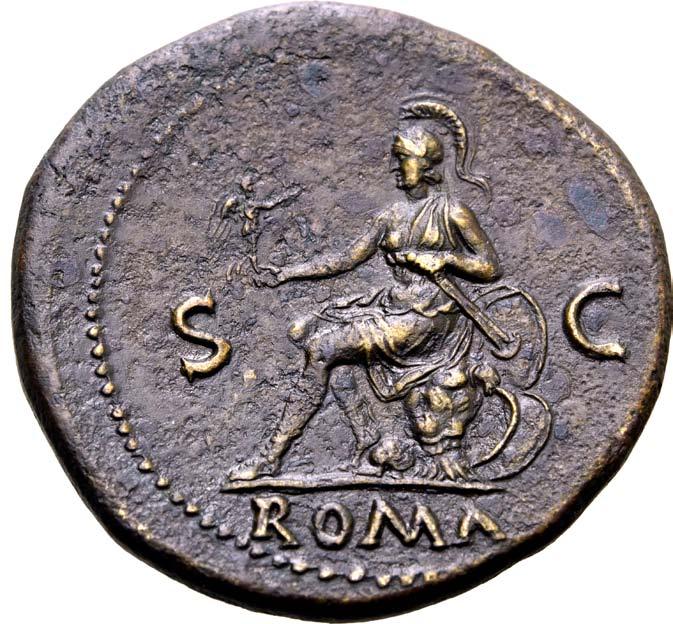

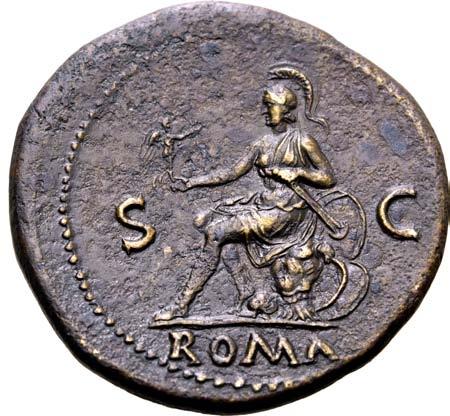
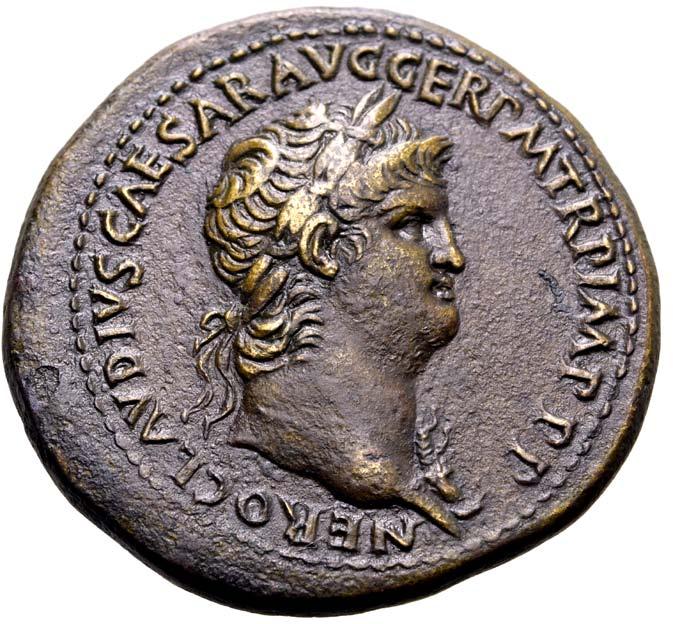
Extremely Fine.
Acquired from Noonan’s.
Nero Ӕ Dupondius. Lugdunum, AD 65. NERO CLAVD CAESAR AVG GER P M TR P IMP P P, laureate head to right, globe at point of bust / VICTORIA AVGVSTI, Victory advancing to left, holding wreath and palm; S-C across fields, II in exergue. RIC I 411; C. -; BN 88; BMCRE 349 bis, p. 398. 12.89g, 31mm, 7h.



Near Extremely Fine.
Acquired from Heritage World Coin Auctions; Privately purchased from Freeman & Sear, old dealer’s ticket included.
208
559. 1,200
450
560.
A Marvellous Sestertius Depicting the Temple of Janus

Nero Æ Sestertius. Rome, AD 67. IMP NERO CLAVD CAESAR AVG GERM P M TR P XIII P P, laureate head to right, aegis on far shoulder / PACE
P R TERRA MARIQ PARTA IANVM CLVSIT, view of the Temple of Janus, decorated with garlands and with door closed; S-C across fields. RIC I 354; C. 145; WCN 171. 25.24g, 37mm, 5h.
Near Mint State; some visually insignificant flan flaws, beautiful, untouched Tiber tone. A wonderful portrait sestertius of Nero with a highly attractive architectural reverse.


Ex Long Valley River Collection, Roma Numismatics Ltd., Auction XX, 29 October 2020, lot 560; Privately purchased from Arsantiqva by Moruzzi Numismatica; Ex Artemide Aste s.r.l. (San Marino), Auction III, 11 September 2004, lot 156.
Janus was a god unique to the Romans, for whom the ancient Greek pantheon (whence the greater part of the Roman religion was derived) had no equivalent. Janus was the god of gateways, beginnings and endings, transitions and duality, of war and peace. The structure commonly referred to as the Temple of Janus, but more correctly the Ianus Geminus, Ianus Quirinus or Portae Belli, was not a temple at all in the traditional sense. Built by the second king of Rome, Numa Pompilius, the doors of the Ianus Geminus were opened to indicate that Rome was at war and closed during times of peace. Since the time of Numa and before the time of Nero, the doors were said to have been closed only in 235 BC, after the first Punic war; and three times during the reign of Augustus.
The structure itself was probably originally conceived and executed in wood and other perishable materials, but contained an archaic bronze statue of the god which held in the one hand a key, denoting his role as the supreme gate-keeper in both spatial and temporal senses, and in the other a staff, signifying both his authority and role as a divine guide. Said to have been situated between the Forum Julium and the Forum Romanum, close to where the Argiletum entered the forum, it consisted of twin gates opposite each other; the cult statue was between them. No roof is indicated, and it may have been an open enclosure. While there is no literary evidence that the temple was destroyed or rebuilt, it must have been moved to make way for the construction of the Basilica Aemilia in 179 BC.
The Ianus Geminus as it existed from that time until the reign of Domitian, and as depicted on this and other coins struck by Nero, evidently had walls of ashlar masonry under a grated window set beneath a decorated frieze. Double doors of bronze and iron are reported by Virgil, and are shown framed by columns, with a wreath hanging overhead. Virgil, whose literary epic the Aeneid enshrined and embellished Roman traditions for eternal posterity, relates that “When the senators have irrevocably decided for battle, the consul himself, a figure conspicuous in Quirine toga of State and Gabine cincture, unbolts these gates, and their hinge-posts groan; it is he who calls the fighting forth” (Virgil, Aeneid, VII.601-615). Yet Virgil and his contemporaries Ovid and Horace disagreed on the meaning of the ritual closing of the gates. To Virgil, it was War that was being locked behind the twin gates; for Ovid and Horace, it was Peace that was kept within. Regardless, the symbolism of opening or closing the gates of the Ianus Geminus was powerful indeed; thus following the favourable end to a war with Parthia in 63 thanks to the efforts of the general Gnaeus Domitius Corbulo, and the general establishment of peace across Rome’s borders by 65, Nero famously closed the doors to great fanfare in AD 66 as a sign that all war was at an end.
209
561.
6,000
The Senate and People of Rome
Galba AV Aureus. Rome, July AD 68 - January AD 69. IMP SER GALBA AVG, bare head to right / S P Q R OB C S in two lines, all within oak wreath. RIC I 164; C. 286; BMCRE 29 corr. (bust type); Calicó 509a. 7.38g, 20mm, 9h.
Good Very Fine.
Ex Roma Numismatics Ltd., Auction XXIII, 25 March 2022, lot 862; Ex Collection of GK, Ukrainian Emigrant, Roma Numismatics Ltd., Auction XXI, 24 March 2021, lot 549.
9,000
Whilst Galba was proconsul of Nearer Spain, he became an ally of Vindex, the governor of Gaul, in his revolt against Nero. Following Nero’s suicide, Galba marched on Rome and was declared emperor by the Senate at the advanced aged of 70, the first princeps from outside of the Julio-Claudian family. Dio Cassius related that Galba put great emphasis on how the Senate had bestowed power on him, that “he did not adopt the name Caesar until the senate’s envoys had come to him… or hitherto even styled himself emperor in any communication.” After his accession, Cassius wrote, some citizens “even wore liberty caps, signifying that they had now become free… and voted to Galba the prerogatives pertaining to the imperial office.”
(Epitome LXIII.29.1)
This coin bears numismatic testament to this concern to appear a selfless leader designated by the senate with a clear, unmistakable celebration of the traditional elements of the Roman state. The bold reverse type boldly utilised the traditional type of the corona civica with the legend indicating it was ‘bestowed by the Senate and People of Rome, for having saved the citizens’. His portrait, a venerable image of an elder statesman with a deep frown, craggy nose and serious, determined expression, represents a return to the veristic mode of portraiture popular in the heyday of the Republic. Under that structure, authority derived from age, rank and experience, qualities which were emphasised in sculptural portraits of senators at the time, against which the idealised Hellenistic style adopted by Augustus and the later Julio-Claudian emperors appears in marked contrast.








Near Extremely Fine.
Ex Phidias (Paris), vente numismatique, 29 June 2022, lot 190.
1,050
210
562.
Vespasian AR Denarius. Rome, AD 70. IMP CɅESɅR VESPɅSIɅNVS AVG, laureate head to right / CɅESɅR ɅVG F COS CɅESɅR ɅVG F P R, confronted bare heads of Titus to right and Domitian to left. RIC II.1 16; BMCRE 2; RSC 5 (Vespasian, Titus and Domitian). 3.38g, 18mm, 6h.
563.
564.
“Judaea Capta” Commemorative Issue
Vespasian AV Aureus. “Judaea Capta” commemorative issue. Rome, AD 71. IMP CAES VESP AVG P M, laureate head to right / Victory standing to right on globe, holding wreath and palm; VIC-AVG across fields. RIC II.1 47; C. 583; BMCRE 63; BN 47; Calicó 698; Roma XV, 527 (hammer: 5,500 GBP). 7.28g, 18mm, 6h.


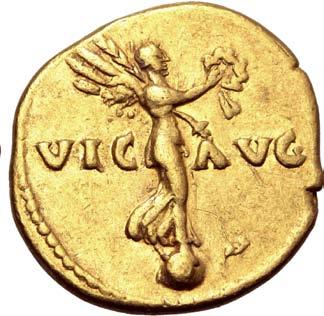

Good Very Fine.
Ex Roma Numismatics Ltd, E-Sale 100, 28 July 2022, lot 1028.




Part of the series of victory issues struck after the successful conclusion of the Jewish War.
Only 3 Known to Cayón
2,700
Vespasian Æ Sestertius. Rome, AD 71. IMP CAES VESPASIAN AVG P M TR P P P COS III, laureate head to right, slight drapery on far shoulder / ROMA RESVRGES, emperor standing to left, raising kneeling Roma; goddess Roma standing to right behind, holding spear and shield; S C in exergue. RIC II.1 195; C. 425 var. (obv. legend, bust type); BMCRE 565 var. (bust type); Cayón 157 (only three specimens listed). 26.52g, 34mm, 6h. Good Very Fine. Extremely Rare, Cayón listed only three specimens.

565. 900
Vespasian Æ Sestertius. Rome, AD 71. IMP CAES VESPAS AVG P M TR P P P COS III, laureate head to right / FORTVNAE REDVC[I], Fortuna standing to left, holding branch and rudder on globe and cornucopiae; SC in exergue. RIC II.1 230; C. 188 corr. (obv. legend); BMCRE 529. 24.70g, 32mm, 6h.

Extremely Fine.
1,800
Domitian AV Aureus. Rome, AD 82. IMP CAES DOMITIANVS AVG P M, laureate head to right / TR POT IMP II COS VIII DES IX P P, helmeted and draped bust of Minerva to left, wearing aegis. RIC II.1 140; C. 609 var. (rev. type); BMCRE 33; Calicó 938b (same rev. die). 7.67g, 20mm, 5h. Very Fine.
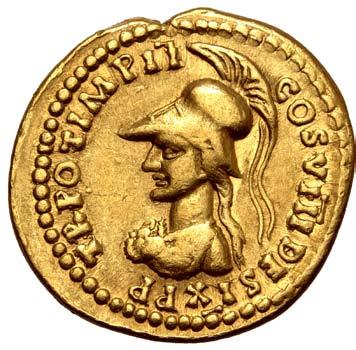


3,000

211
567.
566.
An Aureus of Sculptural Quality


Domitian AV Aureus. Rome, AD 87. IMP CAES DOMIT AVG GERM P M TR P VI, laureate head to right / IMP XIIII COS XIII CENS P P P, female German captive seated on shield to right in attitude of mourning; broken spear below. RIC II.1 513 (R2); C. -; BMCRE -; Calicó 882. 7.62g, 20mm, 6h. Extremely Fine; light traces of mounting and marks, an excellent example, with wonderful reverse detail. Previously graded Ch XF 5/5 - 3/5, Fine Style, edge filed (#4282739-003). Very Rare.


Ex Numismatica Ars Classica, Auction 120, 6 October 2020, lot 738;
Ex Classical Numismatic Group, Triton XXIII, 14 January 2020, lot 711;
Ex Leu Numismatik AG, Auction 2, 11 May 2018, lot 248; Ex cgb.fr, e-Monnaies March 2017, lot 68.
12,000
212
568.


213
Domitian AV Aureus. Rome, AD 88. DOMITIANVS AVGVSTVS, laureate head to right / GERMANICVS COS XIIII, Germania seated to right on shield; broken spear below. RIC II.1 560 (same dies); C. 148; BMCRE 143; Biaggi 407; Calicó 838 (same dies). 7.64g, 20mm, 6h.
Near Mint State; small planchet manufacturing flaw on neck, a marvellous portrait of Domitian. Rare.

Ex Numismatica Ars Classica, Auction 41, 20 November 2007, lot 69;
Ex Sotheby’s, 8 July 1996, lot 168;
Ex Numismatic Fine Arts, Auction XX, 9 March 1988, lot 168.
30,000
This beautiful issue was struck in commemoration of Domitian’s campaigns against the Chatti in Germany in AD 83. At Domitian’s accession following the death of both his father and brother, Domitian was keen to accrue military victories of his own. Much of his career had been spent performing a purely ceremonial role in the governance of the provinces, and his lust for glory following his father and brother ’s impressive military victories was noted by Suetonius, as he explains he “...planned a quite unnecessary expedition into Gaul and Germany, from which his father’s friends managed to dissuade him”.
Domitian’s pathological need to prove himself and equal his familial predecessors’ achievements is perhaps understandable given the shadow of reflected glory he had lived in all his life; the new emperor’s opportunity presented itself when the Chatti, a German tribe, invaded Roman territory in the area of modern Mayence. By AD 83/84 Domitian had successfully dealt with the incursion and for his victory, a distinction he had long been craving, Domitian staged a triumphal entry to the capital with pomp and splendour. He also granted himself the title of ‘Germanicus’ (see Jones, The Emperor Domitian, p. 128-131), he renamed the month of September ‘Germanicus’ and from the year AD 85 he began minting coins with the legend GERMANIA CAPTA, an echo of the magnificent triumphal celebrations of AD 71, when Vespasian and Titus returned to Rome following the pacification of Judea.
It was in this context that the present aureus was struck. Encompassed by the emperor ’s new title ‘Germanicus’ and the formula denoting his consulship for the fourteenth time sits a figure with her head bowed, resting in her hand, the personification of Germania - mourning. Soft drapery falls over Germania’s lap as she sits beside an ornate hexagonal shield that could not withstand the might of the Roman forces and a spear, broken in the middle and rendered unusable. The pathos of this scene is reminiscent of the sculpture now generally referred to as the Dying Gaul and housed in the Capitoline Museums in Rome.

However, doubt is cast on the validity of Domitian’s success against the Chatti by Suetonius, who deemed the campaign ‘unjustified’ (Suetonius, Life of Domitian 6) and Tacitus in his ‘Agricola’. Though perhaps somewhat biased as Tacitus was writing about the life of his father-in-law, when discussing his successes in Britain he mentions that “Domitian heard, as was his wont, with joy in his face but anxiety in his heart. He felt conscious that all men laughed at his late mock triumph over Germany, for which there had been purchased from traders people whose dress and hair might be made to resemble those of captives, whereas now a real and splendid victory, with the destruction of thousands of the enemy, was being celebrated with just applause.” These writers saw the campaign and the proceeding celebrations as extravagant beyond reason. To them it seemed a construction to overshadow the glory granted to Vespasian and Titus, considering the very small territorial gain the campaign resulted in and the fact that neither Vespasian nor Titus took the title ‘Iudaicus’ following their victories in Judea (Jones, The Emperor Domitian, p. 129), .
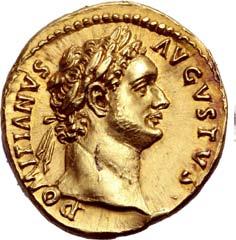
214 Ex NFA 1988
Yet despite being wrapped up in a programme of self-aggrandizement the campaign was in itself significant and had a lasting historical impact, not so much for the territory gained than for the measures taken to secure this territory in the future. With his victory over the Chatti, Domitian laid the foundations for a new system of securing the Roman frontiers in Germany, which resulted in the Limes: a series of watch towers, signal stations and a network of roads with which the borders of the empire could be rapidly reinforced and defended. 569.

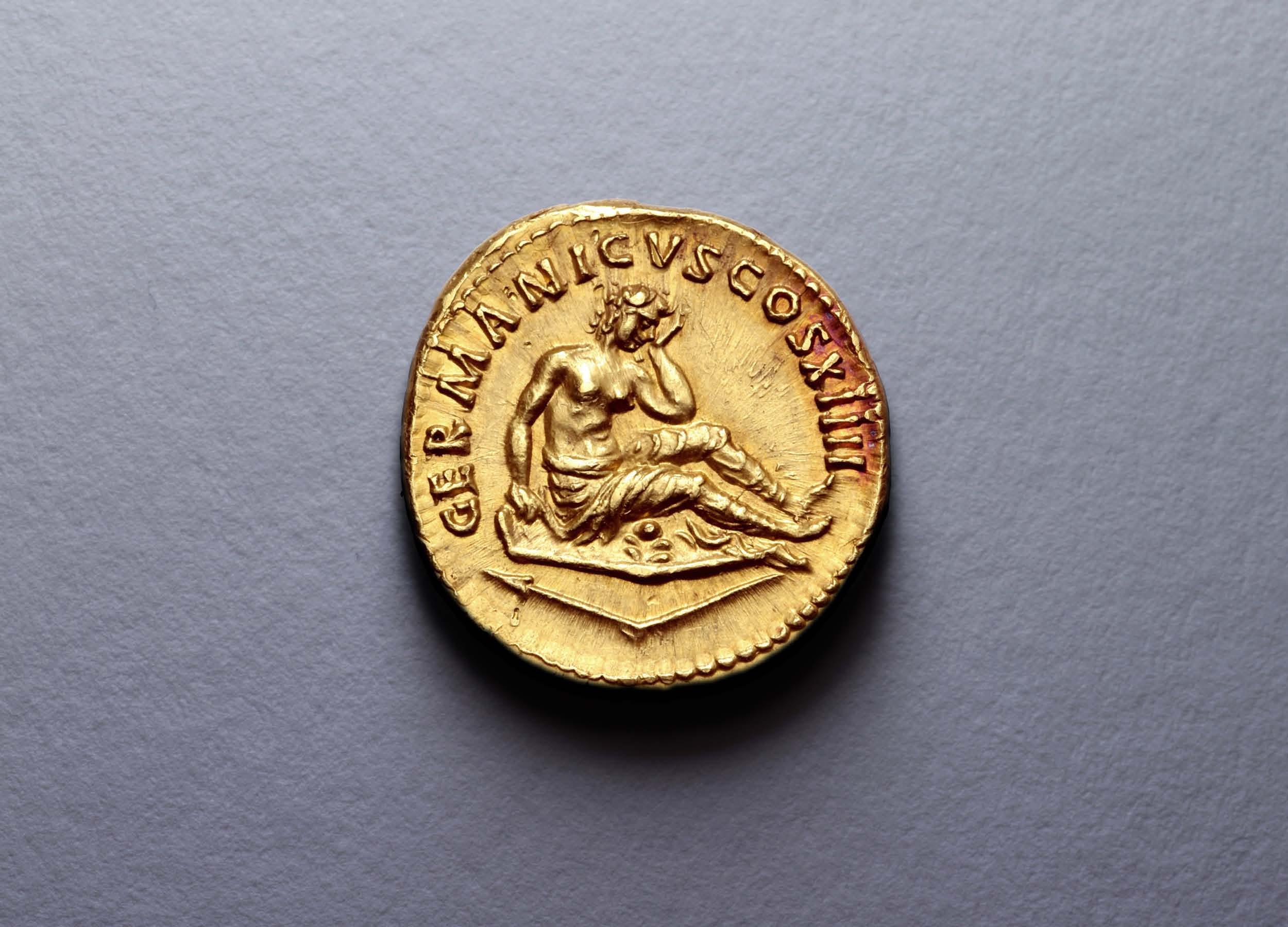
215
Domitian AV Aureus. Rome, AD 95-96. DOMITIANVS AVGVSTVS, laureate head to right / GERMANICVS COS XV, Minerva standing to left, holding spear. RIC II.1 698 (same dies); C. 150; BMCRE 173; Calicó 839. 7.43g, 20mm, 7h.
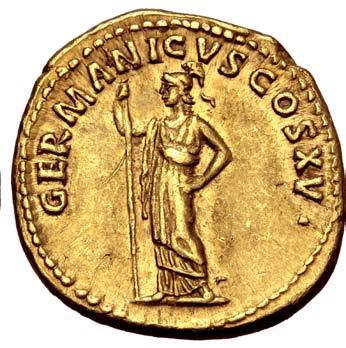




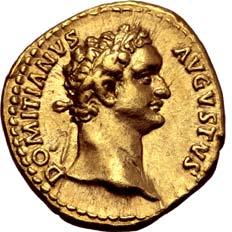


Good Very Fine; rev. scratch. Rare.
Domitian AV Aureus. Rome, AD 95-96. DOMITIANVS AVGVSTVS, laureate head to right / GERMANICVS COS XV, Minerva standing to left, holding spear. RIC II.1 698; C. 150; BMCRE 173; Calicó 839. 7.43g, 20mm, 7h.
Nerva AR Denarius. Rome, AD 96. IMP NERVA CAES AVG P M TR P COS II P P, laureate head to right / AEQVITAS AVGVST, Aequitas standing to left, holding scales and cornucopiae. RIC II 1; BMCRE 1; RSC 3. 3.58g, 18mm, 6h.

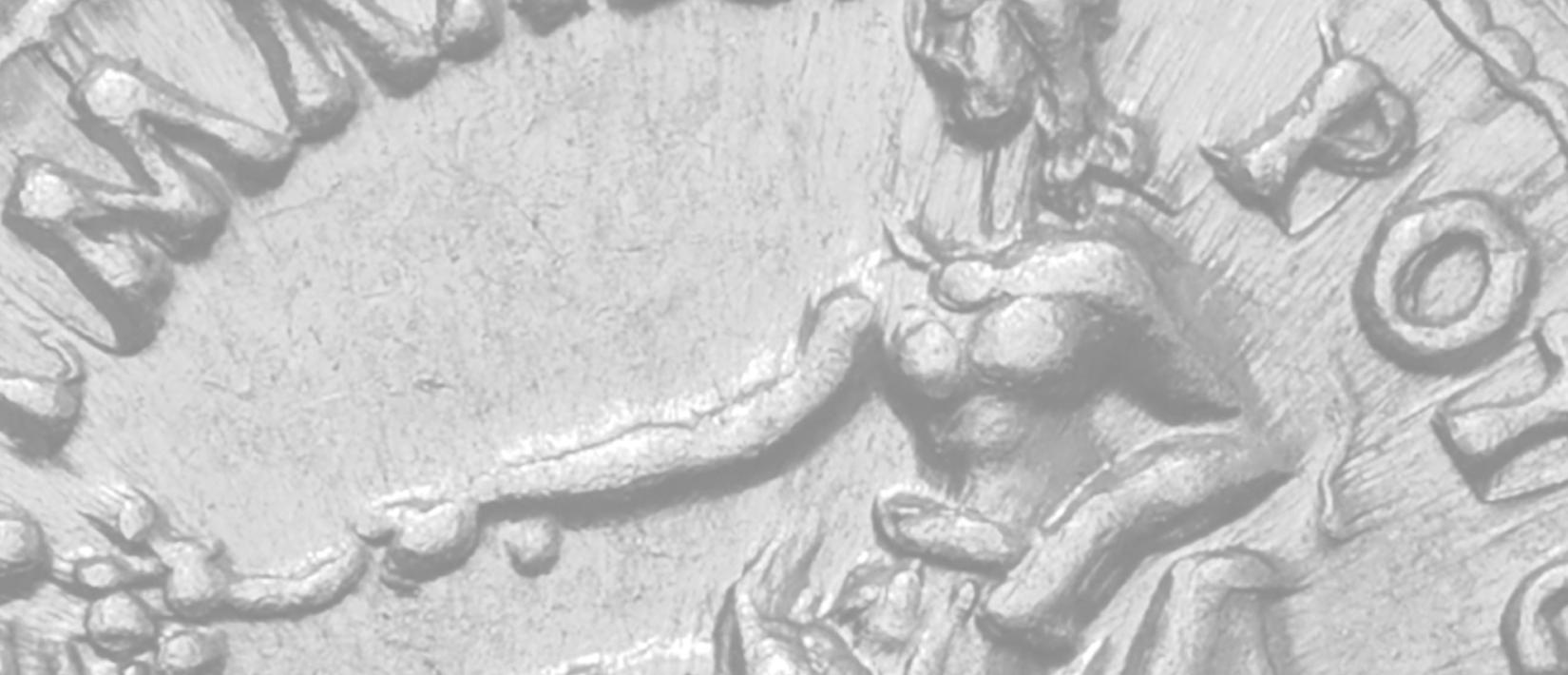

from Apollo Art Auctions.

216
Good
Very Fine. Rare. 571. 3,600
570. 3,600
Extremely
Acquired
572. 450
Fine.
Nerva AR Denarius. Rome, AD 97. IMP NERVɅ CɅES ɅVG P M TR P COS III P P, laureate head to right / SALVS PVBLICɅ, Salus seated to left, holding corn-ears. RIC II 20; BMCRE 48; RSC 134. 3.42g, 19mm, 7h.




Near Mint State; lustrous fields.
Acquired from Classical Numismatic Group.
Very Rare
Trajan AV Aureus. Rome, AD 98. IMP CAES NERVA TRAIAN AVG GERM, laureate head to right / PONT MAX TR POT COS II, Germania, nude to waist, seated to left on pile of shields, resting arm on hexagonal shield and holding olive branch in outstretched hand. RIC II 15; BMCRE 8; Woytek 23a; Calicó 1070 (same rev. die). 7.65g, 20mm, 6h.
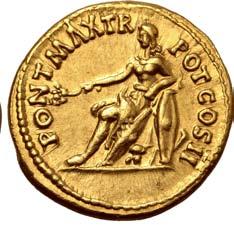
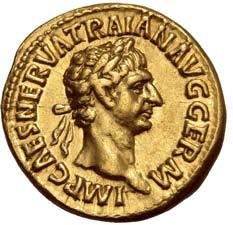





Near Extremely Fine. Very Rare.
Trajan AV Aureus. Rome, AD 101-102. IMP CAES NERVA TRAIAN AVG GERM, laureate bust to right, wearing aegis / P • M • TR P • COS • IIII • P • P, Hercules standing facing on low base, holding club and lion skin. RIC II 50; C. 232; BMCRE 81; Woytek 99c; Calicó 1053. 7.27g, 19mm, 6h.
Near Extremely Fine.
Trajan was the first of the Roman emperors to depict the figure and attributes of Hercules on his coinage. This was perhaps on account of Trajan having been born in Italica in southern Spain where Hercules was particularly venerated as Hercules Gaditanus (the name pertaining to the temple to Hercules outside the Phoenician city of Gadir on the southern coast of Spain). Strack argued that this type is a depiction of the cult-image of Hercules Gaditanus, and though the image is certainly suggestive of being a representation of a cult-statue, there is no corroborating evidence (Untersuchungen zur römischen Reichsprägung des zweiten Jahrhunderts. I. Die Reichsprägung des Traian, Stuttgart, 1931). Indeed, the reverse types of Hadrian make specific reference to Hercules Gaditanus and depict Hercules standing from an altogether different viewpoint, with the attribute of the apples of the Hesperides rather than the lion skin (see RIC II 125).
An equally likely source for the representation may have been the statue that stood near the Ara Maxima Herculis Invicti, the great altar to the hero in the Forum Boarium in Rome. This was a sacred spot which legend tells us was where Hercules killed the giant Cacus who had stolen some of the cattle of Geryon from him (for the full story see Livy 1.7). Despite this, the gilded bronze statue discovered on the site of the Forum Boarium, now housed by the Capitoline Museum of Rome, also lacks the attribute of the lion skin.
Lacking a clear source for the representation, this attractive aureus is best understood within the context of the close association Trajan cultivated between himself and Hercules. The orations addressed to Trajan by Dio Chrysostom directly identify the emperor with Hercules, a comparison also made by Pliny (see Dio Chrysostom, On Kingship A, 84 and Pliny, Panegyricus, 14.5). A series of quadrantes struck under Trajan make the same equation, depicting Hercules in the place of the emperor on the obverse, alongside his imperial titles (RIC II 698, 700-2). In another numismatic representation, the column celebrating Trajan’s victory over the Dacians is depicted in the form of a club resting on a lion skin pedestal (see RIC II 581, pl. XI, 202), likening the emperor’s triumph to a Herculean labour. A statue in the collection of the Palazzo Massimo alle Terme in Rome makes the association most clear, depicting Trajan as Hercules-Silvanus, draped with a lion skin in much the same manner as Hercules depicted on the aureus presented here (for further discussion, see O. J. Hekster, Propagating power: Hercules as an example for second-century emperors in Herakles and Hercules, 2003, pp. 20-35).

217
573. 750
575. 3,000
574.
3,000
576.
Trajan AV Aureus. Rome, AD 103-107. IMP TRAIANO AVG GER DAC P M TR P COS V P P, laureate and draped bust to right / S P Q R OPTIMO PRINCIPI, emperor standing in slow triumphal quadriga, advancing to left, holding branch and eagle-tipped sceptre. RIC II 207; C. 493; BMCRE 247; Woytek 195g (same dies); Biaggi 535; Calicó 1101. 7.33g, 19mm, 7h.
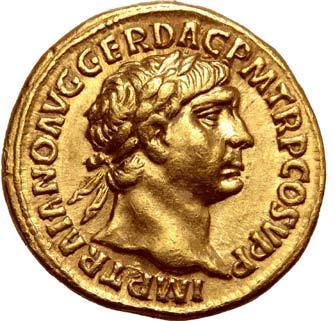





Near Extremely Fine.
Seemingly No Examples on CoinArchives
3,000
577.
Trajan AV Aureus. Rome, AD 103-104. IMP TRAIANO AVG GER DAC P M TR P COS V P P, laureate head to right / S P Q R OPTIMO PRINCIPI, emperor in military dress standing to left, holding spear and resting foot on head of Dacian. RIC II 210; C. 511; BMCRE 242; Woytek 180a; Calicó 1111. 7.20g, 19mm, 6h.


Near Extremely Fine. Extremely Rare; seemingly no examples on CoinArchives.
The Finest of Fewer than Five Known
2,400
Trajan Æ Sestertius. Rome, AD 104-107. IMP CAES NERVAE TRAIANO AVG GER DAC P M TR P COS V P P, laureate head to left / S P Q R OPTIMO PRINCIPI, Pax, draped, standing to left, holding branch downwards in right hand and cornucopiae in left, right foot treading down bust of fallen Dacian; S-C across fields. RIC II 506; C. 409; Lacourt I, Ia1, pl. 2, 1 (this coin); Woytek 200o-1 (same obv. die); BMCRE 803 (same obv. die). 28.68g, 34mm, 6h.
Good Extremely Fine; a perfectly centered specimen featuring a handsome portrait and a beautiful green patina, lightly smoothed in fields. Extremely Rare; seemingly the finest of fewer than five known examples.
3,000
This coin published in J. Lacourt, Sesterces des Antonins, Volume I - Nerva - Trajan (France, 2022); Ex Roma Numismatics Ltd., Auction XXIII, 24 March 2022, lot 920; Ex Numismatica Ars Classica, Auction 59, 4 April 2011, lot 967.

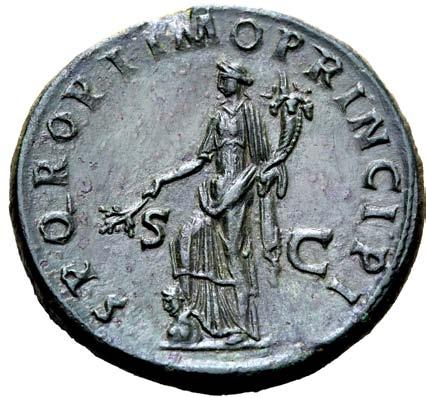


218
578.
A Wonderful Portrait
Trajan AV Aureus. Rome, AD 107-108. IMP TRAIANO AVG GER DAC P M TR P, laureate, draped and cuirassed bust to right / COS V P P S P Q R OPTIMO PRINC, eagle, with open wings and head to left, standing facing on thunderbolt. RIC II 144 var. (bust type); C. 96; BMCRE 351; Woytek 261f; Calicó 1009. 7.27g, 20mm, 7h.




579. 6,000
Extremely Fine; a wonderful portrait struck in high relief.
580. 300
Trajan AR Denarius. Rome, AD 107-108. IMP TRAIANO AVG GER DAC P M TR P, laureate head to right, slight drapery on far shoulder / COS V P P S P Q R OPTIMO PRINC, trophy with one round and two hexagonal shields; sword, two javelins and two shields at base. RIC II 147b; BMCRE 359363; Woytek 268b; RSC 100. 3.14g, 19mm, 6h.




Near Mint State, pleasant light cabinet tone, sharply struck.
Ex collection of Dipl.-Ing. Adrian Lang.
219
Sharply Struck
Trajan AV Aureus. Rome, AD 107. IMP TRAIANO AVG GER DAC P M TR P COS V P P, laureate, draped and cuirassed bust to right / S P Q R OPTIMO PRINCIPI in three lines within oak wreath. RIC II 150; C. 581; BMCRE 253-6; Strack 99; Woytek 224f; Calicó 1121. 7.51g, 19mm, 7h.

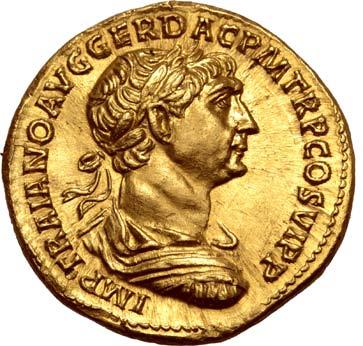

581. 4,500
Extremely Fine.
582. 180
584.
Trajan AR Denarius. Rome, AD 107. IMP TRAIANO AVG GER DAC P M TR P COS V P P, laureate bust to right, slight drapery on far shoulder / S P Q R OPTIMO PRINCIPI, trophy with one round and two hexagonal shields; curved sword, two javelins and two shields at base. RIC II 226; BMCRE 251; Woytek 231b; RSC 571. 3.03g, 19mm, 7h.



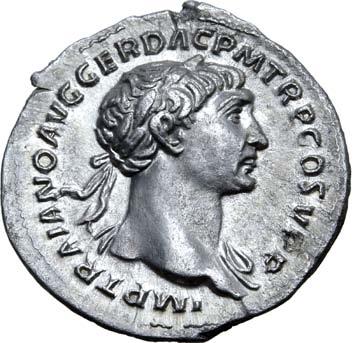

Near Mint State.
Acquired from Classical Numismatic Group.
An Extremely Rare Restitution Issue
Trajan AR Denarius. Restitution issue of P. Cornelius Lentulus Marcellinus. Rome, AD 112-113. Bare head of the consul M. Claudius Marcellus to right; triskeles behind, MARCELLINVS before / IMP CAES TRAIAN AVG GER DAC P P REST, M. Claudius Marcellus advancing to right, carrying trophy into tetrastyle temple; MARCELLVS to right, COS•QVINQ to left. RIC II 809; BMCRE 689; Woytek 834; Komnick Type 36.0; H. Mattingly, “The Restored Coins of Trajan,” NumChron 1926, 35; RSC 35. For prototype, cf. Crawford 439/1; cf. BMCRR Rome 4206; cf. RSC Claudia 11. 3.38g, 20mm, 7h.


Good Very Fine; small scratch to obverse. Extremely Rare; 10 examples known to Woytek, apparently one of only two examples in private hands. Ex Marti Hervera and Soler & Llach, Auction 1128, 15 June 2022, lot 1109.
Near Mint State
1,200
Trajan AV Aureus. Rome, AD 113-114. IMP TRAIANO AVG GER DAC P M TR P COS VI P P, laureate, draped and cuirassed bust to right / S • P • Q • R OPTIMO PRINCIPI, aquila between vexillum surmounted by hand on left and signum surmounted by wreath on right. RIC II 294 var. (bust type); BMCRE 456; Woytek 418f-3; Beckmann, Early, Group VIII, 12 (S6); Biaggi 544; BN 735; Calicó 1118. 7.26g, 20mm, 6h.





Near Mint State.
4,500
220
583.
585.
A Bold Portrait of Fine Style
Hadrian AV Aureus. Rome, AD 119-122. IMP CAESAR TRAIAN HADRIANVS AVG, laureate, draped and cuirassed bust to right / P M TR P COS III, Jupiter, naked to waist, seated to left on throne, holding thunderbolt and sceptre. RIC II.3 513; C. 1060; BMCRE 107; Calicó 1304a. 7.41g, 19mm, 6h.

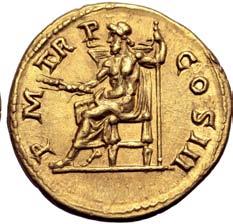
9,000
Good Extremely Fine; a beautiful well-detailed portrait in high relief.
Ex Roma Numismatics Ltd., Auction XX, 30 October 2020, lot 597.

This beautiful aureus was struck after Hadrian had assumed the consulship for the third time in AD 119. In the days of the Republic to assume the consulship once, let alone twice or three times was one of the greatest honours to which a senator could aspire, and was often the culmination of a lifetime of public service both in government and on the field of battle. The Historia Augusta relates that ‘his own third consulship he held for only four months’ and that ‘having himself been consul three times, he reappointed many to the consulship for the third time and men without number to a second term’ (HA 8.5-6). Hadrian’s largesse and generosity towards the Senate in the early years of his reign stands in stark contrast to the austere, even hostile, attitude that characterise his last; his successor Antoninus Pius earned that most recognisable of cognomens for assuring the posthumous deification of Hadrian, possibly helped by the fact that ‘as Hadrian grew more cruel, he rescued many senators from the emperor ’ (HA 24.4).


586.
Hadrian


Near Extremely Fine; a highly attractive example. Rare.
Ex Roma Numismatics Ltd., Auction XXIII, 25 March 2022, lot 969.
600
221
Æ Sestertius. Rome, AD 125-127. HADRIANVS AVGVSTVS, laureate bust to right, slight drapery on far shoulder / COS III, Neptune standing to right, foot set on prow, holding trident and acrostolium; S-C across fields. RIC II.3 814; C. 305 var. (bust type); BMCRE 1288. 27.65g, 35mm, 5h.
A Magnificent Portrait
587.
Hadrian AV Aureus. Rome, AD 125-127. HADRIANVS AVGVSTVS, laureate, draped and cuirassed bust to right / COS III, emperor on horseback to right, raising hand. RIC II.3 782; C. 406; BMCRE 434; Calicó 1216. 7.36g, 20mm, 6h. Good Extremely Fine; a magnificent portrait on a large planchet. Rare. Ex Roma Numismatics Ltd., Auction XXV, 22 September 2022, lot 1021.




10,500
Hadrian AR Denarius. Rome, AD 130-133. HADRIANVS AVG COS III P P, laureate head to right / NILVS, Nilus reclining to right, holding reed and cornucopiae, hippopotamus to right. RIC II.3 1543; BMCRE 862; RSC 991. 3.29g, 18mm, 7h. About Extremely Fine. Ex collection of Dipl.-Ing. Adrian Lang.




222
588.
300
The Work of the ‘Alphaeus Master’
Hadrian Æ Sestertius. Rome, AD 133-135. HADRIANVS AVG COS III P P, bare-headed and draped bust to right / PAX AVG, Pax standing to left, holding branch and cornucopiae; S-C across fields. RIC II.3 2167 (same dies); C. 1016; BMCRE 1528; NAC 54, 432; NGSA 5, 233 = Sotheby’s (Hunt), 134 = M&M 52, 617 (same dies); Glendining (Ryan V), 2548 = Naville II (Vautier-Collignon), 732 = J. Hirsch XXXI, 1325 (same dies); M&M XVII, 451 = Hess (Trau), 1267 = Toynbee pl. I.4 = BMFA Roman Medallions no. 24 (same dies); Lanz 94, 498 = M&M Basel, 12-13 November 1970, 343 (same dies). 21.24g, 34mm, 6h.

Good Very Fine; somewhat corroded surfaces, cuprite gently levelled out in parts. Excessively Rare; the work of the ‘Alphaeus master’, one of only six examples known.
Ex Numismatik Lanz München, Auction 94, 22 November 1999, lot 498; Ex Münzen & Medaillen AG Basel, Auction 318, 12 November 1970, lot 343.
It is the quality of engraving employed for the dies used to strike this sestertius of Hadrian that mark it out for high praise: only one die pair is known for the type and is attributed to the work of a medallion engraver whom Charles Seltman dubbed the ‘Alphaeus master ’ and declared “a brilliant man”. This enigmatic die-engraver has been identified with the sculptor Antonianus of Aphrodisias, whose superb classical style embodied the revival of Greek art and culture under Hadrian and with whose reliefs stylistic parallels can be drawn. Equally, Seltman argued that the “strong characteristic gemengraver’s manner” with which this die was engraved perhaps identifies the Alphaeus master as a gem-engraver working within the imperial court, as the gem-engraver Dioskourides worked for Augustus. (1948, p.83)
In her seminal work on Roman Medallions (1944, p.32), Toynbee described this type as a “medallic coin” which paired a standard, albeit highly elegant, reverse die engraved for a sestertius (with SC inscribed) with an obverse die intended for a larger bronze medallion. Indeed, she ascribes two bronze medallions of Hadrian in Gnecchi to the Alphaeus master, the second of which (pl. 42, no. 4) is remarkably close to (and Toynbee thought perhaps the same die as) the obverse die of the present sestertius.
Just as medallions were minted on occasions of great importance in the reign of a Roman emperor, P. V. Hill suggests this medallic sestertius was minted to mark Hadrian’s vicennalia or twentieth anniversary as Roman emperor in AD 135. (1970, p.167) The impressive authoritative portrait of the veteran emperor is carved with astonishing delicacy and precision, particularly notable in the wave-like hair which curls forward around the temples, his angular features, and full cropped beard.

Although identification remains elusive, the Alphaeus master is the most celebrated die engraver of the Roman period. Seltman concluded his discussion of the artist with the words “skill and elegance of manner mark all the work of this man – the last engraver to employ that style which we have come to regard as Classical Greek.” (1948, p.85) Thus, these masterful rare medallic sestertii of Hadrian, of which there are seemingly only five that have appeared on the market in the last century, are highly-prized by collectors of Roman coinage. There is no better indication of the desire for this type than the Nelson Bunker Hunt example, which holds the record for the highest price for a Roman coin achieved at auction, having sold in 2008 for CHF 2,000,000 (NGSA 5, 233).

223
589.
6,000
Hadrian AV Aureus. Rome, AD 136. HADRIANVS AVG COS III P P, bare-headed bust to right, slight drapery on far shoulder / VICTORIA AVG, Victory advancing to right, head to left, holding wreath and palm branch. RIC II.3 2236 (this coin illustrated); C. 1452; BMCRE p.335 note; Calicó 1394a (cf. 1393, same rev. die). 7.38g, 19mm, 7h. Near Mint State. Very Rare and among the finest known examples of the type.




This coin illustrated in R.A. Abdy and P.F. Mittag, Roman Imperial Coinage II.3 (London, 2019); Ex Bolla Collection, A. Tkalec AG - Astarte S.A., 28 February 2007, lot 36; Reportedly privately purchased from M. Ratto in 1958.
This reverse type most likely makes reference to Hadrian’s victory over Simon Bar Kochba in Judaea during the last Romano-Jewish war, known to contemporary Romans as the Expeditio Judaica (Jewish Expedition). Strack (pp. 132–9) and Mattingly (BMCRE p. cxlvi), both attribute the Victory reverses on the late aurei of Hadrian to this victory. This large-scale rebellion lasted from AD 132-136, and succeeded in establishing an independent state of Israel over parts of Judaea for over two years. Jewish gains were short-lived however, as Hadrian drafted in six full legions with auxiliaries and vexillations from up to six further legions, which finally crushed the revolt. According to Cassius Dio, 580,000 Jews were killed during the rebellion, 50 fortified towns and 985 villages were razed to the ground, and many more Jews sold into slavery. Roman military casualties were significant; Cassius Dio claimed that “many Romans, moreover, perished in this war”. Therefore, Hadrian, in writing to the Senate, did not employ the opening phrase commonly affected by the emperors: “If you and your children are in health, it is well; I and the army are in health.” Legio XXII Deiotariana was disbanded after severe losses, and Legio IX Hispana was possibly also disbanded as a result of the war, according to recent scholarship.
224
Expeditio Judaica - This Coin Illustrated in RIC
590.
21,000


225
591.
Sabina (wife of Hadrian) AV Aureus. Rome, AD 130-133. SABINA•AVGVSTA HADRIANI AVG P P, diademed and draped bust to right, wearing stephane / CONCORDIA•AVG, Concordia seated to left on throne, holding patera and resting arm on statue of Spes on low cippus. RIC II.3 2498; C. 11 corr. (rev. type); BMCRE 894 (Hadrian, same dies); Calicó 1429 (same dies). 7.36g, 19mm, 12h.
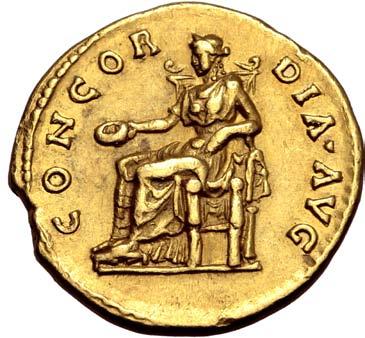

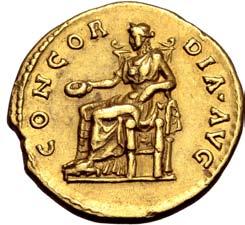

Good Very Fine; light reddish tone. Rare.
3,600
Ex Baldwin’s Auctions Ltd - Dmitry Markov Coins & Medals - M&M Numismatics Ltd, The New York Sale XXXII, 8 January 2014, lot 20 (hammer: USD 14,000);
Ex Numismatica Ars Classica, Auction 59, 4 April 2011, lot 1981.
592.
Antoninus Pius Ӕ As. Rome, AD 140-144. ANTONINVS AVG PIVS P P TR P COS III, laureate head to right / FELICITAS AVG, Felicitas standing facing, head to left, holding caduceus and branch; S-C across fields. RIC III 679; C. 366; BMCRE 1362-1364. 11.91g, 27mm, 12h. Extremely Fine; attractive brown patina.


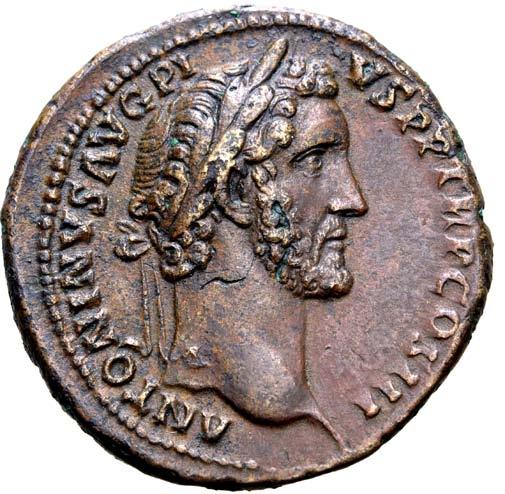


Ex collection of Dipl.-Ing. Adrian Lang;
Ex Baldwin’s Auctions Ltd - Dmitry Markov Coins & Medals - M&M Numismatics Ltd, The New York Sale XXIII, 6 January 2010, lot 173.
240
226
A Rare Aureus of Lucius Verus

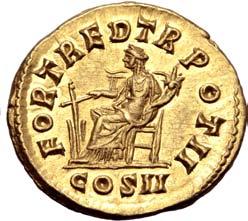


594.
Lucius Verus AV Aureus. Rome, AD 161-162. IMP L AVREL VERVS AVG, bare-headed and cuirassed bust to right / FORT RED TR POT II, Fortuna seated to left, holding rudder and cornucopiae; COS II in exergue. RIC III 476 (Aurelius); BMCRE 199 note (Aurelius & Verus); Calicó 2130 (same obv. die). 7.37g, 19mm, 6h.
Good Extremely Fine. Rare.
Acquired from Numismatica Ars Classica.
7,500
Lucius Verus, co-emperor with his better-known adoptive brother Marcus Aurelius from 161 until his death from disease in 169 AD, was the eldest son of Lucius Aelius Caesar, Hadrian’s first intended heir who died in 138 AD. Verus was adopted by Antoninus Pius alongside Marcus Aurelius and thus eventually became one of the first co-rulers of the Roman Empire, a system for the division of responsibilities which became more commonplace towards the end of the second century. Their partnership was cemented by Lucius Verus’ marriage to Marcus Aurelius’ daughter in 164 AD.
Verus’ portrait follows the Antonine mode with a long face, tightly curled hair and pointed beard, emphasising continuity between emperors and a united front with Marcus Aurelius through visual likeness even though there was no biological dynastic link. He is portrayed cuirassed, which by the time of Hadrian had become the dominant costume of imperial portraiture, emphasising the emperor ’s role in ensuring military security throughout the empire. This image of the emperor as a military figure looked back beyond the Julio-Claudian preference for static imperial images which emphasised religious piety and civic authority to the Hellenistic taste for heroic representation and strong gestural poses.
Verus indeed spent much of his reign shoring up the eastern boundaries of the Roman Empire. Shortly after Lucius Verus succeeded to the position of co-emperor, the peace Antoninus Pius had negotiated with the Parthians collapsed. The Parthian king Vologases IV invaded the Kingdom of Armenia, then a Roman client state, expelling the king and installing his own. Both initial attempts to recover the territory of Armenia by the Governor of Cappadocia, Marcus Sedatius Severianus, and the Governor of Syria, L. Attidius Cornelianus, were unsuccessful. Marcus Aurelius took the decision to send his imperial colleague Lucius Verus to defend the Eastern territories in person.
Lucius Verus AV Aureus. Rome, AD 163-164. [L] VERVS AVG ARMENIACVS, laureate, draped and cuirassed bust to right / TR P IIII IMP II COS II, Armenia seated to left, hand resting on bow and quiver, trophy behind; ARMEN in exergue. RIC III 507 (Aurelius) var. (bust type); C. -; BMCRE 297 (Aurelius & Verus); Biaggi 947 var. (bust type, same rev. die); Calicó 2108. 6.81g, 18mm, 6h.



Good Very Fine.
Ex Numismatica Ars Classica, Auction 84, 20 May 2015, lot 1912.
2,700
227
593.
A Powerful Portrait
Pertinax AV
AD 193.
holding out hand to star in left field. RIC IV 11a;
De Coin; lustrous metal, a powerful and sharply engraved portrait.
Acquired from Classical Numismatic Group (inventory no. 595027).
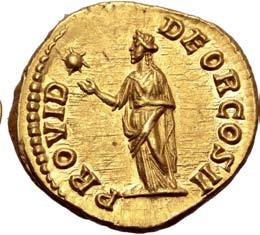
Pertinax was the first Emperor in the tumultuous ‘Year of Five Emperors’. His early life and career is well documented in the Historia Augusta: born into a humble family and the son of a freedman, Pertinax had originally tried to make his way in life as a teacher of grammar, but at some point decided to try to attain a greater station, and with the help of a patron he was commissioned an officer in the Roman army
Pertinax distinguished himself in a campaign against Parthia, and after postings in Britain and on the Danube he served as procurator in Dacia. His career suffered a serious setback during the reign of Marcus Aurelius on account of court intrigues, however he was recalled to assist Claudius Pompeianus during the Marcomannic Wars. In 175 he was made suffect consul, and he then served as governor of a string of provinces including Syria and Britain.
In the 180s he was sent to Britain where the army was in a state of mutiny. His attempt to calm the restive soldiers resulted in his bodyguard being attacked, and Pertinax was left for dead. After his recovery he severely punished the mutinous legion, adding to his reputation as a disciplinarian. In 187 he was forced to resign due to the legions having grown hostile to his strict command style. His career reached an apex when he was given the proconsulship of Africa, the urban prefecture of Rome, and a second consulship with the emperor as his colleague.
When Commodus was murdered on the last day of AD 192, Pertinax was still serving as urban prefect, and hurried to the Praetorian camp where he was proclaimed emperor the following morning. His attempts at reform and restraint, along with attempts to impose discipline on the unruly Praetorians, did not endear him to the Guard who had expected a large donative. After a reign of only three months, during which time he refused imperial titles for his wife and son, a contingent of several hundred Praetorian Guardsmen rushed the palace and Pertinax, although he almost succeeded in reasoning with them, was struck down. Yet by his understanding of the danger of his station and his wise decision not to associate his family with the purple, they were spared from violence.
The powerful portrait of this magnificent aureus shows the furrowed brow and weathered face of a man who had attained high position through hard work and discipline, now burdened by the cares of state. It is an appropriate depiction for an emperor who tried hard to bring the unravelling Roman system back onto the correct path but was ultimately slain for his efforts.


228
Aureus. Rome,
IMP CAES P HELV PERTIN AVG, laureate head to right / PROVID DEOR COS II, Providentia standing to left,
Lempereur Type 10, 146 (D36/R88); C. 42; BMCRE 11; Calicó 2389a. 7.22g, 21mm, 12h. Fleur
595.
39,000

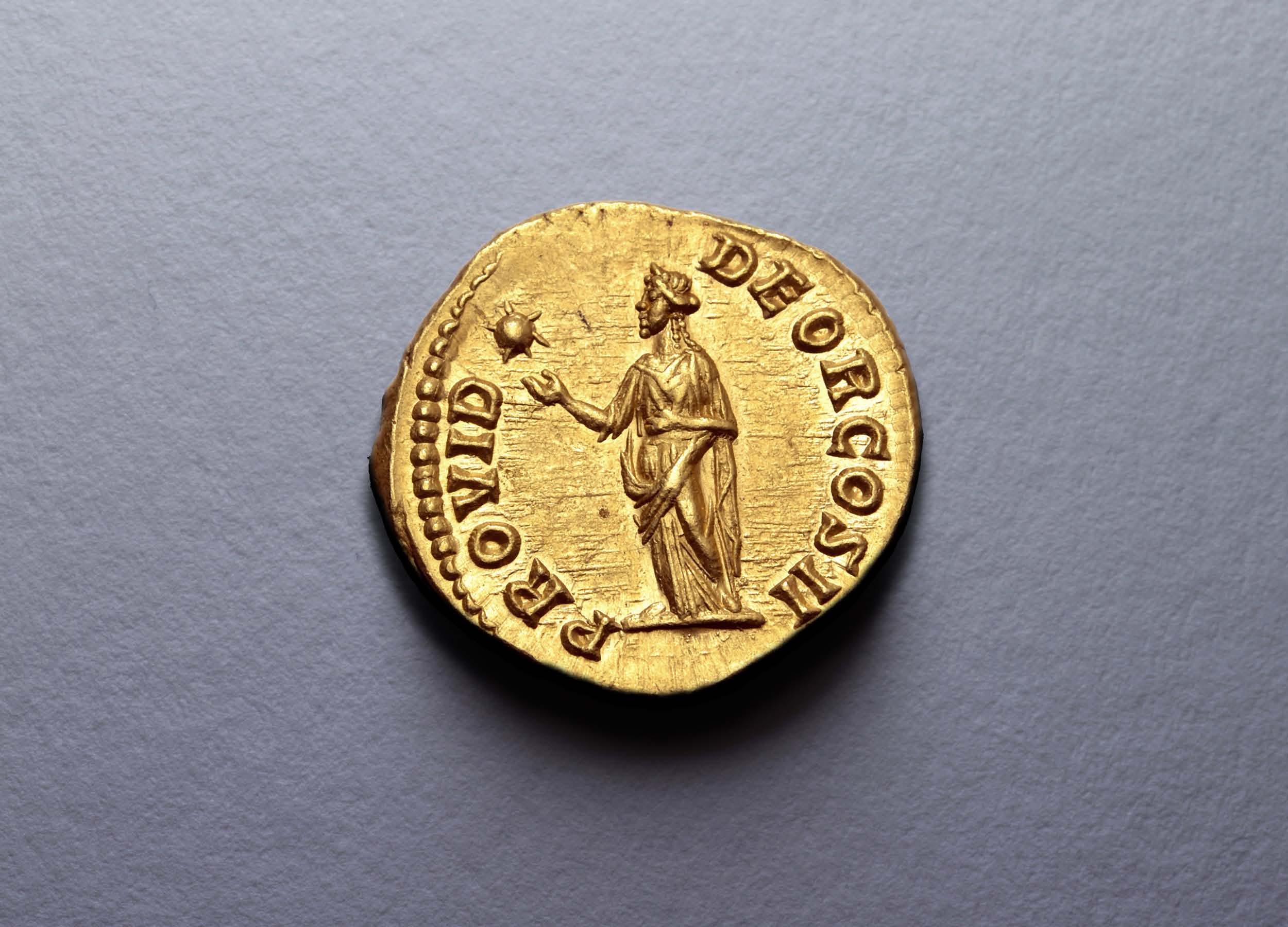
229
Didius Julianus Æ Sestertius. Rome, AD 193. IMP CAES M DID SEVER IVLIAN AVG, laureate head to right / RECTOR ORBIS, emperor standing facing, head to left, holding globe and scroll; S-C across fields. RIC IV 16; C. 17; Banti 6; BMCRE 28. 21.59g, 29mm, 11h.
Good Very Fine; very well preserved for the type.
Ex Münzen & Medaillen AG, Auction 66, 22 November 1984, lot 679;
Ex John Work Garrett Collection Part I, Bank Leu - Numismatic Fine Arts, 16 May 1984, lot 642.
The previous Emperor Pertinax having been murdered after just three months in the imperial palace, Didius Julianus was raised to the purple in a shameful episode, where the sources record, the empire was ‘auctioned’ to the highest bidder by the Praetorian Guard. In fear of what troubles Julianus and the Praetorians could create if challenged, the senate were forced to submit to his rule and ratify his elevation to the throne, whilst at the same time bestowing honorific titles on his wife and daughter, Manlia Scantilla and Didia Clara. Cassius Dio relates that “The next day we [the Senators] went up to pay our respects to him, moulding our faces, so to speak, and posturing, so that our grief should not be detected. The populace, however, went about openly with sullen looks, spoke its mind as much as it pleased, and was getting ready to do anything it could. Finally, when he came to the senate-house and was about to sacrifice to Janus before the entrance, all fell to shouting, as if by preconcerted arrangement, calling him stealer of the empire and parricide” (LXXIV, 13, 2-3).
However, Julianus’ time in the palace was to be limited by the challenges of three provincial governors, all of whom laid claim to the imperial throne. Pescennius Niger in Syria, Clodius Albinus in Britain and Septimius Severus in Upper Pannonia all had themselves acclaimed emperor, Cassius Dio relating that it was the populace of the city that had first called for Niger to come to their aid. As the closest to Italy, Severus had the advantage and marched toward Rome, the spectre of his approaching army being enough to further weaken Julianus’ grip on power so that the Senate were able to condemn him to death and appoint Severus in his place. Seen in the knowledge of Julianus’ demise, the reverse type of the present piece featuring Fortuna is then somewhat ironic. The goddess of fortune and personification of luck in Roman religion, her depiction on the coinage would involved the goddess’ blessing for the both emperor and empire; however she was as equally dedicated to ensuring life’s capriciousness, as it must quickly have become apparent to Julianus.

Near Mint State; pleasant old cabinet tone. Very Rare.
Very Rare
600
Pescennius Niger AR Denarius. Antioch, AD 193-194. IMP CAES C PESC NIGER IVST AV, laureate head to right / INVICTP IMPEPAT (sic), trophy; arms at base. RIC IV 34a var. (rev. legend); BMCRE p. 77, § note var. (same); RSC 33 var. (same). 2.94g, 18mm, 12h.




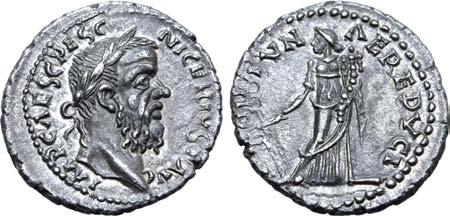
Good Extremely Fine. Very Rare.
Ex Numismatica Ars Classica, Spring Sale 2020, 25 May 2020, lot 1110;



Ex Numismatica Ars Classica, Auction 54, 24 March 2010, lot 1205;
Ex Gorny & Mosch Giessener Münzhandlung, Auction 114, 4 March 2002, lot 348.
The scarcity of Pescennius Niger’s coinage today belies the fact that it was struck on a monumental scale, and we can only assume that after his defeat at the hands of Septimius Severus in AD 194 his coins were meticulously recalled and melted. Although it has been extensively published, there are such a huge number of minor varieties that no single catalogue is without numerous lacunae. It appears that the all of Niger ’s coins were struck at Antioch and possibly a subsidiary mint operating at Caesarea in Cappadocia.
230
Pescennius Niger AR Denarius. Antioch, AD 193-194. IMP CAES C PESC NIGER IVST AVG, laureate head to right / FORTVNAE REDVCI, Fortuna standing facing, head to left, holding rudder and cornucopiae. RIC IV 26d; BMCRE p.76, ∥ note; RSC 28b; Roma E-54, 785 (same dies). 3.01g, 19mm, 12h.
597.
596.
3,900
Ex John Work Garrett Collection 1984
598. 900
599.
Pescennius Niger AR Denarius. Caesarea in Cappadocia, AD 193-194. IMP CAES C PESC NIGER IVST AVG, laureate head to right / SALVTI AVG, Salus standing facing before altar, head to right, holding serpent in her arms and feeding it from a patera. RIC IV 75b; BMCRE 312A (wars of the succession); RSC 66a. 2.73g, 19mm, 11h.



Near Mint State; struck from dies of fine style.
Ex Leu Numismatik AG, Web Auction 17, 14 August 2021, lot 2620.
1,500
Divus Septimius Severus AV Aureus. Rome, AD 211. DIVO SEVERO PIO, bare head to right / CONSECRATIO, eagle standing to left on thunderbolt, with wings outstretched. RIC IV 191a (Caracalla); BMCRE 19 (Caracalla); Calicó 2440. 7.22g, 20mm, 12h. About Good Very Fine. Extremely Rare; only three other examples present in CoinArchives.
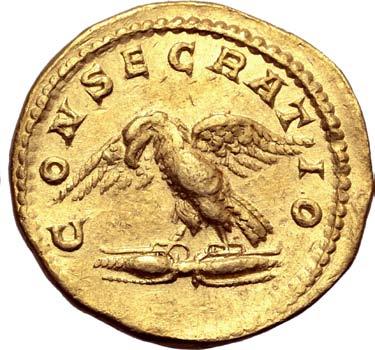
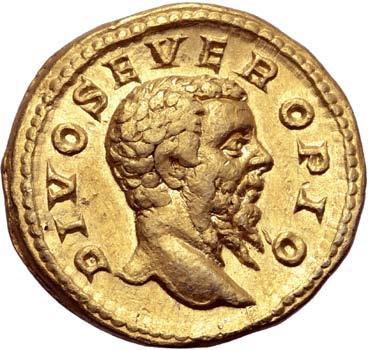


4,500
In AD 208 Severus travelled to Britannia at the head of an army numbering over 40,000 with the intent of subjugating Caledonia. Despite allegedly high Roman casualties on account of the Caledonians’ guerrilla tactics, by 210 Severus had made significant gains. The Caledonians sued for peace, which was granted in return for their forfeit of the Central Lowlands. Renewed conflict ensued almost immediately with a Caledonian revolt supported by the Maeatae, and Severus set himself to the task of exterminating the Caledonians, though illness forced him to withdraw back to Eboracum, where he died on February 4th AD 211. Severus was returned to Rome and laid in the tomb of Marcus Aurelius Antoninus, whom of all the emperors he revered so greatly that he even deified his son Commodus, and held that all emperors should thenceforth assume the name Antoninus as they did that of Augustus. At the demand of his sons, who gave him a most splendid funeral and who caused to be struck this commemorative aureus, he was added by the Senate to the ranks of the deified.

The prominence of the eagle on such issues stems from the consecration ceremony itself; a funeral pyre was lit and an eagle was set loose from its summit, symbolising the elevation of the soul from the earth to the ranks of the gods.

231
600.
Caracalla AV Aureus. Rome, AD 205. ANTONINVS PIVS AVG, laureate and draped bust to right / PONTIF TR P VIII COS II, Mars standing to left, right foot on helmet, holding olive branch and reversed spear. RIC IV 80b; BMCRE 476 note (Septimius & Caracalla); Calicó 2778. 7.11g, 20mm, 12h. Good Extremely Fine.
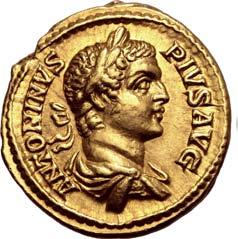
Acquired from Harmers of London; Ex Numismatica Ars Classica, Auction 92, 23 May 2016, lot 614.
When Septimius Severus focused attentions on the consolidation of his new dynasty, he did not shy away from thrusting his young sons into the public eye: they were key to presenting the impression of both longevity and seamless succession. In an effort to link his dynasty with the Antonine Dynasty, Septimius gave Caracalla a new name: Marcus Aurelius Severus Antoninus Augustus (‘Caracalla’ being simply a nickname derived from a type of Gaulish vestment). He also granted him the title of Caesar in AD 196, and by AD 198 at the tender age of ten, Caracalla was raised to the rank of Augustus thereby making him co-emperor with his father. It is therefore no surprise to see Caracalla depicted in his youth on this coin, before the cruel and brutal persona that came to characterise his reign manifested itself publicly. Caracalla is here associated with the connotations of valour, manliness, excellence, courage, character and worth - traits perceived as masculine strengths, that were inherent in the Roman understanding of virtue (virtus).
While Severus had intended his sons to rule as co-augusti after his passing, thereby seamlessly continuing Severan domination, it was not long before bitter fights for sole rule began between the brothers. Events climaxed at a reconciliation meeting in AD 211, when, under the instruction of Caracalla, Geta was assassinated by the Praetorian Guard. Caracalla could then assume sole rule of the empire and he ordered a damnatio memoriae against Geta’s memory as well as carrying out an alienation of the senatorial aristocracy by abrogating much of their remaining authority and prestige. (E. Varner, 2004, Mutilation and Transformation, Damnatio Memoriae and Roman Imperial portraiture).
Caracalla AR Denarius. Rome, AD 206-209. ANTONINVS PIVS AVG, laureate head to right / SOSPITATORI, Jupiter Sospitator standing facing, polos on head, holding sceptre, in tetrastyle shrine; IOVI in exergue. RIC IV 156; BMCRE 507; RSC 108. 3.43g, 19mm, 2h.



Good Extremely Fine; edge planchet flaw, attractive hints of iridescence around devices. Rare. Ex Viggo Collection; Ex Artemide Aste s.r.l., Auction LIII, 2 May 2020, lot 357.
This rare reverse type was struck by both Caracalla and his father and predecessor, Septimius Severus, and marks the only appearances of Jupiter Sosipater, or Rescuer, on Roman coinage.



232 Ex NAC 2016
7,500 601.
602. 600
Geta, as Caesar, AR Denarius. Rome, AD 203-208. P SEPTIMIVS GETA CAES, bare-headed and draped bust to right / PONTIF COS, Minerva standing to left, holding shield set on ground and reversed spear. RIC IV 34b; BMCRE 446-449 (Septimius & Caracalla); RSC 104a. 3.75g, 20mm, 1h. Near Mint State.


Ex collection of Dipl.-Ing. Adrian Lang; Ex Lakeview Collection, UBS, Auction 59, 27 January 2004, lot 6705.
Macrinus AR Denarius. Rome, AD 217-218. IMP C M OPEL SEV MACRINVS AVG, laureate and cuirassed bust to right / IOVI CONSERVATORI, Jupiter standing to left, holding thunderbolt and sceptre. RIC IV 73; BMCRE 68; RSC 33a (Antioch). 3.38g, 21mm, 6h. Mint State.







Ex collection of Dipl.-Ing. Adrian Lang.
Elagabalus AR Denarius. Rome, AD 218-222. IMP ANTONINVS PIVS AVG, laureate and draped bust to right / FIDES MILITVM, aquila between two signa, with shields at base of each. RIC IV 78; BMCRE 202; RSC 44. 2.87g, 18mm, 1h. Good Extremely Fine.






Ex Nomos AG, Auction 22, 22 June 2021, lot 329; Ex German collection, acquired in Paris in May 2000.
Extremely Rare
Elagabalus AR Quinarius. Rome, AD 220-222. IMP ANTONINVS PIVS AVG, laureate and draped bust to right / LIBERALITAS AVG II, Liberalitas standing to left, holding abacus and cornucopiae. RIC IV 101; BMCRE 217A; RSC 81; King 3. 1.28g, 14mm, 6h. Extremely Fine. Extremely Rare; considerably finer than the seemingly only two other examples on CoinArchives.
233
603. 105
604. 180
605. 180
606. 600
Sallustia Orbiana (wife of S. Alexander) AR Denarius. Antioch, AD 225-227. SALL BARBIA ORIBANA AVG, diademed and draped bust to right / CONCORDIA AVGG, Concordia seated to left, holding patera and double cornucopiae. RIC IV 319 (Alexander); BMCRE 287 (Alexander); RSC 1. 2.82g, 19mm, 6h.

Good Extremely Fine; beautiful old cabinet tone, an exceptional example.
Ex Santana Collection; Ex Maxwell Collection, Classical Numismatic Group, Auction 115, 16-17 September 2020, lot 694; Ex James Fox Collection, Classical Numismatic Group - Numismatica Ars Classica, Auction 40, 4 December 1996, lot 1613.
609.
Julia Mamaea (mother of S. Alexander) Æ As. Rome, AD 228. IVLIA MAMA•EA AVGVSTA, diademed and draped bust to right / FELICITAS PVBLICA, Felicitas standing facing, head to left, legs crossed, holding caduceus and leaning on short column; S-C across fields. RIC IV 677 (Alexander); C. 22; BMCRE 495 (Alexander). 11.36g, 26mm, 1h.










Extremely Fine; attractive sage green patina.
Ex Classical Numismatic Group, Auction 117, 19 May 2021, lot 587; Ex Roma Numismatics Ltd., Auction XVIII, 29 September 2019, lot 1198.
Julia Mamaea (mother of S. Alexander) AR Denarius. Rome, AD 231. IVLIA MAMAEA AVG, diademed and draped bust to right / PIETAS AVGVSTAE, Pietas standing to left, sprinkling incense over lighted altar on left and holding incense box. RIC IV 346 (Alexander); BMCRE 821 (same dies); RSC 48. 2.69g, 19mm, 6h.
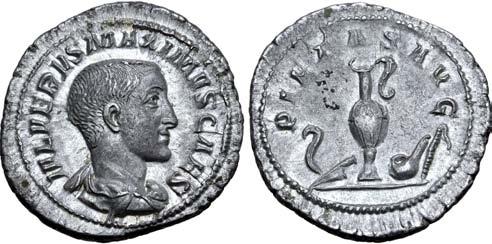
Mint State.
Ex Classical Numismatic Group, e-Auction 492, 26 May 2021, lot 400.
610. 450
Maximus (son of Maximinus I), as Caesar, AR Denarius. Rome, AD 235-236. IVL VERVS MAXIMVS CAES, bare-headed and draped bust to right / PIETAS AVG, emblems of the pontificate: from left, lituus, knife, jug, simpulum and sprinkler. RIC IV 1; BMCRE 118 (Maximinus); RSC 1. 3.60g, 20mm, 6h.

Good Extremely Fine; attractive old cabinet tone.
Ex Nomos AG, Auction 22, 22 June 2021, lot 334.
234
608. 600
120
300
607.
Ex NFA Auction XX, 1988
611. 450
613.
Maximus (son of Maximinus I), as Caesar, AR Denarius. Rome, AD 235-236. IVL VERVS MAXIMVS CAES, bare-headed and draped bust to right / PIETAS AVG, emblems of the pontificate: from left, lituus, knife, jug, simpulum and sprinkler. RIC IV 1; BMCRE 118 (Maximinus); RSC 1. 2.63g, 19mm, 12h.


Good Extremely Fine.
Ex Numismatica Ars Classica, Auction 80, 20 October 2014, lot 161;




Ex Münzen & Medaillen AG Basel, Auction 92, 22 November 2002, lot 173;
Ex Superior Stamp & Coin Co., 13 August 1995, lot 907;
Ex Numismatic Fine Arts, Auction XX, 9 March 1988, lot 332.
614.
Maximus (son of Maximinus I), as Caesar, AR Denarius. Rome, AD 236-237. MAXIMVS CAES GERM, bare-headed and draped bust to right / PRINC IVVENTVTIS, prince standing to left, holding baton and spear; two standards to right. RIC IV 3; BMCRE 211 (Maximinus); RSC 10. 3.48g, 21mm, 12h.
Near Mint State; somewhat weakly struck on rev., but featuring a bold portrait.
Ex Classical Numismatic Group, Auction 117, 19 May 2021, lot 589.
Ex Triton II, 1998
Gordian II Africanus AR Denarius. Rome, AD 238. IMP M ANT GORDIANVS AFR AVG, laureate, draped, and cuirassed bust to right / VICTORIA AVGG, Victory advancing to left, holding wreath in extended right hand, cradling palm frond with left arm. RIC IV 2; BMCRE 28; RSC 12. 3.27g, 20mm, 11h.



Near Mint State; pleasant cabinet tone.
Ex Classical Numismatic Group Inc. - Numismatica Ars Classica - Freeman & Sear, Triton II, 2 December 1998, lot 985.
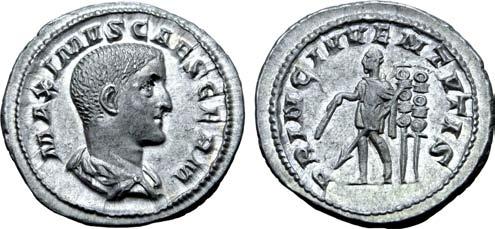
2,700
Pupienus AR Antoninianus. Rome, AD 238. IMP CAES M CLOD PVPIENVS AVG, radiate, draped and cuirassed bust to right / PATRES SENATVS, clasped hands. RIC IV 11a; BMCRE 81; RSC 19. 4.50g, 23mm, 7h.



Good Extremely Fine.
Acquired from Leu Numismatik AG.
450
235
612. 240
615.
Gordian III, as Caesar, AR Denarius. Rome, AD 238. M ANT GORDIANVS CAES, bare-headed and draped bust to right / PIETAS AVGG, jug between lituus and knife on left, simpulum and sprinkler on right. RIC IV 1 (Balbinus & Pupienus); BMCRE 62-63 (Balbinus & Pupienus); RSC 182 var. (no patera). 3.30g, 22mm, 12h.
Good Extremely Fine.
Ex collection of Dipl.-Ing. Adrian Lang; Ex Gemini, LLC, Auction VI, 10 January 2010, lot 540.
616. 3,000
Gordian III AV Aureus. Rome, AD 241-243. IMP GORDIANVS PIVS FEL AVG, laureate, draped and cuirassed bust to right / P M TR P V COS II P P, emperor standing to right, holding transverse spear and globe. RIC IV 106; Calicó 3226. 5.04g, 20mm, 12h.
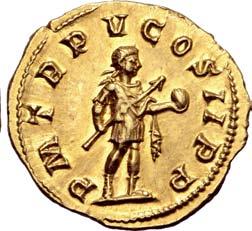
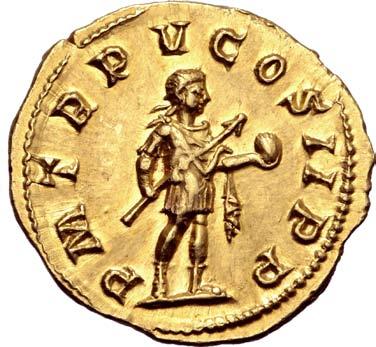
Near Mint State.
Ex Andre Constantine Dimitriadis collection, Heritage World Coin Auctions, CICF Signature Sale 3032, 10 April 2014, lot 23631; Ex McLendon Collection, Christie’s New York, 12 June 1993, lot 174; Ex Bank Leu AG, Auction 28, 5 May 1981, lot 536.
Philip I AR Denarius. Rome, AD 244-247. IMP M IVL PHILIPPVS AVG, laureate, draped and cuirassed bust to right / ADVENTVS AVGG, emperor on horseback advancing to left, raising hand and holding spear. RIC IV 26a; RSC 5. 3.56g, 21mm, 6h.

Extremely Fine. Extremely Rare; only one other example of this type has been offered at auction in the past 20 years (Lanz 109, May 2002, lot 738 [hammer: EUR 6,000]).
Ex Heritage World Coin Auctions, ANA Signature Sale 3101, 25 August 2022, lot 34107.
Maximinus I (235-238) was the last reigning emperor to have struck the denarius as the principal silver denomination intended for regular circulation. The reign of his successor Gordian III (238-244) saw the ‘Antoninianus’ or double-denarius become, virtually overnight, the mainstay of the Roman currency, due to the inflationary pressures of the early third century in part caused by ever greater military expenditure and associated successive debasements of the coinage. The denarius, though not yet relegated to the status of a mere unit of account, was now a critically endangered species. Issued sporadically throughout the reign of Gordian III, mass production of the denarius came to an end with the fourth issue at Rome in 241-243. By the time of Philip I’s accession in 244 the common use of the Antoninianus was well entrenched; Philip himself issued only three denarius types, ADVENTVS AVG (RIC IV 26a), PIETAS AVGG (RIC IV 43a) and SECVRIT ORBIS (RIC IV 48a). Of these, the first two may securely be said to represent ceremonial coins produced for the arrival of Philip at Rome in the late summer of 244, and for the elevation of his son Philip II to the rank of co-Augustus in 247. A possible occasion for the third type may be found at the beginning of Philip’s reign in early 244, when he was required to negotiate peace with Shapur I of the Sasanian Empire in order to return to Rome to secure his position.






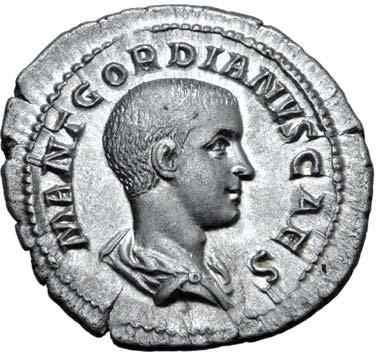

236
600
617. 4,950
Ex Bank Leu 1981

Only Six Auctioned in the Past Two Decades
Philip I AV Aureus. Rome, AD 245. IMP M IVL PHILIPPVS AVG, laureate, draped and cuirassed bust to right / P M TR P II COS P P, emperor seated to left on curule chair, holding globe and short sceptre. RIC IV 2a; C. 119 var. (bust type); Biaggi 1381; Bland, Gold 14 (dies PI 11/TRP II 03); Calicó 3254. 4.34g, 21mm, 6h.


Near Extremely Fine. Very Rare; one of only six examples to appear at auction in the past two decades, of which this is one of the two finest specimens.
15,000
Ex Classical Numismatic Group, Auction 117, 19 May 2021, lot 593.
Philip I, a man of Arab descent who rose to the post of Praetorian Prefect under Gordian III (AD 238-244), became emperor after allegedly staging a coup against the young emperor while they were on campaign in Persia. Although the empire was beset with many troubles, the reign started off with some promise. Philip was a conscientious ruler who showed tolerance toward Christians and other persecuted groups. He spent much of his reign on campaign on the Danube subduing invasions by Germanic tribes, but returned to Rome to preside over the Saecular Games in AD 248 which marked the one-thousandth year anniversary of Rome’s founding, along with his son Philip II whom he had elevated to co-Augustus. Unfortunately, trouble on the frontiers prompted Philip to dispatch the general Trajan Decius to quell the rebellions and deal with barbarian incursions. Instead, Decius was proclaimed emperor by the discontented legions in AD 249 and immediately marched on Rome. The elder Philip’s army met the usurper near modern Verona that summer, but was easily defeated. Philip himself either died in battle or was assassinated by his soldiers soon after (Michael L. Meckler, Philip the Arab).
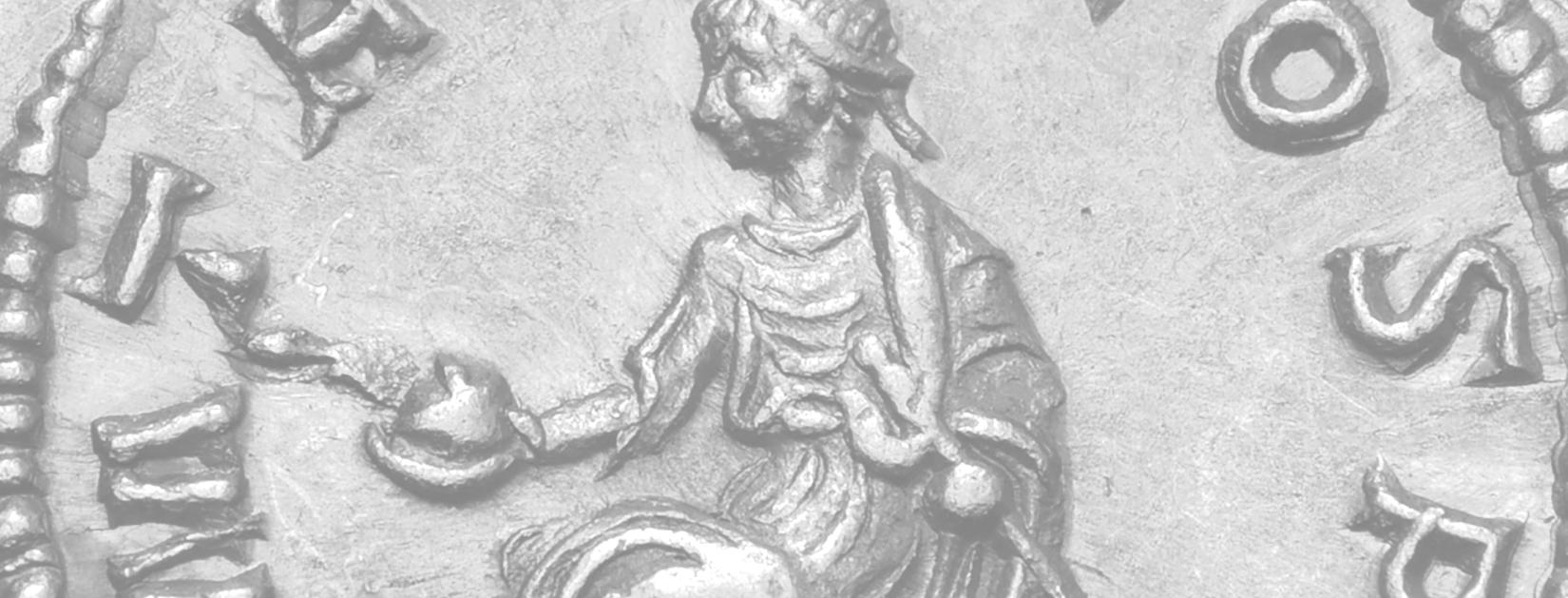
Gold coins dating from the reign of Philip I are exceptionally rare due to the increasing scarcity of precious metals in the mid-third century. This coin is one of the finest of only six examples of the type to appear at auction in the past two decades, and it depicts the emperor so well-known for the violence which bookended his reign as a consummate civil leader, seated on a curule chair - the ancient symbol of magisterial power likely as old as Rome itself.
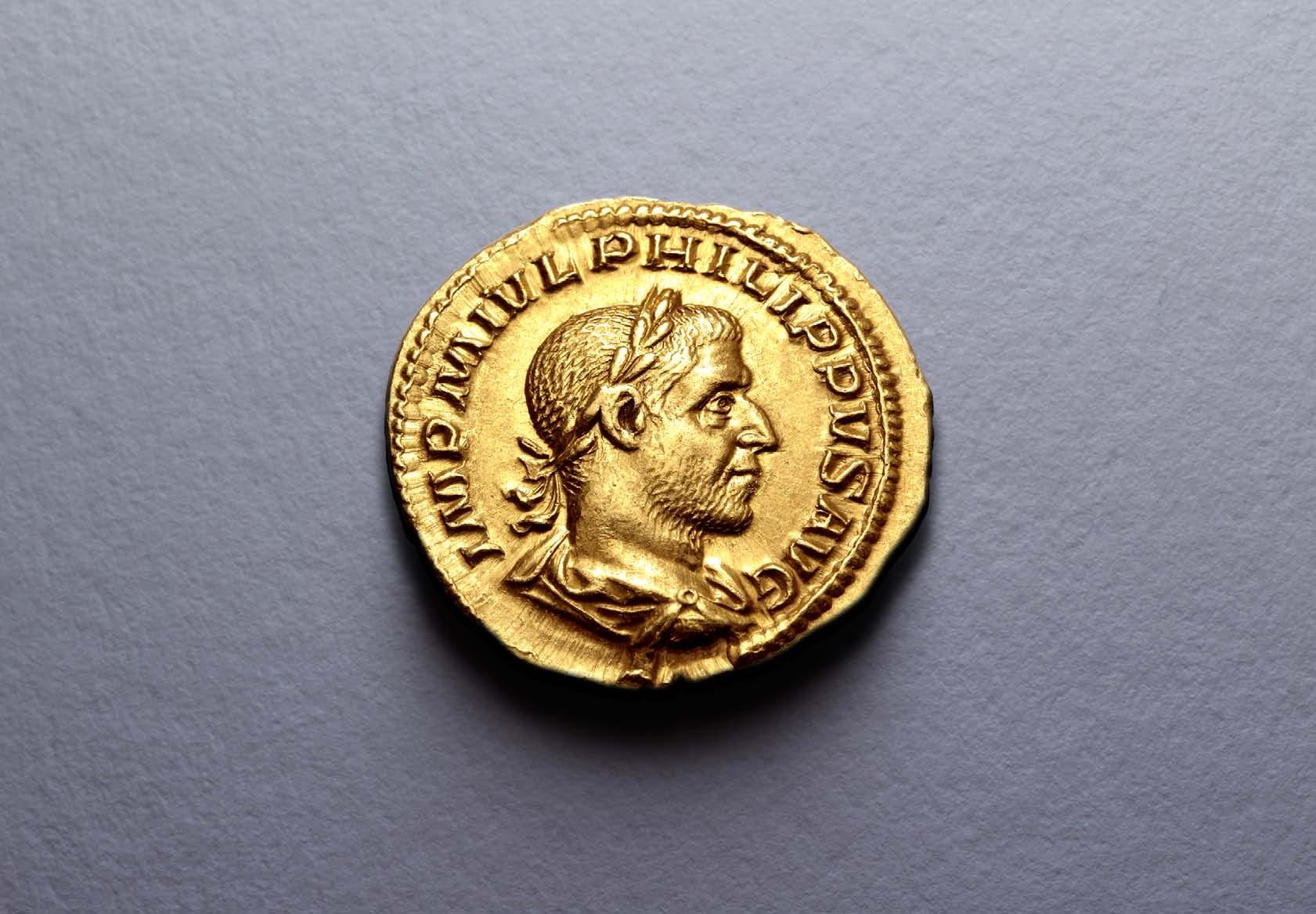
238
618.


239
Trajan Decius AV Aureus. Rome, AD 249-251. IMP C M Q TRAIANVS DECIVS AVG, laureate and cuirassed bust to right / PANNONIAE, the two Pannoniae, veiled and draped, standing facing, their heads turned to left and right, each holding standard pointed outwards. RIC IV 21a; C. 85; Calicó 3295. 4.82g, 20mm, 7h.




Near Mint State; minor edge marks, lustrous metal. Fine style.
Ex Leu Numismatik AG, Auction 1, 25 October 2017, lot 318.
Trajan Decius was acclaimed emperor by his troops while campaigning in Moesia and Pannonia on behalf of Philip I ‘the Arab’. He had been sent to quell the revolt of the usurper Pacatian, who had been proclaimed emperor himself by his troops but was, ultimately, also killed by them before the intervention of Decius. According to Zosimus, Decius was apparently reluctant and unwilling to take power. However, having taken the purple, Philip now advanced against Decius and the two met in battle near Verona, where Philip’s forces were routed and he himself was killed. Subsequently, Decius’ accession was recognised by the Senate, who conferred on him the name Traianus in reference to his predecessor Trajan, the optimus princeps (‘best ruler’) of the Roman Empire. Taking the name of Trajan was more than simple vainglory - in the first Dacian War of AD 101-102 Trajan had reduced the Danube region to the status of a client kingdom, later absorbing it into the empire after the second Dacian War in 105-106. The new emperor, who hailed from the very same region, was seen to have already quelled a revolt in the troubled frontier area, and it was hoped he would restore the strength of the State.
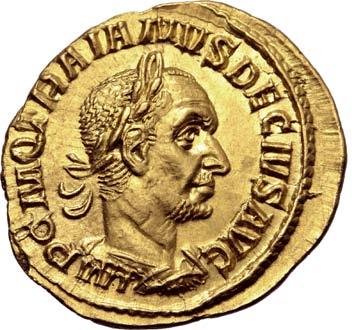


This however was not to be. Barbarian incursions into the empire were becoming more frequent and more daring, while internally the empire was weakened and unable to secure its frontiers. In 250-251 a major Gothic incursion crossed the Danube and raided parts of Moesia and Thrace. Decius surprised the Goths as they were laying siege to Nicopolis, and while they at first made to retreat, they doubled back and in turn caught Decius unprepared, dispersing the Roman army and sacking their camp.
Once the Roman army had reformed, Decius again marched to confront the Gothic invaders along with his son Herennius Etruscus and the general Trebonianus Gallus. At the Battle of Abritus in the second week of June 251 on a swampy patch of ground the Roman army initially routed the Goths’ front line, but made the mistake of pursuing their opponents into the swamp where they were ambushed and destroyed under a barrage of missiles. Both Herennius Etruscus and Decius were slain, their bodies never recovered. Decius’ paychests amounting to several tons of gold, along with many weapons, were despoiled by the Goths and have since been discovered hoarded in many locations throughout the historic Gothic territories (The Battle of Abritus, the Imperial Treasury and Aurei in Barbaricum, Numismatic Chronicle 173, 2013, p. 151). Trajan Decius thus earned for himself the dubious distinction of becoming the first reigning Augustus to be killed in battle by a foreign enemy. Trebonianus Gallus, maligned by Zosimus (1.25), became emperor on Decius’ death, and adopted his predecessor’s younger son, Hostilian, as joint emperor despite the latter’s young age preventing him from ruling in his own right.
240 Fine Style
619.
6,000
Trajan Decius AV Aureus. Rome, mid-late AD 250. IMP C M Q TRAIANVS DECIVS AVG, laureate and cuirassed bust to right, seen from behind / VBERITAS AVG, Uberitas, draped, standing to left, holding purse and cornucopaie. RIC IV 28; Biaggi 1397; Hunter 19; Calicó 3299. 4.38g, 20mm, 6h.
Near Mint State.
Ex Roma Numismatics Ltd., Auction XXIII, 25 March 2022, lot 1060.
620. 3,000
An Exceedingly Rare Aureus

Trebonianus Gallus AV Aureus. Rome, AD 251-253. IMP CAE C VIB TREB GALLVS AVG, laureate, draped and cuirassed bust to right / FELICITAS PVBLICA, Felicitas standing facing, head to left, holding caduceus and sceptre, resting elbow on column. RIC IV 8 var. (bust type); Calicó 3333c (same dies). 3.52g, 20mm, 1h.




Mint State. Previously NGC graded MS 5/5 - 4/5 (#6327052-001). Exceedingly Rare; only one known to Calicó, with no others on CoinArchives.
Acquired from Heritage World Coin Auctions.
At a time when emperors were hard-pressed to maintain their position of power they were in many ways wholly dependent on the fickle attitudes of their armies. Trebonianus Gallus became emperor with the support of his army after the death of his predecessor Trajan Decius at the Battle of Abritus against the Scythian invaders in Moesia. In his portraiture, most notably on coins and a few sculptures such as the monumental bronze in the Metropolitan Museum of Art in New York, Gallus continued the iconographic tradition that was intended to present the emperor as a powerful general who could lead the armies and keep order in the empire. This iconography is characterised by a military style haircut, a short, stubble beard, and a stern, even menacing expression; all of which aspects owe their origins to the mature portrait types of Caracalla.
Early in his reign Gallus shared the purple with his predecessor ’s son Hostilian, who had been Caesar in 251 at the time of his father’s death. However, Hostilian died in an outbreak of the plague which struck Rome later that year, leaving the way open for Gallus’ son Volusian to be made co-emperor with his father. The co-rulers were unfortunately too inept to deal with the pressures and instabilities that Rome faced, including economic crisis, famine and invasions by the Goths and Persians. It is then perhaps slightly ironic that Felicitas occupies the reserve of this coin, traditionally a symbol of wealth and prosperity, but this reflects the rather hopeful attempt of the co-emperors to maintain their power in part through the use of propaganda.

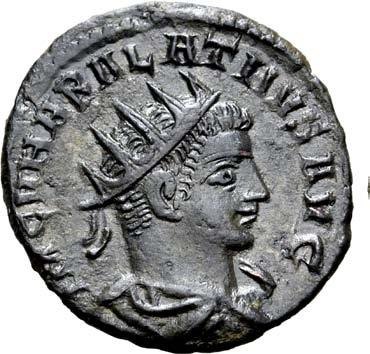

Extremely Fine.
Acquired from Aquila Numismatics.
241
621. 9,000
Vabalathus BI Antoninianus. Antioch, AD 267-272. IM C VHABALATHVS AVG, radiate and draped bust to right / VЄNVS AVG, Venus standing to left, holding helmet and spear, shield to right; * in left field. MER-RIC 3119 var. (bust type); RIC V.2 5 var. (mintmark). 3.16g, 20mm, 5h.
622. 300
NGC graded Ch AU 5/5 - 3/5, fine style (#6674414-003).
Ex Numismatica Ars Classica, Auction 131, 30 May 2022, lot 603;
Ex Kunst und Münzen, Auction 28, 1992, lot 388;
Ex Giessener Münzhandlung, Auction 55, 14 May 1991, lot 763;
Ex Kunst und Münzen, Fixed Price List 66, 1991, lot 2;
Ex Numismatik Lanz München, Auction 50, 27 November 1989, lot 783.
10,500
Aurelian begun his career as a military commander, rising to become emperor under the authority of the Roman army in response to the instability of the state during the Crisis of the Third Century. It is not surprising then that there are multiple references to the army, most clearly seen through the reverse legend “CONCORDIA MILI” emphasising and willing harmony between the emperor and the military.


Aurelian’s first actions as emperor were aimed at consolidating the security of Roman territory; to that end in late AD 270 he campaigned against the barbarian incursions in northern Italia, driving the Vandals, Juthungi, and Sarmatians back across the border. His authority was by no means absolute, and Aurelian was challenged by the usurpers Septimius, Urbanus, Domitianus, and by the rebellion of Felicissimus. The latter revolt led by Felicissimus revolved around the imperial mint of Rome, with employees stealing imperial coinage, which ultimately led Aurelian to close the Rome mint, hence this coin was minted in Mediolanum.

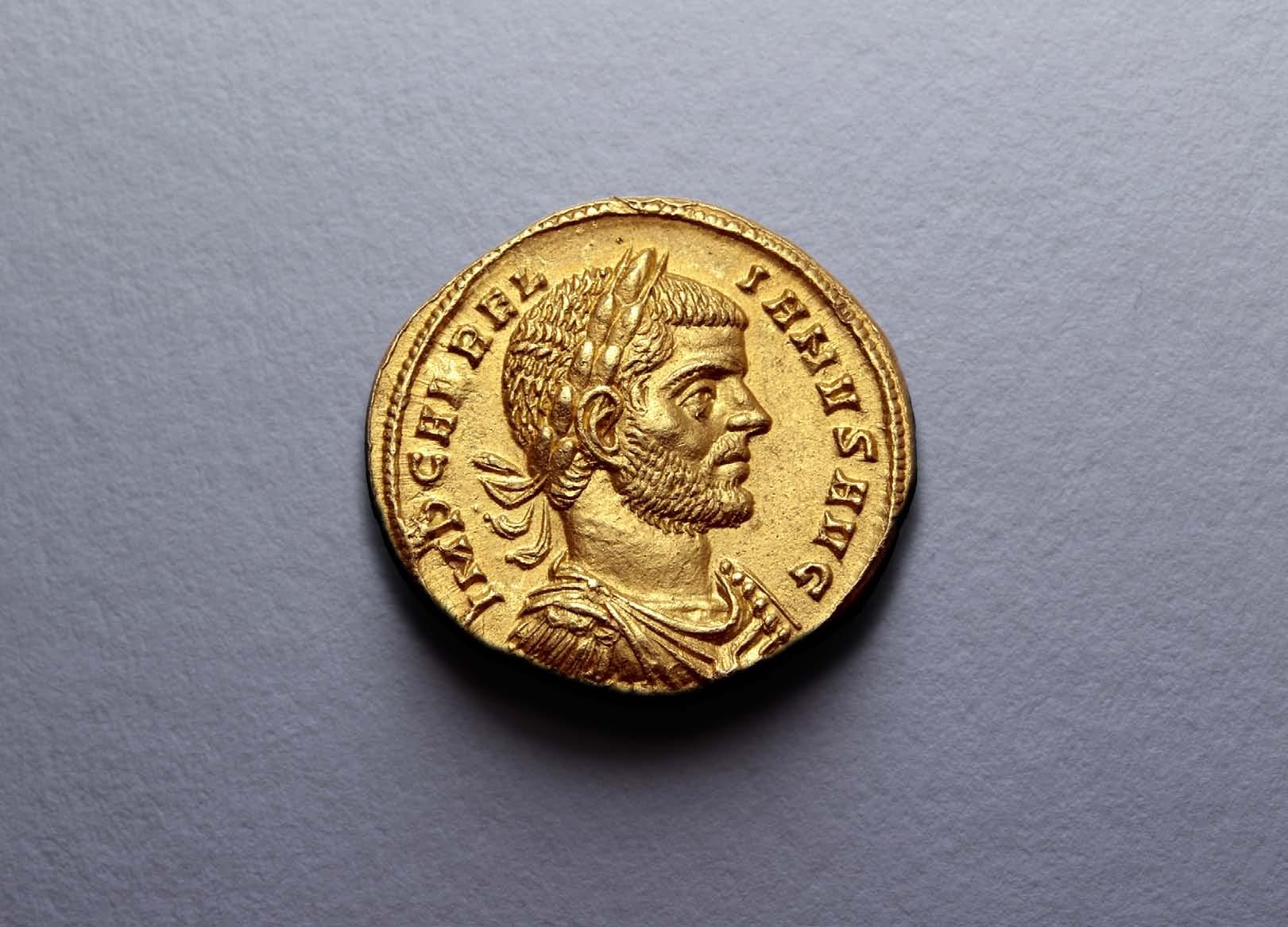
To curry favour with the legions he commanded, Aurelian employed coinage to communicate the strength and importance of the army through both legends and imagery. The inclusion of Concordia, who embodies social concord, associates the quality of harmony with Aurelian’s reign while the inclusion of standards correlates to battlefield imagery where standards were symbolic of individual units and functioned as rallying points. They were thus widely recognised as a symbol of Roman military honour and more broadly as a symbol of the army in general. With multiple references to Aurelian’s militaristic outlook, this coin foreshadows the unprecedented success under his rule, which reunited the Roman Empire after its recent near collapse.



242
Lanz 50, 1989
Ex
Aurelian AV Aureus. Mediolanum, AD 270. IMP C AVRELIANVS AVG, laureate, draped and cuirassed bust to right / CONCORDIA MILI, Concordia seated to left, holding standard in each hand. RIC V.1 166 (Siscia); MER-RIC 1353 (temporary); Calicó 3985.
623.
Florian BI Antoninianus. Serdica, AD 276. IMP C M AN FLORIANVS P AVG, radiate, draped and cuirassed bust to right / PROVIDEN DEOR, Providentia standing to right, holding standard in each hand, facing Sol standing to left, raising hand and holding globe; star in central field, A in exergue. RIC V.2 110; MER-RIC 4500 (temporary). 3.65g, 22mm, 12h. Mint State.
Ex Terner Collection, Roma Numismatics Ltd., E-Sale 100, lot 1322. 300
624.

Probus AV Aureus. Lugdunum, AD 276-282. IMP C M AVR PROBVS AVG, laureate and cuirassed bust to right / VIRTVS AVGVSTI, emperor standing facing, head to left, holding sceptre and crowning trophy; two seated captives at base. RIC V.2 12; C. 863 var. (bust type); Biaggi 1635 = Calicó 4245 (this coin). 4.76g, 22mm, 7h.

Mint State. Extremely Rare; seemingly the only example on CoinArchives.
This coin published in X. Calicó, Los Aureos Romanos (2002);





Ex Numismatica Ars Classica, Auction 131, 30 May 2022, lot 110;
Ex Roma Numismatics Ltd., Auction XVI, 26 September 2018, lot 785;
Ex Chaponnière & Firmenich SA, Auction 8, 5 July 2017, lot 66;
Ex Numismatica Ars Classica 25, 25 June 2003, lot 565;
Ex Biaggi de Blasys Collection.
16,500
Probus’ ascension to the throne in AD 276 occurred at an unstable time for the Roman Empire: three emperors had died over the last year, two of whom were assassinated and the third is rumoured to have been; the security of the empire was threatened by foreign invasion and Florian, the brother of the previous emperor Tacitus, had been declared emperor by the senate and army in the West in opposition to Probus in the East. Probus therefore had a difficult task ahead of him to defeat his rival for the throne and restore order to a destabilised empire. Probus had employed a Fabian strategy to defeat Florian, avoiding an outright battle and instead relying on skirmishes, the intensity of the summer heat and the discontent this caused among Florian’s army to weaken his enemy’s position. Florian was soon killed by his own forces, and Probus was confirmed as emperor by the Senate with a minimum of bloodshed.
Despite the calamitous state of the Empire when Probus ascended the throne, he proved himself to be an efficient and productive emperor, defeating numerous foreign enemies and improving some parts of the areas devastated by war through engaging the army during peacetime in building projects such as growing vines in Gaul, Pannonia and Moesia. Though his rule is covered to an extent by ancient historiographers, the stories often do not match up and the picture we receive of Probus’ rule is somewhat broad and lacking in detail. However, what the sources agree on are the great military achievements of this emperor and the respect he earned both from the conquered and his own people.
626. 900

244 Published in Calicó
Despite his virtues, there was little security to be found in wearing the purple during this period. A long series of civil wars had created a penchant for general-emperors, elected by the army and thereby required to repay the soldiers for their support. Further, internal divisions had left Rome vulnerable to foreign enemies with Germanic tribes attacking the upper Rhine and Danube regions and Aurelian’s Persian campaign still unresolved. Finally, the threat of usurpation was ever present; over the six years Probus was emperor, he successfully put down three revolts but was ultimately assassinated by his own soldiers in AD 282 and replaced by the commander of the Praetorian Guard, Carus. 625.
Probus BI Denarius. Rome(?), AD 276-282. IMP C M AVR PROBVS AVG, laureate, draped and cuirassed bust to right / CONSERVAT AVG, Sol standing facing, head to left, one arm raised and one holding whip. RIC V.2 -. 2.68g, 20mm, 6h. Extremely Fine; remarkably high silver content for this period. Apparently Unique and Unpublished.
Unique and Unpublished


245
This Coin Cited in Depeyrot
Diocletian AV Aureus. Siscia, AD 286. IMP C DIOCLETIANVS P F AVG, laureate, draped and cuirassed bust to right / IOVI CONSERVATORI, Jupiter standing facing, head to left, nude but for chlamys on back, holding long sceptre in left hand and thunderbolt in right. RIC V.2 247; C. 149; Depeyrot 1/2 (this coin). 5.37g, 20mm, 12h.
Near Mint State. Extremely Rare; no other examples offered at auction in the past 20 years.
This coin cited in G. Depeyrot, Les monnaies d’or (Wetteren, 1995-1996); Ex Münzen und Medaillen AG Basel, Auction 43, 12 November 1970, lot 437.
9,000
It would ultimately be religious legitimisation, not military achievements, that would elevate Diocletian above his predecessors. The quasi-republican ideals of Augustus’ ‘primus inter pares’ system were abandoned for all but the tetrarchs themselves. Diocletian took to wearing a gold crown and jewels, and forbade the use of purple cloth to all but the emperors. His subjects were required to prostrate themselves in his presence (adoratio); the most fortunate were allowed the privilege of kissing the hem of his robe (proskynesis). The reverse of this coin further alludes to the quasi-divine aspects of the new ‘dominate’ system of government. Around 287 Diocletian assumed the title Iovius, and his colleague Maximian assumed the title Herculius; these grandiose new titles not only reflected the working dynamic between Diocletian and Maximian (while the one acted as supreme strategist, the other enforced imperial will by brute force), but more importantly by taking on divine attributes Diocletian intended to make the person of the emperor inviolate as the gods’ representative on earth.



Diocletian’s administrative and bureaucratic reforms encompassed far more than the decentralisation of imperial power. Some of his most enduring changes were to the Roman military. Instituting systematic annual conscription for the first time since the days of the Republic, Diocletian increased the overall size of the Roman army by roughly 33%, and more than doubled the number of legions and auxiliary units by creating smaller, more mobile detachments. A massive upgrade of the empire’s defensive infrastructure was undertaken across great swathes of the borders including new fortifications and roads. Centralised fabricae were introduced to provide arms and armour for the army on an industrial scale. The most significant change to the Roman military structure was the establishment of large personal escort armies (comitatus praesentales) which typically comprised 2030,000 elite palatine troops. These highly mobile armies were designed to quickly reinforce the border defences or crush potential usurpers. Indeed, while they proved highly effective during Diocletian’s reign, in his retirement he would live to see them misused by his successors, who now each had a substantial comitatus at their disposal to enforce their claims.

246
627.
628.
A Very Attractive Aureus of Maximian
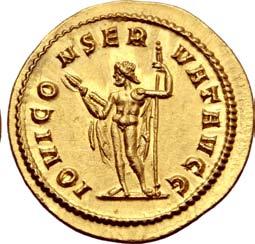


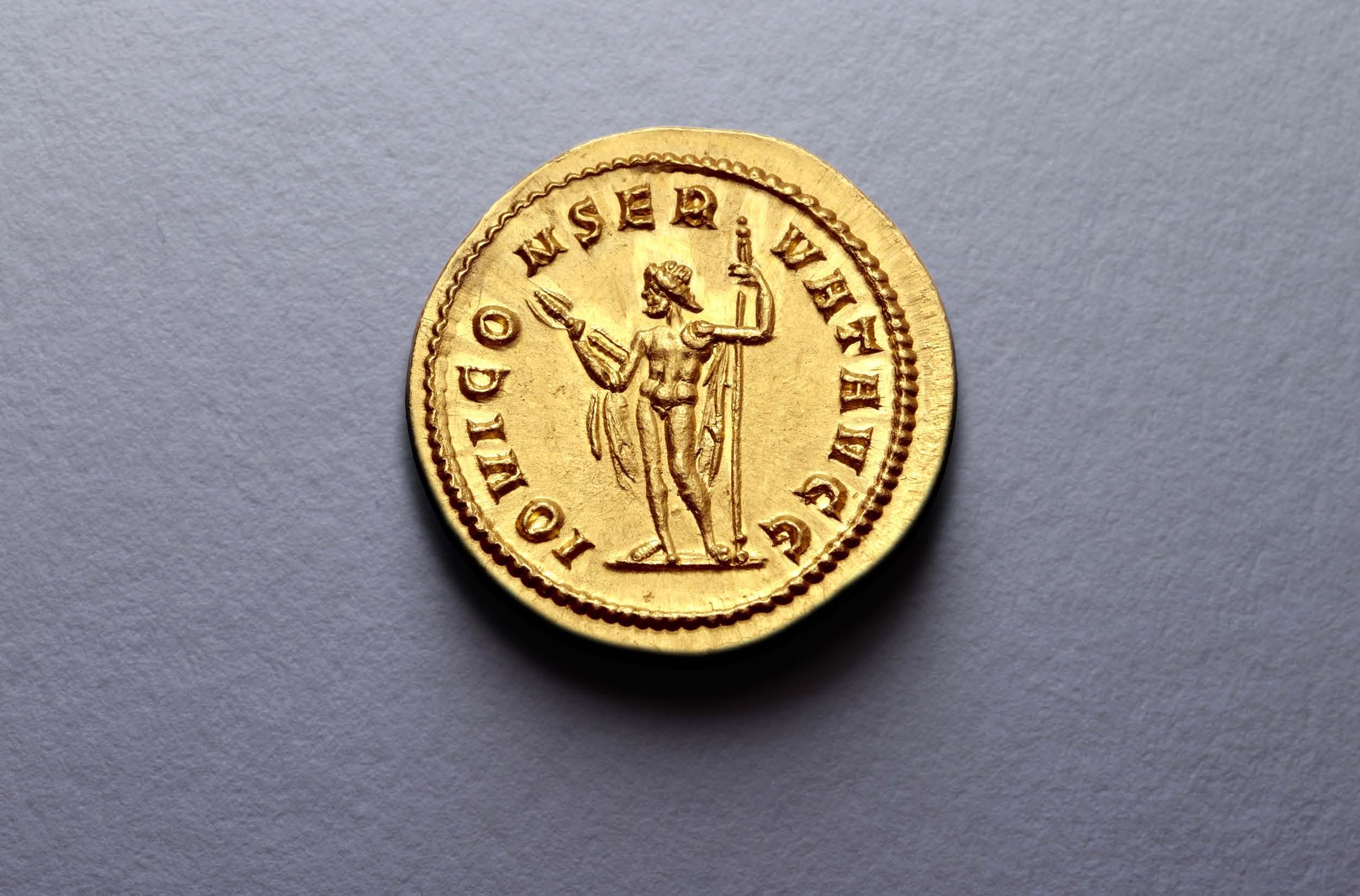

Maximian AV Aureus. Rome, AD 286. IMP C M AVR VAL MAXIMIANVS P F AVG, laureate, draped and cuirassed bust to right / IOVI CONSERVAT AVGG, Jupiter standing to left, nude but for drapery over shoulders, holding thunderbolt in right hand and sceptre in left. RIC V.2 492a; C. 348; Depeyrot 2D/3; Calicó 4688. 5.33g, 21mm, 6h.
Near Mint State; previously NGC graded MS 5/5 - 4/5 (#6030744-010), a highly attractive example.
Ex Numismatica Ars Classica, Auction 125, 23 June 2021, lot 777.
12,000
247
“With the Virtue of Hercules”
Maximian AV Aureus. Cyzicus, AD 286-287. IMP C M A MAXIMIANVS AVG, laureate, draped and cuirassed bust to right / VIRTVTI HERCVLIS, Hercules standing facing, head to right, leaning on club set on rock, lion-skin draped over club; SC in exergue. RIC V.2 605; Depeyrot 5/11; Calicó 4758. 5.34g, 20mm, 12h.

Mint State; a wonderfully sharp strike on lustrous metal. Previously NGC graded MS 5/5 - 4/5 (#2022637-025).
Ex Classical Numismatic Group - Numismatica Ars Classica - Freeman & Sear, Triton I, 2 December 1997, lot 1669.


In 293, Diocletian established the Tetrarchy, a system by which the empire was divided geographically into four areas and ruled by two Augusti and two Caesars. Prior to dividing power between four, Diocletian had initially promoted his ally Maximian to Augustus in 286 to rule with him as coemperor. At the same time, Mausaeus Carausius was appointed to defend the Channel from attacks by Frankish and Saxon pirates. However, Carausius showed his gratitude towards Maximian by usurping power and declaring himself Augustus of Britain and northern Gaul. It was therefore now imperative that Maximian also had a title and position of equal status to confront Carausius on equal standing. Diocletian, having just started to bring some semblance of stability back to the empire after decades of turbulence, was determined that civil war should not break out again. By co-opting Maximian as his fellow Augustus he seemingly hoped that the unrest developing in the north of the empire would be quelled and his program of reform could continue uninterrupted. So, as part of their assumption of joint power, Diocletian and Maximian adopted tutelary deities, namely Jupiter and Hercules respectively and took on the surnames Jovius and Herculius. From this point, most of their coinage was minted with reverse legends and types honouring Jupiter and Hercules, (see Sydenham, E.A. & Mattingly, H. eds., RIC V.2, 1933, p. 213), as shown on this coin.
According to myth, the Olympians were only able to defeat the giants with the help of Hercules, whose role is only obliquely referred to by ancient writers (Hesiod, Theogony 954), but it would seem was commonly known as part of the wider myth in the ancient world. Punished for murdering his wife and children in a rage visited on him by Hera queen of the gods, Hercules was tasked with ten labours to redeem himself, meted out by his cousin King Eurystheus (two of the tasks were disqualified as Hercules was considered to have received too much help). Ultimately, when these tasks were completed, he would be rewarded with immortality by the gods. The labour referred to on this coin is the first; the slaying of the Nemean Lion, indicated by the traditional lion-skin draped over a club. This imagery emphasises Hercules’ power over beasts and more broadly the taming of nature by men. This coin can therefore be seen as underpinning the two Augusti’s connection with their tutelary gods and emphasising the new order established in the empire.
248
629.
12,000


249
630.
Ex Münzen & Medaillen AG, 1962
Maximian AV Aureus. Cyzicus, AD 286-287. IMP C M A MAXIMIANVS AVG, laureate, draped and cuirassed bust to right / VIRTVTI HERCVLIS, Hercules standing facing, head to right, leaning on club set on rock, lion-skin draped over club; SC* in exergue. RIC VI 605 var. (mintmark); C. -; Depeyrot 6/4 (this coin); Calico 4758a corr. (bust type, same dies). 5.30g, 21mm, 12h.
Good Extremely Fine; a powerful rendering of Hercules. Extremely Rare; the only example on CoinArchives with this mintmark.
This coin published in G. Depeyrot, L’or du Bas-Empire, Inventaire justificatif des tomes 1 et 2, 2004, p.133, 6/4;


Ex Dr. Hans Krähenbühl Collection; Purchased from Münzen & Medaillen AG, 25 October 1963; Ex Münzen & Medaillen AG, Auction XXV, 17 November 1962, lot 644.
Ex David Miller Collection
Maximian AV Aureus. Nicomedia, AD 303-304. MAXIMIANVS AVGVSTVS, laureate head to right / XX MAXIMIANI AVG SMN in five lines within laurel wreath. RIC VI 14; C. 704; Depeyrot 7/3; Calicó 4768. 5.24g, 18mm, 12h.






Very Fine. Very Rare.
Ex David Miller Collection, Roma Numismatics Ltd., Auction XXIII, 25 March 2022, lot 625, collector’s ticket included; Ex Collection of GK, Ukrainian Emigrant, Roma Numismatics Ltd., Auction XXI, 24 March 2021, lot 728.
9,000
1,800
250
631.
634.
Constantius I,



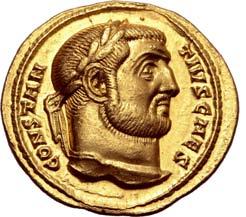

Good Extremely Fine. Extremely Rare; only 4 examples known to Depeyrot, three of which are in museums, and none others on CoinArchives. Acquired from Classical Numismatic Group.
6,000
Constantius I BI Nummus. Aquileia, AD 305-306. IMP CONSTANTIVS P F AVG, laureate, helmeted and cuirassed bust to left, holding sceptre and ornately decorated shield / VIRTVS AVGG ET CAESS N N, emperor galloping on horseback to right, holding shield and spearing down at kneeling barbarian, second barbarian prostrate beneath; AQS in exergue. RIC VI 66a. 9.93g, 27mm, 1h.
Good Extremely Fine. Rare.
Ex David Miller Collection, Roma Numismatics Ltd., Auction XXIII, 25 March 2022, lot 628 (collector’s ticket included).
Galerius, as Caesar, AR Argenteus. Antioch, AD 297. MAXIMIANVS CAESAR, laureate head to right / VIRTVS MILITVM, three-turreted camp gate without doors; ANT•H in exergue. RIC VI 40b; RSC 225c. 3.35g, 20mm, 12h.


Good Extremely Fine; a highly attractive example. Very Rare; rated R4 by RIC.
Ex Hess-Divo AG, Auction 314, 4 May 2009, lot 1624.
Severus II, as Caesar, AR Argenteus. Serdica, AD 305-306. SEVERVS NOB C, laureate head to right / VIRTVS MILITVM, three-turreted camp-gate with no doors; •SM•SDΓ• in exergue. RIC VI -; Gautier 48; RSC -. 3.40g, 20mm, 12h.



Near Mint State. Extremely Rare; only one example cited by Gautier, that being in the Hermitage Museum, and seemingly no others on CoinArchives.

600
1,800
251
Extremely Rare
as Caesar, AV Aureus. Rome, AD 294-299. CONSTANTIVS CAES, laureate head to right / PROVIDENTIA AVGG, camp gate with three forward turrets, two small turrets behind between two towers; PR in exergue. RIC VI 6a; Depeyrot 12A/3 var. (rev. legend break); Calicó 4869. 5.39g, 19mm, 11h.
632.
450 633.
635.
Ex Collection of a Perfectionist; Arras Hoard of 1922
Maximinus II, as Caesar, AV Aureus. Treveri, AD 305-306. MAXIMINVS NOB C, laureate head to right / HERCVLI CONSER AVGG ET CAESS N N, Hercules standing facing, head to left, wearing lion’s skin over his left shoulder and quiver over his right shoulder, holding bow and club set on the ground; TR in exergue. RIC VI 621; Depeyrot 11B/3; Calicó 5012; Bastien and C. Metzger, Le trésor de Beaurains (1977), 144, 420 (this coin). 5.35g, 18mm, 12h.
Near Mint State. Extremely Rare; one of only two examples known, both of which come from the Beaurains/Arras Hoard.

This coin published in P. Bastien & C. Metzger, Le Trésor de Beaurains (Wettern, 1977);
Ex Long Valley River Collection, Roma Numismatics Ltd., Auction XX, 29 October 2020, lot 685;
Ex Roma Numismatics Ltd., Auction 8, 28 September 2014, lot 1092; Ex Hess-Divo AG, Auction 324, 23 October 2013, lot 90;
Ex Claude Vaudecrane (1915-2002) Collection, Leu Numismatik AG, Auction 87 (Collection of a Perfectionist), 6 May 2003, lot 110; Ex Numismatica Ars Classica, Auction 7, 1 March 1994, lot 805; From the Beaurains (Arras) Hoard of 1922.
30,000
This coin was struck to commemorate the foundation of the Second Tetrarchy on 1 May AD 305. Born of Dacian peasant stock to the sister of Galerius, Maximinus rose to high distinction in the army thanks to his uncle’s influence as Caesar under Diocletian. In 305, according to Lactantius, Galerius forced Diocletian to abdicate, and through coercion and threats convinced Diocletian to fill the two vacated positions of Caesar with men compliant to his will. Thus, with the abdication of Diocletian and Maximianus, Galerius was raised to Augustus and immediately appointed his nephew Maximinus to the rank of Caesar along with an old friend, Severus. Portrayed by contemporary writers as vulgar, cruel and ignorant, Maximinus II gained eternal notoriety for his persecution of Christians in open defiance of the Edict of Toleration issued by Galerius.

In 313, having imprudently allied himself to Maxentius, the enemy of Constantine and Licinius, Maximinus found himself at war with Licinius, who marched against him and defeated him in a decisive battle at Tirizallum, despite Maximinus’ army being a veteran force that outnumbered Licinius by more than two to one. Pursued and besieged by Licinius, he poisoned himself at Tarsus in Cilicia in AD 313, eight years after being named Caesar, and five and a half after assuming the purple. His children were put to death and his wife was thrown into the Orontes at Antioch where by her orders a great number of Christian women had been drowned.

252
This extremely rare coin shows Maximinus before he had revealed his cruel and tyrannical nature, and gives him the stern countenance of one of the tried military emperors into whose company he was being elevated. The finely engraved, muscular figure of Hercules on the reverse is a further allusion to the militaristic responsibilities of the tetrarchic emperors, being employed here as Hercules ‘the Defender ’, thus both emphasising Maximinus’ purpose as a guardian of Rome, and at the same time ennobling him by appointing Hercules to watch over him. 636.


253
637.
638.
639.
640.
Constantine I ‘the Great’, as Caesar, AR Argenteus. Rome, AD 306-307. CONSTANTINVS NOB C, laureate head to right / VIRTVS MILITVM, camp gate with three turrets and no doors; RQ in exergue. RIC VI 154; RSC 705. 3.27g, 20mm, 1h. Near Mint State; dark old cabinet tone. Very Rare.




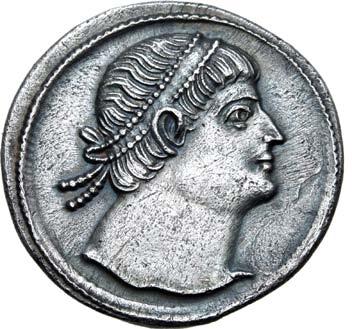
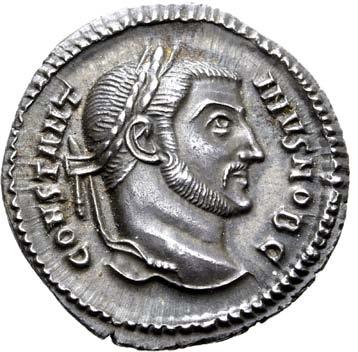
Ex Brian Henry Grover (1924-2015) Collection, Roma Numismatics Ltd., Auction XIX, 26 March 2020, lot 939.
Extremely Rare
Constantine I ‘the Great’ AV Solidus. Treveri, AD 312-313. CONSTANTINVS P F AVG, laureate head to right / GLORIA EXERCITVS GALL, emperor riding to right, arm raised; PTR in exergue. RIC VI 812; C. 258; Depeyrot 17/5. 4.47g, 17mm, 6h.




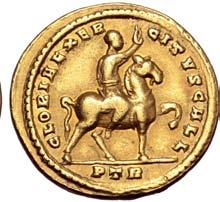



Very Fine. Extremely Rare; only 2 other examples auctioned in the past 20 years.
Acquired from Harmers of London; Ex Burgan Numismatique - Maison Florange, E-Auction 22-1, 6 March 2022, Lot 30.
3,600
3,600
Constantine I ‘the Great’ AR Siliqua. Siscia, AD 326-327. Diademed head to right / CONSTANTINVS AVG, Victory advancing to left, holding wreath and palm branch; SIS in exergue. RIC VII 210; RSC 97b. 2.78g, 19mm, 5h. Good Extremely Fine; a highly attractive example.

600
Rated R4 in RIC
Constans AV Solidus. Thessalonica, AD 337-340. FL IVL CONSTANS P F AVG, rosette-diademed, draped and cuirassed bust to right / VIRTVS EXERCITVM, emperor standing to left, holding trophy on spear and resting hand on shield, seated captive on either side; TES in exergue. RIC VIII 34; Depeyrot 4/7.
NGC graded MS 5/5 - 4/5 (#6329072-004). Extremely Rare; rated R4 in RIC.
3,000
254
641.
Constans AV Solidus. Decennalia issue. Treveri, AD 347-348. CONSTANS AVGVSTVS, pearl-diademed, draped and cuirassed bust to right / VICTORIAE D D N N AVGG, two Victories standing facing each other, holding shield inscribed VOT X MVLT XX; TR in exergue. RIC VIII 135; Depeyrot 6/3. 4.49g, 22mm, 6h.




Extremely Fine; a couple of minor marks to obv., otherwise highly lustrous, untouched surfaces.
Ex Classical Numismatic Group, Auction 114, 13 May 2020, lot 1009; Privately purchased from Numismatic Fine Arts Inc. prior to 1995.
Pedigreed to 1963
642.
1,800
Constantius II AV Solidus. Thessalonica, AD 355-361. D N CONSTANTIVS P F AVG, pearl-diademed head to right / GLORIA REIPVBLICAE, Roma enthroned facing, holding spear, and Constantinopolis enthroned to left with foot on prow and holding sceptre, supporting between them shield inscribed VOT XXXX in two lines; *TES* in exergue. RIC VIII 198; Depeyrot 14/4. 4.57g, 22mm, 12h.


Good Extremely Fine.
Ex Classical Numismatic Group, Triton XVII, 7 January 2014, lot 799;
Ex Classical Numismatic Group, Mail Bid Sale 61, 25 September 2002, lot 2105;
Ex B.A. Seaby Ltd., Coin and Medal Bulletin 540, May 1963, G996.
1,800
643. 3,000
Constantius II AV Solidus. Rome, AD 355-367. FL IVL CONSTANTIVS P F AVG, pearl-diademed, helmeted and cuirassed bust facing, holding spear and shield decorated with star / GLORIA REIPVBLICAE, Roma enthroned facing, holding spear, and Constantinopolis enthroned to left with foot on prow and holding sceptre, supporting between them shield inscribed VOT XXX MVLT XXXX in four lines; •RSMЄ• in exergue. RIC VIII 290 var. (mintmark); C. 117 var. (same); Depeyrot 12/1 var. (same); cf. Gorny & Mosch 236, 504 (same rev. die, but with christogram in shield on obv.). 4.55g, 21mm, 12h.
Near Mint State. Apparently unique and unpublished.
Ex Classical Numismatic Group, Triton XVII, 7 January 2014, lot 798.

Magnentius AV Solidus. Treveri, AD 350-353. IM CAE MAGNENTIVS AVG, bare-headed, draped and cuirassed bust to right / VICTORIA•AVG•LIB•ROMANOR, Victory standing to right, facing Libertas, draped, standing to left, holding transverse spear, both supporting trophy on shaft with hook between them; TR in exergue. RIC VIII 253 corr. (no palm branch); Depeyrot 8/1 var. (plain shaft). 4.39g, 23mm, 6h.





Extremely Fine; tooled. Extremely Rare.
Ex GK Collection, Roma Numismatics Ltd., Auction XXIII, 24 March 2022, lot 1094.
Victory does not appear to be holding a palm branch on the reverse of this coin, however this is also the case with the only other example of this coin on CoinArchives (Heritage 3094, lot 34258) which is from a different die. This suggests that RIC describes the reverse type as including a palm branch simply because that is typical of the design, rather than because they have evidence from this coin type. Without any plates to back this up we can only speculate.
255
644. 2,400
Apparently Unique and Unpublished
645.
One of Three Known
Magnentius AV Solidus. Treveri, AD 353. D N MAGNENTIVS AVG, bare headed, draped and cuirassed bust to right / VICT CAES LIB ROM ORB, Victory standing to right, facing Libertas, draped, standing to left, holding transverse spear, both supporting trophy on shaft with hook between them; TR in exergue. RIC VIII 296; Bastien 76 (same dies, two examples cited); Blätter für Münzfreunde 56, 1921, pl. 246, 14; Depeyrot 13/2; F. Trau Collection, Gilhofer & Ranschburg and A. Hess, 1935, 4288 (same dies). 3.84g, 22mm, 6h.

NGC graded MS 5/5 - 2/5, marks, slight bend (#6158066-011). Extremely Rare; the third known example, much better than the Trau specimen. Struck with a reverse die of Decentius.
Ex GK Collection, Roma Numismatics Ltd., Auction XXIII, 24 March 2022, lot 1096; Ex Nomos AG, obolos 5, 26 June 2016, lot 870 (hammer: CHF 15,000).



646.
Julian II BI 28mm. Heraclea, AD 361-363. D N FL CL IVLIANVS P F AVG, pearl-diademed, draped and cuirassed bust to right / SECVRITAS


REIPVB, bull standing to right, two stars above; •HERACL•B in exergue. RIC VIII 104. 9.00g, 28mm, 6h.
Good Extremely Fine.
Acquired from Morton & Eden.
648.
Julian II BI 27mm. Sirmium, AD 361-363. D N FL CL IVLIANVS P F AVG, pearl-diademed, draped and cuirassed bust to right / SECVRITAS
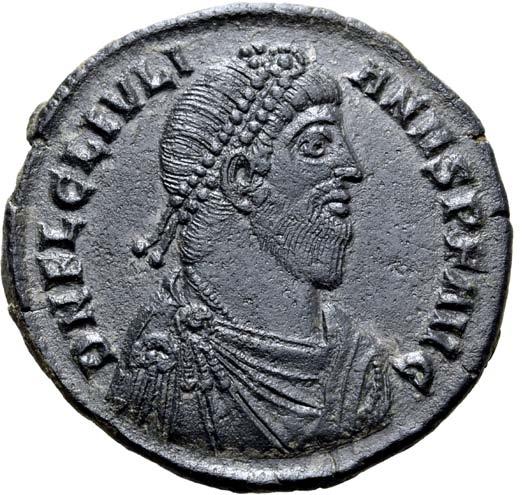
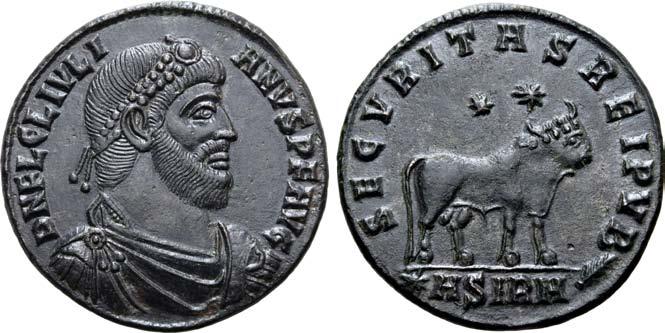

REIPVB, bull standing to right, two stars above; *BSIRM(palm) in exergue. RIC VIII 107; LRBC 1622. 8.78g, 27mm, 12h. Mint State; an impressive and very finely detailed portrait. Ex DMS Collection;



Privately purchased from Brian Kritt, 17 November 2009, inventory no. 40030.
Fleur De Coin
REIPVB,
Fleur De Coin.
Acquired from Morton & Eden.
4,500
180
750
450
256
647.
Julian II BI 27mm. Sirmium, AD 361-363. D N FL CL IVLIANVS P F AVG, pearl-diademed, draped and cuirassed bust to right / SECVRITAS
bull standing to right, two stars above; *ASIRM(palm) in exergue. RIC VIII 107. 9.02g, 27mm, 6h.
Valentinian I AV Solidus. Antioch, AD 364-367. D N VALENTINIANVS P F AVG, rosette-diademed, draped and cuirassed bust to right / RESTITVTOR REIPVBLICAE, emperor standing facing, head to right, holding standard with cross and Victory on globe; cross in left field, *ANTS* in exergue. RIC IX 2b xxxviii; Depeyrot 20/1. 4.52g, 21mm, 5h.



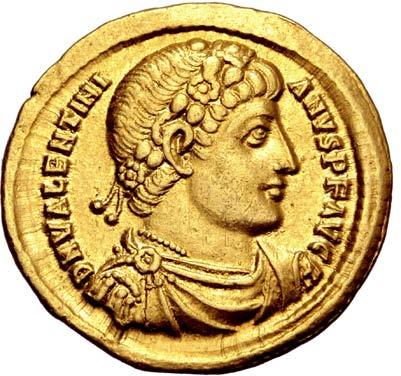



Extremely Fine; ‘S’ graffito in reverse field.
Acquired from Leu Numismatik AG.
Valentinian II AR Siliqua. Siscia, AD 375-378. D N VALENTINIANVS P F AVG, pearl-diademed, draped and cuirassed bust to right / VOT XV MVLT XX in four lines within wreath, medallion with eight-rayed star at apex; SISCPS in exergue. RIC IX 19c var. (eight-rayed star); RSC 74Ab var. (same). 2.02g, 19mm, 12h.

Near Mint State; pleasant old cabinet tone on lustrous metal.
Acquired from Leu Numismatik AG.

Honorius AV Solidus. Mediolanum, AD 394-395. D N HONORIVS P F AVG, pearl-diademed, draped and cuirassed bust to right / VICTORIA AVGGG, emperor standing to right, holding labarum and Victory on globe, treading on captive to right; M-D across fields, COMOB in exergue. RIC IX 35c = RIC X 1206a; Depeyrot 16/2; Biaggi 2320. 4.53g, 21mm, 12h.
Mint State.
Ex Conti Collection; Ex Roma Numismatics Ltd., Auction XIII, 23 March 2017, lot 993.
Extremely Rare
652. 150
653.
Honorius AR Half Siliqua. Ravenna, AD 402-406. D N HONORIVS P F AVG, pearl-diademed, draped and cuirassed bust to right / VICTORIA AVGG, Victory standing to left, holding wreath and palm; RV in exergue. RIC X 1346; RSC 35b. 0.98g, 14mm, 12h.
Good Very Fine. Extremely Rare.
Ex Roma Numismatics Ltd., Auction XXIII, 24 March 2022, lot 1130.


Honorius AV Solidus. Constantinople, AD 408-420. D N HONORIVS P F AVG, helmeted, pearl-diademed and cuirassed bust facing slightly to right, holding spear and shield decorated with horseman motif / CONCORDIA AVGG B, Constantinopolis seated facing, head to right and with foot on prow, holding sceptre and Victory on globe holding wreath; star in left field, CONOB in exergue. RIC X 201; Depeyrot 73/1. 4.49g, 21mm, 6h.




Near Mint State; lustrous metal.
600
257
650. 450
649. 900
651. 750
654. 600
655.
Theodosius II AV Solidus. Constantinople, AD 430-440. D N THEODOSIVS P F AVG, helmeted, pearl-diademed and cuirassed bust facing slightly to right, holding spear and shield decorated with horseman motif / VOT XXX MVLT XXXX B, Constantinopolis seated to left, holding globus cruciger and sceptre, foot on prow, shield by throne; star in right field, CONOB in exergue. RIC X 257; Depeyrot 81/1. 4.46g, 21mm, 7h.
Mint State.
657.
Theodosius II AV Solidus. Constantinople, AD 430-440. D N THEODOSIVS P F AVG, helmeted, pearl-diademed and cuirassed bust facing slightly to right, holding spear and shield decorated with horseman motif / VOT XXX MVLT XXXX I, Constantinopolis seated to left, holding globus cruciger and sceptre, foot on prow, shield by throne; star in right field, CONOB in exergue. RIC X 257; Depeyrot 81/1. 4.47g, 22mm, 6h.




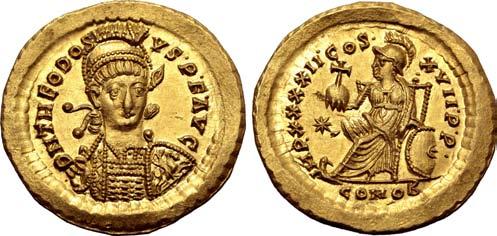


Good Extremely Fine; double strike to obv.
Theodosius II AR Siliqua. Constantinople, AD 438-450. D N THEODOSIVS P F AVG, pearl-diademed, draped and cuirassed bust to right / VOT MVLT XXXX in three lines within wreath; CONS* in exergue. RIC X 389; RSC 21. 0.86g, 16mm, 7h. Good Very Fine; attractive old cabinet tone. Very Rare.




Ex David Miller Collection, Roma Numismatics Ltd., Auction XXIII, 25 March 2022, lot 721 (collector’s ticket included).
Theodosius II AV Solidus. Constantinople, AD 441. D N THEODOSIVS P F AVG, helmeted, pearl-diademed and cuirassed bust facing slightly to right, holding spear and shield decorated with horseman motif / VIRT ЄXЄRC ROM, emperor standing facing in military attire, carrying trophy over shoulder, dragging captive with right hand; star in right field, CONOB in exergue. RIC X 282. Depeyrot 83/1. 4.51g, 21mm, 7h.
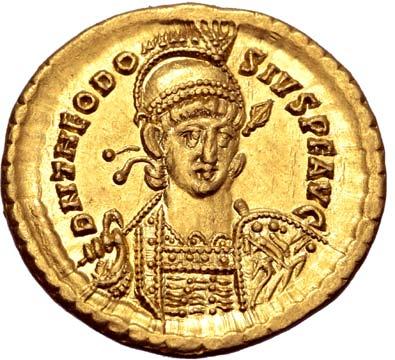

Good Extremely Fine.
1,200
Theodosius II AV Solidus. Constantinople, AD 441-450. D N THEODOSIVS•P•F•AVG, helmeted, pearl-diademed and cuirassed bust facing slightly to right, holding spear and shield decorated with horseman motif / IMP•XXXXII•COS•XVII•P•P•, Constantinopolis seated to left, holding globus cruciger and sceptre, foot on prow, shield by throne; star in left field, COMOB in exergue. RIC X 293; Depeyrot 84/1 var. (mintmark). 4.52g, 21mm, 6h.


658. 600
Near Mint State.
258
600
656. 300
Theodosius II AV Solidus. Constantinople, AD 441-450. D N THEODOSIVS•P•F•AVG, helmeted, pearl-diademed and cuirassed bust facing slightly to right, holding spear and shield decorated with horseman motif / IMP•XXXXII•COS•XVII•P•P•, Constantinopolis seated to left, holding globus cruciger and sceptre, foot on prow, shield by throne; star in left field, COMOB in exergue. RIC X 293; Depeyrot 84/1 var. (mintmark). 4.43g, 21mm, 6h. Mint State; small scratch to obverse.












659. 600
660. 600
661.
Theodosius II AV Solidus. Constantinople, AD 441-450. D N THEODOSIVS P F AVG, helmeted, pearl-diademed and cuirassed bust facing slightly to right, holding spear and shield decorated with horseman motif / IMP•XXXXII•COS XVII•P•P•, Constantinopolis seated to left, holding globus cruciger and sceptre, foot on prow, shield by throne; star in left field, COMOB in exergue. RIC X 300; Depeyrot 84/1 var. (mintmark). 4.51g, 21mm, 6h. Mint State.

663.
Theodosius II AV Solidus. Constantinople, AD 441-450. D N THEODOSIVS•P•F•AVG, helmeted, pearl-diademed and cuirassed bust facing slightly to right, holding spear and shield decorated with horseman motif / IMP•XXXXII•COS XVII•P•P•, Constantinopolis seated to left, holding globus cruciger and sceptre, foot on prow, shield by throne; star in left field, COMOB in exergue. RIC X 301; Depeyrot 84/1 var. (mintmark). 4.51g, 21mm, 6h.

Near Mint State.
Valentinian III AV Solidus. Constantinopolis, AD 425-429. D N VALENTINIANVS P F AVG, helmeted, pearl-diademed and cuirassed bust facing slightly to right, holding spear and shield decorated with horseman motif / SALVS REIPVBLICAE Z, emperor and Theodosius II seated facing, both nimbate and holding mappa and cruciform sceptre; star above, CONOB in exergue. RIC X 242; Depeyrot 79/2. 4.45g, 21mm, 6h.
Extremely Fine; small die break on obv.
Valentinian III AV Solidus. Ravenna, AD 426-430. D N PLA VALENTINIANVS P F AVG, rosette-diademed, draped and cuirassed bust to right / VICTORIA AVGGG, emperor standing facing, holding long cross and victory on globe, foot on head of human-headed coiled serpent; R-V across fields, COMOB in exergue. RIC X 2010; Depeyrot 17/1. 4.48g, 22mm, 6h.
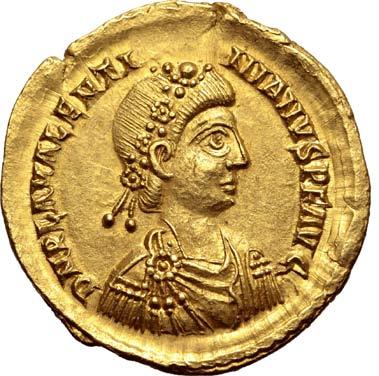
Mint State; very well-detailed.
Ex David Miller Collection, Roma Numismatics Ltd., Auction XXIII, 25 March 2022, lot 725 (collector’s ticket included).
259
600
662. 600
600
665.
Leo I AV Solidus. Constantinople, AD 462 or 466. D N LEO PERPET AVG, pearl-diademed, helmeted and cuirassed bust facing slightly to right, holding spear and shield decorated with horseman motif / VICTORIA AVGGG Є, Victory standing to left, holding long jewelled cross; star in right field, CONOB in exergue. RIC X 605; Depeyrot 93/1. 4.37g, 21mm, 6h.
Extremely Fine; graffiti, highly lustrous.
Ex David Miller Collection, Roma Numismatics Ltd., Auction XXIII, 25 March 2022, lot 725 (collector’s ticket included).
667.
Leo I AV Solidus. Constantinople, AD 462 or 466. D N LEO PERPET AVG, pearl-diademed, helmeted and cuirassed bust facing slightly to right, holding spear and shield decorated with horseman motif / VICTORIA AVGGG Δ, Victory standing to left, holding long jewelled cross; star in right field, CONOB in exergue. RIC X 605; Depeyrot 93/1. 4.45g, 21mm, 6h. Extremely Fine.
Leo I AV Solidus. Constantinople, AD 462 or 466. D N LEO PERPET AVG, pearl-diademed, helmeted and cuirassed bust facing slightly to right, holding spear and shield decorated with horseman motif / VICTORIA AVGGG Є, Victory standing to left, holding long jewelled cross; star in right field, CONOB in exergue. RIC X 605; Depeyrot 93/1. 4.36g, 20mm, 6h.



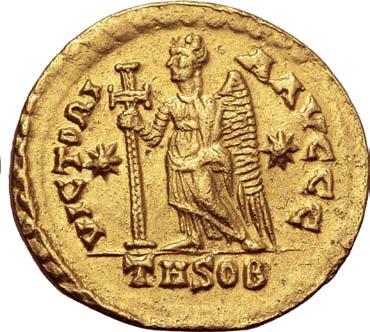
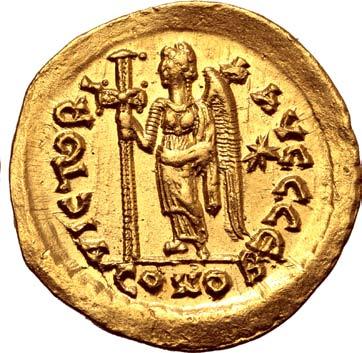







Extremely Fine.
Thessalonica Mint
Leo I AV Solidus. Thessalonica, AD 462 or 466. D N LEO PERPET AVG, pearl-diademed, helmeted and cuirassed bust facing slightly to right, holding spear and shield decorated with horseman motif / VICTORIA AVGGG, Victory standing to left, holding long jewelled cross; star in left and right fields, THSOB in exergue. RIC X 618; Depeyrot 59/1. 4.39g, 20mm, 6h.


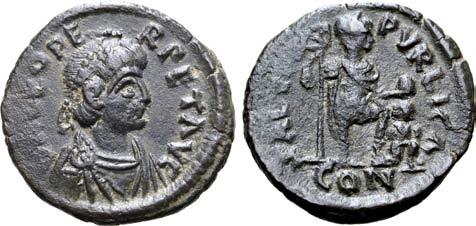
Leo I BI 20mm. Constantinople, AD 474. [D N LE]O PERPET AVG, pearl-diademed, draped and cuirassed bust to right / SAL[VS R] PVRLICA, emperor standing to right, holding standard and globe, treading down a captive; CON in exergue. RIC X 658. 3.90g, 20mm, 6h.
Good Very Fine; excellent quality for the type. Rated R4 in RIC.
Ex David Miller Collection, previous collector’s tickets seemingly indicating it was acquired from C. J. Martin, and noting what may be an acquisition date of March 1975.
90
260
300
664.
300
666. 300
Extremely Fine. Rare. 300
668.
Aelia Verina (wife of Leo I) AV Tremissis. Constantinople, circa AD 457-468. AEL ЧERINA AVG, pearl-diademed, draped and cuirassed bust to right / Cross within wreath; CONOB(star) in exergue. RIC X 615; Depeyrot 96/1. 1.49g, 15mm, 6h.

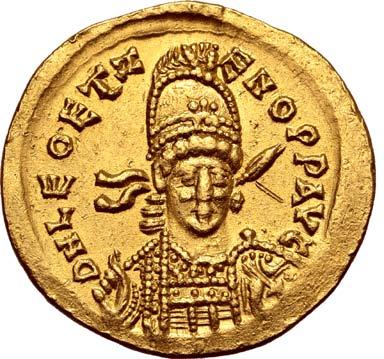

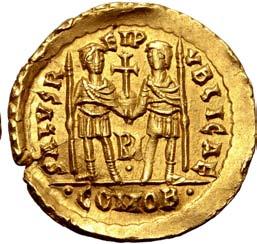




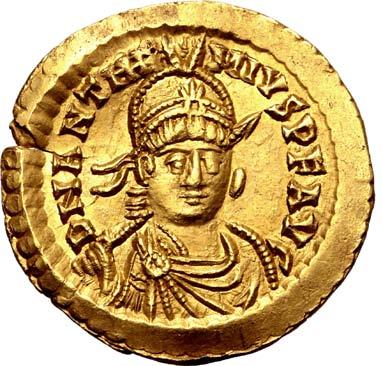
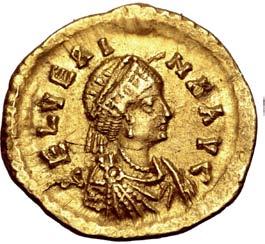

Extremely Fine. Very Rare.
Acquired from Naville Numismatics Ltd; Previously purchased from Numismatica Ars Classica.
Anthemius AV Solidus. Rome, AD 468. D N ANTHEMIVS P F AVG, helmeted, pearl-diademed, draped and cuirassed bust facing slightly to right, holding spear over shoulder / SALVS REIPVBLICAE, Anthemius and Leo I, in military attire, standing facing, holding spears and supporting a globus cruciger between them; ROMA monogram over pellet in central field, •COMOB• in exergue. RIC X 2833; C. -; Lacam 48, pl. CXIII, variety 4.3 (this coin); Depeyrot 67/1; LRC -. 4.36g, 21mm, 6h.

Near Mint State; flan crack at 9h. Very Rare; in exceptional condition for the type.
This coin published in G. Lacam, La fin de l’Empire romain et le monnayage or en Italie (Luzern, 1983); Ex Numismatic Fine Arts Inc., Auction XII, 23-24 March 1983, lot 514; Ex Bank Leu AG, Auction 13, 29-30 April 1975, lot 521.
3,900
Anthemius AV Solidus. Mediolanum, AD 471-472. D N ANTHEMIVS P F AVG, helmeted, pearl-diademed and cuirassed bust facing, holding spear and shield decorated with horseman motif / SALVS REIPVBLICAE, Anthemius and Leo standing facing, clasping hands and holding between them banner inscribed PAS surmounted by cross, emperor on right holding Victory on globe; M-D across fields, COMOB in exergue. RIC X 2885 (this coin); Depeyrot 31/2 corr. (rev. type); Lacam 79. 4.46g, 22mm, 1h.
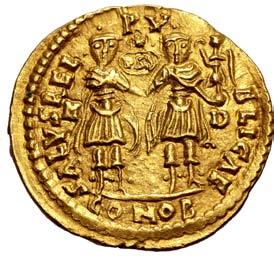

Extremely Rare; rated R4 in RIC, Depeyrot notes only 6 examples and only one other on CoinArchives. This coin illustrated in Kent, J. P. C. The Roman Imperial Coinage, Volume X, The Divided Empire and
Privately
Extremely Fine. Rare.
261
669. 450
670.
the Fall of the Western Parts, AD 395 - 491. (London, 1994);
purchased from Münzhandlung Ritter in February 1995 (dealer ’s ticket included).
671. 4,500
Leo II and Zeno AV Solidus. Constantinople, AD 474. D N LEO EƮ ZENO P P AVG, pearl-diademed, helmeted and cuirassed bust facing, holding spear and shield decorated with horseman motif / SALVS REIPVBLICAE, Leo and Zeno seated facing on double throne, each holding mappa in right hand; star and cross above, CONOB in exergue. RIC X 803; Depeyrot 98/1; DOCLR 600. 4.42g, 21mm, 6h.
in Lacam; Ex Leu 13 1975
in RIC
672.
1,200 Published
Illustrated
X
673.
Leo II and Zeno AV Solidus. Constantinople, AD 474. D N LEO EƮ ZENO P P AVG, pearl-diademed, helmeted and cuirassed bust facing, holding spear and shield decorated with horseman motif / SALVS REIPVBLICAE, Leo and Zeno seated facing on double throne, each holding mappa in right hand; star and cross above, CONOB in exergue. RIC X 803; Depeyrot 98/1; DOCLR 600. 4.36g, 21mm, 6h.

Near Extremely Fine; ‘Π’ and ‘Σ’ graffiti in obv. fields, wavy flan. Rare.
900
674.
Zeno AV Solidus. Constantinople, AD 476-491. D N ZENO PERP AVG, pearl-diademed, helmeted and cuirassed bust facing slightly to right, holding spear over right shoulder and shield decorated with horseman motif / VICTORIA AVGGG I, Victory standing facing, head to left, holding long jewelled cross; star in right field, CONOB in exergue. RIC X 910 and 929; Depeyrot 108/1. 4.41g, 20mm, 6h.
Good Extremely Fine.
300
675.
Zeno AV Solidus. Constantinople, AD 476-491. D N ZENO PERP AVG, pearl-diademed, helmeted and cuirassed bust facing slightly to right, holding spear and shield decorated with horseman motif / VICTORIA AVGGG I, Victory standing facing, head to left, holding long jewelled cross; star in right field, CONOB in exergue. RIC X 910 and 929; Depeyrot 108/1. 4.44g, 20mm, 6h.
Near Mint State; ‘X’ graffito in obv. field.
300
Zeno AV Solidus. Constantinople, AD 476-491. D N Z(retrograde)ENO PERP AVG, pearl-diademed, helmeted and cuirassed bust facing, holding spear and shield decorated with horseman motif / VICTORIA AVGGG I, Victory standing facing, head to left, holding long jewelled cross; star in right field, CONOR in exergue. Cf. RIC X 911 and 930 (obv. legend); cf. Depeyrot 108/1; cf. Roma E-105, 1274. 4.38g, 19mm, 6h.


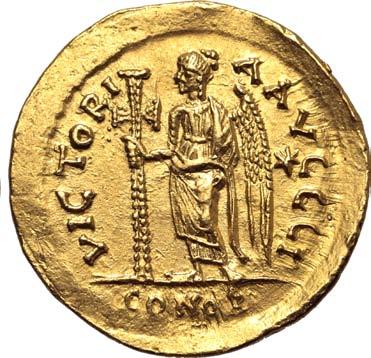

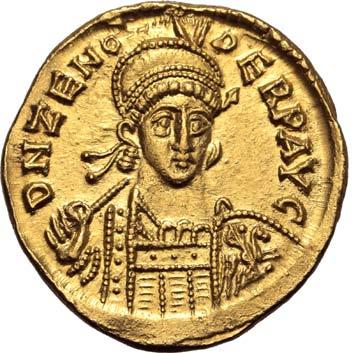









676. 450
Near Mint State. Scarce obv. legend variant with a retrograde Z.
677. 300
Zeno AV Solidus. Constantinople, AD 476-491. D N ZENO PERP AVG, helmeted, pearl-diademed and cuirassed bust facing, holding spear and shield decorated with horseman motif / VICTORIA AVGGG S, Victory standing facing, head to left, holding long jewelled cross; star in right field, CONOB in exergue. RIC X 911 and 930; Depeyrot 108/1. 4.50g, 20mm, 6h.
Good Extremely Fine.
262
678.
Zeno AV Solidus. Constantinople, AD 476-491. D N ZENO PERP AVG, helmeted, pearl-diademed and cuirassed bust facing, holding spear and shield decorated with horseman motif / VICTORIA AVGGG I, Victory standing facing, head to left, holding long jewelled cross; star in right field, CONOB in exergue. RIC X 911 and 930; Depeyrot 108/1; Naumann 84, 539 (same dies). 4.45g, 19mm, 6h.








An AVGGT Solidus
Zeno AV Solidus. Constantinople, AD 476-491. D N ZENO PERP AVG, pearl-diademed, helmeted and cuirassed bust facing slightly to right, holding spear and shield decorated with horseman motif / VICTORIA AVGGT B, Victory standing facing, head to left, holding long jewelled cross; star in right field, CONOB in exergue. RIC X 927; Depeyrot 112/1; MIRB 8; DOCLR 664-5 var. (officina, attributed to Thessalonica); Lacam pl. 54-5, 16-25 var. (officina, attributed to Ticinum under Theoderic). 4.41g, 21mm, 6h.

Zeno AV Solidus. Thessalonica, AD 476-491. D N ZENO PERP AVG, pearl-diademed, helmeted and cuirassed bust facing, holding spear and shield decorated with horseman motif / VICTORIA AVGGG, Victory standing facing, head to left, holding long jewelled cross; star in left and right fields, CONOB in exergue. RIC X 941; Depeyrot 62/1; MIRB 19; DOCLR 666-8. 4.42g, 21mm, 6h.



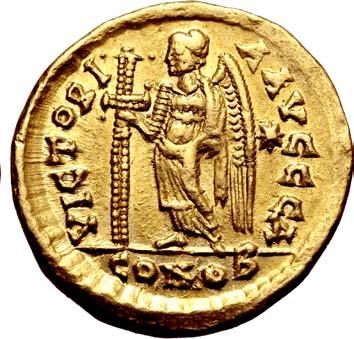

Good Extremely Fine.
Basiliscus AV Solidus. Constantinople, AD 475-476. D N ЬASILISCЧS P P AVG, pearl-diademed, helmeted and cuirassed bust facing slightly to right, holding spear and shield decorated with horseman motif / VICTORIA AVCCC A, Victory standing to left, holding long jewelled cross; star in right field, COMOB in exergue. RIC X 1003; Depeyrot 101/1; Biaggi -. 4.49g, 20mm, 6h.
Near Extremely Fine. Rare.
Ex David Miller Collection, Roma Numismatics Ltd., Auction XXIII, 25 March 2022, lot 736 (collector’s ticket included).
263
Fine.
Extremely
300
Good Extremely Fine. Rare. 679. 300
680. 600
681. 750
682. 600
683.
Basiliscus AV Solidus. Constantinople, 9 January - August AD 475. D N bASILISCЧS P P AVG, pearl-diademed, helmeted and cuirassed bust facing slightly to right, holding spear and shield decorated with horseman motif / VICTORIA AVGGG, Victory standing facing, head to left, holding long jewelled cross; star in right field, CONOB in exergue. RIC X 1003; Depeyrot 101/1; DOCLR 607. 4.44g, 21mm, 6h.
Extremely Fine. Rare.
684.
Basiliscus AV Solidus. Constantinople, 9 January - August AD 475. D N bASILISCЧS P P AVG, pearl-diademed, helmeted and cuirassed bust facing slightly to right, holding spear and shield decorated with horseman motif / VICTORIA AVGGG, Victory standing facing, head to left, holding long jewelled cross; star in right field, CONOB in exergue. RIC X 1003; Depeyrot 101/1; DOCLR 607. 4.48g, 20mm, 6h. Extremely
685.
Basiliscus AV Solidus. Constantinople, 9 January - August AD 475. D N bASILISCЧS P P AVG, pearl-diademed, helmeted and cuirassed bust facing slightly to right, holding spear and shield decorated with horseman motif / VICTORIA AVGGG H, Victory standing facing, head to left, holding long jewelled cross; star in right field, CONOB in exergue. RIC X 1003; Depeyrot 101/1; DOCLR 611. 4.46g, 20mm, 5h.
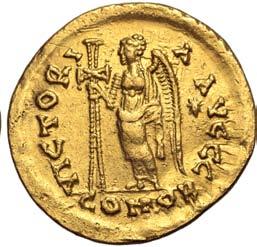











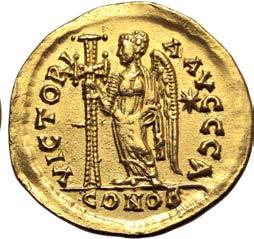


Extremely Fine; graffiti in obv. field. Rare.
Basiliscus and Marcus AV Solidus. Constantinople, autumn AD 475 - August AD 476. D N bASILISCI EƮ MARC P AVG, pearl-diademed, helmeted and cuirassed bust facing slightly to right, holding spear over shoulder and shield decorated with horseman motif / VICTORIA AVGGG A, Victory standing facing, head to left, holding long jewelled cross; star in right field, CONOB in exergue. RIC X 1024; Depeyrot 105/2; DOCLR -. 4.41g, 21mm, 6h.
Near Extremely Fine. Rare.
264
Fine. Rare.
600
450
600
686.
COINS OF THE MIGRATION PERIOD
Pseudo-Imperial, uncertain AV Solidus. In the name of Theodosius II, after AD 423. D N THEDOSIVS P F AVG, pearl-diademed, helmeted and cuirassed bust facing slightly to right, holding spear and shield decorated with horseman motif / VOT XX MVLT XXX, Constantinopolis seated to left, holding globus cruciger and sceptre, foot on prow, shield by throne; star in right field, CONOB in exergue. Unpublished in the standard references; for prototype, cf. RIC X 257 (diff. obv. legend) and Depeyrot 81/1; cf. Roma XXV, 1108 (same obv. die, Victory rev. type). 4.38g, 20mm, 11h.



Extremely Fine. Unpublished and possibly unique.
687.
600
688.
Pseudo-Imperial, uncertain AV Solidus. In the name of Theodosius II, after AD 450. D N THEDOSIVS P R AVG, pearl-diademed, helmeted and cuirassed bust facing slightly to right, holding spear and shield decorated with horseman motif / VICTORIA AVGGG Z, Victory standing facing, head to left, holding long jewelled cross; star in right field, CONOB in exergue. 4.44g, 19mm, 6h.





Mint State. Unpublished and possibly unique.
900
This reverse type only features on the coinage of Theodosius II accompanied by a vota legend commemorating the anniversaries of the emperor’s accession. Since the VICTORIA AVGGG type was not revived until the reign of Marcian, it is likely that the prototype for this reverse was struck after AD 450.





689.
Visigoths, Pseudo-Imperial AV Tremissis. Uncertain mint, AD 466-484. In the name of Libius Severus. D N SEVIRVS P AVG, pearl-diademed, draped and cuirassed bust to right / VICTORIA AVGGG, Victory standing to left, holding long cross; COMOB in exergue. RIC X 3762; cf. MEC 1, 173 for Visigothic coin of same type in the name of Valentinian III; LACAM -; DOC -. 1.40g, 14mm, 6h.
Extremely Fine. Very Rare.
Ex Numismatica Ars Classica, Auction 92, Part 1, 23 May 2016, lot 882.
1,800
Pseudo-Imperial, Odovacar (Odoacer) AV Solidus. In the name of Zeno. Rome, AD 476-489. D N ZENO PERP F AVG, pearl-diademed, helmeted and cuirassed bust facing slightly to right, holding spear and shield decorated with horseman motif / VICTORIA AVGGG :, Victory standing facing, head to left, holding long jewelled cross; star in right field, COMOB in exergue. RIC X 3651; cf. Depeyrot 78/2 (Nepos); Ladich p. 11; MEC 1 -; BMC Vandals -; DOC -; Lacam pl. 50, 1 (same dies). 4.38g, 20mm, 6h.
Extremely Fine. Very Rare.
1,200
265
Unpublished and Possibly Unique
690.
Pseudo-Imperial, Odovacar (Odoacer) AV Solidus. In the name of Zeno. Rome, AD 476-489. D N ZENO PERP F AVG, pearl-diademed, helmeted and cuirassed bust facing slightly to right, holding spear and shield decorated with horseman motif / VICTORIA AVGGG Γ•, Victory standing facing, head to left, holding long jewelled cross; star in right field, •COMOB• in exergue. RIC X 3655; Ladich p. 11; MEC 1, -; BMC Vandals -; DOCLR -; Lacam pls. 50-1, 10-24. 4.44g, 20mm, 6h.






Extremely Fine. Very Rare.
Extremely Rare
691.
900
692.
Pseudo-Imperial, Odovacar (Odoacer) AV Solidus. In the name of Zeno. Rome, AD 476-489. D N ZENO PERP F AVG (Z retrograde), pearl-diademed, helmeted and cuirassed bust facing slightly to right, holding spear and shield decorated with horseman motif / VICTORIA AVGGG Γ•, Victory standing facing, head to left, holding long jewelled cross; star in right field, •COMOB• in exergue. RIC X 3656; Ladich p. 11; MEC 1, -; BMC Vandals -; DOCLR -; Lacam pls. 50-1, 10-24; Roma XXV, 1129; Roma E-71, 1362; NAC 93, 1097. 4.32g, 19mm, 6h.


Good Extremely Fine. Extremely Rare with partially retrograde obv. legend; only three other examples offered at auction in the past 20 years.
900
693.
Pseudo-Imperial, Odovacar (Odoacer) AV Solidus. In the name of Zeno. Rome, AD 476-489. D N ZENO PERP F AVG, pearl-diademed, helmeted and cuirassed bust facing slightly to right, holding spear and shield decorated with horseman motif / VICTORIA AVGGG Ä, Victory standing facing, head to left, holding long jewelled cross; star in right field, •COMOB• in exergue. RIC X 3657; Depeyrot 92/1; Ladich p. 11; MEC 1, -; BMC Vandals -; DOCLR -; Lacam pl. 50, 7-9. 4.19g, 20mm, 7h.
Good Very Fine. Very Rare; rated R4 by RIC.
Ravenna Mint

600
Pseudo-Imperial, Odovacar (Odoacer) AV Solidus. In the name of Zeno. Ravenna, AD 476-489. D N ZЄNO PERP F AVG, pearl-diademed, helmeted and cuirassed bust facing slightly to right, holding spear and shield decorated with horseman motif / VICTORIA AVGGG, Victory standing facing, head to left, holding long jewelled cross; star in right field, CONOBRV in exergue. RIC X 3634; Depeyrot 42/1; DOCLR -; BMC Vandals 2; Lacam pl. 51, 27 (same dies). 4.43g, 20mm, 6h.




Near Mint State; highly lustrous. Very Rare.
1,200
266
694.
Extremely Rare
Pseudo-Imperial, Odovacar (Odoacer) AV Solidus. In the name of Zeno. Ravenna, AD 476-489. D N ZENO PERP AVG, pearl-diademed, helmeted and cuirassed bust facing slightly to right, holding spear and shield decorated with horseman motif / VICTORIA AVGGG :, Victory standing facing, head to left, holding long jewelled cross; star in right field, COMOB in exergue. RIC X 3625; Depeyrot 78/3 (attributed to Rome, first reign of Julius Nepos); Lacam pl. 40, 63-4 (same obv. die); Baldi 23; Heritage Showcase 61288, 95288 (attributed to uncertain mint). 4.31g, 20mm, 7h.
Good Extremely Fine. Extremely Rare; only two examples cited by Depeyrot, both of which are in museums, seemingly only one other on CoinArchives.
There have been various attributions for this extremely rare issue. It has both been suggested that it was struck during the first reign of Julius Nepos (474-475) at either Ravenna (Lacam, pp. 620-5) or Rome (Depeyrot p. 162), or was an early emission of Ravenna during the second reign of Zeno when the Western Roman Empire was under the control of Odovacar (Kent, RIC X, p. 215 and Baldi, p. 7).
1,200
695.
Pseudo-Imperial, uncertain AV Solidus. In the name of Zeno. Uncertain mint, AD 476-489. D N ZENO PERP AVG, pearl-diademed, helmeted and cuirassed bust facing slightly to right, holding spear and shield decorated with horseman motif / IVCTORIA AVGGG Δ, Victory standing facing, head to left, holding long jewelled cross; star in right field, CONOB in exergue. For prototype, cf. RIC X 911 and 930, Depeyrot 108/1; Roma XXVII, 815 (same dies). 4.34g, 20mm, 6h.



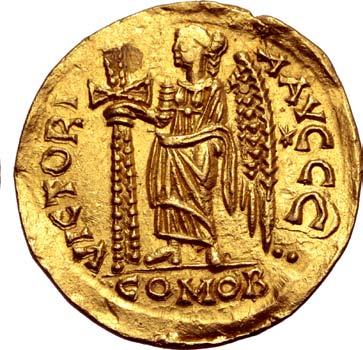








Good Extremely Fine; highly lustrous. Extremely Rare.
Extremely Rare
696.
1,200
697.
Pseudo-Imperial, uncertain AV Solidus. In the name of Zeno. Uncertain mint, AD 476-489. D N ZENO PERP AVG, pearl-diademed, helmeted and cuirassed bust facing slightly to right, holding spear and shield decorated with horseman motif / VICTORIA AVGGG Ꮖ, Victory standing facing, head to left, holding long jewelled cross; star in right field, COMOB in exergue. For prototype, cf. RIC X 910 and 929, Depeyrot 108/1; for similar, cf. Roma XXV, 1130 (hammer: 3,000 GBP). 4.34g, 20mm, 6h.
Near Mint State. Extremely Rare.
1,200
Pseudo-Imperial, uncertain AV Solidus. In the name of Zeno. Uncertain mint, AD 476-489. D N ZENO PERP AVG, pearl-diademed, helmeted and cuirassed bust facing slightly to right, holding spear and shield decorated with horseman motif / VICTORIA AVGGG Θ, Victory standing facing, head to left, holding long jewelled cross; star in right field, CONOR in exergue. For prototype, cf. RIC X 910 and 929, Depeyrot 108/1. 4.41g, 19mm, 6h.
Near Mint State. Extremely Rare.
1,200
267
698.
Pseudo-Imperial, uncertain AV Solidus. In the name of Zeno. Uncertain mint, AD 476-489. D N ZENO PERP AVG (retrograde Z), pearl-diademed, helmeted and cuirassed bust facing slightly to right, holding spear and shield decorated with horseman motif / VICTORIA AVGGG S, Victory standing facing, head to left, holding long jewelled cross; star in right field, CONOB in exergue. For prototype, cf. RIC X 910 and 929, Depeyrot 108/1. 4.28g, 21mm, 6h.
Good Extremely Fine. Extremely Rare.
1,200
699. 300
700.
Pseudo-Imperial, uncertain AV Solidus. In the name of Zeno. Uncertain mint, AD 476-489. D N ZENO PERP AVG, pearl-diademed, helmeted and cuirassed bust facing slightly to right, holding spear and shield decorated with horseman motif / VICTORIA AVGGG A, Victory standing facing, head to left, holding long jewelled cross; star in right field, CONOB in exergue. For prototype, cf. RIC X 910 and 929, Depeyrot 108/1. 4.37g, 19mm, 7h. Extremely Fine.
701.
Pseudo-Imperial, uncertain AV Solidus. In the name of Anastasius I. Uncertain mint, AD 491-518. D N ANASTASIVS PERP AVG, pearl-diademed, helmeted and cuirassed bust facing slightly to right, holding spear and shield decorated with horseman motif / VICTORAA AVGGG ᗡ •, Victory standing facing, head to left, holding long jewelled cross; star in right field, CONOBஃ in exergue. Unpublished in the standard references; for similar, cf. Roma XXIII, 1156, Roma XXV, 1133 and Roma XXVII, 826. 4.44g, 20mm, 6h.

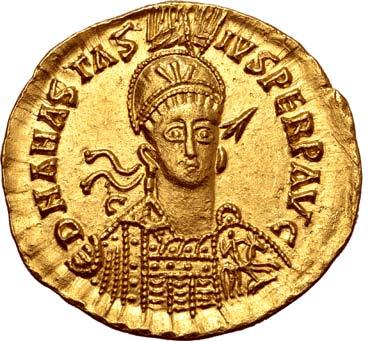
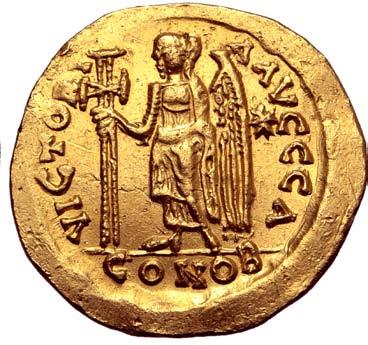

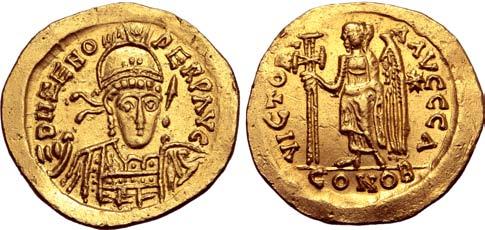




Mint State. Extremely Rare.
Pseudo-Imperial, uncertain AV Solidus. In the name of Anastasius I. Uncertain mint, AD 491-518. D N ANASTASIVS P P AV, pearl-diademed, helmeted and cuirassed bust facing slightly to right, holding spear and shield decorated with horseman motif / VICTORIA AVGGG, Victory standing facing, head to left, holding long jewelled cross; star in right field, CONOB in exergue. Unpublished in the standard references. 4.44g, 20mm, 6h. Mint State. Extremely Rare.



The style of this issue is comparable to the solidi struck in the name of Zeno at the mint of Ravenna (cf. RIC X 3651-7).



268
1,200 1,200
702.
COINS OF THE BYZANTINE EMPIRE



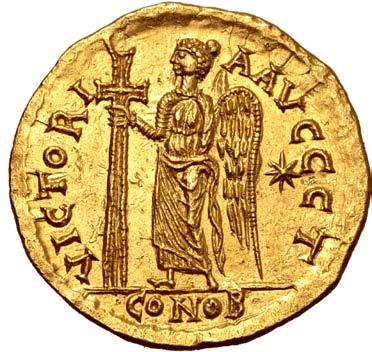

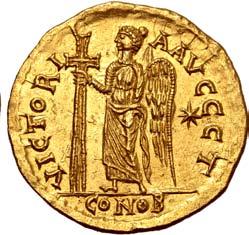


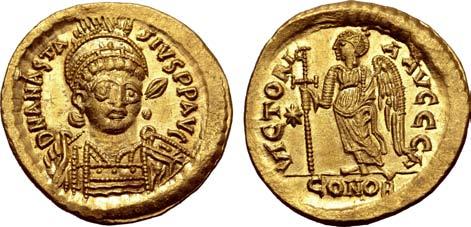
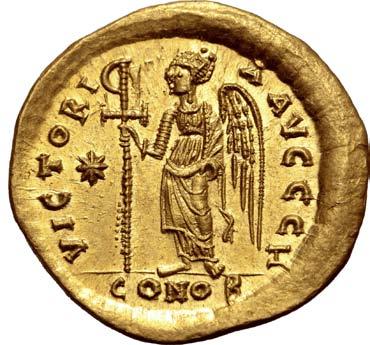


Anastasius I AV Solidus. Constantinople(?), AD 492-507. D N ANASTASIVS P P AVG, helmeted and cuirassed bust facing slightly to right, long cross on helmet, holding spear and shield decorated with horseman motif / VICTORIA AVGGG T, Victory standing facing, head to left, holding long jewelled cross; star in right field, CONOB in exergue. MIBE 4a var. (unlisted officina); DOC 4b var. (same); Sear 3 var. (same); Roma XXIII, 1158 (same dies, hammer: 4,600 GBP). 4.42g, 20mm, 6h.

Mint State; struck from dies of magnificent style. Of the greatest rarity; only the second recorded example.
1,200
Anastasius I AV Solidus. Constantinople, AD 498-518. D N ANASTASIVS P P AVG, helmeted and cuirassed bust facing slightly to right, holding spear and shield decorated with horseman motif / VICTORIA AVGGG H, Victory standing facing, head to left, holding long staff surmounted by staurogram; star in left field, CONOB in exergue. MIBE 7; DOC 7h; Sear 5. 4.48g, 21mm, 6h.
Mint State; lustrous and well-centred.
Acquired from Leu Numismatik AG; Ex Nea Rhomē Collection, formed in the early 2000s.
Anastasius I AV Solidus. Constantinople, AD 498-518. D N ANASTASIVS P P AVG, helmeted and cuirassed bust facing slightly to right, holding spear and shield decorated with horseman motif / VICTORIA AVGGG A, Victory standing facing, head to left, holding long staff surmounted by staurogram; star in left field, CONOB in exergue. MIBE 7; DOC 7a; Sear 5. 4.52g, 20mm, 6h.
Near Mint State; lustrous.
Ex Nea Rhomē Collection, formed in the early 2000s.
Anastasius I AV Solidus. Constantinople, AD 498-518. D N ANASTASIVS P P AVG, helmeted and cuirassed bust facing slightly to right, holding spear and shield decorated with horseman motif / VICTORIA AVGGG A, Victory standing facing, head to left, holding long staff surmounted by staurogram; star in left field, CONOB in exergue. MIBE 7; DOC 7a; Sear 5. 4.49g, 21mm, 6h.
Good Extremely Fine.
Acquired from Morton & Eden; Ex European Ambassador Collection, formed in the 1950s and 1960s.
269
The Second Known
900
703.
704.
600 510
705.
706.
Justin I AV Solidus. Constantinople, AD 518-519. D N IVSTINVS P P AVI, pearl-diademed, helmeted and cuirassed bust facing slightly to right, holding spear and shield decorated with horseman motif / VICTORIA AVCCC I Victory standing facing, head to left, holding long staff surmounted by staurogram; star in left field, CONOB in exergue. MIBE 2; DOC 1h; Sear 55. 4.47g, 21mm, 6h. Good Extremely Fine.
708.
Justin I AV Solidus. Constantinople, AD 519-527. D N IVSTINVS P P AVI, pearl-diademed, helmeted and cuirassed bust facing slightly to right, holding spear and shield decorated with horseman and enemy motif / VICTORIA AVCCC S, angel standing facing, holding long cross and globus cruciger; star in right field, CONOB in exergue. MIBE 3; DOC 2f; Sear 56. 4.50g, 21mm, 12h. Mint State.
Ex Nea Rhomē Collection, formed in the early 2000s. 600
709.
Justin I AV Solidus. Constantinople, AD 519-527. D N IVSTINVS P P AVC, pearl-diademed, helmeted and cuirassed bust facing slightly to right, holding spear and shield decorated with horseman motif / VICTORIA AVGGG I, angel standing facing, holding long cross and globus cruciger; star in right field, CONOB in exergue. MIBE 3; DOC 2i; Sear 56. 4.48g, 20mm, 7h.



Near Mint State; tiny scratch to rev. below mintmark.
Acquired from Morton & Eden; Ex European Ambassador Collection, formed in the 1950s and 1960s.
710.
Justin I AV Tremissis. Constantinople, AD 518-527. D N IVSTINVS P P AVG, pearl-diademed and cuirassed bust to right, wearing paludamentum / VICTORIA AVGVSTORVM, Victory advancing to right, head reverted to left, holding wreath and globus cruciger; star in right field, CONOB in exergue. MIBE 5; DOC 4; Sear 58. 1.50g, 16mm, 12h. Mint State; in a remarkable state of preservation.

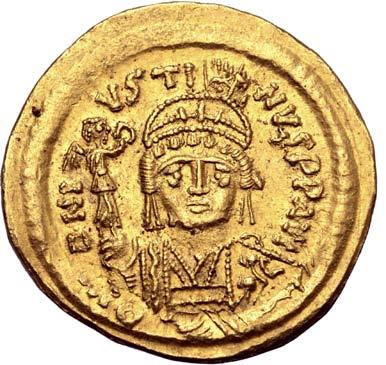




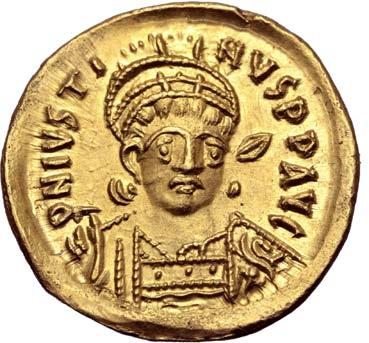




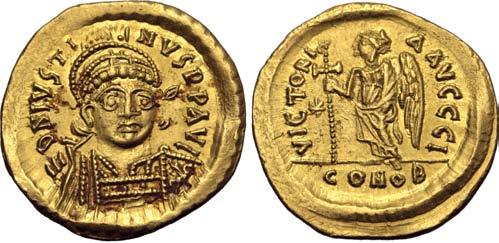
Good Extremely Fine; lightly clipped.
Ex The Coins of 100 Generations Collection, published online at http://www.goldencollection.club. 300
270
Acquired from Morton & Eden; Ex European Ambassador Collection, formed in the 1950s and 1960s. 510
707.
Ex Nea Rhomē Collection, formed in the early 2000s. 510 450
Justin II AV Solidus. Constantinople, AD 565-578. D N IVSTINVS P P AVI, pearl-diademed, helmeted and cuirassed bust facing, holding Victory on globe and shield decorated with horseman motif / VICTORIA AVGGG Δ, Constantinopolis seated facing on throne, head to right, holding spear and globus cruciger; CONOB in exergue. MIBE 5; DOC 4c; Sear 345. 4.22g, 20mm, 6h.
712.
Phocas AV Solidus. Constantinople, AD 607-610. [∂] N FOCAS PЄRP AVI, draped and cuirassed bust facing, wearing crown without pendilia and holding globus cruciger / VICTORIA AVςЧ Є(?), angel standing facing, holding staff surmounted by staurogram and globus cruciger; CONOB in exergue. MIBE 11; DOC 10e; Sear 620. 4.49g, 21mm, 6h.






Mint State.
Acquired from Morton & Eden; Ex European Ambassador Collection, formed in the 1950s and 1960s.
Constantine IV AV Solidus. Constantinople, AD 681-685. [P CONSƮAN]ЧS P P A, helmeted and cuirassed bust facing slightly to right, holding spear and shield decorated with horseman motif / VICTORA AVςЧ Γ, cross potent on three steps, CONOBA in exergue. MIB 11; DOC 15; Sear 1158. 4.49g, 20mm, 6h.

Mint State; area of flatness, a wonderful portrait.
Acquired from Morton & Eden; Ex European Ambassador Collection, formed in the 1950s and 1960s.
Justinian II AV Solidus. Second reign. Constantinople, circa AD 705. ∂ N IҺS CҺS RЄX RЄ[GNANTIЧM], bust of Christ Pantokrator facing / [∂ N IЧST]INIANV[S MЧLTЧS AN], facing bust of Justinian, wearing crown and loros, holding cross potent on three steps and globus cruciger inscribed PA[X]. MIB 1; DOC 1; Sear 1413. 4.50g, 20mm, 6h.
Mint State; area of flatness.
Acquired from Morton & Eden; Ex European Ambassador Collection, formed in the 1950s and 1960s.
Justinian II AV Solidus. Second reign. Constantinople, circa AD 705. ∂ N IҺS CҺS RЄX RЄG[NANT]IЧM, bust of Christ Pantokrator facing / ∂ N IЧS[TINIANVS MЧLTЧS AN], facing bust of Justinian, wearing crown and loros, holding cross potent on three steps and globus cruciger inscribed [P] A[X]. MIB 1; DOC 1; Sear 1413. 4.44g, 20mm, 6h.




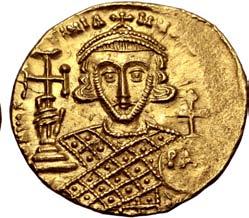


Mint State, some areas of flatness; astonishing detail.
Acquired from Nomos AG.
271
711. 450
450
713.
714.
2,100 1,920
715.
Constantine V Copronymus, with Leo III, AV Solidus. Constantinople, AD 742-745. N C LЄON P A MЧL, crowned and draped bust of Leo facing, holding cross potent and akakia / [C] N CONSƮANƮINЧS, crowned and draped bust of Constantine facing, holding cross potent and akakia. Füeg 3.B.1; DOC 1g.4 var. (obv. legend); Sear 1550. 4.46g, 20mm, 6h.

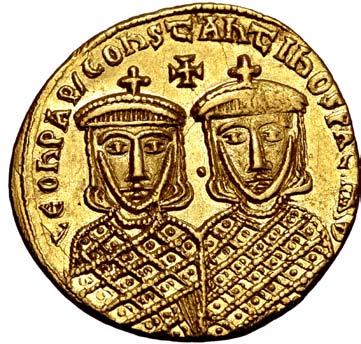






Good Extremely Fine. Rare.
716.
Constantine V Copronymus, with Leo III, AV Solidus. Constantinople, AD 742-745. C LЄON P A MЧL-, crowned and draped bust of Leo facing, holding cross potent and akakia / C N CONSƮANƮINЧS, crowned and draped bust of Constantine facing, holding cross potent and akakia. Füeg 2.B.3; DOC 1g.4; Sear 1550. 4.46g, 20mm, 6h.
Good Extremely Fine. Rare.
717.
Constantine V Copronymus, with Leo IV and Leo III, AV Solidus. Constantinople, AD 750-756. COҺSƮAҺƮIҺOS S LЄOҺ O ҺЄOS, crowned facing busts of Constantine V and Leo IV, each wearing chlamys; cross above / C LЄON PA MЧL Θ, crowned facing bust of Leo III, wearing loros and holding cross potent with raised and bent index finger. Füeg 4.B.1; DOC 2a.1; Sear 1551. 4.45g, 20mm, 6h.
Near Mint State.
718.
Constantine V Copronymus, with Leo IV and Leo III, AV Solidus. Constantinople, AD 756-764. COҺSƮAҺƮIҺOS S LЄOҺ O ҺЄOS, crowned facing busts of Constantine V and Leo IV, each wearing chlamys; cross above, pellet between / C LЄO[N P A M]ЧL Φ, crowned facing bust of Leo III wearing loros, holding cross potent in right hand. Füeg 6.B.5; DOC 2g.1; Sear 1551. 4.47g, 20mm, 6h.
Near Mint State.
719.
Leo IV ‘the Khazar’, with Constantine VI, Leo III, and Constantine V, AV Solidus. Constantinople, AD 778-780. LЄOҺ VS S ЄςςOҺ COҺSƮAҺƮIҺOS O ҺЄS, crowned busts of Leo IV and Constantine VI facing, each wearing chlamys; cross above, pellet between / LЄOҺ PAP’ COҺSƮAҺƮIҺOS PAƮHR Θ, crowned facing busts of Leo III and Constantine V, each wearing loros; cross above, pellet between. Füeg 1.5; DOC 1a.2; Sear 1583. 4.50g, 20mm, 6h.



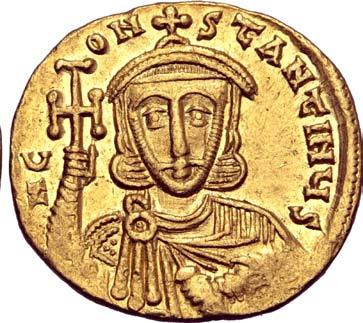
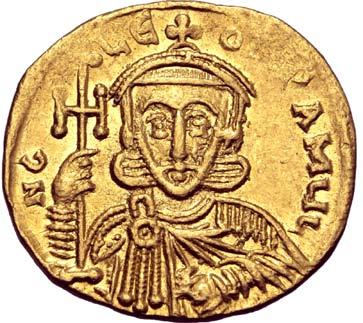
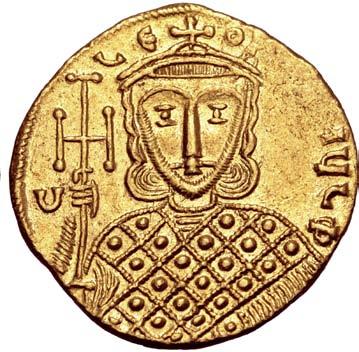
Near Mint State.

272
300
300
450
450
600
720.
Constantine VI, with Leo III, Constantine V, and Leo IV, AV Solidus. Constantinople, AD 780-787. LЄOҺ VS S ЄςςOҺ COҺSƮAҺƮIҺOS O ҺЄOS], Leo IV and Constantine VI enthroned facing, each wearing crown and chlamys and holding akakia; cross above / LЄOҺ [PAP COҺSƮAҺƮIҺOS PAƮHR], crowned facing busts of Leo III and Constantine V, each wearing loros; cross above, pellet between. Füeg 1.B.1; DOC 2 (Leo IV); Sear 1584 (Leo IV). 4.43g, 21mm, 6h.
Good Extremely Fine; small area of flatness.
721.
600
722.
Constantine VI and Irene, with Leo III, Constantine V, and Leo IV AV Solidus. Constantinople, AD 792-793. SV IRIҺI AV’ MIƮRI AV’, Constantine V, Leo III, and Leo IV seated facing, each crowned and wearing chlamys / COҺSƮAҺTIҺOS C’b’Δ’, crowned facing busts of Constantine IV, wearing chlamys and holding globus cruciger, and Irene, wearing loros and holding cruciform sceptre; cross above, pellet between. Füeg 4; DOC 2a.2; Sear 1591. 4.46g, 20mm, 6h.


Near Mint State.
Ex Roma Numismatics Ltd., Auction XXIII, 25 March 2022, lot 1188.
723.
Constantine VI and Irene, with Leo III, Constantine V, and Leo IV AV Solidus. Constantinople, AD 792-793. SVҺ IRIҺI [AVΓ’ ᙏIƮHR], Constantine V, Leo III, and Leo IV seated facing, each crowned and wearing chlamys / COҺSƮΛҺƮIҺ ‘CΛ’b[Λ’Δ’], crowned facing busts of Constantine IV, wearing chlamys and holding globus cruciger, and Irene, wearing loros; cross above, pellet between. Füeg 4 (Ir.4.1/C.19); DOC 2; Sear 1593. 4.45g, 20mm, 6h.
Good Extremely Fine.
300
724.
Constantine VI, with Irene AV Solidus. Constantinople, AD 793-797. IRIҺH AΓOVSƮI, crowned facing bust of Irene, wearing loros, holding globus cruciger and cruciform sceptre / COҺSƮAҺƮINOS bAS’ Θ, crowned and draped facing bust of Constantine, wearing chlamys, holding globus cruciger and akakia. Füeg 5.A; DOC 3a; Sear 1594. 4.46g, 18mm, 6h.
Extremely Fine.
1,800
Constantine VI, with Irene, AV Solidus. Constantinople, AD 793-797. HRHҺH AVΓЧSƮH, crowned facing bust of Irene, wearing loros, holding globus cruciger and cruciform sceptre / COҺSƮAҺƮINOS bAS’, crowned and draped facing bust of Constantine, wearing chlamys, holding globus cruciger and akakia. Füeg -, cf. 5.C; DOC -, cf. 3c; Sear 1594. 4.49g, 18mm, 6h.







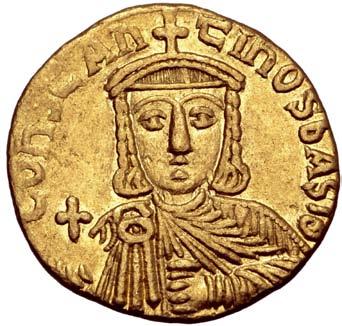





Good Extremely Fine.
Ex Roma Numismatics Ltd., E-Sale 100, 28 June 2022, lot 1634.
1,200
273
600
725.
Constantine VI, with Irene, AV Solidus. Constantinople, AD 793-797. IRIҺH AΓOVSƮI, crowned facing bust of Irene, wearing loros, holding globus cruciger and cruciform sceptre / COҺSƮAҺƮINOS bAS’ Θ, crowned and draped facing bust of Constantine, wearing chlamys, holding globus cruciger and akakia. Füeg 5.A; DOC 3a; Sear 1594. 4.38g, 20mm, 6h.


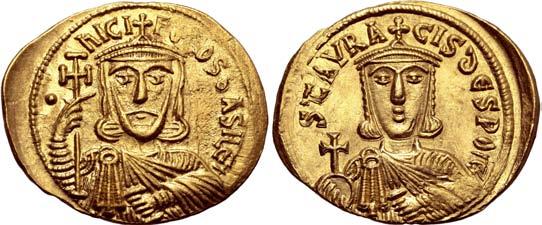


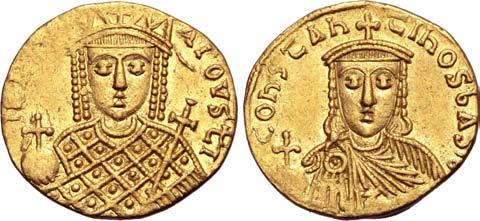





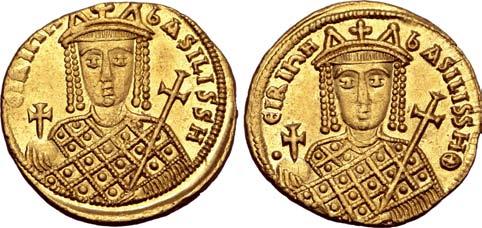



Good Extremely Fine.
1,200
726.
Irene AV Solidus. Constantinople, AD 797-802. ЄIRIҺH ЬASILISSH, crowned bust of Irene facing, wearing loros, holding globus cruciger and cruciform sceptre / • ЄIRIҺH ЬASILISSH X, crowned bust of Irene facing, wearing loros, holding globus cruciger and cruciform sceptre. Füeg 1.C.1; DOC 1c; Sear 1599. 4.38g, 20mm, 6h.
Mint State. Rare.
Ex Roma Numismatics Ltd., Auction XXV, 22 September 2022, lot 1184.
1,800
727.
Irene AV Solidus. Constantinople, AD 797-802. ЄIRIҺH ЬASILISSH, crowned bust of Irene facing, wearing loros, holding globus cruciger and cruciform sceptre / • ЄIRIҺH ЬASILISSH ⴲ, crowned bust of Irene facing, wearing loros, holding globus cruciger and cruciform sceptre. Füeg 2.B.1; DOC 1a; Sear 1599. 4.50g, 20mm, 6h.
Good Extremely Fine.
Nicephorus I, with Stauracius, AV Solidus. Constantinople, AD 803-811. • ҺICIFOROS ЬASILЄ’, crowned facing bust of Nicephorus, wearing chlamys, holding cross potent and akakia / SƮAVRACIS ∂ЄSPO’ Θ, crowned facing bust of Stauracius, wearing chlamys, holding cross potent and akakia. Füeg 2.B.1; DOC 2b.1-2; Sear 1604. 4.44g, 20mm, 6h.
Mint State; highly lustrous metal, perfectly centred.
Ex Classical Numismatic Group, Auction 117, 19 May 2021, lot 701.
729. 600
Nicephorus I, with Stauracius, AV Solidus. Constantinople, AD 803-811. • ҺICIFOROS ЬASILЄ’, crowned facing bust of Nicephorus, wearing chlamys, holding cross potent and akakia / SƮAVRACIS ∂ЄSPO’ Є, crowned facing bust of Stauracius, wearing chlamys, holding cross potent and akakia. Füeg 2.B.2; DOC 2a; Sear 1604. 4.44g, 22mm, 6h.
Near Mint State; area of flatness, lustrous untouched fields.
Ex Roma Numismatics Ltd., Auction XXIII, 25 March 2022, lot 1193.
274
728. 1,800 1,800
730. 600
733.
Nicephorus I, with Stauracius, AV Solidus. Constantinople, AD 803-811. [ҺICIF]OROS ЬASILЄ’, crowned facing bust of Nicephorus, wearing chlamys, holding cross potent and akakia / SƮAVRACIS ∂ЄSPO’ X, crowned facing bust of Stauracius, wearing chlamys, holding globus cruciger and akakia. Füeg 2.A.2; DOC 2c.2; Sear 1604. 4.41g, 19mm, 6h.
Mint State; lustrous surfaces.
734.
Theophilus, with Michael II and Constantine, AV Solidus. Constantinople, AD 831-842. ⧾ MIXAHL S COҺSTAҺTIҺ’, crowned facing busts of Michael II and Constantine, each wearing chlamys; cross above, pellet between / * ΘЄOFILOS bASILЄ Θ’, crowned facing bust of Theophilus, holding patriarchal cross and akakia. Füeg 3.H.2.y; DOC 3d; Sear 1653. 4.38g, 20mm, 6h.
Near Mint State.
Acquired from Morton & Eden; Ex European Ambassador Collection, formed in the 1950s and 1960s.
Theophilus, with Michael II and Constantine, AV Solidus. Constantinople, AD 831-842. ⧾ MIXAHL S COҺSTAҺTIҺ’, crowned facing busts of Michael II and Constantine, each wearing chlamys; cross above, pellet between / * ΘЄOFILOS bASILЄ’Λ, crowned facing bust of Theophilus, holding patriarchal cross and akakia. Füeg 3.E.2.z; DOC 3b; Sear 1653. 4.42g, 22mm, 6h.





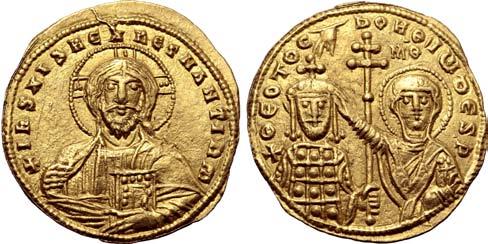









Good Extremely Fine.
Ex collection formed in the Rhineland from late 1970s to late 1990s.
Nicephorus II Phocas, with Basil II, AV Histamenon Nomisma. Constantinople, AD 964-965. ⧾ IҺS XPS RЄX RЄϚNANTIҺᙏ, facing bust of Christ Pantokrator, holding book of Gospels / NIKHΦOP, KAI BACIΛ’ AVΓ, RP’, crowned facing busts of Nicephorus II, wearing loros, and Basil II, wearing chlamys, holding patriarchal cross between them. Füeg 2; DOC 2; Sear 1777. 4.44g, 20mm, 6h.
Good Extremely Fine.
1,200
1,200
Ex Nea Rhomē Collection, formed in the early 2000s.
275
731. 600
732.
Ex Nea Rhomē Collection, formed in the early 2000s. 600
John I Zimisces AV Tetarteron Nomisma. Constantinople, AD 970-973. ⧾ IҺS XIS RЄX RЄGNANTIҺᙏ, facing bust of Christ Pantokrator, holding book of Gospels / ⧾ ΘEOTOC bOHΘ´ IѠ dESP, half-length facing bust of John, wearing crown and loros, holding patriarchal cross, being crowned by the Virgin Mary; MΘ above her, manus Dei above John. Füeg 3; DOC 6; Sear 1789. 4.11g, 21mm, 6h. Near Mint State.
735.
Romanus III Argyrus AV Histamenon Nomisma. Constantinople, AD 1028-1034. ⧾ IhS XIS RЄX RЄςNANTIҺѠ, Christ Pantokrator enthroned facing / ΘCЄ ЬOHΘ RѠmAҺѠ, the Virgin standing facing, wearing pallium and maphorium, crowning Romanus, standing facing, wearing saccos and loros and holding globus cruciger; MΘ between their heads. DOC 1b; Sear 1819. 4.41g, 25mm, 6h.
Mint State; perfectly centred, an exceptional example of the type.
Ex Historical Scholar Collection; Ex Classical Numismatic Group, Mail Bid Sale 69, 8 June 2005, lot 1884.
1,650
736.
Constantine IX Monomachus AV Tetarteron Nomisma. Constantinople, AD 1042-1055. ⧾ IҺ(retrograde)S XIS RЄX RЄςNANTIҺᙏ, bust of Christ Pantokrator facing / + CѠҺSƮAҺƮҺOC’ LЄ M, crowned facing bust of Constantine, wearing jewelled chlamys, holding labarum-headed sceptre and globus cruciger. DOC 6; Sear 1833. 4.04g, 17mm, 6h.
Near Mint State.
1,050
737.
Constantine IX Monomachus AV Tetarteron Nomisma. Constantinople, AD 1042-1055. ⧾ IҺS XIS RЄX RЄςNANTIҺM, bust of Christ Pantokrator facing / + CѠҺAҺƮҺOC’ LЄ M, crowned facing bust of Constantine, wearing jewelled chlamys, holding labarum-headed sceptre and globus cruciger. DOC 6; Sear 1833. 4.04g, 19mm, 6h.










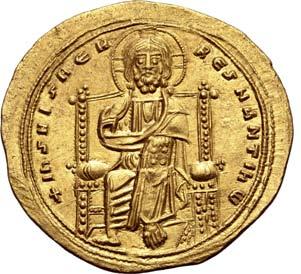
Good Extremely Fine.
738.
Isaac I Comnenus AV Histamenon Nomisma. Constantinople, AD 1057-1059. ⧾ IҺI XIC RCX RЄGNANTIҺᙏ, Christ Pantokrator enthroned facing on backless throne / ⧾ ICΛΛKIOC BRΛCIΛЄVC PƜM’, Isaac standing facing, wearing crown, scale cuirass, corselet with pteryges, and military cloak, holding sword upright and resting other hand on sheath. DOC 2; Sear 1843. 4.33g, 24mm, 6h.


Near Mint State.
600 600
276 Ex CNG 69, 2005
739.
Eudocia, with Michael VII and Constantius, AV Histamenon Nomisma. Constantinople, AD 1067. ⧾ IҺI XIC RCX RЄGNANTIҺᙏ, Christ Pantokrator enthroned facing / + MIX EVΔK KѠNS, Eudocia, holding jewelled sceptre, standing facing on footstool, flanked by her sons Michael and Constantius, each holding globus cruciger and akakia. DOC 1; Sear 1857. 4.42g, 25mm, 6h.
Near Mint State.
Ex Roma Numismatics Ltd., E-Sale 99, 7 July 2022, lot 1353.
1,200
740.
Eudocia, with Michael VII and Constantius, AV Histamenon Nomisma. Constantinople, AD 1067. ⧾ IҺI XIC RCX RЄGNANTIҺᙏ, Christ Pantokrator enthroned facing / + MIX EVΔK KѠNS, Eudocia, holding jewelled sceptre, standing facing on footstool, flanked by her sons Michael and Constantius, each holding globus cruciger and akakia. DOC 1; Sear 1857. 4.39g, 24mm, 6h.
Good Extremely Fine.
Ex Roma Numismatics Ltd., E-Sale 99, 7 July 2022, lot 1352.
741.
Alexius I Comnenus EL Histamenon Nomisma. Thessalonica, AD 1082-1087. ⧾ KE RO AΛEΞZ, facing bust of Christ Pantokrator, holding book of Gospels; IC-XC across fields / St. Demetrius standing to right, holding sword and presenting patriarchal cross set on globe on two steps to Alexius standing facing, wearing crown and loros; ΔIMTI in column to left, [ΔЄCΠITH] in column to right. DOC 5a; Sear 1905. 4.14g, 28mm, 6h.



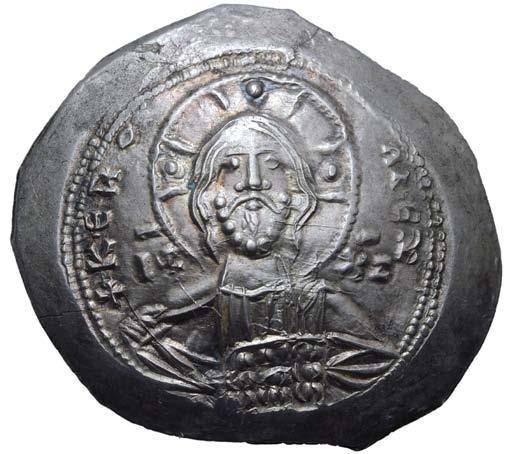

Extremely Fine; hairline flan crack at 6h.
Ex Nea Rhomē Collection, formed in the early 2000s.
Ex Gorny 1994
Isaac II Angelus EL Aspron Trachy. First reign. Constantinople, 12 September AD 1185-8 April 1195. The Virgin enthroned facing, nimbate and wearing pallium and maphorium, holding nimbate head of the infant Christ facing; MHP-ΘV across upper fields / ICAAKIOC Δ, Archangel Michael, beardless and nimbate, standing to left, crowning Isaac on left, wearing divitsion and chlamys and holding cruciform sceptre and akakia; letters in right field. DOC 2a; Sear 2002. 4.35g, 29mm, 6h.




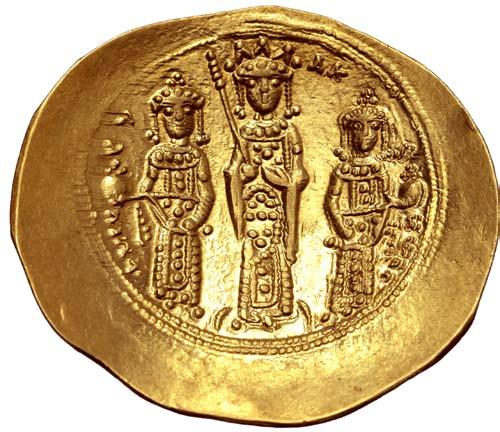


Good Extremely Fine; slight wave to flan.
Ex Gorny & Mosch Giessener Münzhandlung, Auction 69, 18 November 1994, lot 755.
277
600
450 450
742.
743.
Byzantine Empire Æ 3 Uncia Weight. Circa 5th-7th century AD. Two imperial figures with silver inlaid faces standing behind ornate balcony, all within wreath; flowers to upper left and right corners, Γ in lower left and right corners, lower left one with pellet within / Blank. Cf. Bendall, Weights 61; cf. Rochesnard p.56 for types of the same weight. 80.78g, 36mm x 36mm. Condition as
Very Rare
744.
Byzantine Empire Æ 3 Uncia Weight. Circa 5th-7th century AD. Silver inlaid cross above Γ Γ below, the first Γ with pellet within / Blank. Cf. Bendall, Weights 60-67 for types of the same weight; Rochesnard p.57. 80.52g, 34.5mm x 34.5mm. Condition
Unpublished and The Only Known Zemarchus’ Weight of This Unit
Byzantine Empire Æ 6 Nomismata Weight. Issued by Zemarchus, Eparch of Constantinople, before AD 562. ⧾ ЄΠΙΖΙИ(sic)ノΤΟVЄΝΔΟΞノ

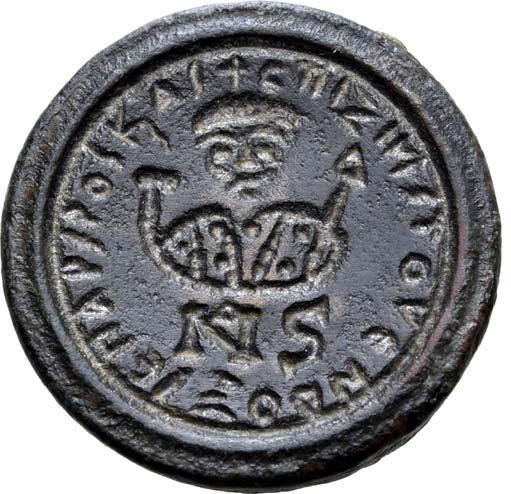







ノΡΟ(sic)ノϏΑ, bust of Zemarchus in consular robes, holding mappa with right hand and sceptre (or spear) in left; NoS below; all within linear border / Plain except for a raised boss; all within incuse circle. Translation: In the time of Zemarchus, gloriossus, Eparch of (new) Rome and East(?). Bendall –(for different weights of Zemarchus, see pp. 46-49); Pondera Online -. 26.32g, 27mm.
Condition as seen.
Flavius Zemarchus was Eparch of Constantinople on two occasions. His second period as Eparch can hardly have lasted longer than a few months since his predecessor Addaeus was in office in January 565 while Justinian replaces Zemarchus with Julianus before he died in November of the same year. We do not know exactly when or for how long Zemarchus held the post of Eparch on the first occasion, but it is possible the weight here was issued then rather than in his second tenure of office.
278
Ex Rubellite Collection.
seen. Very Rare.
2,400
as seen. Very Rare. Ex Rubellite Collection.
450
ЄΠΑΡ
745. 1,200
An Impressive Seal of The Ekdikoi of the Hagia Sophia
Byzantine Iconographic PB Seal of the Ekdikoi of the Hagia Sophia. 11th - 12th centuries AD. [✠ VΠЄΡΑΓΙ]Α ΘЄΟΤΟ⫶ΚЄ RΟΗΘЄΙ, The Mother of God, on the left, nimbate, and the emperor Justinian I, on the right, nimbate, standing facing, holding model of the domed Church of Hagia Sophia; Η Α Γ Ι Α Σ Ο Φ Ι Α vertical inscription above and beneath the edifice; all within dotted border / ✠ ΤΟΙCΘЄ ΟCЄRЄCΤΑ ΤΟΙCΠΡЄC RVΤЄΡΟΙC

in six lines, ornament above and below; all within border of dots. Translation: Most holy Mother of God, help the most reverent priests and judges of Hagia Sophia. Cf. DOCBS V 542.12 (arrangement of obverse legend); cf. BLS II 65 (same); J. Cotsonis “The Virgin and Justinian on Seals of the ‘Ekklesiekdikoi’ of Hagia Sophia.” in Dumbarton Oaks Papers 56 (2002), cf. fig. 1; Lanz 162, 440 (same dies). 137.38g, 63mm, 11h.
Condition as seen.
The most immediately striking aspect of this remarkable seal is its considerable size. In relative terms, the diameter of this example is anywhere between twice and five times as large as the average seal (J. Cotsonis, ‘The Virgin and Justinian on Seals of the Ekklesiekdikoi of Hagia Sophia’ in DOP 56, 2002, p. 42). It belonged to the ekdikoi of the Great Church of Hagia Sophia in Constantinople, the most important ecclesiastical building of the Byzantine Empire, built by Justinian I in the 6th century. The seal depicts the standing figures of the Virgin and Justinian who together support a model of a church, identified as Hagia Sophia by the inscription beneath it (ΗΑΓΙΑ ΣΟΦΙΑ).


The ekdikoi were a group of clerics who formed a tribunal which was instituted by Justinian and assigned to Hagia Sophia. One of the most important responsibilities of the ekdikoi was defending those accused of committing offences and granting the right of asylum in the church (Ibid., p. 47). The legislation stating who could be granted the privilege of asylum was sometimes restrictive during the 10th century, denying protection to those who were deemed to have committed the most serious offences. By the end of the century however even the right of asylum for murderers was affirmed.
The tribunals which took place in the Hagia Sophia would have heard a confession from the accused before judging the individual’s guilt or innocence. The decision of the ekdikoi and the assigned penances were given to the penitent in written form, a semeioma, which also helped ensure their safety against any pursuers. It has been suggested these seals may have been attached to such documents, with their large size allowing for easy recognition of the penitents’ immunity from retribution (ibid., p. 51).
The obverse inscription is an invocation, continuing on the reverse, which calls upon the Virgin for her assistance on behalf the ekdikoi in carrying out their responsibilities (Most holy Mother of God, help the most reverent priests and judges of Hagia Sophia). This would have had a particular significance for the ekdikoi as an icon of the Virgin is known to have been situated in physical proximity to the seat of the tribunal itself which was renowned for encouraging repentance.
REPRODUCTIONS
Electrotype: Etruria, Vulci AR Didrachm. Unsigned British Museum electrotype, copying an issue of the 5th-4th centuries BC. Winged Metus running to left, head facing, holding serpent in each hand / Cartwheel with long crossbar supported by two struts; Etruscan legend ‘θe-zi’ above and below strut. BMC Italy 1 = Head, Guide Period II.C 1 (same dies). 16.00g, 26mm, 9h. Condition as seen.
Ex Roma Numismatics Ltd., E-Sale 75, 15 October 2020, lot 1058; Previously acquired from Dix Noonan Webb.

279
[C]ЄΚΔΙΚς
ΚΑΙЄΚΚΛΗ
746.
2,400
150
747.
ABBASIDS
COINS OF THE ISLAMIC WORLD












748.
Abbasids, time of al-Rashid AV Dinar. Unnamed mint in Misr (Cairo), AH 192 = AD 808. Kalima in three lines, Quran IX, 33 around / Continuation of kalima in three lines; “li’l-khalifa” below, mint and date formula around. Album 218.13; Bernardi 73. 4.23g, 19mm, 12h.
Extremely Fine.
Ex GK Collection;
Ex Morton & Eden, Auction 103, 24 October 2019, lot 187.
Abbasids, al-Mu’tadid billah AV Dinar. Harran mint, AH 285 = AD 898. Kalima in three lines; mint and date formula in inner margin, Quran XXX, 3-4 in outer margin / Continuation of kalima in three lines; “al-Mu’tadid” below, Quran IX, 33 around. Album 241; Bernardi 211Hj. 3.77g, 24mm, 6h.
Near Mint State. Rare.
Ex GK Collection;
Ex Morton & Eden, Auction 103, 24 October 2019, lot 32 (hammer: GBP 1,200).
The obverse margin of this coin has a minor engraving error, and reads thaman (eight) instead of thamanin (eighty).
Abbasids, al-Muktafi AV Dinar. Harran mint, AH 290 = AD 902. Kalima in three lines; mint and date formula in inner margin, Quran XXX, 4-5 in outer margin / Continuation of Kalima in three lines; “al-Muktafi billah” below, Quran IX, 33 around. Album 243.1; Bernardi 226Hj. 3.69g, 26mm, 6h.
Extremely Fine. Very Rare.
Ex GK Collection;
Ex Morton & Eden, Auction 103, 24 October 2019, lot 41 (hammer: GBP 1,400).
Abbasids, al-Radi AV Dinar. Filastin mint, AH 323 = AD 934. Kalima in three lines; mint and date formula in inner margin, Quran XXX, 4-5 in outer margin / Continuation of kalima in three lines, “al-Radi billah” below; Quran IX, 33 in outer margin. Album 254.1; Bernardi 285Gn. 3.41g, 25mm, 11h.
Good Very Fine; some areas of weakness. Rare.
From the GK Collection; Ex Morton & Eden, Auction 103, 24 October 2019, lot 48 (hammer: GBP 1,000)
280
180
450
749.
750.
450 480
751.
Abbasids of Seville, Spanish Muluk al-Tawa’if. Muhammad al-Mu’tamid AV Dinar. Qurtuba mint, AH 471 = AD 1078. Kalima in three lines; mint and date formula around, letter ‘ayn below / Citing the Imam ‘Abd Allah as “amir al-mu’minin”, in three lines, “al-Mu’tamid ‘ala Allah” above. Album 403; Prieto 412b; Vives 973. 3.99g, 26mm, 12h.











Good Very Fine. Extremely Rare.
Ex GK Collection; Ex Áureo & Calicó, Auction 324, 24 January 2019, lot 59 (hammer: EUR 3,000).
ALMORAVIDS
Almoravids, ‘Ali b. Yusuf, with his heir Sir b. ‘Alì AV Dinar. Nul Lamta mint, AH 524 = AD 1129. Kalima, “Commander of the Muslims ‘Ali bin Yusuf and his heir the prince Tashfin” in five lines; Quran III, 85 around / “The Imam Abd Allah Commander of the faithful” in four lines; mint and date formula around. CMA (Eustache) 275; Hazard 333; Vives -. 4.15g, 25mm, 3h.

Extremely Fine. Very Rare.
Ex GK Collection; Ex Áureo & Calicó, Auction 311, 31 May 2018, lot 108 (hammer: GBP 1,050).
Almoravids, ‘Ali b. Yusuf, with his heir Sir b. ‘Ali AV Dinar. Madinat Fas mint, AH 536 = AD 1141. Kalima, “Commander of the Muslims ‘Ali bin Yusuf and his heir the prince Sir” in five lines; Quran III, 85 around / “The Imam Abd Allah Commander of the faithful” in four lines; mint and date formula around. CMA (Eustache) 231; Hazard -; Vives -. 4.13g, 27mm, 9h.
Good Very Fine. Very Rare.
Ex GK Collection; Ex Jesus Vico S.A., Auction 149, 16 November 2017, lot 609 (hammer: GBP 900).
AYYUBIDS
755. 180
Ayyubids, Al-Kamil Muhammad I AV Dinar. Al-Qahira mint, AH 615-635 = AD 1218-1238. Mint and [date] formula in outer margin; citing the Abbasid caliph al-Mustansir billah in four lines across field / Name and titles in four lines across field; Qur ’an IX, 33 around. Album 811.1; cf. Balog 370. 4.53g, 22mm, 3h.
Extremely Fine; lightly clipped.
Ex Roma Numismatics Ltd., Auction XXIV, 28 March 2022, lot 1212.
281
752.
900
753. 450
754. 450
BURIDS
Burids, Atabegs of Damascus. Abaq AV 1/4 Dinar. Dimashq mint, AH 534-549 = AD 1140-1154. Citing the caliph “Imam al-Muqtafi” in two lines; kalima around / ‘al ghaya in two lines; citing the Great Seljuk ruler Sanjar; mint formula in outer margin. Album N784; SICA -. 1.12g, 14mm, 6h.
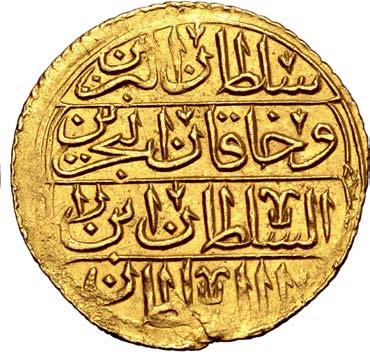
Good Very Fine. Extremely Rare.
Ex GK Collection;
Ex Morton & Eden, Auction 103, 24 October 2019, lot 76; Ex Stephen Album Rare Coins - Wilkes & Curtis Ltd, Horizon Auction I, 2 October 2016, lot 409.
M ANGHIT OF B UKHARA
Manghit of Bukhara, ‘Abd al-Ahad AV Tilla. Bukhara-yi Sharif mint, AH 1327 = AD 1898. Couplet in four lines on floral background; date in field / Mint name in three lines on floral background; date in field. Album 3038. 4.55g, 22mm, 6h.
Fine; superb condition for the type.
GK Collection;
Auctiones GmbH, eAuction 67, 15 March 2020, lot 133.
O TTOMAN E MPIRE
Ottoman Empire, Mahmud I AV Zeri Mahbub. Misr mint, AH 1143 = AD 1730. Toughra; lotus to right, mint and date below / Name and titles in four lines. KM 86; Pere 561. 2.56g, 20mm, 12h.




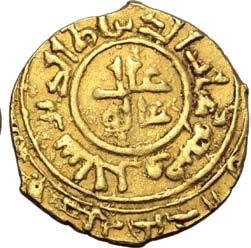


Good Extremely Fine; traces of mounting. Ex GK Collection; Ex Auctiones GmbH, eAuction 61, 16 September 2018, lot 391.
Q A j ARS
Of the Greatest Rarity
Qajars, Nasir al-Din Shah Medallic AV 10 Toman. Celebrating the 50th anniversary of Nasir’s reign. Tehran mint, dated AH 1313 = AD 1896. Uniformed bust facing slightly to left / Mint name, ruler, date and denomination in four lines within floral border. KM X14; Friedberg 59. 28.79g, 36mm, 12h.




Good Extremely Fine; considerable original mint lustre, a magnificent piece. Extremely Rare.
From the GK Collection;
Ex Numismatica Genevensis SA, Auction 12, 18 November 2019, lot 769.
Struck to commemorate the 50th anniversary of his reign, this issue was recalled after his assassination on 1 May 1896 whilst visiting and praying in the Shah Abdol-Azim Shrine.
282
757. 180
Extremely
Ex
Ex
758. 120
759. 4,800
300
756.
Seljuqs of Rum, the Three Brothers, Kayka’us II, Qilij Arslan II and Ali al-din Kaykubad II AV Dinar. Qunya mint, dated AH 648 = AD 1250. Kalima, citing the Abbasid caliph al-Mustansir billah as “amir al-mu’minin”, mint and date in five lines / Name and titles in five lines. Album A1227; ICV 1348; cf. Roma E-74, 1502 (same dies). 4.94g, 25mm, 1h. Mint State.


760. 450
Ex GK Collection; Ex Numismatik Naumann, Auction 56, 6 August 2017, lot 860.
U MAYYADS
761.
Umayyads, time of al-Walid I or Suleyman AV 1/2 Dinar or Semissis. Arab-Byzantine type. Uncertain North African mint, struck circa AH 95-98 = AD 713-717. NN ЄƧ σƧ NIƧV σƧCVI N Ƨ A, blundered form of “non est Deus nisi unus Deus cui non Socius Alius”; cippus with globe on three steps / [...]





762.
Ƨ
σƧ NIƧVNƧ CV (NN) [...] around ƧIMIΛIƧ, blundered form of “non est Deus nisi unus cui non est alius, similis”. Album 120.1; Bernardi 24; Walker p.64, 168. 1.92g, 11mm, 7h.
Extremely Fine; rev. legend blundered and partially off flan. Rare.
Ex Roma Numismatics Ltd., Auction XXII, 8 October 2021, lot 975.
1,440
This is one of the earliest coins struck in North Africa after the Arab conquest, and possibly derives from the Byzantine coins struck at Carthage. Recent studies have suggested that they were minted at Qayrawan, the capital of the newly conquered province, between AH 85 and 95.

Very Rare
Umayyads, time of Umar II AV Dinar. Ifriqiya mint, dated AH 101 = AD 719. Kalima in three lines; Quran IX, 33 around / “In the name of Allah, the Merciful, the Compassionate” in three lines; mint and date formula around. Album 134A; Bernardi 44Ca. 4.28g, 16mm, 6h
Extremely Fine. Very Rare.
4,500
The second earliest Umayyad post-reform dinar struck at Ifriqiya during the short reign of Caliph Umar II (AH 99-101) and an attractive example of the smaller diameter planchets used by the mint in AH 101.



283 S EL j UQS OF R UM
MEDIEVAL AND WORLD COINS
Austria, Holy Roman Empire. Rudolf II AR Taler. Ensisheim mint, 1609. ✠ RVDOLPHVS • II • D • G • RO • IM • SE • AV • GER • HVN • BOH • REX, laureate and draped bust to right, lion’s head broach on shoulder; date before / NEC NON • ARCHIDVCES • AVS • DV • BV • LAN • G • AL • CO • FE, crowned coat-of-arms within ornate border. KM 246.3; Davenport 3034; Klemesch 132; Numista 140274.
NGC graded UNC Details, obv. scratched (#6674260-001).
Acquired from Leu Numismatik AG; Ex collection of Dr. Max Blaschegg (1930-2021), acquired from Hess on 25 January 1991. It can be seen from the date on the obv. of this coin that the die was recut from that used for the previous year.
1,800
Austria, Holy Roman Empire. Leopold V AR 2 Taler. Hall mint, after 1626. Commemorating his marriage to Claudia de Medici. LEOPOLDVS • ARCHID • AVS ⠘ ET • CLAVDIA • ARCHIDVCISA • AVS ⠘ MEDIC ⬩, conjoined crowned and draped busts of Archduke Leopold and Claudia de Medici to right / DVX ⬩ BVRGVNDIÆ ⬩ COMES ⬩ TIROLIS ⠘, crowned eagle of Tyrol facing, wings spread, head to left, wreath above. KM 639; Davenport 3331; Numista 33503.
NGC graded MS 61 (#6674259-002).
Acquired from Leu Numismatik AG; Ex collection of Dr. Max Blaschegg (1930-2021), acquired from C. Freytag in December 1944.
1,200
Austria, Holy Roman Empire. Joseph I AR Taler. Vienna mint, 1706. IOSEPHUS • D ⦂


RO
IMP ⦂
⦂
⦂ REX, draped and armoured bust to right; mintmark in drapery / ARCHIDVX • AVSTRIÆ • DVX • BVR ⠘ COM ⠘ TYROL • (date), crowned double-headed imperial eagle with coat-of-arms of Austria on breast, holding sword and sceptre. KM 1444; Davenport 1013; Numista 95293.


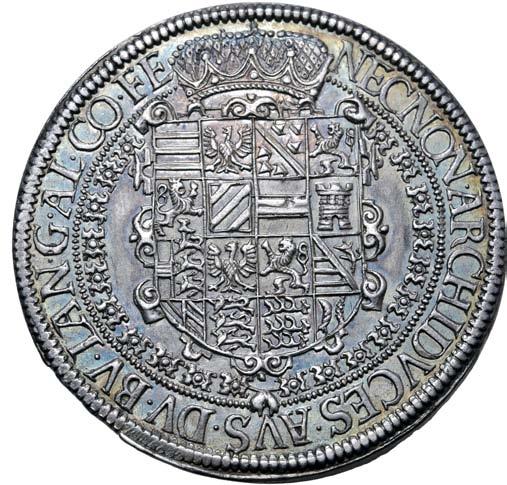
NGC graded AU 58 (#6674259-001).
Acquired from Leu Numismatik AG; Ex collection of Dr. Max Blaschegg (1930-2021), privately acquired from Krüger in October 1950.
284
763.
AUSTRIA
764.
•
•
S
A
•
G
⦂
⦂ GER
HV
BO
765. 750
Austria, Hapsburg Empire. Franz II AR Kronentaler. Milan mint, 1793. FRANCISC • II
D
G
R
I
S
A
GER
HIE • HVN • BOH • REX •, laureate head to right; mintmark below / ARCH • AVST • DVX • BVRG • LOTH • BRAB • COM • FLAN • (date) •, Burgundian cross with firesteel; three crowns around, Order of the Golden Fleece below. Edge inscription: LEGE ET FIDE. Herinek 488; Davenport 1390; J. 134b; CNI 8; MIR 472/2. 29.50g, 41mm, 12h.

Good Extremely Fine; attractive light cabinet tone.
Ex Gorny & Mosch Giessener Münzhandlung, Auction 269, 9 March 2020, lot 1507.
C OLOMBIA
Colombia, Republic of Nueva Granada AV 16 Pesos. Popayan mint, 1846. Assayer UE. REPUBLICA DE LA NUEVA GRANADA., draped bust of Liberty to left, wearing diadem inscribed LIBERTAD; date below / DIEZ I SEIS PESOS. POPAYAN.U.E., coat-of-arms; rosette below. KM 94.2; Friedberg 75. 26.93g, 35mm, 6h.

Near Extremely Fine; scattered marks. Very Rare.
Ex GK Collection; Ex Roma Numismatics Ltd., Auction XX, 30 October 2020, lot 825.


D ENMARK
Pedigreed to 1987
Denmark, Kingdom. Frederik III AV 1/2 Ducat. Copenhagen mint, 1659. Heinrich Köhler, mintmaster; dies by Matthias Först and Johann Blum. FRIDERICVS • III • D • G • DAN • NOR ∗, crowned and draped bust to right / VANDALOR • GOTHOR • REX • , crowned cruciform double F monogram, 3 at centre; date and mintmark above to left. Aagaard 23; Friedberg 102; Hede 15A; Schou 11; Sieg 106.1. 1.75g, 18mm, 4h.
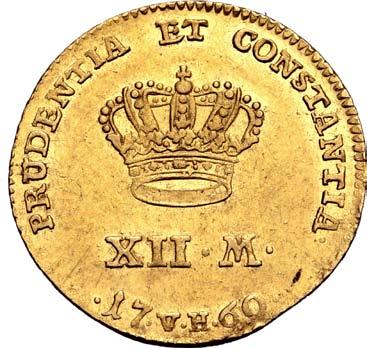
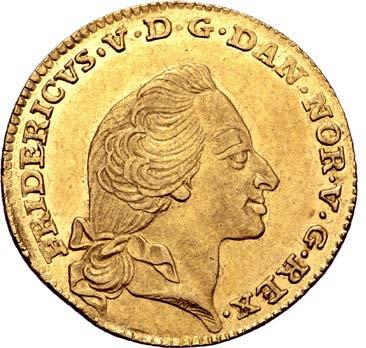


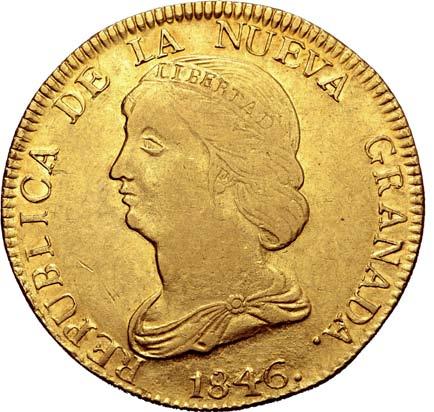

Extremely Fine.
Ex GK Collection;
Ex Fritz Rudolf Künker GmbH & Co. KG, Auction 291, 15 March 2017, lot 4133 (hammer: EUR 2,200);
Ex Poul Henning Knudsen VII Collection, Bruun Rasmussen, Auction 820, 13 May 2011, lot 104; Ex Bruun Rasmussen, Auction 493, 17 March 1987, lot 2034.
1,200
Denmark, Kingdom. Frederik V AV 12 Marks. Copenhagen mint, 1760. Peter Nicolai van Hauen, mintmaster; dies by Johann Henrik Wolff. FRIDERICVS • V
D • G • DAN • NOR • V • G • REX •, head to right / PRUDENTIA ET CONSTANTIA, crown over denomination; date flanking initials VH below. Friedberg 269; Hede 22 C; Schou 1; Sieg 21.3; KM 587. 3.08g, 20mm, 12h.
Near Mint State. Scarce.
Ex GK Collection; Ex WAG Online oHG, Auction 73, 12 March 2017, lot 98.
285
•
•
•
•
•
•
•
•
270
766.
767. 750
768.
•
769. 300
FINLAND
770.
Finland, Grand Duchy. Alexander II AR 2 Markkaa. Helsingfors mint, overdate issue of 1866/5. 47.24 KAPPALETTA NAULASTA SELWÄÄ




HOPEATA., crowned double-headed eagle facing with wings spread, with crowned shield-of-arms on breast, holding sceptre and orb; crown with ribbons above, S to lower right / Denomination over date; wreath around. Bitkin -, cf. 617 & 618 (overdate not noted); KM 7. 10.36g, 28mm, 12h.



NGC graded MS 62 Prooflike (#6673170-010). Highly reflective mirrored fields. Very Rare overdate issue.
As is evidenced on the coin, the reverse die used to strike this piece was altered to read 1866 having already been used to strike the issues of 1865.
FRANCE
Excessively Rare 1579 Half Pistole

771.
France, Provincial. Dombes (Principality). Louis II de Bourbon-Montpensier AV 1/2 Pistole. Trévoux mint, 1579 (die re-engraved from 1578). ✠ LVDO • P • DOMBARVM • D • MONTIS, crowned coat-of-arms / ✠ D N • ADIVT • ET REDEM • MEVS • (date) •, floriated cross. Divo -, cf. 28a29; Friedberg -, cf. 122. 3.34g, 21mm, 10h.

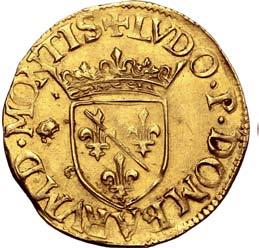
Good Extremely Fine. Excessively Rare, Divo recorded only two examples known for 1579.
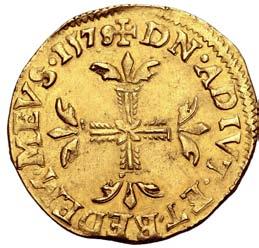
Ex GK Collection;
Ex Maison Palombo, Auction 5, 7 June 2008, lot 151 (hammer: EUR 3,200).
1,200
772.
France, Provincial. Metz (Free Imperial City) AV Florin. Anonymous issue, circa 14th-17th centuries. S • STEPHA • PROTHOM, St. Stephen standing to left, holding palm frond / ❀ FLORENVS • CIVITIS • METENSIS, coat-of-arms within polylobe with inward-facing lis. Friedberg 164. 3.19g, 23mm, 9h.
Very Fine.
Ex GK Collection;
286
Ex Numismatik Naumann, Auction 86, 20 February 2020, lot 813. 180
450
Rare Overdate Issue

Mint State. Very Rare; the finest example to be offered at auction in over two decades, and considerably superior to the example sold at MDC sarl in June 2021 (Auction 7, lot 214, EUR 32,000).
Acquired from Burgan Numismatique.
The reign of Philippe IV of France was marred by several expensive wars, which caused significant financial difficulty for the monarch, characterised by rising deficits, debasement of the currency and emergency taxation. This petit royal d’or, however, struck only five years after he ascended to the French throne, predates most of these wars and, as such, also predates the subsequent devaluation of the currency, hence its composition of pure gold. Indeed, it was created to directly match the size, weight and purity of the Florentine gold florin, which had by then become the de facto currency of international commerce.
The circumstances of Philippe’s ascension to the throne had initially seemed auspicious; through his marriage to Joan I of Navarre in 1284 he had also become king of Navarre and had annexed her inherited lands of Champagne and Brie. Primarily as a result of the trade fairs known as the ‘Champagne Fairs’, which were centres of European mercantile exchange at the time, Champagne was a particularly wealthy province and was therefore a significant financial asset for Philippe, boosting the income of the royal demesne when he became king. Although not financially profitable, the Kingdom of Navarre was also a worthwhile territory to have gained through his marriage, as it was strategically important both geographically and politically. This advantageous political landscape may go some way to explain how Philippe was able to produce gold denominations en masse for the first time in the history of the coinage of the Kingdom of France (gold coins only having been previously minted in very small numbers by Louis IX), of which this coin is an exceptional example.
Due to the increased revenues, Philippe was able to pay off debt that he had inherited from his father ’s wars with Aragon and by 1287 the crown was completely solvent. His good fortune was however not to last and in 1294, after a series of failed negotiations and broken treaties surrounding the English King Edward I’s French lands, war became inevitable and this was ultimately to be the longest ongoing conflict of Philippe’s rule. The costly campaigns against England were compounded by ongoing hostilities with Aragon and Flanders, which declared its independence in 1297. The financial buffer that Philippe had built-up was rapidly depleted and the remainder of his rule was dominated by a constant need to raise funds. All the promise of a fruitful reign embodied in this coin as part of the first significant diffusion of gold coins into the French economy was ultimately undermined by the persistent wars that dominated this period of European history.

France, Kingdom. Charles IV le Bel (the Fair) AV Royal d’or. Paris mint, struck from 16 February 1326. ◦ KOL ◦ RЄX ◦ ◦ FRA’ ◦ COR’ ◦, Charles standing facing within Gothic archway, holding lis-tipped sceptre in right hand and pointing to it with left / ✠ XP’C ◦ VIꞂCIT ◦ XP’C ◦ RЄGИAT ◦ XP’C ◦ IMPЄRAT, cross quadrilobée, feuillue, and fleurdelisée, pellet in quadrilobe at centre; all within quadrilobe with each arc ending in trefoil, crown in each spandrel. Cf. Grierson, Coins of Medieval Europe 331 (for type); Duplessy 240; Ciani 252; Friedberg 261. 4.15g, 26mm, 9h.





Near Mint State; in outstanding condition for the type.
Ex Long Valley River Collection, Roma Numismatics Ltd., Auction XX, 30 October 2020, lot 849; Ex Richard A. Jourdan Collection, Classical Numismatic Group, Triton XXIII, 14 January 2020, lot 1059 (hammer: USD 6,000); Ex Classical Numismatic Group, Triton XVII, 7 January 2014, lot 996.

288 A Perfect Example
France, Kingdom. Philippe IV le Bel (the Fair) AV Petit royal d’or. Struck from Autumn 1290. PҺILIPPVS DЄI GRACIA, Philippe seated facing on lion head throne, holding lis-tipped sceptre in right hand and lis in left / ✠ FRACORVᙏ RЄX, cross feuillue and fleuronnée; lis in each quarter. Duplessy 207; Ciani 193; Lafaurie 211; Friedberg 255. 3.52g, 21mm, 6h.
773. 15,000
774. 2,400


289
A Spectacular Example
VIȠCIT
XP’C ⁝ RЄGИAT ⁝ XP’C ⁝ IMPЄRAT, cross quadrilobée, feuillue, and fleurdelisée, pellet in quadrilobe at centre; all within quadrilobe with each arc ending in trefoil, crown in each spandrel. Duplessy 248; Ciani 268; Lafaurie 252; Friedberg 264. 7.00g, 31mm, 3h.
Near Mint State. Rare.
Acquired from Burgan Numismatique.



12,000

290
France, Kingdom. Philippe VI de Valois AV Parisis d’or. Struck from 6 September 1329. ✠ PhILLIPPVS ⁑ DЄI ⫶ GRA ⫶ FRAИCORVM ⫶ RЄX, Philippe seated facing on Gothic throne with baldaquin, holding lis-tipped sceptre in right hand and Main de Justice in left; lions at feet / ✠ XP’C ⁝
⁝
775.
France, Kingdom. Philippe VI de Valois AV Écu d’or à la chaise. First emission, struck from 1 January 1337. ✠ PҺILIPPVS ⁑ DЄI ˣ ˣ GRA ˣ
FRAꞂCORVM ⁑ RЄX, Philippe seated facing on Gothic throne, holding sword, left hand resting on coat-of-arms to right; all within tressure of arches with trefoil in each spandrel, and four saltires below foot of throne / ✠ ◦ XP’C ⦂ VIꞂCIT ⦂ XP’C ⦂ RЄGИAT ⦂ XP’C ⦂ IИPЄRAT, cross quadrilobée, feuillue, and fleurdelisée, pellet in quadrilobe at centre; all within quadrilobe with each arc ending in trefoil, crown in each spandrel. Duplessy 249; Ciani 282; Lafaurie 262; Friedberg 270. 4.47g, 30mm, 3h.
Fleur De Coin; in magnificent condition for the issue.
Acquired from Fritz Rudolf Künker GmbH & Co.
3,000
France, Kingdom. Philippe VI de Valois AV Écu d’or à la chaise. First emission, struck from 1 January 1337. ✠ PHILIPPVS ⁑ DЄI ˣ ˣ GRA ˣ

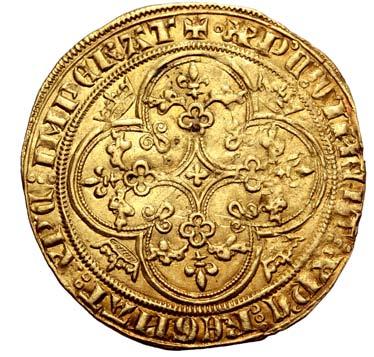


FRAꞂCORVM ⁑ RЄX, Philippe seated facing on Gothic throne, holding sword, left hand resting on coat-of-arms to right; all within tressure of arches / ✠ ◦ XP’C ◦ VIꞂCIT : XP’C : RЄGNAT : XP’C : INPЄRAT, cross quadrilobée, feuillue, and fleurdelisée, pellet in quadrilobe at centre; all within quadrilobe with each arc ending in trefoil, crown in each spandrel. Duplessy 249; Ciani 282; Friedberg 270. 4.51g, 29mm, 7h. Mint State; in superb condition for the issue.
1,500
Ex Long Valley River Collection, Roma Numismatics Ltd., Auction XX, 29 October 2020, lot 835; Acquired from Jean Vinchon Numismatique & Phidias.
France, Kingdom. Philippe VI de Valois AV Pavillon d’or. Struck from 8 June 1339. ⚜ PҺILIPPVS ⁝ DEI GRA ⁝ FRANCҺORVM ⁝ REX, Philippe, holding lis-tipped sceptre, seated facing on throne decorated with lions; all within draped pavilion decorated with lis / ✠ ◦ XP’C ⁝ VIИCIT ⁝ XP’C ⁝
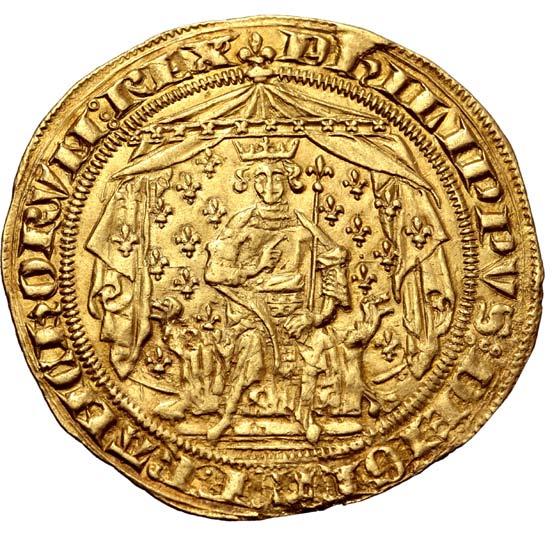





RЄGИAT ⁝ XP’C ⁝ IMPЄRAT, cross quadrilobée, feuillue, and fleurdelisée, pellet in quadrilobe at centre; all within quadrilobe with each arc ending in trefoil, crown in each spandrel. Duplessy 251; Ciani 270; Friedberg 266. 4.97g, 30mm, 4h.
Good Extremely Fine.
Ex GK Collection; Ex MDC Monnaies de Collection sarl, Auction 5, 14 November 2019, lot 234.
3,900
291
776.
777.
778.
Fleur De Coin
The Finest Example in Over 20 Years
France, Kingdom. Philippe VI de Valois AV Ange d’or. Third emission, struck from 26 June 1342. PHILIPPVS ⁑ D GRA ⁑ FRAC ⁑ RЄX, Archangel Michael standing facing beneath baldaquin, holding long cross resting on head of defeated dragon and resting on coat-of-arms / ✠ XPC ⁑ VINCIT ⁑ XPC ⁑ REGИAT ⁑ XPC ⁑ IMPERAT, cross quadrilobée, feuillue, and fleurdelisée, pellet in quadrilobe at centre; all within quadrilobe with each arc ending in trefoil, crown in each spandrel. Duplessy 255B; Ciani -; Lafaurie 258b; Friedberg 273. 5.48g, 32mm, 5h.

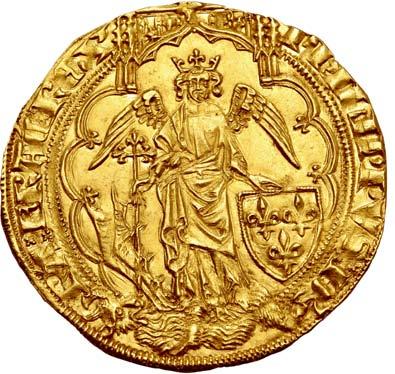
Mint State; a magnificent example of this prestigious type. Rare, and the finest example to be offered at auction in over twenty years.
Ex Burgan Numismatique/Maison Florange, 12 November 2021, lot 27; Privately purchased from Jean Vinchon Numismatique on the 18 December 2000.
Philippe VI’s position as king of France was precarious from the very beginning of his reign in 1328, and indeed his succession was by no means guaranteed. After Charles IV died without a son, debate raged amongst the French prelates and barons as to who was his legal heir. The two claimants were Philippe de Valois and Edward III of England; while Edward had the closer familial relation to the deceased king as his nephew by Charles’s sister Isabella, it was determined that his claim should be disregarded due to its being transmitted through a female line. Thus Philippe, a grandson of Philippe III, was appointed king and was immediately eager to emphasise the legitimacy of his accession against that of his rival, an endeavour that would occupy him for the entirety of his reign.
As had been the case with their predecessors, relations between the French and English kings deteriorated as a result of seemingly superficial slights that masked the more profound, existential questions of who had the greater claim to the French throne. By virtue of his duchies of Aquitaine and Gascony, Edward III was officially a vassal to any king of France and, as such, due to pay homage, but this was an unstable hierarchy. Summons to attend the French court shortly after Philippe assumed power were greeted with disdain by Edward, who, when he did arrive at the cathedral of Amiens in 1329, was not sufficiently deferential as far as Philippe perceived. The offence caused during this interaction set the precedent for the tone of their relationship henceforth and their disputes regarding the duchy of Aquitaine would eventually worsen to the point of war being declared in 1337, when Edward declared himself the rightful king of France.
By 1342, the year in which this coin was struck, there had been no lessening of hostilities, indeed two years prior the French, having enjoyed initial success on the battlefield, suffered their first significant defeat at the naval battle of Sluys, which exacerbated Philippe’s anxiety about his hold on power. The explicit religious and regal imagery on Philip’s coinage, as exemplified in the present coin, should be seen as a direct attempt to convey both his divine and legal right to his throne within the context of repeated challenges to his legitimacy


292
779.
18,000


293
780. 2,700
781.
France, Kingdom. Philippe VI de Valois AV Chaise d’or. Struck from 17 July 1346. ✠ PҺILIPPVS ⁑ DЄI ⁑ GRACIA ⁑ FRAꞂCORVM ⁑ RЄX, Philippe seated facing on Gothic throne, lis-tipped sceptre in right hand and Main de Justice in left; all within tressure of arches with trefoil in each spandrel, and four saltires below foot of throne / ✠ ⁝ XP’C ⁝ VIИCIT ⁝ XP’C ⁝ RЄGИAT ⁝ XP’C ⁝ IMPЄRAT, cross feuillue and fleurdelisée; all within quadrilobe with inward-facing lis in each angle, crown in each spandrel. Duplessy 258; Ciani 290; Lafaurie -; Friedberg 269. 4.72g, 29mm, 9h. Mint State.
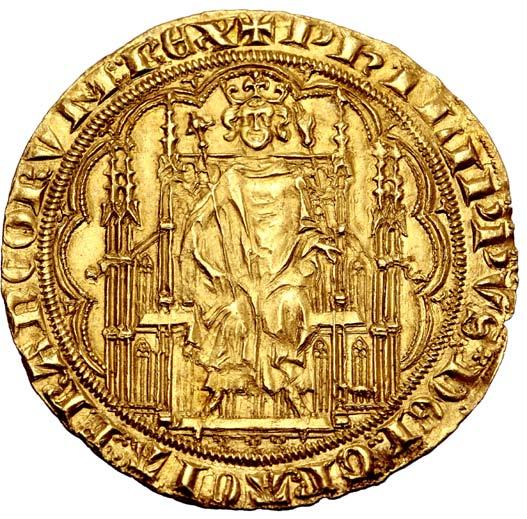





Ex Fritz Rudolf Künker GmbH & Co. KG, Auction 352, 25 September 2021, lot 1178; Privately purchased in the early 1930s from Julius Jenke, Munich.
782.
France, Kingdom. Charles V le Sage (the Wise) AV Franc à pied. Paris mint, struck from 20 April 1365. KAROLV ˣ DI ˣ GR FRAИCORV ˣ RX, king standing facing within Gothic arch, holding sword with annulet pommel and Main de Justice; semé of seven lis to left and right / ✠ XPC ∗ VIѠCIT ∗ XPC ∗ RЄGNAT ∗ XPC ∗ IMPЄRAT, cross tréflée, pellet within angled quadrilobe at centre, cantoned with lis in first and fourth quarters, crown in second and third; all within angled quadrilobe, lis in spandrels. Duplessy 360; Ciani 457; Friedberg 284. 3.80g, 28mm, 3h.

Near Mint State; fine style.
Acquired from Classical Numismatic Group.
2,700
783.
France, Kingdom. Provence (County). Louis I d’Anjou AV Franc à pied. Avignon mint, 1381-1384. KALABRI • AꞂD LVDOVICS • DVX, Louis standing facing within Gothic arch, holding sword with annulet pommel and Main de Justice; semé of seven lis to left and right / ✠ XPC ❀ VIꞂCIT ❀ XPC ❀ RЄGꞂAT ❀ XP’C ❀ INPЄRAT, cross tréflée with pellet within angled quadrilobe at centre, lis in first and third quarters, crown in second and fourth; all within angled quadrilobe, lis in spandrels. Duplessy 1690; Poey d’Avant 4047; Friedberg 215. 3.76g, 28mm, 11h.
Extremely Fine.
Ex GK Collection; Ex MDC Monnaies de Collection sarl, Auction 3, 1 December 2017, lot 1175.
France, Kingdom. Louis XI le Prudent (the Prudent) AV Écu d’or au soleil. Tours mint, struck from 2 November 1475. ♛ LVDOVICVS ⦂ DЄI ⦂ GRA ⦂ FRANCORVᙏ ⦂ RЄX ⦂ ♜, crowned coat-of-arms, sunburst above; pellet below 6th letter / ♛ XPS ⦂ VIꞂCIT ⦂ XPS ⦂ RЄGꞂAT ⦂ ЄT ⦂ IᙏPЄRAT ⦂ ♜, cross fleurdelisée with pellet in quadrilobe at centre; pellet below 6th letter. Duplessy 544; Ciani 745; Lafaurie 529; Friedberg 312. 3.46g, 26mm, 6h.




Good Extremely Fine. Very Rare.
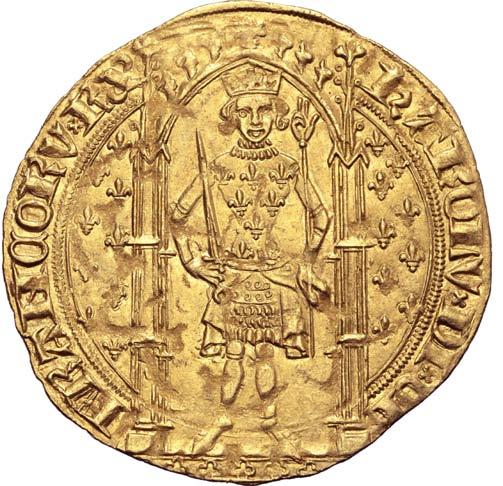
294
Ex Roma Numismatics Ltd., Auction XX, 30 October 2020, lot 854; Acquired from Jean Vinchon Numismatique & Phidias. 750 510
France, Kingdom. Charles VIII l’Affable (the Affable) AV Écu d’or au Soleil. Paris mint, struck from 11 September 1483. ⚜ KAROLVS ⦂ DEI ⦂ GRACIA ⦂ FRANCORVM ⦂ REX ⦂, crowned coat-of-arms of France, sunburst above, pellet below 18th character / ⚜ XPS ⦂ VINCIT ⦂ XPS ⦂

REGNAT ⦂ XPS ⦂ IMPERAT ⦂, cross fleurdelisée with pellet in quadrilobe at centre; pellet below 18th character. Duplessy 575; Ciani 790; Friedberg 318. 3.32g, 26mm, 12h.
Good Extremely Fine.
Ex GK Collection;
Ex MDC Monnaies de Collection sarl, Auction 3, 1 December 2017, lot 394.
France, Kingdom. François I le Restaurateur des Lettres (the Restorer of Letters) AV Écu d’or. Bayonne mint, 5th type, 3rd emission, struck from 21 July 1519. ✠ D : (anchor) : FRANCISCVS : DEI : G : FRANCORVM : REX, crowned coat-of-arms of France, sunburst above / :✠: D : (anchor) : XPS : VINCIT : XPS : REGNAT : XPS : IMPER, cross fleurdelisée with pellet in quadrilobe at centre; cantoned with F in second and fourth quarters, lis in first and third. Duplessy 775; Friedberg 345. 3.45g, 25mm, 10h.




Mint State; previously NGC graded MS 62 (#4929632-002), exceptional condition for the type.
Ex Roma Numismatics Ltd., Auction XX, 30 October 2020, lot 858; Ex New York Sale, XLIX, January 2020, lot 1066.
France, Kingdom. François I le Restaurateur des Lettres (the Restorer of Letters) AV Écu d’or. Toulouse mint, 5th type, 3rd emission, struck from 21 July 1519. ☘ FRANCISCVS : DEI : GRA : FRANCORV : REX, crowned coat-of-arms of France, sunburst above / ☘ XPS : VINCIT : XPS :

REGNAT : XPS : IMPERAT, cross fleurdelisée with pellet within quatrefoil at centre; cantoned with F in first and third quarters, lis in second and fourth. Duplessy 775; Ciani 1073-4; Friedberg 345. 3.38g, 27mm, 11h.


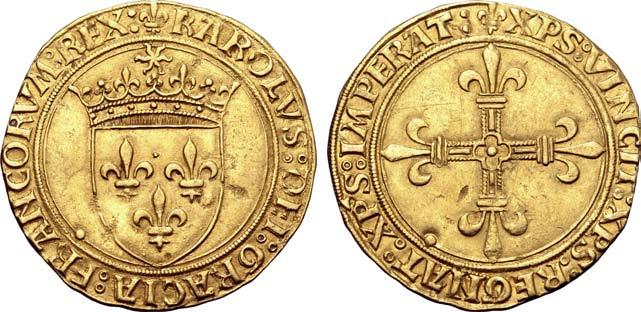
Good Extremely Fine.
Ex MDC Monnaies de Collection sarl, Auction 3, 1 December 2017, lot 398.
An Extremely Rare Grenoble Issue
France, Kingdom. François I le Restaurateur des Lettres (the Restorer of Letters) AV Écu d’or au soleil du Dauphiné. Grenoble mint, 5th type, 3rd emission, 1528. Étienne Nachon, moneyer. ✠ FRANCISCVS ◦ DEI ◦ GRA ◦ FRACORVM ◦ REX ❀ N, coat-of-arms of the Dauphin of France; sunburst above / ❀ XPS
• VINCIT
• XPS
• RENAT ◦ XPS
• INPERAT • N •, cross fleurdelisée with pellet in centre, cantoned with a dolphin and a crowned F. Duplessy 786; Friedberg 355. 3.34g, 27mm, 3h.
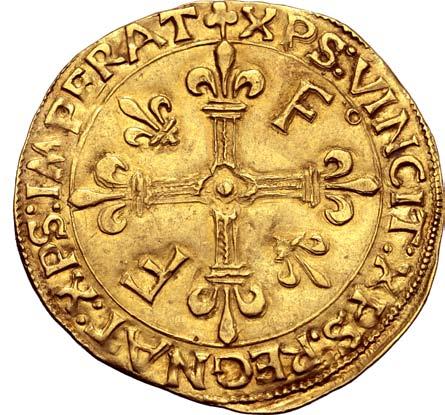


Mint State. Extremely Rare; only three other examples present on CoinArchives.
Ex Long Valley River Collection, Roma Numismatics Ltd., Auction XX, 30 October 2020, lot 859; Acquired from Jean Vinchon Numismatique & Phidias.
This type was produced only at Grenoble by moneyers Étienne Nachon and Pierre Vincent.
1,500
295
750
785.
786.
787. 600
750
784.
788.
France, Kingdom. François I le Restaurateur des Lettres (the Restorer of Letters) AV Écu d’or au soleil du Dauphiné. Crémieu mint, 4th type, 3rd emission, 1528. ♛ ⧾ FRANCISCVS : DEI : GRACIA : FRANC : REX, coat-of-arms of the Dauphin of France; sunburst above / ♛ ⧾ XPS : VINCIT :
XPS : RENAT : XPS : IMPERAT, cross fleurdelisée with pellet in quatrilobe at centre, cantoned with crowns in two quarters. Duplessy 785; Friedberg 353. 3.43g, 26mm, 9h.
Good Extremely Fine. Rare.
900
790.
France, Kingdom. François I le Restaurateur des Lettres (the Restorer of Letters) AV Écu d’or au soleil. Poitiers mint, 2nd type, struck from 14 January 1540. ❋ FRANCISCVS : DEI : GRA : FRANCORV : REX • R, crowned coat-of-arms of France; G below, pellet below 8th letter / ⧾ XPS : VINCIT : XPS : REGNAT : XPS : IMPER • R •, Greek cross within tressure of twelve arches, each ending in lis; pellet below 8th letter. Duplessy 889; Ciani 1091; Friedberg 351. 3.44g, 25mm, 3h.







Good Extremely Fine. Very Rare.
Ex GK Collection; Ex Chaponnière & Firmenich SA, Auction 11, 20 November 2019, lot 180.
France, Kingdom. Henri II AV Henri d’or. Montpellier mint, 1555. HENRICVS ⁑ II ⁑ D ⁑ G ⁑ FRAN ˣ RX c, armoured bust to right / ❋ DVM ⁑ TOTVM ⁑ COMPLEAT ⁑ ORBM ⁑, cruciform crowned H with mintmark at centre, fleur-de-lis in first and third angles, crescent in second and fourth angles; date above to left. Duplessy 972; Ciani 1244; Lafaurie 810; Friedberg 368. 3.62g, 25mm, 3h.
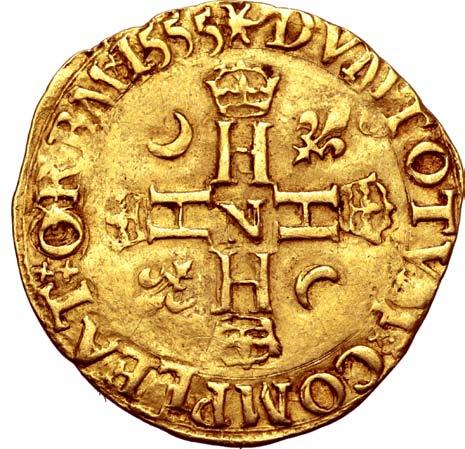
Good Very Fine. Very Rare.
Ex GK Collection; Ex MDC Monnaies de Collection sarl, Auction 3, 1 December 2017, lot 407.
2,400
France, Kingdom. Louis XIV AV Louis d’or à la mèche longue. Amiens mint, 1652. Long curl variety.

• LVD
XIIII
D
G
FR
ET
NAV
REX
bust to right; mintmark (ermine = Nicolas Cezard) above, date below / CHRS



Extremely Fine. Very Rare.
Ex GK Collection;
• REGN
• VINC
• IMP •, crowned cruciform double L monogram, with fleur-de-lis in each angle; at centre, X within annulet. Duplessy 1422; Friedberg 418; Gadoury 245. 6.72g, 25mm, 6h.
791. 750
296
789. 450
•
•
•
•
•
•
•
•,
Ex MDC Monnaies de Collection sarl, Auction 3, 1 December 2017, lot 448.
Ex Roma Numismatics Ltd., Auction XX, 30 October 2020, lot 860; Acquired from Jean Vinchon Numismatique & Phidias.
France, Kingdom. Louis XIV AV Double Louis d’or aux 8 L et aux insignes. Paris mint, 1703. LVD • XIIII • D • G FR • ET • NAV • REX (escallop), bust to right; mintmark above, date below / CHRS • • REGN • • VINC • • IMP, crowned cruciform double L monogram with A within annulet at centre, crossed lis-tipped sceptre and main de justice in angles; mintmark above. Duplessy 1442; Friedberg 43; Gadoury 261. 13.41g, 29mm, 6h.
Near Extremely Fine. Very Rare.
Ex GK Collection; Ex MDC Monnaies de Collection sarl, Auction 3, 1 December 2017, lot 442.
794.
France, Kingdom. Louis XV AV Louis d’or aux lunettes. Tours mint, 1726. LUD • XV • D • G • FR • ET • NAV • REX •, bust to left, mintmark (crescent = Léonard Rolland) below / CHRS • REGN • VINC • IMPER, crown above two coats-of-arms; mintmark E below, mintmark (★ = Martin Petit) and date above. Duplessy 1640; Friedberg 461; KM 489.7; Gadoury 340. 8.16g, 24mm, 6h.
Near Mint State.
Ex GK Collection; Ex Tauler & Fau, Auction 29, 9 April 2019, lot 7873.
France, Kingdom. Louis XV AV Double Louis d’or au bandeau. Strasbourg mint, struck 1759. LUD • XV • D • G • FR • ET NAV • REX, bust to left, mintmark below / CHRS • REGN • VINC • IMPE ∗, crowned coats-of-arms; mintmark BB below, date above to left. Friedberg 463; KM 519.4; Gadoury 346. 16.26g, 29mm, 6h.

Good Very Fine. Adjustment marks to reverse.
Ex GK Collection.
France, Kingdom. Louis XVI AV Double Louis d’or à la tête nue. Metz mint, 1786. Dies by B. Duvivier. LUD • XVI • D • G • FR • ET NAV • REX, bust to left; DUVIV on neck truncation, mintmark below / CHRS • REGN • VINC • IMPER (ermine), crowned coats-of-arms; mintmark below, date above to left. Duplessy 1706; Friedberg 474; Gadoury 363. 15.22g, 28mm, 6h.
Good Extremely Fine.
Ex GK Collection; Ex Numismatica Ranieri, Auction 14, 9 November 2019, lot 1127.











297 Very Rare
300
793.
300 450
795.
792. 1,500
France, Kingdom. Louis XVI AV Louis d’or à la tête nue. Lille mint, 1786. Dies by B. Duvivier. LUD • XVI • D • G • FR • ET NAV • REX •, bust to left; DUVIV on neck truncation, mintmark below / CHRS • REGN • VINC • IMPER, crowned coats-of-arms; mintmark below, mintmark and date above to left. Duplessy 1707; Friedberg 475; Gadoury 361. 7.61g, 24mm, 6h.
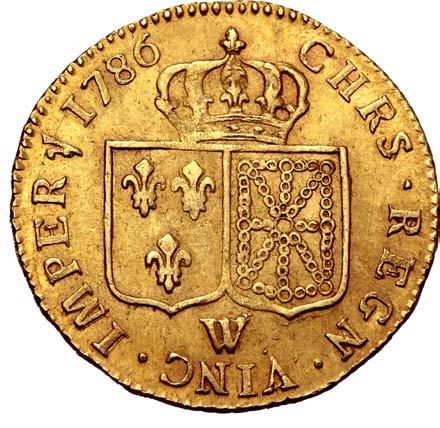

Extremely Fine.
Ex GK Collection; Ex MDC Monnaies de Collection sarl, Auction 3, 1 December 2017, lot 531.
Exquisitely Detailed Reverse
300
France, First Republic. Napoléon Bonaparte, as General de l’armée d’Orient, AR Medal. Celebrating the conquest of Egypt. Dated 1798. Dies by Jouannin and Brenet; Denon, mintmaster. Bust facing slightly to left, wearing lotus wreath; J. JOUANNIN. F. DENON D. on truncation / Napoléon riding to left in biga of richly caparisoned camels, holding sceptre and being crowned by Victory flying to right above, holding palm frond and wreath; obelisk and Corinthian column to left; L’EGYPTE CONQUISE. MDCCXCVIII. in two lines in exergue, BRENET F. DENON D. below. Hennin 879.

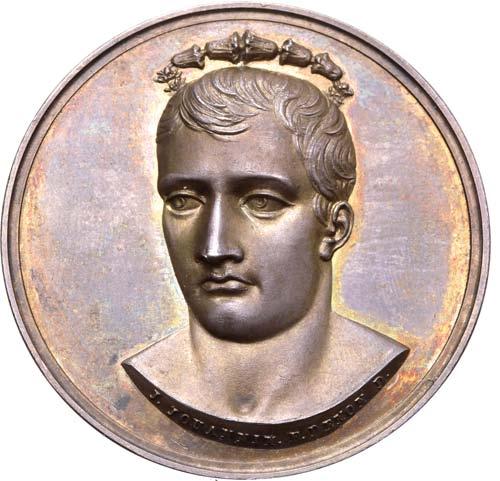

37.75g, 40mm, 12h.
Fleur De Coin; beautiful cabinet tone, exceptional portrait in high relief, exquisitely detailed reverse.
Ex MDC Monnaies de Collection sarl, Auction 4, 15 November 2018, lot 276.
2,100
France, First Republic. Napoléon Bonaparte, as Premier Consul, AR Medal. Celebrating the Peace of Amiens. Dated 25th March 1802 (later restrike). Dies by Abramson. PAX RESVSCITAT IVSTITIAM, the Genius of Peace standing facing, head to right, holding palm and resting hand on shoulder of Justitia standing facing, head to left, holding scales and sceptre; AMBIANI in exergue / ET LEGES IMPERANT, Pallas seated to left, holding tablets of law; shield, spear and owl to right; D. XXV MARTII MDCCCII in two lines in exergue. Bramsen 2167. 12.56g, 34mm, 12h.


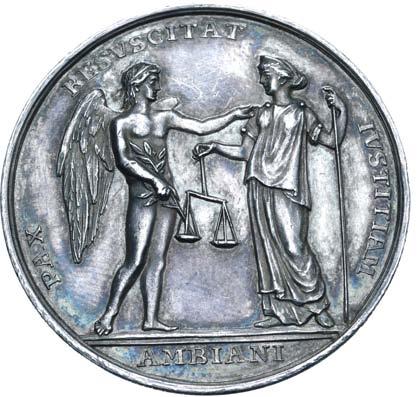

Mint State; appears as though a privy mark on edge has been removed. Very Rare.
Ex Westfälische Auktionsgesellschaft, Auction 78, 11 September 2017, lot 1390 (hammer: EUR 1,600).
600
298
797.
798.
796.
An Extremely Rare Essai Strike
France, First Republic. Napoléon Bonaparte, as Premier Consul, WM Essai for AV 40 Francs. Paris mint, dated year 11 = 1802/3. Pierre-Joseph Tiolier, engraver. BONAPARTE PREMIER CONSUL., bare head to left; Tiolier below truncation / REPUBLIQUE FRANCAISE., denomination within olive wreath; mintmarks flanking date below. Edge plain. Cf. Mazard 525A. 7.48g, 26mm, 6h.

Mint State; slightly weak rev. strike. Extremely Rare.
An Essai strike for what would eventually become the 40 Franc piece, this design by Tiolier was chosen over the alternative put forward by Galle (iNumis, MBS 14, 2010, lot 1024).

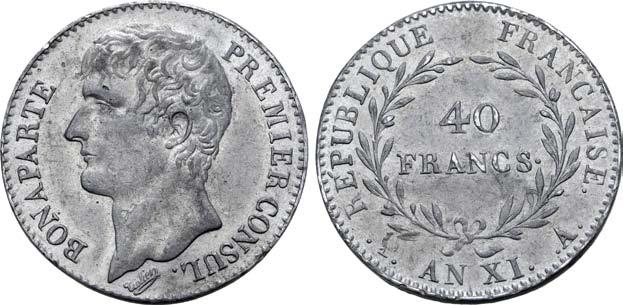
France, First Empire. Napoléon I AR Medal. Commemorating the encampment at Boulogne and the planned invasion of England. Dually dated 1804 and L’An 12 = 1804. Dies by Droz; Denon, mintmaster. NAPOLEON EMPEREUR., laureate head to right; J. P. DROZ F. below / EN L’AN XII 2000 BARQUES SONT CONSTRUITES., Hercules subduing the lion of England; DENON DIREXIT. 1804. in two lines in exergue. Bramsen 320. 34.51g, 40mm, 12h.
Near Mint State.
Ex R. T. Collection of Napoleonic Medals from the First French Republic and Empire, Roma Numismatics Ltd., Auction XXIV, 28 March 2022, lot 1713;
Ex Numismatica Ars Classica - Numismatica Varesi, Auction 115, 28 May 2019, lot 1424.
France, First Empire. Napoléon I AR Medal. Commemorating the construction of the Arc de Triomphe du Carrousel. Dated 1806. Dies by Andrieu and Brenet; Denon, mintmaster. NAPOLEON EMP. ET. ROI., laureate head to right; ANDRIEU F. DENON DIRT. in two lines below neck truncation / Arc de Triomphe in the Place du Carrousel; AUX ARMÉES MDCCCVI. in two lines in exergue, BRENET F. FONTAINE ARC. DENON D. below. Bramsen 557. 38.94g, 40mm, 12h.





Fleur De Coin; pleasant iridescent tones over frosted satin surfaces.
Ex Heritage World Coin Auctions, NYINC Signature Sale 3061, 7 January 2018, lot 30399; Ex J. Eric Engstrom Collection, Classical Numismatic Group, Electronic Auction 389, 18 January 2017, lot 1353.

299
300
799.
800. 300
801. 900
France, First Empire. Napoléon I Æ Medal. Commemorating the formation of the Banque de France. Dated 1809. Dies by Droz. NAPOLEON EMPEREUR ET ROI., laureate head to right; J. P. DROZ FECIT AN 1809 in two lines below truncation / Female figure, seated on throne to left, handing medal to old man standing to right, whom Mercury, standing facing between and holding caduceus, presents to her; dog at feet to left, barrels and sacks with coins spilling out at feet to right; J. P. DROZ. F. to left on ground line. Bramsen 918. 168.71g, 68mm, 12h.

Near Mint State; minor rim contact marks.
Ex R. T. Collection of Napoleonic Medals from the First French Republic and Empire, Roma Numismatics Ltd., Auction XXIV, 28 March 2022, lot 1849; Ex Heritage World Coin Auctions, NYINC Signature Sale 3063, 16 January 2018, lot 34275.
France, First Empire. Napoléon I, with Marie-Louise, Æ Medal. Celebrating the marriage of Napoléon and Marie-Louise. Dated 1 April 1810. Dies by Mercié. NEAPOLIO v MAGNVS v IMP v ET MARIA v LVDOVICA v AVSTR, jugate heads of Napoleon, laureate, and Marie-Louise, diademed, to left, within flower wreath topped by star; lion to left below, MERCIÉ FT. LUG on neck truncation of bust of Napoléon / OB v FELICITATEM HYMENAEI v AVG, Lyon standing to right, inscribing VOTA LVG onto shield set on altar; MERCIÉ SCULPT. LUGDUNI on ground line, CONSILII. MVNICIP. LVG IVSSV. PERCVSSVM KAL. APR. M.D.CCC.X. in three lines in exergue. Bramsen 960. 56.93g, 49mm, 12h.




Mint State; attractive light iridescent cabinet tone.
Ex R. T. Collection of Napoleonic Medals from the First French Republic and Empire, Roma Numismatics Ltd., Auction XXIV, 28 March 2022, lot 1856;
Ex Stack’s Bowers and Ponterio, NYINC Auction, 16 January 2018, lot 22556.
Extremely Rare in Silver
150
France, The Hundred Days. Napoléon I AR Medal. Commemorating Napoleon’s landing at Golfe-Juan. Dated 1815. Dies by Droz; Denon, mintmaster. NAPOLEON EMPEREUR, laureate head to left; DENON D. DROZ F. in two lines below neck truncation / A NAPOLEON LE CVI. REGT., cippus raised on base, decorated with eagle holding lightning within laurel wreath and frieze of laurel wreaths, the middle one surrounding a star, the others surrounding the letter N; GOLFE JUAN MDCCCXV. in two lines in exergue. Bramsen 1590. 9.54g, 26mm, 12h.
Near Mint State; beautiful old cabinet tone. Extremely Rare in silver
Ex MDC Monnaies de Collection sarl, Auction 4, 15 November 2018, lot 569.
1,200
300
180
802.
803.
804.
The Finest Graded Example
France, Third Republic. AV Essai de 25 Centimes. Paris mint, 1913. Dies by Charles Pillet. Central hole topped by pileus, fasces to left, FR monogram to right, date below; all within wreath / Cockerel standing to right, wings slightly spread, rising sun in background; •LIBERTE• •EGALITE•FRATERNITE• and denomination above, CH. PILLET to left, ESSAI to right. Mazard 2149a; cf. Guilloteau 4763 (for type in nickel);


KM -.
PCGS graded SP66 (72938.66/80455912); the finest encapsulated and graded example. Excessively Rare.

Ex GK Collection;
Ex MDC Monnaies de Collection sarl, Auction 5, 14 November 2019, lot 665 (hammer: EUR 12,000);
Ex Maison Palombo, Auction 15, 22 October 2016, lot 809 (hammer: CHF 18,000);
Ex Dr. Lawrence A. Adams Collection, Classical Numismatic Group, Triton XIX, 5 January 2016, lot 2352;
Ex Dr. Busso Peus Nachfolger, Auction 314, 30 October 1985, lot 769.
G ERMAN S TATES
A Very Rare Variant
6,000
German States, Frankfurt (Free Imperial City) AR Vereinstaler. 1857. FREIE STADT FRANKFURT., bust of Francofurtia to right, wearing ornate cloak and oak wreath; Eschenheimer Tower and two other rooftops behind right shoulder, cathedral tower behind to left / EIN VEREINSTHALER ⧾ XXX
EIN PFUND FEIN ⧾, crowned imperial eagle facing, head to left, with wings spread, date below. Edge inscription: STARK ⍭ IM ⍭ RECHT ⍭∗⍭. KM 354; Kahnt 166; Thun 141. 18.57g, 33mm, 12h.

Near Mint State; untouched, mirror-like surfaces, light iridescent toning. Very Rare variant, only 1,350 minted.


Ex Heidelberger Münzhandlung Herbert Grün e.K., Auction 68, 13 May 2016, lot 149.
1,500
301
805.
806.
German States, Fulda (Bishopric). Adalbert von Harstall AR Taler. 1795 VH. ADALBERTUS D • G • EPIS : ET ABB : FULD : S • R • I • PR :, helmeted coat-of-arms; mintmark below / PRO DEO ET PATRIA • and date in four lines; all within wreath; X EINE F • MARCK in three lines in exergue. KM 151; Davenport 2265; Buchonia 3. 28.13g, 40mm, 12h.


Good Extremely Fine; attractive light cabinet tone with an underlying mint lustre.
Ex Gorny & Mosch Giessener Münzhandlung, Auction 269, 9 March 2020, lot 1375.
German States, Jever (Barony). Friederike Auguste Sophie of Anhalt-Bernburg, Princess Consort of Anhalt-Zerbst (as Regent Governor), AR Reichstaler. Silberhutte mint, 1798. SUB • UMBRA • ALARUM • TUARUM •, crowned double-headed eagle facing, wearing shield on breast depicting a lion rampant, and holding sceptre and orb; crown above / FRIED • AUG • SOPH • PRINC • ANH • DYN • IEVER • ADMIN •, denomination above date; wreath around. Bitkin 1. 21.99g, 38mm, 12h.
Extremely Fine. Very Rare.
From the collection of GK.
When the male line of Anhalt-Zerbst died out with the passing of Prince Frederick August and its territories were handed out among the late Prince’s relatives, Jever, in Lower Saxony, was given to his sister, Empress Catherine II of Russia, and was then inherited by Emperor Paul I. Catherine II had allowed her late brother’s widow, Friederike Auguste Sophie of Anhalt-Bernburg, Princess Consort of Anhalt-Zerbst, to rule Jever on her behalf, as did Paul I, who granted permission for the issue of talers in 1798 of which this very rare coin was a part.
200th Anniversary of the Augsburg Confession
German States, Nürnberg (Free Imperial City) AR Medal. 1730. Struck for the 200th anniversary of the Augsburg Confession. Designs by Sigmund Dockler and Peter Paul Werner. Three city coats-of-arms surrounded by seven patriarchal coats-of-arms set on a wreath / AN DENKEN DERZ VA VGSP VRG VBERGEBENEN BERAENTNVS VND ERSTEN BERENNERE, (chronogram) in six lines within circle of seven coats-of-arms from the first seven signatories of the confession, set on wreath. Erlanger 1108; Whiting 430. 4.75g, 31mm, 12h.
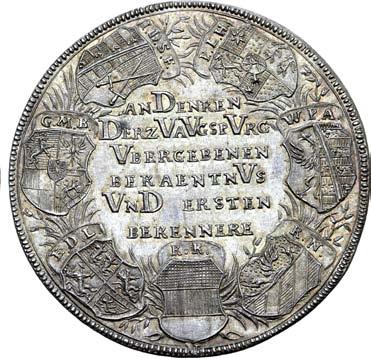
Mint State; beautiful old cabinet tone. Rare.
Ex Dr. Busso Peus Nachfolger, Auction 426, 16 June 2020, lot 1011.
German States, Württemburg (Duchy). Eberhard Ludwig AV 1/4 Carolin. 1732. EBER: LUD: D• G• DUX WUR: x T., armoured bust to right / ✶ CUM DEO ET DIE ✶, crowned coat-of-arms, order chain around; date below. KM 320; Friedberg 3586. 2.38g, 19mm, 5h.

Very Fine. Rare. Ex GK Collection;
Roma Numismatics Ltd.,



2020, lot 903.
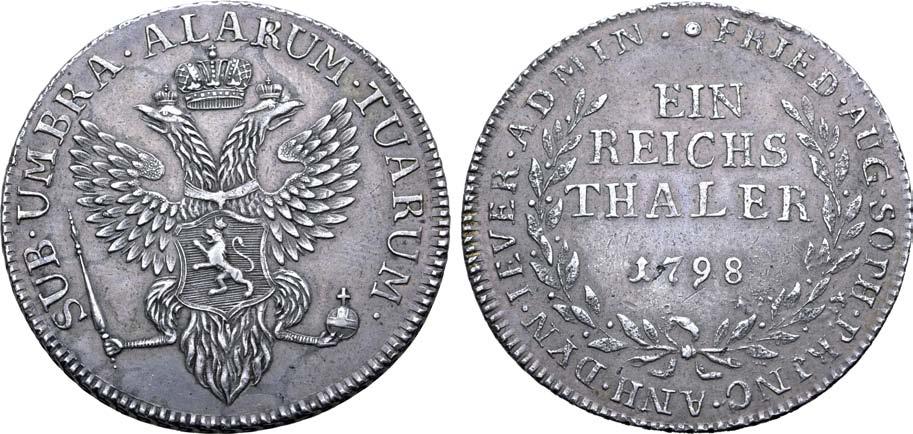
302 807. 270
808. 300
809.
Ex
Auction XX, 30 October
810. 210 300
German States, Württemberg (Kingdom). Wilhelm I AR Vereinstaler. 1859. Designs by Carl Friedrich Voigt. WILLHELM KONIG V. WÜRTTEMBERG, bare head to left / EIN VEREINSTHALER ∗ XXX EIN PFUND FEIN, crowned and helmeted coat-of-arms held by crowned lion to left and stag to right; ribbon inscribed ‘furchtlos und trew’ below, date in exergue. Edge inscription: * MÜNZVERTRAG VOM 24 JANUAR 1857. KM 601; AKS 77. 18.45g, 33mm, 12h.
811. 600
Near Mint State; attractive rainbow iridescence around edges.
Ex Dr. Busso Peus Nachfolger, Auction 426, 16 June 2020, lot 1131.
G REAT B RITAIN
812.
Great Britain, Plantagenet. Edward IV AV Ryal - 10 Shillings. Tower (London) mint, 1465-1466. ЄDWΛRD’ ஃ DI’ ஃ GRΛ’ ஃ RЄX ஃ ΛꞂGL ஃ ’ Z FRΛꞂC’ ஃ DꞂS’ ஃ I ஃ B ஃ, king standing facing in ship, holding sword and shield bearing coat-of-arms, Є on flag on stern, rose on hull, waves below / ✳ IҺC’ ஃ ΛVT’ ஃ TRΛꞂSIЄꞂS ஃ PER ஃ ᙏЄDIVᙏ ஃ ILLORVᙏ ஃ IBΛT, central rose over sunburst with ornate spokes, crowns over lions between spokes and fleur-de-lis in spandrels. SCBC 1950; North 1549; Friedberg 132; Numista 52753. 7.50g, 35mm, 6h. Good Very Fine; hairline planchet defect.





1,200
Great Britain, Tudor. Elizabeth I AV Angel. Tower (London) mint. Second ‘Restoration’ Coinage, Third and Fourth Issue, 1 November 1573 - 25 May 1574. (acorn over ermine) ELIZABETH : D ‘. G ‘. ANG .’ FR .’ ET : HI ‘ REGINA, the Archangel Michael slaying dragon with cross-pommelled lance / (acorn over ermine) A : DNO : FACTVM : EST : ISTVD : ET : EST : MIRABI .’ ship bearing coat-of-arms and cross over waves below; E - �� across fields. SCBC 2515; HCN 341; North 1991/2; Montagu -; Murdoch -; Lockett 4091 (this coin); Brown & Comber C12, and pl. IX (this coin; cf. Comber I, 15); Schneider I, 765 (the overmark unrepresented). 5.03g, 28mm, 7h.
NGC graded UNC Details, reverse graffiti, in limited edition black ‘Alderman Horace Hird’ holder (#6135299-006). Very Rare.



4,800
This coin published in I.D. Brown & C.H. Comber, Notes on the gold coinage of Elizabeth I (BNJ 59, 1989); Ex Alderman Horace Hird (1899-1973) Collection, with old collector’s ticket; Ex “The Celebrated Collection formed by the late Richard Cyril Lockett Esq”, Glendining & Co., 26-27 April 1960, lot 4091 (hammer: 130 GBP). Brown and Comber record nine instances of this privy mark for this denomination (not accounting for duplication) as listed in the Spink Numismatic Circular and Seaby Bulletin between 1937 and 1983. Challis records the mint output for this Pyx Period at £8,143, the lowest for the Second Restoration Coinage.


303
813.
Ex Richard Cyril Lockett Collection
Ex Alderman Horace Hird Collection
815.
Great Britain, Tudor. Elizabeth I AV Angel. Tower (London) mint. Third ‘Restoration’ Coinage, Sixth Issue, 1 February 1592- 8 May 1594. (tun)


ELIZABETH : D .’ G .’ ANG .’ FR ‘• ET • HI .’ REGINA, the Archangel Michael slaying dragon with cross-pommelled lance / (tun) A : DNO : FACTVM : EST : ISTVD : ET : EST ‘ MIRARI ‘, ship bearing coat-of-arms and cross over waves below; E - �� across fields. SCBC 2531; HCN 110; North 2005; Montagu -; Murdoch -; Lockett 4092; Brown & Comber C42; Comber II, 125; Schneider I, 786-790 (this mintmark unrepresented). 5.13g, 30mm, 9h.
NGC graded MS 62, in limited edition black ‘Alderman Horace Hird’ holder (#6135299-008).
Ex Alderman Horace Hird (1899-1973) Collection, with old collector’s ticket; Privately purchased from A. H. Baldwin & Sons Ltd, 31 August 1959 (£18).
6,000
Brown and Comber record twelve instances of this privy mark for this denomination (not accounting for duplication) as listed in the Spink Numismatic Circular and Seaby Bulletin between 1937 and 1983. Challis records the mint output for this Pyx Period at £46,973.

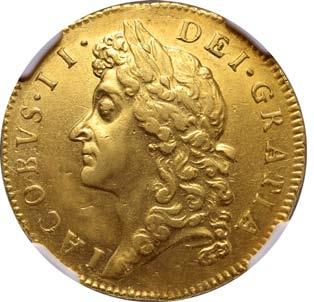

Great Britain, Stuart. James II AV Guinea. 1688. Engraved by John Roettier. IACOBVS • II • DEI • GRATIA, laureate head to left / MAG • BR • FRA • ET • HIB • REX •, crowned cruciform shields-of-arms with sceptres bearing national emblems in angles, divided date above. SCBC 3402; KM 495.1.

NGC graded XF details, obv. repaired (#4769082-007).
Ex Roma Numismatics Ltd., Auction XXIV, 28 March 2022, lot 1332; Acquired from AMR Coins.
1,800
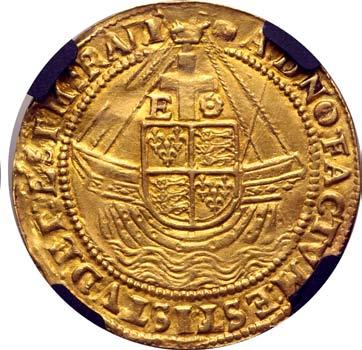
304
814.
Wonderfully Detailed
Great Britain, Hanover. Victoria AR Golden Jubilee Medal. 1887. Engraved by L. C. Wyon, designed by Sir J.E. Boehm and Sir F. Leighton. VICTORIA REGINA ET IMPERATRIX, crowned bust to left in imperial garb; J.E.B. incuse on bust truncation / Personification of Empire enthroned facing, holding globe with Victory and sceptre, seven allegorical figures representing arts, industry and commerce to right and left, Mercury and Time reclining below; shields with ASIA, AMERICA, EUROPE, AUSTRALASIA and AFRICA upon them in commemoration above and angels. Eimer 1733b; Brown, BHM 3219. 222g, 77mm, 12h.

Good Extremely Fine; minor scratches in fields; wonderfully detailed and attractive type. In original presentation box.
Great Britain, Saxe-Coburg and Gotha. Edward VII AV Matte Proof 2 Pounds. London mint, 1902. Designs by George William de Saulles and Benedetto Pistrucci. EDWARDVS VII DEI GRA: BRITT: OMN: REX FID: DEF: IND: IMP:, bare head to right; DE S. below bust truncation / St. George on horseback to right, holding sword and wearing plumed helmet and billowing cloak, slaying the dragon which falls to right; B.P. below ground line, date in exergue. SCBC 3868; KM 806; Friedberg 399a; Numista 13227. 16.00g, 29mm, 12h.
Fleur De Coin. In exemplary condition for the type.
Ex Roma Numismatics Ltd., Auction XX, 30 October 2020, lot 928.

1,200
Great Britain, Saxe-Coburg and Gotha. Edward VII AV Matte Proof 2 Pounds. London mint, 1902. Designs by George William de Saulles and Benedetto Pistrucci. EDWARDVS VII DEI GRA: BRITT: OMN: REX FID: DEF: IND: IMP:, bare head to right; DE S. below bust truncation / St. George on horseback to right, holding sword and wearing plumed helmet and billowing cloak, slaying the dragon which falls to right; B.P. below ground line, date in exergue. SCBC 3868; KM 806; Friedberg 399a; Numista 13227.





NGC graded PF 62 Matte (#6672717-001).
Acquired from Noonan’s; Ex Royal Berkshire Collection, collector’s ticket included; Acquired from Paul Davies Ltd., 2010.
305
Acquired from Noonan’s.
816. 900
817.
750
818.
819.
Great Britain, Saxe-Coburg and Gotha. Edward VII AV Matte Proof 1/2 Sovereign. London mint, 1902. Designs by George William de Saulles and Benedetto Pistrucci. EDWARDVS VII D: G: BRITT: OMN: REX F: D: IND: IMP:, bare head right; De S. below bust truncation / St. George on horseback to right, holding sword and wearing plumed helmet and billowing cloak, slaying the dragon which falls to right; date and B.P in exergue. SCBC 3974B; KM 804; Friedberg 401; Numista 5502.
NGC graded PF 61 Matte (#6672717-002).
Acquired from Noonan’s; Ex Royal Berkshire Collection; Acquired from Seaby’s, 1990.
821.
Great Britain, Saxe-Coburg and Gotha. Edward VII AV Sovereign. London mint, 1908. Design by George William de Saulles and Benedetto Pistrucci. EDWARDVS VII D: G: BRITT: OMN: REX F: D: IND: IMP:, bare head to right; small De S under bust / St. George on horseback to right, holding sword and wearing plumed helmet and billowing cloak, slaying the dragon which falls to right; date and small B.P in exergue. SCBC 3969; KM 805; Friedberg 400. 7.99g, 22mm, 12h.



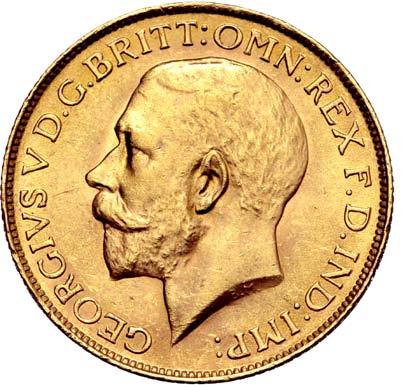

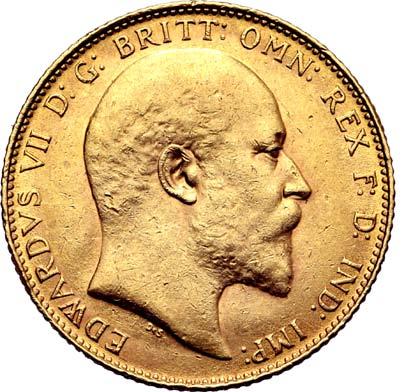

822.
Great Britain, Saxe-Coburg and Gotha. George V AV Sovereign. London mint, 1925. Design by Edgar Bertram MacKennal and Benedetto Pistrucci. GEORGIVS V D. G. BRITT: OMN: REX F. D. IND: IMP:, bare head to left; small B.M. on neck truncation / St. George on horseback to right, holding sword and wearing plumed helmet and billowing cloak, slaying the dragon which falls to right; date and small B.P in exergue. SCBC 3996; KM 820; Friedberg 404. 8.00g, 22mm, 12h.

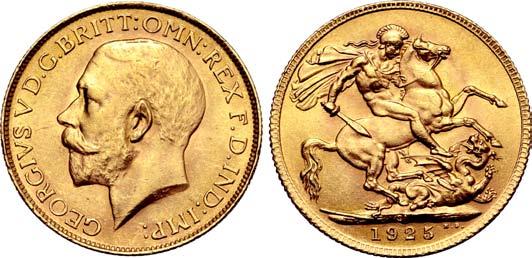
Good Extremely Fine.
Ex GK Collection.
Great Britain, Windsor. Elizabeth II AV Matte Proof Sovereign. Llantrisant (Royal) mint, 1980. Design by Arnold Machin and Benedetto Pistrucci. ELIZABETH • II • DEI • GRATIA • REGINA • F: D:, crowned and draped bust to right / St. George on horseback to right, holding sword and wearing plumed helmet and billowing cloak, slaying the dragon which falls to right; date and small B.P in exergue. SCBC 4204; Friedberg 418. 8.00g, 22mm, 12h.
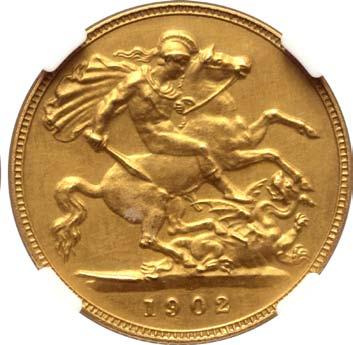


Mint State.
Ex GK Collection.
306
240
Extremely Fine. Ex GK Collection. 820.
240 240
210
H UNGARIAN S TATES
The Extremely Rare Karlsburg 1759 Issue

823.
Hungarian States, Transylvania (Principality). Maria Theresia AR Taler. Karlsburg mint, 1759. M • THERESIA • D: G • R • IMP • GE • HU • BO • REG •, draped bust to right, wearing a tiara / TRAN CO TY (date) AR AU DUX BU ME PR, double-headed eagle with crown above and coat-of-arms on chest. Edge inscription: IUSTITIA ET CLEMENTIA. Davenport 1145; KM 628; Eypeltauer 362. 37.73g, 43mm, 12h.





Good Extremely Fine. Extremely Rare; one of only three examples offered at auction in the past two decades.
I TALIAN S TATES
1,800
Italian States, Napoli (Naples, Kingdom). Filippo II di Spagna AR Mezzo Ducato. 1st phase, as King of England, France and Naples, and Prince of Spain. Giovanni Battista Ravaschiero, mintmaster. 1554-1556. PHILIP • R • ANG • FR • NEAP • PR • HISPA •, crowned, draped and cuirassed bust to right; IBR monogram behind / POSVIMIVS • DEVM •ADIVTOREM • NOST, crowned conjoined royal coat-of-arms of England and Spain emblazoned on ornate escutcheon. MIR 3; CNI XX pg. 19, 153; Pannuti 3. 14.60g, 35mm, 5h.
Near Extremely Fine; typical spots of flat strike, deep old cabinet tone.
Ex David Freedman Collection; Ex Classical Numismatic Group, Auction 67, 22 September 2004, lot 1954.
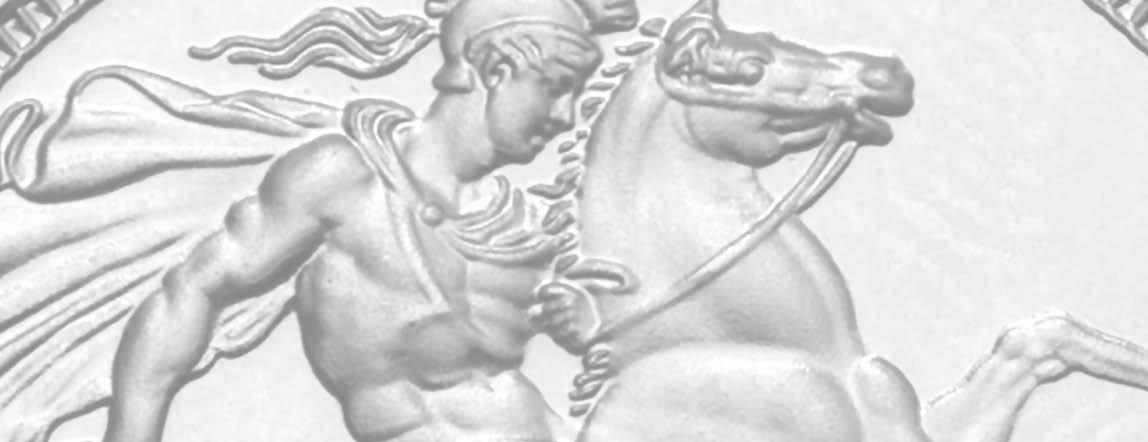
307
824. 450
Displaying the First AD Date on Any Coin


Italian States, Sicilia (Sicily, Kingdom). Frederick I (later Frederick II, Holy Roman Emperor) and Constance as Empress of the Holy Roman Empire, AV Tari. Amalfi mint, November 1198. Outer circle Kufic legend: ‘struck in his reign in the year five hundred ninety-five’; inner circle Latin legend: ⧾ FRE REX SICILIE around palm tree in fruit in central circle / Outer rim Kufic legend: ‘struck in the year one-hundred one-thousand ninety and eight; inner rim Kufic legend: ‘Constance imperatrix of the Romans’, around Latin cross in central circle. L. Travaini, ‘Le monete Sveve con legend arabe nel Regno di Sicilia (1194-1220)’ in RIN 1986, p.136, 2; MIR 36; MEC 14, p.166 fig. 3b; CNI XVII, p.10, 1, pl. 1, 14; G. Sambon, Repertario generale, 1113; M. Guglielmi, La monetazione degli Svevi nell’Italia meritionale, Serravalle RSM, 2000, p.67, 1; D. Spinelli, Monete cufiche, Napoli 1844, pl. 20, 1; R. Levinson, The Early Dated Coins of Europe 1234-1500, Clifton 2007, p.258; Friedberg 51. 0.87g, 24mm.
Mint State; edge clipped. Extremely rare and of great numismatic importance.
1,800
This remarkable scyphate-shaped tari bears two dates: Hegira 595 and Christian era 1198, the earliest Anno Domini date ever recorded on a coin, which according to Philip Grierson and L. Travaini commemorates the investiture formally granted to Frederick II and Constance by Pope Innocent III on 19 November of that year. In return the pope received an annual cens of 1,000 ‘schifati’, cf. MEC pp.165-6.
Amalfi was an independent republic from the 7th century that managed to extract itself from Byzantine vassalage in 839 and first elected an independent duke in 958. By 944 Amalfitan merchants were already present at Constantinople, trading with Egypt by the late 10th century and rivalling Pisa and Genova in its domestic prosperity and maritime trade with Asia before the rise of the Venice. In 1073 the republic fell to the Norman countship of Apulia and was granted many rights and attained great wealth. In about 1080, Amalfitans founded a hospice for pilgrims in Islamic occupied Jerusalem, from which the Order of the Hospital (St. John of Jerusalem) later developed. Under Roger II in 1131, Amalfi passed into the kingdom of Sicily and by 1220 the Empire of Frederick II. In matters of medieval culture, Amalfi was famous for its multiculturalism, flourishing schools of law and mathematics, maritime code and the reputed Amalfitan Flavio Gioia, who in about 1300 was considered the first marine pilot to have introduced the sailor’s compass to Western navigation.
The date on the Amalfi tari must be connected to the fact that Islamic coinage had been dated from the time of the 5th Caliph, ‘Abd al-Malik in the 77th year of the Hagira, the migration of Muhammad and his followers from Mecca to Yathrib in AD 696/7. Amalfi had been within the Islamic monetary sphere strongly influenced by the Emirate of Sicily since the 10th century, in which the standard gold unit was the gold Tarì (meaning “fresh” or “newly minted money”), the Christian designation of Ruba’i or quarter Dinar with the ideal weight of 1.05g of gold.

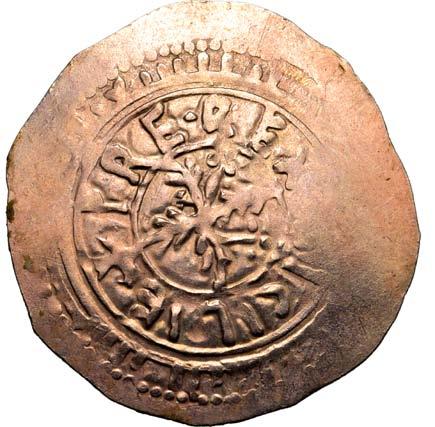

The idea that coins should bear a date of issue referencing the time passed since the birth of Christ was not widespread in Europe until the mid 16th century. While the learned Scythian monk, Dionysus Exiguus from Tomis, formulated the Anno Domini calendar in the 6th century and is still used to enumerate the years of both the Julian and Gregorian calendars, it was not until the advent of this issue in 1198 that European coinage was so dated. This dating system was not utilised again until 1234 by the bishopric of Roskilde on its silver deniers and in 1251 in Arabic script on the Islamic-styled silver coinage by the crusader city of Acre. In the spring of 1250 the papal legate Odo of Châteauroux arrived in Syria and was scandalised to learn that the Franks were striking gold and silver coins with the name and dates of the Muslim Prophet and had them substituted with purely Christian legends and dates in the name of the Messiah, albeit written in Arabic to maintain acceptability in the region. Much later from 1372 dated groschen in the name of Charlemagne were struck on a regular basis at Aachen.

Frederick II, son of Holy Roman Emperor Henry VI of the Hohenstaufen dynasty and Constance the posthumous daughter of Roger II de Hauteville and heiress to the Norman kings of Sicily, was an infant of only three years of age when his father died and was crowned king of Sicily on papal authority at Palermo cathedral on 17 May 1198. Frederick’s minority under his mother only lasted five months as the regent died on 27 November 1198.
L IECHTENSTEIN
826.
Liechtenstein, Principality. Franz Joseph II and Princess Gina AV 100 Franken. 1952. Design by Edwin Grienauer. FRANZ

JOSEF
II
UND
GINA
• VON • LIECHTENSTEIN •, jugate busts to left; GRIENAUER to right, date below / • FÜRSTENTUM LIECHTENSTEIN •, crowned coat-of-arms, denomination below. KM Y17; Friedberg 19. 32.33g, 35mm, 6h. Mint State. Very Rare; from a mintage of only 4,000 pieces. Ex GK Collection; Ex Roma Numismatics Ltd., Auction XX, 30 October 2020, lot 987.
1,050
308
825.
•
•
•
•
Norway, Kingdom. Karl XIV Johan AR Speciedaler. Kongsberg mint, 1834. CARL XIV JOHAN, NORGES SVER • G • OG V • KONGE •, bareheaded and draped bust to right / Crowned coat-of-arms; denomination across fields, value, mintmark and date below. KM 301; Davenport 241; Ahlström 12. 28.84g, 36mm, 12h.




Good Extremely Fine; attractive cabinet tone.
Ex Fritz Rudolf Künker GmbH & Co. KG, Auction 261, 11 March 2015, lot 5819.
SCOTLAND
828. 150
Scotland, Perthshire. St. John’s Church Æ Halfpenny Token. 1797. PERTH HALF-PENNY (date) •, view of the church; ST.JOHN’S - CHURCH flanking seal below / ⧾ 46 WATER:MILLS FOR BLEACHING. PRINTING. COTTON:WORKS. CORN & c. WITHIN 4 MILES OF PERTH, view of a watermill and trees; WRIGHT. DES:. in exergue. Edge inscription: PAYABLE ON DEMAND BY JOHN FERRIER [uncertain number of crosses]. D&H 4.



NGC graded MS 66 BN (#6320091-001); the finest known example available. Excessively Rare; one of only 72 pieces known, and indeed actually a bronzed proof strike, a fact not noted by NGC who incorrectly catalogued it as plain edged.
From the inventory of a UK dealer.
SPANISH STATES
Spanish States, Aragon (Kingdom). Pedro III el Grande (the Great) AV Florin. Barcelona mint, 1336-1387. ✠ ARAGO REX • P •, fleur-de-lis / ✠ S • IOHANNES • B, St. John the Baptist standing facing, holding cruciform sceptre. Crusafont 386; Friedberg 1. 3.50g, 19mm, 12h.


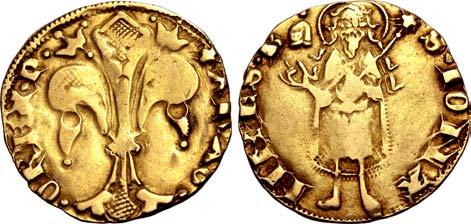
Very Fine.
Ex GK Collection.
309
829. 180
NORWAY
827. 1,200
S WITZERLAND
Switzerland, Kanton Bern AV 2 Duplone. 1796. RESPUBLICA BERNENSIS, crowned coat-of-arms; olive sprigs below / DEUS PROVIDEBIT, Swiss guardsman standing to right, holding halberd in right hand and fasces set on ground in left; date in exergue. Friedberg 186; HMZ 2.211f; D.T. 503b; KM 147. 15.30g, 29mm, 6h.

Near Mint State.
Ex GK Collection; Ex Sincona AG, Auction 35, 26 October 2016, lot 5088.
U KRAINE
Ukraine. International Year of Astronomy Commemorative AR Proof Kilo 100 Hryven. 2009. НАЦІОНАЛЬНИЙ БАНК УКРАЇНИ, armillary sphere (classical astronomical instrument) before depiction of the Solar System in which Earth is marked by a blue topaz of 0.2 carat; date divided by National Emblem of Ukraine in upper central field, denomination below / АСТРОНОМІЇ, facing portrait of Galileo Galilei to upper left, conventionalised medieval miniature of starry sky observation to lower left, depiction of a galaxy to upper right, a radio telescope to lower right, and an observatory in lower central fields; date above. KM 558. 1,000g (1Kg), 100mm, 12h.

NGC graded PF 69 ULTRA CAMEO (#5988910-001) - the highest certified of the type by NGC, joint with one other. Extremely Rare; only 700 minted. Sold with blue official presentation box and certificate.
Ex GK Collection, Roma Numismatics Ltd., Auction XXIV, 28 March 2022, lot 1378.
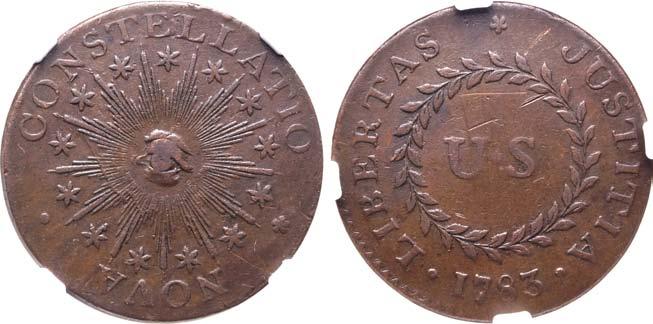
U NITED S TATES OF A MERICA
United States of America, Pre-Federal Issues. “Nova Constellatio” CU Cent Token. Uncertain mint in England (Birmingham?), 1783. Pointed rays, small US type. ✶ NOVA • CONSTELLATIO, radiant all-seeing eye surrounded by thirteen pointed rays and thirteen stars / • LIBERTAS ✶ JUSTITIA




•, small U•S within unbroken laurel wreath; date below. KM EA6.1; Crosby 2-B.
NGC graded AU 50 BN (#6673170-014). Only 25 pieces have been graded higher by NGC. Scarce.
END OF SALE
310
831.
832.
1,350 450
830.
1,500
0.5x
Additional Sessions
Friday 7 July 2023
7 July 13:00 The GK Collection of Russian coins (Part III)



Monday 10 July 2023
10 July 13:00 E-Live 7: A Collection of Migrationary Coins A Collection of Lombardic coins A collection of Medieval and World coins
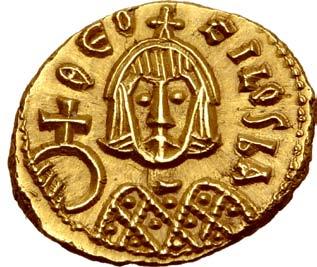

Tuesday 18 July 2023
18 July 13:00 A Highly Interesting Collection of Byzantine coins




311































































































































































































































































































































































































































































































































































































































































































































































































































































































































































































































































































































































































































































































































































































































































































































































































































































































































































































































































































































































































































































































































































































































































































































































































































































































































































































































































































































































































































































































































































